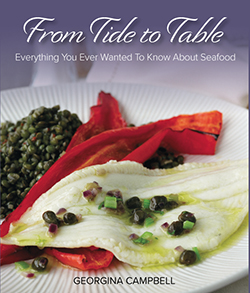Article GROW IT YOURSELF
Grow It Yourself - February

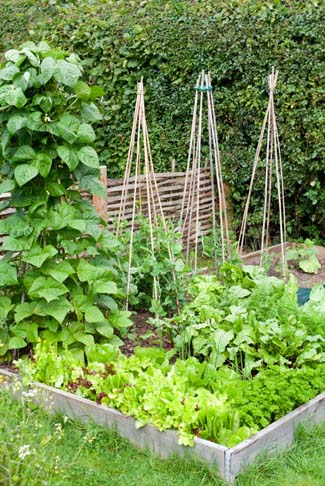 Though St Brigid’s Day (Feb 1st) is considered the start of spring, it’s really still winter outside in the veggie patch. Come February I am always itching to get started with my seed sowing and of course you can get lots of vegetables started in seed trays on a sunny windowsill indoors.
Though St Brigid’s Day (Feb 1st) is considered the start of spring, it’s really still winter outside in the veggie patch. Come February I am always itching to get started with my seed sowing and of course you can get lots of vegetables started in seed trays on a sunny windowsill indoors. The problem is that when they are bursting from their pots and ready to be planted out in a few weeks time, it may be still too cold to do so.
The relative lack of light (due to the short days) can cause problems for seedlings at this time of the year – tiny seedlings literally strain to reach the light and can end up getting too long and “leggy” as a result. Patience is the ultimate virtue for the GIYer.
Though winter stores are looking increasingly bare, we’re glad for the full freezer and the work we did chopping, shelling, podding, blanching and cooking last harvest.
 Having your own produce is a fantastic boon at this time of the year, when supermarket shelves are laden down with imported, unseasonal produce. As we move further and further from the winter solstice, we gain about five minutes of daylight at either end of the day and comparable dollops of optimism. Roll on spring!
Having your own produce is a fantastic boon at this time of the year, when supermarket shelves are laden down with imported, unseasonal produce. As we move further and further from the winter solstice, we gain about five minutes of daylight at either end of the day and comparable dollops of optimism. Roll on spring!Things to do this month
To Do
Turn over the soil only if the weather is dry – if the soil sticks to your boots it’s too early for digging! Keep off the soil to prevent soil compaction - use timber planks to stand on for access. If you have not already done so order/buy your seeds, spuds and onion sets. “Chit” or sprout seed potatoes – put them in a container (e.g. used egg carton or empty seed tray) and leave them in a bright warm place. Check the pH of your soil – you can buy a soil pH testing kit in any garden centre. Lime your soil now if required (to reduce acidity in very acid soils), particularly important in your brassica bed.
Sow
Finally, we can sow some seeds. On a sunny windowsill indoors, in a heated greenhouse or on a heating mat: sow celery, globe artichokes, celeriac, leeks, onions, lettuce, tomatoes, peas, aubergines, peppers/chilli-peppers. In polytunnel or greenhouse: beetroot, Brussels sprouts, summer and autumn cabbage, carrots, leeks, lettuce, radish. Outside: Weather permitting you can try planting out broadbeans, spinach, kohlrabi, onion and shallot sets, Jerusalem artichokes, parsnip and early pea varieties.
Harvest
Winter cabbage and cauliflowers, Brussels sprouts, spinach, kale and leeks.
Recipe of the Month – Kale on Toast
Ok, so kale isn’t one of those vegetables that makes you salivate with excitement, but it’s worth a second look for the following reasons. It’s a nutritional powerhouse, being high in anti-oxidant and anti-inflammatory nutrients, and rich in vitamins K, A and C. It’s also a hardy wonder crop that is easy to grow and will churn out leaves right through the worst of the winter. The key to making it delicious is to use plenty of seasoning, oil and garlic in the cooking.
Ingredients:
• 1 kg kale
• Salt n’ peppa
• 3 tablespoons olive oil
• 3 garlic cloves peeled and sliced
Remove the stalks from the kale and boil in lots of salted water for 10 minutes. Drain well. Heat the oil in a pan and fry the garlic gently until brown. Add the kale and season generously – cook for five minutes. Serve on sourdough or focaccia toast and drizzle with olive oil.
Tip of the Month – Lime
Most vegetables prefer to grow in a slightly acid soil with the exception of brassicas which prefer alkaline conditions. Adding compost/manure to soil to improve fertility each year, eventually makes the soil too acidic for most vegetables and particularly for the brassicas.
Traditionally therefore GIYers add lime in the spring to the beds where they will plant their brassicas to reduce acidity. Never add manure/compost at the same time as lime, as they react badly together. How much lime to add depends on the type of soil and it's pH value (buy a pH testing kit in any garden centre), but typically 1lb per square yard.
------------------------------------
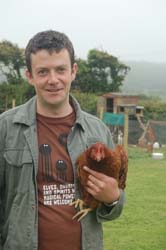 Michael Kelly is a freelance journalist, author and founder of GIY Ireland.
Michael Kelly is a freelance journalist, author and founder of GIY Ireland.GIY is a registered charity that inspires people to grow their own and gives them the skills they need to do so successfully. There are 80 GIY groups around Ireland and 6,000 GIYers involved.
For more tips, information and support visit www.giyireland.com.
© GIY Ireland 2011 – all rights reserved.
Grow It Yourself - March

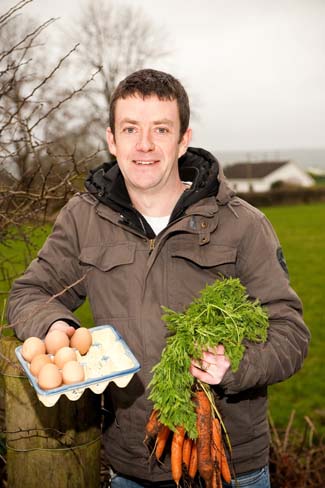 There’s a wise old GIYer I know who says that the “sap starts to rise” in gardeners in March. It’s an odd expression and I yet I completely get what he means by it. The sap is of course starting to rise in plants, but it feels like something is stirring inside us GIYers too – spring is in the air everywhere we look and the desire to get out there and stick your hands in the soil is palpable.
There’s a wise old GIYer I know who says that the “sap starts to rise” in gardeners in March. It’s an odd expression and I yet I completely get what he means by it. The sap is of course starting to rise in plants, but it feels like something is stirring inside us GIYers too – spring is in the air everywhere we look and the desire to get out there and stick your hands in the soil is palpable.They say that when soil is broken by a spade or fork it releases endorphins – this might explain why GIYers are such a happy bunch, we’re basically high on soil all the time. True or not, there is something that I’ve noticed over six seasons of GIYing – I have started to be more in tune with the seasons. When you grow your own vegetables you sort of have to be.
Mother Nature has her own pace and it’s a (sometimes maddeningly) slow, methodical, inexorable one – she refuses to be rushed. Every year my excitement gets the better of me and I sow seeds in January and February but it is only now in March that they will germinate and sprout in to action. It’s GIY time folks. The sap is rising!
 GIY Week takes place March 12th to 19th and there will be events happening all over Ireland – for more information visit www.giyireland.com.
GIY Week takes place March 12th to 19th and there will be events happening all over Ireland – for more information visit www.giyireland.com. Things to do this month
To Do
Continue to prepare ground – there is still time to prepare a plot to grow veg this year. Fork or rake over existing beds, breaking up large clods of earth. Cover new seedlings with fleece if a frost is due. Start your daily slug patrols and lay beer traps. Don’t let new-season weeds take over – get on top of them with weekly hoeing.
Sow
Indoors: lettuce, aubergine, peppers, cucumbers, celery, celeriac, sweet corn, basil, leeks, summer cabbage, cauliflower, Brussels sprouts, parsley, courgette, French beans.
Sow outdoors or under cover: broad beans, red cabbage, carrots, cauliflower, spinach, kale, Brussels sprouts, onions, leeks, turnip, peas, radishes, early lettuce, asparagus. Plant your first early seed potatoes, as soon as weather conditions allow.
Harvest
The efficient GIYer thumbs their nose at the notion of a hungry gap and this month is enjoying (from the ground and from storage) onions, leeks, parsnips, potatoes, some varieties of lettuce, mint, sprouting broccoli, kale, rhubarb, chard, the first of the spring cauliflowers and cabbage, and spinach (perpetual, spinach beet).
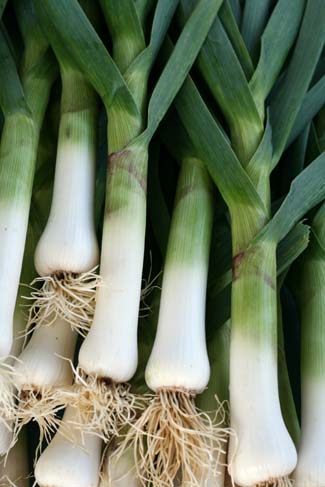 Recipe of the Month – Potato and Leek Soup
Recipe of the Month – Potato and Leek SoupOk, this isn’t the most glamourous of recipes but March is a traditional “Hungry Gap” month, so file this under “P” for practical. If you had a good growing year last year, there’s a strong chance that you will still have access to the core ingredients of this soup - leeks from the ground, potatoes and onions from stores.
Ingredients:
• 400g leeks, sliced (white part only)
• 450g potatoes, diced
• 100g onions, diced
• 900ml chicken stock
• 40g butter
Melt the butter in a saucepan. Add the veg and season generously. Cover and sweat on a low heat for 10 minutes. Make sure the veg are soft. Add the stock and bring to the boil, simmering for about 5 minutes. Liquidise until smooth. You can add a little milk or cream if you wish. This makes an incredibly quick and tasty lunch served with some crusty bread.
Tip of the Month – GIYing with Kids
Kids make fantastic GIYers – they are enthusiastic, hard working and they don’t have the hang-ups about the process that we adults sometimes do! Teaching your kids to grow their own food gives them an invaluable life-skill. Here’s 5 tips for GIYing with kids.
1. Kids love sowing seeds, particularly the bigger ones like peas and beans. They also love getting their hands mucky!
2. Pick fruit and vegetables that are fast growing so that they see a quick return – radishes are a good example
3. GIY Fact – kids will often try vegetables they wouldn’t normally touch if they have been involved in growing them!
4. Top GIY activities for kids – sowing seeds, digging and watering
5. Top GIY crops for Kids – carrots, peas, strawberries and beans
------------------------------------
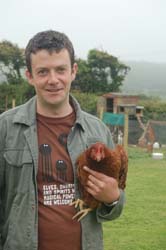 Michael Kelly is a freelance journalist, author and founder of GIY Ireland.
Michael Kelly is a freelance journalist, author and founder of GIY Ireland.GIY is a registered charity that inspires people to grow their own and gives them the skills they need to do so successfully. There are 80 GIY groups around Ireland and 6,000 GIYers involved.
For more tips, information and support visit www.giyireland.com.
© GIY Ireland 2011 – all rights reserved.
Grow it Yourself - April

 Weeds are a downer. Many the great GIYing dream has been dashed against the rocks of a bed full of weeds. We start off with a lovely clear bed, we sow some seeds, there’s a shower of rain and some sunshine, and hey presto, the bed is covered in weeds. Lots and lots of weeds.
Weeds are a downer. Many the great GIYing dream has been dashed against the rocks of a bed full of weeds. We start off with a lovely clear bed, we sow some seeds, there’s a shower of rain and some sunshine, and hey presto, the bed is covered in weeds. Lots and lots of weeds. So you go out in your wellies and gloves, determined to sort them out - some of them play ball and come out clean with a single satisfying tug, but more of them break off at the base and you just know they will be back to haunt you in a week’s time. And now you’re losing the battle. In that week the weeds become more powerful, more persistent, more ubiquitous. And before you know it, you JUST COULDN”T BE BOTHERED. You’ve lost the war, and your GIYing plans are shelved for another year.
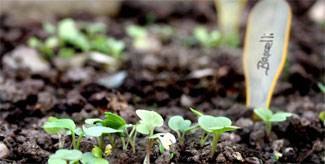 The key to controlling weeds is to dedicate yourself to weeding “little and often” and the best way to beat a weed is to hoe it before it becomes a weed. In other words, run your hoe over your entire veggie patch once a week, regardless of whether there are any weeds or not.
The key to controlling weeds is to dedicate yourself to weeding “little and often” and the best way to beat a weed is to hoe it before it becomes a weed. In other words, run your hoe over your entire veggie patch once a week, regardless of whether there are any weeds or not. Hoeing will disrupt the weeds before they get a chance to become weeds. Buy yourself a decent Dutch or oscillating hoe – hoeing is actually quite a pleasant, upright task (compared to weeding by hand which is an irritating, back-breaking one). Hoe for Victory!
Things to do this month
To Do
If poor weather in March has hampered your outdoor work, then April is the month to catch-up. The key words for April are weeds and slugs. You need to stay on top of them both. Check your early spuds regularly and ‘earth-up’ as required. Water your tunnel/greenhouse – things can get pretty warm on a nice sunny April day and seedlings will dry out quickly.
Sow
Indoors: lettuce, tomato, pepper, chilli-pepper, cucumber, celery, celeriac, basil, leeks, cabbage, cauliflower, Brussels sprouts, parsley, courgette, marrow, globe artichoke, beans, sweet corn and pumpkin.
Outdoors: broad bean, onion sets, pea, beetroot, cabbage, spinach, Brussels sprouts, parsnip, spring onion, leek, carrot, radish, broccoli, turnip. Plant out cabbage plants when they are 15/20 cm tall into well prepared soil that has been manured.
Harvest
Stored fruit and vegetables are likely to be a distant memory at this stage and new crops are only starting to trickle in which makes April a tricky proposition. The middle of this month might see the first asparagus and the first early spring cabbage. The other two star performers this month are purple sprouting broccoli and rhubarb.
Recipe of the Month – Salmon and Leek Pastry Parcels
April is a classic hungry gap month and for many GIYers, leeks may well be the only fresh vegetable in the soil at this time of the year. Here’s a fresh, healthy salmon and leek recipe.
Ingredients:
• 2 salmon fillets, skin removed
• 4 leeks, finely sliced
• 100g crème fraîche
• 20g butter
• 6 sheets filo pastry
Cook the leeks in a saucepan with a few tbsp of water and a knob of butter for 10 minutes, covered. Season well. Allow to cool.
Brush a sheet of pastry with butter, then lay 2 more sheets on top, brushing butter between each layer. Place a salmon fillet on top.
Mix the crème fraîche with the leeks – put about half this mixture on top of the salmon. Fold the pastry up over the salmon to make it in to a parcel.
Repeat this process for the second parcel. Brush them with a little melted butter.
Place on a baking sheet and cook for 20 minutes at 200C until nicely browned.
Serve with some mixed leaves from the veggie patch.
Tip of the Month – Nettle Fertiliser
Pick huge bundles of tender young nettles - divert around 5oz to the kitchen for a delicious nettle soup and use the rest for an organic fertiliser. Nettles are extremely high in nitrogen so if you soak a large bucketful in water for a week, you produce a brilliant nitrogen-rich fertilizer which will be hugely beneficial for any plants which need leafy growth, for example lettuces, cabbage, kale etc. Put a kilo of nettles in a Hessian bag and soak in 20 litres of water and leave it to stew for a month or so. It gets pretty stink so put a lid on top. Mix one part nettle liquid with ten parts water when applying to plants.
------------------------------------
 Michael Kelly is a freelance journalist, author and founder of GIY Ireland.
Michael Kelly is a freelance journalist, author and founder of GIY Ireland.GIY is a registered charity that inspires people to grow their own and gives them the skills they need to do so successfully. There are 80 GIY groups around Ireland and 6,000 GIYers involved.
For more tips, information and support visit www.giyireland.com.
© GIY Ireland 2011 – all rights reserved.
Grow it Yourself - May
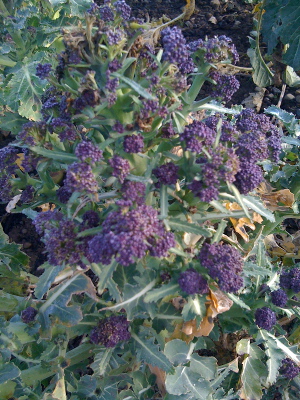
 Last Saturday we got together in a friends house for a GIY meitheal (pronounced meh-hill). A meitheal is a wonderful Irish term for a working gang – it has its origins in rural Ireland where neighbouring farmers would come together on a farm to help with a time-sensitive task such as harvesting or ploughing.
Last Saturday we got together in a friends house for a GIY meitheal (pronounced meh-hill). A meitheal is a wonderful Irish term for a working gang – it has its origins in rural Ireland where neighbouring farmers would come together on a farm to help with a time-sensitive task such as harvesting or ploughing. They would work for a day and expect nothing in return except perhaps a bite to eat and copious quantities of tea – of course, they also knew that when they needed help the meitheal would visit its generosity on them.
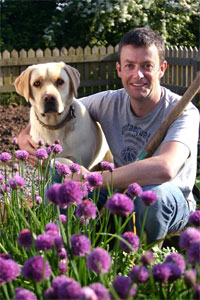 We have tried to reinvent the meitheal in our GIY groups – gangs of 5-10 people meet up in someone’s garden to do a job like building raised beds or shoveling manure. Our buddy Dave has been on crutches for a few months and as a result he’s understandably a little behind on this year’s GIYing. So about 10 of us showed up with spades and forks and got the place sorted for him while he sat in a chair and supervised with a twinkle in his eye!
We have tried to reinvent the meitheal in our GIY groups – gangs of 5-10 people meet up in someone’s garden to do a job like building raised beds or shoveling manure. Our buddy Dave has been on crutches for a few months and as a result he’s understandably a little behind on this year’s GIYing. So about 10 of us showed up with spades and forks and got the place sorted for him while he sat in a chair and supervised with a twinkle in his eye! The work done is fantastic, but it’s the sense of camaraderie and banter that really stands out. There’s a unique joy in a gang of people rolling up their sleeves and digging in to help a neighbour.
If there’s one downside to a meitheal it’s this: you may never want to go back to working by yourself in your garden again!
Things to do in May
To-Do
May is the time to get those outdoor beds ready for early summer transplanting. Fork over and rake. Earth up potatoes as the plants develop. Put protective barrier around your carrots to thwart the dastardly carrot root fly. Regularly hoe weeds and mulch. Water plants if required. Support tomato, bean and pea plants with twiggy sticks, pea netting, timber supports with chicken wire, or existing fence or hedge. Pinch out the growing tips of broad beans plants to help prevent Blackfly.
Sow
Indoors for planting on later: basil, dill, coriander, courgette, cucumber, sweet corn, pumpkins.
Outdoors: winter cauliflower, cabbage, kale, spinach, sprouting broccoli, leeks, beans (French, Runner, Climbing French), beetroot, parsnip, turnip, swedes, radish, lettuce, peas, broccoli, rocket, carrots.
Harden off and begin to plant out seedlings you have lovingly raised indoors – e.g. tomatoes, cucumber, peppers, brussels sprouts, sprouting broccoli, cabbages, sweet corn, leeks.
 Harvest
HarvestMay is another tricky “gap” month as stores continue to dwindle. Continue picking asparagus, purple sprouting broccoli, radish, rhubarb, cabbage, cauliflower, spinach and chard. May is likely to see the first real bumper salad leaves like lettuce and rocket – as well as the first garlic, beetroot and globe artichokes.
Recipe of the Month – PSB with anchovy and chilli dressing
We have been harvesting purple sprouting broccoli (PSB for short) since March and we’re still not bored with it. I always reach for this recipe from Hugh Fearnley Whittingstall – it’s a sinch to make and proves that PSB can be a meal in itself (or at the very least an exciting starter).
Ingredients:
• 700g PSB or curly kale
• 50g anchovy fillets
• 150ml olive oil
• 2 garlic cloves
• fresh thyme
• ½ small red chilli (or a pinch dried flakes)
• 1 teaspoon dijon mustard
• 2 teaspoons red wine vinegar
Blend all the ingredients bar the PSB in a blender until smooth. Steam the PSB for just 3-4 minutes. Toss in a knob of butter.
Warm the dressing over a low heat adding a knob of butter.
Arrange the PSB on a plate and drizzle over the dressing.
Serve with crusty bread to mop up the juices.
Tip of the Month – Making a Home-Made Cloche to protect seedlings
This month’s tip comes from GIY patron Klaus Laitenberger who writes a weekly tip on our website (The Klaus Korner).
“Make a frame using 2”x 2” timber. The width of the frame should match the width of your bed. The length can be 3 or more metres. Drill holes through the sides at 50cm intervals on each side wide enough to hold a strong flexible plumping pipe. Then cover with bionet and fix it onto the frames. It’s crucial though to use bionet rather than clear plastic. Most cloches are covered with clear plastic, but you will have to ventilate every day and water regularly and then when you finally remove it your poor plants will get quite a shock. With the bionet you don’t force your plants too much, but they are safe from strong winds. The rain will get through it so there is no need to water your plants.”
We are trying to get 100,000 people to take a pledge to grow something they can eat – take the GIY pledge at www.facebook.com/giyireland.
------------------------------------
 Michael Kelly is a freelance journalist, author and founder of GIY Ireland.
Michael Kelly is a freelance journalist, author and founder of GIY Ireland.GIY is a registered charity that inspires people to grow their own and gives them the skills they need to do so successfully. There are 80 GIY groups around Ireland and 6,000 GIYers involved.
For more tips, information and support visit www.giyireland.com.
© GIY Ireland 2011 – all rights reserved.
Grow it Yourself - June
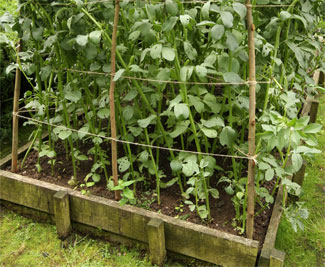
 Did a lot of transplanting this weekend, which is always a fun activity for a GIYer. There’s nothing like the satisfaction of planting seedlings – bare beds transformed in an instant with neat rows of little plants.
Did a lot of transplanting this weekend, which is always a fun activity for a GIYer. There’s nothing like the satisfaction of planting seedlings – bare beds transformed in an instant with neat rows of little plants. There are always a few days of fretting after transplanting however – will cold nights set the plants back? Will slugs or rabbits try and munch on them?
Seed sowing is a relatively exact science – if you sow a seed at the right temperature and at the right depth, and you keep the potting compost moist, then it will generally germinate rather reliably.
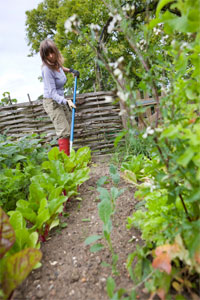 In addition, up to the point that they are transplanted, the seedlings have luxuriated in the 5-star comfort of my potting shed. They have been nurtured, spoiled, cossetted. I’ve carefully watered them each day, switched on heat underneath them at night and covered them with fleece.
In addition, up to the point that they are transplanted, the seedlings have luxuriated in the 5-star comfort of my potting shed. They have been nurtured, spoiled, cossetted. I’ve carefully watered them each day, switched on heat underneath them at night and covered them with fleece. The potting shed is a controlled environment – there is no weather in there – no rain or wind. Nor are there any pests to trouble them – leather jackets, slugs, snails, birds or rabbits.
Planting a seedling out in the soil therefore is a watershed moment. It is the moment it leaves a very controlled environment in favour of something far more uncontrolled, unpredictable and messy. And like a parent sending a child off to school for the first time, you just have to have faith and let it go in to the mad, bad world!!
 Things to do this Month
Things to do this Month To-Do
Watering and weeding duties step up a notch – the tunnel/greenhouse in particular will require a good deal of water from now on. Watch the weather and water outside as required. Continue to earth-up potato plants to prevent the spuds becoming green. Mulch and water tomato plants and continue to remove side shoots that appear in the leaf axils. Stake everything that grows tall – raspberries, peas, beans, tomatoes etc. Net soft fruit against birds – it’s worth the effort.
Sow
Sow courgettes, pumpkins, summer and winter squash, fennel, chicory.
Succession sow: beans (French and Runner), kale, pea, spinach, spinach beet, summer broccoli, carrot, swede, leek, lettuce, Brussels sprouts, beetroot, chicory, endive, turnip, kohlrabi, fennel.
Plant out: leeks, Brussels Sprouts, cabbage, autumn cauliflower, calabrese, sprouting broccoli, celery, celeriac, cucumbers, pumpkin, marrows, runner beans, aubergine.
Harvest
We are now really starting to see some payback from our GIYing - the first broad beans and peas as well as new potatoes, new carrots, soft fruit like gooseberries, cherries and strawberries. Herbs are in full flow. Also harvest kohlrabi, cabbage, cauliflower (month end), spinach, spring onion, shallots, salad leaves, elderflower, rhubarb, salad leaves, onions, carrots, beetroot, garlic, sea-kale.
Recipe of the Month – Broad Beans with Bacon
June is broad bean month – I love opening up the pods and seeing the little beans nestling in the comfy white fleece inside. The little green gems love to be paired with bacon. This recipe serves 4-6.
Ingredients:
• 30g butter
• 4 slices unsmoked bacon
• 1 medium onion, finely chopped
• 500g broad beans, shelled
• 125ml stock
Melt the butter in a pan. Add the bacon and onion and fry until the onion is soft but not coloured. Stir in the beans. Add the stock and bring to the boil. Cover and cook over a moderate heat for 6-8 minutes until the beans are soft but not mushy. If there is too much liquid in the pan at the end, boil briskly for 1-2 minutes to evaporate it. Serve immediately – this will make a lovely side dish or served by itself with some crusty or toasted bread.
Tip of the Month – Comfrey “tea”
Comfrey is a perennial herb that you can grow to harvest the leaves for an excellent liquid organic fertilizer. It has been found to contain as many nutrients as commercial tomato feeds. Harvest comfrey leaves and shove them in a bucket with a lid. Weigh the leaves down with a brick or something else heavy. Drill a hole in the base of the bucket and place a container underneath. As the leaves rot down a black liquid will start to drip down from the bucket in to the container. This is your comfrey feed. Dilute one part comfrey liquid to 15 parts water.
------------------------------------
We are trying to get 100,000 people to take a pledge to grow something they can eat – take the GIY pledge at www.facebook.com/giyireland.
 Michael Kelly is a freelance journalist, author and founder of GIY Ireland.
Michael Kelly is a freelance journalist, author and founder of GIY Ireland.GIY is a registered charity that inspires people to grow their own and gives them the skills they need to do so successfully. There are 80 GIY groups around Ireland and 6,000 GIYers involved.
For more tips, information and support visit www.giyireland.com.
© GIY Ireland 2011 – all rights reserved.
Grow it Yourself - July
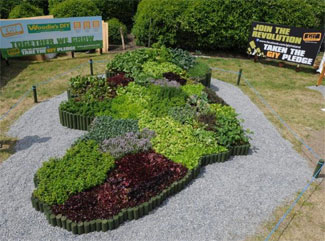
 A supermarket is a place where there are no seasons. You can buy any vegetable you want at any time of the year. Want a butternut squash in May? Your local supermarket probably has one for sale, though it was most probably grown in Ghana and spent weeks in the back of a container lorry. For all its technological wizardry, there is a terrifying blandness about the modern food chain, with its continuous, year-round supply of mediocre, uniform produce.
A supermarket is a place where there are no seasons. You can buy any vegetable you want at any time of the year. Want a butternut squash in May? Your local supermarket probably has one for sale, though it was most probably grown in Ghana and spent weeks in the back of a container lorry. For all its technological wizardry, there is a terrifying blandness about the modern food chain, with its continuous, year-round supply of mediocre, uniform produce.The veggie patch on the other hand, is a place where thankfully, the seasons still hold sway in all their riotous glory. Seasonality is not without its frustrations of course (it involves a lot of waiting for one thing), but at least it brings diversity and variety in its wake. Vegetables were never designed to be available all year round - the wax and wane of the seasons is part of their nature.
 Summer is truly a time of plenty for GIYers - a time when we perhaps start to struggle to keep up with the output of the veggie patch. Though the work is hard, we can also take time to enjoy the fruits of our labour.
Summer is truly a time of plenty for GIYers - a time when we perhaps start to struggle to keep up with the output of the veggie patch. Though the work is hard, we can also take time to enjoy the fruits of our labour. Savour the taste of produce that is organic, local and seasonal. Celebrate its diversity. If you grew a crazy-shaped carrot or a foot-long courgette, congratulate yourself on having produced something utterly unique, which your supermarket wouldn't even let inside the door!
Things to do this Month
To-Do
Any ground that has finished cropping must be quickly cleared away to take more vegetables. Use your produce - eat it, freeze it, process it, exchange it, give it away. Continue to water and feed plants and practice good weed control.
Earth up brassicas such as Brussels sprouts - these plants will grow tall and require a good deal of support. Net plants to keep butterflies and the cabbage moth away.
Cut down legume plants that have finished cropping - leave the roots in the soil as they fix nitrogen in the soil. Give pumpkins plenty of water and apply a high-potash liquid feed.
Sow
Continue successional sowings and use quick maturing varieties for autumn use - Swiss chard, lettuce, rocket, salad onions, radish, turnips, peas, French Beans (dwarf), carrots.
Sow for winter use - spring cabbage, Hungry Gap kale, parsley, perpetual spinach, chicory and coriander. Plant strawberries now for a good crop next June. Propagate rosemary, sage and mint from cuttings now.
Harvest
July and August are peak months for produce – enjoy it! First crops of French and runner beans, tomatoes, peppers, cucumbers, courgette and aubergine, marrows, beetroot, globe artichokes.
Continue to harvest new potatoes, calabrese, cauliflower, cabbage, spinach, carrots, turnips, shallots, garlic, radish, spring onions, salad crops, strawberries, raspberries, tayberries, currents (black, red and white), gooseberries, loganberries, peas, broad beans.
Ask yourself – do you really need to go to the supermarket?!
Recipe of the Month – Ratatouille
Ratatouille is a classic summer dish that makes great use of veggie patch “gluts”. It can fairly be described as “fiddly”, but I think it’s worth it. This serves four.
Ingredients:
• 5 super ripe tomatoes
• 3 courgettes – cut in to slices
• 2 aubergines – cut in to chunks
• 2 red or yellow peppers – sliced
• 1 onion, peeled and sliced
• 2 garlic cloves , peeled and crushed
• 5 tbsp olive oil
• bunch of basil
• 1 tbsp red wine vinegar
• 1 tsp sugar
Start by doing all your choppin’ and slicin’.
Score a cross on the base of each tomato, then put them into a bowl. Pour boiling water over the tomatoes and leave for half a minute, then pour off the water. Cover them with cold water and leave to cool – the skin should come off easily now. Remove the seeds from the tomatoes and roughly chop.
Heat 2 tbsp of the oil in a sauté pan and brown the aubergines on each side, then set aside. Next up brown the courgettes in a little more oil and set aside. Then do the same with the peppers.
Cook the onion for 5 minutes, add the garlic and fry for a further min. Stir in the red wine vinegar and sugar, then tip in the tomatoes and half the basil. Return the vegetables to the pan with some salt and pepper and cook for 5 mins. Garnish with the rest of the basil and serve with some crusty bread.
Tip of the Month – Which plants need lots of water?
Which veg plants need a lot of watering in dry weather and which can ones can withstand a bit of a drought? It’s difficult to come up with a definitive list, but here are some guidelines. Leafy vegetables like brassicas, lettuce, spinach and celery needs lots of water - 10-15 litres per square meter a week.
Fruiting veg like toms, peas, beans, cucumbers need heavy watering when they are flowering and fruits are starting to swell. Too much watering of root crops will encourage lush foliage rather than good roots - in early stages water only if soil is drying out but more is required when roots are swelling.
------------------------------------
We are trying to get 100,000 people to take a pledge to grow something they can eat – take the GIY pledge at www.facebook.com/giyireland.
 Michael Kelly is a freelance journalist, author and founder of GIY Ireland.
Michael Kelly is a freelance journalist, author and founder of GIY Ireland.GIY is a registered charity that inspires people to grow their own and gives them the skills they need to do so successfully. There are 80 GIY groups around Ireland and 6,000 GIYers involved.
For more tips, information and support visit www.giyireland.com.
© GIY Ireland 2011 – all rights reserved.
Grow it Yourself - August

 Harry's Restaurant has been getting rave reviews and much-deserved plaudits of late. Run by Donal Doherty, the restaurant is bucking the recessionary trend by attracting people in their droves to the remote Inishowen peninsula in Donegal. How are they doing it? By serving only the freshest, local and seasonal produce, and by growing their own grub. “We had good local sources for some summer salads, herbs, root vegetables and potatoes, but outside that we were reliant largely on imports,” says Doherty.
Harry's Restaurant has been getting rave reviews and much-deserved plaudits of late. Run by Donal Doherty, the restaurant is bucking the recessionary trend by attracting people in their droves to the remote Inishowen peninsula in Donegal. How are they doing it? By serving only the freshest, local and seasonal produce, and by growing their own grub. “We had good local sources for some summer salads, herbs, root vegetables and potatoes, but outside that we were reliant largely on imports,” says Doherty.
Doherty turned to GIY for help. In late 2010 he established GIY Inishowen and based the fledgling group at the restaurant. Suitably inspired, Doherty worked to convert a neighbour’s disused walled garden in to a thriving vegetable garden for the restaurant. “Linking up with GIY networked us into a community of growers and sparked ideas on how we could develop a kitchen garden. We are nearly self sufficient already in salads and herbs.”
.jpg) The garden has yielded produce that they can’t source locally such as tomatoes, celery, cabbage, beans, peas and albino beetroot, and in the summer months, every salad and vegetable right down to the purees and flowers on the plate will be coming out of the garden.
The garden has yielded produce that they can’t source locally such as tomatoes, celery, cabbage, beans, peas and albino beetroot, and in the summer months, every salad and vegetable right down to the purees and flowers on the plate will be coming out of the garden.
His advice for peers in the industry? “At the very least restaurants should consider having a herb patch. I know our herb bill alone ran in to thousands last year. I’d say give it a try.”
Things to Do this Month – August
To-Do
Green manures (mustard, buckwheat, radish, rye, alfalfa, clover and vetches) are plants which are grown specifically to improve soil fertility and useful at times when beds are empty (as is often the case in August). Grow directly in the bed and then cut down and dig in to the soil.
Give pumpkins plenty of water and apply a high-potash liquid feed. Nip out the growing points to encourage the fruits to swell.
Net brassicas to keep butterflies and the cabbage moth away (and check undersides of leaves regularly for caterpillars). Keep watering - mulch around plants to retain moisture.
Sow
Continue succession sowing. Sow spring cabbage, red cabbage, winter spinach, salad onions (in polytunnel for spring crop), autumn salad mix, endive, parsley, onion seed, Chinese vegetables.
Pick Beetroot regularly as they reach the size you require - if left to grow too large they will lose their tenderness.
Harvest
Continue to harvest beetroot, tomatoes, carrots, cabbage, cauliflower, peas, broad beans, french and runner beans, salad leaves, radish, turnip, potato, onions, peppers and chilli-peppers, aubergine, globe artichoke, courgettes, cucumber, gooseberries, raspberries and currants.
Recipe of the Month – Pea and Mint Soup
You might baulk at the idea of eating soup in August, but thanks to the mint and peas this is a super-refreshing soup and can be eaten hot or cold.
Ingredients:
• 1 bunch spring onions, chopped
• 1 potato, peeled and diced
• 1 garlic clove, crushed
• 850ml vegetable or chicken stock
• 250g shelled peas
• 4 tbsp chopped fresh mint
• large pinch caster sugar
• 1 tbsp lemon juice
Put the spring onions into a large pan with the potato, garlic and stock. Bring to the boil and simmer for 15 minutes or until the potato is soft.
Add the peas to the soup base and simmer for 5 minutes. Stir in the mint, sugar and lemon juice and then blitz with a hand blender until smooth. Season with salt and pepper. Serve garnished with some sour cream.
Tip of the Month – Earthing Up Leeks
A GOOD leek (from a culinary perspective) has got a substantial amount of white flesh and a short green top. A BAD leek has lots and lots of green top and only a short amount of white flesh. The key to getting the former rather than the latter is to "earth up" leeks at this time of the year to encourage blanching or bleaching of the stems (similar to what you do with celery).
This is achieved by drawing soil up around the stem to exclude light. Be careful not to draw soil over the top of the leek - you will end up with soil down the inside of the leek which will be a nightmare to remove when cooking. Incidentally, a leek "stem" is not in fact a stem at all, but a series of tightly rolled leaves.
A cleaner method than using soil to earth up, is to pop the insert from a kitchen roll around the leek.
 Date for your Diary
Date for your Diary
The 3rd national GIY Gathering takes place in Waterford on September 10th and 11th 2011 as part of the Waterford Harvest Festival. Over 30 workshops, demos, discussions, debates, forages, tours and events. Come along and represent your veggie patch, village, town, community or GIY group. Tickets from www.giyireland.com.
------------------------------------
We are trying to get 100,000 people to take a pledge to grow something they can eat – take the GIY pledge at www.facebook.com/giyireland.
 Michael Kelly is a freelance journalist, author and founder of GIY Ireland.
Michael Kelly is a freelance journalist, author and founder of GIY Ireland.
GIY is a registered charity that inspires people to grow their own and gives them the skills they need to do so successfully. There are 80 GIY groups around Ireland and 6,000 GIYers involved.
For more tips, information and support visit www.giyireland.com.
© GIY Ireland 2011 – all rights reserved.
Grow it Yourself - September
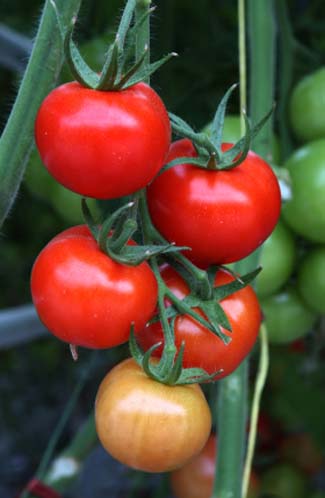
 If you allow it to be, the harvest can be a time of incredible celebration, and it is quite right that it should be so. We should be celebrating at this time of the year even though it might be kind of quaint to do so. The joy of the harvest is something that the food chain’s assault on seasonality has deprived us of, for if every vegetable is available all the year round, then of course there is no reason to celebrate the harvest months.
If you allow it to be, the harvest can be a time of incredible celebration, and it is quite right that it should be so. We should be celebrating at this time of the year even though it might be kind of quaint to do so. The joy of the harvest is something that the food chain’s assault on seasonality has deprived us of, for if every vegetable is available all the year round, then of course there is no reason to celebrate the harvest months. As GIYers, we reclaim the joy of the harvest: fruit trees laden down with fruit and the veggie patch heaving with produce; lifting crops and getting them in to storage; shelling, dicing, chopping and pickling in preparation for the winter months ahead. Don’t forget to take time to enjoy the fruits of your labour and have heroic meals in convivial company!
 Here at GIY HQ we are busy with our own harvesting, but we’ve also just enjoyed the annual GIY Gathering which took place in Waterford City on September 10th and 11th. It was the largest meeting EVER in Ireland of people that are interested in growing their own food, and was a wonderful opportunity to celebrate the harvest and to get inspiration from other GIYers from across the country.
Here at GIY HQ we are busy with our own harvesting, but we’ve also just enjoyed the annual GIY Gathering which took place in Waterford City on September 10th and 11th. It was the largest meeting EVER in Ireland of people that are interested in growing their own food, and was a wonderful opportunity to celebrate the harvest and to get inspiration from other GIYers from across the country. There were over 40 workshops, talks, demos, panel discussions, debates, expert Q&As, and forages over the two days with speakers includinging Joy Larkcom, Bob Flowerdew, Darina Allen, Ella McSweeney, Suzanne Campbell, John McKenna, Klaus Laitenberger and yours truly.
Things to Do this Month – September
To-Do
Lift crops which have finished growing and dress bare soil with manure, compost (or plant green manures). Wasps can be problematic as fruit ripens so make traps from jars of sugary water. Remove surplus leaves from tomato plants which allows air to circulate and sunshine to fall on the fruit. Go blackberry picking!
Sowing Seeds
Last month for sowing perpetual spinach, chard and oriental salads – it will be worth it in the New Year when there’s almost nothing else to eat, so get sowing! In the polytunnel/greenhouse sow lettuce, mustard, coriander, parsley, radish, dwarf early pea, broadbean, cauliflower seed, rocket, onion seed and garlic. Outside sow white turnip seeds and autumn onion sets, e.g. ‘centurion’ and ‘sturon’. Plant out strawberry runners. Pot up some parsley for winter use.
Harvest
Summer vegetables and fruit are joined by the great autumn veg like parsnips, swedes and celeriac. Lift onions and leave to dry out in sun or in the polytunnel/greenhouse for two weeks. Apples, plums, pears are now in season. Continue to harvest salad leaves, tomatoes, radish, potatoes, carrots, turnips, beetroots, cauliflower, cucumbers, peppers, beans, courgettes, spinach, leeks, red cabbage, summer cabbage, aubergine, sweet corn.
Recipe of the Month – Piccalilli
Cauliflower needs to be harvested as soon as it’s ready (you can’t leave it in the ground or the curds start to open) and it doesn’t store particularly well once picked – so here’s a good recipe for an exotic pickle called Piccalilli that will help you keep it for 6 months. It also uses up some of those other “glut” vegetables like beans and courgettes.
Ingredients
• 1 large cauliflower
• 2 large onions, peeled and quartered and sliced finely
• 900g mixed veg such as courgette, runner beans, carrots and green beans – cut in to bite sized chunks
• 60g salt
• 2tbsp plain flour
• 225g sugar
• 1 tbsp turmeric
• 60g English mustard powder
• 900ml pickling Vinegar
Put all the vegetables in a large bowl. Dissolve the salt in 1.2l of water and pour this over the veg. Put plate on top to keep them submerged and leave for 24 hrs. Drain and rinse the next day.
Bring a large pan of water to the boil – add the veg and blanch for 2 minutes. Drain and refresh in cold water.
Put flour, sugar, turmeric and mustard in a small bowl and mix in a little of the vinegar to make a paste.
Put it in a large stainless steel saucepan along with remaining vinegar, bring to the boil and stir continuously so that no lumps appear. Reduce heat and simmer for 15 mins.
Add veg to the sauce and stir well so they are coated. Ladle in to sterilised jars and use a non-metallic lid to seal. Allow to mature for one month before using. This recipe will make 5lbs.
 Tip of the Month – Saving Tomato Seeds
Tip of the Month – Saving Tomato SeedsIf you had a variety of tomato that was a particular success this year, why not try saving the seeds from the tomatoes to grow next year’s plants? You should only save seed from open-pollinated varieties of tomatoes, and not hybrids.
Pick a nice big, ripe tomato and cut it in half. Squeeze the contents (seeds, gel and juice - not flesh) in to a cup or container and label the cup with the variety. Half fill the cup with water. After a few days a mould will form on the water, which is a sign that the seed coating has dissolved.
Pour off the water and any floating seeds (these are duds that wont germinate). The good seeds should be on the bottom of the cup. Rinse the seeds under a cold tap in a very fine mesh strainer.
Put the seeds in a single layer on a paper plate and leave for a few days to dry. Bag them up in a labelled envelope and store them somewhere cool (or refrigerate) until next spring.
------------------------------------
We are trying to get 100,000 people to take a pledge to grow something they can eat – take the GIY pledge at www.facebook.com/giyireland.
 Michael Kelly is a freelance journalist, author and founder of GIY Ireland.
Michael Kelly is a freelance journalist, author and founder of GIY Ireland.GIY is a registered charity that inspires people to grow their own and gives them the skills they need to do so successfully. There are 80 GIY groups around Ireland and 6,000 GIYers involved.
For more tips, information and support visit www.giyireland.com.
© GIY Ireland 2011 – all rights reserved.
Grow it Yourself - November
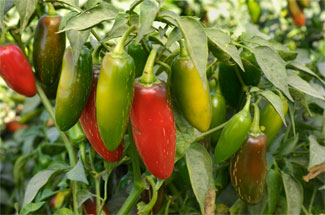
 It was World Food Day last month and as I always do with these vast global events, I tried to think about it down at the only level that makes any sense to me – my vegetable patch. One of my main motivations for growing my own food is that supermarkets just don’t provide any real variety when it comes to fruit and vegetables.
It was World Food Day last month and as I always do with these vast global events, I tried to think about it down at the only level that makes any sense to me – my vegetable patch. One of my main motivations for growing my own food is that supermarkets just don’t provide any real variety when it comes to fruit and vegetables. There is an assumption that because our world is so small now, we have access to a vast array of new and exotic vegetables from all over the globe. In fact, ever more powerful trans-national supermarkets are forcing food producers in to the strait-jacket of mono-culture – producing higher yields of ever-decreasing varieties of vegetables.
What does this really mean? Whereas two decades ago you could find 10 or 15 varieties of apples or tomatoes in a supermarket – now there are just a couple. And in all likelihood they will be same varieties available in a supermarket in Spain or America or Asia. Almost all (90% plus) of the apples on sale in supermarkets around the world are of just 5 varieties. 75% of the world's agricultural diversity has been lost in the last century according to the UN Food and Agriculture Organisation.
 This tragic blandness suits retailers who are only interested in bulk selling, but its terrible for bio-diversity, taste and variety. The beauty of the veg patch is the diversity it offers us. We have at our fingertips a smorgasbord of varieties for each veg that we can dip in to each season.
This tragic blandness suits retailers who are only interested in bulk selling, but its terrible for bio-diversity, taste and variety. The beauty of the veg patch is the diversity it offers us. We have at our fingertips a smorgasbord of varieties for each veg that we can dip in to each season. We can grow vegetables that you rarely get at all in a supermarket like kohlrabi, artichokes or Florence fennel. We can grow a variety of tomato that we know to be particularly tasty (the revelation for me this year was Sungold – the fizzbomb of the tomato world). In short, we are empowered.
Things to do this month - November
To Do
Do not leave beds bare for the winter – sow a green manure, or cover with a thick layer of manure/compost and then black plastic or straw. This will return nutrients to the soil, keep the worst of the weather off it, suppress weeds and prevent leaching of nutrients.
‘Earth up’ or tie up vegetables such as cabbage, cauliflower and Brussels sprouts. Divide up your rhubarb if you want to propagate, and cover it with a thick mulch of manure. Prune apple trees. Mulch fruit bushes. Take cuttings of currant bushes from current season’s wood.
Sow
Sow broad beans outside now for an early crop next spring. To avoid rotting before germination, make small newspaper cups and germinate them indoors first. Next summer’s garlic does best if it’s planted before Christmas – plant outdoors in well prepared soil in a sunny spot.
Though I have to admit I never bother with them, some varieties of onion can over-winter and will be ready to harvest in early summer.
Harvest
Continue to harvest perpetual spinach, cabbage, cauliflower, potatoes, swede, parsnips, apples, pears. Start harvesting leeks, winter cabbage, kale, artichokes, Brussels sprouts. Time to lift carrots and turnips or at least cover them with a good layer of straw to protect them from frost damage.
Recipe of the Month – Rabbit Stew
Our red setter has a tendency to come home from winter walks carrying a rabbit – a quick skinning and some knife work, and you’ve a cracking winter stew in prospect. Many butchers will source wild rabbit for you if you ask. Since rabbit is a very lean meat, the bacon bring the necessary fat to the equation.
Serves 4.
Ingredients
• 250g streaky bacon
• 1 wild rabbit, skinned and jointed (1.5-1.8kg)
• Chopped vegetables and herbs – whatever your veggie plot has to offer you: veg (a few cloves of garlic, a large onion, three good sized carrots and a stalk of celery) and herbs
• 600ml stock and glass of white wine
Directions
Cut the bacon in to cubes and fry it in some oil – remove to a casserole dish. Fry the rabbit pieces until golden brown. Add to the casserole. Throw the veggies in to the pan and get the juices from the cooked meat all over them before putting them in with the meat.
Deglaze the pan with the stock and pour that in to the casserole with the wine. Add the chopped herbs and season. Bring to the boil, cover and transfer to a hot oven for 90 minutes. Serve with mashed spuds.
Tip of the Month – Overwinter your Chilli plants
Chilli pepper plants are not annuals at all and can in fact be overwintered and used again next year. This method is reputed to give you a better and earlier crop the following year. Dig up the plants carefully and remove any remaining fruit and foliage - cut the stem back to about 15cm. Pot up in some fresh potting compost and leave it on a sunny windowsill indoors - it won't survive outside. The plant will burst back to life in the spring and will produce fruit earlier than spring-sown plants.
------------------------------------
We are trying to get 100,000 people to take a pledge to grow something they can eat – take the GIY pledge at www.facebook.com/giyireland.
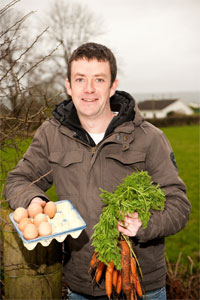 Michael Kelly is a freelance journalist, author and founder of GIY Ireland.
Michael Kelly is a freelance journalist, author and founder of GIY Ireland.GIY’s purpose is to transform people’s health and wellbeing, stenghten communities and protect the environment by empowering people to grow their own food. We do this by bringing people together in communities and online to share tips and information. There are nearly 100 GIY groups around Ireland and 12,000 GIYers involved.
For more tips, information and support visit www.giyireland.com.
© GIY Ireland 2011 – all rights reserved.
Grow it Yourself - December
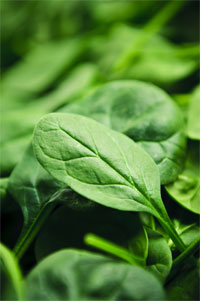
 I had a bit of a panic last weekend when it occurred to me that I hadn’t sown anywhere near enough spinach or chard when I did my ‘winter sowing’ back in September. I’m a big fan of spinach, particularly in the winter months when there are few other sources of leafy greens in the vegetable patch.
I had a bit of a panic last weekend when it occurred to me that I hadn’t sown anywhere near enough spinach or chard when I did my ‘winter sowing’ back in September. I’m a big fan of spinach, particularly in the winter months when there are few other sources of leafy greens in the vegetable patch. I love using tiny little spinach leaves in salads and larger ones in stir-fries, soups and the likes. But problem is, I reckon I only have enough left in the veg patch to see me up to Christmas. Which would leave with me with at least 2-3 months in the New Year ‘spinach free’.
Spinach is a nutritional powerhouse – calorie for calorie it provides more nutrients than any other food. It is rich in vitamins and minerals, and concentrated anti-oxidant phytonutrients. It is thought to be anti-inflammatory and anti-cancer, and provides more than you could ever need of vitamins A, C and K (over 1000% of your recommended intake). It’s no wonder that it made Popeye so healthy. Nutritionists recommend a one-cup serving of spinach, at least twice a week.
 So anyway last weekend I decided to sow another tray of spinach, more in hope than expectation really (given that we’re in the middle of Winter and most grower’s guides advise not sowing it beyond September). I put the module tray on a warming mat in the potting shed and lo and behold within 3 or 4 days it germinated and is already showing very promising signs of life.
So anyway last weekend I decided to sow another tray of spinach, more in hope than expectation really (given that we’re in the middle of Winter and most grower’s guides advise not sowing it beyond September). I put the module tray on a warming mat in the potting shed and lo and behold within 3 or 4 days it germinated and is already showing very promising signs of life. I assume the constant ‘heat from beneath’ was instrumental in helping it to germinate, but either way it gave me such a buzz to see anything germinate at this time of the year. I will be planting it out in the polytunnel in a few weeks, where I assume it may need a fleece covering in very cold weather.
Here’s hoping for a healthy crop of baby leaves in January. Happy Christmas from GIY.
Things to do this month
To Do
As you clear remaining crops from your veggie patch, dig the beds over and add well rotted compost or manure. Get Educated – book yourself on a course! Start planning what you would like to grow next year and work out what crop rotation system you are going to use. Study seed catalogues carefully before deciding on the best varieties to grow. Start a Compost corner or heap. Keep an eye on your stored veggies and discard anything that’s rotting. Collect and store leaves in bags to make leaf mould or use as cover for bare soil.
Sow
If you haven’t already done so plant garlic – it should be in the soil by the shortest day of the year. Bring herbs like mint, chives, lemon balm, parsley, thyme indoors by lifting and potting them up.
Harvest
Buck the seasonal trend by continuing to harvest winter salad leaves like corn salad, land cress and mizuna. You should still have at least some produce left in the December veggie patch e.g. winter cabbages, Brussels sprouts, leeks, kale, Jerusalem artichokes, carrots, celery, turnips, parsnips, winter cauliflowers, swedes, spinach, chard and celeriac.
From your stores you can enjoy pumpkins and squashes, potatoes, onions, apples, beetroot and garlic.
Recipe of the Month – How to Cook Spinach
The key to preserving the nutritional value, flavor and consistency of spinach is NOT to overdo the cooking. A couple of minutes in a pan is more than enough.
Ingredients:
• 2 large bunches of spinach, about 1 lb
• 2 tablespoons olive oil
• 3 cloves garlic, sliced
Directions:
Cut off the thick stems of the spinach and discard. Rinse the spinach under a tap to remove any soil or dirt. Put the spinach in a lettuce spinner to remove any excess moisture – this is important.
Heat the olive oil in a large pan on a medium heat – add the garlic and cook gently for about 1 minute, until the garlic is just beginning to brown. Add the spinach and turn it with a spatula so that it all gets covered in the oil and garlic.
Cover the pan and cook for 2 minutes, turning it once. You want to get it out of the pan just as it wilts.
Drain any excess moisture from the pan and serve it up. Add a little more olive oil and then season to taste. A tablespoon or two of soya sauce and a sprinkle of sesame seeds, added just before serving will liven things up a bit and give it an asian aroma.
Tip of the Month – How to Grow Spinach
Given its propensity to bolt, succession sowing is the key if you want a constant supply of spinach during the season. Sow in module trays, 1.5 cm deep every three weeks from April to September. Sow three or four seeds in each module.
You can also sow direct in the soil outside if you wish, but slugs can be a problem as the tiny seedlings are getting established. Transplant to final growing spot, leaving 25cm between rows and 7-15cm between plants (depending on whether you want baby leaves or regular ones).
Spinach can be grown pretty much anywhere and doesn’t need to be included in your rotation – use it as a flexible filler and for intercropping. Summer sowings should be done in partial shade to prevent bolting.
Water copiously particularly in summer – as soon as the plant dries out, it will bolt. Apply an organic liquid feed (nettle is good – high in nitrogen) if growth seems lacklustre.
------------------------------------
We are trying to get 100,000 people to take a pledge to grow something they can eat – take the GIY pledge at www.facebook.com/giyireland.
 Michael Kelly is a freelance journalist, author and founder of GIY Ireland.
Michael Kelly is a freelance journalist, author and founder of GIY Ireland.GIY’s purpose is to transform people’s health and wellbeing, stenghten communities and protect the environment by empowering people to grow their own food. We do this by bringing people together in communities and online to share tips and information. There are nearly 100 GIY groups around Ireland and 12,000 GIYers involved.
For more tips, information and support visit www.giyireland.com.
© GIY Ireland 2011 – all rights reserved.
Grow it Yourself - January
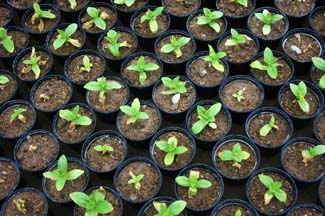
 Every year I worry a little about whether I will find enthusiasm for growing my own food again – what if the year turns and I just don’t have any interest any more? I always take a decent break from the veg patch in December – it’s the one month when there’s very little work to do and the garden will forgive you if you don’t show up.
Every year I worry a little about whether I will find enthusiasm for growing my own food again – what if the year turns and I just don’t have any interest any more? I always take a decent break from the veg patch in December – it’s the one month when there’s very little work to do and the garden will forgive you if you don’t show up. The “to-do” list is always full of things that no sensible person really bothers with – like cleaning your spade and mending fences and the like. So it’s a lazy month. But then BOOM, the clock moves over New Year’s Eve and in to New Year’s Day, and you wake up bleary eyed in to 2012 and according to all popular wisdom it’s now January and there’s loads of work to do again. How did that happen?
It doesn’t help of course that January can bring with it worse weather than December – it just doesn’t feel like spring, and of course officially it’s not spring – it’s still winter. The days are still short and cold and the garden is generally uninviting. Little wonder then that my enthusiasm for GIYing generally doesn’t show up until later in the year (usually March), when you can practically smell growth in the air.
 In the meantime, a trick I’ve discovered is to get stuck in to some seed sowing. The cold weather and short days make it tricky to grow seedlings well at this time of the year (they get “leggy” as they literally reach for the sunlight) but you can get around that by putting them on a bright windowsill and investing in a warming mat or cable which gives seeds ‘heat from beneath’.
In the meantime, a trick I’ve discovered is to get stuck in to some seed sowing. The cold weather and short days make it tricky to grow seedlings well at this time of the year (they get “leggy” as they literally reach for the sunlight) but you can get around that by putting them on a bright windowsill and investing in a warming mat or cable which gives seeds ‘heat from beneath’. At this time of the year stick to vegetables that need a long growing season like tomatoes and peppers (they will benefit ultimately from the head start) or very quick growing veg like salad crops (mizuna, salad rocket, mustards etc). Approach seed sowing at this time of the year with a devil may care attitude – they may grow or they may not but sod it, it’s still worth it – there’s simply nothing like seed sowing to get the GIY juices flowing again.
Happy New Year from GIY!
Things to do
To Do
Plan. This is the time to decide where and what you are going to grow this year. If you are just starting out join your local GIY group for advice and check out our website for handy “getting started” guides and videos.
Consider building or buying raised vegetable beds. Order your seeds, onions sets and seed potatoes. Turn over the soil in February only if the weather is dry – if the soil sticks to your boots it’s too early for digging! “Chit” seed potatoes – put them in a container (e.g. used egg carton or empty seed tray) and leave them in a bright warm place to sprout.
Sow
In mid Feb, in seed trays and pots on a sunny windowsill indoors sow celery, globe artichokes, celeriac, leeks, onions, lettuce, tomatoes, peas, aubergines, peppers/chilli-peppers. Weather permitting outside you can try sowing broadbeans, spinach, kohlrabi, onion and shallot sets, Jerusalem artichokes, parsnip and early pea varieties.
Harvest
You may still have winter cabbage, perpetual spinach, chard, leeks, kale, cauliflowers and Brussels sprouts in your veggie patch and depending on how successful your growing/storage regime last year was, you may well still be tucking in to stores of potatoes, celeriac, carrots, parsnips, onions, cauliflower, jerusalem artichokes, winter squash, pumpkins, leeks and red cabbage.
Recipe of the Month - Colcannon
Serves 4
I love the warming earthiness of colcannon – it’s my favourite way to eat cabbage. You can also use kale for this recipe.
Ingredients:
• 500g of cabbage – stalks removed and shredded
• 500g potatoes, scrubbed
• 2 sticks butter
• 150ml hot milk
• 4 spring onions, finely chopped
Steam the potatoes in their skins for a half hour, then peel and mash them. Add a lump of butter. Season well. Meanwhile steam the cabbage or kale in a small amount of boiling water until tender. Don’t overcook.
Put the milk in a pan and throw in the spring onions, simmering for about 5 minutes. Add this and the cabbage/kale to the spuds and beat well.
Serve with a knob of butter on top and sprinkle with some parsley. Some chopped ham or crispy bacon added in before serving also works a treat.
Tip of the Month – Don’t Tread on Me
Be careful not to get too enthusiastic about preparing soil at this time of the year. If you work on soil when it’s wet, it will damage the soil structure. If the soil sticks to your boots when you walk on it, then you shouldn’t be walking on it.
If you have to walk on the soil to get at your veggies, put a plank of timber down and walk on that instead. The timber distributes your weight more evenly. If you haven’t already done so, it’s worth covering down an area of your soil to warm it up – use a cloche or black polythene.
This will make the soil warm up far quicker than it would otherwise and will mean you can start sowing in it far earlier. In very wet weather it will also help to dry the soil out.
------------------------------------
We are trying to get 100,000 people to take a pledge to grow something they can eat – take the GIY pledge at www.facebook.com/giyireland.
 Michael Kelly is a freelance journalist, author and founder of GIY Ireland.
Michael Kelly is a freelance journalist, author and founder of GIY Ireland.GIY’s purpose is to transform people’s health and wellbeing, stenghten communities and protect the environment by empowering people to grow their own food. We do this by bringing people together in communities and online to share tips and information. There are nearly 100 GIY groups around Ireland and 12,000 GIYers involved.
For more tips, information and support visit www.giyireland.com.
© GIY Ireland 2012 – all rights reserved.
Grow it Yourself - February
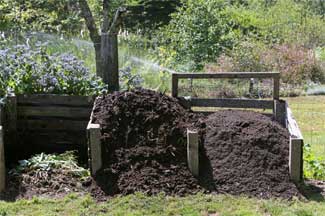
 The other evening I was going through some notes from a course on soil fertility I attended a few years back with Jim Cronin on his smallholding in Bridgetown, Co Clare. Jim is a rare breed – a wise sage who wears his considerable wisdom lightly.
The other evening I was going through some notes from a course on soil fertility I attended a few years back with Jim Cronin on his smallholding in Bridgetown, Co Clare. Jim is a rare breed – a wise sage who wears his considerable wisdom lightly. The two greatest materials for returning fertility to soil, he says, are seaweed and homemade compost. Both rank a "10" on his scale of fertility. Farmyard manure composted for one year ranks an "8" while fresh manure (oddly) only ranks a "7". On the other hand a very old farmyard manure heap with nettles growing on it only ranks about a "1", because all the nutrients have leached away.
So how do you make compost properly? ?Treat your heap not as place where you can happily dump all manner of stuff from the kitchen and garden, but with love and respect! It’s like making a loaf of bread - make sure you have the right mix of ingredients.
With compost you have to have a 50/50 mix of green and brown material and you have to build up the layers carefully.?The brown layer can consist of straw, hay, wood ash, cardboard, twigs, leaf mould, soil or garden "sweepings". ??The green layer should contain seaweed, farmyard manure (hens, pigs, ducks, cows etc), grass, hedge clippings and kitchen waste (veg only).
 Jim is a fan of completely open heaps - that is, you basically pick a corner of your garden and start a heap on bare soil which you dig roughly before you start (which encourages earth worms to come up through the heap). There are no "walls" but the basic measurements of it should be about 4ft wide and deep. Start with a brown layer such as straw or twigs of at least 10 inches.
Jim is a fan of completely open heaps - that is, you basically pick a corner of your garden and start a heap on bare soil which you dig roughly before you start (which encourages earth worms to come up through the heap). There are no "walls" but the basic measurements of it should be about 4ft wide and deep. Start with a brown layer such as straw or twigs of at least 10 inches. Turn the heap with a fork monthly to aerate it - cover it with cardboard or old carpet to keep the worst of the weather off it. Carry on adding alternate layers of 10 inches or so of brown and green. When you get to about 6ft high its time to move on to a new heap and let that one to rot down.
How long this takes depends on what’s in it - could be 4-6 months but you will know when its ready by the fact that you have a nice crumbly compost with few or no traces of straw in it - in other words that everything has rotted down. ?The overall goal is that you be self-sufficient in the material that you need to fertilise your soil - or as Jim puts it - you "close the gate on fertility". He estimates that you will get approx 20-30 wheelbarrows of compost from each heap you make.
That sounds a lot, but each spring you will need a wheelbarrow of compost for each square yard of veggie bed.
Things to Do This Month
To Do
Turn over the soil only if the weather is dry – if the soil sticks to your boots it’s too early for digging! Keep off the soil to prevent soil compaction - use timber planks to stand on for access.
If you have not already done so order/buy your seeds, spuds and onion sets. “Chit” or sprout seed potatoes – put them in a container (e.g. used egg carton or empty seed tray) and leave them in a bright warm place.
Check the pH of your soil – you can buy a soil pH testing kit in any garden centre. Lime your soil now if required (to reduce acidity in very acid soils), particularly important in your brassica bed.
Sow
Finally, we can sow some seeds. On a sunny windowsill indoors, in a heated greenhouse or on a heating mat: sow celery, globe artichokes, celeriac, leeks, onions, lettuce, tomatoes, peas, aubergines, peppers/chilli-peppers.
In polytunnel or greenhouse: beetroot, Brussels sprouts, summer and autumn cabbage, carrots, leeks, lettuce, radish.
Outside: Weather permitting you can try planting out broadbeans, spinach, kohlrabi, onion and shallot sets, Jerusalem artichokes, parsnip and early pea varieties.
Harvest
Winter cabbage and cauliflowers, Brussels sprouts, spinach, kale and leeks.
Recipe of the Month – Spinach and Cheddar Souffle
This recipe is from Donna Hay’s Modern Classics cookbook. The word souffle needn’t fill you with terror – it’s quite straightforward, if a little fiddly. If you are growing spinach and have your own hens, then this is really a ‘store-cupboard’ recipe that won’t require a trip to the supermarket.
Ingredients:
• 1 bunch spinach leaves (about 400g)
• 60g butter
• 4 tablespoons plain flour
• 3 cups milk
• 4 eggs, separated
• ½ cup grated cheddar
• a handful of breadcrumbs
Place the spinach in boiling water and remove after one minute and drain. Squeeze all the excess liquid from the spinach and then chop.
Melt the butter in a saucepan over a medium heat. Add the flour and stir until smooth. Whisk in the milk and stir briskly until the sauce thickens. Remove from the heat and stir through the spinach, egg yolks, cheese. Season well with salt and pepper. Allow to cool to room temperature.
Preheat the oven to 210 degrees celsius. Grease 4 x 1-cup capacity ramekins with butter and sprinkle with dry breadcrumbs to coat. Beat the egg whites in an electric mixer until soft peaks form. Gently fold one-third of the egg whites through the spinach mixture and then the remaining two-thirds. Spoon in to the ramekins and place them on a baking tray.
Bake for 15 minutes until puffed and golden. Do not open the oven door while cooking.
Tip of the Month – Rejuvenate perpetual spinach
Perpetual spinach plants may be looking a little tired at this time of the year but with the milder weather should also be showing signs of new growth, particularly at the centre of the plant. Cut the larger outer leaves with a sharp knife at the bottom of the stem so that the plant can concentrate on this new growth.
------------------------------------
We are trying to get 100,000 people to take a pledge to grow something they can eat – take the GIY pledge at www.facebook.com/giyireland.
 Michael Kelly is a freelance journalist, author and founder of GIY Ireland.
Michael Kelly is a freelance journalist, author and founder of GIY Ireland.GIY’s purpose is to transform people’s health and wellbeing, stenghten communities and protect the environment by empowering people to grow their own food. We do this by bringing people together in communities and online to share tips and information. There are nearly 100 GIY groups around Ireland and 12,000 GIYers involved.
For more tips, information and support visit www.giyireland.com.
© GIY Ireland 2012 – all rights reserved.
Grow it Yourself - March
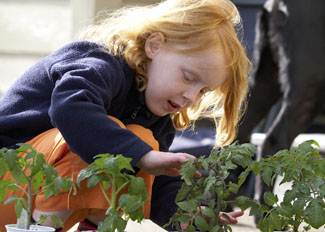
 One of the most incredible things about children is their innocence – they have (thankfully) almost none of the hang-ups that us adults are burdened with.
One of the most incredible things about children is their innocence – they have (thankfully) almost none of the hang-ups that us adults are burdened with. They approach life with a wide-eyed enthusiasm, devoid of cynicism or skepticism. They bring these same qualities with them when it comes to growing their own food. While we can be daunted by the complexity of growing veg, they view it as a tactile, sensory delight. They simply love new things to touch, smell and taste.
The difference between the two approaches can be best summed up thus: I was sowing apple seeds with my kids recently. In my mind I was thinking the following: “They will never grow. They’re probably the wrong variety. They haven’t watered them enough. If they do grow where am I going to plant them?” And the kids are just thinking: “Woohoo! We’re sowing seeds!”
 At GIY we think that one of the key ways we can help to make home-grown food the norm is to make sure that our kids are taught about GIYing in school. Using the school garden as a ‘living classroom’ makes perfect sense. Kids love wriggly worms and getting their hands dirty.
At GIY we think that one of the key ways we can help to make home-grown food the norm is to make sure that our kids are taught about GIYing in school. Using the school garden as a ‘living classroom’ makes perfect sense. Kids love wriggly worms and getting their hands dirty. They love sowing seeds and rummaging in soil. Teachers we’ve spoken to, tell us they love bringing the class outdoors and that it acts as a useful teaching aid for many aspects of the curriculum.
So we’re getting stuck in. Many of our GIY groups around Ireland are already doing Trojan work in their local schools providing advice and even manpower to help get kids growing.
We’re doing an exciting initiative called the Living Classroom with Bord Bia, SEED and the Blackrock Education Centre - the Living Classroom hub on our website will be a comprehensive, easy-to-use resource for schools that want to start a school garden.
And finally, we have launched a new campaign with Innocent to get Irish school kids to take the first step on their GIY journey by putting simple seed-sowing kits in to 500 Irish classrooms.
The schools will compete for a development prize and a trip to Bloom. Please let teachers in your local school know about it. Check out www.innocentdrinks.ie or www.giyireland.com for more. Happy Growing!
Things to do this Month - March
To Do
Continue to prepare ground – there is still time to prepare a plot to grow veg this year. Fork or rake over existing beds, breaking up large clods of earth. Cover new seedlings with fleece if a frost is due. Start your daily slug patrols and lay beer traps. Don’t let new-season weeds take over – get on top of them with weekly hoeing.
Sow
Indoors: lettuce, aubergine, peppers, cucumbers, celery, celeriac, sweet corn, basil, leeks, summer cabbage, cauliflower, Brussels sprouts, parsley, courgette, French beans.
Sow outdoors or under cover: broad beans, red cabbage, carrots, cauliflower, spinach, kale, Brussels sprouts, onions, leeks, turnip, peas, radishes, early lettuce, asparagus. Plant your first early seed potatoes, as soon as weather conditions allow.
Harvest
This month you could be enjoying (from the ground and from storage) onions, leeks, parsnips, potatoes, some varieties of lettuce, mint, sprouting broccoli, kale, rhubarb, chard, the first of the spring cauliflowers and cabbage, and spinach (perpetual, spinach beet).
Recipe of the Month – Cauliflower Cheese with Salmon
This month sees the first spring cauliflower and this recipe from James Martin celebrates it in a big gooey, melty, delicious dish.
Serves 4
Ingredients:
• 1 large cauliflower, cut into florets
• 50g butter
• 50g plain flour
• 450ml milk
• 2 organic egg yolks
• 1 tsp English mustard
• splash of Worcestershire sauce
• 150g cooked flaked salmon
• 125g cheddar cheese and 75g emmental cheese, grated
Preheat oven to 200C.
Bring a large pan of salted water to the boil, then add the cauliflower and cook for two minutes. Drain and place in a buttered ovenproof dish. Place the butter and flour into a saucepan and heat to melt the butter.
Cook, stirring for one to two minutes until lightly golden. Remove from the heat and gradually whisk in the milk to form a smooth sauce.
Return to the heat and simmer for two to three minutes. Remove from the heat and beat in the egg yolks, mustard and Worcestershire sauce.
Season with salt and pepper and flake the salmon into the sauce, stirring carefully. our over the cauliflower and top with the grated cheeses.
Place in the oven and cook for 10-15 minutes, until golden brown.
Serve immediately.
Tip of the Month – Sow Onion Sets
Onions are typically grown from ‘sets’ (a fancy name for baby onions) rather than from seed. Sets are usually planted from mid March to mid April, depending on the weather and will take approx 5 months to mature so if you sow this month, you will probably be harvesting in mid August.
To plant your sets: firm the surface of the soil and plant the onion sets 4 inches apart in rows 9 inches apart. Push the set gently down in to the soil, leaving the tip just showing above the surface.
If you have already bought your onion sets and are waiting for the weather to warm up a bit before planting, spread out the sets in a cool, well-lit place to prevent early sprouting. Onions can also be grown from seed but take a bit longer (but it's also a lot cheaper).
Grow Magazine: The 64-page GIY magazine, GROW is a must-read for anyone interested in growing their own food in 2012. Includes contributions from Joy Larkcom, Fionnuala Fallon, Kitty Scully, Hans Wieland, Darina Allen, Klaus Laitenberger and Joyce Russell. The magazine costs €4.50 and is available from our website.
------------------------------------
We are trying to get 100,000 people to take a pledge to grow something they can eat – take the GIY pledge at www.facebook.com/giyireland.
 Michael Kelly is a freelance journalist, author and founder of GIY Ireland.
Michael Kelly is a freelance journalist, author and founder of GIY Ireland.GIY’s vision is for a healthier, more connected and more sustainable world where people grow their own food. We bring people together in community groups and online to inspire and empower them to grow vegetables. There are over 100 GIY community groups and approximately 12,000 people involved in the movement around Ireland. GIY is a registered charity – CHY 18920.
For more tips, information and support visit www.giyireland.com.
© GIY Ireland 2012 – all rights reserved.
Grow it Yourself - April
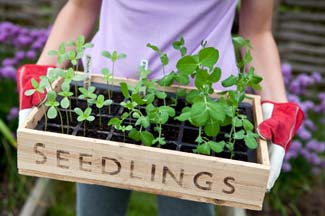
 I’m not too far removed from the point where I was really, really daunted by the idea of growing my own food. I was the least green fingered person in the universe when I started growing my own vegetables about 6 years ago – up to that point my only experience of growing things was with bonsai trees. I went through a phase where I thought they were really cool, but they kept just dying on me and I stopped after I had killed about 4 of them with a collective age of about 1,500 years.
I’m not too far removed from the point where I was really, really daunted by the idea of growing my own food. I was the least green fingered person in the universe when I started growing my own vegetables about 6 years ago – up to that point my only experience of growing things was with bonsai trees. I went through a phase where I thought they were really cool, but they kept just dying on me and I stopped after I had killed about 4 of them with a collective age of about 1,500 years.
So I totally get how daunting it can be to take that first step. At events, shows and festivals around Ireland, we do a seed-sowing roadshow where we have little GIY cardboard cups that we use to get people to sow seeds in. We fill them with potting compost and get people to sow a pea or a broad bean seed in them and bring it home with them.
You would be amazed at how frightened people are of this simple little act of popping a seed in soil. They are scared (like I was) of failure – scared it won’t grow, scared they will look like an eejit if it doesn’t work. At GIY, our job is to help people overcome that initial fear, help them to get a quick win and to experience what we call GIY JOY – the thrill about a week or two after sowing when a little green seedling pokes its head out of the soil and the even greater thrill when eventually (fingers and other extremities crossed), the plant produces some food.
 So our big idea for 2012 is a campaign we are calling Operation GIY Nation. The idea is to get families that have never grown anything at all to give it a try. We have designed 6 really straight forward growing projects that parents and kids can download from our website – one each month for six months starting in April.
So our big idea for 2012 is a campaign we are calling Operation GIY Nation. The idea is to get families that have never grown anything at all to give it a try. We have designed 6 really straight forward growing projects that parents and kids can download from our website – one each month for six months starting in April.
The idea is that we will take you on a journey – starting with a really easy and fun growing project that you can do with your kids, and build your level of experience over the 6 months. If you get involved we promise you that by the end of it, you will have produced some food that you can eat – we will leave you feeling empowered and healthy, living more sustainably and doing something that really matters. Above all, you will experience GIY JOY.
To get involved in Operation GIY Nation – go to our website www.giyireland.com/giynation.
Things to do this Month - April
To Do
If poor weather in March has hampered your outdoor work, then April is the month to catch-up. The key words for April are weeds and slugs. You need to stay on top of them both. Check your early spuds regularly and ‘earth-up’ as required. Water your tunnel/greenhouse – things can get pretty warm on a nice sunny April day and seedlings will dry out quickly.
Sow
Indoors: lettuce, tomato, pepper, chilli-pepper, cucumber, celery, celeriac, basil, leeks, cabbage, cauliflower, Brussels sprouts, parsley, courgette, marrow, globe artichoke, beans, sweet corn and pumpkin.
Outdoors: broad bean, onion sets, pea, beetroot, cabbage, spinach, Brussels sprouts, parsnip, spring onion, leek, carrot, radish, broccoli, turnip. Plant out cabbage plants when they are 15/20 cm tall into well prepared soil that has been manured.
Harvest
Stored fruit and vegetables are likely to be a distant memory at this stage and new crops are only starting to trickle in which makes April a tricky proposition. The middle of this month might see the first asparagus and the first early spring cabbage. The other two star performers this month are purple sprouting broccoli and rhubarb.
Recipe of the Month – Simple Cooked Chard
April is a classic “hungry gap” month for most growers, where we are still waiting patiently for the first of the new season crops to come along and last year’s stores are looking painfully bare. Thankfully we still have chard! I sowed rows of it last winter for the polytunnel, and the little seedlings burst in to life back in March. It’s in good nick for picking now.
I’ve always been a little daunted about what to do with chard, until I discovered proper instructions on how to cook them. Don’t forget that the stalks are really good – don’t discard them.
This quantity will serve 4.
Ingredients:
• 450g chard
• extra virgin olive oil
• handful freshly chopped herbs (e.g. rosemary, marjoram or tarragon)
Wash the chard carefully and then drain. Chop the stalks off the leaves and cut them in to to 5cm lengths. Roughly chop the leaves. Cook the stalks in boiling salted water for 3-4 minutes, then add the leaves and cook for a further 2-3 minutes. The leaves will be wilted at this point. Drain well and then toss with a little olive oil. Add the herbs, season and serve.
Tip of the Month – Upcycle!
Your recycle bin can often throw up very useful veggie growing companions in the shape of pots, containers, cloches and seed sowing containers. For example yogurt pots are great for starting tomato, pepper, and aubergine seeds - poke a few drainage holes in the bottom and they are perfect for the purpose.
Egg cartons are eggscellent (teehee) for chitting spuds in, but they are also good for seed sowing so long as you are not sowing things in them that need a large root system. Toilet roll inserts are brilliant to sow in - pretty much anything can be sown in them and they can be placed directly in the soil then as the insert will then rot away. Once you’ve packed away that shopping after your trip to the shop, you’re likely to have all manner of clear plastic punnets, pots and containers –They can act as cloches in that crucial springtime period when seedlings are first put out in the soil.
Grow Magazine: The 64-page GIY magazine, GROW is a must-read for anyone interested in growing their own food in 2012. Includes contributions from Joy Larkcom, Fionnuala Fallon, Kitty Scully, Hans Wieland, Darina Allen, Klaus Laitenberger and Joyce Russell. The magazine costs €4.50 and is available from our website and in most good newsagents. GROW is sent free of charge to subscribing members of GIY. GIY membership costs €35 and the member's pack includes the magazine, 7 packs of GIY seeds, grower's wallchart and a GIY member's card.
------------------------------------
We are trying to get 100,000 people to take a pledge to grow something they can eat – take the GIY pledge at www.facebook.com/giyireland.
 Michael Kelly is a freelance journalist, author and founder of GIY Ireland.
Michael Kelly is a freelance journalist, author and founder of GIY Ireland.
GIY’s vision is for a healthier, more connected and more sustainable world where people grow their own food. We bring people together in community groups and online to inspire and empower them to grow vegetables. There are over 100 GIY community groups and approximately 12,000 people involved in the movement around Ireland. GIY is a registered charity – CHY 18920.
For more tips, information and support visit www.giyireland.com.
© GIY Ireland 2012 – all rights reserved.
Grow it Yourself - May
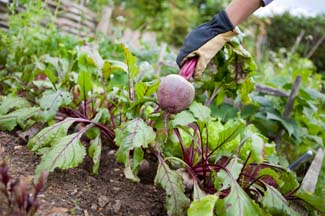
 This month we will be harvesting the first of our new season beetroot - OK, so they will be no bigger than golf balls and will have been grown in the polytunnel, but they will be all the tastier and more tender as a result.
This month we will be harvesting the first of our new season beetroot - OK, so they will be no bigger than golf balls and will have been grown in the polytunnel, but they will be all the tastier and more tender as a result. I was turned off beetroot as a kid because the only way I ever saw it presented was pickled and floating in vinegar – fresh beetroot plucked straight from the soil and baked to retain all the goodness, is a different matter entirely: earthy, tender, wonderful and incredibly good for you.
Interesting to note that we also still have about half a dozen beetroot from last year in a box of sand in the shed – they were sown in July, lifted for storage in October and we’ve been eating a couple a week since. They have held up well. They are an altogether hardier affair than the new season ones – about the size of large oranges and not quite as tender, but they taste pretty good still and make a useful addition to salads (raw, grated).
To my mind this brings home why beetroot is the perfect GIY crop – it can be difficult to source fresh in the supermarket, it’s easy to grow, doesn’t demand much space and with a little planning it can be enjoyed fresh all year round.
 By the way, if you are heading to Bloom in the Phoenix Park (31st May to 4th June), come visit us at the GIY Zone. We will be showing people how to sow seeds and generally spreading GIY Joy. We’re also aiming to break a Guinness World Record for the most people sowing seedlings at the one time, and creating a giant seedling mosaic!
By the way, if you are heading to Bloom in the Phoenix Park (31st May to 4th June), come visit us at the GIY Zone. We will be showing people how to sow seeds and generally spreading GIY Joy. We’re also aiming to break a Guinness World Record for the most people sowing seedlings at the one time, and creating a giant seedling mosaic!Things to do this Month
To-Do
May is the time to get those outdoor beds ready for early summer transplanting. Fork over and rake. Earth up potatoes as the plants develop. Put protective barrier around your carrots to thwart the dastardly carrot root fly. Regularly hoe weeds and mulch. Water plants if required. Support tomato, bean and pea plants with twiggy sticks, pea netting, timber supports with chicken wire, or existing fence or hedge. Pinch out the growing tips of broad beans plants to help prevent Blackfly.
Sow
Indoors for planting on later: basil, dill, coriander, courgette, cucumber, sweet corn, pumpkins.
Outdoors: winter cauliflower, cabbage, kale, spinach, sprouting broccoli, leeks, beans (French, Runner, Climbing French), beetroot, parsnip, turnip, swedes, radish, lettuce, peas, broccoli, rocket, carrots. Harden off and begin to plant out seedlings you have lovingly raised indoors – e.g. tomatoes, cucumber, peppers, brussels sprouts, sprouting broccoli, cabbages, sweet corn, leeks.
Harvest
May is another tricky “gap” month as stores continue to dwindle. Continue picking asparagus, purple sprouting broccoli, radish, rhubarb, cabbage, cauliflower, spinach and chard. May is likely to see the first real bumper salad leaves like lettuce and rocket – as well as the first garlic, beetroot and globe artichokes.
Operation GIY Nation
This month in Operation GIY Nation we’re showing you how to grow salad leaves in a container. You can download the project help-sheet from http://www.giyireland.com/giynation.
Recipe of the Week – Beetroot and Goats Cheese Salad
Walnuts, goats cheese and beetroot make ideal bedfellows.
This serves four.
Ingredients:
• 12-15 baby beetroot
• 2 tbsp lemon juice
• 80ml extra virgin olive oil
• 1 tsp Dijon mustard
• 70g baby spinach leaves and some small beetroot leaves
• A bunch of flat-leaf parsley leaves, roughly chopped
• 100g soft goat's cheese, crumbled
• 75g toasted walnuts
Twist off the leaves from the beetroot (don’t cut, this causes them to bleed), leaving about 2 inches of stalk attached to the beet. Wash them well and pat dry. Place them in a tinfoil parcel and bake in a hot (220 degrees Celsius) oven for about 35-45 minutes.
They will be very tender when cooked – pierce with a knife to check. Take a beetroot and rinse under a cold tap (so you can handle it), then quickly remove the skin by rubbing with your fingers – if it is well cooked, it should come off easily. Repeat with all the beetroot and cut them in to quarters. Whisk the lemon juice, olive oil and mustard together in a small bowl. Season to taste.
Place the spinach, beetroot leaves and chopped parsley in a large bowl. Add half the dressing and toss well.
Divide among 4 serving plates (or leave in the large bowl if desired), then scatter with beetroot, goat's cheese and toasted walnuts. Garnish the salad with some parsley, drizzle with the remaining dressing and serve immediately.
Tip of the Week – Sow Beetroot
Beetroot likes a deep, sandy soil, manured the previous winter. Apply organic fertiliser about a week before sowing. Germination is in about 10 days and you will have roots to eat in about 3 months. I always sow beetroot in module trays and then carefully transplant them about a month after sowing. They should be planted 4 inches apart in rows about 12 inches apart.
Bear in mind that a beetroot seed is actually a “cluster” of up to five seeds, so even if you sow just one seed you may end up with a small cluster of plants – thin them out to just one seedling. Sow every two weeks from April until July (for a continuous supply of young beets) although you can start even earlier (March) in a greenhouse or polytunnel.
Sow another batch in July, which will be ready to lift in October for winter storage.
For a GIY video tutorial on growing beetroot check out directory at http://www.giyireland.com/videos/detail/beetroot
Grow Magazine: The 64-page GIY magazine, GROW is a must-read for anyone interested in growing their own food in 2012. Includes contributions from Joy Larkcom, Fionnuala Fallon, Kitty Scully, Hans Wieland, Darina Allen, Klaus Laitenberger and Joyce Russell. The magazine costs €4.50 and is available from our website and in most good newsagents. GROW is sent free of charge to subscribing members of GIY. GIY membership costs €35 and the member's pack includes the magazine, 7 packs of GIY seeds, grower's wallchart and a GIY member's card.
------------------------------------
We are trying to get 100,000 people to take a pledge to grow something they can eat – take the GIY pledge at www.facebook.com/giyireland.
 Michael Kelly is a freelance journalist, author and founder of GIY Ireland.
Michael Kelly is a freelance journalist, author and founder of GIY Ireland.GIY’s vision is for a healthier, more connected and more sustainable world where people grow their own food. We bring people together in community groups and online to inspire and empower them to grow vegetables. There are over 100 GIY community groups and approximately 12,000 people involved in the movement around Ireland. GIY is a registered charity – CHY 18920.
For more tips, information and support visit www.giyireland.com.
© GIY Ireland 2012 – all rights reserved.
Grow it Yourself - June
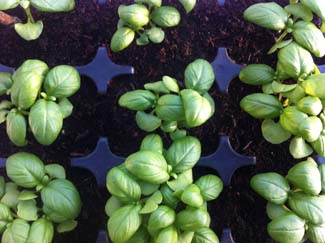
 I am doing a lot of transplanting at the moment, which is always a fun activity for a GIYer. There’s nothing like the satisfaction of planting seedlings – bare beds transformed in an instant with neat rows of little plants.
I am doing a lot of transplanting at the moment, which is always a fun activity for a GIYer. There’s nothing like the satisfaction of planting seedlings – bare beds transformed in an instant with neat rows of little plants. I always feel intensely happy after spending some time planting – and now I know that there is actually a scientific reason for this – contact with soil triggers the release of serotonin in our brain according to research. Serotonin is the happy chemical – it is a natural anti-depressant and strengthens the immune system.
On the other hand, there are always a few days of fretting after transplanting– will cold nights set the plants back? Will slugs or rabbits try and munch on them?
Seed sowing is a relatively exact science – if you sow a seed at the right temperature and at the right depth, and you keep the potting compost moist, then it will generally germinate rather reliably. In addition, up to the point that they are transplanted, the seedlings have luxuriated in the 5-star comfort of my potting shed.
They have been nurtured, spoiled, cossetted. I’ve carefully watered them each day, switched on heat underneath them at night and covered them with fleece. The potting shed is a controlled environment – there is no weather in there – no rain or wind. Nor are there any pests to trouble them – leather jackets, slugs, snails, birds or rabbits.
Planting a seedling out in the soil therefore is a watershed moment. It is the moment it leaves a very controlled environment in favour of something far more uncontrolled, unpredictable and messy. And like a parent sending a child off to school for the first time, you just have to have faith and let it go in to the mad, bad world!!
 Things to do this Month
Things to do this Month To-Do
Watering and weeding duties step up a notch – the tunnel/greenhouse in particular will require a good deal of water from now on. Watch the weather and water outside as required. Continue to earth-up potato plants to prevent the spuds becoming green. Mulch and water tomato plants and continue to remove side shoots that appear in the leaf axils. Stake everything that grows tall – raspberries, peas, beans, tomatoes etc. Net soft fruit against birds – it’s worth the effort.
Sow
Sow courgettes, pumpkins, summer and winter squash, fennel, chicory. Succession sow: beans (French and Runner), kale, pea, spinach, spinach beet, summer broccoli, carrot, swede, leek, lettuce, Brussels sprouts, beetroot, chicory, endive, turnip, kohlrabi, fennel. Plant out leeks, Brussels Sprouts, cabbage, autumn cauliflower, calabrese, sprouting broccoli, celery, celeriac, cucumbers, pumpkin, marrows, runner beans, aubergine.
Harvest
We are now really starting to see some payback from our GIYing - the first broad beans and peas as well as new potatoes, new carrots, soft fruit like gooseberries, cherries and strawberries. Herbs are in full flow. Also harvest kohlrabi, cabbage, cauliflower (month end), spinach, spring onion, shallots, salad leaves, elderflower, rhubarb, salad leaves, onions, carrots, beetroot, garlic, sea-kale.
Recipe of the Month – Broad Bean Hummus
At some point last year I decided I was never growing broad beans again, because I reckoned I actually didn’t like their taste much. Then I discovered this recipe from our old mucker Hugh Fearnley Whittingstall which turns them in to a cracking hummus.
Serves 4.
Ingredients:
• 400g shelled broad beans
• ½-1 garlic clove, crushed with a little salt
• Approx 3 tbsp rapeseed or extra virgin olive oil
• Generous squeeze of lemon juice
• Sea salt and freshly ground black pepper
Put the broad beans in a pan, cover with water and bring to the boil. Lower the heat and simmer for 5-10 minutes (depending on age and size) until tender, then drain. Set aside to cool, then slip the beans out of their skins.
Put the skinned broad beans in a food processor or blender with the garlic, 3 tablespoons of oil, a good squeeze of lemon juice and some salt and pepper. Process to a thick, slightly coarse purée, adding more oil if it seems too thick and dry.
When you're happy with the texture, transfer the purée to a bowl. Taste and adjust the seasoning with more salt, pepper and lemon juice as needed. Delicious with a slice of ham in a pitta bread or bap (or a blaa if you’re a Waterford boy like me).
Tip of the Month – Manually pollinating courgette plants
In cold or very wet summers, you may notice that fruit is not forming well on your courgette plants. This can be because pollination is poor (lack of insects to move the pollen from the male to female plant).
The problem can be fixed by getting all Charles Darwin and pollinating the plants manually. Remove a male flower from the plant and brush the central parts against the centre of a female flower (the pollen from the male plant is rubbed against the stigma of the female plant).
The female flowers are the ones that have a small fruit starting to form behind them. The male flowers don't.
------------------------------------
We are trying to get 100,000 people to take a pledge to grow something they can eat – take the GIY pledge at www.facebook.com/giyireland.
 Michael Kelly is a freelance journalist, author and founder of GIY Ireland.
Michael Kelly is a freelance journalist, author and founder of GIY Ireland.GIY’s vision is for a healthier, more connected and more sustainable world where people grow their own food. We bring people together in community groups and online to inspire and empower them to grow vegetables. There are over 100 GIY community groups and approximately 12,000 people involved in the movement around Ireland. GIY is a registered charity – CHY 18920.
For more tips, information and support visit www.giyireland.com.
© GIY Ireland 2012 – all rights reserved.
Grow it Yourself - July
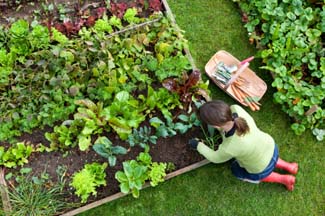
.jpg) There are some vegetables that you grow yourself and you really wonder whether it's worth the hassle, particularly if there are good commercial alternatives available. But given the fact that most of the tomatoes in our supermarkets are the super-bland, all-year-round Dutch variety and taste of ....well nothing at all, having a good crop of your own tomatoes is really one of the most rewarding things you can do.
There are some vegetables that you grow yourself and you really wonder whether it's worth the hassle, particularly if there are good commercial alternatives available. But given the fact that most of the tomatoes in our supermarkets are the super-bland, all-year-round Dutch variety and taste of ....well nothing at all, having a good crop of your own tomatoes is really one of the most rewarding things you can do.Tomatoes that you grow yourself taste a million times nicer than anything you will buy in the supermarket - period. This is because the overwhelming majority of commercial tomatoes are grown for superficial uniformity and shelf-life, rather than flavour. You are more likely to eat your own tomatoes as you would an apple rather than slice 'em up and put them in a sandwich. They are a sweet, sumptuous treat, best eaten warm and freshly picked.
I like being in touch with the seasonality of tomatoes though it is a bitter-sweet affair given how short the season is – tomatoes are basically in season for just a third of the year - four short months. Ours are starting to ripen now and they will go on producing hopefully in to late October and then they will be no more and we will shed a tear.
 We try to extend their season a little by getting the first seeds going on a warming mat in early spring at one end and by preserving the produce at the other end (storing, bottling, freezing etc). If you want to really embrace seasonal food consumption, you could do worse then starting with the tomato. Grow as many plants as your space will allow - nurture them, harvest, eat and store.
We try to extend their season a little by getting the first seeds going on a warming mat in early spring at one end and by preserving the produce at the other end (storing, bottling, freezing etc). If you want to really embrace seasonal food consumption, you could do worse then starting with the tomato. Grow as many plants as your space will allow - nurture them, harvest, eat and store. Enjoy them fresh from July until October and then in the winter enjoy your own ‘processed’ tomatoes too in what ever form you have converted them in to – then give yourself a break from them. They are not in season, so don't be tempted to buy them. When you have sampled the delectable taste of your own tomatoes, I promise you that you won't find this hard.
Date for the Diary
On Sunday 2nd September 2012, Fingal Gardener's Group and GIY Naul are holding an event: 'TOTALLY TERRIFIC TOMATOES' - celebrating all things tomato! It takes place at Seamus Ennis Centre, Naul, Co. Dublin from 12 noon until 5pm. For more information check out www.nickykylegardening.com.
 Things to do this Month
Things to do this Month To-Do
Any ground that has finished cropping must be quickly cleared away to take more vegetables. Use your produce - eat it, freeze it, process it, exchange it, give it away. Continue to water and feed plants and practice good weed control. Earth up brassicas such as Brussels sprouts - these plants will grow tall and require a good deal of support. Net plants to keep butterflies and the cabbage moth away.
Cut down legume plants that have finished cropping - leave the roots in the soil as they fix nitrogen in the soil. Give pumpkins plenty of water and apply a high-potash liquid feed.
Sow
Continue successional sowings and use quick maturing varieties for autumn use - Swiss chard, lettuce, rocket, salad onions, radish, turnips, peas, French Beans (dwarf), carrots. Sow for winter use - spring cabbage, Hungry Gap kale, parsley, perpetual spinach, chicory and coriander. Plant strawberries now for a good crop next June. Propagate rosemary, sage and mint from cuttings now.
Harvest
July and August are peak months for produce – enjoy it! First crops of French and runner beans, tomatoes, peppers, cucumbers, courgette and aubergine, marrows, beetroot, globe artichokes. Continue to harvest new potatoes, calabrese, cauliflower, cabbage, spinach, carrots, turnips, shallots, garlic, radish, spring onions, salad crops, strawberries, raspberries, tayberries, currents (black, red and white), gooseberries, loganberries, peas, broad beans. Ask yourself – do you really need to go to the supermarket?!
Recipe of the Month – Green Tomato Chutney
Far from being a waste, the tomatoes that don’t ripen can be one of the most important assets you will get from your veg patch this year. The beauty of this recipe is its exclusivity. Because you can’t buy the primary ingredient (green tomatoes) in the shops, it can really only be made by a GIYer.
Ingredients:
• 3kg green tomatoes
• 6 large onions (about 1kg)
• 3 or 4 large green peppers
• 700g brown sugar
• 1.2 litres of vinegar
• Spices: 3 tbs mustard seed, 1 tbs coriander seed, ½ teaspoon celery seed, 1 teaspoon turmeric
Chop the onions and slice the tomatoes finely. Layer them in a very large bowl – i.e. start with onions, then tomatoes, then onions etc, seasoning each layer with plenty of salt and a little pepper as you go. Leave it to stand for a day or so – then drain off the liquid and transfer the veg to a large stock pot.
Add the rest of the ingredients (sugar, vinegar, spices), bring the whole thing to a boil and let it simmer on a low heat for two or three hours. Put it back in to the bowl and let it sit for another day. Put it back in the stock pot and cook it for another half hour so that the liquid reduces down further – you want just enough liquid to cover the vegetables when they are transferred in to pots.
Sterilise some jam jars and ladle the chutney in to them. Don’t be tempted to eat any for about a month – it’s like a fine wine, it will get better with age.
Tip of the Month – Make use of your grass cuttings
Here’s how to make great compost using two great waste-creators in the home and garden - newspapers and grass cuttings. Build an open heap of alternating 10-inch layers of crumpled newspaper and grass cuttings. Allow to get quite tall - 4-6ft - and then leave to rot down for a year.
Operation GIY Nation
Interested in growing your own food? It’s not too late to grow some veg this year! Check out www.giyireland.com/giynation for simple growing projects for July and August that you can try with your kids. Operation GIY Nation is proudly supported by AIB.
------------------------------------
We are trying to get 100,000 people to take a pledge to grow something they can eat – take the GIY pledge at www.facebook.com/giyireland.
 Michael Kelly is a freelance journalist, author and founder of GIY Ireland.
Michael Kelly is a freelance journalist, author and founder of GIY Ireland.GIY’s vision is for a healthier, more connected and more sustainable world where people grow their own food. We bring people together in community groups and online to inspire and empower them to grow vegetables. There are over 100 GIY community groups and approximately 12,000 people involved in the movement around Ireland. GIY is a registered charity – CHY 18920.
For more tips, information and support visit www.giyireland.com.
© GIY Ireland 2012 – all rights reserved.
Grow it Yourself - September
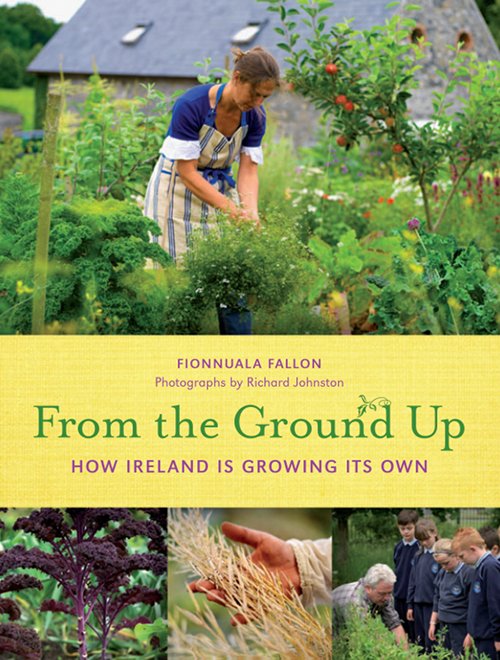
 If you are looking for inspiration for your growing endeavours, it can often be found in the gardens of other GIYers. I always find that walking around another grower’s garden leaves me with renewed inspiration and several useful tips to take back to my own vegetable patch. I guess this is why the garden visit and meitheal are such important parts of the GIY group experience.
If you are looking for inspiration for your growing endeavours, it can often be found in the gardens of other GIYers. I always find that walking around another grower’s garden leaves me with renewed inspiration and several useful tips to take back to my own vegetable patch. I guess this is why the garden visit and meitheal are such important parts of the GIY group experience.
Irish Times gardening correspondent (and contributor to GIY’s magazine GROW) Fionnuala Fallon’s wonderful new book From the Ground Up – How Ireland is Growing its Own (Collins Press) is like going on several lengthy garden visits all without leaving your house. It takes, not just a peek, but a substantial gander at the veg patches of some of Ireland’s passionate food growers, with gorgeous and extensive photos from her husband Richard Johnston to bring the profiles to life.
The book reflects the variety of growing that is happening up and down the country – from an 8-Square-Metres veg patch to urban and suburban pads to rural potagers. Featured growers include Trevor Sargent, Jim Cronin, GIY patron Klaus Laitenberger, Michael and Ethna Viney, Joy Larkcom, Madeline McKeever of Brown Envelope Seeds, and Martijn Kajuiter of The Cliffhouse Hotel.
She even visits the teenage twins Micheál and Oisín Byrne in County Louth, who grow pumpkins to compete for Ireland’s Giant Pumpkin title. Fionnuala and Richard also visited us here in Dunmore East some time back to do the photoshoot and thankfully did so in the summer when the place was looking at its best – and of course, a great photographer can make any garden look impressive!
This book has truly been a labour of love for Fionnuala, and it shows. It’s a beautiful production and comes highly recommended. Incidentally Fionnuala is one of the speakers at the GIY Gathering on September 15th/16th (see below).
Things to Do this Month – September
To-Do
Lift crops which have finished growing and dress bare soil with manure, compost (or plant green manures). Wasps can be problematic as fruit ripens so make traps from jars of sugary water. Remove surplus leaves from tomato plants which allows air to circulate and sunshine to fall on the fruit. Go blackberry picking!
Sowing Seeds
Last month for sowing perpetual spinach, chard and oriental salads – it will be worth it in the New Year when there’s almost nothing else to eat, so get sowing! In the polytunnel/greenhouse sow lettuce, mustard, coriander, parsley, radish, dwarf early pea, broadbean, cauliflower seed, rocket, onion seed and garlic. Outside sow white turnip seeds and autumn onion sets, e.g. ‘centurion’ and ‘sturon’. Plant out strawberry runners. Pot up some parsley for winter use.
Harvest
Summer vegetables and fruit are joined by the great autumn veg like parsnips, swedes and celeriac. Lift onions and leave to dry out in sun or in the polytunnel/greenhouse for two weeks. Apples, plums, pears are now in season. Continue to harvest salad leaves, tomatoes, radish, potatoes, carrots, turnips, beetroots, cauliflower, cucumbers, peppers, beans, courgettes, spinach, leeks, red cabbage, summer cabbage, aubergine, sweet corn.
 The GIY Gathering 2012
The GIY Gathering 2012
Whether you are an old hand or a complete novice at growing your own grub, this year’s GIY Gathering (Saturday 15th and Sunday 16th of September) is simply unmissable, bringing together some of the world’s leading advocates and experts on growing food to Ireland for two unforgettable days of talks, debates and discussions. Speakers include a BBC Gardeners World presenter, a head gardener from River Cottage and the inspiration behind Michelle Obama’s White House veg garden.
Hosted by RTE’s Ella McSweeney, we've got talks and discussions on self sufficiency, thrifty gardening, keeping hens, herbs, fruit, polytunnel growing, creative vegetable gardening, beekeeping, composting, growing for nutrition, growing in small spaces and much more. The speaker list is a veritable who’s-who of the veg growing world: Alys Fowler, Mark Diacono, Roger Doiron, Joy Larkcom, Klaus Laitenberger, Trevor Sargent, Peter Dowdall, Kitty Scully, Hans Wieland, Simon Dawson, Joyce Russell and many more.
The event takes place during the Waterford Harvest Festival so the city will be heaving with events to delight the palate. We are expecting all 400 tickets for the Gathering to sell out, so don’t be left out – get your tickets (priced at just €20) from www.giyireland.com or call the Gathering ticket office on 051 302 191.
Recipe of the Week – Cucumber Pickle
A great recipe for “storing” cucumbers for the winter.
Ingredients:
• 4 cucumbers
• 3 onions, peeled
• 50g of salt
• 570ml of white wine vinegar
• 450g of soft brown sugar
• ½ level tsp each of ground turmeric and ground cloves
• 1 tbsp of mustard seed
Directions:
Slice the cucumber and onions thinly, then layer them in a large bowl, seasoning each layer. Weigh down with a plate and stand for three hours. Pour away the liquid and rinse the vegetables. Put the vinegar, sugar and spices in a saucepan and stir over medium heat until the sugar is dissolved. Add the cucumber and onions to the saucepan and bring to the boil. Boil for a few minutes then remove the veg and continue to boil syrup for 20 minutes. Fill sterilised jars with veg and when syrup is ready pour it over the vegetables. Cover, label and store the jars.
------------------------------------
We are trying to get 100,000 people to take a pledge to grow something they can eat – take the GIY pledge at www.facebook.com/giyireland.
 Michael Kelly is a freelance journalist, author and founder of GIY Ireland.
Michael Kelly is a freelance journalist, author and founder of GIY Ireland.
GIY’s vision is for a healthier, more connected and more sustainable world where people grow their own food. We bring people together in community groups and online to inspire and empower them to grow vegetables. There are over 100 GIY community groups and approximately 12,000 people involved in the movement around Ireland. GIY is a registered charity – CHY 18920.
For more tips, information and support visit www.giyireland.com.
© GIY Ireland 2012 – all rights reserved.
Grow it Yourself - November
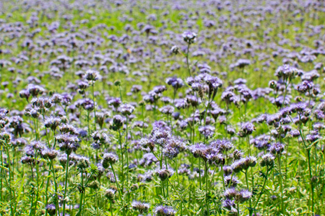
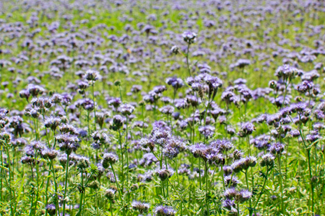 Back in late summer when the broad beans, early peas and early spuds were finished cropping, I cleaned up the beds and sowed a green manure called phacelia in the beds (the seeds were broadcast liberally in the soil and then raked in). The seeds germinated within a few days, and within weeks we had a lovely carpet of light green plants covering the beds. This week, the phacelia was ready to be cut down and dug in to the soil.
Back in late summer when the broad beans, early peas and early spuds were finished cropping, I cleaned up the beds and sowed a green manure called phacelia in the beds (the seeds were broadcast liberally in the soil and then raked in). The seeds germinated within a few days, and within weeks we had a lovely carpet of light green plants covering the beds. This week, the phacelia was ready to be cut down and dug in to the soil.
A green manure is a fast growing ‘cover’ crop grown specifically to add nutrients and organic matter to the soil. While it is growing the green manure protects the soil (its roots hold the soil together) and because it grows so quickly, it also suppresses weeds.
Green manures are dug in to the soil when the plants are still young and typically before they flower (the phacelia was just starting to produce pretty little blue flowers). The green leafy material is very high in nutrients and so, as it decomposes it improves and protects the soil. The upside of digging in when the plants are young is that they are still quite tender and easy to work with. They also break down in the soil quite quickly. Left to get too old and tough, and it becomes a more difficult job.
 To dig in the manure, I simply used a shears to chop down the manure at ground level. I also chopped at the plants to break them down in to smaller bits as I went. I have heard of people using a strimmer where there are larger areas of ground covered in green manure, but the shears were fine for me and it didn’t take long.
To dig in the manure, I simply used a shears to chop down the manure at ground level. I also chopped at the plants to break them down in to smaller bits as I went. I have heard of people using a strimmer where there are larger areas of ground covered in green manure, but the shears were fine for me and it didn’t take long.
I then simply got a fork and turned the soil over, incorporating everything (including the roots) as I went. It’s important not to go too deep – the green manure will rot down best and have the most impact if dug in quite shallow (about 15cm).
You can sow a new crop in the bed after three to four weeks – as mentioned above, my beds will be covered down with polythene now so hopefully those nutrients from the green manure will be preserved over the winter months.
Things to Do this Month - November
To Do
Do not leave beds bare for the winter – sow a green manure, or cover with a thick layer of manure/compost and then black plastic or straw. This will return nutrients to the soil, keep the worst of the weather off it, suppress weeds and prevent leaching of nutrients. ‘Earth up’ or tie up vegetables such as cabbage, cauliflower and Brussels sprouts. Divide up your rhubarb if you want to propagate, and cover it with a thick mulch of manure. Prune apple trees. Mulch fruit bushes. Take cuttings of currant bushes from current season’s wood.
Sow
Sow broad beans outside now for an early crop next spring. To avoid rotting before germination, make small newspaper cups and germinate them indoors first. Next summer’s garlic does best if it’s planted before Christmas – plant outdoors in well prepared soil in a sunny spot. Though I have to admit I never bother with them, some varieties of onion can over-winter and will be ready to harvest in early summer.
Harvest
Continue to harvest perpetual spinach, cabbage, cauliflower, potatoes, swede, parsnips, apples, pears. Start harvesting leeks, winter cabbage, kale, artichokes, Brussels sprouts. Time to lift carrots and turnips or at least cover them with a good layer of straw to protect them from frost damage.
Recipe of the Week – Beetroot Relish
At my talk at the GIY Gathering this year I discussed how beetroot is in my top 5 vegetables to grow. One of the people in the audience, Máire Jones, from GIY Rush & Skerries kindly sent me this lovely recipe to make beetroot relish – another option for ‘storing’ this wonderful crop.
Ingredients:
• 3lb cooked beetroot
• 1lb onions, chopped
• 1lb cooking apples, peeled and chopped
• 1tsp salt
• 2lb granulated sugar
• 24 fl oz red wine vinegar
Directions:
Peel and cut beet into cubes, or mash if smooth relish required. Place onion into a large preserving pan with a little of the vinegar and cook for a few minutes to soften the onion. Add apples with 4tbsps of sugar and continue cooking until pulpy. Add beet, salt and half of the remaining vinegar. Simmer gently until thick. Stir in sugar and remaining vinegar and continue cooking until thick. Pot into hot sterilized jars, seal with vinegar-proof lid. Store 6-8 weeks before using. Makes approx 3 half-litre jars or 4/5 1lb jars.
Tip of the Month – Shredding for Great Compost
Small garden shredders are available quite cheaply from most garden centres - they are a great investment for improving your compost heap. Chances are you have a huge amount of foliage available from your veggie patch to go on your compost heap at the moment (parsnip leaves, cabbage plants, peas and beans etc). These make fine additions to the compost heap, but shredding them first means they will decompose much faster. If you don't have a shredder use a shears to cut up large leaves, and use a sledgehammer to bash down large brassica stems (and you can cancel your gym membership!).
Get Involved
GIY aims to create a healthier, more sustainable world where people grow their own food. We bring people together in community groups and online to share tips and knowledge. We also run events and programmes to inspire and support people to grow their own. GIY is a registered charity (CHY 18920) and proudly supported by Woodies DIY. Support our work by becoming a member of GIY for €35 and receive a member’s pack with seed selection, member’s card, GROW magazine, grower’s guides and more. www.giyireland.com.
------------------------------------
We are trying to get 100,000 people to take a pledge to grow something they can eat – take the GIY pledge at www.facebook.com/giyireland.
 Michael Kelly is a freelance journalist, author and founder of GIY Ireland.
Michael Kelly is a freelance journalist, author and founder of GIY Ireland.
GIY’s vision is for a healthier, more connected and more sustainable world where people grow their own food. We bring people together in community groups and online to inspire and empower them to grow vegetables. There are over 100 GIY community groups and approximately 12,000 people involved in the movement around Ireland. GIY is a registered charity – CHY 18920.
For more tips, information and support visit www.giyireland.com.
© GIY Ireland 2012 – all rights reserved.
Grow it Yourself - December
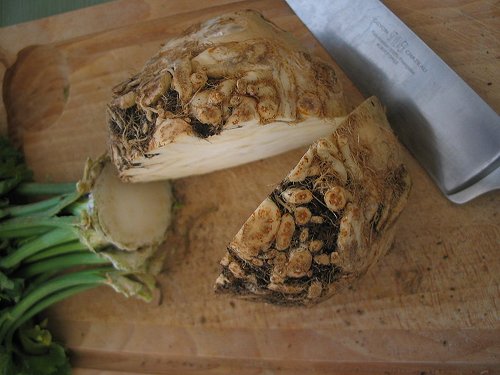
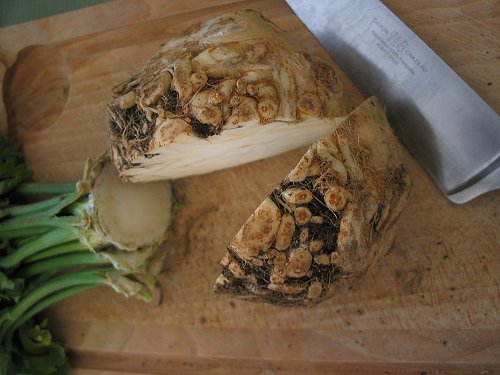 I have started to harvest celeriac from the garden now – it’s a hardy veg that I generally leave in the ground until things are starting to get a bit sparse elsewhere and when most of the celery is gone.
I have started to harvest celeriac from the garden now – it’s a hardy veg that I generally leave in the ground until things are starting to get a bit sparse elsewhere and when most of the celery is gone.
I am a huge fan of celeriac – it has all the lovely smooth flavour of celery, but with the added benefit that it stores exceptionally well. It will keep for up to four months if stored correctly. So this year, I actually eased off on the celery a little (because last year a lot of the crop spoiled in the ground because we couldn’t eat it fast enough) and grew more celeriac instead.
Many books will tell you that celeriac is also easier to grow than celery – I can’t say that I agree on this. Though it is relatively easy to grow, I find it difficult to grow well if you know what I mean. One almost always gets some form of a crop, but getting decent sized roots takes a bit of work (and luck).
Unlike celery, celeriac is not grown for its leaves, but for the knobbly root that forms at the base of the stem. An early start is key – you need to be sowing your celeriac seeds in February or March as it has a very long growing season. It takes 2-3 weeks to germinate for starters.
This year, I sowed all the seeds in to one 10-inch pot, before ‘pricking’ the seedlings out a few weeks later in to module trays. They were then allowed to grow on until they were about 20cm high before being hardened off and planted out. So it’s a little fiddly.
 Celeriac is also a craver of moisture, which might explain why I have good celeriac this year – we had no lack of moisture. If you get a dry summer (chance would be a fine thing) it will require mulching and regular watering. Removing some of the outer leaves in late season apparently makes the roots grow larger, but I have to confess that I have never bothered with this.
Celeriac is also a craver of moisture, which might explain why I have good celeriac this year – we had no lack of moisture. If you get a dry summer (chance would be a fine thing) it will require mulching and regular watering. Removing some of the outer leaves in late season apparently makes the roots grow larger, but I have to confess that I have never bothered with this.
Like other root veg its flavour is improved and sweetened by the first frosts – I generally dig mine up before Christmas however as I find slug and worm damage can become a problem. Simply remove most of the soil and store in hessian sacks somewhere cool and dark.
Celeriac would probably win an “Ugly Veg of the Year” award, but don’t let its appearances put you off – it’s delicious raw or cooked. The recipe below from Hugh Fearnley Whittingstall is worth trying to prove to yourself just how good it is raw, and the dressing is delicious.
Happy Christmas from GIY!
Things to Do this Month
To Do
As you clear remaining crops from your veggie patch, dig the beds over and add well rotted compost or manure. Get Educated – book yourself on a course! Start planning what you would like to grow next year and work out what crop rotation system you are going to use.
Study seed catalogues carefully before deciding on the best varieties to grow. Start a Compost corner or heap. Keep an eye on your stored veggies and discard anything that’s rotting. Collect and store leaves in bags to make leaf mould or use as cover for bare soil.
Sow
If you haven’t already done so plant garlic – it should be in the soil by the shortest day of the year. Bring herbs like mint, chives, lemon balm, parsley, thyme indoors by lifting and potting them up.
Harvest
Buck the seasonal trend by continuing to harvest winter salad leaves like corn salad, land cress and mizuna. You should still have at least some produce left in the December veggie patch e.g. winter cabbages, Brussels sprouts, leeks, kale, Jerusalem artichokes, carrots, celery, turnips, parsnips, winter cauliflowers, swedes, spinach, chard and celeriac.
From your stores you can enjoy pumpkins and squashes, potatoes, onions, apples, beetroot and garlic.
Recipe of the Month – Celeriac, Raisin and Lentil Salad
This is absolutely my favourite way to eat celeriac, though it is perhaps more of an early spring recipe than a late winter one. The dressing is delicious – I use it as a general salad dressing sometimes too.
Ingredients
75g raisins
50ml cider
1 cricket ball sized celeriac, about 300g peeled weight
1 lemon, juice only
1 large eating apple
100g Cooked puy lentils
Handful of parsley, chopped
For the dressing
1½ tsp English mustard
1½ tsp sugar
1½ tbsp cider vinegar
3 tbsp rapeseed oil
3 tbsp olive oil
Directions:
Make the dressing by whisking in a bowl until emulsified. Soak the raisins in the cider for an hour. Using a mandolin or sharp knife cut the celeriac into fine julienne pieces, and toss in a little lemon juice. Core and thinly slice the apple and toss in a little lemon juice to prevent it discolouring. To assemble the salad put a handful of celeriac in the centre of a plate scatter over some sliced apple a generous tablespoon of drained raisins, a similar amount of lentils and a sprinkling of parsley. Finish with a drizzle of dressing.
Tip of the Month – Frost
Air frosts occur when the air temperature reaches 0C but as GIYers the important thing to look out for is ground frost which is a slightly different thing - this is when the temperature at the soil surface is 0C. This is where frost has the biggest impact on our plants. This also explains why the positioning of your veggie patch is so important.
Frosts will have a bigger impact in low-lying sites where cold air tends to collect. Cold air is heavy and will therefore move downwards where it can - so a veggie patch at the foot of a hill is a terrible idea because cold air will accumulate there.
Some veg are frost hardy including brussel sprouts, brocolli, cabbage, cauliflowers, carrots (up to a point), parsnip, radish, turnip, celery, leeks, garlic, onions, kale and spinach. For those plants that are not frost hardy, keep an eye out for ground frost warnings, and cover with fleece to protect them.
------------------------------------
 GIY aims to create a healthier, more sustainable world where people grow their own food. We bring people together in community groups and online to share tips and knowledge. We also run events and programmes to inspire and support people to grow their own. GIY is a registered charity (CHY 18920) and proudly supported by Woodies DIY. Support our work by becoming a member of GIY for &euro35 and receive a member’s pack with seed selection, member’s card, GROW magazine, grower’s guides and more.
GIY aims to create a healthier, more sustainable world where people grow their own food. We bring people together in community groups and online to share tips and knowledge. We also run events and programmes to inspire and support people to grow their own. GIY is a registered charity (CHY 18920) and proudly supported by Woodies DIY. Support our work by becoming a member of GIY for &euro35 and receive a member’s pack with seed selection, member’s card, GROW magazine, grower’s guides and more.
For more tips, information and support visit www.giyireland.com
Michael Kelly is a freelance journalist, author and founder of GIY Ireland.
© GIY Ireland 2012 – all rights reserved.
Grow it Yourself - January

 With the 2013 growing season nearly upon us, I’m intrigued by the idea that 2012’s GIYing is still paying dividends. It’s a good time of the year therefore for a bit of stock-take.
With the 2013 growing season nearly upon us, I’m intrigued by the idea that 2012’s GIYing is still paying dividends. It’s a good time of the year therefore for a bit of stock-take.
I use various locations to ‘store’ vegetables – our kitchen doubles up as a larder at this time of the year (you can barely get in to the kitchen - there are veggies hanging out of every available space!); then there’s the garage where I keep vegetables in sacks, boxes and the freezer. And finally there are also vegetables still in the ground in the veg patch and polytunnel.
In the kitchen: onions are stored in a corner of our kitchen on onion ropes. There are still roughly 30-40 onions left out of a total of 150. I have no idea why but I grew massive onions this year, so everyone comments on the size of them. I pretend I’m not bothered by their praise but of course secretly, I’m absolutely made up... We still have about 20 bulbs of garlic hanging up in a braid, and about 5 squashes on top of the dresser in the kitchen. On a shelf in the utility room we have various chutneys, pickles and piccalillis.
In the garage: we have a chest freezer, the penultimate resting place to last year’s tomatoes, broad beans, peas and runner beans, shredded cabbage, celery and whole chilli-peppers. In boxes and sacks I still have some celeriac (maybe 7 or so), parsnips (well over 20) and beetroot (approx. 10).
The only vegetables left in the ground outside now are leeks, kale, purple sprouting broccoli and Jerusalem artichokes. Haven’t touched the artichokes yet this year, but we are working away on the kale and leeks as we need them. The sprouting broccoli is starting to come – hopefully that will be a star performer for Feb and March.
The polytunnel is still churning out green leaves – courtesy of a sowing in September (Joy Larkcom’s advice) – we’ve had a marvellous supply of claytonia, mizuna, mibuna, red mustard and hardy winter lettuce.
All in all, though there’s a sense that the larder is depleting it’s not exactly empty yet. Will we make it through to April or May when we get our first crops from this year’s sowing? Possibly not, but we will be damn close!
Happy New Year from GIY!
 Things to Do this Month - January
Things to Do this Month - January
To Do
Plan. This is the time to decide where and what you are going to grow this year. If you are just starting out join your local GIY group for advice and check out our website for handy “getting started” guides and videos. Consider building or buying raised vegetable beds. Order your seeds, onions sets and seed potatoes. Turn over the soil in February only if the weather is dry – if the soil sticks to your boots it’s too early for digging! “Chit” seed potatoes – put them in a container (e.g. used egg carton or empty seed tray) and leave them in a bright warm place to sprout.
Sow
In mid Feb, in seed trays and pots on a sunny windowsill indoors sow celery, globe artichokes, celeriac, leeks, onions, lettuce, tomatoes, peas, aubergines, peppers/chilli-peppers. Weather permitting outside you can try sowing broadbeans, spinach, kohlrabi, onion and shallot sets, Jerusalem artichokes, parsnip and early pea varieties.
Harvest
You may still have winter cabbage, perpetual spinach, chard, leeks, kale, cauliflowers and Brussels sprouts in your veggie patch and depending on how successful your growing/storage regime last year was, you may well still be tucking in to stores of potatoes, celeriac, carrots, parsnips, onions, cauliflower, jerusalem artichokes, winter squash, pumpkins, leeks and red cabbage.
Recipe of the Month – Spinach and Cheddar Souffle
This recipe is from Donna Hay’s Modern Classics cookbook. The word souffle needn’t fill you with terror – it’s quite straightforward, if a little fiddly. If you are growing perpetual spinach in your garden and have your own hens, then this is really a ‘store-cupboard’ recipe that won’t require a trip to the supermarket.
Ingredients:
• 1 bunch spinach leaves (about 400g)
• 60g butter
• 4 tablespoons plain flour
• 250ml milk
• 4 eggs, separated
• 50g grated cheddar
• a handful of breadcrumbs
Place the spinach in boiling water and remove after one minute and drain.
Squeeze all the excess liquid from the spinach and then chop.
Melt the butter in a saucepan over a medium heat. Add the flour and stir until smooth. Whisk in the milk and stir briskly until the sauce thickens.
Remove from the heat and stir through the spinach, egg yolks, cheese. Season well with salt and pepper. Allow to cool to room temperature.
Preheat the oven to 210 degrees celsius. Grease 4 x 200g capacity ramekins with butter and sprinkle with dry breadcrumbs to coat.
Beat the egg whites in an electric mixer until soft peaks form. Gently fold one-third of the egg whites through the spinach mixture and then the remaining two-thirds.
Spoon in to the ramekins and place them on a baking tray. Bake for 15 minutes until puffed and golden. Do not open the oven door while cooking.
Tip of the Week – Rejuvenate perpetual spinach
Perpetual spinach plants may be looking a little tired at this time of the year but with the milder weather should also be showing signs of new growth, particularly at the centre of the plant. Cut the larger outer leaves with a sharp knife at the bottom of the stem so that the plant can concentrate on this new growth.
------------------------------------
Get Involved
 GIY aims to create a healthier, more sustainable world where people grow their own food. We bring people together in community groups and online to share tips and knowledge. We also run events and programmes to inspire and support people to grow their own. GIY is a registered charity (CHY 18920) and proudly supported by Woodies DIY. Support our work by becoming a member of GIY for €35 and receive a member’s pack with seed selection, member’s card, GROW magazine, grower’s guides and more.
GIY aims to create a healthier, more sustainable world where people grow their own food. We bring people together in community groups and online to share tips and knowledge. We also run events and programmes to inspire and support people to grow their own. GIY is a registered charity (CHY 18920) and proudly supported by Woodies DIY. Support our work by becoming a member of GIY for €35 and receive a member’s pack with seed selection, member’s card, GROW magazine, grower’s guides and more.
For more tips, information and support visit www.giyireland.com
Michael Kelly is a freelance journalist, author and founder of GIY Ireland.
© GIY Ireland 2012 – all rights reserved.
Grow it Yourself - February
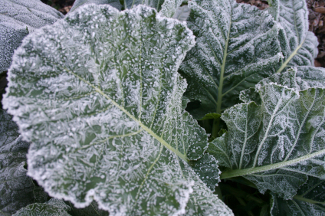
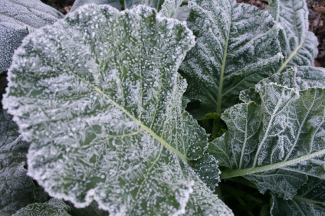 As we make the first tentative sowings of 2013, the 2012 growing season, for the moment, keeps on giving. Last weekend I got out in the veg patch in frost and brilliant sunshine to do some jobs which should have been done ages ago, and primary among them was to lift the remaining celeriac and parsnips from the ground.
As we make the first tentative sowings of 2013, the 2012 growing season, for the moment, keeps on giving. Last weekend I got out in the veg patch in frost and brilliant sunshine to do some jobs which should have been done ages ago, and primary among them was to lift the remaining celeriac and parsnips from the ground.
There were only a handful of parsnips – giant mutant roots that have to be hacked to pieces back in the kitchen – so it was a good opportunity to get the bed cleared, forked over and covered in compost.
The celeriac bed was more generous. I harvested about 10 medium size roots which I put in hessian sacks and hung them up in the potting shed. I’ve written here before about how much of a fan of celeriac I am, so at the risk of being repetitive let me say, I will be growing even more celeriac this year. Its storability (is that a word?) makes it, in my eyes, a more practical alternative to celery.
I still have about 20 heads of celery in the ground, and am debating whether just to keep on using them fresh as we need them and risk them rotting, or to lift them, blanch and freeze. In order to get the bed cleared and ready for this year’s growing, I will probably do the latter this weekend.
I also relented and lifted a bed of beetroot that I was sort of hanging on to in hope rather than expectation – these were supposed to be my winter storage beets, but I sowed them too late last year and they didn’t develop properly. I baked them up as baby beets, but noticed that the flavour and texture wasn’t great – the winter in the ground doesn’t seem to have done them any favours.
Apart from potatoes (for which we have to go to the supermarket now), we are managing to keep the hungry gap at bay for the time being. In various locations (either in the ground or in the larder), we still have plenty of carrots, squashes, parsnips, celeriac, onions, garlic, leeks, shallots, spinach, chillpeppers and a small amount of calabrese.
After a slow start, the sowing of oriental greens in the polytunnel that I did back in September is paying dividends too, so we’re having our first tentative salads of the year for lunches.
 Things to Do This Month - February
Things to Do This Month - February
To Do
Turn over the soil only if the weather is dry – if the soil sticks to your boots it’s too early for digging! Keep off the soil to prevent soil compaction - use timber planks to stand on for access. If you have not already done so order/buy your seeds, spuds and onion sets. “Chit” or sprout seed potatoes – put them in a container (e.g. used egg carton or empty seed tray) and leave them in a bright warm place. Check the pH of your soil – you can buy a soil pH testing kit in any garden centre. Lime your soil now if required (to reduce acidity in very acid soils), particularly important in your brassica bed.
Sow
Finally, we can sow some seeds. On a sunny windowsill indoors, in a heated greenhouse or on a heating mat: sow celery, globe artichokes, celeriac, leeks, onions, lettuce, tomatoes, peas, aubergines, peppers/chilli-peppers. In polytunnel or greenhouse: beetroot, Brussels sprouts, summer and autumn cabbage, carrots, leeks, lettuce, radish. Outside: Weather permitting you can try planting out broadbeans, spinach, kohlrabi, onion and shallot sets, Jerusalem artichokes, parsnip and early pea varieties.
Harvest
Winter cabbage and cauliflowers, Brussels sprouts, spinach, kale and leeks.
Recipe of the Month – Celeriac, Potato and Pear Gratin
This is a recipe from Easy Peasy author and chef Sophie Wright. I love the idea of pairing pear with celeriac, and this would make a great accompaniment for Sunday dinner.
Ingredients
• 1 knob butter
• About 400g floury potatoes
• About 400g celeriac
• 2 firm, medium pears (about 300g)
• Salt and freshly ground black pepper
• 400ml double cream
• 100ml whole milk
• 1 clove garlic, peeled and halved
• 1 bay leaf
• 1 good grating nutmeg
Directions:
Heat the oven to 170c. Rub a gratin dish with the butter. Peel the potatoes and slice them thinly, either with a sharp knife or a mandoline. Cut the outer layer off the celeriac and slice this thinly, too.
Peel, quarter and core the pears, and slice each quarter thinly lengthwise. Combine the vegetables and pear in a bowl, season and toss. Arrange the mixture in the gratin dish, pressing it as flat as possible so there are not too many gaps and air pockets.
Put the cream and milk in a saucepan with the garlic halves, the bay leaf, the nutmeg and plenty of salt and pepper, and heat until just below boiling. Pour over the veg in the dish (take the bay leaf out at this stage, but keep the garlic in). Bake for an hour and a quarter to an hour and a half.
The gratin is ready when the top is golden and bubbling, and a small, sharp knife easily pierces the vegetables all the way through.
You may want to turn up the heat to 190-200C (gas mark 5 or 6) for five minutes at the end for a bit of extra bubbling crispness. Leave to rest and cool for five minutes or so before serving.
Tip of the Month – Where and How to Sow Different Seeds
It can be confusing when you read different grower's guides and see that they recommend sowing different vegetables in different ways. For example some seeds should be sown in seed trays, while others can be sown direct in the soil. Why is this? The answer is generally either (1) some seeds are large and/or reliable and will do quite well in the soil in your garden or (2) some vegetables don't mind the root disturbance which happens when you transplant, while others will die at the very mention of the phrase.
Cabbages, cauliflowers and celery for example, transplant very well - you can therefore sow them quite liberally in a seed tray (one without modules) and then ‘prick them out’ in to module trays later on. These vegetables therefore have three growing stages - the first in the seed tray, then in the module tray and finally outside in their final growing position.
Cucumbers, squashes and pumpkins hate root disturbance - they must always be sown in pots. When they outgrow the pot they are sown in, they can be transplanted carefully later in to a large one. At that stage they should be sturdy enough not to be distressed by the move. Here’s a rough, but not exhaustive guide, to how to sow the different veg. In some cases it comes down to personal preference – for e.g. I sow beetroot in module trays, but I know some people like to sow them direct.
Sow in Pots: Cucumbers, squash, pumpkin, courgette
Sow in Modules: Beetroot, kohlrabi, lettuce, spinach, tomatoes, pepper
Sown in Trays for Pricking out: cabbage, cauliflower, celery and celeriac
Sow Direct Outside: carrots, parsnips, peas, beans, garlic, onion (sets)
------------------------------------
Get Involved
 GIY aims to create a healthier, more sustainable world where people grow their own food. We bring people together in community groups and online to share tips and knowledge. We also run events and programmes to inspire and support people to grow their own. GIY is a registered charity (CHY 18920) and proudly supported by Woodies DIY. Support our work by becoming a member of GIY for €35 and receive a member’s pack with seed selection, member’s card, GROW magazine, grower’s guides and more.
GIY aims to create a healthier, more sustainable world where people grow their own food. We bring people together in community groups and online to share tips and knowledge. We also run events and programmes to inspire and support people to grow their own. GIY is a registered charity (CHY 18920) and proudly supported by Woodies DIY. Support our work by becoming a member of GIY for €35 and receive a member’s pack with seed selection, member’s card, GROW magazine, grower’s guides and more.
For more tips, information and support visit www.giyireland.com
Michael Kelly is a freelance journalist, author and founder of GIY Ireland.
© GIY Ireland 2012 – all rights reserved.
Grow it Yourself - March
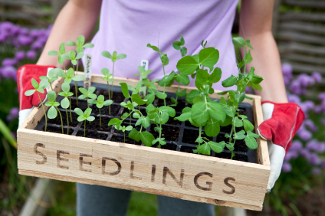
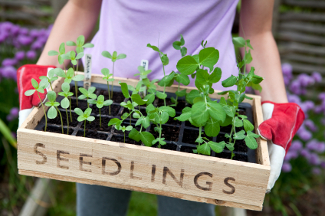 If you want to grow your own food and are starting with lawn, where do you begin? Let’s take a look at three different options. First of all, if you’re not in too much of a hurry to get started, you could try the following. Cover the area down with a thick layer of farmyard manure or compost and then with a sheet of black plastic. Leave for a year. The lack of light (due to the plastic) will kill of the grass and the worms will do the digging work for you (if you leave them alone for long enough).
If you want to grow your own food and are starting with lawn, where do you begin? Let’s take a look at three different options. First of all, if you’re not in too much of a hurry to get started, you could try the following. Cover the area down with a thick layer of farmyard manure or compost and then with a sheet of black plastic. Leave for a year. The lack of light (due to the plastic) will kill of the grass and the worms will do the digging work for you (if you leave them alone for long enough).
This is clearly not the method to use if you are hoping to get started this spring, but if you are willing to leave the area be for 12 months (maybe put a small raised bed somewhere else so you can grow this year) this is the easiest and cheapest approach.
The second option to consider is raised beds – this is the quickest way to get going though not necessarily the cheapest. Use untreated timber and build a raised bed of no more than 1.2m wide so that you can always reach in to the centre of the bed (you should never walk on the soil in your veggie beds as it compacts it).
The bed can be as long as you want. Fill it with a mix of 70% soil and 30% compost. If you wish, before you put in the soil, put a good thick layer of cardboard and newspaper on the grass and then wet it - this will rot down and also kill off the grass. You will be able to sow in a raised bed almost immediately after filling it - leave it a few days to allow the soil to settle.
The third option is to get out your spade and dig, the old fashioned way! If you feel the soil is good in your garden, then there is probably no reason to go to the expense of a raised bed. With "single digging" you dig out trenches to a spades depth, known as a spit, and about 30cm (12in) wide. Place the soil from the first trench on the ground in front and work backwards along the plot, turning the soil from each subsequent trench into the one in front (so that the grass on each sod is facing down in to the trench).
When you have made the final trench, you turn the sods from the very first trench in to it. You will need to leave the bed be for about 4-6 weeks and then turn it over gently with a fork before planting in to it.
 GIY Get Ireland Growing Campaigns
GIY Get Ireland Growing Campaigns
This year, we’re all about getting Ireland growing! Check out our website (www.giyireland.com) for more information on the GIY Get Ireland Growing campaigns:
• The GIY Get Ireland Growing Fund in partnership with AIB. If you are a community group or school developing a growing initiative in Ireland you can apply for a grant between €500 and €5000. Check out our website for application forms and criteria.
• The innocent GIY Sow & Grow schools campaign aims to get 100,000 school children sowing seeds in the next three years. Your school can apply for a FREE Sow & Grow kit and start their GIY journey.
• Operation GIY Nation – we can get your family growing food! Sign up and get emailed monthly simple GIY projects that you can do with your family.
Things to do this Month - March
To Do
Continue to prepare ground – there is still time to prepare a plot to grow veg this year. Fork or rake over existing beds, breaking up large clods of earth. Cover new seedlings with fleece if a frost is due. Start your daily slug patrols and lay beer traps. Don’t let new-season weeds take over – get on top of them with weekly hoeing.
Sow
Indoors: lettuce, aubergine, peppers, cucumbers, celery, celeriac, sweet corn, basil, leeks, summer cabbage, cauliflower, Brussels sprouts, parsley, courgette, French beans.
Sow outdoors or under cover: broad beans, red cabbage, carrots, cauliflower, spinach, kale, Brussels sprouts, onions, leeks, turnip, peas, radishes, early lettuce, asparagus. Plant your first early seed potatoes, as soon as weather conditions allow.
Harvest
This month you could be enjoying (from the ground and from storage) onions, leeks, parsnips, potatoes, some varieties of lettuce, mint, sprouting broccoli, kale, rhubarb, chard, the first of the spring cauliflowers and cabbage, and spinach (perpetual, spinach beet).
Recipe of the Week – Ham and Leek Pie
This is a delicious Jane Hornby recipe for a warming pie. You could use any cold meat in this really from cold ham to chicken or even turkey – so, it’s a great Monday night dish to use up leftover meat from Sunday dinner. Using a pack of puff pastry makes it a sinch to make.
Serves 4-6.
Ingredients
• 2 tbsp butter
• 1 large onion, finely chopped
• 3 leeks, finely sliced
• 2 large potatoes, cut into small cubes
• 2 tbsp plain flour, plus extra for dusting
• 300ml chicken or ham stock
• 100ml pot crème fraîche
• 2 tsp wholegrain mustard
• 200g cooked ham, shredded
• 4 bay leaves, optional
• 375g pack puff pastry
• 1 egg, beaten, to glaze (or use
Directions:
Heat a large frying pan, melt the butter, then add the onion and leeks. Cover, then very gently cook for 15 minutes until soft. Add the potatoes after 5 minutes cooking.
Stir in the flour, turn up the heat, then add the stock, stirring until the mix thickens a little. Take off the heat, then stir in the crème fraîche, mustard and ham. Season to taste.
Spoon the mix into a large pie dish, adding a couple of bay leaves. Heat oven to 220C.
Roll out the pastry on a floured surface until it’s the same size as the dish roughly. Lay it on top of the dish and tuck the sides in. Cut a few slits to let the steam escape, then brush all over the top with egg.
Bake for 30 minutes until golden brown.
Tip of the Month – Sow Onion Sets
Onions are typically grown from ‘sets’ (a fancy name for baby onions) rather than from seed. Sets are usually planted from mid March to mid April, depending on the weather and will take approx 5 months to mature so if you sow this month, you will probably be harvesting in mid August.
To plant your sets: firm the surface of the soil and plant the onion sets 4 inches apart in rows 9 inches apart. Push the set gently down in to the soil, leaving the tip just showing above the surface. If you have already bought your onion sets and are waiting for the weather to warm up a bit before planting, spread out the sets in a cool, well-lit place to prevent early sprouting.
Onions can also be grown from seed but take a bit longer (but it's also alot cheaper).
------------------------------------
Get Involved
 GIY aims to create a healthier, more sustainable world where people grow their own food. We bring people together in community groups and online to share tips and knowledge. We also run events and programmes to inspire and support people to grow their own. GIY is a registered charity (CHY 18920) and proudly supported by Woodies DIY. Support our work by becoming a member of GIY for €35 and receive a member’s pack with seed selection, member’s card, GROW magazine, grower’s guides and more.
GIY aims to create a healthier, more sustainable world where people grow their own food. We bring people together in community groups and online to share tips and knowledge. We also run events and programmes to inspire and support people to grow their own. GIY is a registered charity (CHY 18920) and proudly supported by Woodies DIY. Support our work by becoming a member of GIY for €35 and receive a member’s pack with seed selection, member’s card, GROW magazine, grower’s guides and more.
For more tips, information and support visit www.giyireland.com
Michael Kelly is a freelance journalist, author and founder of GIY Ireland.
© GIY Ireland 2012 – all rights reserved.
Grow it Yourself - April
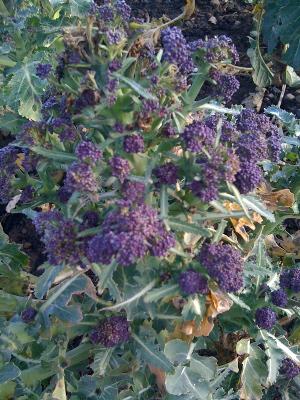

People shake their heads and say that the world is gone mad and climate change is causing havoc, but then again March has a track record of throwing up unpredictable weather. So perhaps this is just normal.
Either way, the cold weather has caused things to slow down in the veg patch after a couple of productive weeks. Growth in my seedlings in the polytunnel has slowed almost to a stop – the lack of sunlight means I am not even having to water them all that much since the potting compost is not drying out.
One suspects that the newly planted spuds aren’t doing a whole lot in the cold ground outside either. Rhubarb, the only thing that was starting to be very productive, seems to have been knocked back too with the leaves looking burned. I fret that it’s frost damage and wonder whether they will bounce back.
This growth “pause” couldn’t come at a worse time really, considering that the larder is now starting to look very bare. This week we used up the last of our stored carrots, onions, shallots and pumpkins (though I have to say that I was cheered up immensely when I cut open the last pumpkin and saw the beautiful, vibrant orange colour of the flesh).
So anyway, with the exception of chutneys/pickles, some frozen veg in the freezer, and the stalwarts of the polytunnel (oriental greens) and the winter veg garden (purple sprouting broccoli, perpetual spinach and chard) – pickings are slim indeed. All of nature is in a holding pattern – roll on the spring.
 Operation GIY Nation - 6 Projects. 6 Months. 1 Healthy, Happy Family.
Operation GIY Nation - 6 Projects. 6 Months. 1 Healthy, Happy Family.
Operation GIY Nation, our programme to get families growing food, starts up again this week. We are aiming to help families that have never grown food before to start their GIY journey and help them to get over that early, daunted phase. The idea behind the campaign is simple – we give your family a simple growing project to do each month for six months, thereby gradually building your level of expertise and confidence.
We start this month with growing cress (one of the absolute easiest things to grow) and by September we will have you and your family growing your own spuds for Christmas. Sign up to receive the projects, absolutely free, at www.giyireland.com/giynation.
Things to Do This Month – April
To Do
If poor weather in March has hampered your outdoor work, then April is the month to catch-up. The key words for April are weeds and slugs. You need to stay on top of them both. Check your early spuds regularly and ‘earth-up’ as required. Water your tunnel/greenhouse – things can get pretty warm on a nice sunny April day and seedlings will dry out quickly.
Sow
Indoors: lettuce, tomato, pepper, chilli-pepper, cucumber, celery, celeriac, basil, leeks, cabbage, cauliflower, Brussels sprouts, parsley, courgette, marrow, globe artichoke, beans, sweet corn and pumpkin.
Outdoors: broad bean, onion sets, pea, beetroot, cabbage, spinach, Brussels sprouts, parsnip, spring onion, leek, carrot, radish, broccoli, turnip. Plant out cabbage plants when they are 15/20 cm tall into well prepared soil that has been manured.
Harvest
Stored fruit and vegetables are likely to be a distant memory at this stage and new crops are only starting to trickle in which makes April a tricky proposition. The middle of this month might see the first asparagus and the first early spring cabbage. The other two star performers this month are purple sprouting broccoli and rhubarb.
Recipe of the Week – PSB with anchovy and chilli dressing
When the first harvests of purple sprouting broccoli (PSB for short) arrive, I always reach for this recipe from Hugh Fearnley Whittingstall – it’s a sinch to make and proves that PSB can be a meal in itself (or at the very least an exciting starter).
Ingredients:
· 700g PSB or curly kale
· 50g anchovy fillets
· 150ml olive oil
· 2 garlic cloves
· fresh thyme
· ½ small red chilli (or a pinch dried flakes)
· 1 teaspoon dijon mustard
· 2 teaspoons red wine vinegar
Blend all the ingredients bar the PSB in a blender until smooth. Steam the PSB for just 3-4 minutes. Toss in a knob of butter. Warm the dressing over a low heat adding a knob of butter. Arrange the PSB on a plate and drizzle over the dressing.
Serve with crusty bread to mop up the juices. Delicious.
Tip of the Month – Protecting Brassica Seedlings from Cabbage Root Fly
Brassica seedlings (cabbage, kohlrabi, broccoli, kales) are vulnerable to cabbage root fly - the maggot of the fly bore in to the roots of the plants. Protect the seedlings with brassica "collars" which go around the base of the plant on the ground and prevent the fly from laying its eggs.
You can buy collars or make your own with carpet, underlay or roofing felt - a 3-inch disc of material will do the job. Growing garlic or chives nearby also puts them off apparently though I am always skeptical about how well companion planting like this works in practical terms..!
------------------------------------
Get Involved
 GIY aims to create a healthier, more sustainable world where people grow their own food. We bring people together in community groups and online to share tips and knowledge. We also run events and programmes to inspire and support people to grow their own. GIY is a registered charity (CHY 18920) and proudly supported by Woodies DIY. Support our work by becoming a member of GIY for €35 and receive a member’s pack with seed selection, member’s card, GROW magazine, grower’s guides and more.
GIY aims to create a healthier, more sustainable world where people grow their own food. We bring people together in community groups and online to share tips and knowledge. We also run events and programmes to inspire and support people to grow their own. GIY is a registered charity (CHY 18920) and proudly supported by Woodies DIY. Support our work by becoming a member of GIY for €35 and receive a member’s pack with seed selection, member’s card, GROW magazine, grower’s guides and more.
For more tips, information and support visit www.giyireland.com
Michael Kelly is a freelance journalist, author and founder of GIY Ireland.
© GIY Ireland 2013 – all rights reserved.
Grow it Yourself - July

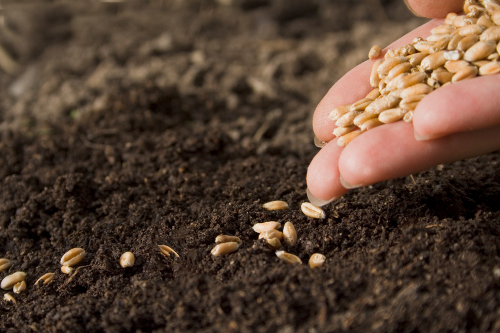 I am growing scorzonera for the first time this year and enjoying the sight of it in the summer veg patch while waiting patiently to try it later in the autumn. This oddly named vegetable is relatively unknown in Ireland, but it is one that is well worth growing. It is grown for it’s long brown/black slender roots which are similar in taste to artichokes, and (to a lesser extent) for its spring shoots which are like asparagus.
I am growing scorzonera for the first time this year and enjoying the sight of it in the summer veg patch while waiting patiently to try it later in the autumn. This oddly named vegetable is relatively unknown in Ireland, but it is one that is well worth growing. It is grown for it’s long brown/black slender roots which are similar in taste to artichokes, and (to a lesser extent) for its spring shoots which are like asparagus.
Scorzonera needs a light, friable and sandy soil to grow well – it should never be grown in manured soil as (like carrots) it will fork. It is sown in late April or May in a well-prepared seed bed in rows 30cm apart and about 5cm deep in a drill. The seeds are large and easy to handle – you can sow two or three seeds every 10cm, and then remove the weaker seedlings leaving one at each 10cm interval. Once they have germinated there is very little work required – keep the bed weed free and water in very dry weather.
 The roots can be harvested from October but allow them to experience a frost or two to sweeten them up. The flowers are also edible. The roots are notoriously difficult to harvest without snapping, so it might be effective to grow the roots in pots for easy harvesting. Some roots can be left to overwinter (with foliage removed) – the new spring growth the following year is asparagus-like in taste.
The roots can be harvested from October but allow them to experience a frost or two to sweeten them up. The flowers are also edible. The roots are notoriously difficult to harvest without snapping, so it might be effective to grow the roots in pots for easy harvesting. Some roots can be left to overwinter (with foliage removed) – the new spring growth the following year is asparagus-like in taste.
The key when cooking is to remove the skins after boiling – otherwise preparing them can be cumbersome. Clean the roots and cut in to short lengths and boil in salted water for 25 minutes. Drain and then rub off the skins. Toss in a little melted butter.
Things to do this Month – July
To-Do
Any ground that has finished cropping must be quickly cleared away to take more vegetables. Use your produce - eat it, freeze it, process it, exchange it, give it away. Continue to water and feed plants and practice good weed control. Earth up brassicas such as Brussels sprouts - these plants will grow tall and require a good deal of support. Net plants to keep butterflies and the cabbage moth away.
Cut down legume plants that have finished cropping - leave the roots in the soil as they fix nitrogen in the soil. Give pumpkins plenty of water and apply a high-potash liquid feed.
Sow
Continue successional sowings and use quick maturing varieties for autumn use - Swiss chard, lettuce, rocket, salad onions, radish, turnips, peas, French Beans (dwarf), carrots. Sow for winter use - spring cabbage, Hungry Gap kale, parsley, perpetual spinach, chicory and coriander. Plant strawberries now for a good crop next June. Propagate rosemary, sage and mint from cuttings now.
Harvest
July and August are peak months for produce – enjoy it! First crops of French and runner beans, tomatoes, peppers, cucumbers, courgette and aubergine, marrows, globe artichokes. Continue to harvest new potatoes, beetroot, calabrese, cauliflower, cabbage, spinach, carrots, turnips, shallots, garlic, radish, spring onions, salad crops, strawberries, raspberries, tayberries, currents (black, red and white), gooseberries, loganberries, peas, broad beans. Ask yourself – do you really need to go to the supermarket?!
 Recipe of the Month – Ratatouille
Recipe of the Month – Ratatouille
This is the ultimate seasonal recipe for July, celebrating the arrival of the first great summer crops such as courgette, aubergine and (in particular) tomatoes. This recipe from River Cottage serves 4-6.
Ingredients:
• 250g aubergine, cut into 2cm cubes
• 250g small courgettes, cut into 1cm slices
• 250g sweet cherry or Sungold tomatoes, left whole
• 250g onions, in fairly thick slices
• Salt and freshly ground black pepper
• 4 garlic cloves, finely chopped
• A handful of basil leaves, torn
Directions:
Put a pan over a medium heat, add a splash of olive oil and begin to fry the aubergines (these take longer than the rest of the vegetables, so start them off first). Put three more small pans over medium heat and cover the base of each with a little olive oil, then put the courgettes, tomatoes and onions into their own pans.
Cook the courgettes until tender, then turn up the heat a little to brown them lightly. The tomatoes should be wrinkled and sweet, but just about holding their shape. And the onions should be soft, sweet and slightly caramelised. The aubergine, when finished, should be very soft and tender, almost creamy. Season the vegetables towards the end of cooking, then remove each from the heat. When the vegetables are done, toss them gently together in a large pan and heat through for a few minutes with the garlic, then add the torn basil leaves.
Heat a grill or griddle pan, brush bread with oil and toast lightly on both sides. Spoon the ratatouille over the bruschetta and serve.
Tip of the Month – Dealing with Pigeons
Pigeons can be a serious veg patch pest, particularly for peas and the leaves of all brassica plants (broccoli, cabbage, cauliflower etc). They are a particular nuisance in early spring when their food sources are scare, but they can be seen, loitering with ill-intent, pretty much all year around. You will know that pigeons have been active in your veg patch if you see torn leaves (often plants will be stripped to the stalk). There are many bird scaring devices on the market and home-made options include hanging CDs from some twine etc – in my experience, none of these work for long. The only sure fire way to protect plants is by netting them.
------------------------------------
Get Involved
 GIY aims to create a healthier, more sustainable world where people grow their own food. We bring people together in community groups and online to share tips and knowledge. We also run events and programmes to inspire and support people to grow their own. GIY is a registered charity (CHY 18920) and proudly supported by Woodies DIY. Support our work by becoming a member of GIY for €25 and receive a member’s pack with seed selection, member’s card, GROW magazine, grower’s guides and more. www.giyireland.com
GIY aims to create a healthier, more sustainable world where people grow their own food. We bring people together in community groups and online to share tips and knowledge. We also run events and programmes to inspire and support people to grow their own. GIY is a registered charity (CHY 18920) and proudly supported by Woodies DIY. Support our work by becoming a member of GIY for €25 and receive a member’s pack with seed selection, member’s card, GROW magazine, grower’s guides and more. www.giyireland.com
Michael Kelly is a freelance journalist, author and founder of GIY Ireland.
© GIY Ireland 2013 – all rights reserved.
Grow it Yourself - August
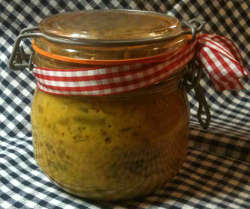
 For me, August is the ultimate payback month, when all the hard work of the year really starts to pay off. Somehow, it never seems as busy as other months. August and September sees us poised between the hard work of the current growing year and the hard work of preparing for the next one. We could hardly be described as bone idle, but we can kick back a little and enjoy the fruits of our labour.
For me, August is the ultimate payback month, when all the hard work of the year really starts to pay off. Somehow, it never seems as busy as other months. August and September sees us poised between the hard work of the current growing year and the hard work of preparing for the next one. We could hardly be described as bone idle, but we can kick back a little and enjoy the fruits of our labour.
We’re done with most of the toil of preparing and growing vegetables - preparing soil, sowing, potting on, planting out etc). The key harvesting jobs (lifting main crop carrots, potatoes, celeriac, turnips, beetroot etc) can wait until next month. And, the prep work for the 2014 growing season (clearing beds, getting them covered down with compost and manure etc) has yet to begin.
Even the weeds are, generally speaking, not such an issue by now, as the main growth of the year has already passed. So if you’ve been diligent about your weeding through spring and early summer, an occasional hoeing now should be enough to keep on top of things.
The only fly in the ointment potentially is a prolonged hot and dry spell, which necessitates long bouts of watering outside. We GIYers are even more demanding about the weather than the rest of the populace – so, yes please, give us a dry spell by day so we can take to the beach, but we need rain at night so we don’t have to take out the hose each day.
Before we hang up our “sowing” boots for the year, it’s worth bearing in mind that this is pretty much the last chance to get a good crop of winter greens going. If you can therefore, do a good sowing before the end of the month of lettuce, perpetual spinach, chard, lamb’s lettuce, and oriental greens (such as mizuna, mibuna, mustard, tat soi).
Things to do in August
To Do
Green manures (mustard, buckwheat, radish, rye, alfalfa, clover and vetches) are plants which are grown specifically to improve soil fertility and useful at times when beds are empty (as is often the case in August). Grow directly in the bed and then cut down and dig in to the soil. Give pumpkins plenty of water and apply a high-potash liquid feed. Nip out the growing points to encourage the fruits to swell. Net brassicas to keep butterflies and the cabbage moth away (and check undersides of leaves regularly for caterpillars). Keep watering - mulch around plants to retain moisture.
Sow
Continue succession sowing. Sow spring cabbage, red cabbage, winter spinach, salad onions (in polytunnel for spring crop), autumn salad mix, endive, parsley, onion seed, Chinese vegetables.
Harvest
Pick Beetroot regularly as they reach the size you require - if left to grow too large they will loose their tenderness. Continue to harvest tomatoes, carrots, cabbage, cauliflower, peas, broad beans, french and runner beans, salad leaves, radish, turnip, potato, onions, peppers and chilli-peppers, aubergine, globe artichoke, courgettes, cucumber, gooseberries, raspberries and currants.
 Recipe of the Month – Piccalilli
Recipe of the Month – Piccalilli
Cauliflower needs to be harvested as soon as it’s ready (you can’t leave it in the ground or the curds start to open) and it doesn’t store particularly well once picked – so here’s a good recipe for an exotic pickle called Piccalilli that will help you keep it for 6 months. It also uses up some of those other “glut” vegetables like beans and courgettes.
Ingredients
· 1 large cauliflower
· 2 large onions, peeled and quartered and sliced finely
· 900g mixed veg such as courgette, runner beans, carrots and green beans – cut in to bite sized chunks
· 60g salt
· 2tbsp plain flour
· 225g sugar
· 1 tbsp turmeric
· 60g English mustard powder
· 900ml pickling Vinegar
Put all the vegetables in a large bowl. Dissolve the salt in 1.2l of water and pour this over the veg. Put plate on top to keep them submerged and leave for 24 hrs.
Drain and rinse the next day. Bring a large pan of water to the boil – add the veg and blanch for 2 minutes. Drain and refresh in cold water.
Put flour, sugar, turmeric and mustard in a small bowl and mix in a little of the vinegar to make a paste. Put it in a large stainless steel saucepan along with remaining vinegar, bring to the boil and stir continuously so that no lumps appear.
Reduce heat and simmer for 15 mins. Add veg to the sauce and stir well so they are coated.
Ladle in to sterilised jars and use a non-metallic lid to seal. Allow to mature for one month before using.
This recipe will make 5lbs.
Be Inspired. Be Informed. The GIY Gathering 2013 – September 14/15
The 5th annual GIY Gathering takes place in Waterford on the 14th and 15th of September as part of the Waterford Harvest Festival. The event will bring together up to 400 people from every corner of Ireland for a two day festival of learning and to share tips, ideas and advice on growing your own food.
This year's Gathering brings together some of the world's leading food-growing experts and advocates from Ireland, UK, and US. Speakers include Charles Dowding, Wenonah Hauter (Foodopoly), Michael Kelly, Alys Fowler, Mark Diacono, Darina Allen, Joy Larkcom, Ella McSweeney, John McKenna, Kitty Scully and Bruce Darrell.
Tickets from www.giyireland.com.
Tip of the Month – Save Tomato Seeds
If you had a variety of tomato that was a particular success this year, why not try saving the seeds from the tomatoes to grow next year’s plants? You should only save seed from open-pollinated varieties of tomatoes, and not hybrids. Pick a nice big, ripe tomato and cut it in half. Squeeze the contents (seeds, gel and juice - not flesh) in to a cup or container and label the cup with the variety. Half fill the cup with water. After a few days a mould will form on the water, which is a sign that the seed coating has dissolved.
Pour off the water and any floating seeds (these are duds that wont germinate). The good seeds should be on the bottom of the cup. Rinse the seeds under a cold tap in a very fine mesh strainer. Put the seeds in a single layer on a paper plate and leave for a few days to dry. Bag them up in a labelled envelope and store them somewhere cool (or refridgerate) until next spring.
 Get Involved
Get Involved
GIY aims to create a healthier, more sustainable world where people grow their own food. We bring people together in community groups and online to share tips and knowledge. We also run events and programmes to inspire and support people to grow their own.
GIY is a registered charity (CHY 18920) and proudly supported by Woodies DIY. Support our work by becoming a member of GIY for €25 and receive a member’s pack with seed selection, member’s card, GROW magazine, grower’s guides and more. www.giyireland.com
Michael Kelly is a freelance journalist, author and founder of GIY Ireland.
Grow it Yourself - September
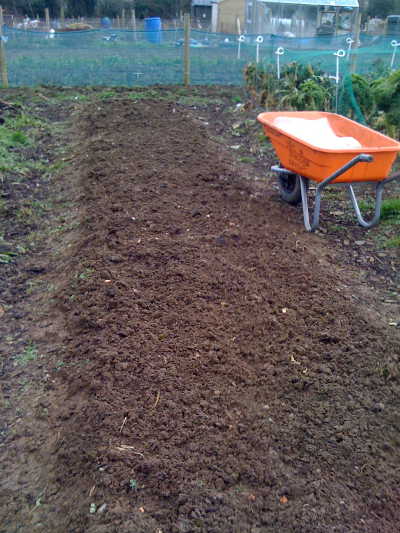
 Stop treating your soil like dirt
Stop treating your soil like dirt
Soil. Well, it’s just dirt really, isn’t it? It’s something to be cleaned off our boots and scrubbed off our hands, right? When I started growing my own food, I didn’t have much respect for the soil that the veg was growing in. My focus was on the seed, the plants, the vegetables. The soil was actually a source of annoyance to me - it had to be dug, raked, hoed, rotavated, coaxed and cajoled.
If we brought in a big digger and scraped the thin little layer (about 6 to 8 inches) of rich topsoil off the surface of our planet, all life as we know it would cease to exist. Plant matter would not grow, and without plant matter there would be no animals (including humans).
Given its importance to our survival, it’s strange that we treat it with such contempt. Centuries of commercial agriculture has assumed that we can continue to rob the soil of it’s nutrients by growing intensively from it and that all we need to do is replace the three core nutrients of nitrogen, phosphorus and potassium (the key ingredients of commercial NPK fertiliser).
In fact, what soil needs to support life is far more complex than that. Composts and manures (which are the organic alternative to chemical fertilisers) also return dozens of trace minerals and other nutrients to the soil – the vegetables that grow in this soil have more nutrients in them as a result and healthier veg leads to healthier people.
Then, having served their purpose in the kitchen, the vegetable trimmings and waste are returned to the compost, releasing the nutrients that are left back to the compost heap and then eventually back to the soil. Even a cursory understanding of this never-ending cycle of growth-maturity-decay leads you to one conclusion: growing your own food is actually ALL ABOUT THE SOIL.
From that perspective, my most significant achievement as a GIYer has been to learn how to make proper compost. Each winter I put wheelbarrow loads of the crumbly stuff on my vegetable beds. And each year my soil starts to look less like a potter’s clay, and becomes a little darker, a little more crumbly and a lot more lovable. In a nutshell - I’ve stopped treating my soil like dirt...
The GIY Gathering 2013
400 food growers and food lovers will descend on Waterford for the 5th annual GIY Gathering which takes place on September 14th and 15th. The event brings together some of the world’s leading food growing advocates, experts and writers for two days of inspiring and practical debate, discussion, talks and workshops.
Speakers include Foodopoly author Wenonah Hauter, ‘no-dig’ guru Charles Dowding, Guardian food writer Tom Maggoch, BBC presenter Alys Fowler, author Joy Larkcom, and River Cottagers Mark Diacono and Steve Lamb. A two-day pass costs just €30.
Tickets from www.giyinternational.org.
Things to do this month
Lift crops which have finished growing and dress bare soil with manure, compost (or plant green manures). Wasps can be problematic as fruit ripens so make traps from jars of sugary water. Remove surplus leaves from tomato plants which allows air to circulate and sunshine to fall on the fruit. Go blackberry picking!
Sow
Last month for sowing perpetual spinach, chard and oriental salads – it will be worth it in the New Year when there’s almost nothing else to eat, so get sowing! In the polytunnel/greenhouse sow lettuce, mustard, cress, basil, coriander, parsley, radish, dwarf early pea, broadbean, cauliflower seed, rocket, onion seed and garlic. Outside sow white turnip seeds and autumn onion sets, e.g. ‘centurion’ and ‘sturon’. Plant out strawberry runners. Pot up some parsley for winter use.
Harvest
Lift onions and leave to dry out in sun or in the polytunnel/greenhouse for two weeks. Apples, plums, pears are now in season. Continue to harvest salad leaves, tomatoes, radish, potatoes, carrots, turnips, beetroots, cauliflower, cucumbers, peppers, beans, courgettes, spinach, leeks, red cabbage, summer cabbage, aubergine, sweet corn.
Recipe of the Month – Punjabi Style Pickle
Here’s a Madhur Jaffrey recipe for an early autumn veg pickle that can be eaten immediately.
Ingredients
· 3 tbsp jaggery (cane sugar) or palm sugar or light brown sugar
· 175ml/6fl oz cider vinegar
· 120ml/4fl oz extra virgin olive oil (you can use mustard oil, peanut oil or vegetable oil)
· 1-2 garlic cloves, peeled and crushed
· 1 tsp finely grated fresh ginger
· 400g/14oz small cauliflower florets
· 5 medium carrots, peeled and cut into 5cm/2½in pieces
· 225g/9oz baby turnips, peeled and halved
· 2 tsp whole brown mustard seeds, ground in a clean coffee grinder
· 2 tsp salt
· a mixture of 1 tsp chilli powder and 1½ tsp bright red paprika
· ½ tsp garam masala
Directions:
Combine the sugar and vinegar in a small pan set over a low heat, stirring occasionally. Heat until the sugar has dissolved, then turn off the heat. Pour the oil into a large pan set over a medium heat. When the oil is hot, add the garlic and ginger and stir for 30 seconds. Add the cauliflower, carrots and turnips to the pan.
Stir and cook for about a minute or until the vegetables are coated with oil and still fairly crisp. Reduce the heat to low and add the ground mustard, salt, chilli powder and paprika mixture and garam masala. Stir and mix for a minute or two until the vegetables are coated in the spices.
Pour in the palm sugar-vinegar mixture and stir. Take off the heat and allow the pickle to cool.
Spoon the finished pickle into one or two clean jars, with its juices, then refrigerate.
The pickle may be eaten immediately but will keep in the fridge for 3-4 weeks.
Tip of the Month – Pumpkin/Squash Care
You can leave pumpkins and squashes on the plant until October however you need to keep an eye on the fruit to make sure it doesn’t rot. Mildew is the main disease problem, manifesting as a white powdery mould on the leaves - remove badly infected leaves and spray remaining leaves with a milk spray (9 parts water to one part milk in a spray bottle).
Raise the fruit up off the ground on to a piece of slate or in a pot so that it is not touching wet soil. Remove leaves near the fruit to allow the sun in on them, which will help with ripening. They will continue to develop colour after being removed from the plant if left somewhere warm and sunny - a greenhouse, warm windowsill or polytunnel would be ideal (but do not allow to get wet). Remove fruit with about 3 inches of stem left on. Stored fruit once properly "cured" (i.e. skin has firmed up) will last many months.
Handle carefully so as not to bruise them.
Get Involved
 GIY aims to create a healthier, more sustainable world where people grow their own food. We bring people together in community groups and online to share tips and knowledge. We also run events and programmes to inspire and support people to grow their own.
GIY aims to create a healthier, more sustainable world where people grow their own food. We bring people together in community groups and online to share tips and knowledge. We also run events and programmes to inspire and support people to grow their own.
GIY is a registered charity (CHY 18920) and proudly supported by Woodies DIY. Support our work by becoming a member of GIY for €25 and receive a member’s pack with seed selection, member’s card, GROW magazine, grower’s guides and more. www.giyireland.com
Michael Kelly is a freelance journalist, author and founder of GIY Ireland.
Grow it Yourself - November
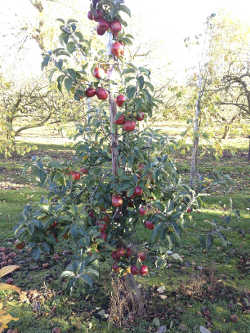
 If, like me, you like your apples, you will almost certainly have noticed how badly served we are by the commercial food chain when it comes to this wonderful fruit. Though there are literally thousands of apple varieties available around the world, just a handful make up the vast majority of apples sold by supermarkets.
If, like me, you like your apples, you will almost certainly have noticed how badly served we are by the commercial food chain when it comes to this wonderful fruit. Though there are literally thousands of apple varieties available around the world, just a handful make up the vast majority of apples sold by supermarkets.
The famous southern hemisphere apples (Pink Lady, Royal Gala etc) have been chosen largely for their ability to withstand long journeys and even longer bouts on the storage shelf. So if you want to experiment with flavour and diversity, you really have to seek out dedicated Irish growers (like Con Traas at The Apple Farm in Tipperary) or grow them yourself.
It’s a great time of the year to consider planting an apple tree (while the trees are dormant). It’s important to give some thought to how much space you have – left to its own devices, an apple tree will eventually take over your entire garden, but modern breeders have been able to graft varieties on to different root stocks to keep them in check.
So you can get a tree size to suit your needs. Springfield Nursery in Dungarvan even developed a miniature apple tree – the coronet - that can be grown in a 25 litre pot and has two apple varieties on the one tree. Clever or what?
I planted 6 apple trees out in the front garden three years ago this winter – varieties Katy, Elstar and Jonagold. I had almost no apples from them in 2012, but this year they have sprung in to life in a big way. The star performer was the early variety Katy (known in its native Sweden as Katya) which had over a hundred apples on it (yes, in a state of excited anticipation, I counted them).
The apples were a little on the small side (perhaps because it’s a relatively young tree?), but they tasted very pleasant indeed – very juicy, with a mild apple flavour that has a hint of strawberry. The apples can be eaten fresh (I grabbed two each morning before I got in to the car to go to work – the ultimate convenience food), but the acidity means that they also worked well in crumbles and tarts.
Katy is an incredibly easy apple to grow and it’s very productive, so a great variety to buy if you’re just starting out. The apples will ripen even in the worst of summers, as it was bred for the cold northern climate of Sweden.
 Things to do this month - November
Things to do this month - November
To Do
Do not leave beds bare for the winter – sow a green manure, or cover with a thick layer of manure/compost and then black plastic or straw. This will return nutrients to the soil, keep the worst of the weather off it, suppress weeds and prevent leaching of nutrients. ‘Earth up’ or tie up vegetables such as cabbage, cauliflower and Brussels sprouts. Divide up your rhubarb if you want to propagate, and cover it with a thick mulch of manure. Prune apple trees. Mulch fruit bushes. Take cuttings of currant bushes from current season’s wood.
Sow
Sow broad beans outside now for an early crop next spring. To avoid rotting before germination, make small newspaper cups and germinate them indoors first. Next summer’s garlic does best if it’s planted before Christmas – plant outdoors in well prepared soil in a sunny spot. Though I have to admit I never bother with them, some varieties of onion can over-winter and will be ready to harvest in early summer.
Harvest
Continue to harvest perpetual spinach, cabbage, cauliflower, potatoes, swede, parsnips, apples, pears. Start harvesting leeks, winter cabbage, kale, artichokes, Brussels sprouts. Time to lift carrots and turnips or at least cover them with a good layer of straw to protect them from frost damage.
Recipe of the Month – Spiced Carrot and Lentil Soup
This recipe from Jane Hornby is packed full of iron. You can use a can of coconut milk instead of milk if you want to keep it dairy free. For a warming and nutritious supper, add some cooked strips of chicken at the end of cooking. Serves 4.
Ingredients
· 2 tsp cumin seeds
· pinch chilli flakes
· 2 tbsp olive oil
· 600g carrots , washed and coarsely grated (no need to peel)
· 140g split red lentils
· 1l hot vegetable stock
· 125ml milk
· plain yogurt and naan bread, to serve
Directions:
Heat a large saucepan and dry-fry the cumin seeds and chilli flakes for 1 min, or until they start to jump around the pan and release their aromas. Scoop out about half of the seeds with a spoon and set aside. Add the oil, carrot, lentils, stock and milk to the pan and bring to the boil.
Simmer for 15 mins until the lentils have swollen and softened. Whizz the soup with a stick blender or in a food processor until smooth (or leave it chunky if you prefer). Season to taste and finish with a dollop of yogurt and a sprinkling of the reserved toasted spices. Serve with warmed naan breads.
Tip of the Week – Keep on Harvesting
Given the short days, inclement weather and the fact that we are already seeing the first C*****mas ads on the telly, its easy to forget that the season of harvest is still upon us. Many GIYers will still have tomatoes, peppers, chilipeppers, salad leaves and herbs in their polytunnels/greenhouses and of course outside we are in the full bloom of fabulous hardy crops like carrots, parsnips, celeriac, celery, leeks, beetroot, turnips, spinach, cabbage, kale, artichokes, brussels sprouts, swede, apples and pears. So for another few weeks let’s stay focussed on the veg patch bounty.
 About GIY
About GIY
GIY is a not-for-profit organisation that aims to create a healthier, more sustainable world where people grow their own food. We inspire and support people to grow food more successfully by bringing them together to share advice, tips and ideas. There are approximately 50,000 people involved in the GIY movement in Ireland.
For more information check out www.giyireland.com
Michael Kelly is a freelance journalist, author and founder of GIY Ireland.
© GIY Ireland 2013 – all rights reserved.
Grow It Yourself - December
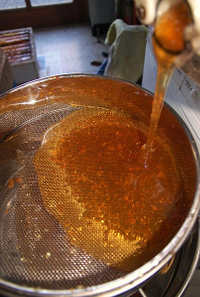
I can’t confess to know a lot about beekeeping. Actually, correct that, I know absolutely nothing about beekeeping. So, one might be surprised to find a beehive in my garden. But there it is nonetheless, nestling happily in a secluded patch between my polytunnel and the hedgerow.
The fact that I have a beehive in my garden is the result of a strange confluence of fortuitous events. A beekeeper from Waterford city, Mike Hughes, with a lifetime’s beekeeping expertise, who needed somewhere to put a hive. And a honey lover (i.e. me) who has zero knowledge and plenty of space for a hive.
The arrangement is therefore a symbiotic one but (don’t tell Mike) I think I get far more out of it then he does. He shows up occasionally to check in on the bees, and at the end of the season I buy the jars of honey off him, with some basic beekeeping tuition thrown in for free.
The noise of their buzzing provides a welcome backdrop as I work in the veg patch and polytunnel, and of course they are great pollinators for flowering plants such as tomatoes in the tunnel and elsewhere in the garden.
The Food and Agriculture Organisation of the United Nations estimates that of the 100 crop varieties that provide 90 per cent of food worldwide, 71 rely to some extent on bee pollination. So in other words, the unassuming little bee is actually maintaining life on this planet - no bees, no pollination. No pollination, no food. No food, no humans. And make no mistake, bees are under threat: from the gradual disappearance of their natural habitats, the use of pesticides and the parasitic varroa mite which has killed off 30% of bees in Europe (and the entire wild bee population in Ireland).
So, experienced beekeepers like Mike, are a valuable commodity indeed. There are roughly 2,500 beekeepers in Ireland according to the Federation of Irish Beekeepers Association. The organisation has 53 local member associations, each of which has its own programmes of lectures and demonstrations trying to encourage more people to get involved. Check out www.irishbeekeeping.ie.
Things to Do this Month - December
As you clear remaining crops from your veggie patch, dig the beds over and add well rotted compost or manure. Get Educated – book yourself on a course! Start planning what you would like to grow next year and work out what crop rotation system you are going to use. Study seed catalogues carefully before deciding on the best varieties to grow. Start a Compost corner or heap. Keep an eye on your stored veggies and discard anything that’s rotting. Collect and store leaves in bags to make leaf mould or use as cover for bare soil.
Sow
If you haven’t already done so plant garlic – it should be in the soil by the shortest day of the year. Bring herbs like mint, chives, lemon balm, parsley, thyme indoors by lifting and potting them up.
Harvest
Buck the seasonal trend by continuing to harvest winter salad leaves like corn salad, land cress and mizuna. You should still have at least some produce left in the December veggie patch e.g. winter cabbages, Brussels sprouts, leeks, kale, Jerusalem artichokes, carrots, celery, turnips, parsnips, winter cauliflowers, swedes, spinach, chard and celeriac. From your stores you can enjoy pumpkins and squashes, potatoes, onions, apples, beetroot and garlic.
Recipe of the Month – Root Veg Pie
I’m really in to warming, root-based, one-pot dishes at the moment and this is a delicious and healthy pie that will utilize vegetables that are still available in the December vegetable patch (or larder) like carrots, celeriac and squash. It’s one I return to again and again at this time of year. You don’t need to stick too slavishly to the recipe – use whatever root crops you have and experiment. You can leave out the pepper if you want (it’s not likely to be seasonal).
Ingredients:
• 1 quantity short crust pastry – 350g
• 300g potatoes
• 300g celeriac
• 300g squash or pumpkin
• 4 medium mushrooms
• 1 red pepper
• 2 tablespoons olive oil
• 2 tablespoons chopped rosemary
• 300g fresh ricotta (I’ve used feta too and it’s lovely)
• ¾ cup grated cheddar or goats cheese
• ½ cup grated parmesan
Directions:
Preheat the oven to 180 degrees Celsius. To the make the filling place the potato, celeriac, pumpkin, mushrooms and pepper in a baking dish and toss with the oil and rosemary – season well. Bake for 30 minutes until golden. Leave to cool. Roll out the pastry and use it to line a pie dish, trimming away the excess. Mix the vegetables with the ricotta and cheddar, and then fill the pie dish. Sprinkle the parmesan over it. Bake for 35 minutes until the pie is golden. Serves 4.
Tip of the Month – Start Harvesting Early Sprouts
Early maturing sprout varieties are now cropping. Pick sprouts as soon as they are ready to eat (while still hard and firm and before they open out). Pick the sprouts from the bottom of the stem first and then move upwards. To harvest a sprout simply snap off by pulling downwards. The leaves at the top of the stems can be cooked like spring greens – very tasty they are too. For more information on sowing, growing and harvesting sprouts check out the GIY Veg Directory at www.giyireland.com.
 About GIY
About GIY
GIY is a not-for-profit organisation that aims to create a healthier, more sustainable world where people grow their own food. We inspire and support people to grow food more successfully by bringing them together to share advice, tips and ideas. There are approximately 50,000 people involved in the GIY movement in Ireland.
For more information check out www.giyireland.com
Michael Kelly is a freelance journalist, author and founder of GIY Ireland.
© GIY Ireland 2013 – all rights reserved.
Grow It Yourself - January
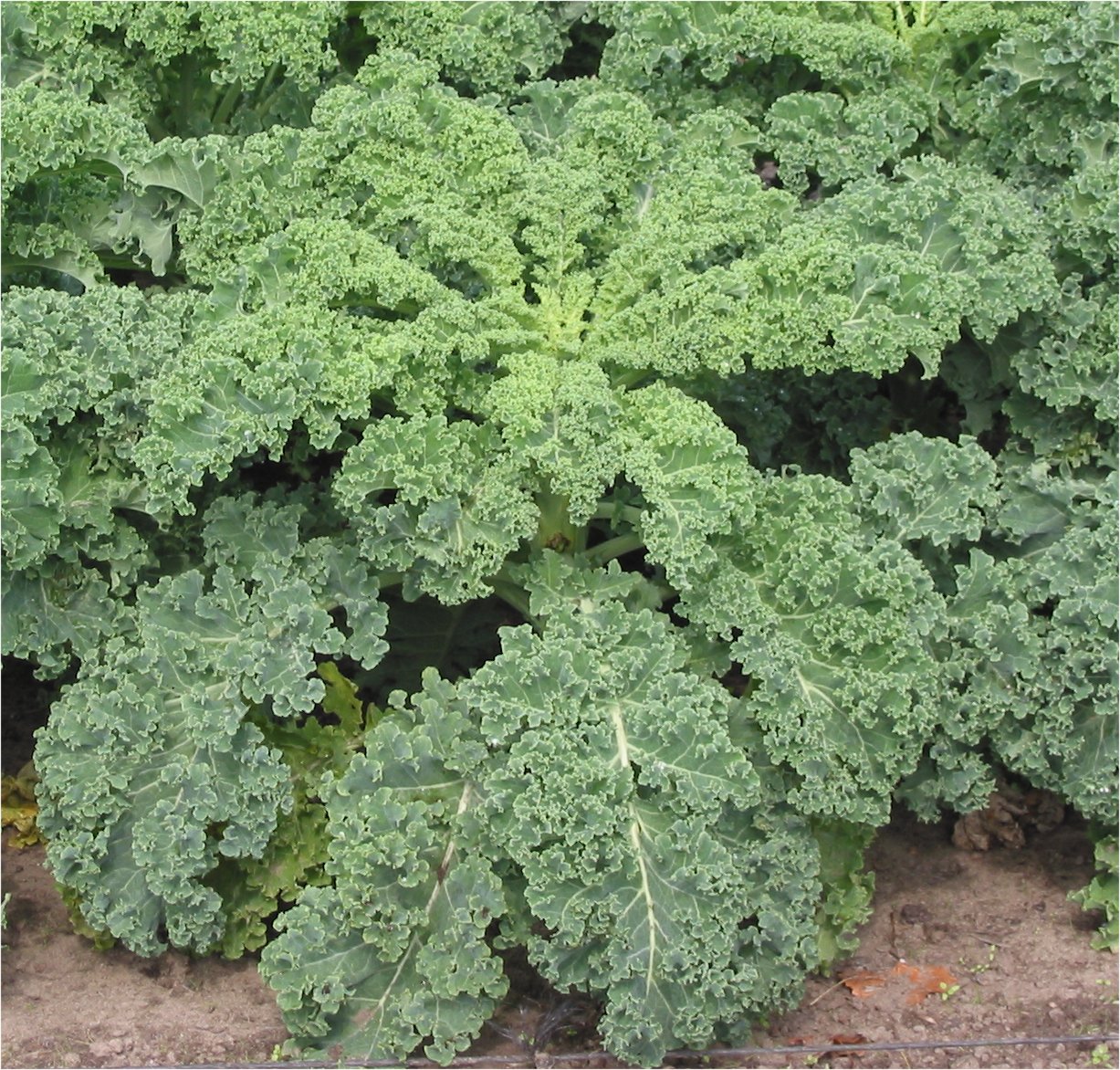
 I’ve tried hard to resist the charms of kale over the years, but finally, perhaps inevitably, I have succumbed. I’ve become somewhat of a kale nut. Kale suffers somewhat from a reputation problem.
I’ve tried hard to resist the charms of kale over the years, but finally, perhaps inevitably, I have succumbed. I’ve become somewhat of a kale nut. Kale suffers somewhat from a reputation problem.
If spinach is the very manifestation of the “eat your greens” horror that is imposed on us as children, then kale is even worse – all rugged and jagged - at least spinach is relatively smooth skinned. Most kale recipes involve disguising it as an ingredient – blitzing it in a soup, or boiling it down in to a stew. Given how formidable it looks, that’s perhaps not surprising.
I blame nutritionist Dorcas Barry for my new kale obsession – it was she that first convinced me to try eating kale raw, in a delicious kale salad that she was giving away on her stall at the GIY Gathering last year. In fact, it was so delicious (see recipe below), I didn’t believe it was kale.
One can’t overestimate just how good for you a raw kale salad is – super food fads come and go, but kale is the real deal. It’s loaded with fibre, vitamins A, C and K, folic acid, potassium and calcium. Per calorie it has more iron than beef and more calcium than milk. It’s considered a valuable anti-inflammatory and is high in cancer-busting anti-oxidants. I never doubted that for one minute – what I did doubt, very much indeed, was that it could be so tasty.
Kale is brilliant to grow at home. Once you protect seedlings from slugs and other critters, it’s one of those near perfect vegetables to grow – very low maintenance but very high return. And once you get the plants started, it’s a doughty survivor - kale will be providing greens right through the winter and hungry gap months, when nothing else is growing in the garden. It’s a “cut and come again” vegetable – in other words, you don’t have to wait for a head to form as you do with cabbage, but rather you continue to cut the leaves and the more you cut the more you can harvest.
Kale plants for overwintering are typically sown in spring – I sowed mine in module trays in the potting shed and planted out about 6-8 weeks later. By now they are 4ft tall and providing much needed colour in an increasingly drab winter garden.
We still have carrots, parsnips and the like to eat from the garden, but already one can imagine a situation where the kale plants will be pretty much the only source of fresh food from the veg patch.
To Do
Plan. This is the time to decide where and what you are going to grow this year. If you are just starting out join your local GIY group for advice and check out our website for handy “getting started” guides and videos. Consider building or buying raised vegetable beds. Order your seeds, onions sets and seed potatoes. Turn over the soil only if the weather is dry – if the soil sticks to your boots it’s too early for digging! “Chit” seed potatoes – put them in a container (e.g. used egg carton or empty seed tray) and leave them in a bright warm place to sprout.
Sow
In mid Feb, in seed trays and pots on a sunny windowsill indoors sow celery, globe artichokes, celeriac, leeks, onions, lettuce, tomatoes, peas, aubergines, peppers/chilli-peppers. Weather permitting outside you can try sowing broadbeans, spinach, kohlrabi, onion and shallot sets, Jerusalem artichokes, parsnip and early pea varieties.
Harvest
You may still have winter cabbage, perpetual spinach, chard, leeks, kale, cauliflowers and Brussels sprouts in your veggie patch and depending on how successful your growing/storage regime last year was, you may well still be tucking in to stores of potatoes, celeriac, carrots, parsnips, onions, cauliflower, jerusalem artichokes, winter squash, pumpkins, leeks and red cabbage.
Recipe of the Month – Kale Salad
This recipe from Dorcas Barry is taken from the 2013 GIY magazine GROW. Massaging the kale with lemon juice effectively cooks it, and makes it far more palatable while retaining its nutrient richness. It will keep for 3 days in the fridge. Serves 4.
Ingredients:
• 250kg kale
• Juice of 1 lemon
• 25g dried cranberries, chopped finely
• 25g pine nuts, roasted
• 4-5 spring onions, chopped finely
• 2-3 stalks of celery, chopped finely
• olive oil
• salt and pepper
Directions
Remove the stalks from the kale and roll each leaf before chopping in to fine strips. Place in a large bowl, add the lemon juice and 2-3 pinches of sea salt.
Massage the kale with the juice and salt until is starts to soften a little, making sure all the leaves are coated.
Sprinkle with olive oil and leave it to sit for another 10 minutes to soften further.
Before serving add the cranberries, pine nuts, celery and spring onion and stir well.
Tip of the Month – Sort your seeds
It’s a great time of the year to address those tasks that we often put on the long finger, like sorting out your seeds. Having a good seed storage regime (if that doesnt sound too nerdy) will make your seed last longer, save you money, and ensure better germination rates. Bear in mind that the storage lives for seeds listed on packets are generally for unopened seeds - the viability of seeds is cut drastically once you open the packet.
Here are three tips with that in mind:
1. tightly close opened seed packets - if they are in a foil or paper wrapper inside the packet, make sure to fold this over tightly.
2. Store the seed packets in a sealed container (e.g. a tupperware container with a tight fitting lid). You could dedicate a container to the different vegetable families, e.g. have one for legumes, one for brassicas, one for roots etc. Store the containers in a cool, dry and dark place.
3. Discard seeds that are out of date - they will only lead to lost time in the veggie patch next year.
 About GIY
About GIY
GIY is a not-for-profit organisation that aims to create a healthier, more sustainable world where people grow their own food. We inspire and support people to grow food more successfully by bringing them together to share advice, tips and ideas. There are approximately 50,000 people involved in the GIY movement in Ireland.
For more information check out www.giyireland.com
Michael Kelly is a freelance journalist, author and founder of GIY Ireland.
© GIY Ireland 2013 – all rights reserved.
Grow It Yourself - February
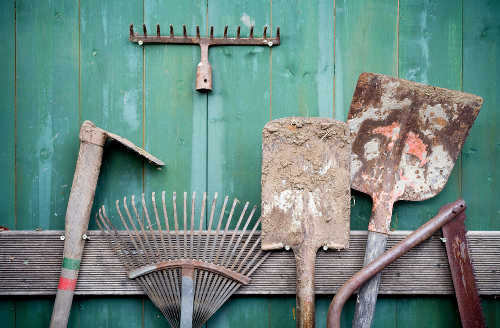
 Though we haven’t quite reached ‘hungry gap’ territory yet, I think it’s fair to say at this stage that we are beginning to pass the point of plenty as far as last year’s harvest is concerned. We still have plenty to eat in the veg patch and in stores, but things are a little scarce and some vegetables are starting to run out altogether.
Though we haven’t quite reached ‘hungry gap’ territory yet, I think it’s fair to say at this stage that we are beginning to pass the point of plenty as far as last year’s harvest is concerned. We still have plenty to eat in the veg patch and in stores, but things are a little scarce and some vegetables are starting to run out altogether.
Last month we ate the last of our onions, and though we still have a braid of shallots in the kitchen, we’ve been buying nets of onions which is annoying. We are in the death throes of our 2013 carrot crop and I am simultaneously pleased to have made it this far and annoyed that I didn’t grow more.
Being the quintessential stock pot and soup ingredient, carrots are one of those vegetables that you really can’t do without, unlike say butternut squash which one could happily forego for a couple of months.
I am going to do an early sowing in the polytunnel but it will be months before they are ready, so for now, reluctantly, I am back to buying them and the perennial hunt for a good source of organic carrots continues.
There are however, other active sources of food. In the kitchen I still have plenty of garlic, squashes, pumpkins, chilli-peppers, and the aforementioned shallots. I’d be lost without the pickle/chutney shelf, particularly when it comes to the school lunches – a simple slice of ham can be turned in to serious sandwich with a good dollop of some chutney or other. The freezer still turns up an occasional nugget of wonderfulness – tonight for example, it was some beautiful broad beans.
In the polytunnel, we’ve still plenty of winter greens. In the veg patch I still have a decent number of parsnips in the ground. I haven’t counted them, but if I had to guess I’d say there are maybe 20-25 of them still.
Close by, there’s a great crop of leeks – surely another 4-6 weeks worth. We used the first of them over Christmas and they truly are wonderful - though they are not classed as a ‘green’, they taste fresh and spring-like.
Finally, there’s also still plenty of life in my kale and perpetual spinach plants and I noticed the other day that the rhubarb plants are showing signs of life again too. So, all in all, there are reasons to be cheerful!
To Do
Turn over the soil only if the weather is dry – if the soil sticks to your boots it’s too early for digging! Keep off the soil to prevent soil compaction - use timber planks to stand on for access. If you have not already done so order/buy your seeds, spuds and onion sets.
“Chit” or sprout seed potatoes – put them in a container (e.g. used egg carton or empty seed tray) and leave them in a bright warm place. Check the pH of your soil – you can buy a soil pH testing kit in any garden centre. Lime your soil now if required (to reduce acidity in very acid soils), particularly important in your brassica bed.
Sow
Finally, we can sow some seeds. On a sunny windowsill indoors, in a heated greenhouse or on a heating mat: sow celery, globe artichokes, celeriac, leeks, onions, lettuce, tomatoes, peas, aubergines, peppers/chilli-peppers. In polytunnel or greenhouse: beetroot, Brussels sprouts, summer and autumn cabbage, carrots, leeks, lettuce, radish.
Outside: Weather permitting you can try planting out broadbeans, spinach, kohlrabi, onion and shallot sets, Jerusalem artichokes, parsnip and early pea varieties.
Harvest
Winter cabbage and cauliflowers, Brussels sprouts, spinach, kale and leeks.
Recipe of the Month – Mick’s Minestrone Soup
This is a completely made up recipe that I cobbled together this week using some vegetables that I brought in from the garden and some standard store cupboard ingredients. So, honestly, I don’t know if Minestrone is the right word for it – but it seems to fit.
The added pasta makes it a substantial feed, and because it’s not blitzed in a blender after cooking, it’s chunky and delicious. You can play around with different vegetables if you don’t have what I added here.
Serves 4.
Ingredients:
• 2 tablespoons olive oil
• 1 onion, chopped
• 1 clove garlic, chopped
• 1 leek, cleaned and finely sliced
• 2 carrots, peeled and chopped small
• Half a butternut squash or small pumpkin, peeled and chopped small
• 500ml good quality homemade chicken stock (or made from an organic stock cube)
• 400ml tin chopped tomatoes (I used the same quantity of passata instead).
• 4 tagliatelle ‘nests’, preferably organic (you could use any type of pasta really).
• 1 bunch spinach leaves, stalks removed and chopped roughly
Directions:
Heat the oil in a large pot and cook the onions and garlic until softened. Add the leek, carrot and squash and toss well so they are coated in oil.
Season well, then cover and cook on a low heat with the lid on the pot, stirring occasionally, for 5-10 minutes.
Then add the stock and tomato and cook with the lid off until the veg is soft (about 10 minutes) – don’t overcook, you don’t want the veg to go to mush.
Stir in the spinach about 5 minutes before the end of cooking.
Meanwhile cook the pasta as per instructions in a pot of boiling, salted water. When it’s cooked, drain and stir it in to the soup pot. Check the seasoning.
Ladle in to warm bowls and serve with some crusty bread.
Tip of the Month – Show your tools some love
Blades on shears, forks, spades, hoes, secateurs and other tools will benefit from an annual overhaul with a sharpening stone (you can buy them in hardware stores).
Prepare the blade with a drop of three-in-one oil. Push the tool forwards and to the side on the stone, exerting a little downward pressure. Then turn the tool over and, holding the blade almost flat against the stone, brush it across the surface to take off any rough edges. Only sharpen the outside blade on bypass secateurs and the upper surface of hoes. Wipe over the blade with an oily rag before storing.
 About GIY
About GIY
GIY is a not-for-profit organisation that aims to create a healthier, more sustainable world where people grow their own food. We inspire and support people to grow food more successfully by bringing them together to share advice, tips and ideas. There are approximately 50,000 people involved in the GIY movement in Ireland, which is proudly supported by Woodies DIY. For more information check out www.giyireland.com.
For more information check out www.giyireland.com
Michael Kelly is a freelance journalist, author and founder of GIY Ireland.
© GIY Ireland 2014 – all rights reserved.
Grow It Yourself - March
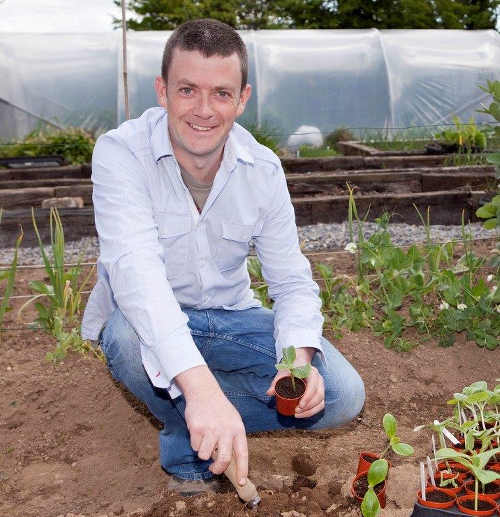
 I am all for taking a decent break from the veg patch in the winter months, and I do very little between late November and February. There are lots of things I could be doing if I was that way inclined, and I know of GIYers that visit the veg patch daily in those times – continuing to sow, grow and harvest despite the short days and inclement weather. I am not one of those growers. Apart from occasional trips to pick some carrots, parsnips, kale or leeks, I visit the veg patch rarely in winter.
I am all for taking a decent break from the veg patch in the winter months, and I do very little between late November and February. There are lots of things I could be doing if I was that way inclined, and I know of GIYers that visit the veg patch daily in those times – continuing to sow, grow and harvest despite the short days and inclement weather. I am not one of those growers. Apart from occasional trips to pick some carrots, parsnips, kale or leeks, I visit the veg patch rarely in winter.
Rather than a continuous 12 months of work, I prefer to see my veg patch year as about 9 months of work with a focus on growing food for winter storage so that I can take a break. It takes all sorts of course, but to my mind, the winter months are for hibernation – both for me and for my veg patch. We both work hard enough for the rest of the year.
Every year, I wonder will I have the desire to get going at all when spring arrives. This tends to worry me a good deal, particularly in January and February. But as March arrives, the sap rises in nature and I can feel the excitement mounting in me all over again at the prospect of food growing.
The food opportunities that the veg patch offers are laid out before me like a blank canvass. Seeds arrive by post and I thrill at the thoughts of putting my hands in to the soil again.
Perhaps it is some desire that rests deep in my DNA and is triggered by the time of year, but suddenly I have a deep craving for eating green leafy things. Thank goodness for spring cabbage then, which is making its first appearance this month from the polytunnel.
Since seed sowing is my favourite of all the GIY activities, March is a very happy month indeed. Last month I did a couple of sowings of the long-season veg like tomatoes, peppers and aubergines, but these only felt like minor skirmishes.
I always feel like I am practically coaxing things to life in February – using artificial heat and light to bring things on. In March, things are easier and we can get really stuck in – the days are getting longer and day time temperatures are increasing. The sap is rising.
 Things to do this Month - March
Things to do this Month - March
To Do
Continue to prepare ground – there is still time to prepare a plot to grow veg this year. Fork or rake over existing beds, breaking up large clods of earth. Cover new seedlings with fleece if a frost is due. Start your daily slug patrols and lay beer traps. Don’t let new-season weeds take over – get on top of them with weekly hoeing.
Sow
Indoors: lettuce, aubergine, peppers, cucumbers, celery, celeriac, sweet corn, basil, leeks, summer cabbage, cauliflower, Brussels sprouts, parsley, courgette, French beans.
Sow outdoors or under cover: broad beans, red cabbage, carrots, cauliflower, spinach, kale, Brussels sprouts, onions, leeks, turnip, peas, radishes, early lettuce, asparagus.
Plant your first early seed potatoes, as soon as weather conditions allow.
Harvest
This month you could be enjoying (from the ground and from storage) onions, leeks, parsnips, potatoes, some varieties of lettuce, mint, sprouting broccoli, kale, rhubarb, chard, the first of the spring cauliflowers and cabbage, and spinach (perpetual, spinach beet).
Recipe of the Month – Spring Greens and Gammon Soup
I’ve used this Barney Desmazery recipe to use up leftover ham (or you can cook the gammon from scratch) – it’s a wonderful broth to celebrate the first spring cabbage. Serves 4.
Ingredients:
• 450g piece gammon, soaked overnight
• 2 bay leaves
• 2 medium onions, sliced
• 2 tsp paprika
• 2 large potatoes, peeled and chopped into small chunks
• 225g spring greens, roughly chopped
• 450g can cannellini beans, drained and washed
Directions
Put the gammon in a large pan with the bay leaves, onions and about 1.5 litres of cold water or enough to cover. Bring to the boil, then reduce the heat and simmer gently for about 1½ hrs.
Drain the gammon, reserving the cooking liquid. When the gammon is cool enough to handle, trim away the skin, and shred the meat.
Return meat to the pan with the reserved cooking liquid, paprika and potatoes. Cover and simmer for 20 mins or until the potatoes are cooked.
While the potatoes are cooking, trim away the stalky bit from the greens and finely shred the leaf. Stir the greens and beans into the stock and continue to cook for about 10 mins until cooked.
Season to taste and serve ladled straight from the pan.
Tip of the Month – Sowing Spuds
The soil in which you are planting potatoes requires a generous application of well-rotted farmyard manure, compost or seaweed before planting (ideally a couple of weeks before).
Sow first earlies in mid March (St Patrick’s Day traditionally) in single rows, 15cm deep, 25cm apart and 45cm between rows. Maincrop spuds are sown in mid to late April. Increase spacing to 35cm.
It is vitally important to include potatoes in your crop rotation as they are susceptible to disease if grown in the same ground year on year.
Check earlies in mid June to see how they are getting on. Earlies will be ready about 14 weeks after sowing. Maincrops take 18 weeks. I typically leave my earlies in the ground and dig as required. They do fine in the ground until September at which point we move on to maincrop.
Maincrop can stay in the ground until the first frosts – lift them then and store in hessian sacks.
For a GIY video tutorial on growing spuds check out www.giyireland.com/videos/detail/potatoes
About GIY
GIY is a not-for-profit organisation that aims to create a healthier, more sustainable world where people grow their own food. We inspire and support people to grow food more successfully by bringing them together to share advice, tips and ideas. There are approximately 50,000 people involved in the GIY movement in Ireland, which is proudly supported by Woodies DIY.
For more information check out www.giyireland.com
Michael Kelly is a freelance journalist, author and founder of GIY Ireland.
© GIY Ireland 2014 – all rights reserved.
Grow It Yourself - April
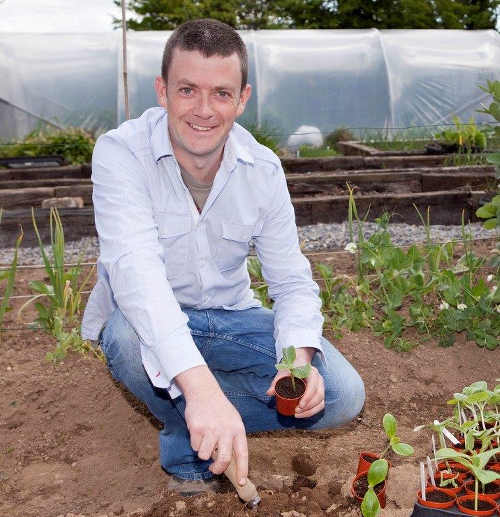
 The luck of the crop rotation draw and bad design in my veg patch means that particular veg families tend to have what might be described as ‘off years’ depending on the area they are destined to spend their growing season in.
The luck of the crop rotation draw and bad design in my veg patch means that particular veg families tend to have what might be described as ‘off years’ depending on the area they are destined to spend their growing season in.
There’s a particular part of my veg patch that is hampered by being simultaneously the closest to the garden perimeter and the lowest point in the garden. Thanks to the shading from the aggressive hawthorn hedge nearby, it gets less light than the other parts of the patch. And since it is comparatively low-lying, lazy frosts also converge there, slumping in from all parts of the garden. They could happily hide out there from the sun’s rays until lunchtime, and I’ve seen occasions when they’ve got to stay there for days on end.
If all that weren’t bad enough, the beds there also suffer from the attentions of the always-encroaching ditch, with errant briars going out in search of nutrient rich soil. The grass that surrounds the vegetable garden also tries to make its way in to the veg patch through the picket fence. In high season it’s a constant battle to keep the beds near the fence clear.
None of this, as you can imagine, is particularly helpful to the vegetables growing there and I always feel bad for whatever family is due a visit there. This year it’s the turn of allium family to do a turn and so I am already mentally bracing myself for a poor crop of garlic, onions and leeks this year.
I could of course try moving the entire vegetable patch about 10m further away from the garden perimeter and closer to the house. This would, however, take up 10m more of lawn and I think I have already pushed that particular boat as far as is acceptable to the rest of the family.
So I have learned over the years to bear this particular problem with stoicism and I like to think the veg families do too. So, yes, once in every five years, they have an ‘off’ year. But sure doesn’t that make the other four years all the sweeter?
 Things to do this Month - April
Things to do this Month - April
To Do
If poor weather in March has hampered your outdoor work, then April is the month to catch-up. The key words for April are weeds and slugs. You need to stay on top of them both. Check your early spuds regularly and ‘earth-up’ as required. Water your tunnel/greenhouse – things can get pretty warm on a nice sunny April day and seedlings will dry out quickly.
Sow
Indoors: lettuce, tomato, pepper, chilli-pepper, cucumber, celery, celeriac, basil, leeks, cabbage, cauliflower, Brussels sprouts, parsley, courgette, marrow, globe artichoke, beans, sweet corn and pumpkin. Outdoors: broad bean, onion sets, pea, beetroot, cabbage, spinach, Brussels sprouts, parsnip, spring onion, leek, carrot, radish, broccoli, turnip. Plant out cabbage plants when they are 15/20 cm tall into well prepared soil that has been manured.
Harvest
Stored fruit and vegetables are likely to be a distant memory at this stage and new crops are only starting to trickle in which makes April a tricky proposition. The middle of this month might see the first asparagus and the first early spring cabbage. The other two star performers this month are purple sprouting broccoli and rhubarb.
Recipe of the Month – Deb’s Kale Salad with Apple, Cranberries and Pecans
I made a big batch of this last weekend and enjoyed it for lunch several days running. It’s delicious. I didn’t have any radishes, but it didn’t seem to suffer too badly from their omission. Come to think of it, I also didn’t have pecans and used walnuts instead.
The recipe (from The Smitten Kitchen cookbook) recommends Cavolo Nero kale (don’t they all) but you can use whatever you have – mine was the hardy red kale, Redbor.
Serves 4.
Ingredients:
• 50g pecans
• 200g kale
• 4 to 5 medium radishes
• 50g dried cranberries
• 1 medium apple
• 50g soft goats cheese
For Dressing:
• 3 tablespoons olive oil
• 1½ tablespoons apple cider vinegar (or white wine vinegar)
• 1 tablespoon smooth Dijon mustard
• 1½ teaspoons honey
• Sea salt and freshly ground pepper, to taste
Directions:
Preheat the oven to 180 degrees celsius and spread the pecans on a baking tray. Toast them until lightly golden, about 5 to 10 minutes, tossing them once or twice to make sure they bake evenly. Remove the tray from the oven and set them aside to cool.
Pull the kale leaves off from the tough stems and discard the stems. Chop the kale into small, bite-sized pieces. Transfer the kale to a big salad bowl. Sprinkle a small pinch of sea salt over the kale and massage the leaves with your hands by lightly scrunching big handfuls at a time, until the leaves are darker in color and fragrant.
Thinly slice the radishes and add them to the bowl. Coarsely chop the pecans and cranberries and add them to the bowl. Chop the apple into small, bite-sized pieces and add it to the bowl as well. Crumble the goat cheese over the top.
In a small bowl, whisk the dressing ingredients together and pour the dressing over the salad. Toss until the salad is evenly coated with dressing.
Serve immediately, or for even better flavour, let the salad marinate in the dressing for 10 to 20 minutes beforehand.
Tip of the Month – Picking Onion Sets
Onion sets are small, immature onions, planted in spring or late summer. The sets increase in size and each forms one full-sized bulb when ready to harvest. Its much easier to grow onions from sets than it is from seed but they have the downside of being more expensive than seed.
A poor onion set equals a poor onion. With that in mind we should only sow the best quality onion sets otherwise we will get a poor harvest. Sow good hard, plump ones - never very small or soft ones. Some, but not all, garden centres offer sets for sale in open trays so you can literally pick out the best ones. Sets can be planted in the soil this month, weather permitting.
About GIY
GIY is a not-for-profit organisation that aims to create a healthier, more sustainable world where people grow their own food. We inspire and support people to grow food more successfully by bringing them together to share advice, tips and ideas. There are approximately 50,000 people involved in the GIY movement in Ireland, which is proudly supported by Woodies DIY.
For more information check out www.giyireland.com
Michael Kelly is a freelance journalist, author and founder of GIY Ireland.
© GIY Ireland 2014 – all rights reserved.
Grow It Yourself - May

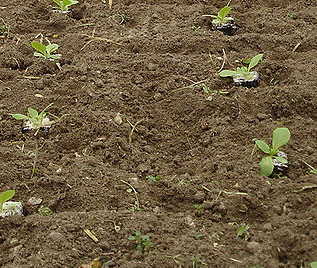 Each month, I try and think about my seed sowing in two categories. The first category is those veg that we must sow pretty much every month to guarantee a consistent supply (without gluts) – so for example: lettuce, spinach, oriental greens, calabrese etc. Between March and August, I sow a little of these at the start of every month.
Each month, I try and think about my seed sowing in two categories. The first category is those veg that we must sow pretty much every month to guarantee a consistent supply (without gluts) – so for example: lettuce, spinach, oriental greens, calabrese etc. Between March and August, I sow a little of these at the start of every month.
The second category consists of those vegetables that are sown once during the year, and in this category there are some really important ones to be sown this month. In early May, I sow my parsnips direct outside in the veg patch. Given how easy they are to grow and how well they stand in the soil over the winter months, I grow a lot of parsnips – enough at any rate to provide perhaps 20 parsnips a month between November and April (i.e. 120). That is a superb supply of winter food.
In the potting shed early this month I will also sow my pumpkins, squashes, cucumber and sweetcorn in pots for later transplanting. Pumpkin and squash are worth spending time on, given just how much food they can supply for the winter – last year, thanks to the brilliant summer weather, we had a bumper year for fruiting veg and I had about 40 squashes and pumpkins on top of the dresser in the kitchen.
They are an invaluable ingredient for stews, soups and curries. Though they don’t store so well, cucumbers are also a productive veg – a single healthy plant will produce about 40 cucumbers over the summer months.
Later in the month I will do a sowing of French and runner beans outside, while in the last week of the month I will sow my main crop carrots outside. Again, this is a crucial sowing.
I aim to grow enough carrots to keep the kitchen supplied between October and next April – given that they are the quintessential stock-pot veg. We could easily go through 30-40 carrots a month, so ideally, I aim to grow about 250 carrots. If that sounds a lot, bear in mind you can grow 100 carrots in a 1 metre x 1 metre veg bed.
To-Do
May is the time to get those outdoor beds ready for early summer transplanting. Fork over and rake. Earth up potatoes as the plants develop. Put protective barrier around your carrots to thwart the dastardly carrot root fly. Regularly hoe weeds and mulch. Water plants if required. Support tomato, bean and pea plants with twiggy sticks, pea netting, timber supports with chicken wire, or existing fence or hedge. Pinch out the growing tips of broad beans plants to help prevent Blackfly.
Sow
Indoors for planting on later: basil, dill, coriander, courgette, cucumber, sweet corn, pumpkins. Outdoors: winter cauliflower, cabbage, kale, spinach, sprouting broccoli, leeks, beans (French, Runner, Climbing French), beetroot, parsnip, turnip, swedes, radish, lettuce, peas, broccoli, rocket, carrots. Harden off and begin to plant out seedlings you have lovingly raised indoors – e.g. tomatoes, cucumber, peppers, brussels sprouts, sprouting broccoli, cabbages, sweet corn, leeks.
Harvest
May is another tricky “gap” month as stores continue to dwindle. Continue picking asparagus, purple sprouting broccoli, radish, rhubarb, cabbage, cauliflower, spinach and chard. May is likely to see the first real bumper salad leaves like lettuce and rocket – as well as the first garlic, beetroot and globe artichokes.
Recipe of the Month – Rhubarb and Date Chutney
I love the young tender stalks of rhubarb that you get early in the spring, but by now we are generally in to glut territory, with larger stalks and lots of them! This recipe, from The Great Book of Rhubarb by Elaine Lemm, is actually better with larger stalks. This is very easy to make and yields about six jars.
Ingredients:
• 2lbs/900g Rhubarb
• 2lbs/900g Sugar
• 1lb/450g Sultanas
• 1 pint Vinegar
• 1 oz/25g Salt
• 1 oz/25g powdered Ginger
• 1 Onion – finely chopped
• ½ teaspoon Cayenne Pepper
• ½ teaspoon ordinary Pepper
Directions:
Bring all of the ingredients to the boil in a large stainless steel pan. Reduce the heat and let it “plop” away until thick and dark brown, stirring occasionally. Pour into clean sterilised jars, put lid on and store. Has a long store cupboard life.
Tip of the Month – Pot up Courgettes
This time of the year is all about managing the timing of when you plant seedlings out in the garden. Do it too early and the plants will be knocked back by night-time cold. Do it too late and the plants become ‘pot-bound’ – that is, they have grown too large for their container resulting in tangling of the roots.
I’m still too suspicious of the weather to plant out relatively tender plants like courgettes - by potting plants in to bigger pots, you buy yourself a couple of extra weeks where you can keep them in doors.
I sow courgette, squash, cucumber and pumpkin plants in 5cm pots but they grow incredibly quickly and need to be put in to larger pots within 2 weeks or so. Simply pop the seedling out of it’s old pot, put a little compost in the base of a bigger pot, place the seedling in carefully and then fill it in with compost.
It pays to water the plants very well about an hour before hand – the seedlings pop out of the pots much easier then – and of course you need to water again after you have finished potting them on.
 About GIY
About GIY
GIY is a not-for-profit organisation that aims to create a healthier, more sustainable world where people grow their own food. We inspire and support people to grow food more successfully by bringing them together to share advice, tips and ideas. There are approximately 50,000 people involved in the GIY movement in Ireland, which is proudly supported by Woodies DIY.
For more information check out www.giyireland.com
Michael Kelly is a freelance journalist, author and founder of GIY Ireland.
© GIY Ireland 2014 – all rights reserved.
Grow It Yourself - June
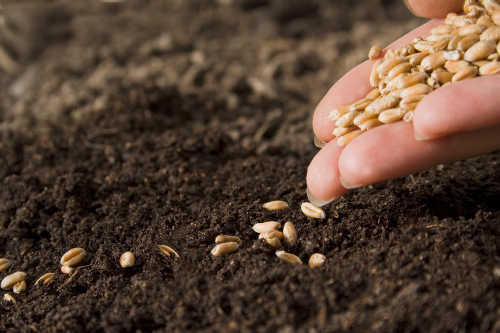
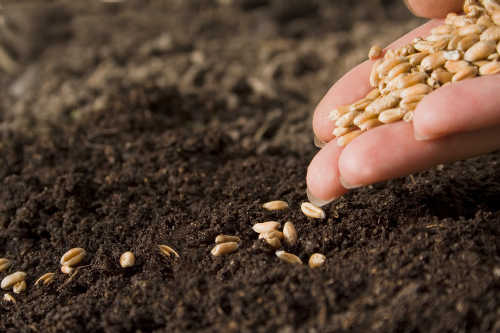 Could soil be the new Prozac? This is a question prompted by a recent research study, which found that treatment with a specific soil bacterium, Mycobacterium vaccae, can alleviate the symptoms of depression.
Could soil be the new Prozac? This is a question prompted by a recent research study, which found that treatment with a specific soil bacterium, Mycobacterium vaccae, can alleviate the symptoms of depression.
Scientists set up an experiment whereby mice were put in a beaker of water and watched to see how long they would keep swimming and looking for an exit before giving up. The mice that were treated with the bacteria kept swimming for longer than the control mice, leading the scientists to conclude that they had a more active “coping mechanism”.
A related study by the Sage Colleges in New York, found that soil bacteria can also accelerate learning. More long-suffering mice were fed Mycobacterium vaccae and were subsequently able to navigate a maze twice as fast as the control mice. In yet another study, scientists found that human cancer patients who were injected with Mycobacterium vaccae reported better quality of life and less nausea and pain.
So, how does it work? The researchers believe that the key to it is the ‘happy chemical’ serotonin, which is produced in the brain and acts as a natural anti-depressant. The Mycobacterium vaccae bacteria cause an immune system response in the body, causing serotonin-releasing neurons to fire in the pre-frontal cortex of the brain - the part of our brain known to be involved in mood regulation.
The benefits of regular contact with soil extend beyond mood improvement – it can also improve our immune system function. In 2012, researchers at Harvard Medical School published a study showing the health benefits of contact with soil.
They studied two groups of mice - one that had been exposed to microbes and one that had been raised in germ-free environments – they found that the group with early-life microbe exposure had a better chance at avoiding asthma and inflammatory bowel diseases later in life.
We live in a ‘germaphobic’ society where everything is kept spotlessly clean and germs are considered the enemy. We use antibacterial soaps each time we wash our hands and blitz surfaces with antibacterial wipes.
Vegetables are cleaned before being put on the supermarket shelves, in case we might consider them too dirty to buy. Undoubtedly, improved hygiene has reduced disease in the last century, but have we gone too far?
The research on Mycobacterium vaccae shows that not only is contact with soil good for your immune system function, it will most likely improve your mood too. It’s no wonder GIYers are such a happy bunch – it turns out we’re all jacked up on Mycobacterium vaccae!
Things to do this Month - June
To-Do
Watering and weeding duties step up a notch – the tunnel/greenhouse in particular will require a good deal of water from now on. Watch the weather and water outside as required. Continue to earth-up potato plants to prevent the spuds becoming green. Mulch and water tomato plants and continue to remove side shoots that appear in the leaf axils. Stake everything that grows tall – raspberries, peas, beans, tomatoes etc. Net soft fruit against birds – it’s worth the effort.
Sow
Sow courgettes, pumpkins, summer and winter squash, fennel, chicory. Succession sow: beans (French and Runner), kale, pea, spinach, spinach beet, summer broccoli, carrot, swede, leek, lettuce, Brussels sprouts, beetroot, chicory, endive, turnip, kohlrabi, fennel. Plant out leeks, Brussels Sprouts, cabbage, autumn cauliflower, calabrese, sprouting broccoli, celery, celeriac, cucumbers, pumpkin, marrows, runner beans, aubergine.
Harvest
We are now really starting to see some payback from our GIYing - the first broad beans and peas as well as new potatoes, new carrots, soft fruit like gooseberries, cherries and strawberries. Herbs are in full flow. Also harvest kohlrabi, cabbage, cauliflower (month end), spinach, spring onion, shallots, salad leaves, elderflower, rhubarb, salad leaves, onions, carrots, beetroot, garlic, sea-kale.
Recipe of the Month – Fresh Pea, Courgette and Parmesan Rosti with Tangy Tomato Dressing
I love this Ainsley Harriott summery recipe that celebrates the first of the new season’s courgettes and peas with a brilliant twist on the classic potato rosti.
Ingredients
For the rosti:
• 200g shelled fresh peas
• 350g courgettes, grated
• 150g ground rice
• 3 tbsp shredded basil leaves, plus extra to serve
• 70g parmesan, grated
• 50g pine nuts, lightly toasted
• 2 free-range eggs, lightly beaten
• sea salt and freshly ground black pepper
• 2 tbsp olive oil
For the tangy tomato dressing
• 6 tbsp olive oil
• 1 ripe plum tomato, seeds removed and finely diced
• 4 sun-dried tomatoes in oil, drained and finely chopped
• 1 small shallot, finely chopped
• 1 tbsp red wine vinegar
Directions
For the rosti, blanch the peas in a pan of boiling salted water for two minutes or until just tender then drain well. Refresh in a bowl of iced water and drain again.
Squeeze the courgettes in a clean tea towel and place in a large bowl. Mix in the blanched peas, ground rice, basil, parmesan and pine nuts then add the beaten eggs and season with sea salt and freshly ground black pepper.
Divide the mixture into 16 evenly sized balls and slightly flatten each one. Heat one tablespoon of the olive oil in a large non-stick frying pan over a medium heat and fry half the rosti for 2-3 minutes on each side or until crisp and golden-brown.
Drain on kitchen paper and keep warm. Repeat with the remaining oil and rostis. To make the dressing, place the ingredients in a bowl, mix until well combined and season with sea salt and freshly ground black pepper.
Place a stack of rosti on each plate, drizzle a little dressing over and around the rosti and garnish with a sprinkling of shredded basil leaves.
Tip of the Month – Harvesting Garlic
Knowing when to lift garlic can be a tricky proposition - harvest them too early and the bulbs will be too small, but harvest too late and the bulbs will begin to lose their quality. The old rule is to sow garlic before the shortest day of the year (Dec 21st) and harvest before the longest (June 21st). Some people also do a spring sowing which wont be ready until late July or August.
A good general rule of thumb is to do a test when a third of the leaves on each plant are gone brown. Carefully push back the soil around one plant and have a look at the bulb to check its size. If its too small, put the soil back around it. Lift all your garlic when a half to two-thirds of the leaves are gone brown.
 About GIY
About GIY
GIY is a not-for-profit organisation that aims to create a healthier, more sustainable world where people grow their own food. We inspire and support people to grow food more successfully by bringing them together to share advice, tips and ideas. There are approximately 50,000 people involved in the GIY movement in Ireland, which is proudly supported by Woodies DIY.
For more information check out www.giyireland.com
Michael Kelly is a freelance journalist, author and founder of GIY Ireland.
© GIY Ireland 2014 – all rights reserved.
Grow It Yourself - July
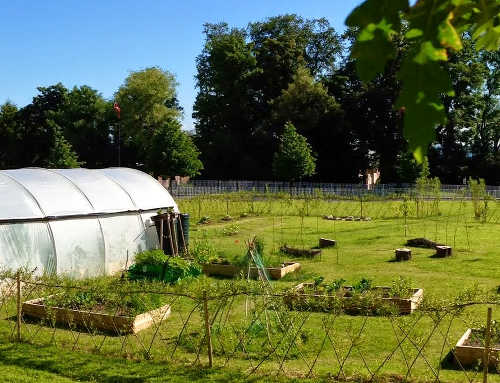
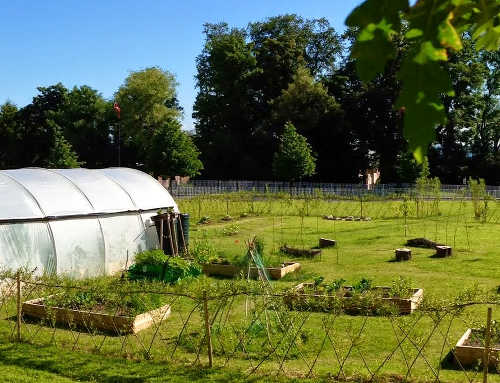 I know that sometimes I can be guilty of hyperbole, but recently I visited a garden that I think could transform Ireland. One of the recipients of a community food growing grant from AIB via the GIY Get Ireland Growing Fund last year was the Headlands Community Garden.
I know that sometimes I can be guilty of hyperbole, but recently I visited a garden that I think could transform Ireland. One of the recipients of a community food growing grant from AIB via the GIY Get Ireland Growing Fund last year was the Headlands Community Garden.
Headlands is an attractive housing estate in Bray - 108 of the houses in this 139-house estate have no private gardens. Led by Hannah Quinn, residents got permission from the management company to develop a community vegetable garden on the ‘green’ in the estate.
The idea was to provide a communal growing space for the families and increase the sense of community in the area. As is so often the case, people were wary. Objections were raised. There will be vandalism and anti-social behavior, they said.
A year on and a vibrant community garden has been established on the green, marked out by a living willow ‘fedge’. An orchard has been planted, raised beds installed, a compost-corner established and a polytunnel erected. There’s a sunflower circle, a pea-wigwam and a blackboard with a watering roster on it. There is food growing – lots of it.
On Saturday afternoons about 8-10 core group members come together to do some work on the garden and remarkable things happen – curious residents pop by for a look and a chat. Friendships are forged among neighbours, many of whom have never met before. Children learn where food comes from. Plans are afoot to extend operations further with laying hens and a hive of bees.
There are thousands of housing estate ‘greens’ just like this around Ireland, most of which are underused and simply maintenance headaches for the residents or management companies that own them. They could be transformed in to community food growing assets, and Headlands is a stunning case study of how it can be achieved with some local passion, grit and leadership.
Win a Ballymaloe Cookery School Course
Do you enjoy cooking up a storm for your family? Have you always dreamed of opening your own little café? Are you passionate about home-grown, seasonal food? Or are you looking for a life-changing career switch? Ballymaloe Cookery School has generously provided a fully funded spot on their much-coveted 12-week certificate cookery course as the prize in a raffle to support the fundraising campaign for GROW HQ, GIY’s national food education centre, which will open in 2015.
The prize, valued at over €12,000, also includes accommodation in a farmhouse cottage on site. Tickets are €25 from www.giyireland.com, and the draw will take place at the GIY Gathering in September.
Things to do this Month – July
To-Do
Any ground that has finished cropping must be quickly cleared away to take more vegetables. Use your produce - eat it, freeze it, process it, exchange it, give it away. Continue to water and feed plants and practice good weed control. Earth up brassicas such as Brussels sprouts - these plants will grow tall and require a good deal of support. Net plants to keep butterflies and the cabbage moth away.
Cut down legume plants that have finished cropping - leave the roots in the soil as they fix nitrogen in the soil. Give pumpkins plenty of water and apply a high-potash liquid feed.
Sow
Continue successional sowings and use quick maturing varieties for autumn use - Swiss chard, lettuce, rocket, salad onions, radish, turnips, peas, French Beans (dwarf), carrots. Sow for winter use - spring cabbage, Hungry Gap kale, parsley, perpetual spinach, chicory and coriander. Plant strawberries now for a good crop next June. Propagate rosemary, sage and mint from cuttings now.
Harvest
July is a peak month for produce – enjoy it! First crops of French and runner beans, tomatoes, peppers, cucumbers, courgette and aubergine, marrows, globe artichokes. Continue to harvest new potatoes, beetroot, calabrese, cauliflower, cabbage, spinach, carrots, turnips, shallots, garlic, radish, spring onions, salad crops, strawberries, raspberries, tayberries, currents (black, red and white), gooseberries, loganberries, peas, broad beans. Ask yourself – do you really need to go to the supermarket?!
Recipe of the Month – Grilled Courgette and Tomato Salad
With the polytunnel providing the first new season tomatoes, and courgettes abundant from the garden, we’re loving fresh, zingy summer salads at the moment. This recipe from Jane Baxter’s Riverford Field Kitchen in Devon is a cracker.
Serves 4.
Ingredients
• 200g dried cannellini or haricot beans, presoaked
• 2 courgettes
• Small punnet of cherry tomatoes
• 50ml olive oil
For the dressing
• 1 bunch of basil leaves, roughly chopped
• Half a garlic clove, crushed
• Pinch of salt
• 100ml extra virgin olive oil
Directions:
Cover the dried beans with water and soak them overnight. Simmer until tender, drain, season and dress with 2 tbsp of extra virgin olive oil. (You can use a can of precooked beans.)
Slice the courgettes in to thin slices. Coat them with olive oil and griddle or grill them for 2 minutes on either side.
Meanwhile, oven roast the cherry tomatoes in a little olive oil for 10 minutes on 140C/gas mark 1.
Blend the dressing ingredients together in a food processor. Mix the cooked beans, courgettes and tomatoes together gently in a large bowl and add the basil dressing to taste and season.
Tip of the Month – Red Spider Mite
Red spider mite is a common problem with aubergine plants. Leaves begin to appear pale and even eaten, and you can see the little red mites on the underside. A small infestation can be killed off by squashing with your thumb.
Garlic or seaweed spray will work as a prevention – spray leaves every week to 10 days. This will prevent attacks and strengthen the plants.
For a home made garlic spray add 3 crushed cloves of garlic to a tablespoon of vegetable oil and leave to soak overnight. Strain the mixture in to a spray bottled, add one tsp liquid soap and 1litre water. Shake well.
 About GIY
About GIY
GIY is a not-for-profit organisation that aims to create a healthier, more sustainable world where people grow their own food. We inspire and support people to grow food more successfully by bringing them together to share advice, tips and ideas. There are approximately 50,000 people involved in the GIY movement in Ireland, which is proudly supported by Woodies DIY.
For more information check out www.giyireland.com
Michael Kelly is a freelance journalist, author and founder of GIY Ireland.
© GIY Ireland 2014 – all rights reserved.
Grow It Yourself - August
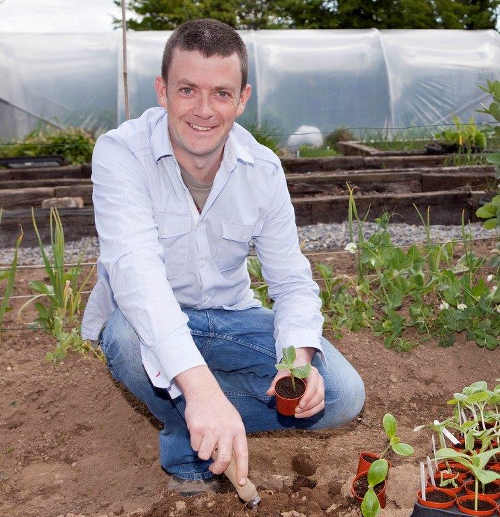
 It’s hard to fathom, but it’s already August and the seed-sowing year is almost over – this month is the last opportunity to sow seeds and marks the end of seven months of fairly intense seed sowing activity that started way back in the dreary days of February.
It’s hard to fathom, but it’s already August and the seed-sowing year is almost over – this month is the last opportunity to sow seeds and marks the end of seven months of fairly intense seed sowing activity that started way back in the dreary days of February.
May and June were the busiest seed sowing months, with things slowing down considerably last month. This month it slows down even further - there are just salad leaves (lettuce, oriental greens etc) to sow and then that’s pretty much it until next February. Notably this month, I always do a decent sowing in the polytunnel of oriental greens (like mizuna, mibuna, mustard, pak choi etc) for winter eating.
If there is a sense of ‘winding down’ in one aspect of the GIY year, there is a corresponding ramping up of another (more exciting) phase – dealing with the basket loads of delicious grub coming from the veg patch.
The time lag between the first sowings in February and the arrival of the first new season crops is something that continues to surprise me each year. With the exception of rhubarb and some salad leaves in early spring, it’s not really until June that the first new season crops (like carrots, beetroot, peas and beans) are ready to eat.
That trickle of fresh produce has now turned in to a deluge, and we will continue to enjoy the harvest bounty up to and beyond Christmas. The time that is ‘freed up’ by the lack of growing related activities (seed sowing/transplanting etc) is now spent ‘processing’ food – shelling, podding, blanching and the like.
But while we’re busy in the kitchen, things are certainly quieter out in the vegetable patch – the hard work of the year is mainly done now and we can start to enjoy the fruits of our labour.
Win a Ballymaloe Cookery School Course
Have you always dreamed of opening your own little café? Or are you looking for a life-changing career switch? Ballymaloe Cookery School has generously provided a fully funded spot on their much-coveted 12-week certificate cookery course as the prize in a raffle to support the fundraising campaign for GROW HQ, GIY’s national food education centre, which will open in 2015. The prize, valued at over €12,000, also includes accommodation on site. Tickets are €25 from www.giyireland.com, and the draw will take place at the GIY Gathering next month.
Things to do this Month - August
To-Do
Green manures (mustard, buckwheat, radish, rye, alfalfa, clover and vetches) are plants which are grown specifically to improve soil fertility and useful at times when beds are empty (as is often the case in August). Grow directly in the bed and then cut down and dig in to the soil.
Give pumpkins plenty of water and apply a high-potash liquid feed. Nip out the growing points to encourage the fruits to swell. Net brassicas to keep butterflies and the cabbage moth away (and check undersides of leaves regularly for caterpillars). Keep watering - mulch around plants to retain moisture.
Sow
Continue succession sowing. Sow spring cabbage, red cabbage, winter spinach, salad onions (in polytunnel for spring crop), autumn salad mix, endive, parsley, onion seed, Chinese vegetables.
Harvest
Pick Beetroot regularly as they reach the size you require - if left to grow too large they will lose their tenderness. Continue to harvest tomatoes, carrots, cabbage, cauliflower, peas, broad beans, french and runner beans, salad leaves, radish, turnip, potato, onions, peppers and chilli-peppers, aubergine, globe artichoke, courgettes, cucumber, gooseberries, raspberries and currants.
 Recipe of the Week – Tahini Dressed Courgette and French Bean Salad
Recipe of the Week – Tahini Dressed Courgette and French Bean Salad
In my opinion the River Cottage Veg Every Day book is the very best book you can have on your shelf if you’re a GIYer – it’s packed with recipes that will help you make delicous meals from the produce coming from your veg patch.
Ingredients:
For the Tahini:
• 1⁄2 garlic clove, crushed
• 2 tablespoons light tahini (stir the jar well first)
• Finely grated zest and juice of 1⁄2 lemon
• Juice of 1⁄2 orange
• 1⁄2 teaspoon clear honey
• 2 tablespoons olive oil
• Sea salt and freshly ground black pepper
For the Salad:
• 2 tablespoons olive oil
• 3 medium courgettes (about 400g), sliced into 3mm rounds
• Juice of 1⁄2 lemon
• 1 red chilli, deseeded and finely chopped
• About 125g French beans, trimmed
• 4 good handfuls of salad leaves
• 12-18 oven-dried tomatoes (see page 304) or semi-dried tomatoes (optional)
• A handful of mint, finely shredded (optional)
Directions:
To make the tahini dressing, put the crushed garlic into a small bowl with the tahini, lemon zest and juice, orange juice, honey and a grind of black pepper, and stir together well.
The dressing may thicken and go grainy or pastey, but don’t worry. Just thin it down by whisking in a little water, 1 tablespoon at a time, until you get a creamy, trickling consistency.
Finally, gently stir in the olive oil. Taste and add a little more salt and pepper if needed. The dressing is now ready to use.
For the salad, heat the olive oil in a large non-stick frying pan over a fairly high heat and cook the courgette slices in batches, tossing them occasionally, for a few minutes until tender and browned on both sides, transferring them to a bowl once cooked.
When the courgettes are all cooked, season generously with salt and pepper, add the lemon juice and chilli and toss together well. Bring a pan of salted water to the boil. Tip in the French beans, return to the boil and blanch for 1 minute.
Drain, then dunk in cold water to refresh. Drain again, pat dry with a clean tea towel and toss the beans with the courgettes.
To assemble the salad, spread the salad leaves in a large shallow serving bowl and scatter over the dressed courgettes and beans, tomatoes and shredded mint, if using. Trickle the tahini dressing generously over the whole lot and serve.
Tip of the Week - Harvesting Garlic
Harvest garlic when at least half to two-thirds of leaves on each plant are yellow. Autumn sown garlic will be ready in early summer. Do not allow them to go too far as they lose flavour.
When harvesting garlic, don't pull the bulbs from the ground as you will damage the bulbs and break the neck which will make it difficult to store it well. Stick a fork in beneath the bulb and ease it out gently. Remove any excess soil. Leave to dry for a few days on the soil if possible (if it's dry).
You can use the garlic straight away, but to store it, you will need to dry them out for a few weeks in a warm sunny place (potting shed or greenhouse) before hanging in plaits.
 About GIY
About GIY
GIY is a not-for-profit organisation that aims to create a healthier, more sustainable world where people grow their own food. We inspire and support people to grow food more successfully by bringing them together to share advice, tips and ideas. There are approximately 50,000 people involved in the GIY movement in Ireland, which is proudly supported by Woodies DIY.
For more information check out www.giyireland.com
Michael Kelly is a freelance journalist, author and founder of GIY Ireland.
© GIY Ireland 2014 – all rights reserved.
Grow It Yourself - September
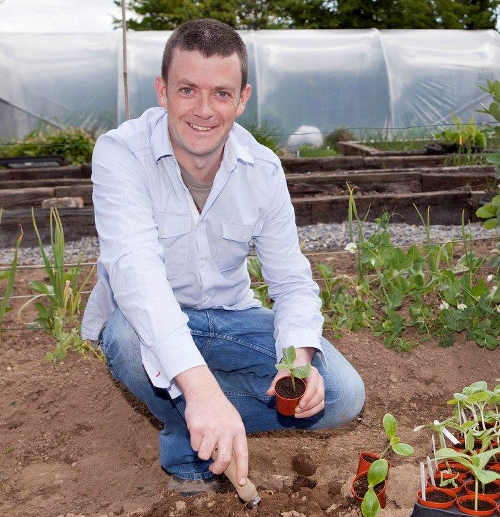
 Yesterday morning I went down to the polytunnel to get a few fresh tomatoes to go with our breakfast eggs, only to walk in on a group of birds conducting a daring raid. They had managed to pull a few ripe tomatoes off the plant, and were busy gorging themselves on the fleshy fruit. Once disturbed they flew around in a panic, getting caught in plants here and up against plastic there. It took me some time to shoo all of them out.
Yesterday morning I went down to the polytunnel to get a few fresh tomatoes to go with our breakfast eggs, only to walk in on a group of birds conducting a daring raid. They had managed to pull a few ripe tomatoes off the plant, and were busy gorging themselves on the fleshy fruit. Once disturbed they flew around in a panic, getting caught in plants here and up against plastic there. It took me some time to shoo all of them out.
I am no expert on birds, but I am pretty sure they were thrushes. Whatever – you do not mess with my tomatoes… In some ways, oddly, I was happy that it was birds that were doing the pilfering, since last summer I assumed the nibbling on the tomatoes was caused by rodents which is not what you want messing with your food. Birds, while undoubtedly a pest, at least are not a major health risk. I have had to put a bio-net screen over the open doors to stop the birds getting in.
From July to October, we are in what I like to call ‘bruschetta’ season – it’s a wonderful time of the year, when a simple lunch or supper can easily be conjured up from nothing, once you have some decent sourdough bread in the bread bin.
Simply toast some of the bread, rub some cut garlic on it, add some slices of delicious ripe tomatoes (warm from the polytunnel), some ripped basil leaves, sprinkle with lots of sea salt and black pepper and drizzle with a good olive oil. Shake fists at the birds, and eat.
Win a Ballymaloe Cookery School Course
Have you always dreamed of opening your own little café? Or are you looking for a life-changing career switch? Ballymaloe Cookery School has generously provided a fully funded spot on their much-coveted 12-week certificate cookery course as the prize in a raffle to support the fundraising campaign for GROW HQ, GIY’s national food education centre, which will open in 2015. The prize, valued at over €12,000, also includes accommodation on site. Tickets are €25 from www.giyireland.com, and the draw will take place at the GIY Gathering this month.
 Things to do this Month - September
Things to do this Month - September
To-Do
Lift crops which have finished growing and dress bare soil with manure, compost (or plant green manures). Wasps can be problematic as fruit ripens so make traps from jars of sugary water. Remove surplus leaves from tomato plants which allows air to circulate and sunshine to fall on the fruit. Go blackberry picking!
Sow
Last month for sowing perpetual spinach, chard and oriental salads – it will be worth it in the New Year when there’s almost nothing else to eat, so get sowing! In the polytunnel/greenhouse sow lettuce, mustard, cress, basil, coriander, parsley, radish, dwarf early pea, broadbean, cauliflower seed, rocket, onion seed and garlic. Outside sow white turnip seeds and autumn onion sets, e.g. ‘centurion’ and ‘sturon’. Plant out strawberry runners. Pot up some parsley for winter use.
Harvest
Lift onions and leave to dry out in sun or in the polytunnel/greenhouse for two weeks. Apples, plums, pears are now in season. Continue to harvest salad leaves, tomatoes, radish, potatoes, carrots, turnips, beetroots, cauliflower, cucumbers, peppers, beans, courgettes, spinach, leeks, red cabbage, summer cabbage, aubergine, sweet corn.
Recipe of the Month – Carrot, Kohlrabi and Beetroot Salad
This is the ultimate in raw food goodness, but doesn’t taste raw if you know what I mean. Takes less than five minutes to make, and serves 4.
Ingredients:
• 1 medium sized beetroot
• 1 carrot
• 1 kohlrabi
• 1 tablespoon olive oil
• 1 tablespoon honey
• Zest and juice of a lemon
• Fresh dill, chopped
• Few drops of Tabasco
Peel and grate the carrot and kohlrabi. Grate the beet too, but there’s no need to peel it. Toss with the remaining ingredients and serve.
Tip of the Month - Rabbits
Rabbits are a serious GIY pest, and particularly problematic at this time of the year. They are notorious for being prolific breeders - the litter size is approx 5 rabbits and baby rabbits start breeding themselves at four months. A female can become pregnant again just one day after giving birth. So that gives you an idea of how formidable a challenge they can present. They are particularly fond of new plants and soft growth. Thankfully, there are some ways of controlling them:
1) Chicken wire – in my veg patch I resorted to a picket fence lined with chicken wire, though it was costly and labour intensive to put in. It is approx. 3ft high, with the bottom 30cm of chicken wire buried beneath the ground and bent outwards - this prevents rabbits from burrowing underneath.
2) Less costly is a netting or bionet cover around individual plants or beds.
3) Repellents (e.g. Vitax Stay Off) can be applied to plants but are not always to be trusted.
4) Shooting and trapping - depends on your stomach for these kind of things or your ethical view of it, but shooting rabbits is effective and also provides a cheap and nutritious meal. Humane traps can be set at rabbit tunnels but the question is what do you do with them if you catch them? Dogs should also prey on rabbits – but in my experience a big slobbery Labrador won’t.
 About GIY
About GIY
GIY is a not-for-profit organisation that aims to create a healthier, more sustainable world where people grow their own food. We inspire and support people to grow food more successfully by bringing them together to share advice, tips and ideas. There are approximately 50,000 people involved in the GIY movement in Ireland, which is proudly supported by Woodies DIY.
For more information check out www.giyireland.com
Michael Kelly is a freelance journalist, author and founder of GIY Ireland.
© GIY Ireland 2014 – all rights reserved.
Grow It Yourself - November
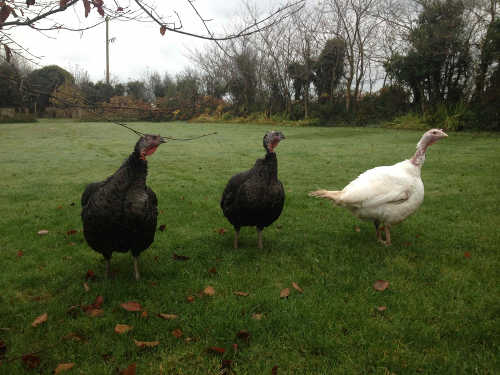
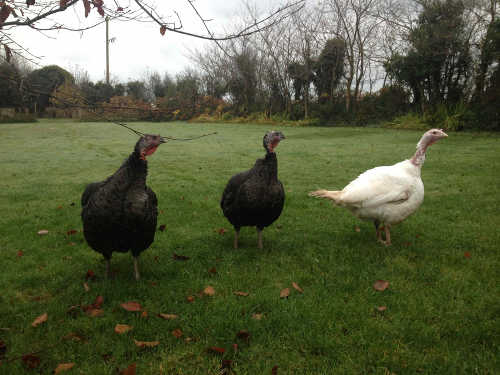 With Halloween over, the countdown to Christmas is truly on, and as a result we have turkeys back in our garden again. Each year we rear about 4 turkeys, with one becoming the centerpiece of our Christmas Day celebrations, and the balance jointed and put in to the freezer.
With Halloween over, the countdown to Christmas is truly on, and as a result we have turkeys back in our garden again. Each year we rear about 4 turkeys, with one becoming the centerpiece of our Christmas Day celebrations, and the balance jointed and put in to the freezer.
It’s an arrangement that has worked well for us for a number of years now, providing some amazing fresh meat at a time of the year when we’re really focused on eating food from storage.
I love keeping turkeys for the same reason that I love making Gravad Lax for Christmas (to the point that it’s a bit of a running joke in our family) - I love putting all that work in to a single meal.
It seems to make the Christmas dinner all the more special – and of course the fact that the turkeys are out and about in the fresh air, with unlimited access to grass, makes the meat particularly delicious. What could be better than sitting down to a Christmas dinner that has been reared in your own back garden?
They are very fine birds indeed – two ‘regular’ white ones and two bronze. Though in a separate house, they are sharing a run with our hens and ducks.
It’s not generally considered such a good idea to run turkeys and hens together, with the risk of the transmission of blackhead (histomoniasis) between them – but I am willing to chance it given the relatively small amount of time the turkeys will be here.
The first day we let the turkeys out in to the run, the hens and ducks spent a few hours cowering underneath an old trailer, worried about these strange new intruders in to their little universe. But by now, they are getting used to each other (though the turkeys are definitely the boss).
Turkeys have some unique characteristics when compared to hens – there are all those wonderful ‘gobble-gobble’ sounds for one thing. While hens head for their house as soon as it gets dark (so there is no ‘rounding up’ to do), turkeys are far more interested in roosting in a tree or on top of a wall.
Each night since we got them, we’ve had to lift them down from a tree or some other lofty perch, and put them in to their house. Incidentally they are far easier to handle than hens – they seem to like human interaction.
GROW COOK EAT
Our brand new grow/cookbook, called GROW, COOK, EAT (A GIY guide to growing and cooking your own food) is out now. Written by yours truly, it features seasonal contributions and recipes from over 35 of our favourite chefs, cooks and growers including Hugh Fearnley Whittingstall, Dylan McGrath, Donal Skehan, Darina Allen, Neven Maguire, Rachel Allen and Clodagh McKenna. Available from all good book stores and from the GIY website at www.giyireland.com. RRP €25.
 Things to do this month - November
Things to do this month - November
To Do
Do not leave beds bare for the winter – sow a green manure, or cover with a thick layer of manure/compost and then black plastic or straw. This will return nutrients to the soil, keep the worst of the weather off it, suppress weeds and prevent leaching of nutrients. ‘Earth up’ or tie up vegetables such as cabbage, cauliflower and Brussels sprouts. Divide up your rhubarb if you want to propagate, and cover it with a thick mulch of manure. Prune apple trees. Mulch fruit bushes. Take cuttings of currant bushes from current season’s wood.
Sow
Sow broad beans outside now for an early crop next spring. To avoid rotting before germination, make small newspaper cups and germinate them indoors first. Next summer’s garlic does best if it’s planted before Christmas – plant outdoors in well prepared soil in a sunny spot. Though I have to admit I never bother with them, some varieties of onion can over-winter and will be ready to harvest in early summer.
Harvest
Continue to harvest perpetual spinach, cabbage, cauliflower, potatoes, swede, parsnips, apples, pears. Start harvesting leeks, winter cabbage, kale, artichokes, Brussels sprouts. Time to lift carrots and turnips or at least cover them with a good layer of straw to protect them from frost damage.
Recipe – Tagliatelle with cavolo nero, chickpeas and pecorino
This is a super-quick, healthy kale recipe from Café Paradiso’s Denis Cotter. Serves 4.
Ingredients:
• large handful cavolo nero kale (or any other type if you don’t have cavolo nero).
• 100ml/3½fl oz olive oil
• 2 lemons, zest only
• ½ lemon, juice only
• 200g/7oz cooked chickpeas
• 500g/1lb 2oz fresh tagliatelle pasta, or similar
• salt
• freshly ground black pepper
• 100g/3½oz pecorino or other hard cheese, finely grated
Directions
Bring a deep saucepan of water to a rolling boil and blanch the cavolo nero for one minute. Drain, and when cool enough to handle, chop finely.
Heat the olive oil in a wide pan and fry the cavolo nero in it for a few minutes, over a moderately high heat, stirring constantly.
At the same time, bring a pot of water to a boil and drop in the pasta to cook for two or three minutes until just tender.
Drain the pasta and stir it into the kale with the lemon zest and juice, the chickpeas and half of the grated pecorino.
Season, to taste, with salt and freshly ground black pepper.
Serve the pasta in deep bowls with more cheese scattered over.
Tip of the Month – Divide and Conquer
You can and should divide rhubarb plants every four or five years to give the plants more room and reinvigorate them. The best time to do this work is when the plant is dormant so November to Feburary will work.
Dig the rhubarb using a fork to lever the crown carefully from the soil, trying to avoid as much as possible damage to the roots. Once you have it out of the ground remove any rotting sections from the plant and give it a general clean up.
Then using a sharp spade, press down heavily and divide the crown in three. Ideally you want each section to have a crown, a large amount of root and at least 4 or 5 pink buds
Then dig a hole for the divided crowns and place one crown in each roots downwards, with the top of the crown roughly an inch BELOW the soil surface. You can pop some well rotted manure or compost in to the hole first if you want to add some nutrients. Backfill with soil, firming in gently. New plants shouldnt be harvested too heavily in the first year.
 About GIY
About GIY
GIY is a not-for-profit organisation that aims to create a healthier, more sustainable world where people grow their own food. We inspire and support people to grow food more successfully by bringing them together to share advice, tips and ideas. There are approximately 50,000 people involved in the GIY movement in Ireland, which is proudly supported by Woodies DIY.
For more information check out www.giyireland.com
Michael Kelly is a freelance journalist, author and founder of GIY Ireland.
© GIY Ireland 2014 – all rights reserved.
Grow It Yourself - December
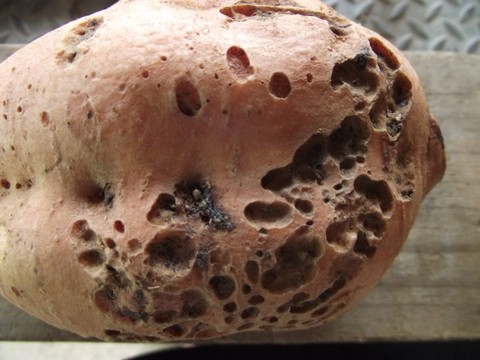
 This year I managed to fill 3 large hessian sacks with spuds for storage and we’ve been tucking in to them every other day as required. It’s very handy to have them there, waiting patiently in the garage for their moment of destiny in the kitchen.
This year I managed to fill 3 large hessian sacks with spuds for storage and we’ve been tucking in to them every other day as required. It’s very handy to have them there, waiting patiently in the garage for their moment of destiny in the kitchen.
I have to admit however that we’ve lost more than the normal number of spuds to pest damage this year (particularly among the main crop varieties). This is maddening, particularly since you don’t generally know that the spud is destroyed until you’ve gone to the bother of peeling it (and then discover a little network of cavities inside it, that render the potato inedible).
The two main pests of potatoes are slugs and wireworms – partners in slime. The wireworms are typically at the vanguard of these attacks – they are small wire-like worms that bore tunnels in to potatoes, making tiny holes on the surface. The more opportunistic slugs follow, using the same holes to gain access to the spud. Getting your main crop potatoes out of the ground as early as you can is the main organic method of prevention for both these pests.
That issue aside, the spud is an incredible hardy foodstuff that in general stores very well and we’ve enough potatoes to take us right through to March or so. It makes sense to check in every now and then on any stored food that you have squirrelled away to make sure that everything is in order.
A rotting spud can quickly take out all the spuds around it, and before long the whole crop can turn to a squidgy mush. Removing the occasional rotting spud early on will prevent this from happening.
Sprouting in storage is normal and not a huge deal – in fact, the process of chitting them in spring before planting is encouraging them to do what some of my spuds have done quite naturally in storage. All the same, it’s no harm to rub off the sprouts and make sure the spuds aren’t soft or green before eating.
GROW COOK EAT
Our brand new grow/cookbook, called GROW, COOK, EAT (A GIY guide to growing and cooking your own food) is out now. Written by yours truly, it features seasonal contributions and recipes from over 35 of our favourite chefs, cooks and growers including Hugh Fearnley Whittingstall, Dylan McGrath, Donal Skehan, Darina Allen, Neven Maguire, Rachel Allen and Clodagh McKenna. Available from all good book stores and from the GIY website at www.giyireland.com. RRP €25.
 Things to Do this Month - December
Things to Do this Month - December
To Do
As you clear remaining crops from your veggie patch, dig the beds over and add well rotted compost or manure. Get Educated – book yourself on a course! Start planning what you would like to grow next year and work out what crop rotation system you are going to use. Study seed catalogues carefully before deciding on the best varieties to grow. Start a Compost corner or heap. Keep an eye on your stored veggies and discard anything that’s rotting. Collect and store leaves in bags to make leaf mould or use as cover for bare soil.
Sow
If you haven’t already done so plant garlic – it should be in the soil by the shortest day of the year. Bring herbs like mint, chives, lemon balm, parsley, thyme indoors by lifting and potting them up.
Harvest
Buck the seasonal trend by continuing to harvest winter salad leaves like corn salad, land cress and mizuna. You should still have at least some produce left in the December veggie patch e.g. winter cabbages, Brussels sprouts, leeks, kale, Jerusalem artichokes, carrots, celery, turnips, parsnips, winter cauliflowers, swedes, spinach, chard and celeriac. From your stores you can enjoy pumpkins and squashes, potatoes, onions, apples, beetroot and garlic.
Recipe of the Month – December Omelette
This recipe uses two great stalwarts of the winter kitchen garden and larder – squash and leeks. The yoghurt is an interesting addition. Serves 6.
Ingredients
• 2 tbs extra virgin olive oil
• 1 leek, white and light green parts, chopped
• 2 garlic cloves, minced
• 350g squash or pumpkin, diced
• 2 tablespoons chopped fresh mint and the same quantity of fresh dill.
• 8 eggs
• 150ml Greek-style yogurt
• 40g freshly grated Parmesan cheese
Directions
Preheat the oven to 180 degrees. Heat 1 tablespoon of the oil over medium heat in a large, heavy pan.
Add the leek and cook, stirring, until tender, about three minutes. Add the garlic, stir together until fragrant, about 30 seconds, and add the squash. Cook, stirring, until tender, 10 to 12 minutes.
Season to taste with salt and pepper. Stir in the dill and the mint. Remove from the heat.
Place the remaining tablespoon of oil in a 9-inch casserole disk, brush the sides of the pan with the oil and place in the oven.
Meanwhile, whisk the eggs in a large bowl. Season with salt and freshly ground pepper to taste. Whisk in the yogurt and the Parmesan. Stir in the squash mixture.
Remove the baking dish from the oven and pour in the egg mixture. Place in the oven, and bake 30 minutes or until puffed and lightly colored.
Allow to cool for at least 10 minutes before serving.
Serve hot, warm or at room temperature.
Tip of the Month – Buy Local
When it comes to buying for Christmas (presents, food, wine etc) we have tremendous buying power. These are tough times for small local businesses so support them by buying local this year. Support Irish crafts people and artisan food producers. Make sure the money you spend stays in Ireland where it maintains local jobs.
 About GIY
About GIY
GIY is a not-for-profit organisation that aims to create a healthier, more sustainable world where people grow their own food. We inspire and support people to grow food more successfully by bringing them together to share advice, tips and ideas. There are approximately 50,000 people involved in the GIY movement in Ireland, which is proudly supported by Woodies DIY.
For more information check out www.giyireland.com
Michael Kelly is a freelance journalist, author and founder of GIY Ireland.
© GIY Ireland 2014 – all rights reserved.
Grow It Yourself - January
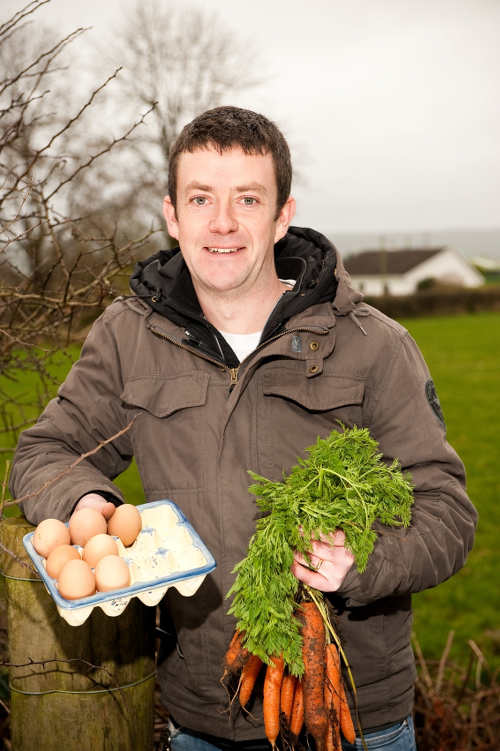
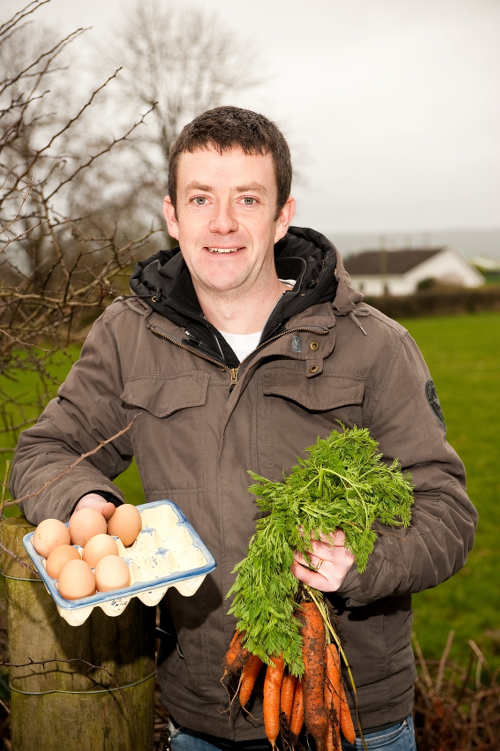 Michael Kelly
Michael Kelly
New Year’s resolutions sometimes get a bad rap, because they seem to represent the folly and flightiness of the human spirit. We start off the year with grand intentions to eat only salads, walk/run/swim 100 miles a week, and to do Bikram yoga in a sauna until we weigh as much as a baby sparrow. But then by the end of January we’ve quietly abandoned our good intentions and reverted to guilty, bloated type.
This year, make a simple resolution that can transform your life. Grow food. And before you think that sounds like a resolution that might involve significant effort, life changes or all round hassle on your part, fear not! It doesn’t have to be a huge amount of food. We’re not talking 100% self-sufficiency or living off grid. It’s not scary or daunting. It DOES NOT involve growing a goatee.
Here are the “don’ts”: Don’t spend a load of money on expensive garden equipment, books or tools. Do not dig up your garden or sign up for an allotment. Do not learn Latin so you can read plant names. For now, we’re keeping it small-scale, achievable, practical. Unlike most of our resolutions, this one is about working with (rather than against) our limitations – our lack of time, our lack of space, lack of green fingers.
Just grow food. Grow some salad leaves in a container. Stick a pea in some potting compost in a pot. Grow your own garlic. Or some herbs on your balcony. Start small. Pick three vegetables that you like to eat and learn how to grow those. How about setting yourself the target of producing an entirely home-grown meal? Just one little meal. That’s easy right?
Keep this in mind as you start. Research shows that by growing some of your own food (even if it’s only a little amount) your dietary habits may change. Because of the deeper understanding and connection with food that you will have as a result of your food growing experiment, you will be welcoming health and happiness in to your life, and saving some money in the process. You will be out and about in the fresh air, getting some exercise at the same time. You will have access to the most delicious, nutritious, seasonal food.
This is your year. 2015 is the year that anything can happen. This year, let your intention be to grow food! Happy New Year from all of us at GIY.
By joining GIY you help us to continue the work of supporting people just like you to grow food at home, at school, in the workplace and in the community – each year we support over 50,000 people and 800 community food growing groups and projects. It costs just €35 to join GIY for a year, and to say thanks we will send you a seasonal copy of our supporter’s magazine GROW and some GIY seeds for you to sow each quarter. We will also send you our weekly tips, news and advice ezine and offer you discounts to GIY events like the annual GIY Gathering. Join today at www.giyireland.com.
Things to do this Month
To Do
Plan. This is the time to decide where and what you are going to grow this year. If you are just starting out join your local GIY group for advice and check out our website for handy “getting started” guides and videos. Consider building or buying raised vegetable beds. Order your seeds, onions sets and seed potatoes. Turn over the soil in February only if the weather is dry – if the soil sticks to your boots it’s too early for digging! “Chit” seed potatoes – put them in a container (e.g. used egg carton or empty seed tray) and leave them in a bright warm place to sprout.
Sow
In mid Feb, in seed trays and pots on a sunny windowsill indoors sow celery, globe artichokes, celeriac, leeks, onions, lettuce, tomatoes, peas, aubergines, peppers/chilli-peppers. Weather permitting outside you can try sowing broadbeans, spinach, kohlrabi, onion and shallot sets, Jerusalem artichokes, parsnip and early pea varieties.
Harvest
You may still have winter cabbage, perpetual spinach, chard, leeks, kale, cauliflowers and Brussels sprouts in your veggie patch and depending on how successful your growing/storage regime last year was, you may well still be tucking in to stores of potatoes, celeriac, carrots, parsnips, onions, cauliflower, jerusalem artichokes, winter squash, pumpkins, leeks and red cabbage.
Recipe of the Month – Mick’s ‘January Blues’ Minestrone Soup
This is a completely made up recipe that I cobbled together using some vegetables that I brought in from the garden and some standard store cupboard ingredients. So, honestly, I don’t know if Minestrone is the right word for it – but it seems to fit. The added pasta makes it a substantial feed, and because it’s not blitzed in a blender after cooking, it’s chunky and delicious. You can play around with different vegetables if you don’t have what I added here. Serves 4.
Ingredients:
• 2 tablespoons olive oil
• 1 onion, chopped
• 1 clove garlic, chopped
• 1 leek, cleaned and finely sliced
• 2 carrots, peeled and chopped small
• Half a butternut squash or small pumpkin, peeled and chopped small
• 500ml good quality homemade chicken stock (or made from an organic stock cube)
• 400ml tin chopped tomatoes (I used the same quantity of passata instead).
• 4 tagliatelle ‘nests’, preferably organic (you could use any type of pasta really).
• 1 bunch spinach leaves, stalks removed and chopped roughly
Directions:
Heat the oil in a large pot and cook the onions and garlic until softened. Add the leek, carrot and squash and toss well so they are coated in oil. Season well, then cover and cook on a low heat with the lid on the pot, stirring occasionally, for 5-10 minutes.
Then add the stock and tomato and cook with the lid off until the veg is soft (about 10 minutes) – don’t overcook, you don’t want the veg to go to mush.
Stir in the spinach about 5 minutes before the end of cooking.
Meanwhile cook the pasta as per instructions in a pot of boiling, salted water. When it’s cooked, drain and stir it in to the soup pot. Check the seasoning.
Ladle in to warm bowls and serve with some crusty bread.
Tip of the Week – Show your tools some love
Blades on shears, forks, spades, hoes, secateurs and other tools will benefit from an annual overhaul with a sharpening stone (you can buy them in hardware stores). Prepare the blade with a drop of three-in-one oil. Push the tool forwards and to the side on the stone, exerting a little downward pressure. Then turn the tool over and, holding the blade almost flat against the stone, brush it across the surface to take off any rough edges. Only sharpen the outside blade on bypass secateurs and the upper surface of hoes. Wipe over the blade with an oily rag before storing.
About GIY
GIY is a not-for-profit organisation that aims to create a healthier, more sustainable world where people grow their own food. We inspire and support people to grow food more successfully by bringing them together to share advice, tips and ideas. There are approximately 50,000 people involved in the GIY movement in Ireland, which is proudly supported by Woodies DIY.
For more information check out www.giyireland.com
Michael Kelly is a freelance journalist, author and founder of GIY Ireland.
© GIY Ireland 2015 – all rights reserved.
Grow It Yourself - February
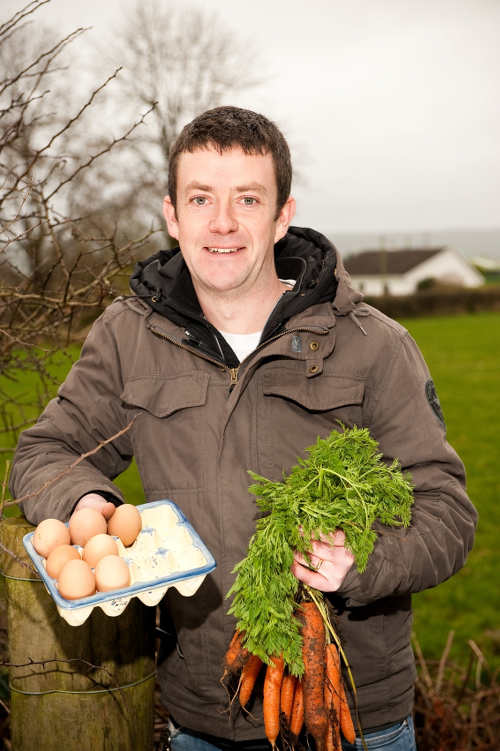
 Michael Kelly
Michael Kelly
2015 is the UN FAO’s Year of Soil. The year-long project aims to raise awareness in society about the ‘profound importance’ of soil for human life and promote the sustainable management of soil. FAO Director-General José Graziano da Silva said that we are not paying enough attention to soil, our ‘silent ally’, which I reckon is an understatement – as a society we’re paying no attention whatsoever to our soil.
Healthy soils he said are not only the foundation for food, fuel and medical products, but also essential to our ecosystems, playing a key role in the carbon cycle, storing and filtering water, and improving resilience to floods and droughts.
Our soils work hard. But we will work them even harder in the decades to come – population growth will require a 60% increase in food production, but instead of working to conserve and protect this precious resource, we’re literally treating it like dirt.
The world’s soil is under immense pressure – it takes 1,000 years to form a centimeter of soil, but we’re losing it permanently (and at dizzying pace) to relentless urbanization to accommodate the expanding population.
An area of soil the size of Costa Rica is lost every year and here in Europe, 11 hectares of life-giving soil are sealed under expanding cities every hour. Globally, a third of all our remaining soil is degraded from erosion, compaction, nutrient depletion and pollution. Given the role it plays in feeding us (95% of our food comes from it), Vandana Shiva says that our determined destruction of the soil globally represents a ‘species-level act of suicide’.
As GIYers we play an important part in the management of this critical resource, not only by our gentle stewardship of the soil in our own gardens, but also by developing a deeper understanding of how soil works (and sharing that knowledge with others).
Of all the things I have learned about food growing in the last ten years, a deeper understanding of the soil has been perhaps the most important (and certainly the most satisfying). I am starting to understand that food growing is not about growing plants at all, it’s about growing soil. If you get the soil right, the plants really look after themselves.
Of course that means many mucky, sweaty hours spent turning compost heaps, lugging barrows of farmyard manure or collecting seaweed, but that’s OK too – you don’t need gym membership when you’re a GIYer.
Gradually my soil here at home has come to life, no longer the heavy potters clay of when we arrived here first, but friable and teeming with life. In a previous article I called myself a ‘nutrient shepherd’ and it’s a phrase I am very fond of – for that indeed is my job here – shepherding nutrients around the place from the compost heap to the soil to the plants, to the kitchen table and back to the compost heap again.
If you need a new year’s resolution for 2015, make yours to love soil. Pick up big handfuls of it in your hands. Smell it. Stand in it in your barefeet. Care for it. Nurture it. It is literally where all life begins.
By joining GIY you help us to continue the work of supporting people just like you to grow food at home, at school, in the workplace and in the community – each year we support over 50,000 people and 800 community food growing groups and projects. It costs just €35 to join GIY for a year, and to say thanks we will send you a seasonal copy of our supporter’s magazine GROW and some GIY seeds for you to sow each quarter. We will also send you our weekly tips, news and advice ezine and offer you discounts to GIY events like the annual GIY Gathering. Join today at www.giyireland.com.
Things to Do This Month
To Do
Turn over the soil only if the weather is dry – if the soil sticks to your boots it’s too early for digging! Keep off the soil to prevent soil compaction - use timber planks to stand on for access. If you have not already done so order/buy your seeds, spuds and onion sets. “Chit” or sprout seed potatoes – put them in a container (e.g. used egg carton or empty seed tray) and leave them in a bright warm place. Check the pH of your soil – you can buy a soil pH testing kit in any garden centre. Lime your soil now if required (to reduce acidity in very acid soils), particularly important in your brassica bed.
Sow
Finally, we can sow some seeds. On a sunny windowsill indoors, in a heated greenhouse or on a heating mat: sow celery, globe artichokes, celeriac, leeks, onions, lettuce, tomatoes, peas, aubergines, peppers/chilli-peppers. In polytunnel or greenhouse: beetroot, Brussels sprouts, summer and autumn cabbage, carrots, leeks, lettuce, radish. Outside: Weather permitting you can try planting out broadbeans, spinach, kohlrabi, onion and shallot sets, Jerusalem artichokes, parsnip and early pea varieties.
Harvest
Winter cabbage and cauliflowers, Brussels sprouts, spinach, kale and leeks.
Recipe of the Month – Beetroot and Carrot Gratin
I’ve cooked this recipe from our new book GROW COOK EAT lots of times over this winter and the whole family love it. The cream and parmesan make it just decadent enough not to feel too frugal, but it still feels healthy and is a great way to cook beetroot. It’s also a sinch to make. The recipe comes originally from Michelle Darmody‘s The Cake Café.
Ingredients:
• 300g of waxy potatoes, sliced very thinly
• 4 carrots, sliced
• 3 beetroot, peeled and sliced
• a small bunch of rosemary, pulled from the stalk and chopped
• 4 cloves of garlic, sliced
• 250ml of cream
• 70g of Parmesan, grated
Directions:
Lay the sliced potato, carrots and beetroot into an ovenproof dish, sprinkling the garlic and rosemary between layers. Pour the cream over the whole lot and place into an oven heated to 180 degrees until the vegetables are soft which will take about 40 minutes. Season and sprinkle with the parmesan and place back into the oven until golden on the top. Toss the leaves and almonds in the dressing and season. Slice the gratin in four and gently transfer onto a plate. Serve with a salad on the side and with some chutney if you wish.
Tip of the Month – Tips for growing good carrots
One of the most common problems that people have with carrots is that they end up with stumped or forked roots – though the first couple might be fun to look at (particularly if they’re rude looking), after that it is just plain annoying.
There are three main causes here:
(1) Forking of roots occurs if there are stones in the soil or if the soil is very compacted. I mainly practice no dig gardening, but I do dig the carrot bed thoroughly in springtime to make sure the soil is in good nick to a spade’s depth and that any large stones are removed.
(2) Forking can also be caused by too much fresh manure or compost in the soil being added in spring. The root will literally fork off in search of a pocket of nutrients rather than growing down in search of it. If you need to feed the soil in your carrot bed, do so in the autumn.
Finally (3), carrots don’t transplant well and any disturbance to the seedling when you’re transplanting can cause forked roots. So, it’s always better to sow carrot seeds direct in the soil.
 About GIY
About GIY
GIY is a not-for-profit organisation that aims to create a healthier, more sustainable world where people grow their own food. We inspire and support people to grow food more successfully by bringing them together to share advice, tips and ideas. There are approximately 50,000 people involved in the GIY movement in Ireland, which is proudly supported by Woodies DIY.
For more information check out www.giyireland.com
Michael Kelly is a freelance journalist, author and founder of GIY Ireland.
© GIY Ireland 2015 – all rights reserved.
Grow It Yourself - March
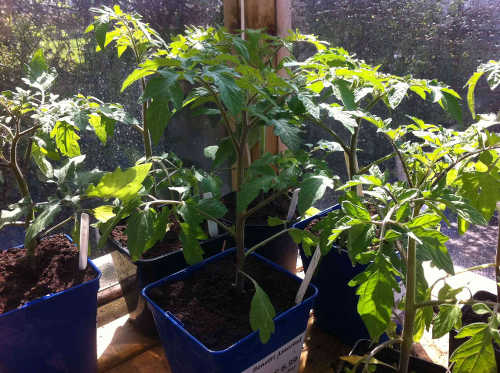
 Tomatoes have a long growing season so to get good fruit you need to get the plants started early (if you are growing from seed). I sow my tomatoes on a heating mat in the potting shed in mid February, so by early March they have germinated.
Tomatoes have a long growing season so to get good fruit you need to get the plants started early (if you are growing from seed). I sow my tomatoes on a heating mat in the potting shed in mid February, so by early March they have germinated.
This year I am sowing five varieties of tomato: the delectable cherry, ‘Sungold’, ‘Lucky Leprechaun’ (Irish Seed Savers variety), ‘Black Russian’, ‘Tigerella’ and ‘Sweet Aperitif’. I sow ten tomato seeds in a 9cm pot (one pot for each variety) and pretty much as soon as they germinate, I move each seedling on to its own individual 5cm pot.
This process is called ‘pricking out’ (which is a term that would put me in to a fit of the giggles if I was really immature, which I might add, I am not) and it’s the act of moving very young seedlings from the pot they’ve germinated in to another container or bed to provide more space. It’s a little different to transplanting, which is where we move a more established seedling to its final growing position in the soil.
Pricking out is a delicate little operation, and you have to be very careful not to damage the root or stem of the seedling. Having filled the 5cm pot with seed compost, I make a decent sized hole in the compost with my finger. Then using a plant label I ease one of the seedlings out of the pot, holding it very gently by the leaf. I then place the seedling in to the hole in the new pot, sprinkle a little compost in around it, firm it in gently and water.
It’s important to keep a close eye on seedlings at this time of year – a daily check-in to see if they need watering is important at this very vulnerable stage in their development. With the cold nights, I am also covering my seedlings with fleece at night time. I’m struck by how quickly space on the heating mat becomes prime real estate. From just 5 x 9cm pots of toms, there are now 50 individual little 5cm pots (one for each seedling). The growing year is hotting up..!
GROW COOK EAT wins Gourmand Award
The GIY Cookbook ‘GROW COOK EAT’ which was launched by author and founder of GIY Michael Kelly in October 2014 has been announced this week as a national winner in the Gourmand World Cookbook Awards. The book now qualifies for “Gourmand Best in the World" Competition. The Gourmand World Cookbook Awards often referred to as the ‘Oscars of Food Awards’ is a global stamp of accreditation as the competition awards global cookbook and wine publishing in all languages and all countries around the world. The global winners will be announced at an awards ceremony to be held in China in May. GROW COOK EAT is available from all good book shops and online at www.giyireland.com/shop.
 Things to do this Month - March
Things to do this Month - March
To Do
Continue to prepare ground – there is still time to prepare a plot to grow veg this year. Fork or rake over existing beds, breaking up large clods of earth. Cover new seedlings with fleece if a frost is due. Start your daily slug patrols and lay beer traps. Don’t let new-season weeds take over – get on top of them with weekly hoeing.
Sow
Indoors: lettuce, aubergine, peppers, cucumbers, celery, celeriac, sweet corn, basil, leeks, summer cabbage, cauliflower, Brussels sprouts, parsley, courgette, French beans. Sow outdoors or under cover: broad beans, red cabbage, carrots, cauliflower, spinach, kale, Brussels sprouts, onions, leeks, turnip, peas, radishes, early lettuce, asparagus. Plant your first early seed potatoes, as soon as weather conditions allow.
Harvest
This month you could be enjoying (from the ground and from storage) onions, leeks, parsnips, potatoes, some varieties of lettuce, mint, sprouting broccoli, kale, rhubarb, chard, the first of the spring cauliflowers and cabbage, and spinach (perpetual, spinach beet).
Recipe of the Month – Kale and Black-Eyed Pea Soup
This feels more like a broth than a soup, but it’s delicious and makes a virtue of kale which is so wonderfully in-season at the moment. This will make a great healthy lunch or if you want to turn it in to a hearty supper, add 100g of cooked pasta (something small like macaroni) and serve with crusty bread. Serves 6.
Ingredients:
• 2 tablespoons coconut oil
• 1 small onion, diced
• 6 large carrots, chopped
• 2 stalks of celery
• 2 cloves garlic, minced
• 400g tin dried black-eyed peas or pinto beans.
• 1.8l vegetable stock
• 225g kale, chopped
• 1 teaspoon finely chopped rosemary
• 1 teaspoon finely chopped dried sage
• 1 teaspoon cumin
• 1 chili-pepper, finely chopped
Instructions
In a large saucepan on medium heat, add coconut oil and onions and cook until softened. Add in celery, carrots, and garlic and cook until the mixture is nice and caramelized and cooked through. Add herbs, spices and a good sprinkling of salt and pepper and stir well. Pour in the vegetable stock, beans, and kale. Cook for 1-2 hours on a medium heat until the beans and carrots are tender.
Tip of the Month – Sowing
As we have now moved in to March, this week I tried my first sowing (on a heating mat indoors in the potting shed) of lettuce, annual spinach and oriental greens (mustard, pak choi, rocket) for later transplanting out in to the polytunnel.
This is the start of my monthly succession sowing of all these vegetables, which I will sow at the start of each month between now and August. I generally sow two 8-module trays of lettuce, two of annual spinach and two of oriental greens – I’ve found this is enough to give me a pretty consistent supply of each, without any major shortages or gluts. 16 heads of lettuce a month (4 a week) should be enough for most people!
Later in March, the seed sowing really starts to heat up. Early potatoes will go in the ground outside some time after Paddy’s Day and before end of month. In the potting shed (for later transplanting), I will be sowing my celeriac crop and the first succession sowings of calabrese, cauliflower, celery and scallions.
 About GIY
About GIY
GIY is a not-for-profit organisation that aims to create a healthier, more sustainable world where people grow their own food. We inspire and support people to grow food more successfully by bringing them together to share advice, tips and ideas. There are approximately 50,000 people involved in the GIY movement in Ireland, which is proudly supported by Woodies DIY.
For more information check out www.giyireland.com
Michael Kelly is a freelance journalist, author and founder of GIY Ireland.
© GIY Ireland 2015 – all rights reserved.
Grow It Yourself - April
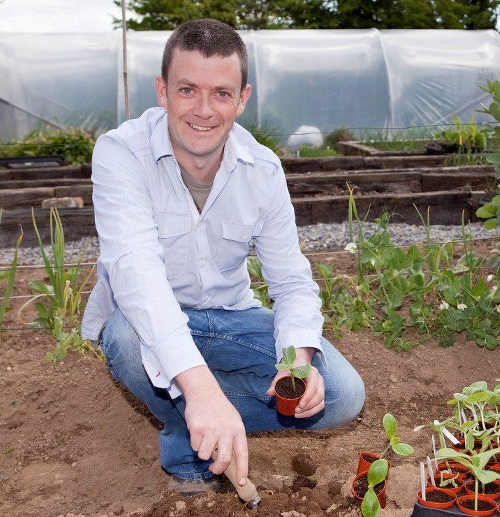
 A few months ago, I was giving a talk about growing things (as you do) to a GIY group and was discussing the growing of spuds when a woman put up her hand to comment. She told us about a tradition in her family when the first new spuds of the season were being harvested. Her grandmother would always take a small batch of new spuds and put them in a biscuit tin, throw in a small covering of soil, put a lid on top and then bury the tin in the garden. The tin would wait patiently in the soil for 6 months and then on Christmas Eve they would dig it up so that they could have “new spuds” for Christmas dinner. What a marvelous thing.
A few months ago, I was giving a talk about growing things (as you do) to a GIY group and was discussing the growing of spuds when a woman put up her hand to comment. She told us about a tradition in her family when the first new spuds of the season were being harvested. Her grandmother would always take a small batch of new spuds and put them in a biscuit tin, throw in a small covering of soil, put a lid on top and then bury the tin in the garden. The tin would wait patiently in the soil for 6 months and then on Christmas Eve they would dig it up so that they could have “new spuds” for Christmas dinner. What a marvelous thing.
I was struck that night, as I always am, by the irresistible sense of camaraderie in the room. The fact that you know everyone in the room is either currently growing food or interested in growing food means that you can strike up a conversation instantly with anyone.
That was the idea behind the creation of the first GIY group back in 2008 in Waterford, when a merry band of GIYers came together with the idea of helping each other to grow food. And that ethos continues to inform the expansion and evolution of the GIY group network. It is a belief that growing food is easier and more fun, if you come together with other people to do it.
The Waterford group was meant to be a one-off, but compelling ideas have their own momentum. Within a couple of months other people had taken the idea and adapted it to create a GIY group in their own community. A hallmark of the movement is that it is spontaneously evolving. There are groups of all shapes and sizes and types. The more people that get involved, the more the network changes. Ideas are shared, interesting things happen.
New types of GIY groups emerge – in work places, in homes, in community gardens. Groups are the beating heart of the GIY movement, and ‘local champions’ are the changemakers that make it all happen. If you’re willing to get your hands dirty and start a GIY group in your community, get in touch – we’d love to help.
By joining GIY you help us to continue the work of supporting people just like you to grow food at home, at school, in the workplace and in the community – each year we support over 50,000 people and 800 community food growing groups and projects.
It costs just €35 to join GIY for a year, and to say thanks we will send you a seasonal copy of our supporter’s magazine GROW and some GIY seeds for you to sow each quarter. We will also send you our weekly tips, news and advice ezine and offer you discounts to GIY events like the annual GROW Summit. Join today at www.giyireland.com
Things to do this Month - April
To Do
If poor weather in March has hampered your outdoor work, then April is the month to catch-up. The key words for April are weeds and slugs. You need to stay on top of them both. Check your early spuds regularly and ‘earth-up’ as required. Water your tunnel/greenhouse – things can get pretty warm on a nice sunny April day and seedlings will dry out quickly.
Sow
Indoors: lettuce, tomato, pepper, chilli-pepper, cucumber, celery, celeriac, basil, leeks, cabbage, cauliflower, Brussels sprouts, parsley, courgette, marrow, globe artichoke, beans, sweet corn and pumpkin. Outdoors: broad bean, onion sets, pea, beetroot, cabbage, spinach, Brussels sprouts, parsnip, spring onion, leek, carrot, radish, broccoli, turnip. Plant out cabbage plants when they are 15/20 cm tall into well prepared soil that has been manured.
Harvest
Stored fruit and vegetables are likely to be a distant memory at this stage and new crops are only starting to trickle in which makes April a tricky proposition. The middle of this month might see the first asparagus and the first early spring cabbage. The other two star performers this month are purple sprouting broccoli and rhubarb.
Recipe of the Month – Asparagus, Beetroot and Baby Spinach Salad
We often see the first asparagus of the year in April, but the beetroot for this salad are likely to be from stores (we keep a stash, picked the previous October, in the garage in a box of sand) as the first beetroot from the polytunnel won’t be ready until next month. I adapted this from a Tom Kime recipe and it serves 6 people.
Ingredients:
For the dressing
• a large handful of marjoram leaves
• 1 garlic clove
• juice of 1½ lemons
• 4 tbsp extra-virgin olive oil
For the salad
• 250g bunch asparagus, cut into 3cm lengths
• 3 medium beetroot (about 500g), cooked and cut into quarters
• zest of 1 lemon
• 2 spring onions, finely sliced
• A good selection of oriental greens such as mizuna, mibuna, red mustard
• About 20 spinach leaves
• 400g goat's cheese
Instructions
First make the dressing. Put the marjoram, a pinch of salt and the garlic into a food processor and pulse to a paste. Add the lemon juice and whizz until smooth. Stir in the olive oil and season – it should be sharp and a bit salty. Cover and chill.
Two hours before serving: bring a pan of salted water to the boil, add the asparagus and cook for 3 minutes. Drain and cool under the cold tap. Cover and keep cool. Put the beetroot in a large bowl and toss with twothirds of the dressing. Add the lemon zest and spring onions, cover and keep at cool room temperature with the remaining dressing.
To serve: add the oriental greens and spinach to the beetroot. Toss in the asparagus and season with freshly ground black pepper. Taste before adding salt as the cheese is quite salty. Mix lightly, so you don’t dye everything pink, then pile into a serving dish. Crumble over the cheese and pour the remaining dressing on top.
Tip of the Month – Sowing Onions
As long as the weather is not to harsh, April is the perfect month for sowing onions. Generally most GIYers grow onions from “sets” (basically baby onions) but you can also grow from seed. Sets will mature quickly. Sow sets 10cm apart in rows 25cm apart. Push the set in to the soil so that the tip is just about visible above the surface. Firm in well.
Just-sown onion sets are vulnerable to ‘frost heave’ which means that the expansion and contraction of soil as a result of warming and cooling can literally heave the little sets from the soil. If this happens push them back in the next day. In our garden the more likely problem is the occasional errant hen who (despite clipped wings) will hop over the picket fence in to the veg patch and start scratching in beds – newly sown beds are her favourite! Magpies and pigeons can also be an issue, pecking at the sets to pull them out. So, I cover the bed with fleece (with bricks placed on the corner to keep it tight and stop it blowing away), which gives some protection to the sets for a few weeks while they get established.
 About GIY
About GIY
GIY is a not-for-profit organisation that aims to create a healthier, more sustainable world where people grow their own food. We inspire and support people to grow food more successfully by bringing them together to share advice, tips and ideas. There are approximately 50,000 people involved in the GIY movement in Ireland, which is proudly supported by Woodies DIY.
For more information check out www.giyireland.com
Michael Kelly is a freelance journalist, author and founder of GIY Ireland.
© GIY Ireland 2015 – all rights reserved.
Grow It Yourself - May
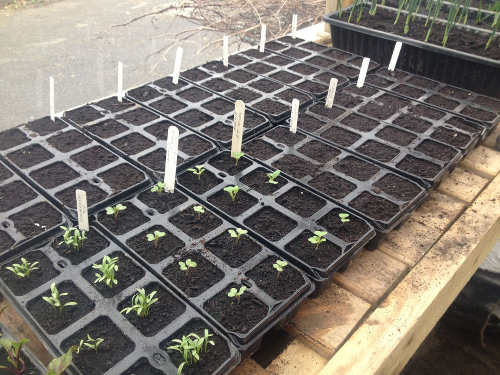
 There is a wonderful Ted Talk by New York-based chef Dan Barbour about a small farm in Spain that produces foie gras humanely (without the force feeding that the product is often lambasted for). Raising his geese in a natural environment, farmer Eduardo Sousa re-discovered that if geese are allowed to forage at will, they will naturally gorge themselves in the autumn to build up fat for the winter. The result? A ‘natural’ foie gras. The important word there is “re-discovered” because there is nothing new in this.
There is a wonderful Ted Talk by New York-based chef Dan Barbour about a small farm in Spain that produces foie gras humanely (without the force feeding that the product is often lambasted for). Raising his geese in a natural environment, farmer Eduardo Sousa re-discovered that if geese are allowed to forage at will, they will naturally gorge themselves in the autumn to build up fat for the winter. The result? A ‘natural’ foie gras. The important word there is “re-discovered” because there is nothing new in this.
Originally foie gras was invented simply as a timely slaughter of geese to take advantage of their fatty livers post winter gorge. It was in a typically unthinking and cack-handed attempt to be the master or foie gras and have it all year around that mankind invented the ‘gavache’ or force-feeding approach.
Though the talk focuses on foie gras, it’s actually a parable and there’s a broader point in there about commercial food production. Eduardo Sousa calls modern methods of foie gras production ‘an insult to history’, a phrase that could be equally applied to all manner of food production methods – from rearing thousands of chickens in unbearably cramped conditions in sheds to growing tonnes of potatoes in the same field year-on-year using chemicals to ‘cheat’ nature; to strawberries from Israel on the shelves in a Wexford supermarket during strawberry season. So much of modern food production is an insult to life on earth, the planet and to human health. Barbour calls them the “take more, sell more, waste more” approach to food that just won’t serve us in the future.
His advice is something that I think will resonate strongly with anyone that grows some of their own food. Listen to nature instead of imposing things on it. Work with it, rather than against it. Accept that small is beautiful.
Barbour sums up by pointing to the happy coincidence that the most ecologically sensitive food production methods are also usually the most ethical and the most delicious. I would add, that they are almost always the healthier and more nutritious choices too.
By joining GIY you help us to continue the work of supporting people just like you to grow food at home, at school, in the workplace and in the community – each year we support over 65,000 people and 1,000 community food growing groups and projects. It costs just €35 to join GIY for a year, and to say thanks we will send you a seasonal copy of our supporter’s magazine GROW and some GIY seeds for you to sow each quarter. We will also send you our weekly tips, news and advice ezine and offer you discounts to GIY events like the annual GROW Fest. Join today at www.giyireland.com.
Things to do this Month - May
To-Do
May is the time to get those outdoor beds ready for early summer transplanting. Fork over and rake. Earth up potatoes as the plants develop. Put protective barrier around your carrots to thwart the dastardly carrot root fly. Regularly hoe weeds and mulch. Water plants if required. Support tomato, bean and pea plants with twiggy sticks, pea netting, timber supports with chicken wire, or existing fence or hedge. Pinch out the growing tips of broad beans plants to help prevent Blackfly.
Sow
Indoors for planting on later: basil, dill, coriander, courgette, cucumber, sweet corn, pumpkins. Outdoors: winter cauliflower, cabbage, kale, spinach, sprouting broccoli, leeks, beans (French, Runner, Climbing French), beetroot, parsnip, turnip, swedes, radish, lettuce, peas, broccoli, rocket, carrots. Harden off and begin to plant out seedlings you have lovingly raised indoors – e.g. tomatoes, cucumber, peppers, brussels sprouts, sprouting broccoli, cabbages, sweet corn, leeks.
Harvest
May is another tricky “gap” month as stores continue to dwindle. Continue picking asparagus, purple sprouting broccoli, radish, rhubarb, cabbage, cauliflower, spinach and chard. May is likely to see the first real bumper salad leaves like lettuce and rocket – as well as the first garlic, beetroot and globe artichokes.
Recipe of the Week – Spinach, Egg and Bacon Salad
Celebrate the new-season spinach by making a meal out of it. This recipe makes a delicous salad supper. Serves 4.
Ingredients:
• 8 ounces young spinach
• 2 large eggs
• 8 pieces thick-sliced bacon, chopped
• 3 tablespoons red wine vinegar
• 1 teaspoon sugar
• 1/2 teaspoon Dijon mustard
• salt and freshly ground black pepper
• 4 large white mushrooms, sliced
• 1 small red onion, very thinly sliced
Directions:
Remove the stems from the spinach and wash, drain and pat dry thoroughly. Place into a large mixing bowl and set aside. Hard boil the eggs and set aside. Remove and peel off the shell. Slice each egg into 8 pieces and set aside.
While the eggs are cooking, fry the mushrooms in some butter or oil until nicely browned. Then fry the bacon and remove to a paper towel to drain, reserving 3 tablespoons of the rendered fat. Crumble the bacon and set aside. Transfer the fat to a small saucepan set over low heat and whisk in the red wine vinegar, sugar and Dijon mustard. Season with a small pinch each of salt and black pepper. Add the mushrooms and the sliced onion to the spinach and toss. Add the dressing and bacon and toss to combine. Divide the spinach between 4 plates or bowls and evenly divide the egg among them. Season with pepper, as desired. Serve immediately.
Tip of the week – Busy times
This week I spent about 2 hours in the potting shed doing my BIG MAY SOWING. I sowed an 8-module tray each of lettuce, annual spinach, rocket, oriental greens, coriander, chervil, parsley, dill, calabrese, summer broccoli, chard, fennel and kohlrabi. I also sowed one 9cm pot of runner beans and two of French beans (with 5 seeds per pot) – these could be almost certainly sowed direct outside by now, but I like giving them a head start before planting out. I also sowed my storage crop of beetroot (which will be lifted for storage around September) – a full 77-module tray of them. Again, these could certainly be planted direct by now, but what can I say, I like sowing things in trays and spending time in my potting shed..! This week I will be out in the veg patch sowing my main crop of carrots and a bed of dwarf french beans – I find these neat little plants far more manageable than their climbing cousins and very productive. The beans are easily harvested and make a fine addition to the freezer for winter.
 About GIY
About GIY
GIY is a not-for-profit organisation that aims to create a healthier, more sustainable world where people grow their own food. We inspire and support people to grow food more successfully by bringing them together to share advice, tips and ideas. There are approximately 50,000 people involved in the GIY movement in Ireland, which is proudly supported by Woodies DIY.
For more information check out www.giyireland.com
Michael Kelly is a freelance journalist, author and founder of GIY Ireland.
© GIY Ireland 2015 – all rights reserved.
Grow It Yourself - June
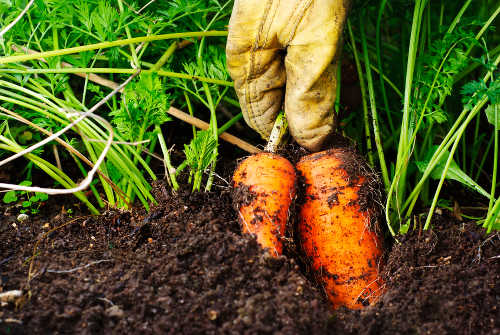
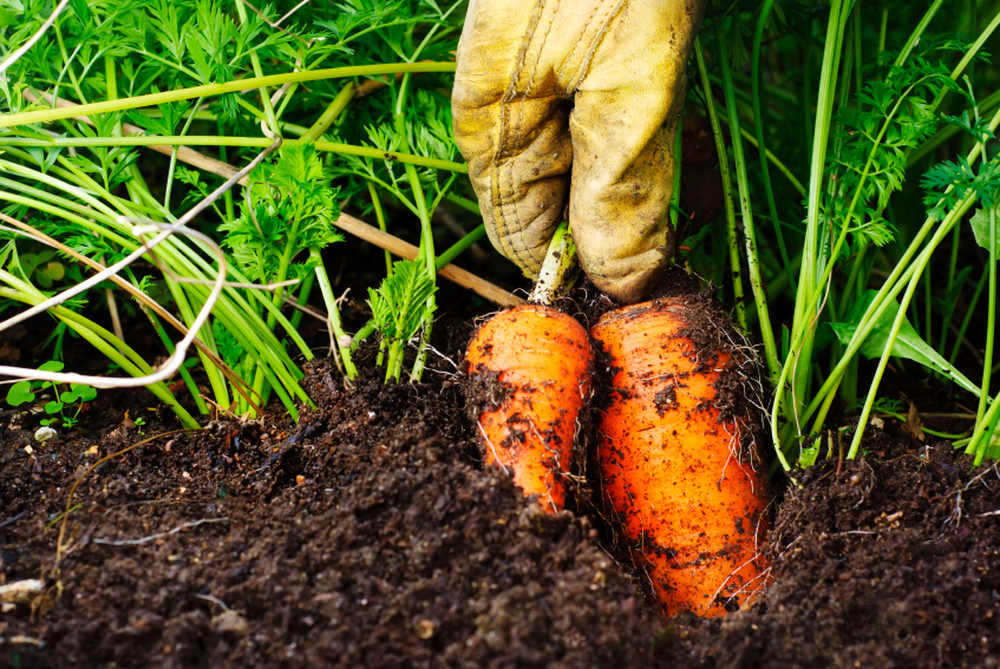 Michael Kelly
Michael Kelly
It’s hard to believe that we’re now in the sixth month of the year already, and that the longest day of the year is a mere three weeks away. At the risk of getting a slap in the head, let me say this much: it will be Christmas before we know it!
After a couple of stalwart days in the veg patch in fine weather, I am feeling uncharacteristically chipper and on top of things and perhaps even a little smug – yes, I know there’s danger in that.
In early June I sow my carrots and parsnips outside, and also my final sowing of peas. There is a sense of completion, if not finality, in the air. Of course there is still lots of sowing to do (right up until August or September), but that’s the last of what I consider my “big 7” direct-sow sowings – garlic, potatoes, broad beans, peas, onions, carrots and parsnips.
Carrots and parsnips are sown in almost identical fashion. While I practice ‘no-dig’ growing pretty much everywhere in the garden, I make an exception for the root bed, which I turn over with a spade and then rake to a fine tilth. This is hard work but essential if you want nice long roots.
Both these vegetables are great for storing so they are worth the effort. I then make shallow drills in the bed using a ridging hoe and tidy the drills up by hand – with small little seeds you need to make sure the surface of the drill is good and flat so the seeds won’t disappear down in between clumps of soil.
I get 4 rows of carrots in each bed (20cm apart), but only 3 with parsnips (30cm apart). I then sow the seeds in the drills. With carrots, sprinkle them as thinly as you can along the row. With parsnips it’s more precise – laying a seed in the drill every 7cm.
In both cases we will be thinning them out later when they’ve got established (carrots to 4cm, parsnips to 15cm). The reason we sow extra seeds is to allow for some not germinating.
Then simply rake the soil carefully back over the drills and water well. I sowed 3 meters of each so should expect roughly 300 carrots and 60 parsnips.
Give Peas a Chance at Work
With our friends in Cully & Sully, we’re looking for 500 workplaces to take part in our ‘al desko’ food growing challenge by growing peas on their desk at work. Sign up today for a free Give Peas a Chance growing kit for you and up to 5 colleagues. Each week we will be picking our favourite growers to win cool GIY prizes and the top prize is worth €5,000 including a €3,000 garden which you can donate to your local community. Sign up at www.cullyandsully.com/ourgarden.
 Things to do this Month - June
Things to do this Month - June
To-Do
Watering and weeding duties step up a notch – the tunnel/greenhouse in particular will require a good deal of water from now on. Watch the weather and water outside as required. Continue to earth-up potato plants to prevent the spuds becoming green. Mulch and water tomato plants and continue to remove side shoots that appear in the leaf axils. Stake everything that grows tall – raspberries, peas, beans, tomatoes etc. Net soft fruit against birds – it’s worth the effort.
Sow
Sow courgettes, pumpkins, summer and winter squash, fennel, chicory. Succession sow: beans (French and Runner), kale, pea, spinach, spinach beet, summer broccoli, carrot, swede, leek, lettuce, Brussels sprouts, beetroot, chicory, endive, turnip, kohlrabi, fennel. Plant out leeks, Brussels Sprouts, cabbage, autumn cauliflower, calabrese, sprouting broccoli, celery, celeriac, cucumbers, pumpkin, marrows, runner beans, aubergine.
Harvest
We are now really starting to see some payback from our GIYing - the first broad beans and peas as well as new potatoes, new carrots, soft fruit like gooseberries, cherries and strawberries. Herbs are in full flow. Also harvest kohlrabi, cabbage, cauliflower (month end), spinach, spring onion, shallots, salad leaves, elderflower, rhubarb, salad leaves, onions, carrots, beetroot, garlic, sea-kale.
Recipe of the Month – Gooseberry and Strawberry Tart
I planted six new gooseberry bushes earlier this year and we’ve had our first gooseberries this month – it’s cause for celebration and a good tart.. The sweetness of the strawberries in this Hugh Fearnley Whittingsstall tart goes brilliantly with gooseberries. It’s also a sinch to make.
Serves four.
Ingredients
• 200g gooseberries, topped and tailed
• 200g strawberries, hulled and halved or quartered
• 75g caster sugar, plus a little extra to finish
• Finely grated zest of 1 lemon
• 3 tbsp ground almonds
• 1 egg white, lightly beaten
For the sweet shortcrust pastry
• 200g plain flour
• 1 heaped tbsp icing sugar
• Pinch of salt
• 120g cold, unsalted butter, cut into cubes
• 1 egg yolk
• About 50ml cold milk (or water)
For the pastry, put the flour, sugar and salt in a food processor, blitz briefly to combine, then add the butter and blitz until it resembles breadcrumbs. Add the egg yolk (save the white) and enough milk or water to bring it together into large clumps.
Tip on to a lightly floured surface and knead lightly into a ball. Wrap in clingfilm and chill for 30 minutes.
Combine the berries, sugar and lemon zest, and set aside to macerate for 30 minutes. Heat the oven to 200C/400F/gas mark 6.
Line a large baking tray with baking parchment or nonstick liner – use a tray with a slight edge, as the tart may leak juice while baking.
On a floured surface, roll out the pastry to a rough circle, 2-3mm thick and about 35cm in diameter, and transfer to the baking tray. Sprinkle the ground almonds evenly over the top without going right to the edges.
Spoon the macerated fruit, and any juices, over the pastry, leaving a 3-4cm border. Fold the border inwards over the fruit, brush the pastry edges with the egg white and sprinkle with more caster sugar.
Bake for 30 minutes, or until the pastry is a deep gold. Serve warm, with cream or ice-cream.
Tip of the Month – Busy times
Before we head in to July, it’s not too late to get a decent sowing of the following done for June: Purple Sprouting Broccoli is sown now, grows through the autumn/winter and starts to produce food in the spring, when it’s badly needed. It’s really worth trying to get 3-4 healthy plants started now.
It’s still not too late to produce more food for this year too – you can still sow florence fennel, kohlrabi, cauliflower, winter cabbage, scallions, kale, perpetual spinach and chard. Also keep on top of your monthly succession sowing of salad leaves – perhaps one small module tray each of lettuce, oriental greens, annual spinach and coriander
 About GIY
About GIY
GIY is a not-for-profit organisation that aims to create a healthier, more sustainable world where people grow their own food. We inspire and support people to grow food more successfully by bringing them together to share advice, tips and ideas. There are approximately 50,000 people involved in the GIY movement in Ireland, which is proudly supported by Woodies DIY.
For more information check out www.giyireland.com
Michael Kelly is a freelance journalist, author and founder of GIY Ireland.
© GIY Ireland 2015 – all rights reserved.
Grow It Yourself - July
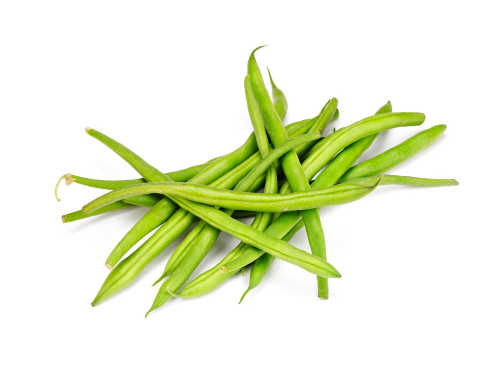
 Michael Kelly
Michael Kelly
French beans are, I think, one of the most underrated of vegetables. Of all the legume family, they are my favourite to eat, more desirable to my mind than runner beans, broad beans and perhaps even peas.
I recall a sublime food experience at La Boqueria market in Barcelona, sitting up at a counter at lunch time and eating french beans that were (I presume) briefly blanched before being fried in butter and sprinkled with loads of rock salt. Perhaps that’s where the love affair started. French beans also freeze really well, so if you have the space they are REALLY worth growing.
Though teepees of climbing french beans are no doubt visually appealing, I think that dwarf french beans (the plants of which grow to no more than 45cm tall) are easier to harvest from and surprisingly productive for such a neat little plant.
Back in mid April, I sowed a module tray of dwarf french beans in the pottting shed. Three weeks later, I planted these out in the polytunnel in two short rows in one of the side beds. There were 12 plants in total, and I planted them out 15cm apart in two rows 40cm apart.
Just two months or so later, aided by the sub-tropical climate in the polytunnel, the little plants are host to masses of slender, vibrant, delicious french beans. Cue repeats of my La Boqueria market experience.
The good news is that once we’ve finished these, I’ve another 3 long rows (about 4 metres) of them outside in the veg patch (sown in late May) which are about 3-4 weeks from harvesting.
These will provide masses of beans for the winter freezer. You can still try a sowing of dwarf french beans at this time of the year, as long as you’re willing to provide them with some cover (a fleece or similar) in October if the weather turns cold. My favourite variety is Purple Teepee which I once mispronounced at a talk as Turple Peepee to much hilarity.
Join GIY
By joining GIY you help us to continue the work of supporting people just like you to grow food at home, at school, in the workplace and in the community – each year we support over 65,000 people and 1,500 community food growing groups and projects. It costs just €35 to join GIY for a year, and to say thanks we will send you a seasonal copy of our supporter’s magazine GROW and some GIY seeds for you to sow each quarter. We will also send you our weekly tips, news and advice ezine and offer you discounts to GIY events like the annual GROW Fest. Join today at www.giyireland.com.
 Things to do this Month – July
Things to do this Month – July
To-Do
Any ground that has finished cropping must be quickly cleared away to take more vegetables. Use your produce - eat it, freeze it, process it, exchange it, give it away.
Continue to water and feed plants and practice good weed control. Earth up brassicas such as Brussels sprouts - these plants will grow tall and require a good deal of support. Net plants to keep butterflies and the cabbage moth away.
Cut down legume plants that have finished cropping - leave the roots in the soil as they fix nitrogen in the soil. Give pumpkins plenty of water and apply a high-potash liquid feed.
Sow
Continue successional sowings and use quick maturing varieties for autumn use - Swiss chard, lettuce, rocket, salad onions, radish, turnips, peas, French Beans (dwarf), carrots. Sow for winter use - spring cabbage, Hungry Gap kale, parsley, perpetual spinach, chicory and coriander. Plant strawberries now for a good crop next June. Propagate rosemary, sage and mint from cuttings now.
Harvest
July is a peak month for produce – enjoy it! First crops of French and runner beans, tomatoes, peppers, cucumbers, courgette and aubergine, marrows, globe artichokes. Continue to harvest new potatoes, beetroot, calabrese, cauliflower, cabbage, spinach, carrots, turnips, shallots, garlic, radish, spring onions, salad crops, strawberries, raspberries, tayberries, currents (black, red and white), gooseberries, loganberries, peas, broad beans.
Recipe of the Month – Good Old French Bean Salad
Here’s a lovely Jamie Oliver recipe for serving french beans with a tangy mustardy dressing – I am a big fan of the delicate herb chervil and it makes a good bedfellow with the beans. We love this as a salad in its own right, or as an accompaniment to a main meal.
Ingredients
• 4 handfuls French beans, stalk ends removed
• 2-3 heaped teaspoons French mustard, to taste
• 2 tablespoons good-quality white wine vinegar
• 4 tablespoons extra virgin olive oil
• sea salt and freshly ground black pepper
• 1 medium shallot, peeled and finely chopped
• 1 tablespoon capers, optional
• ½ clove garlic, finely grated
• 1 small handful fresh chervil, optional
Directions:
Bring a pan of water to a fast boil, add your beans, put a lid on the pan, and cook for at least 4 to 5 minutes. Meanwhile, put the mustard and vinegar into a jam jar or bowl and, while stirring, add the olive oil to make a good hot French dressing.
Season carefully with sea salt and freshly ground black pepper, then add the finely chopped shallot, the capers if you're using them and the garlic. Drain the beans in a colander. Now, while the beans are steaming hot, dress them. Serve the beans in a bowl, sprinkled with chervil if you like.
Tip of the Month – Looking after Climbing Beans
Loosely tie the plants to supports to start but after that they should climb themselves quite happily. Water plants "copiously" during dry weather to maximise pod development. Pinch off the growing tip once the plants have reached the top of their supports (about 8ft). Mulch around stems to preserve moisture and keep weeds down. Don’t forget to succession sow - you could have a second, much later crop of beans in October, if you sow some seeds now.
 About GIY
About GIY
GIY is a not-for-profit organisation that aims to create a healthier, more sustainable world where people grow their own food. We inspire and support people to grow food more successfully by bringing them together to share advice, tips and ideas. There are approximately 50,000 people involved in the GIY movement in Ireland, which is proudly supported by Woodies DIY.
For more information check out www.giyireland.com
Michael Kelly is a freelance journalist, author and founder of GIY Ireland.
© GIY Ireland 2015 – all rights reserved.
Grow It Yourself - August

 After a couple of quiet weeks it’s time to get busy in the veg patch again, this time with harvesting. Our onions are ready to pick so it’s a job for a quiet Saturday, if the weather plays ball. Gathering onions and getting them ready for winter storage is one of the bigger harvesting jobs of the year, but I love it.
After a couple of quiet weeks it’s time to get busy in the veg patch again, this time with harvesting. Our onions are ready to pick so it’s a job for a quiet Saturday, if the weather plays ball. Gathering onions and getting them ready for winter storage is one of the bigger harvesting jobs of the year, but I love it.
So, how do you know when your onions are ready to harvest? Thankfully onions are rather helpful on this matter, providing you with an indicator of sorts so you know when they are ready. The foliage on the onions will turn yellow and literally topple over (approximately 20 weeks after sowing).
One of the most remarkable sights you will ever see in your vegetable plot is a bed of onions getting itself ready for harvest. In the last weeks of summer, a nutrient ‘tug-of-war’ of sorts happens between the bulb and its foliage which of course you are hoping the bulb will win. The bulb starts to suck all the vitamins and minerals from the foliage until finally, thoroughly beaten, the foliage turns yellow, withers and then topples over dramatically in a final act of surrender.
It’s a good idea at this stage to gently loosen the soil around the onions (or turn the onion very carefully and very slightly in the soil – my friend Joe Hurley, a wise old GIYer from Viewmount in Waterford talks about ‘turning the onion a quarter moon’ in the soil).Loosening the soil like this allows the onion to expand.
After this, leave for another week or so, and then your onions are ready to be picked. Lift them carefully (ease them out using a fork, being careful not to damage the necks as you pull them). It’s worth eating a few of them at this stage, because they are literally bursting with nutrition. It’s perfectly fine to eat onions “fresh” straight from the ground, but the key to getting them to store is to get all the moisture from the neck and skin which means drying them out well (see tip of the month below).
 Things to do this Month - August
Things to do this Month - August
To-Do
Green manures (mustard, buckwheat, radish, rye, alfalfa, clover and vetches) are plants which are grown specifically to improve soil fertility and useful at times when beds are empty (as is often the case in August). Grow directly in the bed and then cut down and dig in to the soil. Give pumpkins plenty of water and apply a high-potash liquid feed. Nip out the growing points to encourage the fruits to swell. Net brassicas to keep butterflies and the cabbage moth away (and check undersides of leaves regularly for caterpillars). Keep watering - mulch around plants to retain moisture.
Sow
Continue succession sowings of lettuce, oriental greens and other interesting salad bowl leaves. Sow spring cabbage, red cabbage, winter spinach, salad onions (in polytunnel for spring crop), autumn salad mix, endive, parsley.
Harvest
Pick Beetroot regularly as they reach the size you require - if left to grow too large they will loose their tenderness. They can be stored in sand. Continue to harvest tomatoes, carrots, cabbage, cauliflower, peas, broad beans, french and runner beans, salad leaves, radish, turnip, potato, onions, peppers and chilli-peppers, aubergine, globe artichoke, courgettes, cucumber, gooseberries, raspberries and currants.
Recipe of the Month – Spicy Tomato and Cucumber Salad
This is a fiery little salad that will clear the head and gladden the heart. Serves 4.
Ingredients:
• 1 cucumber, peeled and cut in half, then cut lenghtways in to thin strips
• 1 shallot, finely chopped
• 1 green or red bell pepper, seeds removed and finely sliced
• 10 cherry tomatoes cut in half
For dressing:
• 2 tbs sunflower oil
• Juice of 1 lime
• 1 tbs rice wine vinegar
• 1 tbs fish sauce
• 1 tsp sesame oil
• ½ red chilli, finely chopped
• 1 garlic clove, finely chopped
Directions:
Put all the veg ingredients in to a large salad bowl. For the dressing, combine all the ingredients in a bowl and whisk well. Pour the dressing over the vegetables in the other bowl and mix well. Leave to sit for about 20 minutes to rest, and then serve.
Tip of the Month – Drying and Storing Onions
The ideal way to dry onions is to leave them out in the sun and wind, but of course the Irish climate’s fondness for precipitation can play havoc with this plan and so, if I have to, I resort to laying them out on a wire rack in my potting shed for about 2-3 weeks and then hanging them in a twine braid. Having braided them, I will leave them in the shed for another month or so and then move them in to the kitchen. Braiding onions is a time-consuming process, but if there’s a more impressive kitchen decoration than a home-grown onion braid, I’ve yet to see it. Make sure to store your hard-earned onions somewhere very dry - if there is any moisture at all in the air, the onions may rot. I stored them in our porch one year and lost several braids because the air was too damp there. Check the braid frequently and use/remove any onions that are showing any signs of softening.
Join GIY
By joining GIY you help us to continue the work of supporting people just like you to grow food at home, at school, in the workplace and in the community – each year we support over 65,000 people and 1,500 community food growing groups and projects. It costs just €35 to join GIY for a year, and to say thanks we will send you a seasonal copy of our supporter’s magazine GROW and some GIY seeds for you to sow each quarter. We will also send you our weekly tips, news and advice ezine and offer you discounts to GIY events like the annual GROW Fest. Join today at www.giyireland.com.
 About GIY
About GIY
GIY is a not-for-profit organisation that aims to create a healthier, more sustainable world where people grow their own food. We inspire and support people to grow food more successfully by bringing them together to share advice, tips and ideas. There are approximately 50,000 people involved in the GIY movement in Ireland, which is proudly supported by Woodies DIY.
For more information check out www.giyireland.com
Michael Kelly is a freelance journalist, author and founder of GIY Ireland.
© GIY Ireland 2015 – all rights reserved.
Grow It Yourself - September

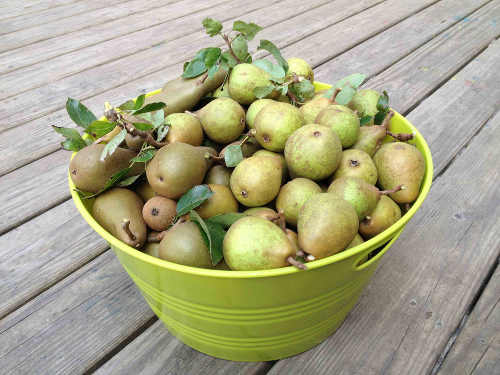 This week I spent some time at either end of the food growing cycle: at one end, up to my neck in compost, turning the heaps at the end of the garden; at the other, up to my neck in a mountain of pears in the kitchen, turning them in to a pickle for the winter larder. When it comes down to it, you have to be willing to invest time at both ends of the cycle, if your food growing is to thrive.
This week I spent some time at either end of the food growing cycle: at one end, up to my neck in compost, turning the heaps at the end of the garden; at the other, up to my neck in a mountain of pears in the kitchen, turning them in to a pickle for the winter larder. When it comes down to it, you have to be willing to invest time at both ends of the cycle, if your food growing is to thrive.
Turning compost heaps is unsung, hard bloody work, and not particularly glamourous it has to be said. But, it’s a vital beginning and end to everything that happens in the veg patch.
Spent vegetable plants and the rich manure-covered straw from the hen house are barrowed to the compost corner, and with the help of Father Time (and some back-breaking labour) magically turn in to crumbly black gold which is given back to the veg patch soil.
I find it immensely comforting to be part of this virtuous circle and increasingly view my role in the veg patch as ‘nutrient shepherd’ – helping nutrients to flow around the garden between soil, plants, animal and man.
At the other end of the cycle, there are food gluts to deal with. At this time of the year I find these great autumn processing tasks towering over me, tapping their fingers expectantly. Every day as I went down to the end of the garden to feed hens or collect eggs, I was conscious that the pear trees were literally creaking under the weight of pears (a mature pear tree can yield 50-100kg of pears).
If they were not to be wasted, a serious marathon of peeling, chopping and general sweating over a hot stove was required. It took me three early-morning hours to convert nearly 10kg of pears in to a pickle (see recipe below) – I’d like to say there’s great joy in this simple labour, but really I would have prefered a lie-in.
There is however, a quiet satisfaction to be had in surveying a row of kiln jars and knowing that nature’s great bounty has been harnessed yet again for the winter.
 Things to do this Month - September
Things to do this Month - September
To-Do
Lift crops which have finished growing and dress bare soil with manure, compost (or plant green manures). Wasps can be problematic as fruit ripens so make traps from jars of sugary water. Remove surplus leaves from tomato plants which allows air to circulate and sunshine to fall on the fruit. Go blackberry picking!
Sow
Last month for sowing perpetual spinach, chard and oriental salads – it will be worth it in the New Year when there’s almost nothing else to eat, so get sowing! In the polytunnel/greenhouse sow lettuce, mustard, cress, basil, coriander, parsley, radish, dwarf early pea, broadbean, cauliflower seed, rocket, onion seed and garlic. Outside sow white turnip seeds and autumn onion sets, e.g. ‘centurion’ and ‘sturon’. Plant out strawberry runners. Pot up some parsley for winter use.
Harvest
Lift onions and leave to dry out in sun or in the polytunnel/greenhouse for two weeks. Apples, plums, pears are now in season. Continue to harvest salad leaves, tomatoes, radish, potatoes, carrots, turnips, beetroots, cauliflower, cucumbers, peppers, beans, courgettes, spinach, leeks, red cabbage, summer cabbage, aubergine, sweet corn.
Recipe of the Week – Pickled Pears
This recipe from Darina Allen’s ‘Forgotten Skills of Cooking’ book (Kyle Books, 2010), features in my book, ‘Grow, Cook, Eat’. I used it for the first time last year, and we just loved it in our house – the sweet and tangy pears work beautifully with meats, game and blue cheese but also as dessert. Recipe makes 6 X 450G (1lb) pots.
Ingredients
• 1.8kg (4lb) pears (Conference or Doyenne de Comice are perfect, but Bartlett pears will also suffice)
• juice and zest of 1 organic lemon
• 600ml (1 pint) of white wine vinegar
• 30ml (1fl oz) sherry vinegar (optional)
• 600g (11⁄4 lb) sugar
• 2.5cm (1in) piece of fresh ginger, peeled and sliced
• 1 cinnamon stick, 2 star anise, 4 cloves
Directions
Peel, core and quarter the pears and put them into a stainless-steel saucepan. Remove the lemon zest with a swivel-top peeler, squeeze the juice over the fruit and toss well. Cover and cook on a gentle heat while you prepare the pickle. Put the vinegars, sugar, spices, and lemon zest into a stainless-steel saucepan. Bring to the boil, stirring until all the sugar is dissolved. Simmer for 5 minutes, then add the pears and continue to cook until the pears are completely soft – about 10-30 minutes, depending on the variety and degree of ripeness. Fill the pears into sterilised jars, while continuing to cook the liquid. Pour the boiling liquid over the pears, making sure they are well covered. Seal and, if possible, leave for a couple of weeks to mellow before tucking in!
Tip of the Week – Storing Pears
Unlike apples, pears do not store particularly well and you will be doing very well if you have any left in storage at Christmas. I put about 2kg of pears on a wire rack in the garage one year, and they were all wizened within a week. As a result I am generally sceptical of the idea of storing pears (hence the pickling marathon described above). The general advice is to leave them unwrapped on slatted trays in a moderately dry, warm atmosphere (about 7 degrees celsius). Be careful only to store the very best fruit – reject anything bruised or damaged.
Join GIY
By joining GIY you help us to continue the work of supporting people just like you to grow food at home, at school, in the workplace and in the community – each year we support over 65,000 people and 1,500 community food growing groups and projects. It costs just €35 to join GIY for a year, and to say thanks we will send you a seasonal copy of our supporter’s magazine GROW and some GIY seeds for you to sow each quarter. We will also send you our weekly tips, news and advice ezine and offer you discounts to GIY events like the annual GROW Fest. Join today at www.giyireland.com.
 About GIY
About GIY
GIY is a not-for-profit organisation that aims to create a healthier, more sustainable world where people grow their own food. We inspire and support people to grow food more successfully by bringing them together to share advice, tips and ideas. There are approximately 65,000 people involved in the GIY movement in Ireland, which is proudly supported by Woodies DIY.
For more information check out www.giyireland.com
Michael Kelly is a freelance journalist, author and founder of GIY Ireland.
© GIY Ireland 2015 – all rights reserved.
Grow It Yourself - November
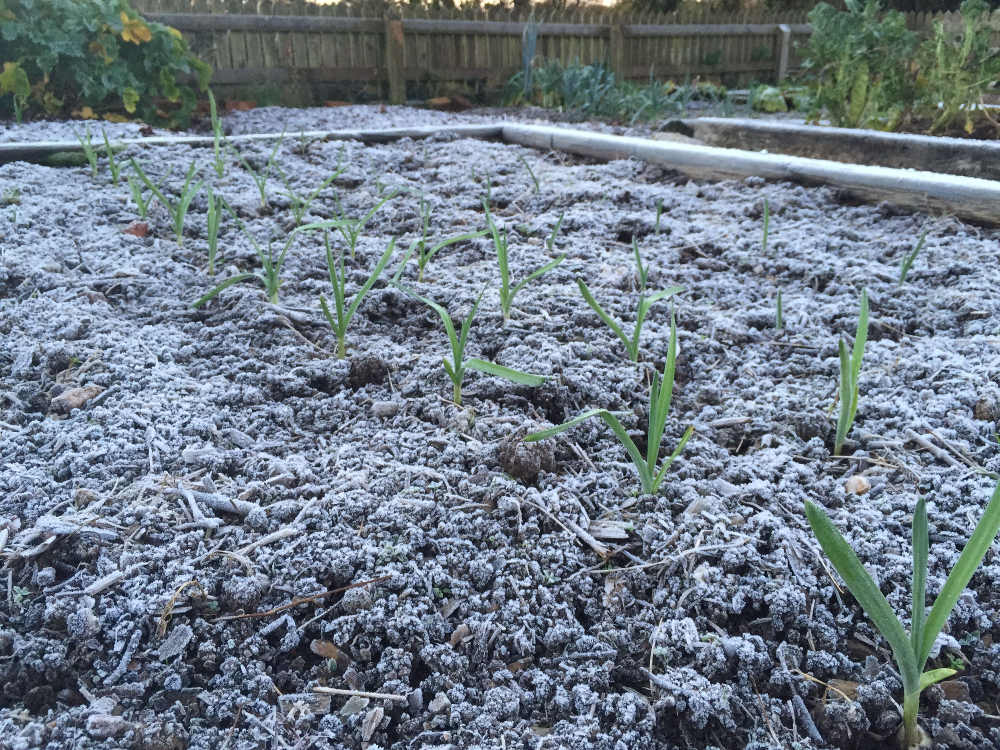
 Being a contrary sort I have always sown my garlic in the spring time, and it’s an approach that has served me well over the years. In fact, it has worked so well that I never really saw the point of winter garlic sowing and I always felt very clever indeed for holding off until spring.
Being a contrary sort I have always sown my garlic in the spring time, and it’s an approach that has served me well over the years. In fact, it has worked so well that I never really saw the point of winter garlic sowing and I always felt very clever indeed for holding off until spring.
This year however, I got caught out by mild spring weather. Garlic needs a prolonged cold snap (4-8 weeks of sub 10 degrees Celsius) to yield nice big tasty bulbs, and the spring weather this year didn’t supply the conditions needed. The result? Puny little garlic bulbs and a dollop of humble pie.
The reason that the majority of growers sow their garlic pre-Christmas is that it gives the bulbs more of a chance of getting the prolonged cold spell that they need in the soil.
We did a survey among GIYers and found that 89% sow their garlic pre-Christmas with just 11% sowing in the spring. So, for next year’s garlic crop, I’ve decided to join the sensible majority.
In previous years I’ve enjoyed taking a complete break from sowing things outdoors between late September and February, but this year I’ve been uncharacteristically busy on the sowing front, getting garlic, overwintering red onions and broad beans in the soil.
I have enjoyed these sowings immensely, which seem in defiance of the changing seasons and must confess that it’s wonderful to see little shoots appearing through the soil at this time of year.
The bed where the garlic will grow next year is a big square raised bed beside the polytunnel. Since removing this year’s crop from it (brassicas), I’ve kept the bed well hoed in preparation for the garlic.
So the soil was in good, ‘weed-free’ nick and a simple raking was enough to get it ready for sowing. This year I sowed four varieties – Early Purple Wight, Carcassone, Provence and Solent - and sowed seven rows with ten cloves per row. 70 bulbs of garlic would be a mighty haul.
The question arises then – if you are sowing something in a bed over the winter, how do you go about the normal winter job of returning fertility to the bed? A trick I gleaned from our friend Monty Don is to mulch the bed with a good covering of home-made compost after sowing the cloves beneath the surface. Since the surface of the soil was to be covered with a layer of compost, I sowed the garlic a little shallower than normal.
 Things to do this month - November
Things to do this month - November
To Do
Do not leave beds bare for the winter – sow a green manure, or cover with a thick layer of manure/compost and then black plastic or straw. This will return nutrients to the soil, keep the worst of the weather off it, suppress weeds and prevent leaching of nutrients. ‘Earth up’ or tie up vegetables such as cabbage, cauliflower and Brussels sprouts. Divide up your rhubarb if you want to propagate, and cover it with a thick mulch of manure. Prune apple trees. Mulch fruit bushes. Take cuttings of currant bushes from current season’s wood.
Sow
Sow broad beans outside now for an early crop next spring. To avoid rotting before germination, make small newspaper cups and germinate them indoors first. Next summer’s garlic does best if it’s planted before Christmas – plant outdoors in well prepared soil in a sunny spot. Though I have to admit I never bother with them, some varieties of onion can over-winter and will be ready to harvest in early summer.
Harvest
Continue to harvest perpetual spinach, cabbage, cauliflower, potatoes, swede, parsnips, apples, pears. Start harvesting leeks, winter cabbage, kale, artichokes, Brussels sprouts. Time to lift carrots and turnips or at least cover them with a good layer of straw to protect them from frost damage.
Recipe of the Month – Hardcore Coleslaw with Garlic Dressing
Don’t be tempted to look on coleslaw as a summer only dish – for the GIYer, some of the great coleslaw ingredients like carrots and celeriac are still abundant in the veg patch in November. This Tom Kerridge recipe has a lot of ingredients in it but it’s quite simple to make, particularly if you use a mandolin or food processor to slice the veg.
I was missing the fennel for this recipe, but it didn’t seem to suffer unduly from its absence – I simply added a little more of the other veg. I guess it’s the 5 cloves of garlic that makes it hardcore.
Ingredients:
• 1 bulb fennel
• ¼ small celeriac, peeled
• ¼ small red cabbage
• ¼ small white cabbage
• 1 beetroot, peeled
• 1 Spanish onion
• 2 large carrots, peeled
• 1 tbsp fennel seeds, toasted
• 2 tbsp flaky sea salt
• 1 lemon, zest only
• 1 tsp chopped fresh dill
• 1 tbsp chopped chervil
• 1 tbsp chopped fresh flatleaf parsley
For the dressing
• 5 garlic cloves, grated
• 2 free-range egg yolks
• 4 tsp white wine vinegar
• 35g/1¼oz English mustard
• 1 lemon, juice only
• 1 tbsp salted anchovies
• 2 tsp caster sugar
• 350ml/12fl oz vegetable oil
• salt
• cayenne pepper, to taste
Directions:
Finely slice the fennel, celeriac, red cabbage, white cabbage, beetroot, onion and carrots and place into a large mixing bowl. Add the fennel seeds and salt. Mix thoroughly, then leave to stand for 20 minutes so the vegetables wilt and cure in the salt.
For the garlic dressing, add the garlic, egg yolks, white wine vinegar, mustard, lemon juice, anchovies and sugar to a food processor and blend until smooth.
While the food processor is still running, slowly pour in the vegetable oil in a thin steady stream until the mayonnaise is emulsified. Season with salt and cayenne pepper, to taste.
Pass through a fine sieve to make it really smooth. Keep in the fridge until needed.
Rinse the vegetables under cold running water for a couple of minutes. Place in a clean tea towel and squeeze out all of the moisture. Put the vegetables in a clean mixing bowl and add the lemon zest and chopped herbs. Check and add seasoning if required.
Fold in as much mayonnaise as you like, you may not need it all. Mix together and serve. The coleslaw will keep in the fridge for up to one week.
Tip of the Month – Sow Garlic
If possible buy your garlic from a garden centre or reputable on-line retailer which will be certified virus free (the same can’t be said of supermarket garlic). When you buy your bulbs, break up in to individual cloves. Only the sow the better cloves and dump (or eat) any small ones.
Garlic likes a light free-draining soil so if you have heavy soil in your garden grow in raised beds or pots. It will prefer a sunny position in the veg patch. Hold each clove pointed end up, and push it into the soil so that the tip is 2cm or so beneath the soil surface. The cloves should be 20cm apart in the rows, and the rows 25cm apart.
Garlic is part of the allium family so include it in your crop rotation and don’t sow it anywhere where any member of the allium family has grown in the previous 3-5 years (e.g. onions, garlic, leeks).
There’s a full range of overwintering garlic on our web shop at www.giyireland.com/shop.
Join GIY
By joining GIY you help us to continue the work of supporting people just like you to grow food at home, at school, in the workplace and in the community – each year we support over 65,000 people and 1,500 community food growing groups and projects. It costs just €35 to join GIY for a year, and to say thanks we will send you a seasonal copy of our supporter’s magazine GROW and some GIY seeds for you to sow each quarter. We will also send you our weekly tips, news and advice ezine and offer you discounts to GIY events like the annual GROW Fest. Join today at www.giyireland.com.
 About GIY
About GIY
GIY is a not-for-profit organisation that aims to create a healthier, more sustainable world where people grow their own food. We inspire and support people to grow food more successfully by bringing them together to share advice, tips and ideas. There are approximately 65,000 people involved in the GIY movement in Ireland, which is proudly supported by Woodies DIY.
For more information check out www.giyireland.com
Michael Kelly is a freelance journalist, author and founder of GIY Ireland.
© GIY Ireland 2015 – all rights reserved.
Grow It Yourself - December
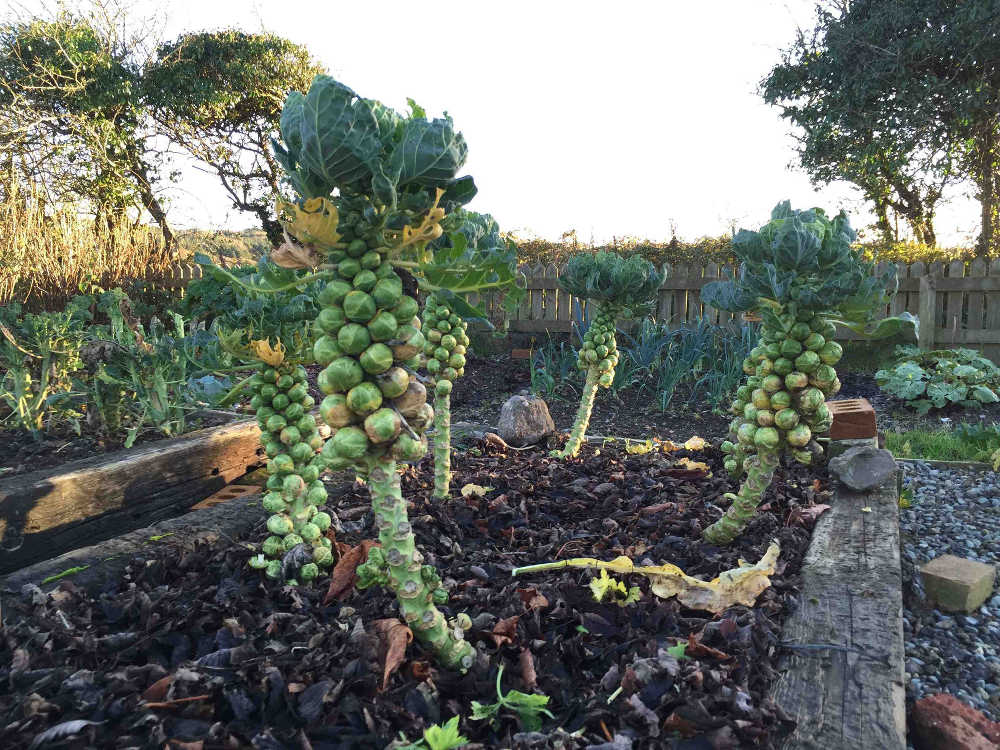

Ok, so here’s a confession. In almost ten years of growing I’ve never managed to successfully grow that quintessential Christmas crop, the Brussels sprout. This has been somewhat irksome as I am a fan of sprouts and generally speaking, really in to the idea of vegetables that grow well over winter.
But alas they are a slow growing crop, which means you have to be on the ball for a long period of time to grow them successfully. My sprouts this year were sown in April (and planted out in the veg patch end May) which means that I have been tending to them on and off for 8 months now. That’s not ideal when you’ve the attention span of gnat like I do.
It doesn’t help of course that Brussels sprouts are a member of the brassica family, otherwise known as the “Pests and Diseases Love Us” family. In some years, the little seedlings have been munched by slugs shortly after being planted out in the garden.
In other years I’ve managed to fend off the slugs long enough to get a decent plant going, only for the pesky cabbage white butterfly to lay its pesky eggs on the leaves, which turn in to pesky caterpillars that end up eating the whole pesky thing. That’s just pesky.
This year through a combination of grim determination and sheer good luck, I managed to get the plants in to the autumn in fine fettle and have been rewarded FINALLY with a decent crop of sprouts.
Timing is everything – you want the plants to form nice firm sprouts by the time the first frosts hit, but not so early that they’ve become overly mature (and loose) by then. With the occasional frosts of the last month, their flavour has continued to improve to a pleasingly sweet and nutty flavour – unlike anything I’ve ever tasted before.
They are an incredibly handsome crop in the garden – particularly when the yellowing leaves are removed to expose the sprouts along the stalks, therefore providing an ever present reminder of your awesomeness as a GIYer.
The big question is – with such an appetite for the lovely sprouts, will I have any left for Christmas dinner?
Things to Do this Month - December
To Do
As you clear remaining crops from your veggie patch, dig the beds over and add well rotted compost or manure. Get Educated – book yourself on a course! Start planning what you would like to grow next year and work out what crop rotation system you are going to use. Study seed catalogues carefully before deciding on the best varieties to grow. Start a Compost corner or heap. Keep an eye on your stored veggies and discard anything that’s rotting. Collect and store leaves in bags to make leaf mould or use as cover for bare soil.
Sow
If you haven’t already done so plant garlic – it should be in the soil by the shortest day of the year. Bring herbs like mint, chives, lemon balm, parsley, thyme indoors by lifting and potting them up.
Harvest
Buck the seasonal trend by continuing to harvest winter salad leaves like corn salad, land cress and mizuna. You should still have at least some produce left in the December veggie patch e.g. winter cabbages, Brussels sprouts, leeks, kale, Jerusalem artichokes, carrots, celery, turnips, parsnips, winter cauliflowers, swedes, spinach, chard and celeriac. From your stores you can enjoy pumpkins and squashes, potatoes, onions, apples, beetroot and garlic.
Recipe of the Month – Brussels Sprouts, Apple and Bacon Hash
This cracking seasonal recipe brings together ingredients that work great together – sprouts, apple, bacon and onions. Roasting the veg and apples brings out their sweetness and of course bacon is the ultimate partner for the sprouts.
Ingredients:
• 300g Brussels sprouts, halved
• 2 red onions, unpeeled, halved lengthwise
• 1 apple, cored
• 1/2 tablespoon butter
• 180g streaky bacon, cut into 1/2-inch pieces
Directions:
Preheat oven to 190 degrees. Toss Brussels sprouts and onions with just enough olive oil to coat; season with salt and pepper. Spread vegetables in a single layer on a baking sheet. Fill center of apple with butter, and add to baking sheet. Roast until tender when pierced with a fork, about 30 minutes for the apple, 40 to 45 minutes for the vegetables.
Meanwhile, cook bacon in a large, heavy pan over medium heat until fat renders and bacon begins to crisp, about 12 minutes. Pour off most fat, leaving behind enough to coat bottom of pan. When onion and apple are cool enough to handle, cut into pieces about the size of Brussels sprouts.
Add onion, apple, and Brussels sprouts to skillet, and cook over medium heat, stirring occasionally, until heated through, about 15 minutes.
Tip of the Month – Winter Protection for Plants
Over the last couple of years we’ve been experiencing some severe winter weather, not usually seen until the New Year. So if you haven’t yet started now is a good time to protect your plants, trees and soil from the more extreme temperatures – ensuring that you’re guaranteed some crops come Spring!
Fleece will protect your crop or soil from frost and cold weather whilst admitting light, air and rain. This is generally bought in large rolls or sheets and can be cut to the specifications of your plant/raised bed. It is also available in varying thickness, including a heavyweight version (30g) for Arctic conditions! ‘Fleece Jackets’ for larger plants/bushes are available from some garden centres.
If you don’t have a greenhouse or polytunnel, you may want to look at covering young or more delicate plants with cloches. This can range from glass bell jar cloches or ornate Victorian lantern cloches to homemade cloches from glass jars, fizzy drink bottles and sneakily-appropriated Water Cooler bottles from the office!
Join GIY
By joining GIY you help us to continue the work of supporting people just like you to grow food at home, at school, in the workplace and in the community – each year we support over 65,000 people and 1,500 community food growing groups and projects. It costs just €35 to join GIY for a year, and to say thanks we will send you a seasonal copy of our supporter’s magazine GROW and some GIY seeds for you to sow each quarter. We will also send you our weekly tips, news and advice ezine and offer you discounts to GIY events like the annual GROW Fest. Join today at www.giyireland.com.
 About GIY
About GIY
GIY is a not-for-profit organisation that aims to create a healthier, more sustainable world where people grow their own food. We inspire and support people to grow food more successfully by bringing them together to share advice, tips and ideas. There are approximately 65,000 people involved in the GIY movement in Ireland, which is proudly supported by Woodies DIY.
For more information check out www.giyireland.com
Michael Kelly is a freelance journalist, author and founder of GIY Ireland.
© GIY Ireland 2015 – all rights reserved.
Grow It Yourself - January
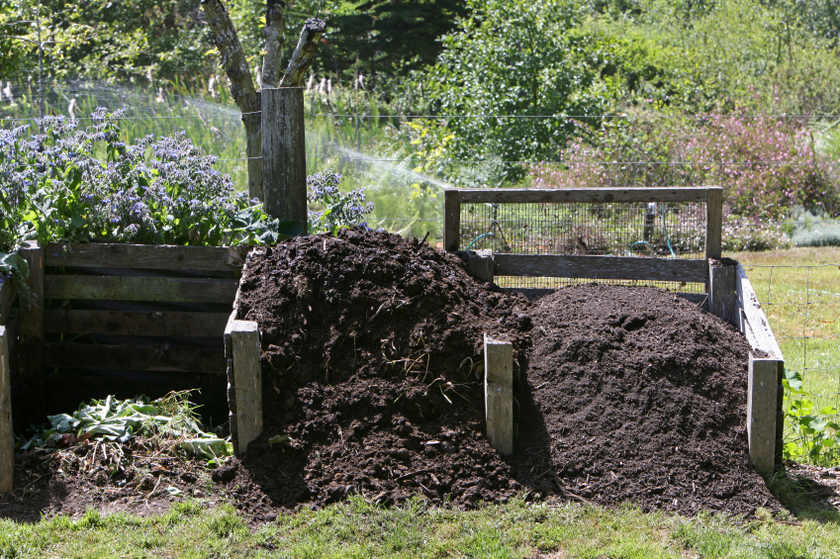
 I reckon we could do worse then to make our 2016 resolution all about paying more attention to soil. If that sounds odd, bear in mind that healthy soils are the cornerstone of life on earth - not only the foundation for food, fuel and medical products, but also essential to our ecosystems, playing a key role in the carbon cycle, storing and filtering water, and improving resilience to floods and droughts.
I reckon we could do worse then to make our 2016 resolution all about paying more attention to soil. If that sounds odd, bear in mind that healthy soils are the cornerstone of life on earth - not only the foundation for food, fuel and medical products, but also essential to our ecosystems, playing a key role in the carbon cycle, storing and filtering water, and improving resilience to floods and droughts.
Our soils work hard. But we will work them even harder in the decades to come – population growth will require a 60% increase in food production, but instead of working to conserve and protect this precious resource, we’re literally treating it like dirt.
The world’s soil is under immense pressure – it takes 1,000 years to form a centimeter of soil, but we’re losing it permanently (and at dizzying pace) to relentless urbanization to accommodate the expanding population.
An area of soil the size of Costa Rica is lost every year and here in Europe, 11 hectares of life-giving soil are sealed under expanding cities every hour. Globally, a third of all our remaining soil is degraded from erosion, compaction, nutrient depletion and pollution. Given the role it plays in feeding us (95% of our food comes from it), Vandana Shiva says that our determined destruction of the soil globally represents a ‘species-level act of suicide’.
As GIYers we play an important part in the management of this critical resource, not only by our gentle stewardship of the soil in our own gardens, but also by developing a deeper understanding of how soil works (and sharing that knowledge with others). Of all the things I have learned about food growing in the last ten years, a deeper understanding of the soil has been perhaps the most important (and certainly the most satisfying).
I am starting to understand that food growing is not about growing plants at all, it’s about growing soil. If you get the soil right, the plants really look after themselves. Of course that means many mucky, sweaty hours spent turning compost heaps, lugging barrows of farmyard manure or collecting seaweed, but that’s OK too – you don’t need gym membership when you’re a GIYer.
Gradually my soil at home has come to life, no longer the heavy potters clay of when we arrived here first, but friable and teeming with life. My job here is about shepherding nutrients around the place from the compost heap to the veg patch plants, to the kitchen table and back to the compost heap again. So this year, resolve to love soil. Pick up big handfuls of it in your hands. Smell it. Stand in it in your barefeet. Care for it. Nurture it. It is literally where all life begins.
Things to do this Month
To Do
Plan. This is the time to decide where and what you are going to grow this year. If you are just starting out join your local GIY group for advice and check out our website for handy “getting started” guides and videos. Consider building or buying raised vegetable beds. Order your seeds, onions sets and seed potatoes. Turn over the soil in February only if the weather is dry – if the soil sticks to your boots it’s too early for digging! “Chit” seed potatoes – put them in a container (e.g. used egg carton or empty seed tray) and leave them in a bright warm place to sprout.
Sow
In mid Feb, in seed trays and pots on a sunny windowsill indoors sow celery, globe artichokes, celeriac, leeks, onions, lettuce, tomatoes, peas, aubergines, peppers/chilli-peppers. Weather permitting outside you can try sowing broadbeans, spinach, kohlrabi, onion and shallot sets, Jerusalem artichokes, parsnip and early pea varieties.
Harvest
You may still have winter cabbage, perpetual spinach, chard, leeks, kale, cauliflowers and Brussels sprouts in your veggie patch and depending on how successful your growing/storage regime last year was, you may well still be tucking in to stores of potatoes, celeriac, carrots, parsnips, onions, cauliflower, jerusalem artichokes, winter squash, pumpkins, leeks and red cabbage.
Recipe of the Month – Beetroot and Carrot Gratin
This recipe from our GIY book GROW COOK EAT is a staple in our house. The cream and parmesan make it just decadent enough not to feel too frugal, but it still feels healthy and is a great way to cook beetroot. It’s also a sinch to make. The recipe comes originally from Michelle Darmody‘s The Cake Café. Serves 4.
Ingredients:
• 300g of waxy potatoes, sliced very thinly
• 4 carrots, sliced
• 3 beetroot, peeled and sliced
• a small bunch of rosemary, pulled from the stalk and chopped
• 4 cloves of garlic, sliced
• 250ml of cream
• 70g of Parmesan, grated
• mixed salad leaves for four
• a handful of almonds, toasted and chopped
• 1 tbsp of vinaigrette dressing
Directions:
Lay the sliced potato, carrots and beetroot into an ovenproof dish, sprinkling the garlic and rosemary between layers.
Pour the cream over the whole lot and place into an oven heated to 180 degrees until the vegetables are soft which will take about 40 minutes.
Season and sprinkle with the parmesan and place back into the oven until golden on the top.
Toss the leaves and almonds in the dressing and season.
Slice the gratin in four and gently transfer onto a plate.
Serve with the salad on the side and with some chutney if you wish.
Tip of the Week – Tips for growing good carrots
One of the most common problems that people have with carrots is that they end up with stumped or forked roots – though the first couple might be fun to look at (particularly if they’re rude looking), after that it is just plain annoying. There are three main causes here:
(1) Forking of roots occurs if there are stones in the soil or if the soil is very compacted. I mainly practice no dig gardening, but I do dig the carrot bed thoroughly in springtime to make sure the soil is in good nick to a spade’s depth and that any large stones are removed.
(2) Forking can also be caused by too much fresh manure or compost in the soil being added in spring. The root will literally fork off in search of a pocket of nutrients rather than growing down in search of it. If you need to feed the soil in your carrot bed, do so in the autumn.
Finally (3), carrots don’t transplant well and any disturbance to the seedling when you’re transplanting can cause forked roots. So, it’s always better to sow carrot seeds direct in the soil.
Join GIY
By joining GIY you help us to continue the work of supporting people just like you to grow food at home, at school, in the workplace and in the community – each year we support over 65,000 people and 1,500 community food growing groups and projects. It costs just €35 to join GIY for a year, and to say thanks we will send you a seasonal copy of our supporter’s magazine GROW and some GIY seeds for you to sow each quarter. We will also send you our weekly tips, news and advice ezine and offer you discounts to GIY events like the annual GROW Fest. Join today at www.giyireland.com.
 About GIY
About GIY
GIY is a not-for-profit organisation that aims to create a healthier, more sustainable world where people grow their own food. We inspire and support people to grow food more successfully by bringing them together to share advice, tips and ideas. There are approximately 65,000 people involved in the GIY movement in Ireland, which is proudly supported by Woodies DIY.
For more information check out www.giyireland.com
Michael Kelly is a freelance journalist, author and founder of GIY Ireland.
© GIY Ireland 2016 – all rights reserved.
Grow it Yourself - February
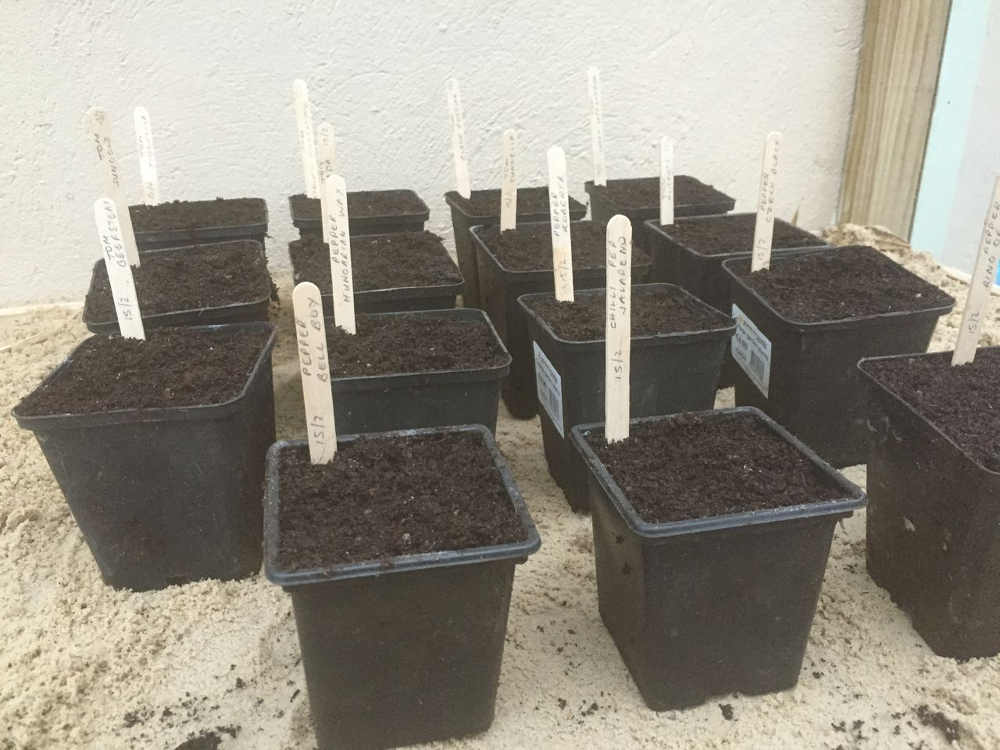

Michael Kelly
And so it begins. Another season starts with the determined act of seed sowing in the potting shed. A bag of compost opened and tipped out on the sowing bench. Cold black plastic pots filled with even colder blacker compost.
Seed labels lined up awaiting a scrawl of information. Seed packets fished out from my big box of tricks and ripped open to reveal their bounty. It’s just tomatoes, aubergines and peppers today so five tiny little seeds are placed gently on the surface of each pot (one for each variety I will sow and 17 pots in all).
Ah but it feels good to start again in to another season. While I work I try to remember whether it’s my tenth or eleventh season? Then I find myself wondering how many seasons I have ahead of me. Maybe thirty if I am lucky? I pull myself back from such existential thoughts and try to stay in the moment. I plug in the heated cable to start the process of warming the sand beneath the seed pots. I realize I am whistling.
It feels too cold to be sowing seeds. The calendar says spring (in that strange Irish way that labels February spring) but it’s definitely still winter outside. All day the weather has alternated erratically from sun to cold showers of rain.
I have shelter from the elements in here in the potting shed but I can feel my feet are numb in my wellies and the tips of my fingers are cold. I’ve a hat on my head and several layers of fleece beneath my jacket, and I can see my breath while I work. I would like to luxuriate over this process, particularly today since it’s the first sowing of the year, but it’s too damn cold – so I move quickly. Sow a pot, label it, move on to the next one.
Before I finish I make a cloche over the pots with some rubber pipe and spread a layer of clear plastic over them, tucking the plastic in beneath them. I am creating a little hothouse for these seeds, which need heat to germinate. It feels a little artificial, but my growing year always starts like this – coaxing Mediterranean conditions from a cold February and trying to warm up the world.
Things to Do This Month - February
To Do
Turn over the soil only if the weather is dry – if the soil sticks to your boots it’s too early for digging! Keep off the soil to prevent soil compaction - use timber planks to stand on for access. If you have not already done so order/buy your seeds, spuds and onion sets. “Chit” or sprout seed potatoes – put them in a container (e.g. used egg carton or empty seed tray) and leave them in a bright warm place. Check the pH of your soil – you can buy a soil pH testing kit in any garden centre. Lime your soil now if required (to reduce acidity in very acid soils), particularly important in your brassica bed.
Sow
Finally, we can sow some seeds. On a sunny windowsill indoors, in a heated greenhouse or on a heating mat: sow celery, globe artichokes, celeriac, leeks, onions, lettuce, tomatoes, peas, aubergines, peppers/chilli-peppers. In polytunnel or greenhouse: beetroot, Brussels sprouts, summer and autumn cabbage, carrots, leeks, lettuce, radish. Outside: Weather permitting you can try planting out broadbeans, spinach, kohlrabi, onion and shallot sets, Jerusalem artichokes, parsnip and early pea varieties.
Harvest
Winter cabbage and cauliflowers, Brussels sprouts, spinach, kale and leeks.
Recipe of the Month – Chocolate and Beetroot Cake
GIY Dorset local champion Wendy Pillar put together a handy guide to beetroot recipes, which I happily plagiarise here (with thanks!) – this Pam Rosling recipe for chocolate and beetroot cake is delicious and easy to make.
Ingredients
• 100 ml rapeseed or sunflower oil
• 220g cooked beetroot
• 150g soft brown sugar
• 1 tbsp baking powder
• 50g cocoa powder
• 200g natural yoghurt
• 2 tsp vanilla extract
Heat oven to 180°C/160°C fan/gas 4. Grease and line a deep 2- cm springform cake tin. Tip the beetroot into a food processor and whiz to a puree. Add the remaining ingredients, along with a pinch of salt, and blend until well combined. Scrape into the cake tin, level the surface and bake for 50 min to 1 hour, or until a skewer comes out clean.
Tip of the Week – Make a Spring Nettle Tea
Wild nettles are a free, abundant wild food that are traditionally used to purify the blood and digestive system. They are one of nature’s first spring foods and will give your immune system a boost. Go in search of fresh spring nettles to make a tonic – use gloves and pick only the tender, pale green leaves. Use a scissors and cut off the top two bracts of leaves, leaving the rest to grow back. Put about a cup of nettle leaves in to about two cups of boiling water and leave for 10 minutes. Pour through a strainer in to a mug and add honey to taste.
Join GIY
By joining GIY you help us to continue the work of supporting people just like you to grow food at home, at school, in the workplace and in the community – each year we support over 65,000 people and 1,500 community food growing groups and projects. It costs just €35 to join GIY for a year, and to say thanks we will send you a seasonal copy of our supporter’s magazine GROW and some GIY seeds for you to sow each quarter. We will also send you our weekly tips, news and advice ezine and offer you discounts to GIY events like the annual GROW Fest. Join today at www.giyireland.com.
 About GIY
About GIY
GIY is a not-for-profit organisation that aims to create a healthier, more sustainable world where people grow their own food. We inspire and support people to grow food more successfully by bringing them together to share advice, tips and ideas. There are approximately 65,000 people involved in the GIY movement in Ireland, which is proudly supported by Woodies DIY.
For more information check out www.giyireland.com
Michael Kelly is a freelance journalist, author and founder of GIY Ireland.
© GIY Ireland 2016 – all rights reserved.
Grow It Yourself - March
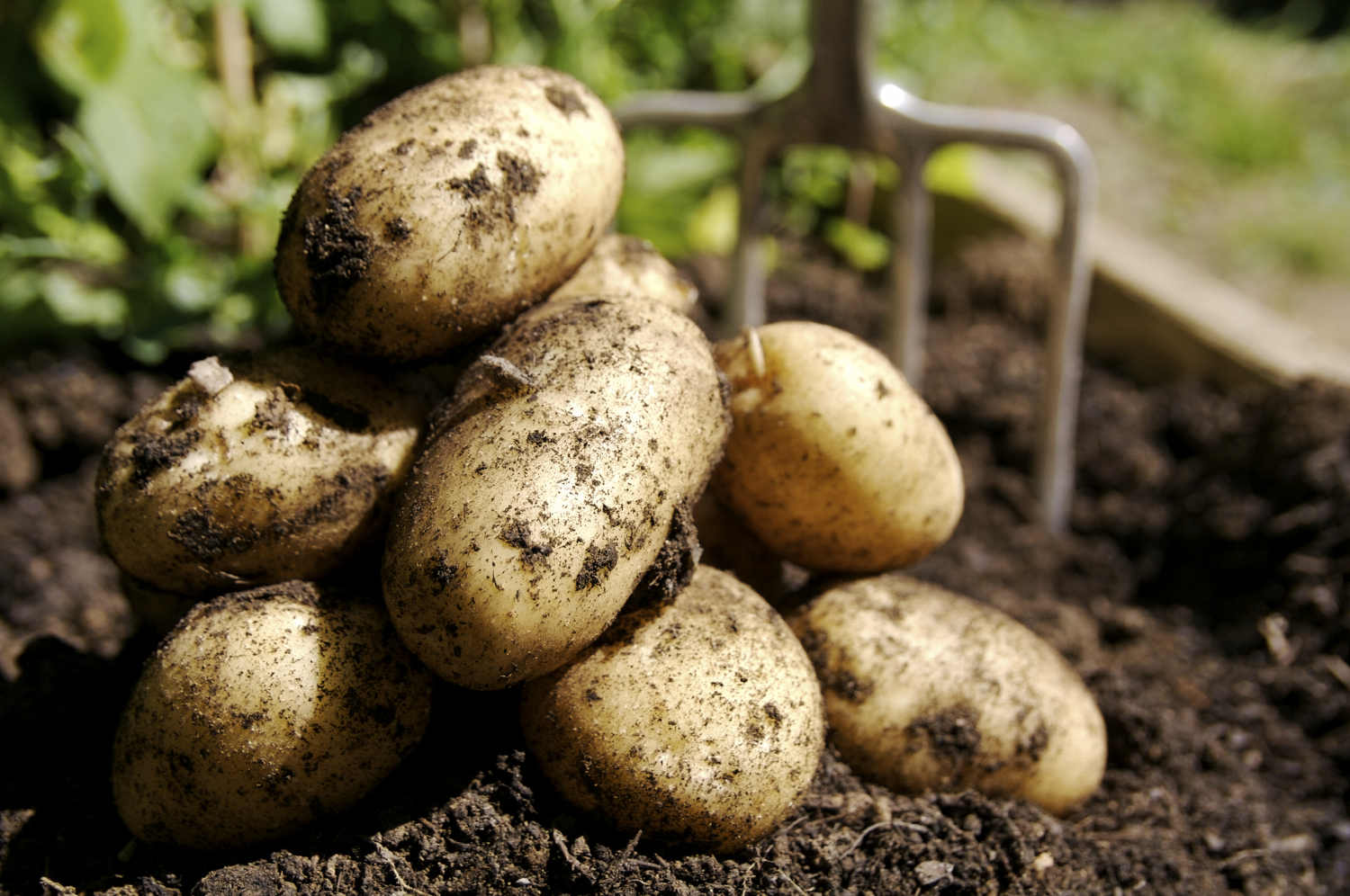
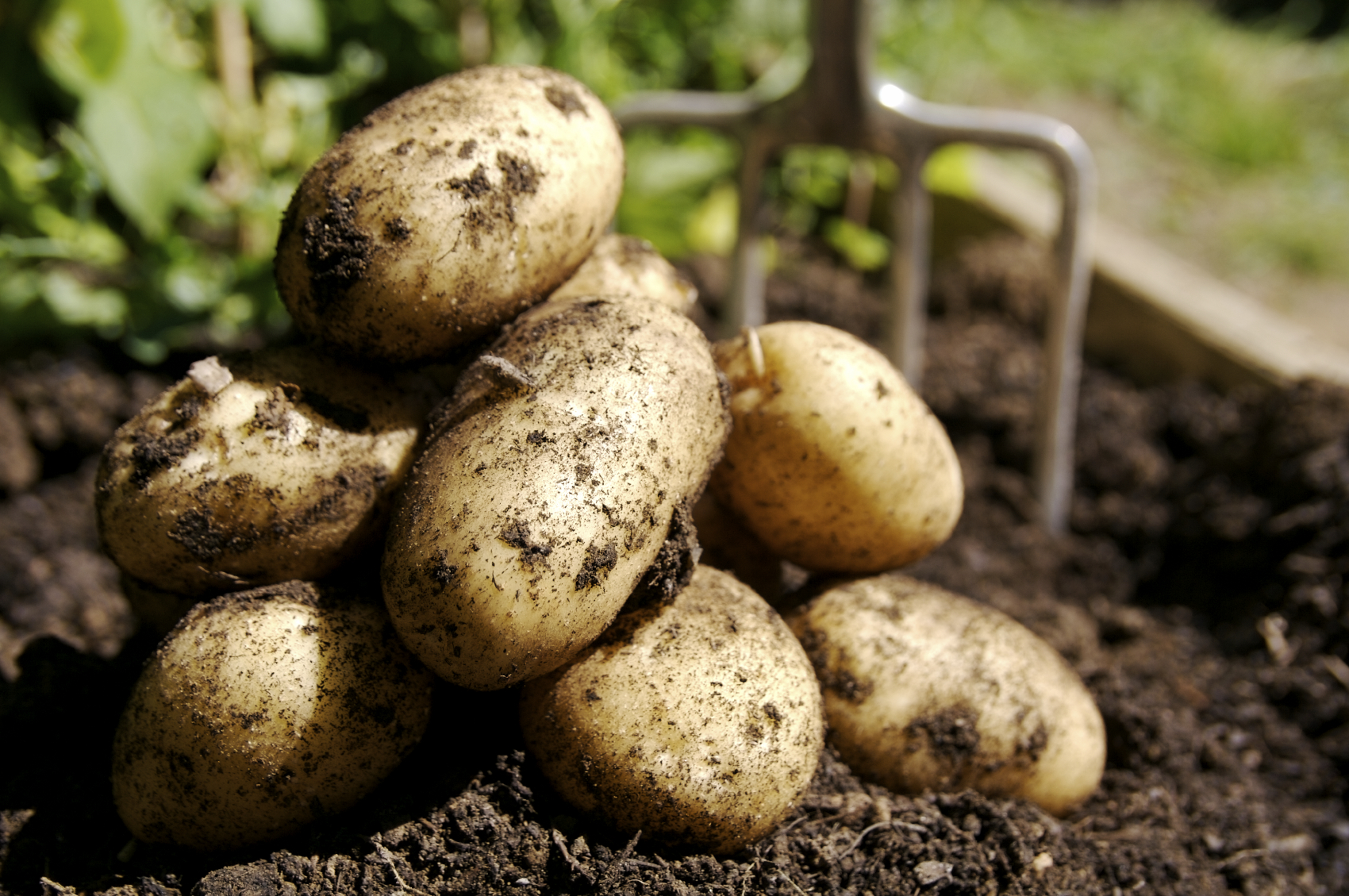
The rise of carbs such as rice, pasta and cous cous has seen sales of potatoes decline by 20% in the last decade. In fact Bord Bia reports that sales of the spud could fall by as much as 40% in the next decade if the trend continues unchecked. The spud’s reputation has taken a hammering of late – it is deemed a little old fashioned, fattening and a hassle to cook.
Take a deeper look beneath the headlines however and you find a product that’s far more than just a carbohydrate. Take away the copious quantities of fat that we often add through cooking (or post-cooking) of potatoes and you have an exceptionally healthful low-calorie, high-fibre food that’s also a great source of potassium, vitamin B6 and vitamin C. It is also generally speaking an entirely unprocessed food and let’s be honest, the same simply can’t be said for pasta.
To top it all, at a time when more of us are committed to supporting local foods, the potato is a genuinely home-grown product, and by buying it we support a huge local industry of growers and packers (whereas sweet potatoes are generally imported from the US). Thankfully, the potato is one of the few remaining vegetables where Irish people generally won’t tolerate a foreign import equivalent and that’s good for the environment too.
Few of us are lucky enough to be able to grow enough spuds to be self-sufficient and that’s fine – it’s good to grow some of them ourselves AND support local growers at times of the year when we don’t have our own. I like to think that GIYers can act as the ultimate spud ambassador - as growers we get to understand this wonder-crop a little better and at a time when the number of potato varieties is reducing sharply (with Irish tastes increasingly consolidating around Roosters), we get to try lots of different varieties and sample the flavours.
So in March we celebrate St Patrick’s Day in our house with the ritual of sowing our early potatoes. I don’t buy the idea that spuds are old-hat or that their best days are behind them – in fact I think it’s only a matter of time before contemporary Ireland falls in love with them all over again. After all they are a healthy, local, seasonal super-food – so what’s not to love?
Things to do this Month - March
To Do
Continue to prepare ground – there is still time to prepare a plot to grow veg this year. Fork or rake over existing beds, breaking up large clods of earth. Cover new seedlings with fleece if a frost is due. Start your daily slug patrols and lay beer traps. Don’t let new-season weeds take over – get on top of them with weekly hoeing.
Sow
Indoors: lettuce, aubergine, peppers, cucumbers, celery, celeriac, sweet corn, basil, leeks, summer cabbage, cauliflower, Brussels sprouts, parsley, courgette, French beans.
Sow outdoors or under cover: broad beans, red cabbage, carrots, cauliflower, spinach, kale, Brussels sprouts, onions, leeks, turnip, peas, radishes, early lettuce, asparagus. Plant your first early seed potatoes, as soon as weather conditions allow.
Harvest
This month you could be enjoying (from the ground and from storage) onions, leeks, parsnips, potatoes, some varieties of lettuce, mint, sprouting broccoli, kale, rhubarb, chard, the first of the spring cauliflowers and cabbage, and spinach (perpetual, spinach beet).
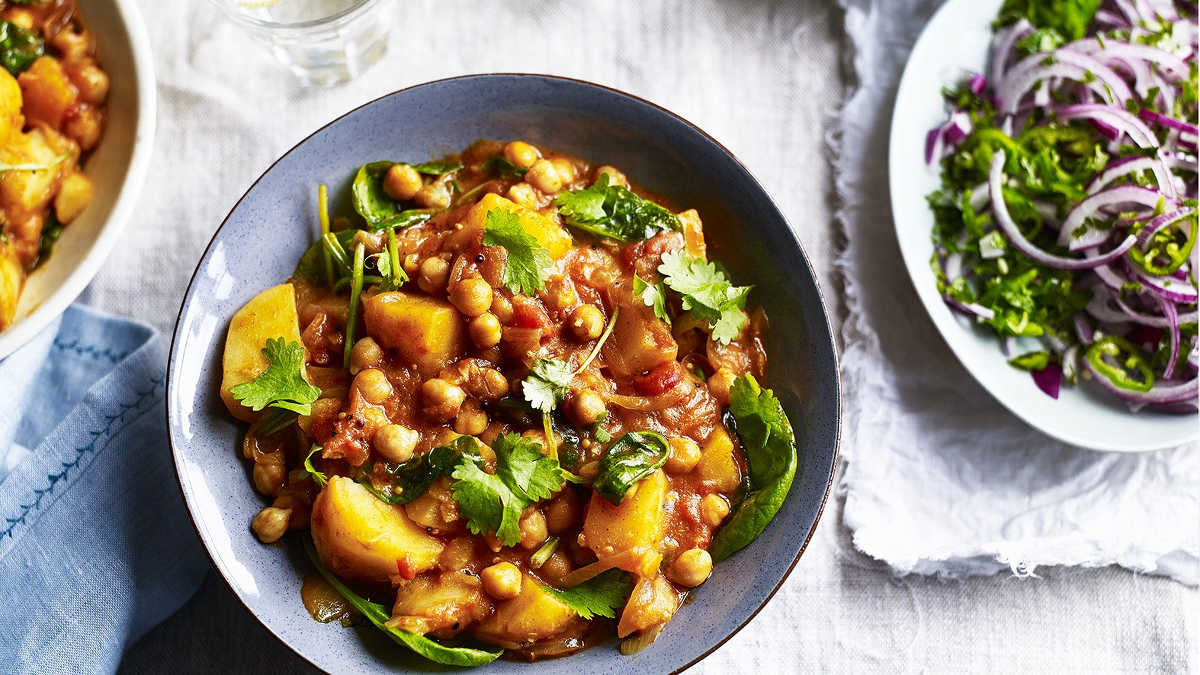 Recipe of the Month – Potato and Chickpea Masala
Recipe of the Month – Potato and Chickpea Masala
This recipe from the potato.ie website puts potatoes center stage in a classic masala and can be prepped and cooked in under half an hour. The spinach doesn’t have to be baby leaf – if you have your own home-grown spinach, you could chop it before adding instead. Serves 4.
Ingredients:
• 900g Maris Piper/Rooster potatoes, peeled and cubed
• 1 tin of chickpeas, drained
• 3tbsp masala curry paste
• 1tbsp garam masala
• 2 onions, sliced
• 2tbsp sunflower oil
• 2 cloves of garlic
• 1tbsp fresh grated ginger
• 1 tin of chopped tomatoes
• 1 tin of coconut milk
• Large handful baby spinach
• 1 tbsp fresh chopped coriander
Directions:
In a large pan or casserole pot gently cook the onion for 5 minutes in the sunflower oil. Next add the garlic, ginger, garam masala and curry paste, continue cooking for 3 minutes over a medium heat. Now add the potatoes and chickpeas and give them a stir in the lovely spices making sure everything is coated.
Pour in the tinned tomatoes and coconut milk and bring to a steady simmer. At this stage add a little salt and milled pepper. Continue cooking until the potatoes are soft. If the sauce feels a little dry just add a little water.
Just before serving stir in the spinach and coriander and serve with yoghurt.
Tip of the Month – On Sowing potatoes
Sow early potatoes from mid March (St Patrick’s Day traditionally) in single rows, 15cm deep, 25cm apart and 45cm between rows. Maincrop spuds are sown in mid to late April. Increase spacing between the spuds to 35cm. It is vitally important to include potatoes in your crop rotation as they are susceptible to disease if grown in the same ground year on year. Earlies will be ready about 14 weeks after sowing. Maincrops take 18 weeks. I typically leave my earlies in the ground and dig as required. They do fine in the ground until September at which point we move on to maincrop. Maincrop can stay in the ground until the first frosts – lift them then and store in hessian sacks. For a GIY video tutorial on growing spuds check out www.giyireland.com/videos/detail/potatoes.
Join GIY
By joining GIY you help us to continue the work of supporting people just like you to grow food at home, at school, in the workplace and in the community – each year we support over 65,000 people and 1,500 community food growing groups and projects. It costs just €35 to join GIY for a year, and to say thanks we will send you a seasonal copy of our supporter’s magazine GROW and some GIY seeds for you to sow each quarter. We will also send you our weekly tips, news and advice ezine and offer you discounts to GIY events like the annual GROW Fest. Join today at www.giyireland.com.
 About GIY
About GIY
GIY is a not-for-profit organisation that aims to create a healthier, more sustainable world where people grow their own food. We inspire and support people to grow food more successfully by bringing them together to share advice, tips and ideas. There are approximately 65,000 people involved in the GIY movement in Ireland, which is proudly supported by Woodies DIY.
For more information check out www.giyireland.com
Michael Kelly is a freelance journalist, author and founder of GIY Ireland.
© GIY Ireland 2016 – all rights reserved.
Grow it Yourself - April
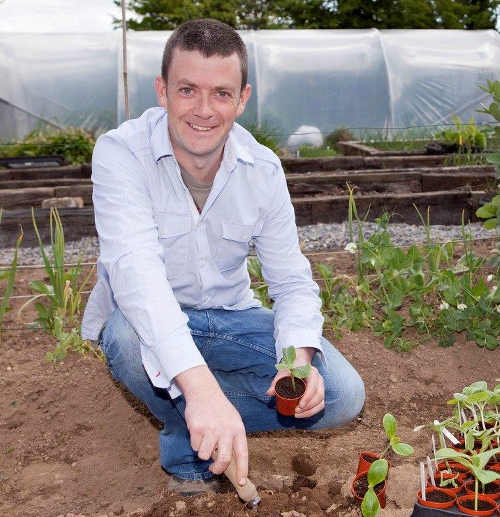
 When you have been growing your own food for a few years, it’s easy to forget what it felt like when you started out first. I am talking about that sweaty, daunted, vaguely frightened feeling - afraid to start, afraid to make a mistake, afraid to look foolish if it goes wrong.
When you have been growing your own food for a few years, it’s easy to forget what it felt like when you started out first. I am talking about that sweaty, daunted, vaguely frightened feeling - afraid to start, afraid to make a mistake, afraid to look foolish if it goes wrong.
I am reminded of something that a friend once told me when I asked her why she didn’t grow her own food. She said her Dad gave her a beautiful flowering orchid once as a present, and instead of feeling gratitude she felt a sinking feeling in the pit of her stomach, knowing that it would only be a matter of days before she would kill it. The feeling in her stomach, she said, was ‘preemptive guilt’ that she couldn’t keep this beautiful living thing alive. Little wonder then that so many people who would like to grow their own food don’t ever start.
So, here’s a confession. In my first few years of GIYing I was completely and utterly useless at it. Voracious reading on the subject left me feeling none the wiser. A veg growing guide might, for example, tell you that you start growing garlic by sticking a clove in the soil – I would immediately wonder, “which end do you stick in the soil?” and riddled with indecision, I would be reluctant to even try. The first time I sowed carrots, I ended up weeding the little seedlings away, because I had no idea which were the weeds and which were the carrot seedlings.
Most people start their GIY journey by buying a book – usually some sort of a vegetable growing guide that has an A-Z listing of all the vegetables one can grow. This seems sensible and I’m all for people buying books (particularly if it’s one of mine…) but I always think that starting with a comprehensive guide to growing is like using the Kama Sutra to learn the basics of sex. What one really needs of course, is to keep it simple, start small and focus on vegetables that are easy to grow (like herbs and salad greens for example). A couple of early quick wins will give you the confidence to keep going.
Incidentally, I wince whenever I hear the phrase “green fingers” - the idea that you are either born with an ability to grow things, or not, is deeply unhelpful. In reality, growing things is a skill and like any skill it takes time to master. All of us have to go through that phase where we are novices and we have to accept the fact that we will most likely kill a lot of plants while we wait for our ability to catch up with our enthusiasm.
Once we’ve accepted that fact, it somehow doesn’t seem so scary. Let’s be honest, in the grand scheme of things, a couple of plants sacrificed for the greater good is not such a big deal. Don’t let yourself get derailed by occasional mishaps. Get back on the horse and try again. The most important thing is that we show up each spring ready to try another season.
Things to do this Month - April
To Do
If poor weather in March has hampered your outdoor work, then April is the month to catch-up. The key words for April are weeds and slugs. You need to stay on top of them both. Check your early spuds regularly and ‘earth-up’ as required. Water your tunnel/greenhouse – things can get pretty warm on a nice sunny April day and seedlings will dry out quickly.
Sow
Indoors: lettuce, tomato, pepper, chilli-pepper, cucumber, celery, celeriac, basil, leeks, cabbage, cauliflower, Brussels sprouts, parsley, courgette, marrow, globe artichoke, beans, sweet corn and pumpkin.
Outdoors: broad bean, onion sets, pea, beetroot, cabbage, spinach, Brussels sprouts, parsnip, spring onion, leek, carrot, radish, broccoli, turnip. Plant out cabbage plants when they are 15/20 cm tall into well prepared soil that has been manured.
Harvest
Stored fruit and vegetables are likely to be a distant memory at this stage and new crops are only starting to trickle in which makes April a tricky proposition. The middle of this month might see the first asparagus and the first early spring cabbage. The other two star performers this month are purple sprouting broccoli and rhubarb.
Recipe of the Month – Sicilian Style Purple Sprouting Broccoli
For the season that’s in it, here’s a sprouting broccoli recipe with a Sicilian twist that’s full of flavour. Serves 4.
Ingredients:
• 1kg sprouting broccoli
• 6 anchovy fillets (drained - retain the oil)
• 2 tablespoons olive oil
• 1 onion
• 12 black olives
• 125ml stock (chicken or veg)
• 125ml red wine
• 1 tsp butter
• 1 tsp flour
Heat the oil and simmer the onions, anchovies and olives for 5 mins. Add the broccoli and give it a good stir. Add the stock and the wine and then stir in a tablespoon of the anchovy oil. Season. Cover and cook for about 10-15 mins.
When the broccoli is tender, remove the lid and simmer for another few minutes. Take out the broccoli and transfer to a warmed serving dish. Thicken the sauce by adding a roux made from the butter and flour.
Stir the sauce until it boils and then pour over the broccoli. Serve with crusty bread, fried potatoes or rice.
Tip of the Month – Starting Celery and Celeriac
Celeriac and celery seeds are sown the same way, but while celery is succession sown (perhaps three sowings over the season), celeriac needs just a single sowing (as it stores well). Early April is a good time to sow them.
Sprinkle seeds liberally in to a 9cm pot filled with potting compost. These seeds need light to germinate so do not cover the seed with compost. Place the pot somewhere warm (a sunny windowsill or a heating mat). It’s slow to germinate so don’t expect any action for two to three weeks.
Keep the compost moist (covering the pot with clingfilm or a freezer bag will keep moisture in and lessen the need for watering).
About 2 weeks after germination (when about 3cm tall), prick the seedlings out in to module trays (one seedling per module). They will be planted out in the ground about a month later (ideally by late May for celeriac).
Join GIY
By joining GIY you help us to continue the work of supporting people just like you to grow food at home, at school, in the workplace and in the community – each year we support over 65,000 people and 1,500 community food growing groups and projects. It costs just €35 to join GIY for a year, and to say thanks we will send you a seasonal copy of our supporter’s magazine GROW and some GIY seeds for you to sow each quarter. We will also send you our weekly tips, news and advice ezine and offer you discounts to GIY events like the annual GROW Fest. Join today at www.giyireland.com.
 About GIY
About GIY
GIY is a not-for-profit organisation that aims to create a healthier, more sustainable world where people grow their own food. We inspire and support people to grow food more successfully by bringing them together to share advice, tips and ideas. There are approximately 65,000 people involved in the GIY movement in Ireland, which is proudly supported by Woodies DIY.
For more information check out www.giyireland.com
Michael Kelly is a freelance journalist, author and founder of GIY Ireland.
© GIY Ireland 2016 – all rights reserved.
Grow it Yourself - May
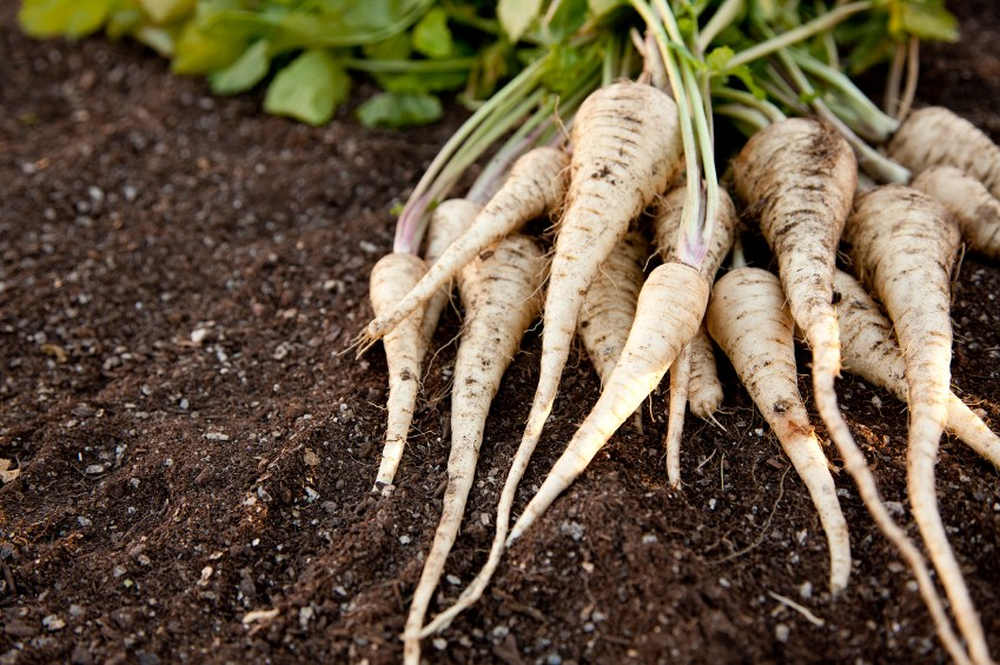
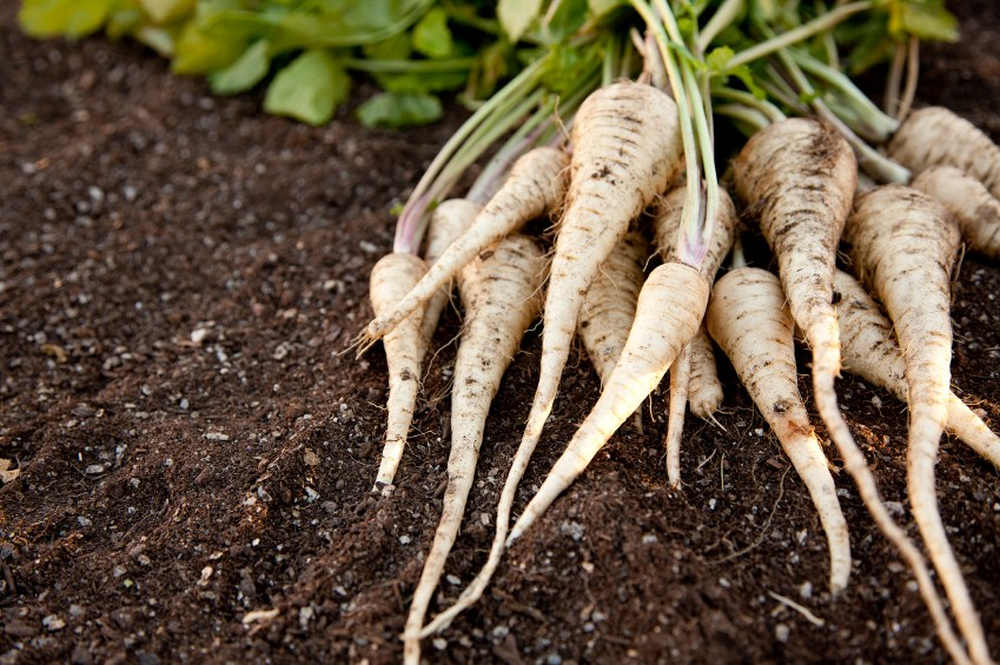 Early this month I will be sowing my parsnips outside in the veg patch. Unlike carrots, they are relatively easy to grow (once you have persuaded them to germinate), and since they store well in the soil over the winter they are a valuable winter storage crop.
Early this month I will be sowing my parsnips outside in the veg patch. Unlike carrots, they are relatively easy to grow (once you have persuaded them to germinate), and since they store well in the soil over the winter they are a valuable winter storage crop.
I grow around 40 parsnips which is more than enough to keep us happy between around November (when we start hankering for root crops) and next March. To do this I need to allocate around 2m of growing space (in a standard bed you will get three rows of parsnips).
Though I practice mainly a no-dig type of growing I always put a bit of work in to the root crop bed (where carrots and parsnips will be sown) – I start by turning over the soil with a fork (to a depth of a foot) which I think is the key to a decent crop since the roots can descend in to the soil happily, with no obstructions such as hard soil or stones to thwart their growth. I then rake the soil well to even it off before sowing and break up and large clods of soil.
Most parsnip seed packets will tell you to sow them in February - don't do it. Far better to leave it until around now when germination will be more reliable thanks to warmer weather. To sow, make a drill 2cm deep – if soil is dry, dampen. Sow one seed every 5cm in rows 30cm apart and cover in with soil. Germination takes up to three weeks. When seedlings appear, thin to 10cm apart for medium sized parsnips.
Once you have sown them, there is very little maintenance needed. Weed carefully until well established and watering shouldn’t be necessary except in dry spells. Parsnips are ready to rock when the foliage starts to die away in autumn but flavour improves after first frosts. Lift them out of the soil carefully with a fork. Leave in soil until ready to eat but lift by March.
Watch a short GIY video tutorial on parsnips here: www.giyinternational.org/videos/detail/parsnips
Sowing Guide for May
I think May is often the busiest of all months in the veg patch. There’s just as much sowing to be done as there was in April, but on top of that, seeds sown in the last few months are now starting to demand more effort (hardening off, planting out etc). May is also a great catch up month, when you can still sow veg you might have forgotten about in April such as spuds and onions etc. Here’s the sowing plan for the month:
Outside direct in soil: Parsnips and peas (early May) and carrots (in late May).
Inside in module trays or pots for later transplanting: Squash, pumpkin, courgette, cucumber, leeks, cauliflower, kohlrabi, Brussels sprouts, French beans, runner beans, Florence fennel, beetroot, celery, swede.
Also this month do your regular monthly sowing of: Salad leaves, oriental greens, calabrese and annual spinach.
Recipe of the Month – Broad Bean and Dill Pilaf
If you sowed overwintering broad beans last October or November, you might well be celebrating your first broad beans of the year in the coming weeks. Serves 4.
Ingredients:
• 300g basmati rice
• 50g butter, plus extra to serve
• 1 onion, finely chopped
• 1 garlic clove, crushed
• 500ml vegetable stock
• 400g podded and skinned broad beans (about 1.6kg unpodded)
• handful dill, chopped
Directions:
Rinse the rice until the water runs clear, then soak in warm water for 5 mins and drain well. Heat the butter in a saucepan and add the onion and garlic. Sizzle everything for 8-10 mins until softened, but not coloured. Stir though the rice and pour over the stock. Cover, bring to the boil, then turn down heat to a minimum and cook the rice very slowly for 10 mins. Lift the lid, and quickly scatter over the podded beans, then replace the lid. Turn up the heat and simmer for 5 mins until all the liquid is absorbed. Add the dill, give the rice a good stir and serve with extra butter melting through.
Things to Do This Week – Pot up Courgettes
This time of the year is all about managing the timing of when you plant seedlings out in the garden. Do it too early and the plants could be knocked back. Do it too late and the plants become ‘pot-bound’ – that is, they have grown too large for their container resulting in tangling of the roots.
I grow courgettes, pumpkins and squash seeds in module trays and if I am in any way suspicious of the weather I pot them on in to bigger pots rather than planting them out in to the soil - by potting plants in to bigger pots, you buy yourself a couple of extra weeks where you can keep them in doors and get them good and sturdy.
Simply pop the seedling out of it’s module, put a little compost in the base of a bigger pot, place the seedling in carefully and then fill it in with compost. It pays to water the plants very well about an hour before hand – the seedlings pop out of the pots much easier then – and of course you need to water again after you have finished potting them on.
Join GIY
By joining GIY you help us to continue the work of supporting people just like you to grow food at home, at school, in the workplace and in the community – each year we support over 65,000 people and 1,500 community food growing groups and projects. It costs just €35 to join GIY for a year, and to say thanks we will send you a seasonal copy of our supporter’s magazine GROW and some GIY seeds for you to sow each quarter. We will also send you our weekly tips, news and advice ezine and offer you discounts to GIY events like the annual GROW Fest. Join today at www.giyireland.com.
 About GIY
About GIY
GIY is a not-for-profit organisation that aims to create a healthier, more sustainable world where people grow their own food. We inspire and support people to grow food more successfully by bringing them together to share advice, tips and ideas. There are approximately 65,000 people involved in the GIY movement in Ireland, which is proudly supported by Woodies DIY.
For more information check out www.giyireland.com
Michael Kelly is a freelance journalist, author and founder of GIY Ireland.
© GIY Ireland 2016 – all rights reserved.
Grow it Yourself - June
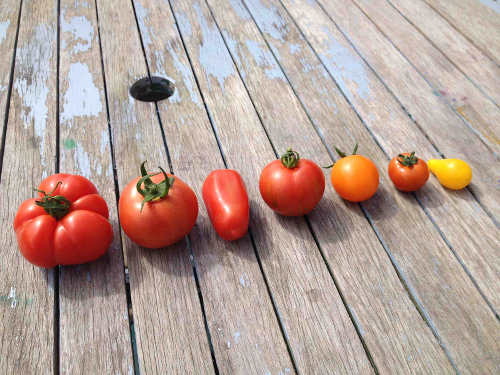

Tomatoes can be difficult to grow well, but I think a proper watering regime is one of the keys to an abundant crop. The secret to watering tomatoes properly is that you need to water ‘deep’. A healthy tomato plant is a thirsty beast, supported by a deep root system - so in other words, there’s no point in standing there with the hose and spraying the plant or the soil around it with water.
You need to get water right down where it’s needed at the roots. The more extensive the root system, the healthier and more productive the plant will be. There’s an added benefit to a deep watering system, in that by keeping water away from the plant itself, you minimize the chance of scorch on the leaves and avoid creating the wet conditions that could attract blight.
A few years ago I happened across a handy method of deep-watering tomatoes, which involves up-cycling used 2L milk cartons. Use a scissors to cut the base off the carton and then bury the carton, upside down, in the soil beside the plant. You can angle it slightly so that it’s ‘aiming’ at the plant and bury it deep enough so that only an inch or so of the carton is visible above the soil.
I generally do this when planting the tomatoes out in the polytunnel around May (so as not to disturb the plant’s roots later on). Since I have 24 tomato plants in the tunnel, it means stocking up on empty milk cartons a few months in advance.
I also drop some gravel or small stones in to the bottom of the carton so that the water is slower to seep down in to the soil (otherwise it can run through the carton so quickly that it’s hard to tell how much water you’ve put in). As an aside, the cut base of the carton makes a perfect beer trap for slugs.
I water the plants early in the morning (every 2 days usually), using a lance (so there’s no stooping), simply walking up and down the polytunnel and filling each carton. I don’t have any hard science to back this assertion up, but I reckon giving each plant 2L of water regularly is the perfect amount to keep them vigorous and productive.
Things to do this Month - June
To-Do
Watering and weeding duties step up a notch – the tunnel/greenhouse in particular will require a good deal of water from now on. Watch the weather and water outside as required. Continue to earth-up potato plants to prevent the spuds becoming green. Mulch and water tomato plants and continue to remove side shoots that appear in the leaf axils. Stake everything that grows tall – raspberries, peas, beans, tomatoes etc. Net soft fruit against birds – it’s worth the effort.
Sow
Sow courgettes, pumpkins, summer and winter squash, fennel, chicory. Succession sow: beans (French and Runner), kale, pea, spinach, spinach beet, summer broccoli, carrot, swede, leek, lettuce, Brussels sprouts, beetroot, chicory, endive, turnip, kohlrabi, fennel. Plant out leeks, Brussels Sprouts, cabbage, autumn cauliflower, calabrese, sprouting broccoli, celery, celeriac, cucumbers, pumpkin, marrows, runner beans, aubergine.
Harvest
We are now really starting to see some payback from our GIYing - the first broad beans and peas as well as new potatoes, new carrots, soft fruit like gooseberries, cherries and strawberries. Herbs are in full flow. Also harvest kohlrabi, cabbage, cauliflower (month end), spinach, spring onion, shallots, salad leaves, elderflower, rhubarb, salad leaves, onions, carrots, beetroot, garlic, sea-kale.
Recipe of the Month – Barley, Strawberry and Spinach Salad
I am a huge fan of barley, which I think is a healthy, crunchy, cheaper and generally more local alternative to the likes of quinoa and cous cous. This salad shouldn’t work on the face of it – strawberries and celery? But the dressing brings it all together. You could leave out the goats cheese if you want to keep it dairy-free. The dressing recipe is my go-to dressing for all sorts of salads – it’s simple to slap it together, so I often make twice the recipe to have it in the cupboard.
Ingredients:
For the salad:
• 200g or 1 cup of pearl barley
• Large handful baby spinach, roughly chopped
• 1 celery stalk, finely chopped
• 1 red onion, finely chopped
• Approx 8-10 strawberries, washed and sliced
• 100g soft goat cheese, crumbled
• 50g walnuts, crumbled
For the dressing:
• 60ml extra virgin Olive Oil
• 45ml balsamic vinegar
• 2 tbsp honey
• 1 tsp grainy mustard
• 1/4 tsp ground black pepper
Directions:
Put the barley in a saucepan, cover with water and cook for 30 minutes or until tender. Then drain well and transfer to a large salad bowl. Set aside to cool completely. Then add all the dry ingredients - spinach, celery, onion, strawberries, goat cheese and walnuts - and toss gently. Make the vinaigrette – combine all the ingredients in a jam jar, pop on the lid and shake well. Pour it over the salad and gently toss. Serve immediately.
Tip of the Month – Tomato Watering Tips
Watering tomatoes is all about balance. Under-water and you can end up with weak plants and a poor crop. Over-water and you can end up diluting the lovely sugars in the tomatoes which give them their wonderful sweetness. Water irregularly and you can end up with split fruit.
As a general rule, water only when your plants need it. Don’t get freaked out if your plants look a little wilted on a hot summer afternoon in the polytunnel or greenhouse – it’s quite normal and they generally perk up again overnight. If they look wilted in the morning however, they probably need watering straight away.
In the early stages of growth, I water every two days to encourage the root system to develop. Later on in the summer when the plants are producing fruit, I will only water every three to four days.
Because of the deep watering mentioned above, the surface of the soil looks quite dry, but that’s fine – there’s plenty of water underneath for the plant to survive between watering. Deep watering also prevents waste and cuts down on the amount of water lost to evaporation in a hot polytunnel. Watering early in the day also helps.
Join GIY
By joining GIY you help us to continue the work of supporting people just like you to grow food at home, at school, in the workplace and in the community – each year we support over 65,000 people and 1,500 community food growing groups and projects. It costs just €35 to join GIY for a year, and to say thanks we will send you a seasonal copy of our supporter’s magazine GROW and some GIY seeds for you to sow each quarter. We will also send you our weekly tips, news and advice ezine and offer you discounts to GIY events like the annual GROW Fest. Join today at www.giyireland.com.
 About GIY
About GIY
GIY is a not-for-profit organisation that aims to create a healthier, more sustainable world where people grow their own food. We inspire and support people to grow food more successfully by bringing them together to share advice, tips and ideas. There are approximately 65,000 people involved in the GIY movement in Ireland, which is proudly supported by Woodies DIY.
For more information check out www.giyireland.com
Michael Kelly is a freelance journalist, author and founder of GIY Ireland.
© GIY Ireland 2016 – all rights reserved.
Grow It Yourself - August
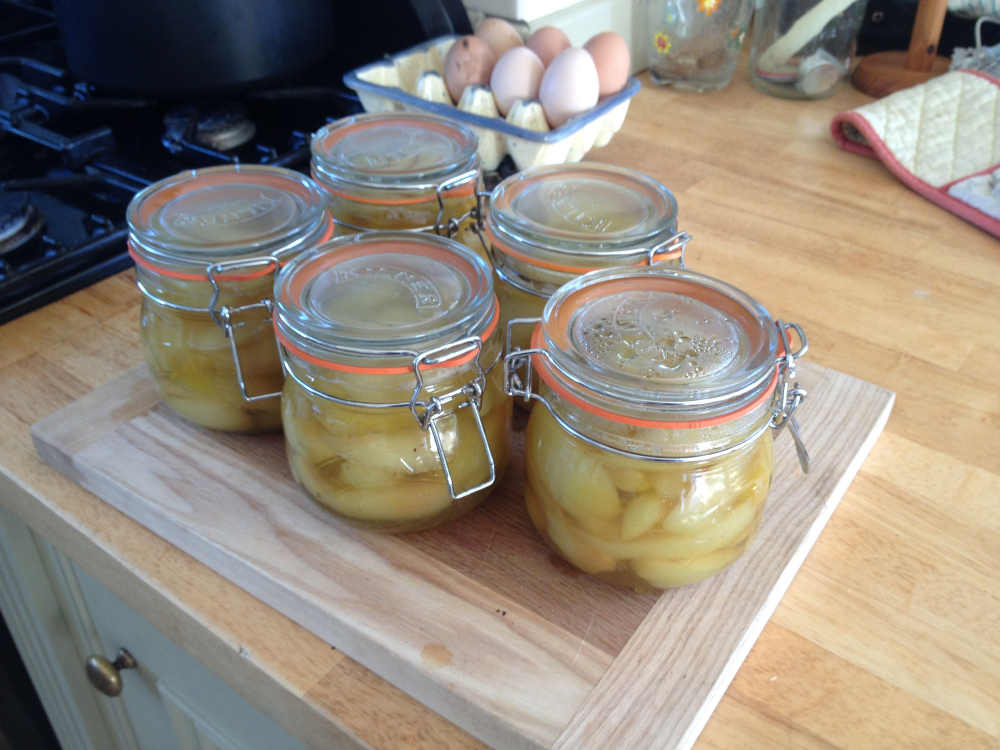
 Successful food growing is as much about time spent in the kitchen as in the veg patch and at this time of the year that point is usually in sharp focus.
Successful food growing is as much about time spent in the kitchen as in the veg patch and at this time of the year that point is usually in sharp focus.
The garden is at its most productive and you’re unlikely to be able to use all of its bounty straight away. So, storing the produce, or finding some way of processing it, is as important as growing the food in the first place.
Sometimes, processing jobs can be mercifully straightforward – for example, a crop of garlic can be turned in to a garlic braid that will hang happily in the kitchen for about 5 months in about 15 minutes. Squashes and pumpkins make their way from the veg patch to the top of the dresser in the kitchen where thanks to their thick skins they will store until next spring.
A colander-full of French beans just needs a dunk in some boiling water to blanch them before you bag them up for the freezer. There are plenty of beans still remaining on the plants to be grazed on as required in the month ahead. But these freezer-bound ones will be particularly appreciated after Christmas when the bean plants are long since composted.
Other processing jobs require more of a time investment. Late summer and autumn weekends generally see me spending entire days in the kitchen surrounded by boiling pans, bubbling pots and chopping boards laden down with vegetables. There are times when I find this somewhat of a chore, but other times when I can get myself in to the right frame of mind.
August means glut territory for tomatoes and there are lots of options to process them. I generally ‘sun-dry’ one batch of the much-coveted sungold variety in a very low oven overnight and then put them in a sterilized kilner jar, covered with olive oil.
Another batch go in a tray in to a hot oven with some garlic, seasoning and rosemary, get cooked for 30 minutes and are then blitzed to turn them in to passata (which will emerge from the freezer later in the year to make a pizza or pasta).
And finally I use 1.5kg of bigger tomatoes to make a big batch of tomato ketchup (see recipe below) which is a great way to make a relatively small amount of delicious tomatoes go a very long way indeed.
I am a glutton for punishment, so this month I am also making: jars of beetroot marmalade (great to accompany meats or in sandwiches); zingy cucumber and onion pickle; and a big batch of gut-friendly kimchi (fermented cabbage, carrot and beetroot).
I could have put the various completed jars straight in to the cupboard, but I left them on the counter for a few days so I could enjoy looking at them for a little while first. It’s hard work, but these are some of the growing year’s most satisfying moments.
Things to do this Month - August
To-Do
Green manures (mustard, buckwheat, radish, rye, alfalfa, clover and vetches) are plants which are grown specifically to improve soil fertility and useful at times when beds are empty (as is often the case in August). Grow directly in the bed and then cut down and dig in to the soil.
Give pumpkins plenty of water and apply a high-potash liquid feed. Nip out the growing points to encourage the fruits to swell. Net brassicas to keep butterflies and the cabbage moth away (and check undersides of leaves regularly for caterpillars). Keep watering - mulch around plants to retain moisture.
Sow
Continue succession sowings of lettuce, oriental greens and other interesting salad bowl leaves. Sow spring cabbage, red cabbage, winter spinach, salad onions (in polytunnel for spring crop), autumn salad mix, endive, parsley.
Harvest
Pick Beetroot regularly as they reach the size you require - if left to grow too large they will loose their tenderness. They can be stored in sand. Continue to harvest tomatoes, carrots, cabbage, cauliflower, peas, broad beans, french and runner beans, salad leaves, radish, turnip, potato, onions, peppers and chilli-peppers, aubergine, globe artichoke, courgettes, cucumber, gooseberries, raspberries and currants.
Recipe of the Month – Tomato Ketchup
Rory O’Connell has been a great friend to GIY over the years, and some of his wonderful recipes appear in our book GROW COOK EAT. This is his recipe for Tomato Ketchup – it’s absolutely delicious and far healthier than the shop bought equivalent. Makes 6 x 225ml bottles.
Ingredients:
• 1.6kg tomatoes, peeled and chopped
• 450g eating apples, peeled, cored and chopped (weigh after peeling and coring)
• 450g onions, chopped
• 600g sugar
• 450ml cider vinegar
• 1 level tablespoon sea salt
• 1/4 teaspoon cayenne
• 6 black peppercorns
• 6 allspice/ pimento berries
• 6 cloves
Directions:
Place all the ingredients in a stainless-steel saucepan. Bring to a boil and summer for about 1 hour, stirring regularly to avoid sticking, until it has the consistency of ketchup. Leave to cool for 4-5 minutes, then blend to a smooth puree. If the consistency is a bit thin, return to the saucepan and cook to reduce further. Remember: it will thicken as it cools. Pour into sterilized glass bottles and store in a cool, dry place, for 3 months or more.
Things to do this Month – How to Harvest Sunflower Seeds
If you grew sunflowers this year, you will most likely have been enjoying the beauty of the flowers in the last few weeks. Don’t forget they also now provide a wonderful, protein-rich food bounty – the flowers are hiding hundreds of sunflower seeds which you can harvest and store to sprinkle on your porridge.
The key to successful harvesting of the seeds is to get the flower head dry – this can be done outside (if the weather’s fine and sunny) or else by removing the head and drying it indoors.
Wait until about half the yellow petals have dropped and the flower is wilting. Have a look at the seeds – you will see them lurking in behind the black florets. Remove the head leaving 30cm of stem attached to the head. Tie a paper bag over the head, and fasten it loosely with some string or twine. Don’t use plastic – you want air to be able to circulate inside the bag. Hang the head upside down indoors somewhere dry and sunny for about a week. I hang them in the greenhouse. The bag captures any seeds that fall off. The seeds should come away easily when dry, simply by rubbing them. Wash the seeds, then dry them well and store in an airtight container. If you can, be generous, and leave some of the sunflowers in situ for birds and other wildlife to share the spoils.
Join GIY
By joining GIY you help us to continue the work of supporting people just like you to grow food at home, at school, in the workplace and in the community – each year we support over 65,000 people and 1,500 community food growing groups and projects. It costs just €35 to join GIY for a year, and to say thanks we will send you a seasonal copy of our supporter’s magazine GROW and some GIY seeds for you to sow each quarter. We will also send you our weekly tips, news and advice ezine and offer you discounts to GIY events like the annual GROW Fest. Join today at www.giyireland.com.
 About GIY
About GIY
GIY is a not-for-profit organisation that aims to create a healthier, more sustainable world where people grow their own food. We inspire and support people to grow food more successfully by bringing them together to share advice, tips and ideas. There are approximately 65,000 people involved in the GIY movement in Ireland, which is proudly supported by Woodies DIY.
For more information check out www.giyireland.com
Michael Kelly is a freelance journalist, author and founder of GIY Ireland.
© GIY Ireland 2016 – all rights reserved.
Grow It Yourself - September

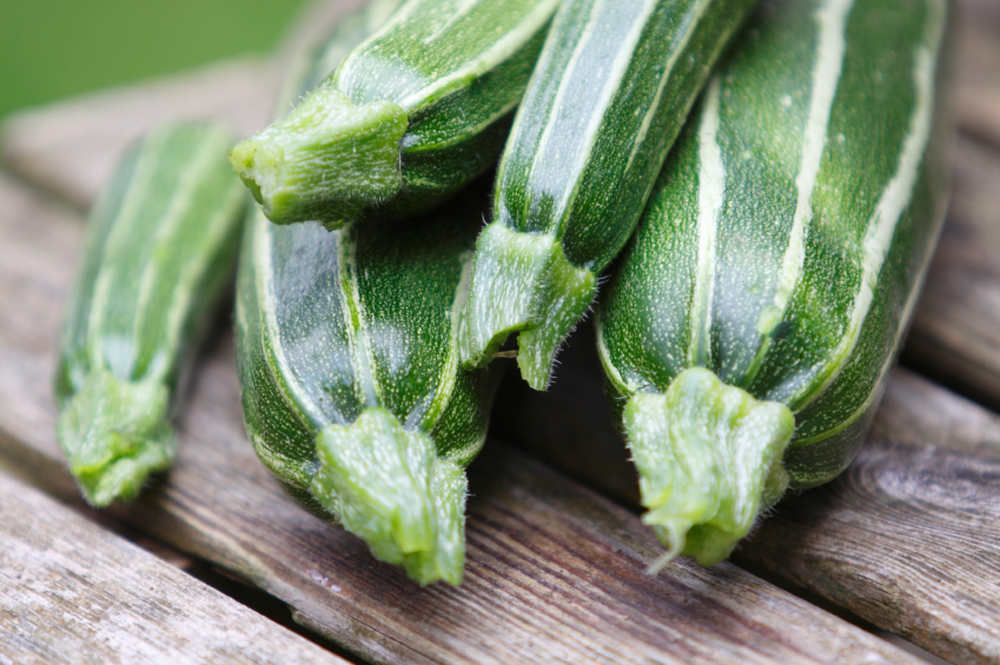
I own more cookbooks than is sensible, and though I can sometimes be accused of being a little slow on the uptake, I’ve spotted a trend in them of late – yes my fellow laggards, I bring you astonishing news: to an increasingly large number of our fellow citizens, carbs are bad. But fear not - if you’re finding the idea of going gluten-free a bitter pill to swallow, there are a slew of gorgeous food writers to help you on the journey. The message is clear – buy their cookbook, cut the gluten and you too could look like them.
Yeah, so you might have guessed - I don’t buy in to the whole ‘carbs are bad’ thing. I think it’s a dangerous generalization that lumps heavily refined, low nutrient carbs like white bread in with nutrient-rich, unprocessed, vitamin-replete carbs like potatoes.
It’s a blunt instrument that fails to differentiate between the joys of a good quality sourdough bread and a processed sliced pan that takes a month to go off. It’s undeniably true to say that our diets contain too much wheat and we should eat more wholefoods but we should also mistrust any diet that relegates an entire food group to pariah status.
That said, there’s plenty to like in new books from the likes of Lily Simpson, Ella Woodward and the Hemsley sisters Melissa & Jasmine, particularly if you’re a fan of putting veg centre stage and want to eat less refined foods.
So instead of spaghetti with your Bolognese why not try courgetti (spiralized courgettes) instead? Or swap out noodles for spiralized cucumbers, or even (whisper it) blitz a head of cauliflower to use instead of rice.
Yep, it’s time to add one more piece of kitchen equipment to your arsenal – a spiralizer. It’s a nifty and relatively inexpensive little machine that turns fruit and vegetables in to noodle/pasta shaped lengths. Mrs Kelly and I have recently taken delivery of a spiralizer but not because we feel particularly guilty about eating pasta, or because we’ve gone gluten free (we haven’t).
Instead it’s because the spiralizer is a brilliant way to eat veg raw, make it look prettier or just a little more interesting. It also helps us make light work of two of the most glut-prone vegetables that can be a struggle to keep up with – courgettes and cucumbers.
We’ve tried all the recipes you could imagine to deal with courgettes – throwing them in to stews, soups, breads, cakes and more – hell even throwing them at the neighbours. None of these are as quick or delicious as converting them in to courgetti. If you have trouble getting your kids to eat vegetables, they might well be more inclined to eat them if they’ve been involved in the fun of spiralizing them.
Incidentally, I don’t think one would ever necessarily confuse courgetti with actual spaghetti but that’s hardly the point. It’s delicious in it’s own right.
Recipe of the Month – Panzanella
This is my version of the classic Italian peasant’s lunch of stale bread and tomatoes. Though purists might sniff at the presence of courgettes, I think it works well if sliced very finely. Because the tomato crop was slow this year, I used 300ml of passata to soak the bread instead of fresh tomatoes, but if you have a glut of tomatoes you could of course use them instead (rubbed through a sieve). All in all, it’s not too shabby being a peasant. Serves 4.
Ingredients:
• 300ml organic passata
• 300g slightly stale sourdough bread
• 1 small cucumber, peeled, deseeded and chopped
• 1 small yellow courgette, thinly sliced
• 1 small red onion, halfed and thinly sliced
• 200g red or green pepper, de-seeded and sliced
• 20 black olives
• Handful basil leaves, chopped roughly
• 10-15 cherry tomatoes, halved
• 4 tbs olive oil
• 2 tbs apple cider vinegar
• 1 tbs capers
Directions:
Tear the bread in to large chunks and put it in a large bowl. In a separate bowl mix the passata, olive oil, vinegar and season well. Add it to the bread bowl, stirring well to mix it all together. Add the olives, capers, courgette, cucumber, onion, tomatoes and basil. Toss it all together again. Leave it to stand for half an hour to let all the flavours mingle.
Join GIY
By joining GIY you help us to continue the work of supporting people just like you to grow food at home, at school, in the workplace and in the community – each year we support over 65,000 people and 1,500 community food growing groups and projects. It costs just €35 to join GIY for a year, and to say thanks we will send you a seasonal copy of our supporter’s magazine GROW and some GIY seeds for you to sow each quarter. We will also send you our weekly tips, news and advice ezine and offer you discounts to GIY events like the annual GROW Fest. Join today at www.giyireland.com.
 About GIY
About GIY
GIY is a not-for-profit organisation that aims to create a healthier, more sustainable world where people grow their own food. We inspire and support people to grow food more successfully by bringing them together to share advice, tips and ideas. There are approximately 65,000 people involved in the GIY movement in Ireland, which is proudly supported by Woodies DIY.
For more information check out www.giyireland.com
Michael Kelly is a freelance journalist, author and founder of GIY Ireland.
© GIY Ireland 2016 – all rights reserved.
Grow It Yourself - October
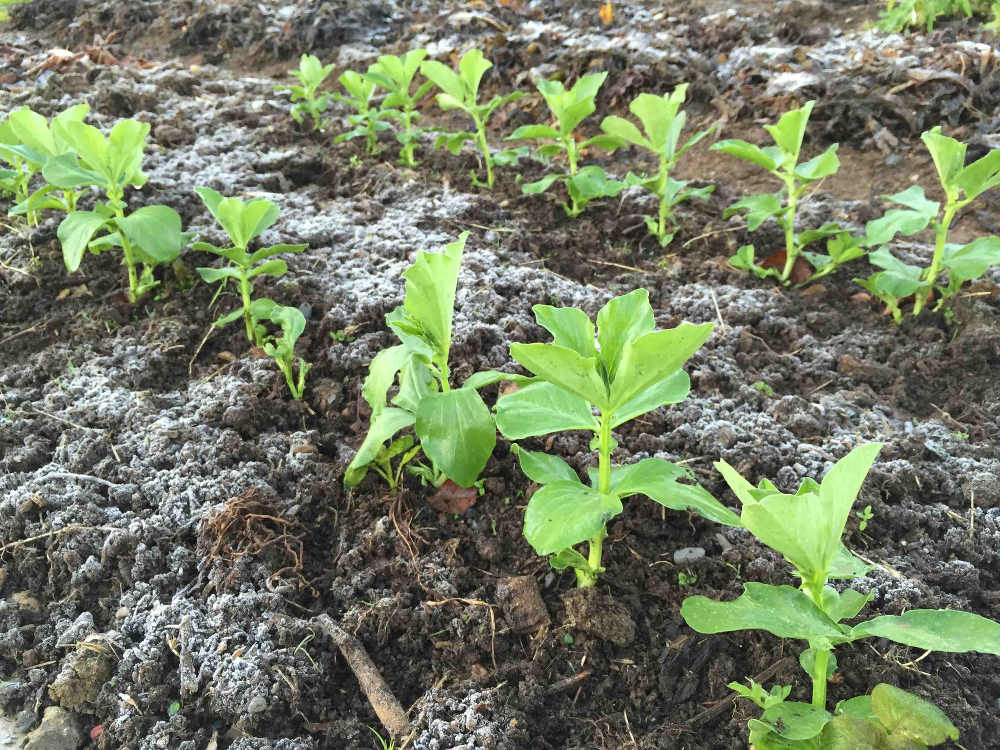

It really is hard to believe that it’s already October, and the year is winding down inexorably towards Halloween and that other mid-winter festival that will remain unmentioned. Thankfully there’s still some sowing activity to do this month that helps us to hang on to this year’s growing for a little longer.
The way I see it, sowing activities at this time of the year have a number of benefits. First of all, over-wintering varieties of vegetables will be ready to eat earlier than their spring-sown equivalents. Secondly it makes the task of seed sowing that little easier in the spring because you’ve already completed part of the job. Thirdly I really enjoy seeing some green things growing in the winter vegetable patch, which can other wise feel a little dreary (the picture with this column was taken in the depths of winter last year, with the super hardy broad bean variety Aquadulce Claudia successfully facing down a particularly nasty ground frost). Finally, the contrarian in me loves sowing at this time of the year exactly because it feels counter-intuitive to be doing a ‘spring activity’ at a time of the year when nature is starting to shut down.
This time last year I sowed three different types of vegetables that paid major dividends – garlic, red onions and broad beans. In the case of red onions and broad beans it was the first time I have sown them in the autumn, and they worked out great.
I have found red onions sown in spring are inclined to soften or rot in my wet soil, but the autumn sown ones worked fantastically well. In the case of the broad beans, because of the jump start they get from early sowing, they were ready to eat in May when there was very little else to eat.
Finally it’s worth reiterating that garlic is best sown pre-Christmas, as it needs a prolonged cold spell in the soil for the cloves to split and form big juicy bulbs. With spring-sown garlic you can be lucky and get a long, cold spring or you can be unlucky and get a very mild spring and terribly puny garlic bulbs. Though of course I realise that a mild spring has other attractions!
We’ve a good selection of winter garlic and onions on the GIY shop at www.giyireland.com/shop.
Things to do this Month - October
To Do
Pot up herbs to grow inside over the winter. Continue to lift crops that have finished harvesting and clean up the beds. Sow over-wintering green manures. If you are going to cover empty beds down with manure for the winter, the earlier you do it the better. Try and find a good source of farmyard manure if you don’t have your own – cow, horse, pig, sheep and chicken manure are all great sources of nitrogen, phosphorus and potassium for your soil. Cut autumn fruiting raspberry canes down to the ground.
Sow
You can sow hardy varieties of peas and broad beans later this month for an early spring crop but only do so in well-drained soil. In the polytunnel get a crop of cauliflower and carrots going over the winter. Plant selected varieties of garlic and winter onion sets.
Harvest
Depending on the weather, the harvest may well continue in to October – pumpkins, squashes, courgette, apples, pears etc. It’s the last hurrah however for peas, beans, tomatoes, cucumbers, aubergines, peppers and chilli-peppers. Continue to harvest wild mushrooms, elderberry, blackberries, sloes, carrots, potatoes, parsnips, swedes, celeriac, turnip, beetroot, celery, marrows, leeks and cabbage.
Recipe of the Month – Red Cabbage, Carrot and Beetroot Slaw
I like growing red cabbage because it seems relatively impervious to some of the beasties that make growing other cabbages a complete nightmare. I must say however that we often find it difficult to do it justice in the kitchen and don’t find it as versatile as green or white cabbages.
This coleslaw is great though and I like to think the abundance of raw veg in it can offset the use of lots of mayonaise. I have tried to do a more virtuous mayo-free version with mustard and vinegar but it didn’t work so well in my view. This will keep in the fridge for 3-4 days.
Ingredients
• ½ a red cabbage, outer leaves removed and very thinly sliced
• 1 large carrot, peeled and grated
• 2 small beetroot, peeled and grated
• 1 clove garlic, finely chopped
• 3-4 sprigs fresh parsely, finely chopped
• 3-4 tablespoons mayonaise
Directions
Combine all the vegetables and the parsley in a bowl and mix well. Season really well with sea salt and black pepper. Stir in the mayonnaise and sprinkle some more parsley on top. Serve immediately.
Tip of the Month – Keep Sowing
Think the growing year is over???
1. BROAD BEANS - autumn sown broad beans are ready a good month before spring-sown and they don't get black fly. Try variety Aquadulce or Supersimonia.
2. PEAS - Ditto for autumn sown peas - try variety Meteor.
3. SUGARSNAP PEAS - you might be able to get early varieties of sugarsnaps such as Snow Pea Gigante Svizzero - growth will be slow but you will get small pods early next year.
4. GARLIC - plant cloves one inch below the surface.
5. ONIONS - Autumn sown onions will be harvested earlier than spring-sown.
6. SPRING ONIONS - Sow some spring onions too - White Lisbon is a good option..
7. SPRING CABBAGE - if you can get your hands on some cabbage plants from your local garden centre, plant them 12 inches apart and earth up the soil around the base of the stem.
8. WINTER LETTUCE - you can still sow some really hardy varieties of winter lettuce - cover with fleece in cold weather. Try Winter Gem.
9. LAMBS LETTUCE - easy to grow and undemanding. It's not the greatest taste but will bulk out the salad bowl in lean winter months.
10. SPINACH - the beauty of sowing spinach at this time of the year is that it won't bolt (which is the great blight of growing spinach earlier in the year). Young leaves are great for salads.
Join GIY
By joining GIY you help us to continue the work of supporting people just like you to grow food at home, at school, in the workplace and in the community – each year we support over 65,000 people and 1,500 community food growing groups and projects. It costs just €35 to join GIY for a year, and to say thanks we will send you a seasonal copy of our supporter’s magazine GROW and some GIY seeds for you to sow each quarter. We will also send you our weekly tips, news and advice ezine and offer you discounts to GIY events like the annual GROW Fest. Join today at www.giyireland.com.
 About GIY
About GIY
GIY is a not-for-profit organisation that aims to create a healthier, more sustainable world where people grow their own food. We inspire and support people to grow food more successfully by bringing them together to share advice, tips and ideas. There are approximately 65,000 people involved in the GIY movement in Ireland, which is proudly supported by Woodies DIY.
For more information check out www.giyireland.com
Michael Kelly is a freelance journalist, author and founder of GIY Ireland.
© GIY Ireland 2016 – all rights reserved.
Grow It Yourself - November
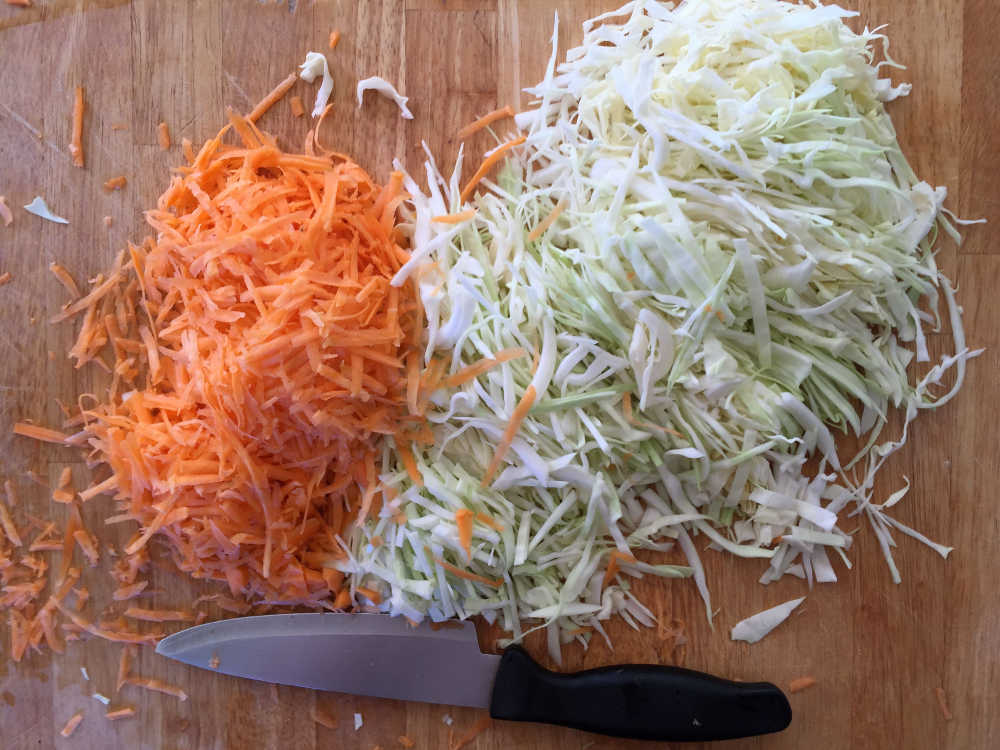

We have a pretty fixed view of what makes up the human body – cells, blood, tissues, bone and so on. But, did you know that inside your gut you carry around a whopping 2kg of microbes, which consists of over 1,000 different species of bacteria that outnumber our cells 10 to 1?
Most of us are aware that these bacteria play a hugely important role in the digestion process (breaking down food, absorbing nutrients etc), but science is increasingly viewing the microbiome as a new, unexplored and possibly intelligent organ in its own right.
Scientists are now asking: what’s the connection between the health of our microbiome and our overall health? What role does the microbiome play in mood, depression, diabetes, autism, autoimmune disease, inflammation, food allergies and cancer?
Though it’s an emerging field, scientists seem to agree that a diversity of gut bacteria is good for our health and that (not surprisingly) what we put in to our bodies has a huge impact on our microbiome.
Diets high in processed foods are thought to have a huge impact on our gut micro-organism levels. Dietary sugar and fat encourages bad bacteria and reduces the level of the virtuous ones.
Excessive antibiotic use is also a concern – a study co-led by researchers at the Universitat de València found that antibiotic treatment causes significant and sometimes irreversible changes in our gut community. Specifically, the study found that the gut microbiome shows less capacity to absorb iron and digest certain foods during antibiotic treatment.
There are major health claims being made about fermented foods in relation to gut heath, some of which we should probably treat with caution. They are purported to improve intestinal tract health, enhance the immune system, improve absorption of nutrients and reduce the risk of certain cancers. Scientists agree that the bacteria in fermented foods help to pre-digest food components, making it easier for your gut to handle and for nutrients to be absorbed.
When I first started fermenting food at home, I was more interested in how they could help me to ‘store’ food than I was in their potential health benefits. Kimchi and sauerkraut for example are centuries-old methods (in Korea and Germany respectively) of preserving cabbage. From a culinary perspective I think kimchi is the more exciting of the two.
In Korea there are thought to be literally thousands of kimchi recipes and it was traditionally stored in clay pots buried underground to keep them cool and slow the fermentation process. My version below adds carrot, beetroot and shallots as well as the traditional garlic, ginger and chilli-pepper to give it a kick.
I have got in to the habit of eating a small bowl of kimchi each evening before dinner (or sometimes as a side dish). Potential gut health benefits aside, it’s a delicious way to deal with a glut of homegrown veg.
Read more about the microbiome and health here
GROW HQ
The home of the GIY movement and our brand new national food education centre, GROW HQ, is finally open in Waterford city. In addition to our 65-seat home-grown food café and shop, we’ve a range of growing and cooking courses happening weekly – for courses happening this month, check out www.growhq.org.
Things to do this Month – November
To Do
Do not leave beds bare for the winter – sow a green manure, or cover with a thick layer of manure/compost and then black plastic or straw. This will return nutrients to the soil, keep the worst of the weather off it, suppress weeds and prevent leaching of nutrients. ‘Earth up’ or tie up vegetables such as cabbage, cauliflower and Brussels sprouts. Divide up your rhubarb if you want to propagate, and cover it with a thick mulch of manure. Prune apple trees. Mulch fruit bushes. Take cuttings of currant bushes from current season’s wood.
Sow
Sow broad beans outside now for an early crop next spring. To avoid rotting before germination, make small newspaper cups and germinate them indoors first. Next summer’s garlic does best if it’s planted before Christmas – plant outdoors in well prepared soil in a sunny spot. Though I have to admit I never bother with them, some varieties of onion can over-winter and will be ready to harvest in early summer.
Harvest
Continue to harvest perpetual spinach, cabbage, cauliflower, potatoes, swede, parsnips, apples, pears. Start harvesting leeks, winter cabbage, kale, artichokes, Brussels sprouts. Time to lift carrots and turnips or at least cover them with a good layer of straw to protect them from frost damage.
Recipe of the Month – Kimchi
Though it’s traditional to have coarsely grated cabbage in kimchi, I like the veg to be finely grated. This recipe produces enough for two large kilner jars, but a lot will depend on the size of the head of cabbage!
Ingredients
• 1 Medium head white cabbage, grated
• 2 medium carrots, grated
• 1 small beetroot, peeled and grated
• 3 shallots , chopped
• 2 red chillis deseeded and finely chopped
• Thumb-sized piece ginger, chopped
• 2 tbs fish sauce
• 750ml water and 3 tbs sea salt
Directions
Make the brine by adding the salt to the water and stirring. Put the cabbage, beetroot and carrot in a large bowl and add the brine. Put a plate on top to keep the veg submerged and leave 3-4 hours or overnight.
Drain the veg the next morning, retaining the brine. Put the shallots, chillis, ginger and fish sauce and blitz with a hand-blender until it’s like a paste. Pour over the veg and mix really well to ensure all the veg is coated in the paste.
Put the veg mix in to sterilised kilner jars and pour the brine over so it’s covering the veg. Cover and leave to stand at room temperature for 3-5 days. It will start to bubble and ferment.
Then pop it in the fridge where it will continue to ferment (but more slowly).
You can enjoy it straight away and it will keep for about a month (though it never lasts that long in our house).
Tip of the Month – Ventilate
As the cold weather and lower light conditions draw in, it's important to close up the doors of your greenhouse or polytunnel to keep the heat in there as much as possible. However try and give the polytunnel/greenhouse a good airing on fine dry days - open up the doors and let air circulate - this will help to stop disease developing, particularly downy mildew which can be a big issue in the winter months. On days where you do open up the doors make sure to close them again at night to retain whatever heat is in there.
Join GIY
By joining GIY you help us to continue the work of supporting people just like you to grow food at home, at school, in the workplace and in the community – each year we support over 65,000 people and 1,500 community food growing groups and projects. It costs just €35 to join GIY for a year, and to say thanks we will send you a seasonal copy of our supporter’s magazine GROW and some GIY seeds for you to sow each quarter. We will also send you our weekly tips, news and advice ezine and offer you discounts to GIY events like the annual GROW Fest. Join today at www.giyireland.com.
 About GIY
About GIY
GIY is a not-for-profit organisation that aims to create a healthier, more sustainable world where people grow their own food. We inspire and support people to grow food more successfully by bringing them together to share advice, tips and ideas. There are approximately 65,000 people involved in the GIY movement in Ireland, which is proudly supported by Woodies DIY.
For more information check out www.giyireland.com
Michael Kelly is a freelance journalist, author and founder of GIY Ireland.
© GIY Ireland 2016 – all rights reserved.
Grow It Yourself - December
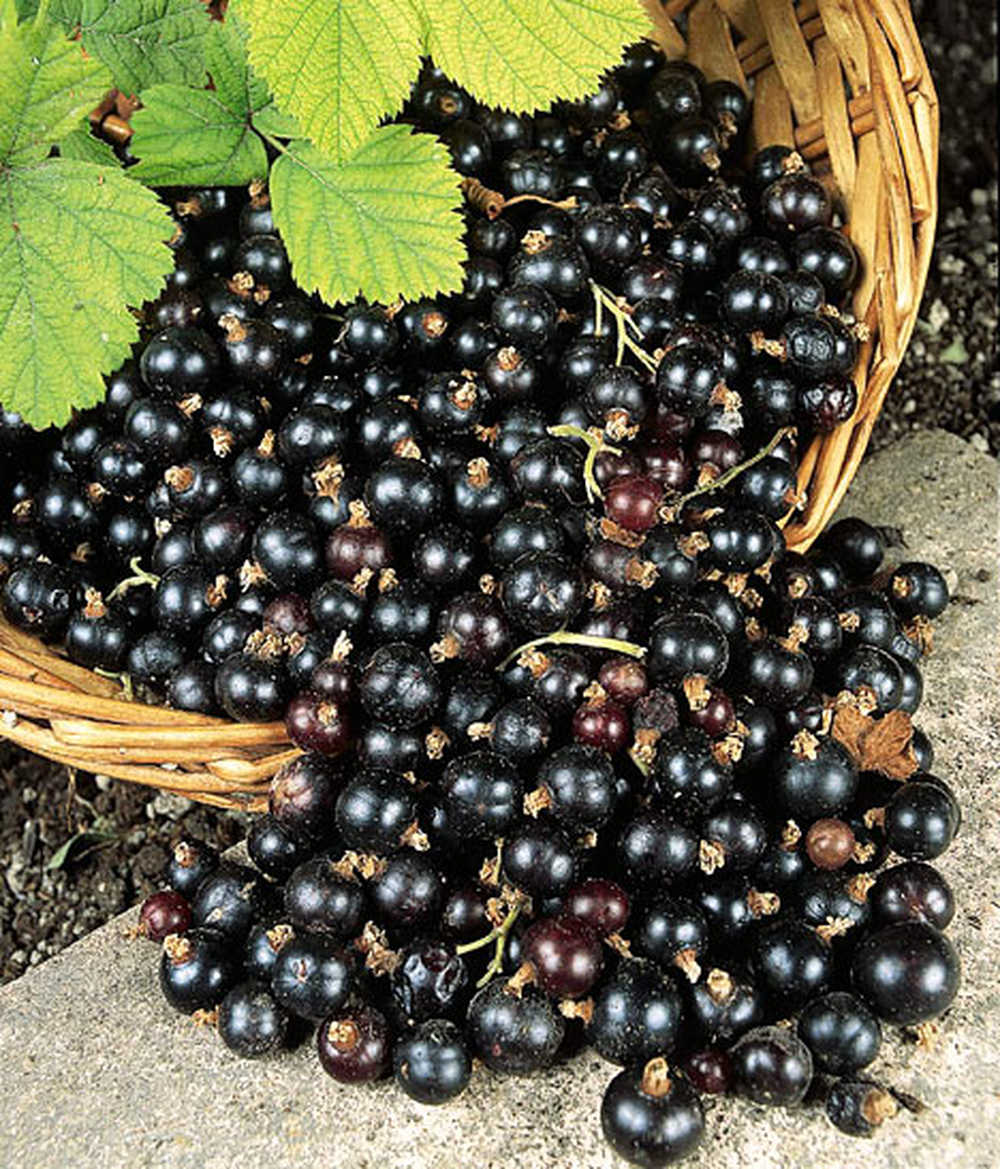
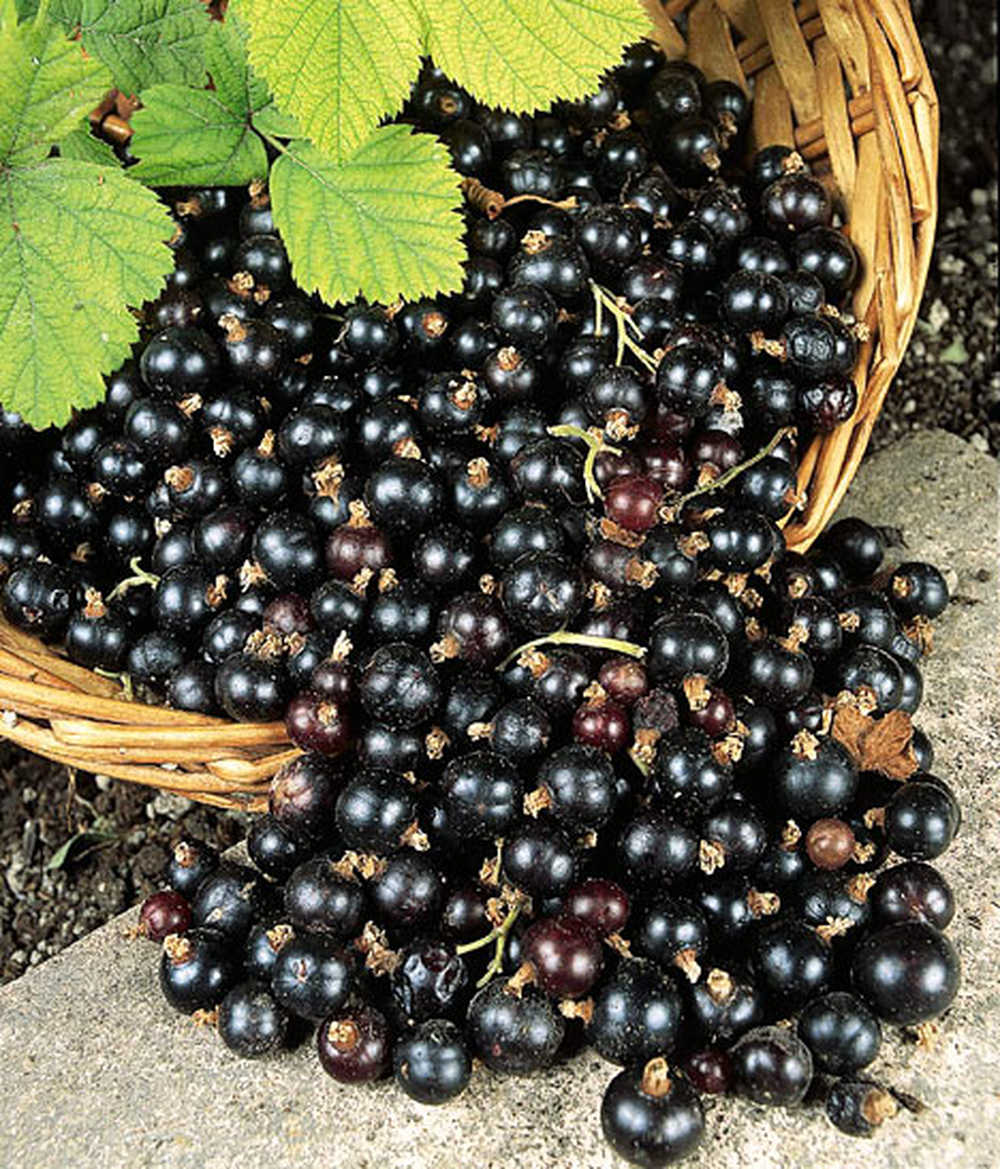
I have two blackcurrant bushes in the garden – they are prolific croppers and don’t get a huge amount of love from me if the truth be known. I always consider them a second-tier crop – not quite as tasty as say raspberries, strawberries or blueberries.
At the same time, we always do our best to bring the crop in and get it in the freezer, because it’s great for jams and ice-creams. At this time of the year we are able to grab handfuls from the freezer at night time and let them thaw out so they can be thrown on porridge in the morning. They are rich in numerous health benefiting phyto-nutrients and anti-oxidants.
If there’s a downside to them, it is that they get enormous and if left un-pruned they will quickly become overcrowded which will lead to poor harvests. Naked stems at this time of the year make it easier to prune, and of course the plant is lying dormant so it’s not knocked back by the pruning.
The basic idea is to create a light airy plant in a bowl shape, but keeping as much of last season’s growth as possible since it is these that will bear most of next year’s fruit. The new season shoots should be relatively easy to identify – they are quite smooth, tea-coloured, and clearly “new” looking. The older shoots will be more gnarled and grey looking. Start by removing congested and weak stems, any diseased branches or those branches that are crossing over.
Then take out some of the older growth that is clearly unproductive – that is, not carrying any new growth. I try to remove about a third of the plant, leaving about 10 strong healthy shoots. You can also give the base a good dressing of compost. The result should be a healthy plant that will pay you back in spades.
Things to Do this Month - December
To Do
As you clear remaining crops from your veggie patch, dig the beds over and add well rotted compost or manure. Get Educated – book yourself on a course! Start planning what you would like to grow next year and work out what crop rotation system you are going to use. Study seed catalogues carefully before deciding on the best varieties to grow. Start a Compost corner or heap. Keep an eye on your stored veggies and discard anything that’s rotting. Collect and store leaves in bags to make leaf mould or use as cover for bare soil.
Sow
If you haven’t already done so plant garlic – it should be in the soil by the shortest day of the year. Bring herbs like mint, chives, lemon balm, parsley, thyme indoors by lifting and potting them up.
Harvest
Buck the seasonal trend by continuing to harvest winter salad leaves like corn salad, land cress and mizuna. You should still have at least some produce left in the December veggie patch e.g. winter cabbages, Brussels sprouts, leeks, kale, Jerusalem artichokes, carrots, celery, turnips, parsnips, winter cauliflowers, swedes, spinach, chard and celeriac. From your stores you can enjoy pumpkins and squashes, potatoes, onions, apples, beetroot and garlic.
Recipe of the Month – Spinach and Ricotta Pie
The ricotta cheese gives this a nice creamy texture. This is a great dish to get spinach in to your diet in a way that doesn’t feel frugal. Serves 4.
Ingredients:
• olive oil
• 1 medium onion , finely chopped
• 2 garlic cloves , peeled and crushed
• 250g young spinach
• 1 egg
• 250g ricotta , drained
• ½ tsp freshly grated nutmeg
• 100g feta cheese
• 4 sheets filo pastry (each roughly 38cm x 30cm)
Directions:
Heat the oil in a large pan and fry the onion and garlic for 10 minutes until soft but not coloured. Add the spinach and cook for 5 minutes, stirring.
Tip into a sieve and press to remove as much excess liquid as possible. Cool.
Beat the egg with the ricotta and nutmeg and season. Stir in the feta with the spinach and onion.
Heat the oven to 200C/fan 180C. Rub a little oil in a 20cm cake tin. Line with the filo sheets, leaving excess pastry overhanging and rubbing each sheet with a little oil.
Spoon the cheese and spinach mixture into the tin. Bring the pastry up and over the top of the pie. Brush generously with oil.
Bake for 25-30 minutes until golden brown and crisp.
Serve warm or cold.
Tip of the Month – Relax..
It would seem harsh of me to suggest that you should be out in the veg patch working this month, when really this is the last time we can really kick back and enjoy a break before the 2017 growing season begins in earnest.
I always marvel at how suddenly the mood changes as the new year arrives at midnight on New Year’s Eve. With the relentless march of the calendar it is no longer “the end of the year” and instead is very suddenly “the beginning of the new year”.
That’s an important emphasis shift for the GIYer, for even though it’s only a few minutes later there is, all of a sudden, a whole lot to do! So, enjoy it while you can.
Put your feet up, pour yourself a glass of something wet, and before the madness begins all over again, comtemplate your successes over the last 12 months.
Join GIY
By joining GIY you help us to continue the work of supporting people just like you to grow food at home, at school, in the workplace and in the community – each year we support over 65,000 people and 1,500 community food growing groups and projects. It costs just €35 to join GIY for a year, and to say thanks we will send you a seasonal copy of our supporter’s magazine GROW and some GIY seeds for you to sow each quarter. We will also send you our weekly tips, news and advice ezine and offer you discounts to GIY events like the annual GROW Fest. Join today at www.giyireland.com.
 About GIY
About GIY
GIY is a not-for-profit organisation that aims to create a healthier, more sustainable world where people grow their own food. We inspire and support people to grow food more successfully by bringing them together to share advice, tips and ideas. There are approximately 65,000 people involved in the GIY movement in Ireland, which is proudly supported by Woodies DIY.
For more information check out www.giyireland.com
Michael Kelly is a freelance journalist, author and founder of GIY Ireland.
© GIY Ireland 2016 – all rights reserved.
Grow It Yourself - February
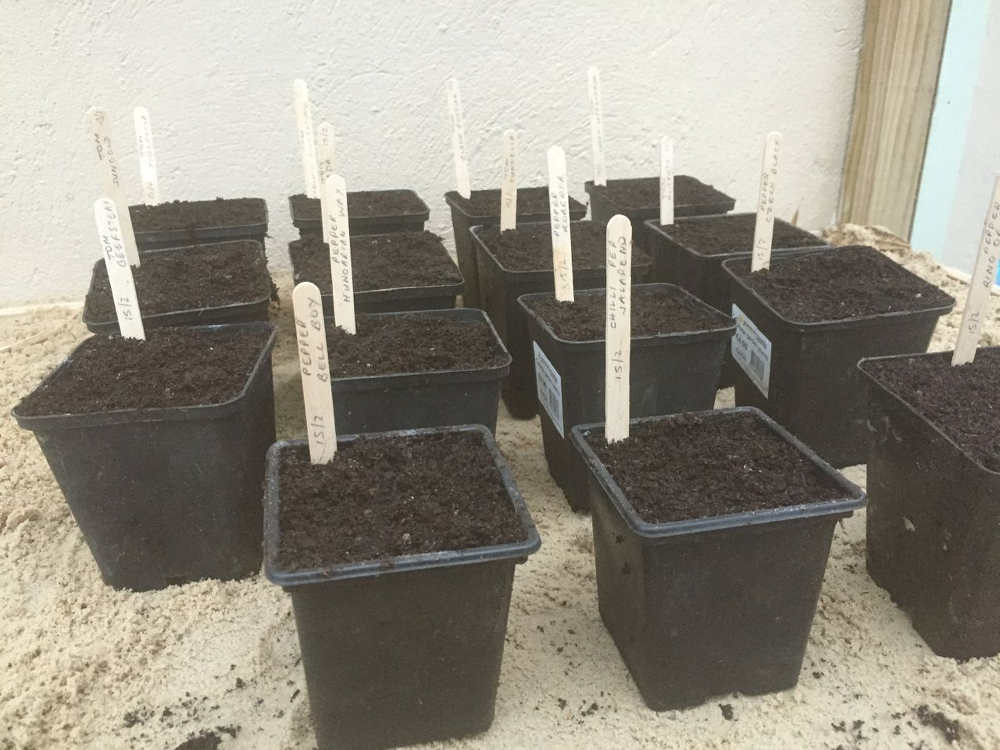

And so it begins. Another season starts with the determined act of seed sowing in the potting shed. A bag of compost opened and tipped out on the sowing bench. Cold black plastic pots filled with even colder blacker compost.
Seed labels lined up awaiting a scrawl of information. Seed packets fished out from my big box of tricks and ripped open to reveal their bounty. It’s just tomatoes, aubergines and peppers today so five tiny little seeds are placed gently on the surface of each pot (one for each variety I will sow and 17 pots in all).
Ah but it feels good to start again in to another season. While I work I try to remember whether it’s my tenth or eleventh season? Then I find myself wondering how many seasons I have ahead of me. Maybe thirty if I am lucky?
I pull myself back from such existential thoughts and try to stay in the moment. I plug in the heated cable to start the process of warming the sand beneath the seed pots. I realize I am whistling.
It feels too cold to be sowing seeds. The calendar says spring (in that strange Irish way that labels February spring) but it’s definitely still winter outside. All day the weather has alternated erratically from sun to cold showers of rain. I have shelter from the elements in here in the potting shed but I can feel my feet are numb in my wellies and the tips of my fingers are cold.
I’ve a hat on my head and several layers of fleece beneath my jacket, and I can see my breath while I work. I would like to luxuriate over this process, particularly today since it’s the first sowing of the year, but it’s too damn cold – so I move quickly. Sow a pot, label it, move on to the next one.
Before I finish I make a cloche over the pots with some rubber pipe and spread a layer of clear plastic over them, tucking the plastic in beneath them. I am creating a little hothouse for these seeds, which need heat to germinate. It feels a little artificial, but my growing year always starts like this – coaxing Mediterranean conditions from a cold February and trying to warm up the world.
Things to Do This Month - February
To Do
Turn over the soil only if the weather is dry – if the soil sticks to your boots it’s too early for digging! Keep off the soil to prevent soil compaction - use timber planks to stand on for access. If you have not already done so order/buy your seeds, spuds and onion sets. “Chit” or sprout seed potatoes – put them in a container (e.g. used egg carton or empty seed tray) and leave them in a bright warm place. Check the pH of your soil – you can buy a soil pH testing kit in any garden centre. Lime your soil now if required (to reduce acidity in very acid soils), particularly important in your brassica bed.
Sow
Finally, we can sow some seeds. On a sunny windowsill indoors, in a heated greenhouse or on a heating mat: sow celery, globe artichokes, celeriac, leeks, onions, lettuce, tomatoes, peas, aubergines, peppers/chilli-peppers. In polytunnel or greenhouse: beetroot, Brussels sprouts, summer and autumn cabbage, carrots, leeks, lettuce, radish. Outside: Weather permitting you can try planting out broadbeans, spinach, kohlrabi, onion and shallot sets, Jerusalem artichokes, parsnip and early pea varieties.
Harvest
Winter cabbage and cauliflowers, Brussels sprouts, spinach, kale and leeks.
Recipe of the Week – Perfect Parmesan Parsnips
Here’s a recipe from our friend Donal Skehan who contributed two lovely recipes to GROW COOK EAT, our new grow/cookbook.
Ingredients:
· 1kg of parsnips.
· 3 tablespoons of wholemeal flour.
· 1 tablespoon of ground black pepper.
· 1 tablespoon of sea salt.
· 1 generous handful of Parmesan cheese.
· 2 tablespoons of olive oil.
Directions:
Preheat the oven to 200oC/390oF/Gas 6. Peel the parsnips and chop in half and then slice into four. You may need to slice the chunks in half again depending on what size you want them.
Place the parsnips in a pot and cover with cold water. Bring the pot to the boil and simmer for 4 minutes. Rinse with a little cold water and drain the chunks in a colander.
Combine the flour, pepper, and salt in a large bowl. Tumble the parsnips into the bowl and toss to coat.
Place in a large roasting tray, sprinkle over the Parmesan cheese and drizzle with olive oil. Roast in the oven for 25 minutes or until golden brown and crispy.
Tip of the Week – Slugs
Yes, slugs are a pain in the veg patch but there are lots of ways of keeping them away from your plants (which is better than blitzing them with nasty blue chemical pellets!).
1. Do a slug hunt! Collect the slugs in a bucket and get them away from the veg patch – night time is a great time to collect slugs after they come out to play.
2. Encouraging birds and frogs in to your garden will help keep the slug population under control.
3. Slugs don’t like the following so try sprinkling them on the ground around your veg plants – egg shells, gravel, coffee granules and salt.
GROW HQ
The home of the GIY movement and our brand new food education centre, GROW HQ, is finally open in Waterford city. In addition to our 65-seat home-grown food café and shop, we’ve a range of growing and cooking courses happening weekly – for courses happening this month, check out www.growhq.org
Join GIY
By joining GIY you help us to continue the work of supporting people just like you to grow food at home, at school, in the workplace and in the community – each year we support over 65,000 people and 1,500 community food growing groups and projects. It costs just €35 to join GIY for a year, and to say thanks we will send you a seasonal copy of our supporter’s magazine GROW and some GIY seeds for you to sow each quarter. We will also send you our weekly tips, news and advice ezine and offer you discounts to GIY events like the annual GROW Fest. Join today at www.giyireland.com.

About GIY
GIY is a not-for-profit organisation that aims to create a healthier, more sustainable world where people grow their own food. We inspire and support people to grow food more successfully by bringing them together to share advice, tips and ideas. There are approximately 65,000 people involved in the GIY movement in Ireland, which is proudly supported by Woodies DIY.
For more information check out www.giyireland.com
Michael Kelly is a freelance journalist, author and founder of GIY Ireland.
© GIY Ireland 2017 – all rights reserved.
Grow It Yourself - March
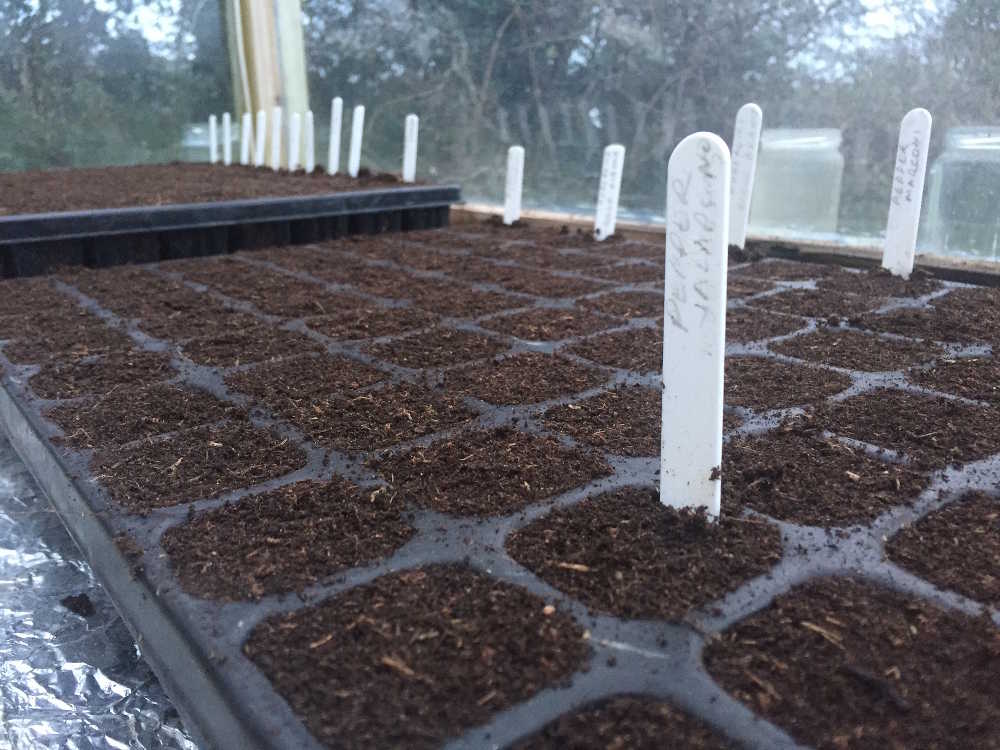

I absolutely love being a GIYer at this time of the year. It’s hard not to feel all spring-like and full of hope about life in general when one sees a little green seedling emerging from the cold, brown earth. I want to talk a little about seed sowing in general, which can be such a challenge when you’re starting out with your GIYing, but is relatively straightforward once you get a bit of a system going.
In particular I want to talk about seed sowing “indoors” – that is, those seeds that are sown in protected conditions rather than sown directly in the soil outside. So, here’s how it breaks down. I sow the following vegetables directly in the soil outside in the vegetable patch: potatoes, onions, garlic, shallots, peas, beans, parsnips and carrots.
Pretty much everything else I sow indoors first and then (usually about 4-6 weeks later when the seedlings are a little bit hardy), I plant them out in the soil. The vegetables I sow this way include lettuce, tomatoes, aubergines, peppers, sweetcorn, broccoli, cabbage, kohlrabi, Brussels sprouts, cauliflower, celery, celeriac, beetroot, spring onions, courgette, cucumber, kale, pumpkin, squash, spinach and turnip.
Sowing seeds directly outside is of course, a far easier way to do things. So why do we bother doing it a more convoluted way? Put simply, it’s far more effective. A seed sown in the soil outside has a lot to contend with in that difficult first 8 weeks of its life – among other things: frost, snow, rain, wind, slugs, snails and birds.
By sowing indoors you are giving the seedling a chance to get itself established before it has to deal with these threats. As a result, you’re more likely to convert your seed sowing in to food eating, which let’s be honest is the whole point.
Incidentally the word “indoors” can have many different meanings for different people. When I started growing first, sowing indoors meant actually sowing them inside the house. But when that got a bit out of control, I got myself a greenhouse/potting shed with benches where I grow seedlings. So, when I think of sowing “indoors” I am referring to the potting shed.
Sowing indoors also allows you to cheat on the growing season – by creating a warmer ambient temperature than that which exists outside, you can extend the growing season at either ends. This is particularly important for vegetables that have a very long growing season – examples are tomatoes, aubergines and peppers.
You can cheat even further by buying a heated propagation unit which provides your seedlings with heat from beneath. Seed germination and subsequent seedling growth is more reliable and faster when using a propagation unit, particularly at this time of the year when the air temperatures are low.
Things to do this Month - March
To Do
Continue to prepare ground – there is still time to prepare a plot to grow veg this year. Fork or rake over existing beds, breaking up large clods of earth. Cover new seedlings with fleece if a frost is due. Start your daily slug patrols and lay beer traps. Don’t let new-season weeds take over – get on top of them with weekly hoeing.
Sow
Indoors: lettuce, aubergine, peppers, cucumbers, celery, celeriac, sweet corn, basil, leeks, summer cabbage, cauliflower, Brussels sprouts, parsley, courgette, French beans.
Sow outdoors or under cover: broad beans, red cabbage, carrots, cauliflower, spinach, kale, Brussels sprouts, onions, leeks, turnip, peas, radishes, early lettuce, asparagus. Plant your first early seed potatoes, as soon as weather conditions allow.
Harvest
This month you could be enjoying (from the ground and from storage) onions, leeks, parsnips, potatoes, some varieties of lettuce, mint, sprouting broccoli, kale, rhubarb, chard, the first of the spring cauliflowers and cabbage, and spinach (perpetual, spinach beet).
Recipe of the Week – Borscht
This recipe was sent to me by Chris Betts, a GIYer from Tramore. It’s a brilliant way to use garden vegetables at the end of the season and makes a very tasty and nutritious lunch dish. You can be flexible with the ingredients, with Chris saying that only the beetroot is critical (otherwise it’s not borscht)! Make a big batch of this and freeze it.
Ingredients:
• ¾ lb each of lean pork and cooked bacon, diced
• 6 or more large beetroot
• 2 large onions
• 1 small celeriac or 2 sticks celery
• 1 leek
• 1 large turnip
• 1 large swede
• 1 or 2 parsnips
• 4 carrots
• 1 lb potatoes
• Half a cabbage
• Haricot or cannelloni beans, soaked overnight, to produce ¾ to one pint
• Olive oil
• Approx 1½ pints stock or water
• 1 or 2 tablespoons cornflour
• Plain yoghourt to garnish (if liked)
Directions:
Roughly chop/dice all veg. Saute onions lightly in oil, then add diced pork and brown all sides. Add vegetables and cook for a few minutes on medium heat, stirring to distribute oil evenly. Add the beans and sufficient stock or water to cover.
Bring to the boil, stirring occasionally, then add the cooked bacon, salt if required, and pepper to taste. Simmer for about 40 mins until everything is soft.
Mix cornflour to a paste with cold water in a small bowl or cup, add some of the liquid from the pan to it, stirring, then trickle into pan, stirring constantly. Adjust thickness to own preference (this can be done after defrosting if preferred).
When serving, add a dessert spoonful of yoghourt to each bowl.
Tip of the Month – Grow Red Cabbage
We’ve grown red cabbage for a few years now and it’s a very straight-forward, reliable plant to grow - pretty much untroubled by slugs and other pests once you get it started. It is also excellent for late summer coleslaws and will survive tough winters in the ground. Red cabbage is very easy and reliable to grow from seed, so there’s no real need to buy those expensive plants in modules. Sow the seeds in a seed bed or in modules (one seed in each cell) and they will almost certainly reward you with fine plants later on.
GROW HQ
The home of the GIY movement and our brand new food education centre, GROW HQ, is finally open in Waterford city. In addition to our 65-seat home-grown food café and shop, we’ve a range of growing and cooking courses happening weekly – for courses happening this month, check out www.growhq.org
Join GIY
By joining GIY you help us to continue the work of supporting people just like you to grow food at home, at school, in the workplace and in the community – each year we support over 65,000 people and 1,500 community food growing groups and projects. It costs just €35 to join GIY for a year, and to say thanks we will send you a seasonal copy of our supporter’s magazine GROW and some GIY seeds for you to sow each quarter. We will also send you our weekly tips, news and advice ezine and offer you discounts to GIY events like the annual GROW Fest. Join today at www.giyireland.com.

About GIY
GIY is a not-for-profit organisation that aims to create a healthier, more sustainable world where people grow their own food. We inspire and support people to grow food more successfully by bringing them together to share advice, tips and ideas. There are approximately 65,000 people involved in the GIY movement in Ireland, which is proudly supported by Woodies DIY.
For more information check out www.giyireland.com
Michael Kelly is a freelance journalist, author and founder of GIY Ireland.
© GIY Ireland 2017 – all rights reserved.
Grow It Yourself - April

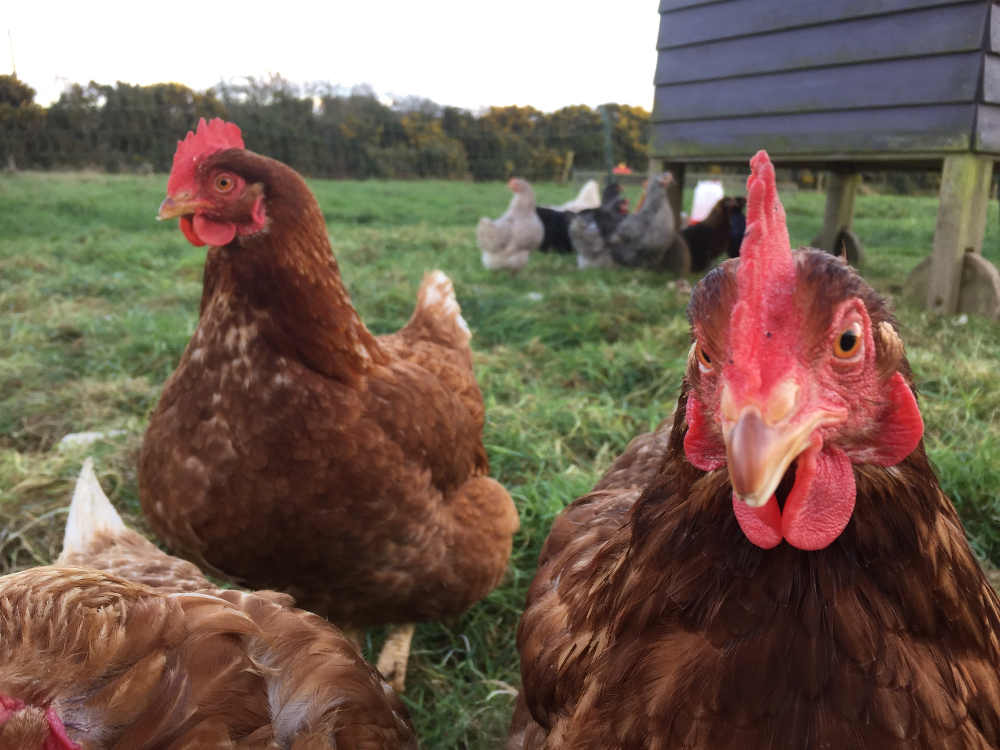
We added ten new hens to the flock here at home this week, ostensibly so the Eldest Child could satisfy his entrepreneurial instincts and start to sell our excess eggs. We had 5 hens up to now: 4 Rhode Island Red hybrids and a beautiful little white Leghorn who produces equally beautiful white-shelled eggs.
They were reliable layers for most of last year, but went off the boil (see what I did there?) over the last few months and we were down to one or two eggs a day over the winter – a serious thing in an egg-obsessed house like ours.
After several consecutive days of me cutting one poached egg in half to share between our two children for breakfast, Eldest Child decided to take matters in to his own hands and buy new hens to get things back on track.
As we debated how many to buy, he explained that ten extra was the perfect number so that he could start selling eggs once we’d satisfied requirements at home. He’s even started to stockpile egg cartons, a signal of the seriousness of his intent. Since he intended to buy the hens with his communion money, I could hardly refuse.
So, last weekend we took ourselves off to Kehoe’s Poultry farm just outside New Ross with a poultry crate in the boot of the car. As luck would have it Mr Kehoe had a grand selection of ‘point of lay’ (ready to start laying) hens ready to go.
Picking breeds of hens is usually a tradeoff between beauty and egg-laying reliability. You generally sacrifice one for the other. You can have a beautiful Columbian Brahma with a mad array of white feathers along its legs so it looks like it’s wearing leg warmers, but it probably won’t result in much income for the egg business.
The Rhode Island Red “Hybrid” is considered the most reliable layer of all. Given the quantity of hens we were buying, we reckoned we had some artistic licence, and opted for two each of Marans, Bluebells, Black Rock, Amber and Speckled Diamond. This required a investment of €130 but with (potentially) 70 eggs to sell a week, he won’t be long making that back.
It is always a fun if slightly turbulent time introducing new hens in to an existing, well-established flock. Hens quickly and often brutally establish and enforce a rigid pecking order so that everyone knows their place in the grand scheme of things.
The best time to introduce them to each other is at night time, so they get used to each other’s sounds in the dark when they are roosting, more placid and less prone to aggression. Closing the door, we listened and giggled at the sounds of restrained discontent and growling murmurs of bok bok bok from the elder lemons inside. Then Eldest Child went off to bed, no doubt to dream of all that egg money.
The Basics: Bringing New Hens Home
1. Young hens (called pullets) will start laying eggs generally at about 6 months – at this stage they are called ‘point of lay’ pullets. It’s an ideal time to buy them. Any earlier and you will be feeding hens that aren’t giving you an egg return. Expect to pay between €10 to €15 for a hen, depending on the breed.
2. Hens are best transported in a specialist crate or carrier, or a cardboard box if you don’t have one (firmly closed so they can’t get out, but with ventilation holes). Line the base of the box with newspaper and straw.
3. Leave new hens in their house for a few days to acclimatize and get used to their new home, particularly if they will eventually be free ranging. They need to get used to their house as their home base. Minor skirmishes are unavoidable when you bring new hens in to a flock and it takes a few days for them to establish their pecking order.
Things to do this Month - April
To Do
If poor weather in March has hampered your outdoor work, then April is the month to catch-up. The key words for April are weeds and slugs. You need to stay on top of them both. Check your early spuds regularly and ‘earth-up’ as required. Water your tunnel/greenhouse – things can get pretty warm on a nice sunny April day and seedlings will dry out quickly.

Sow
Indoors: lettuce, tomato, pepper, chilli-pepper, cucumber, celery, celeriac, basil, leeks, cabbage, cauliflower, Brussels sprouts, parsley, courgette, marrow, globe artichoke, beans, sweet corn and pumpkin.
Outdoors: broad bean, onion sets, pea, beetroot, cabbage, spinach, Brussels sprouts, parsnip, spring onion, leek, carrot, radish, broccoli, turnip. Plant out cabbage plants when they are 15/20 cm tall into well prepared soil that has been manured.
Harvest
Stored fruit and vegetables are likely to be a distant memory at this stage and new crops are only starting to trickle in which makes April a tricky proposition. The middle of this month might see the first asparagus and the first early spring cabbage. The other two star performers this month are purple sprouting broccoli and rhubarb.
Recipe of the Month – Kale and Smoked Cheddar Risotto
JB Dubois, our Head Chef at GROW HQ delivered a course on Vegetarian Cooking last month. The idea was to show people that introducing a couple of veggie dinners in to your repertoire each week can be healthy and delicious. This was one of the recipes featured. Don’t be turned off by the idea of making your own stock – it takes just half an hour to make and makes all the difference.
Serves 4.
Ingredients:
Veg Stock
• 1 small carrot
• 1 sprig thyme
• 2 cloves garlic
• 1 small leek
• 1 stick of celery
Risotto
• 250g Arborio rice
• 20g butter
• 1 clove garlic
• 1l veg stock
• 100g kale
• 1 carrot
• 100g Knockanore cheese (or other smoked cheddar)
• toasted sesame and poppy seeds
Directions:
First make the veg stock. Wash, peel and roughly chop the vegetables. Place them and the thyme in a pot, cover with 1.5l of cold water and a pinch of sea salt. Bring to the boil and simmer for 20 minutes. Remove from the heat and allow to infuse for another 10 minutes. Then pass through a fine sieve.
Wash and chop the kale. Peel and grate the carrot. Peel and chop the garlic. Grate the smoked cheddar. Sweat the garlic with the butter in a large pot on a low heat for 2 minutes. Add the rice and sweat it off for 2-3 minutes (keep stirring to avoid sticking). Add a good pinch of sea salt and pepper. Add the veg stock little by little while stirring every few minutes. The rice should be cooked when all the stock has been absorbed (15-20 minutes). When the rice is cooked, add the kale, the grated carrot and the grated cheese, give it a quick stir and serve immediately. Garnish with the toasted seeds. Add a squeeze of lemon.
Become a VIPea
By joining GIY you help us to continue the work of supporting people just like you to grow food at home, at school, in the workplace and in the community – this year we will support over 250,000 people and 8,000 community food growing groups and projects. It costs just €35 to join GIY for a year, and to say thanks we will send you a seasonal copy of our supporter’s magazine GROW and some GIY seeds for you to sow each quarter. It will also entitle you to a 10% discount at GROW HQ and our online shop. Join today at www.GIY.ie.
GROW HQ
The home of the GIY movement and our brand new food education centre, GROW HQ, is finally open in Waterford city. In addition to our 65-seat home-grown food café and shop, we’ve a range of growing and cooking courses happening weekly – for courses happening this month, check out www.growhq.org
About GIY
GIY is a not-for-profit organisation that aims to create a healthier, more sustainable world where people grow their own food. We inspire and support people to grow food more successfully by bringing them together to share advice, tips and ideas. There are approximately 65,000 people involved in the GIY movement in Ireland, which is proudly supported by Woodies DIY.
For more information check out www.giyireland.com
Michael Kelly is a freelance journalist, author and founder of GIY Ireland.
© GIY Ireland 2017 – all rights reserved.
Grow It Yourself - May
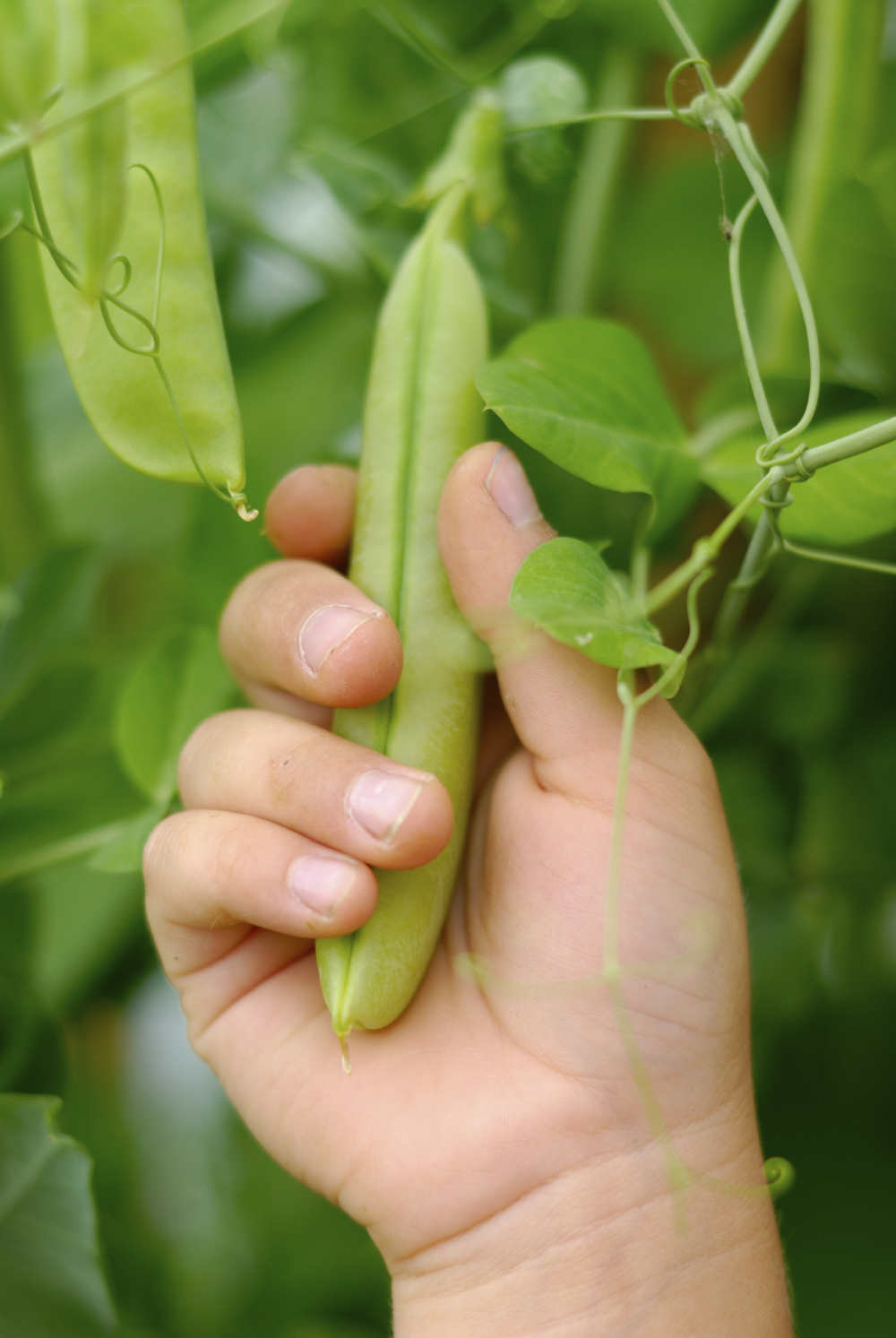
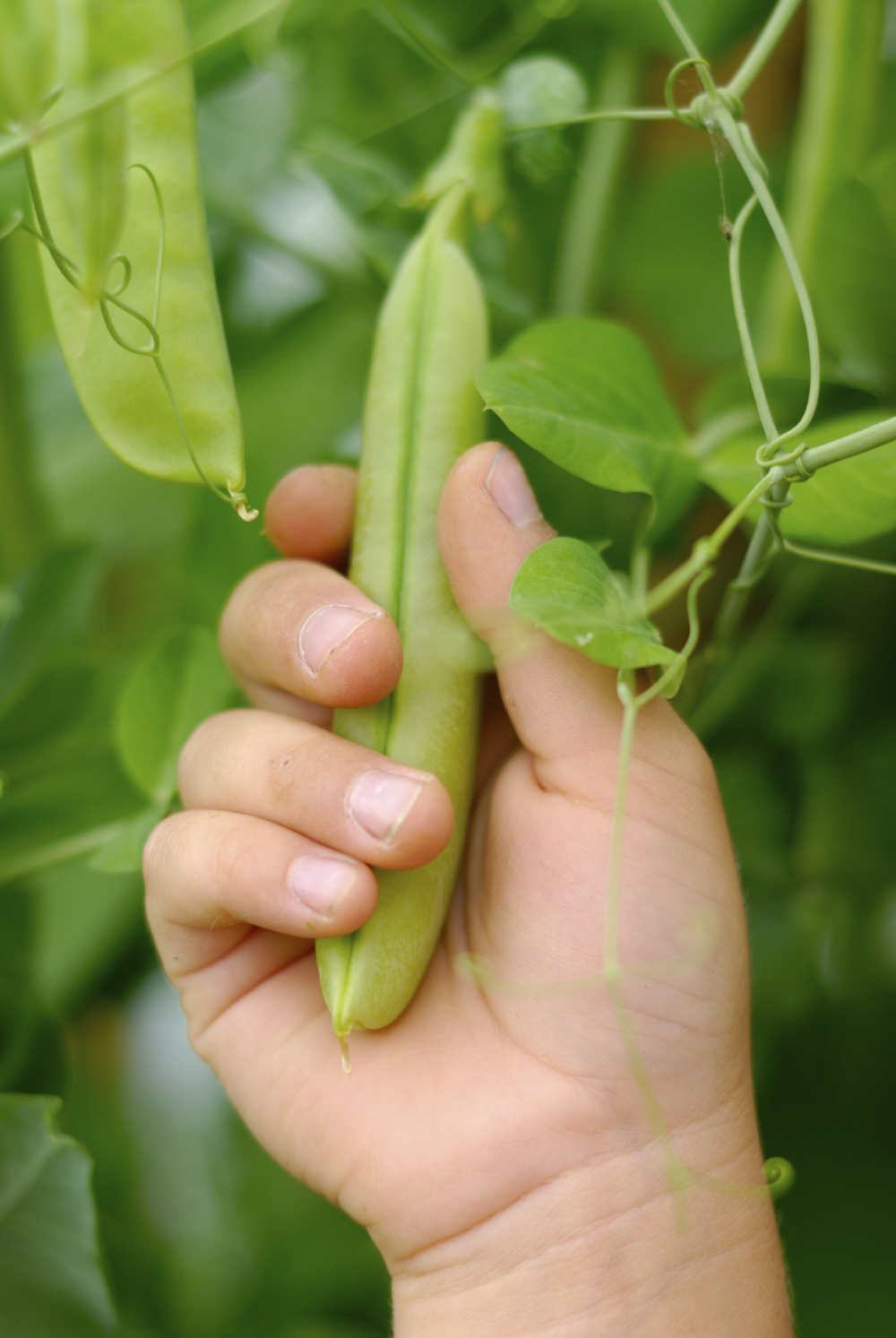
On one level, food growing is quite simple – you sow a seed, a plant grows, you eat it. But of course it’s the bits in between those major milestones where things can get complicated. Sometimes it doesn’t get complicated at all and everything flows beautifully. I smile, zen-like, and feel mighty happy with my abilities – but even then I can’t shake the uneasy feeling that I have no idea why it went so well this time.
And sometimes, it doesn’t go so well. Seeds don’t germinate. Seedlings die. There’s too much rain, or not enough. It’s too cold, or too damn hot. The place is overrun with weeds. And slugs. Everywhere you look, there’s a weed with a slug on it. Plants bolt or run to seed. Growth is puny, or over-abundant. Yield is poor, or there’s a glut you can’t handle. Too little nitrogen in the soil or not enough. Too acid. Too alkaline. Too many things to learn, not enough time.
Food growing is a skill and like any skill worth having, it takes time to get a handle on it. So the most important skill that one can have as a food grower is the ability to take the long view and be patient. You won’t learn all the skills you need in one season, or in ten seasons.
Learning to relax and sit with the discomfort of not being an expert is a very liberating thing. Peas didn’t germinate? Chill out. There’s always next year. Rhubarb has run to seed? Well, at least the flowers are pretty.
It helps I think to view GIYing as a whole range of little individual skills. Eating the elephant in bite-sized chunks makes it feel like a more manageable meal. Growing each individual vegetable is a skill in itself, because they are all different – but there’s a series of core skills that don’t really change.
These are the foundation skills, the building blocks for everything else. It’s like the leaving cert on which you can then build your higher education. If you can master these, then you’re well set up. Have a look below at some of the basics.
GIY 101
If I was to devise a GIY Skills course (hey, that’s not a bad idea actually..), semester 1 would be all about getting soil ready, because it all starts with good soil. So in that soil preparation and improvement category I would put the following individual skills: good composting, getting soil ready if starting from scratch; single/double digging; soil improvement (mulching, adding compost/manures etc); and then preparing a bed for planting (raking soil to a fine tilth).
Once you’ve got your soil in good nick, then it’s time to move on to semester two - sowing and planting things. In that category there are again some core skills: sowing seeds indoors or under cover (I think if you’re shown how to do this right, you will almost always have successful germination of seeds); pricking out and potting those seedlings on; sowing seeds direct in the soil (things like peas, carrots, onions, spuds etc).
Then you’re in to a plant maintenance phase and there’s another range of small skills to master: weed control (mainly, hoeing); managing pests and diseases (particularly slugs); watering (knowing how much or how little to use); plant maintenance (e.g. pinching off growing tips to bulk plants out, pinching out side shoots on tomatoes etc).
And finally, we get to the really fun part, when you get to sample your home-grown food. There are important skills there too: knowing when to harvest from a plant; being able to deal with gluts; being able to ‘process’ and store your food so you can prolong the season (braiding, pickling, drying, freezing, clamping etc).
Still here? Congratulations – you’ve just graduated in GIY 101!
GROW HQ
Check out the courses, classes, events and more at the home of the GIY movement, GROW HQ, in Waterford city. In addition to our 65-seat home-grown food café and shop, we’ve a range of growing and cooking courses happening weekly – for courses happening this month, check out www.growhq.org.
Things to do this Month - May
To-Do
May is the time to get those outdoor beds ready for early summer transplanting. Fork over and rake. Earth up potatoes as the plants develop. Put protective barrier around your carrots to thwart the dastardly carrot root fly. Regularly hoe weeds and mulch. Water plants if required. Support tomato, bean and pea plants with twiggy sticks, pea netting, timber supports with chicken wire, or existing fence or hedge. Pinch out the growing tips of broad beans plants to help prevent Blackfly.
Sow
Indoors for planting on later: basil, dill, coriander, courgette, cucumber, sweet corn, pumpkins.
Outdoors: winter cauliflower, cabbage, kale, spinach, sprouting broccoli, leeks, beans (French, Runner, Climbing French), beetroot, parsnip, turnip, swedes, radish, lettuce, peas, broccoli, rocket, carrots. Harden off and begin to plant out seedlings you have lovingly raised indoors – e.g. tomatoes, cucumber, peppers, brussels sprouts, sprouting broccoli, cabbages, sweet corn, leeks.
Harvest
May is another tricky “gap” month as stores continue to dwindle. Continue picking asparagus, purple sprouting broccoli, radish, rhubarb, cabbage, cauliflower, spinach and chard. May is likely to see the first real bumper salad leaves like lettuce and rocket – as well as the first garlic, beetroot and globe artichokes.
Recipe of the Month – Asparagus and Toasted Pecan Salad
Lucky the GIYer that has well-established asparagus in their garden – here’s a lovely asparagus salad. Serves 3-4.
Ingredients:
• 1kg asparagus, trimmed and cut into 2-inch pieces
• 1/3 cup balsamic vinegar
• 3 tbsp olive oil
• 1 tbsp Dijon mustard
• 1 tbsp chopped fresh marjoram
• 1 tsp garlic - minced
• 1 red pepper, diced
• 1/3 cup chopped and toasted pecans
Directions
Cook the asparagus in a pot of boiling, salted water until tender (about 4 mins). Drain and then rinse with cold water. Boil the vinegar in a saucepan until reduced by half. Pour it in to a large bowl – whisk in the oil, mustard, marjoram and garlic. Season to taste. Add asparagus and bell pepper and blend well. Sprinkle with pecans.
Become a VIPea
By joining GIY you help us to continue the work of supporting people just like you to grow food at home, at school, in the workplace and in the community – this year we will support over 250,000 people and 8,000 community food growing groups and projects. It costs just €35 to join GIY for a year, and to say thanks we will send you a seasonal copy of our supporter’s magazine GROW and some GIY seeds for you to sow each quarter. It will also entitle you to a 10% discount at GROW HQ and our online shop. Join today at www.GIY.ie.
GROW HQ
The home of the GIY movement and our brand new food education centre, GROW HQ, is finally open in Waterford city. In addition to our 65-seat home-grown food café and shop, we’ve a range of growing and cooking courses happening weekly – for courses happening this month, check out www.growhq.org
About GIY
GIY is a not-for-profit organisation that aims to create a healthier, more sustainable world where people grow their own food. We inspire and support people to grow food more successfully by bringing them together to share advice, tips and ideas. There are approximately 65,000 people involved in the GIY movement in Ireland, which is proudly supported by Woodies DIY.
For more information check out www.giyireland.com
Michael Kelly is a freelance journalist, author and founder of GIY Ireland.
© GIY Ireland 2017 – all rights reserved.
Grow It Yourself - June
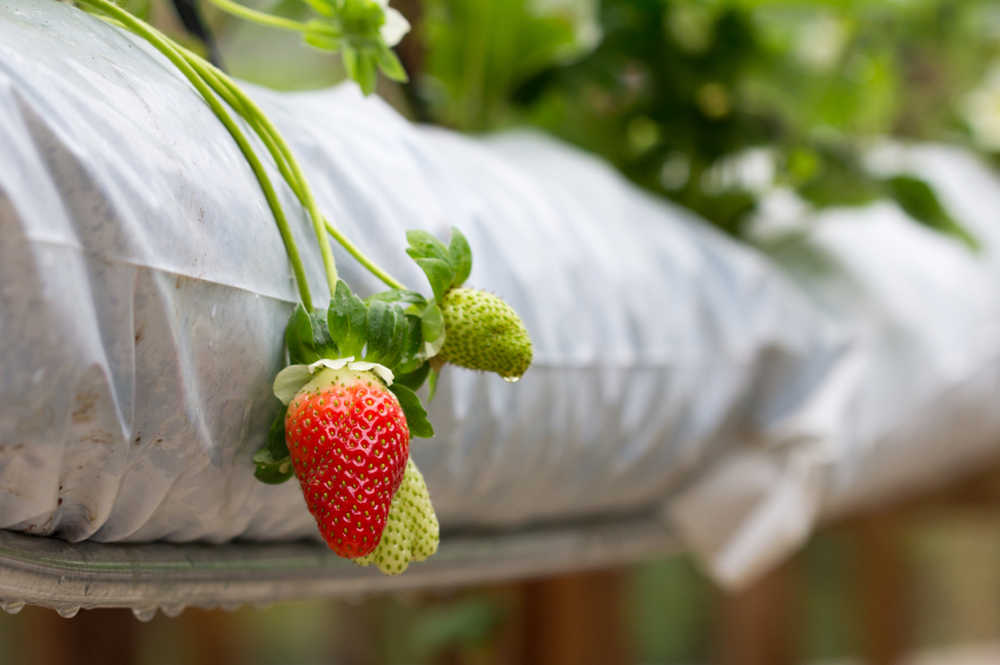
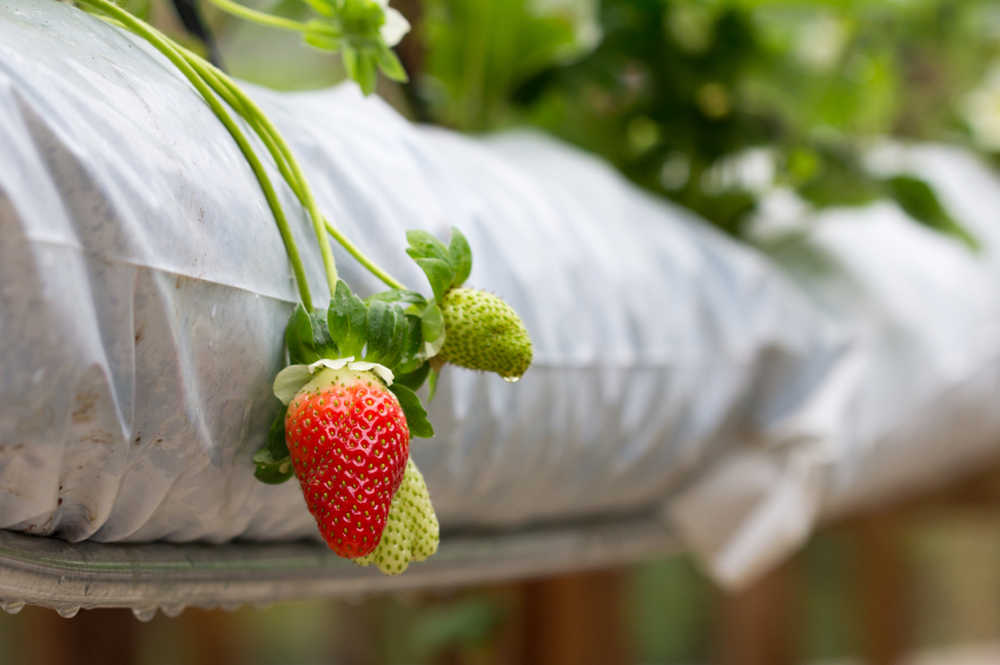
I’ve discovered as I get older that I am person that loves to square things away, and that applies equally with food-growing where I am constantly looking for things that simplify what can be a pretty complicated life-skill.
Over the years I’ve deployed all sorts of little nerdish tricks, categories, tables, post-it notes, spreadsheets and all manner of other organising devices to try and break it down and make it easier for me to understand.
When it comes to seed sowing in particular, it always seemed to me that almost every vegetable seemed to start in a slightly different way which just added to the general confusion. In fact, there are really only two categories: those that are sown direct in the soil, and those that are sown in a pot or tray to be planted out later. So, let’s break it down (use a spreadsheet if you want…!):
Firstly we start with veg that are sown direct in the soil outside (or in a polytunnel or greenhouse). This category can be broken down in to three different types of seed:
• Tubers – for e.g. potatoes where the ‘seed’ is an actual potato. In a similar vein are artichokes, yacon and oca etc.
• Sets – for e.g. onions and shallots. Where the ‘seed’ is a small, immature onion that someone else has grown from seed; or garlic where the ‘seed’ is a clove of garlic from last year.
• Seeds that are best sown direct in the soil – e.g. peas, French beans, parsnips and carrots.
Secondly we have the veg that are sown in pots or module trays for later planting out in to the soil. In this category I include pretty much everything else, e.g. tomatoes, peppers, aubergines, celery, celeriac, salads (including oriental greens), cabbage, kohlrabi, swede, chard, turnips, kale, beetroot and so on.
Admittedly there are quite a few veg that I include in the latter category (sowing in module trays for later transplanting), that could just as easily be sown direct outside. A good example of this is beetroot.
So the question is – why would I do this when it would save time to sow them direct? The answer is that I just find it more successful to start them off inside and plant out later. And besides, as regular readers will know, I just love spending time in the potting shed.
The reason it is more successful is that plants are at their most vulnerable (to cold and slugs for example) when they are seedlings and it is generally more successful to plant a plant rather than to sow a seed. Sowing seeds in pots/trays also allows you to get a head start on the growing season as you keep the pots/trays indoors or under cover during Feb/March/April when it is generally too cold to sow outside.
The Basics – Potting Compost
Potting compost is the medium that is used to sow seeds in. Potting compost is completely different to compost that you might make yourself in the garden from rotting plant matter. I always found this rather confusing when I started growing. For starters, potting compost is a sterile medium which means you know there are no weed seeds in it. It also retains moisture very effectively which is important for your seeds.
Interestingly, unlike your homemade garden compost, potting compost is very low in nutrients so it is only ever used for starting seeds off. If you intend to grow a plant to maturity in a pot, it will need to be transplanted in to a medium that has more nutrients in it (e.g. a mix of garden compost and soil etc). Seeds do not need to be sown in a medium that is rich in nutrients since they already have all the nutrients they need for germination.
It’s worth buying good quality potting compost – ideally one that is approved for use in organic production and peat-free. I’ve bought cheap compost over the years if I couldn’t get anything else and I am almost always disappointed with the results.
GROW HQ
Check out the courses, classes, events and more at the home of the GIY movement, GROW HQ, in Waterford city. In addition to our 65-seat home-grown food café and shop, we’ve a range of growing and cooking courses happening weekly – for courses happening this month, check out www.growhq.org.
Things to do this Month - June
To-Do
Watering and weeding duties step up a notch – the tunnel/greenhouse in particular will require a good deal of water from now on. Watch the weather and water outside as required. Continue to earth-up potato plants to prevent the spuds becoming green.
Mulch and water tomato plants and continue to remove side shoots that appear in the leaf axils. Stake everything that grows tall – raspberries, peas, beans, tomatoes etc. Net soft fruit against birds – it’s worth the effort.
Sow
Sow courgettes, pumpkins, summer and winter squash, fennel, chicory. Succession sow: beans (French and Runner), kale, pea, spinach, spinach beet, summer broccoli, carrot, swede, leek, lettuce, Brussels sprouts, beetroot, chicory, endive, turnip, kohlrabi, fennel. Plant out leeks, Brussels Sprouts, cabbage, autumn cauliflower, calabrese, sprouting broccoli, celery, celeriac, cucumbers, pumpkin, marrows, runner beans, aubergine.
Harvest
We are now really starting to see some payback from our GIYing - the first broad beans and peas as well as new potatoes, new carrots, soft fruit like gooseberries, cherries and strawberries. Herbs are in full flow. Also harvest kohlrabi, cabbage, cauliflower (month end), spinach, spring onion, shallots, salad leaves, elderflower, rhubarb, salad leaves, onions, carrots, beetroot, garlic, sea-kale.
Recipe of the Month – Strawberry and Spinach Salad
Celebrate the seasonality of strawberries and new season spinach with this delicious and super-quick salad. Serves 4.
Ingredients:
• 300g annual spinach
• Approx 400g strawberries, sliced
• 120ml olive oil
• 4 tablespoons apple cider vinegar
• 100g caster sugar
• 1/4 teaspoon paprika
• 2 tablespoons sesame seeds
• 1 tablespoon poppy seeds
Directions
Toss together the spinach and strawberries in a large salad bowl. In another bowl whisk together the oil, vinegar, sugar, paprika, sesame seeds and poppy seeds. Pour over the spinach and strawberries, and toss to coat.
Become a VIPea
By joining GIY you help us to continue the work of supporting people just like you to grow food at home, at school, in the workplace and in the community – this year we will support over 250,000 people and 8,000 community food growing groups and projects. It costs just €35 to join GIY for a year, and to say thanks we will send you a seasonal copy of our supporter’s magazine GROW and some GIY seeds for you to sow each quarter. It will also entitle you to a 10% discount at GROW HQ and our online shop. Join today at www.GIY.ie.

About GIY
GIY is a not-for-profit organisation that aims to create a healthier, more sustainable world where people grow their own food. We inspire and support people to grow food more successfully by bringing them together to share advice, tips and ideas. There are approximately 65,000 people involved in the GIY movement in Ireland, which is proudly supported by Woodies DIY.
For more information check out www.giyireland.com
Michael Kelly is a freelance journalist, author and founder of GIY Ireland.
© GIY Ireland 2017 – all rights reserved.
Grow It Yourself - September
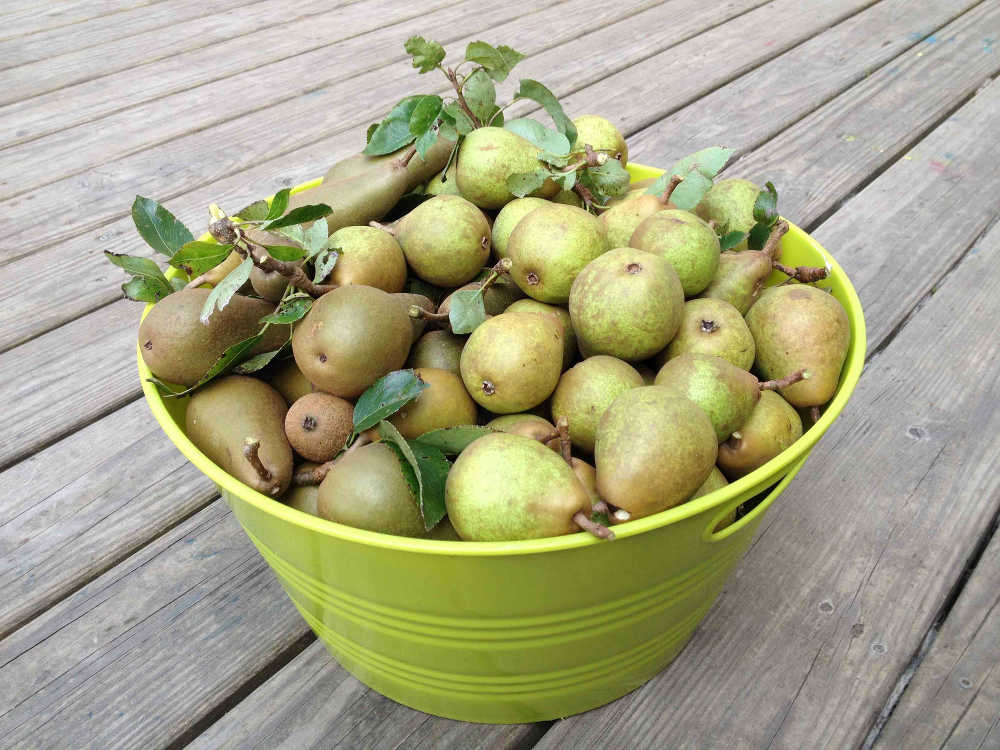
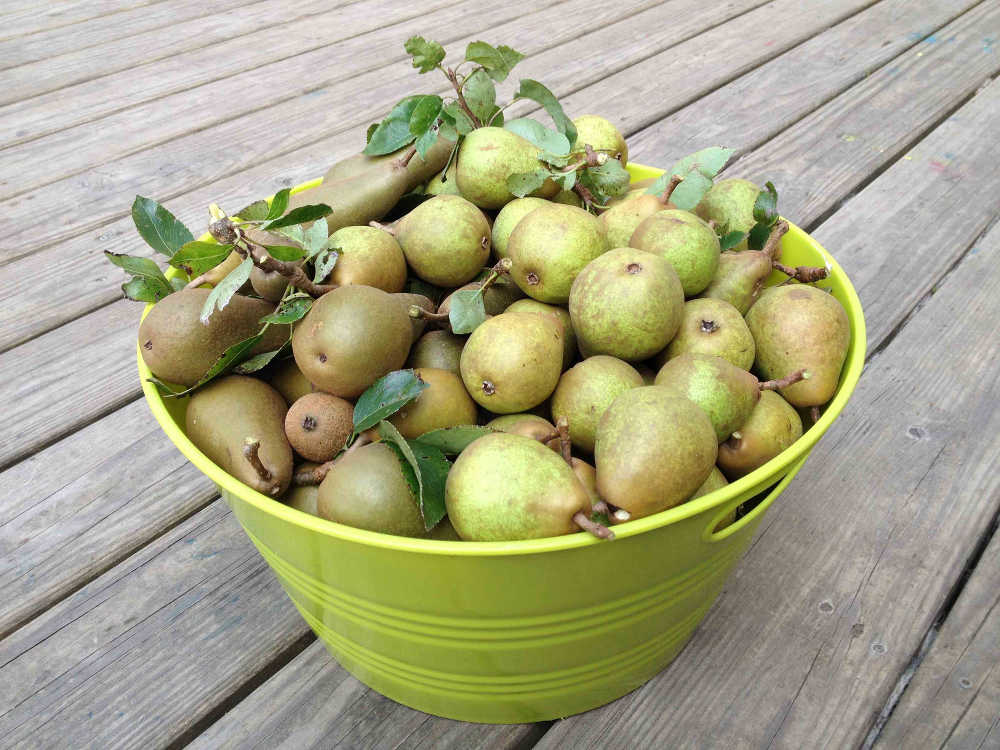
I was about 5 hours in to my monster 8-hour ‘pickle-athon’ and up to my neck in diced fruit, veg and vinegar syrups. I had just peeled, cored and chopped 2kg of pears (I didn’t count how many pears that is, but it’s a lot), and a pan of boiling, sugary stickiness had just overflowed on the stove. The kitchen looked like a bomb had hit it. I was tired, cranky, sweaty and hungry (ironic, given that I was surrounded by mounds of food).
It was at that moment that Mrs Kelly chose to arrive in from the garden with another enormous bucket of windfall pears and a big smile on her face. “Look what else I found,” she said, beaming at what was surely an entire winter’s supply of overripe fruit. “That’s great,” I deadpanned, without much conviction, before turning away and muttering something unprintable.
We are in serious glut territory in our garden at the moment and suspended in that perilous no-man’s land between abundance and waste. So you have to move fast - do something with the produce so you can eat it later in the year, or lose them forever to the compost heap. That means making a conscious decision to dedicate the time required to make a jam, pickle or chutney, or whatever other preserving recipes you have in your arsenal.
With a large stack of oversized cucumbers I made a zingy cucumber and onion pickle. Five large beetroot became a sweet beetroot marmalade. A big bucket of pears were prepared and then boiled in a spicey syrup of white wine vinegar and sugar before being popped in to warm kilner jars.
So, here’s what I was thinking last night as I went to bed in a vinegar-fume fug. (1) When it comes to getting produce in to “storage” for the winter, we need to put aside any romantic notions about how the hours spent peeling, dicing and chopping will make you a better person. Let’s be honest, it’s just hard bloody work. (2) It is relentless at this time of the year - there are plenty more cucumbers, beetroot and pears where the first batch came from, and other vegetables in the veg patch that need dealing with too. (3) Do I smell burning? Did I turn off the hob?
The morning after, the vinegar fumes having dissipated, I was feeling a little more balanced and reflective. Gazing along the rows of different sized jam and kilner jars, I had that wonderful, primordial smug/satisfied feeling that arises the day after a mammoth session of food storing. In November or December when fresh produce is starting to wear thin, and we can pop open a jar and taste harvest 2017 all over again.
The Basics – Making the Most of Space
As we start to clear crops from the greenhouse/polytunnel, you can use the available space to grow winter salad crops such as lettuce, cabbage, radish, chard, land cress, corn salad, claytonia (often called purslane or miner’s lettuce) and texsel greens.
These plants will provide fantastic greens (and bundles of Vit C) during the winter and if you sow enough of them, they may even keep you in greens until the first new season crops arrive next Spring. They will grow more slowly than they would earlier in the season, but if you sow them now, they will put a burst of growth on before the real cold weather sets in.
Things to do this Month - September
To-Do
Lift crops which have finished growing and dress bare soil with manure, compost (or plant green manures). Wasps can be problematic as fruit ripens so make traps from jars of sugary water. Remove surplus leaves from tomato plants which allows air to circulate and sunshine to fall on the fruit. Go blackberry picking!
Sow
Last month for sowing perpetual spinach, chard and oriental salads – it will be worth it in the New Year when there’s almost nothing else to eat, so get sowing! In the polytunnel/greenhouse sow lettuce, mustard, cress, basil, coriander, parsley, radish, dwarf early pea, broadbean, cauliflower seed, rocket, onion seed and garlic. Outside sow white turnip seeds and autumn onion sets, e.g. ‘centurion’ and ‘sturon’. Plant out strawberry runners. Pot up some parsley for winter use.
Harvest
Lift onions and leave to dry out in sun or in the polytunnel/greenhouse for two weeks. Apples, plums, pears are now in season. Continue to harvest salad leaves, tomatoes, radish, potatoes, carrots, turnips, beetroots, cauliflower, cucumbers, peppers, beans, courgettes, spinach, leeks, red cabbage, summer cabbage, aubergine, sweet corn.
Recipe of the Month – Glut-Buster Seasonal Slaw
This will keep for 3-4 days in the fridge and serves 4.
Ingredients:
• 2 beets, peeled and shredded
• 2 small carrots, shredded
• 1/4 cabbage, thinly sliced
• 2 lemons, zest and juice
• 2 Tablespoons rice vinegar
• 4 Tablespoons vegetable or olive oil
• 1 Tablespoon honey
• 2 cloves garlic, peeled and grated
• Salt and pepper to taste
Directions:
Combine the vegetables with lemon zest in a very large bowl. In a small bowl, whisk together remaining ingredients with lemon juice. Season with salt and pepper to taste. Add it to the vegetables and mix well.
Become a VIPea
By joining GIY you help us to continue the work of supporting people just like you to grow food at home, at school, in the workplace and in the community – this year we will support over 500,000 people and 9,000 community food growing groups and projects. It costs just €35 to join GIY for a year, and to say thanks we will send you a seasonal copy of our supporter’s magazine GROW and some GIY seeds for you to sow each quarter. It will also entitle you to a 10% discount at GROW HQ and our online shop. Join today at www.GIY.ie.
GROW HQ
The home of the GIY movement and our brand new food education centre, GROW HQ, is finally open in Waterford city. In addition to our 65-seat home-grown food café and shop, we’ve a range of growing and cooking courses happening weekly – for courses happening this month, check out www.growhq.org
About GIY
GIY is a not-for-profit organisation that aims to create a healthier, more sustainable world where people grow their own food. We inspire and support people to grow food more successfully by bringing them together to share advice, tips and ideas. There are approximately 65,000 people involved in the GIY movement in Ireland, which is proudly supported by Woodies DIY.
For more information check out www.giyireland.com
Michael Kelly is a freelance journalist, author and founder of GIY Ireland.
© GIY Ireland 2017 – all rights reserved.
Grow It Yourself - November
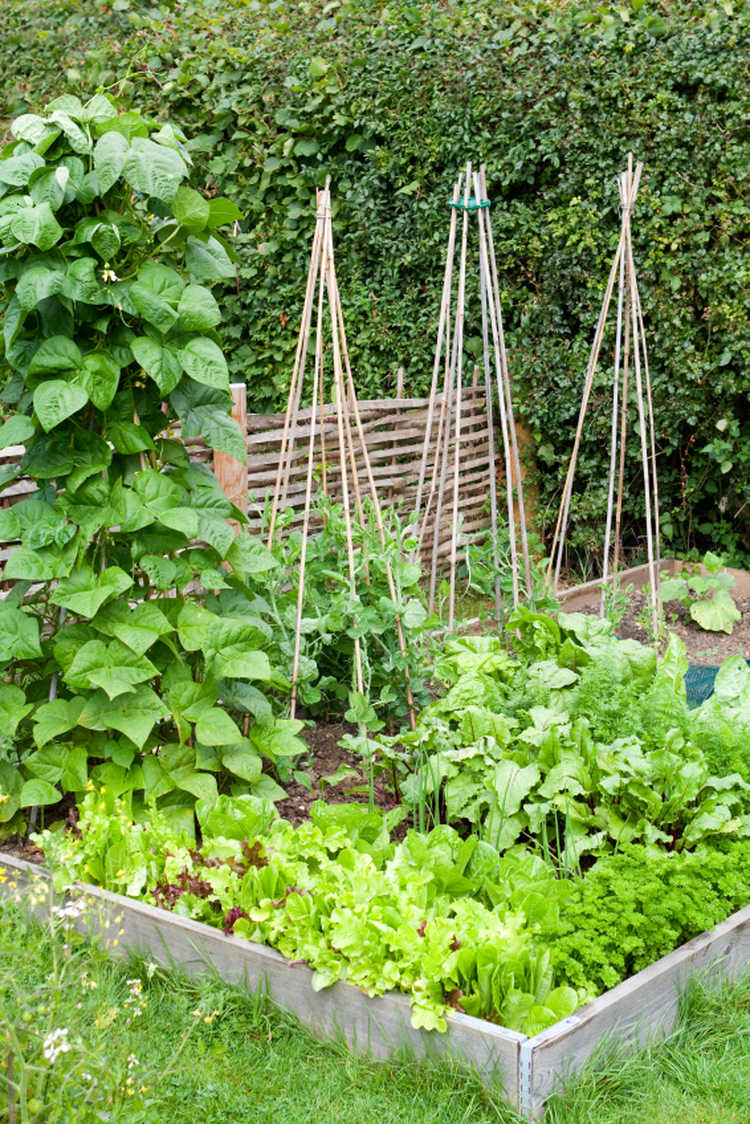
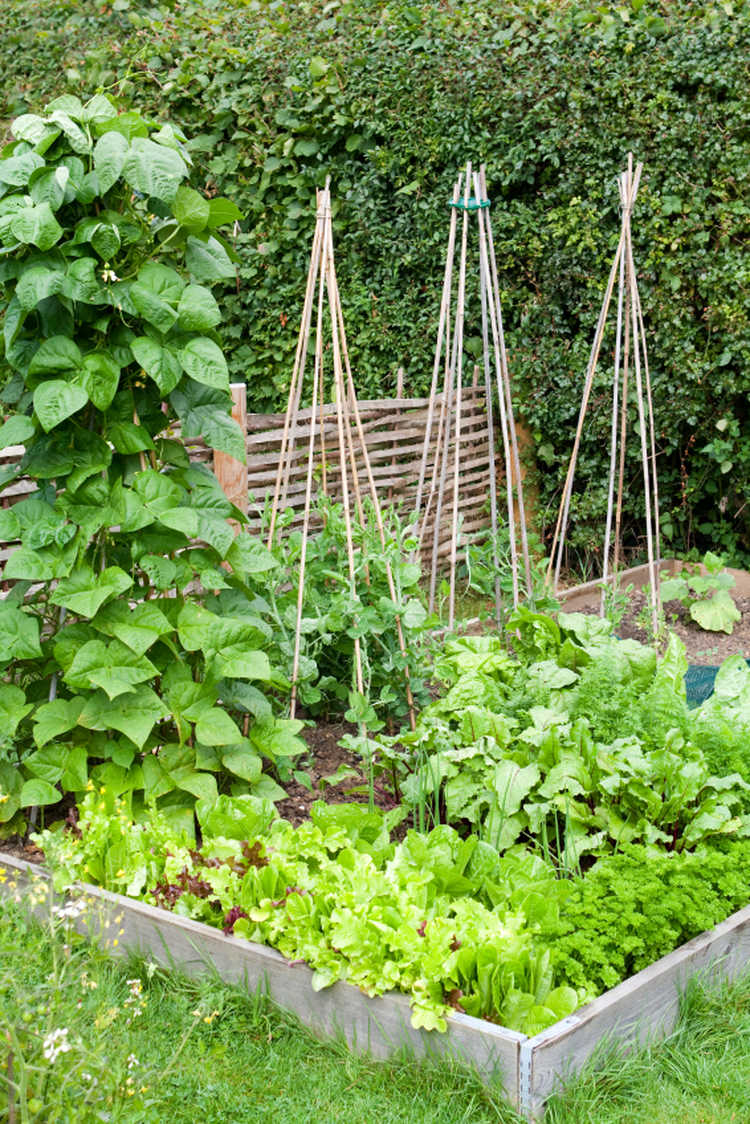
Over the last few years I’ve noticed a definite snootiness about using raised beds for growing food, which I find ridiculous. It’s almost like if you are not out there double digging your soil and breaking your back to suffer for your vegetables then it’s considered cheating. Personally I am all for the occasional cheat if it helps me to grow better veggies or helps me to grow them with less time and effort expended.
Generally speaking you need a good spade’s depth of quality top soil in order to grow good veggies. Unfortunately GIYers now face twin barriers to this approach – poor soil depth/quality in their garden, and lack of time to spend improving the soil quality. In most housing estates in Ireland for example the ‘soil’ was created by departing builders throwing a miserly inch-thick layer of top soil on top of the builder’s rubble – not the most promising growing medium.
A “raised bed” is created by adding a good layer (at least a foot) of soil on top of the existing soil, usually using a frame of timber to keep the soil in place. Instead of digging down in to the soil therefore, you are effectively raising the level of it up by a foot.
The raised bed is therefore an ingenious cheat to provide, good quality, deep, fertile soil that’s perfect for planting. It goes without saying that if you are blessed with good quality, deep soil in your garden and plenty of time for digging, then you don’t need raised beds. But if you don’t, by bringing good quality soil in to raised beds in your garden, you can start growing promising veggies instantly.
They have a number of other benefits. Typically, you don’t ever stand on the soil which means less soil compaction and therefore better drainage (the soil will dry out quicker). They also tend to extend the growing season because the soil in raised beds warms up earlier than the soil around it. You can therefore start planting earlier in the season. The dreaded slugs tend to be less of an issue too because they face more barriers to get in to the bed.
When it comes to the shape and look of your raised beds you can let your imagination run riot, but don’t sacrifice functionality for aesthetics. I went nuts a few years back making triangular-shaped beds – they looked lovely but were highly impractical.
The important thing to remember is that you are not supposed to be walking on the soil at any point, so you must be able to reach in to the centre of the bed from the sides. A 4ft (1.2m) wide bed is therefore considered ideal because the centre of the bed can be reached from both sides (depending how long your arms are I guess!).
The beds should be a minimum of 25cm deep. You can go deeper if you want (even up to waist height) - deeper beds have the advantage of being easier to work at (no stooping etc) but they drain very quickly and are therefore difficult to keep watered in summer. You also need a serious load of soil to fill them.
A typical argument against raised beds is their cost. In reality you can spend as much or as little as you want. You can buy raised beds or make them yourself from old scaffolding planks or salvaged timber.
The Basics – 5 Step Plan to Make Raised Beds
A simple 5-step plan to put raised beds on to a lawn is as follows:
1. Measure out the lengths of wood needed, cut them to size and nail them together.
2. Support from the inside using wooden pegs, then nail the planks to the pegs for support.
3. Place a thick layer of wet cardboard or newspaper at the bottom to kill off grass and weeds.
4. Fill with alternating layers of manure/compost and top soil. A mix of about 60 per cent soil and 40 per cent compost would be ideal.
5. Fill the beds to within about 10cm of the top so that the sides of the bed act as a windbreak.
Autumn is a great time to put in raised beds. If you get them built in the autumn and early winter and filled with soil and compost, you can cover them down for the rest of the winter so that they will be bursting with nutrients and ready for planting next spring.
You can buy top soil in garden centres but it will be expensive. Specialist soil mix providers like Enrich sell larger quantities (1-tonne bags). Ask at your local GIY group, gardening club, or allotment organisation. Failing that, keep an eye on local papers. Ask to see the soil before it’s delivered - you do not want a lorry load of subsoil full of stones and weeds.
GROW HQ
We were very proud to win the Farm & Sea to Plate Award at the 2017 Food & Wine Awards. Check out the courses, classes, events and more at the home of the GIY movement, GROW HQ, in Waterford city. In addition to our 65-seat home-grown food café and shop, we’ve a range of growing and cooking courses happening weekly – for courses and events happening this month, check out www.growhq.org
Things to do this Month – November
To Do
Do not leave beds bare for the winter – sow a green manure, or cover with a thick layer of manure/compost and then black plastic or straw. This will return nutrients to the soil, keep the worst of the weather off it, suppress weeds and prevent leaching of nutrients. ‘Earth up’ or tie up vegetables such as cabbage, cauliflower and Brussels sprouts. Divide up your rhubarb if you want to propagate, and cover it with a thick mulch of manure. Prune apple trees. Mulch fruit bushes. Take cuttings of currant bushes from current season’s wood.
Sow
Sow broad beans outside now for an early crop next spring. To avoid rotting before germination, make small newspaper cups and germinate them indoors first. Next summer’s garlic does best if it’s planted before Christmas – plant outdoors in well prepared soil in a sunny spot. Though I have to admit I never bother with them, some varieties of onion can over-winter and will be ready to harvest in early summer.
Harvest
Continue to harvest perpetual spinach, cabbage, cauliflower, potatoes, swede, parsnips, apples, pears. Start harvesting leeks, winter cabbage, kale, artichokes, Brussels sprouts. Time to lift carrots and turnips or at least cover them with a good layer of straw to protect them from frost damage.
Recipe of the Month – Mick’s Wilted Spinach, Black Pudding and Poached Egg Breakfast
I get a lot of slagging here in GIY about my love of breakfast, and I am loathe to add fuel to that particular fire. But, it is without question my favourite meal of the day, and I’ll get up early just to ensure I have enough time to cook it.
This breakfast is packed with iron and protein in the form of fresh-blood black pudding, eggs and spinach. Though black pudding is a rich and easily absorbed source of iron, it’s on the fatty side – so you could perhaps leave it out mid-week and enjoy at the weekend. Always seek out a good quality pudding made from fresh blood as opposed to blood ‘powder’.
A good black pudding really should have only a small handful of ingredients: blood, pork fat and meat, rice, oatmeal and seasoning. Inch House is an artisan black pudding made by Nora Ryan from Inch House in Thurles that we use on the breakfast menu at GROW HQ.
It’s available from good retailers including Ardkeen in Waterford, Cavistons in Dublin and Country Choice in Nenagh. Jane Russell also recently introduced an excellent fresh blood black pudding to her product range.
Serves 4.
Ingredients:
• 6-7 large spinach leaves – stalks finely chopped, and leaves chopped
• Grated nutmeg
• Sea salt and pepper
• 4 x 1cm slices of good quality black pudding
• 1 beef tomato – cut in to slices
• 4 organic eggs
• 4 slices of sourdough bread
Directions:
Fry a little butter in a pan on a low heat and add the spinach stalks. Wilt gently until soft and then stack them in the corner of the pan. Add the slices of black pudding and fry for a few minutes on each side until browned and cooked through. Remove them and the spinach stalks to an oven to keep warm. Fry the slices of tomato for a minute or so on each side to brown slightly and then remove from the pan.
Meanwhile bring a saucepan of water to a rolling boil. Crack the eggs in and poach them as you like them. Pop some sourdough bread in the toaster. Back to the frying pan - add the spinach leaves. Season well with some sea salt and black pepper and grate a little fresh nutmeg on top. Keep turning the spinach in the pan - you want it to wilt gently as opposed to frying so add a little knob of butter or a few drops of water if you need to.
When the spinach is wilted it’s time to plate up – butter a slice of sourdough toast and them make a stack on top: a slice of black pudding, tomato, spinach stalks and leaves and top with a poached egg. Eat, then embrace the day.
Become a VIPea
By joining GIY you help us to continue the work of supporting people just like you to grow food at home, at school, in the workplace and in the community – this year we will support over 500,000 people and 9,000 community food growing groups and projects. It costs just €35 to join GIY for a year, and to say thanks we will send you a seasonal copy of our supporter’s magazine GROW and some GIY seeds for you to sow each quarter. It will also entitle you to a 10% discount at GROW HQ and our online shop. Join today at www.GIY.ie.
About GIY

GIY is a not-for-profit organisation that aims to create a healthier, more sustainable world where people grow their own food. We inspire and support people to grow food more successfully by bringing them together to share advice, tips and ideas. There are approximately 65,000 people involved in the GIY movement in Ireland, which is proudly supported by Woodies DIY.
For more information check out www.giyireland.com
Michael Kelly is a freelance journalist, author and founder of GIY Ireland.
© GIY Ireland 2017 – all rights reserved.
Grow It Yourself - December
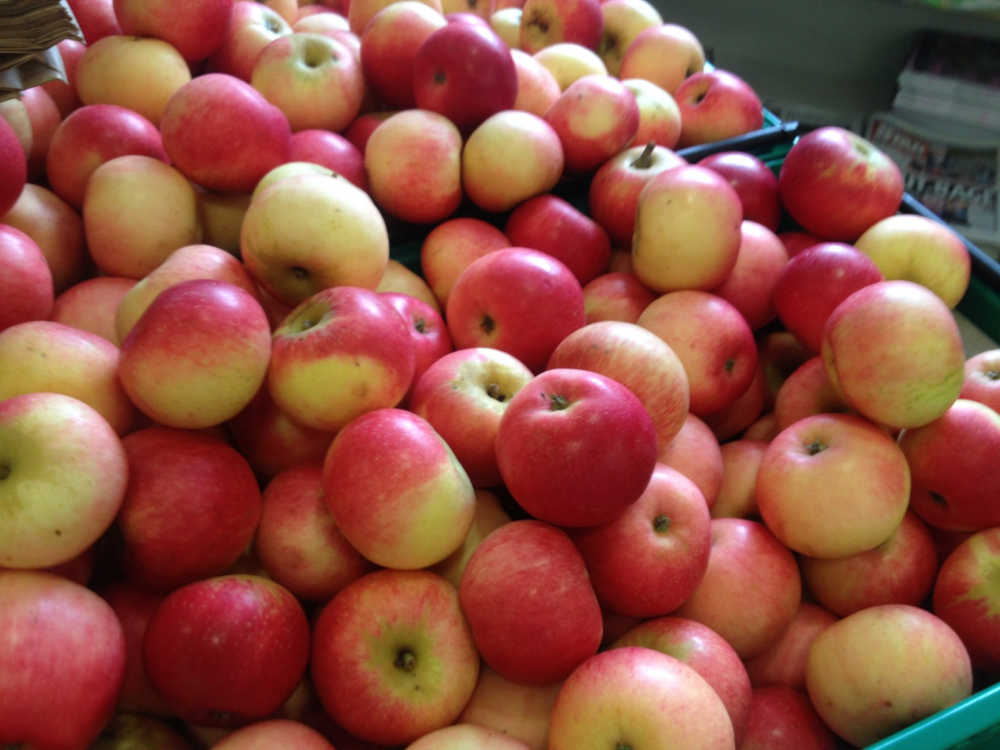
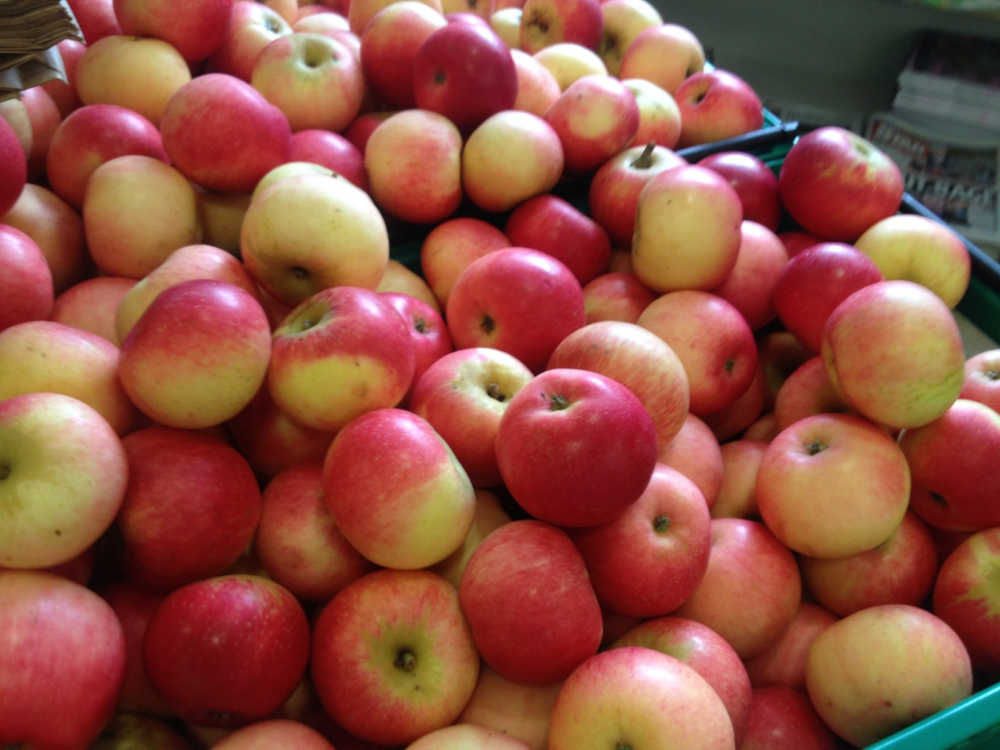
I am a massive fan of apples and the “apple a day keeps the doctor away” lessons of youth have stayed with me all my life. I’ve often thought it strange however, that such a traditional saying must surely have originated at a time when it would have been difficult to follow the advice and eat an apple each day all year round.
The apple season here runs from late August until Christmas but since apples store quite well (kept somewhere cool and dark), you could eat Irish apples until March or April. After that, traditionally, it was time to move to the great summer fruits such as currants and berries and then wait until August for the new season apples to appear again.
These days of course one can eat an apple a day all year round with no problem whatsoever thanks to the abundance of imported apples available in our supermarkets. In a strange way, the apple-lover in me would be glad about this if we were only eating imported apples when the Irish ones were all finished. But sadly, that’s not the case.
In fact, 95% of the €100 million worth of apples consumed in Ireland annually are imported. Even in peak apple season in Ireland, the apples on our supermarket shelves are more likely to have been grown in New Zealand, South America, China and India.
This is bad enough for the planet and for our indigenous apple industry but it’s also bad for us as consumers. As is the case with most fruits and vegetables, the commercial apple market has been homogenised and rationalised to the point where almost all of the apples consumed worldwide come from just a handful of varieties such as Pink Lady, Golden Delicious and Granny Smith.
As consumers, our flavour choices are therefore incredibly limited. Though we have been conditioned to believe that there are just handfuls of apple varieties, in fact, we have hundreds of native varieties in Ireland alone. One of our great apple growers and advocates, Con Traas, grows over 60 varieties on his 40 acre farm in Cahir, Co Tipperary.
Growing your own apples is a good way to access a superb, seasonal product with zero food miles. In addition you can also try lots of different varieties and flavours. But even if you can’t or don’t want to grow all your own apples, growing even a small amount of them is a great way to expose yourself to those new varieties and flavours.
Once you experience the joys of an Elstar, Katy, Discovery or Jonagold apple it’s hard to go back. It will also give you a new found appreciation for the work done by our commercial apple producers. We’re in the middle of Irish apple season - make sure to vote with your wallet and buy in-season Irish apples.
The Basics – Planting an Apple Tree
If you choose good varieties, a suitable rootstock and plant them properly you will get delicious fruits for many years – with hardly any work. There are a few things you need to know:
• You can’t just have a single apple tree – you need a suitable partner for pollination. There are three pollination groups: A, B and C (A being the earliest flowering and C the latest flowering types). The most unlucky scenario would be to have one of each type and they miss each other. Two trees of one pollination group that flower around the same time are ideal partners. Crab apples are perfect pollinators for apples as they flower for a long period of time.
• Steer clear of supermarket favourites like Golden Delicious, Gala or Cox’s Orange Pippin trees. They don’t perform well in Ireland and are very susceptible to scab and need to be sprayed regularly with a fungicide. My favourite varieties are Discovery, Katy (or Katya) and Jonagold.
• Apple trees are available as bare-root trees until early March. They cost about half the amount compared to containerised plants. Bare-root simply means that the trees have been dug up from the nursery, packed in a bag with damp peat.
Planting:
Dig a planting hole about 60cm in diameter and about 40cm deep and mix some old garden compost with the existing soil. The next step is to drive in the stake firmly and then place the tree next to the stake. The stake should be on the side of the prevailing wind. When you plant make sure that the soil level is like it was in the nursery. You should never bury the grafting union. First loosely fill the soil around and make sure it fills all spaces. Every now and again firm the soil with your heels. When finished fix a tie near the top of the stake.
GROW HQ
Check out the courses, classes, events and more at the home of the GIY movement, GROW HQ, in Waterford city. In addition to our 65-seat home-grown food café and shop, we’ve a range of growing and cooking courses happening weekly – for courses and events happening this month, check out www.growhq.org.
Things to Do this Month - December
To Do
As you clear remaining crops from your veggie patch, dig the beds over and add well rotted compost or manure. Get Educated – book yourself on a course! Start planning what you would like to grow next year and work out what crop rotation system you are going to use. Study seed catalogues carefully before deciding on the best varieties to grow. Start a Compost corner or heap. Keep an eye on your stored veggies and discard anything that’s rotting. Collect and store leaves in bags to make leaf mould or use as cover for bare soil.
Sow
If you haven’t already done so plant garlic – it should be in the soil by the shortest day of the year. Bring herbs like mint, chives, lemon balm, parsley, thyme indoors by lifting and potting them up.
Harvest
Buck the seasonal trend by continuing to harvest winter salad leaves like corn salad, land cress and mizuna. You should still have at least some produce left in the December veggie patch e.g. winter cabbages, Brussels sprouts, leeks, kale, Jerusalem artichokes, carrots, celery, turnips, parsnips, winter cauliflowers, swedes, spinach, chard and celeriac. From your stores you can enjoy pumpkins and squashes, potatoes, onions, apples, beetroot and garlic.
Recipe of the Month – Winter Omelette
This recipe uses two great stalwarts of the winter kitchen garden – squash and leeks. The yoghurt is an interesting addition. Serves 6.
Ingredients
• 2 tablespoons extra virgin olive oil
• 1 leek, white and light green parts, cleaned and chopped
• 2 garlic cloves, minced
• 350g winter squash, cut in dice
• Salt and freshly ground pepper to taste
• 2 tablespoons chopped fresh mint and the same quantity of fresh dill.
• 8 eggs
• 150ml Greek-style yogurt
• 40g freshly grated Parmesan cheese
Directions
Preheat the oven to 180 degrees. Heat 1 tablespoon of the oil in a large, heavy pan. Add the leek and cook, stirring, until tender. Add the garlic, stir together, and add the squash. Cook, until tender, 10 to 12 minutes. Season to taste. Stir in the herbs. Remove from the heat.
Place the remaining tablespoon of oil in a 9-inch casserole disk, brush the sides of the pan with the oil and place in the oven.
Meanwhile, whisk the eggs in a large bowl and season. Whisk in the yogurt and the Parmesan. Stir in the squash mixture.
Remove the baking dish from the oven and pour in the egg mixture.
Place in the oven, and bake 30 minutes or until lightly colored. Allow to cool for at least 10 minutes before serving.
Become a VIPea
By joining GIY you help us to continue the work of supporting people just like you to grow food at home, at school, in the workplace and in the community – this year we will support over 500,000 people and 9,000 community food growing groups and projects. It costs just €35 to join GIY for a year, and to say thanks we will send you a seasonal copy of our supporter’s magazine GROW and some GIY seeds for you to sow each quarter. It will also entitle you to a 10% discount at GROW HQ and our online shop. Join today at www.GIY.ie.
About GIY

GIY is a not-for-profit organisation that aims to create a healthier, more sustainable world where people grow their own food. We inspire and support people to grow food more successfully by bringing them together to share advice, tips and ideas. There are approximately 65,000 people involved in the GIY movement in Ireland, which is proudly supported by Woodies DIY.
For more information check out www.giyireland.com
Michael Kelly is a freelance journalist, author and founder of GIY Ireland.
© GIY Ireland 2017 – all rights reserved.
Grow It Yourself - February
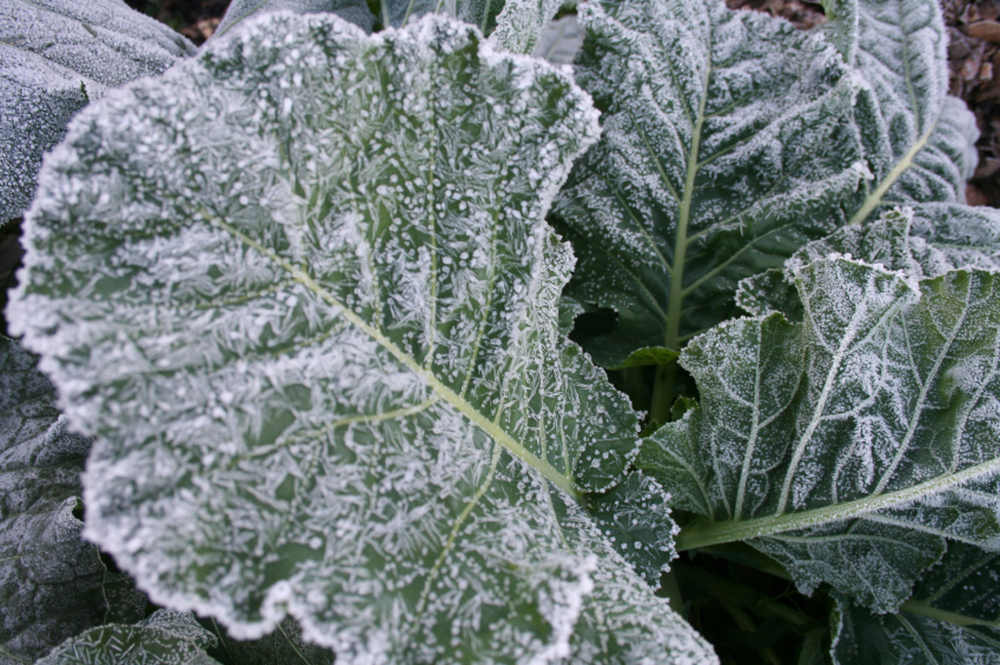
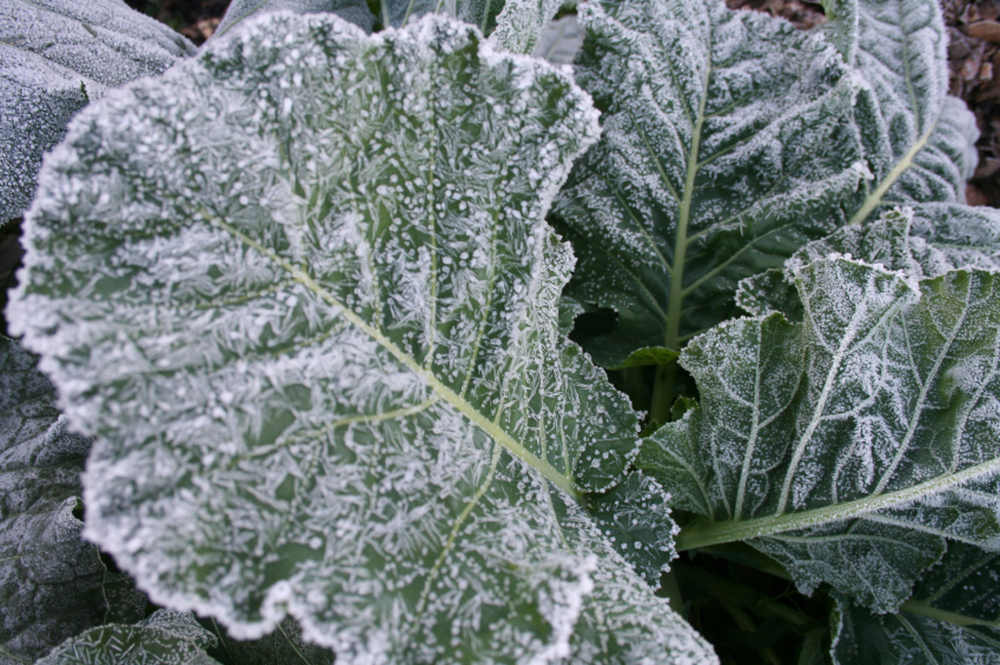
As we move towards sowing time, my inner critic is active again, goading me to get started on work in the veg patch. Every time I look out the window at the veg patch, or visit it to grab a leek or some parsnips for the dinner, it starts up its never-ending critical commentary.
“You really need to get some compost on that bed,” it says. “Look at those weeds, you’d really think you would keep it tidier. That polytunnel needs cleaning and look at the state of the potting shed. You started GIY? Really? You’d think the so-called founder of GIY would be more on top of things in his own veg patch.”
My inner critic, it turns out, is a total pain in the ass.
As a New Year gift to myself, I’ve been reading Aoife McElwain’s excellent new book “Slow at Work” and it strikes me that its principles could apply not just to my work life, but to my veg patch life too.
I am constantly beating myself up about what’s to be done out there, rather than cutting myself a break or, God forbid, praising myself for how much I’ve actually managed to grow. I’ve done very little in the veg patch since November, but instead of relishing the break, most of the time I just feel guilty.
Aoife’s book promises to show us how to “work less, achieve more and regain our balance in an always-on world”. It’s a promise I think most of us could really latch on to in these frenetic times. It’s a fascinating book that explores the cult of busyness, the imposter syndrome and the problems of procrastination.
The phrase “I’ve been beating myself up” is a really interesting one. It points to the strange duality that’s the core problem of the human experience. Who exactly is it that’s beating me up? Is it me? Creating a tiny little bit of distance between you (the experiencer of life), and your inner critic (that constant inner monologue) is one of the healthiest things you can do for your mental health and all-round happiness.
Just being able to notice or watch the critic, to catch it out – is usually enough to be able to stop identifying with it so much. After a while you realise your inner critic is actually kind of a moron. It’s like the worst type of bullying boss – hyper critical and repetitive, often sulky, whiney and childish. Never giving you a break, always saying the same dumb stuff, time and time again.
If you’ve already broken your new year’s resolution, how about trying this: get to know your inner critic. Start listening out for it and watching its patterns. Don’t identify with it so much or take it so seriously.
The first time you find yourself smiling at your inner critic you will know you’ve made significant progress. As for me, I’m staying out of the veg patch for another few weeks. My inner critic is not happy about it, but then again, he never is.
Slow at Work by Aoife McElwain is €12.99 and available from Gill Books.
Things to Do this Month
To Do
Turn over the soil only if the weather is dry – if the soil sticks to your boots it’s too early for digging! Keep off the soil to prevent soil compaction - use timber planks to stand on for access. If you have not already done so order/buy your seeds, spuds and onion sets. “Chit” or sprout seed potatoes – put them in a container (e.g. used egg carton or empty seed tray) and leave them in a bright warm place. Check the pH of your soil – you can buy a soil pH testing kit in any garden centre. Lime your soil now if required (to reduce acidity in very acid soils), particularly important in your brassica bed.
Sow
Finally, we can sow some seeds. On a sunny windowsill indoors, in a heated greenhouse or on a heating mat: sow celery, globe artichokes, celeriac, leeks, onions, lettuce, tomatoes, peas, aubergines, peppers/chilli-peppers. In polytunnel or greenhouse: beetroot, Brussels sprouts, summer and autumn cabbage, carrots, leeks, lettuce, radish. Outside: Weather permitting you can try planting out broadbeans, spinach, kohlrabi, onion and shallot sets, Jerusalem artichokes, parsnip and early pea varieties.
Harvest
Winter cabbage and cauliflowers, Brussels sprouts, spinach, kale and leeks.
The Basics – How to Hoe
Speaking of new skills. Learning how to hoe properly is one of the most useful skills I’ve acquired in the veg patch – it’s the ultimate labour and time saving device.
I wouldn’t be able to keep on top of my veg patch weeds without it. Hoeing is 8 times faster than pulling weeds, apparently. I would love to have been at the trial where they established that fact.
Ideally you want to hoe to prevent weeds as opposed to having to get rid of them. Although you may have to pull weeds if they get well established, it's preferable not to have to, since it upsets soil structure and fertility. Far better to hoe weeds which basically dislodges the roots and forces them to die - they then rot down and add to soil fertility.
From April to September run over the entire patch with a hoe each week - its enjoyable work if you do it right, standing upright with a long-handled hoe and moving it forward and back just beneath the soil surface.
Try to hoe when the soil is dry. Weeds are more likely to take root again in wet soil. It’s good to redouble your hoeing efforts at two times of the year – (1) go in to the winter with a clean patch and (2) in spring, don’t let weeds get established.
Mulch and green manures will prevent weeds from becoming established, as will coverings of mypex, plastic etc. Also important to keep the grass around your patch short - otherwise it’s a great seeding environment for weeds.
Recipe of the Month – Celeriac, Kale and Apple Broth
Hugh Fearnley Whittingstall’s excellent first book River Cottage Veg Everyday is the most used cook book in our house, packed with user-friendly delicious veg recipes. As a result, his new book River Cottage Much More Veg is on my must-acquire list. This is a new recipe from it – a timely, warming, nourishing celeriac, kale and apple broth. Serves 4-6
Ingredients:
• 50g pearl barley or pearled spelt
• 2 tbsp olive or rapeseed oil
• 1 onion, chopped
• 2 garlic cloves, chopped
• ½ small celeriac (about 250g), peeled and cut into roughly 1cm cubes
• 1 litre hot veg stock (see page 190 for home-made)
• 150g curly kale or cavolo nero, leaves stripped off the stalks and roughly shredded
• 5–6 sage leaves, sliced into fine ribbons
• 2 medium eating apples, quartered, cored and chopped into roughly 1cm cubes
• Sea salt and black pepper
• Extra virgin olive or rapeseed oil, to finish
Directions
Put the pearl barley or spelt to soak in cold water while you prepare the vegetables.
Heat the oil in a large saucepan or small stockpot over a medium heat. Add the onion and garlic with some salt and pepper. When everything is sizzling, turn the heat down low, cover the pan and let the veg sweat, stirring once or twice, for about 10 minutes.
Meanwhile, rinse the barley or spelt well. Add the barley or spelt to the pan with the celeriac. Sauté, stirring, for 2–3 minutes, then pour in the hot stock.
Bring to a simmer and cook, partially covered, until the grain is almost tender (about 15 minutes for spelt, 25 minutes for barley).
Stir in the shredded kale and sage and bring back to a simmer. Cook for 5 minutes, then add the cubed apple and cook for a further 2 minutes only.
Remove from the heat, taste the soup and add more seasoning if needed.
Ladle the soup into warmed bowls and finish with a trickle of extra virgin oil and a grinding of black pepper, then serve.
GROW HQ
Visit the home of the GIY movement, GROW HQ in Waterford for a range of classes and courses on growing and cooking food. Our plot-to-plate café and bistro, just 110 paces from the veg patch, won the Farm to Plate award at the Food & Wine Awards and Local Food Hero at the Irish Restaurant Awards. Open 7 days from 9am to 5pm and serving evening meals from Thursday to Saturday. www.growhq.org.
Become a VIPea
By joining GIY you help us to continue the work of supporting people just like you to grow food at home, at school, in the workplace and in the community – this year we will support over 500,000 people and 9,000 community food growing groups and projects. It costs just €35 to join GIY for a year, and to say thanks we will send you a seasonal copy of our supporter’s magazine GROW and some GIY seeds for you to sow each quarter. It will also entitle you to a 10% discount at GROW HQ and our online shop. Join today at www.GIY.ie.
About GIY

GIY is a not-for-profit organisation that aims to create a healthier, more sustainable world where people grow their own food. We inspire and support people to grow food more successfully by bringing them together to share advice, tips and ideas. There are approximately 65,000 people involved in the GIY movement in Ireland, which is proudly supported by Woodies DIY.
For more information check out www.giyireland.com
Michael Kelly is a freelance journalist, author and founder of GIY Ireland.
© GIY Ireland 2018 – all rights reserved.
Grow It Yourself - March
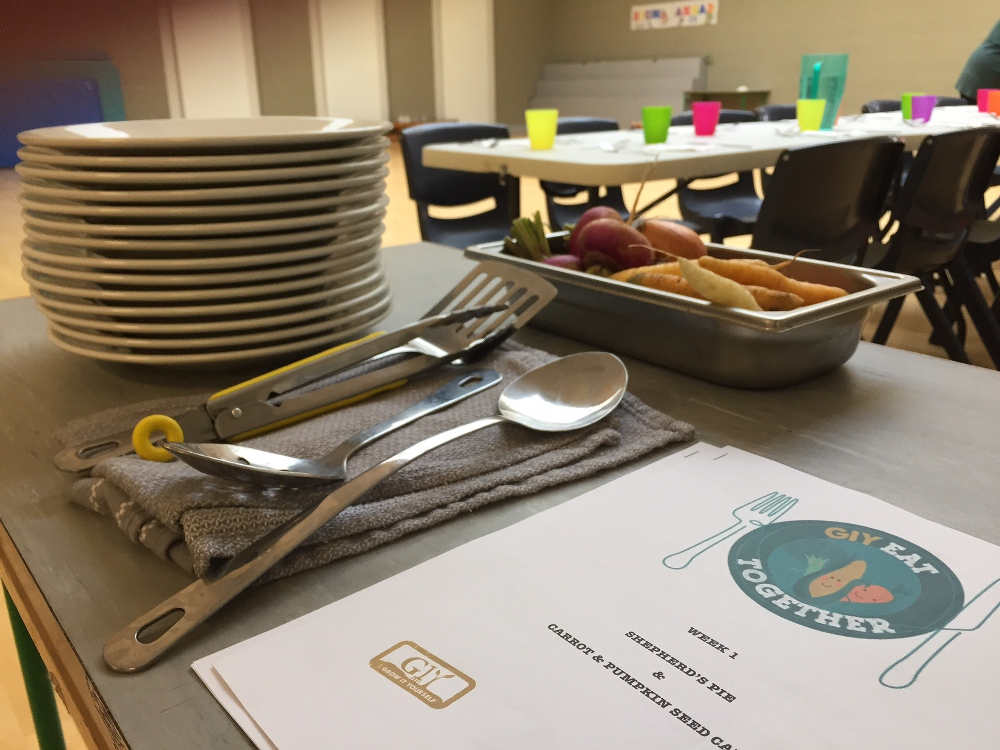

There’s a great scene from Michael Moore’s 2015 documentary Where to Invade Next that focuses on school dinners. He visits a small rural town in France and goes to the ‘best place to eat in town’ – the local school’s cafeteria. In France, they consider school lunch to be part of the teaching day.
The children spend a full hour where they learn how to eat in a civilized, relaxed manner and enjoy healthy food. In the film, the children dine on scallops to start, chicken or lamb skewers on cous cous for mains, a dessert and even a cheese course (bien sûr!). With such a grounding in social eating, it’s little wonder that the French have such a healthy attitude to and knowledge about food.
Earlier this year, the Chairperson at Tramore Educate Together came across Moore’s documentary. Corinne is French, so it resonated with her, particularly since she now lives in a culture where school lunches are about wolfing down a sandwich in ten minutes before running out to play. She sent it on to my wife, who is principal at the school, and it got us all thinking. Could we hatch a plan to achieve something similar?
The result was a social eating programme called Eat Together, which we’ve now delivered at four schools in Waterford. Since very few primary schools in Ireland have canteen facilities, we had the idea to send the lunches from our restaurant (GROW HQ) instead.
Once a week for a 6 or 8 week period, we deliver to the school a delicious, 2-course hot lunch from a menu plan prepared by our Head Chef JB Dubois. The school agree to schedule it in as a lesson (before the lunch break), and we provide the teacher with a lesson plan to weave it in to the curriculum. The children eat together at long tables to encourage them to talk to each other and, as in the French school, they eat from proper plates/bowls and use real cutlery. We talk about the food they are eating, where it has come from, and how it was produced or grown. They talk about texture and flavour, what veg they can identify in the meal, what they like and what they don’t.
The menu changes every week, but it’s always proper hearty, in-season food. We could have a little veg quiche or tartlet to start, followed by shepherd’s pie or chicken casserole for mains. If dessert is on the menu we generally sneak some veg in there too. A beetroot brownie, or carrot cake.
The children bring the menus home so they can cook it at home with their families if they so wish. Feedback from children, parents and teachers has been overwhelmingly positive – over 90% of parents would like the programme to continue and are willing to pay for it themselves. They tell us it helps to make their children more interested, curious and knowledgeable about food.
We’ve seen even the pickiest eaters become more willing to try things, when they are surrounded by their peers who are getting stuck in. Above all though, it’s a chance for children to view food as a sociable, enjoyable occasion – rather than a quick re-fueling.
A recent Safefood Ireland study found that the total lifetime cost of childhood obesity in Ireland is estimated at €7.2billion (that’s not a typo), so it’s clear that radical thinking on food education is needed.
A programme like Eat Together could be part of the solution, and it’s worth noting that the government is already funding lunch deliveries to DEIS schools to the tune of €48m annually. In the meantime, we’re actively looking for partners to help us roll Eat Together out further around the country. Get in touch if you want to get involved.
The Basics – Sowing Celeriac
Grow celeriac as you would with celery, but because it stores well, there’s no need for succession sowing. A single sowing in late March or early April is all that’s required. Broadcast (sprinkle liberally) the seed in to a pot filled with seed compost. As is the case with celery, celeriac seeds need light to germinate so do not cover the seed with compost. Place the pot somewhere warm (a sunny windowsill or a heating mat) – it’s slow to germinate so don’t expect any action for two to three weeks. Keep the compost moist. Prick the seedlings out in to module trays (one seedling per module) about 2-3 weeks after germination (when about 3cm tall).
GROW HQ Courses in March
The teaching team are busy this March at GROW HQ. Join our horticulture therapist Caitriona Kelly for “Step in to Social and Therapeutic Horticulture” (March 10th); Head Chef JB Dubois for a masterclass on Brunches (March 15th, €25); Michael Kelly for his popular Beginners Guide to Growing Course (March 24th); and Head Grower Richard Mee for a full day course called Spring in the Garden (March 31st). For kids we have our Easter Camp (26th to 29th) and our Junior Cookery Club on March 25th. For more details visit shop.giy.ie.
Things to do this Month - March
To Do
Continue to prepare ground – there is still time to prepare a plot to grow veg this year. Fork or rake over existing beds, breaking up large clods of earth. Cover new seedlings with fleece if a frost is due. Start your daily slug patrols and lay beer traps. Don’t let new-season weeds take over – get on top of them with weekly hoeing.
Sow
Indoors: lettuce, aubergine, peppers, cucumbers, celery, celeriac, sweet corn, basil, leeks, summer cabbage, cauliflower, Brussels sprouts, parsley, courgette, French beans.
Sow outdoors or under cover: broad beans, red cabbage, carrots, cauliflower, spinach, kale, Brussels sprouts, onions, leeks, turnip, peas, radishes, early lettuce, asparagus. Plant your first early seed potatoes, as soon as weather conditions allow.
Harvest
This month you could be enjoying (from the ground and from storage) onions, leeks, parsnips, potatoes, some varieties of lettuce, mint, sprouting broccoli, kale, rhubarb, chard, the first of the spring cauliflowers and cabbage, and spinach (perpetual, spinach beet).
Recipe of the Month – Traditional Shepherds Pie
This recipe from our Head Chef at GROW HQ (JB Dubois) is one of the main courses from the EAT Together pgoramme. In the olden days, meat pies were done with left over stew and not with mince. The reheated stew was then topped with pastry or with mash potato (more traditional in Ireland). The diced lamb gives this a fantastic texture, and it’s full of in-season vegetables – garlic, carrots, parsnips and onions.
Ingredients
• 500g diced lamb
• 4 large tomatoes or 1 small tin of chopped tomatoes
• 2 garlic cloves
• 2 medium carrots
• 1 parsnip
• 1 large onion
• chopped rosemary leaves
• 200 ml good homemade chicken stock (made from the left-over bones of a roast chicken)
• pinch of salt
• 1 Tbsp cooking oil
• 700g nice buttery mash potato to cover the top
Directions
Fry off the diced lamb with a little cooking oil in a wide stock pot for 5 to 6 minutes until golden brown. Peel and slice the vegetables. Add the vegetables to the meat and fry off for 3 to 4 minutes.
Add the chopped garlic, rosemary and salt. Add the chopped tomatoes and the chicken stock and simmer on low heat for 2 to 3 hours until the meat start to become flaky. Pour the lamb stew into a pie dish, cover with mash potato and bake at 150 degrees celsius for 45 minutes.
GROW HQ
Visit the home of the GIY movement, GROW HQ in Waterford for a range of classes and courses on growing and cooking food. Our plot-to-plate café and bistro, just 110 paces from the veg patch, won the Farm to Plate award at the Food & Wine Awards and Local Food Hero at the Irish Restaurant Awards. Open 7 days from 9am to 5pm and serving evening meals from Thursday to Saturday. www.growhq.org.
Become a VIPea
By joining GIY you help us to continue the work of supporting people just like you to grow food at home, at school, in the workplace and in the community – this year we will support over 500,000 people and 9,000 community food growing groups and projects. It costs just €35 to join GIY for a year, and to say thanks we will send you a seasonal copy of our supporter’s magazine GROW and some GIY seeds for you to sow each quarter. It will also entitle you to a 10% discount at GROW HQ and our online shop. Join today at www.GIY.ie.
About GIY

GIY is a not-for-profit organisation that aims to create a healthier, more sustainable world where people grow their own food. We inspire and support people to grow food more successfully by bringing them together to share advice, tips and ideas. There are approximately 65,000 people involved in the GIY movement in Ireland, which is proudly supported by Woodies DIY.
For more information check out www.giyireland.com
Michael Kelly is a freelance journalist, author and founder of GIY Ireland.
© GIY Ireland 2018 – all rights reserved.
Grow It Yourself - April
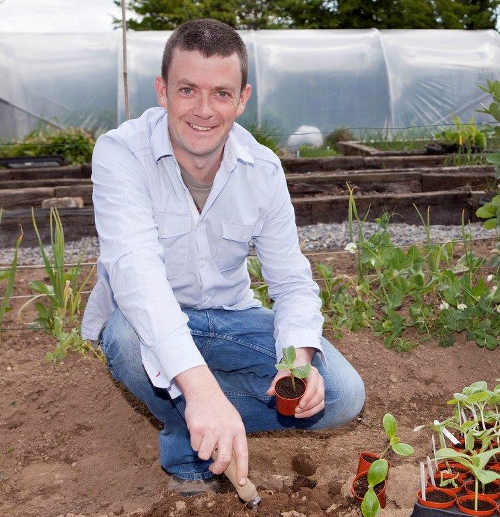
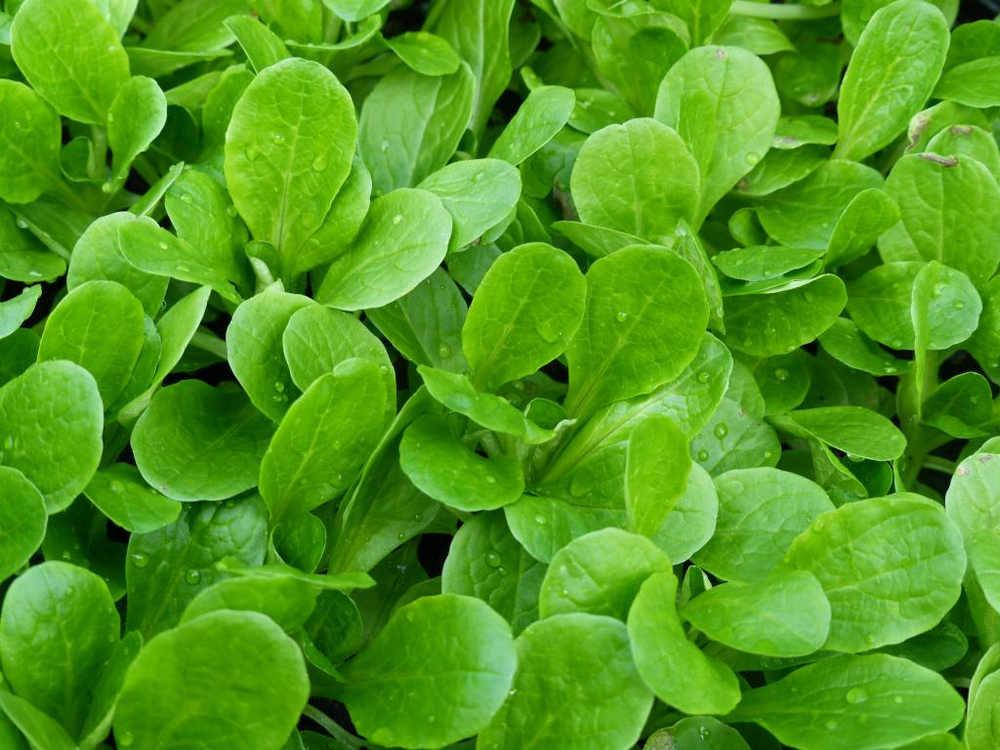
It is fair to say that it has been a long and thoroughly miserable winter, with almost 6 months of grim weather at this stage. The impact has been minimal enough for the home-grower but we should of course spare a thought for the people who make a living from food production, particularly commercial growers and farmers.
For the commercial grower the hungry gap (the gap between the last of last year’s produce and the first new-season produce) is always tortuous but it will be even longer this year, as it has simply been too cold to get sowing.
For farmers, livestock would typically be enjoying life on open grass by now, but with sodden fields and no grass growth, they have been forced to keep animals indoors. The knock on effect, as we’ve been hearing, is a shortage of fodder with a real risk of animals starving to death if they run out.
You only have to see the joy of farm animals being let out on to grass for the first time in spring, to know they don’t enjoy being in the sheds as much. After a hard winter, the arrival of spring grass growth, warmer temperatures and longer days changes the whole dynamic of farming. One can only imagine how distressing its delay must be for the farming community.
Though we’re certainly not out of the woods yet there are at least some signs that spring is taking hold. You can see and hear glimpses of it all around. Birds singing their morning chorus, buds forming on the trees, a small amount of grass growth. Everywhere seems just a shade greener. If the temperatures hold up, that should all accelerate in the week ahead. Fingers crossed.
Though we’re a long way off any major harvesting, we are enjoying the first new season greens from the polytunnel here at home now. Up to now the salad bowl has been reliant on the fabulous winter green, claytonia (or Miner’s lettuce) which I sowed late last autumn. But it is now joined by some baby pak choi, red mustard and mizuna.
I find that my system is craving fresh greens after a long winter. Incidentally with the pak choi, I am harvesting them as baby leaves, rather than waiting for them to heart up – I’m too impatient for that. I just chop them and steam them over some boiling water for a few minutes and they are delicious. Add some seasoning or a little chopped chilli if you want.
I’ve been taking advantage of longer evenings to get some work done. I’ve planted my spuds, though I fret the soil was too cold. I am hoping to do the onions this weekend. Last evening I planted out some beetroot that I sowed on heat in the potting shed in January, and they should be ready to start eating in about 3 weeks time.I’ve also just transplanted some spinach in to the tunnel.
Tomato plants that were sown in February have been transplanted in to module trays and have really taken off in the last week aided by the warmer days. I am already wondering whether I will have to pot them up in to pots or get away with planting them directly in to the polytunnel from there. I hope it’s the latter.
I transplanted chillipeppers from their pots in to individual modules in a module tray – they are slow growing, and will be happy there for at least another 6 weeks.
The Basics – Transplanting Celery and Celeriac
Celery and celeriac are grown the same way, and look very similar at seedling stage, but their paths diverge dramatically later on – celery is eaten of course for its lovely stem (and the leaves if you want), but celeriac is a swollen root, more like a celery-flavoured turnip in shape and size. I grow both.
Whereas celery is sown several times in the year (between March and May) for succession, celeriac is sown just once in March or April.
I am trying two different approaches to sowing celeriac this year.
1. Sprinkle seeds in a 10cm pot of potting compost. After they germinate, but before they get too big, transplant in to module trays to grow on
2. Sow them direct in the module trays
Both have germinated at this stage, and I have yet to transplant the pot-sown ones. It will be interesting (in a nerdy, not very interesting way) to see which does better. Obviously the latter approach would be far easier if it works.
In each case, don’t forget that celery and celeriac seeds like light so don’t cover the seeds with compost after sowing. You could add a small shallow layer of vermiculite (which is slightly transparent and allows light through).
Recipe of the Month – Pearl Barley and Greens Broth
This is great comfort food, and brilliant for you – a really tasty way to get a fill of green leaves. It’s also classic hungry gap food – using some of the new season leaves and some store cupboard or freezer ingredients.
Very good served with some sourdough, crusty bread to mop up those juices. The vegetable stock is best if it’s home-made but if you are using a cube, try and make it an organic one.
Ingredients:
• 100g pearl barley
• 200g frozen peas
• 2 carrots, finely diced
• 700ml vegetable stock
• A large handful of greens (e.g. spinach, chard, kale, tat soi or pak choi – or a mix) – remove large stalks and chop roughly
• Tin of cannellini beans
Directions:
Bring the vegetable stock to the boil in a large pan and add the pearl barley. Reduce the heat to simmer for about 20-30 minutes until the pearl barley is cooked and tender. Add the frozen peas, carrots and beans to the pan and bring back to the boil. Pop in the greens and cook for another 2-3 minutes. Serve immediately in to bowls.
The GIY TV series GROW COOK EAT is on Wednesdays on RTE 1, presented by Michael Kelly and Karen O’Donohoe. www.growcookeat.ie
GROW HQ
Visit the home of the GIY movement, GROW HQ in Waterford for a range of classes and courses on growing and cooking food. Our plot-to-plate café and bistro, just 110 paces from the veg patch, won the Farm to Plate award at the Food & Wine Awards and Local Food Hero at the Irish Restaurant Awards. Open 7 days from 9am to 5pm and serving evening meals from Thursday to Saturday. www.growhq.org.
Become a VIPea
By joining GIY you help us to continue the work of supporting people just like you to grow food at home, at school, in the workplace and in the community – this year we will support over 500,000 people and 9,000 community food growing groups and projects. It costs just €35 to join GIY for a year, and to say thanks we will send you a seasonal copy of our supporter’s magazine GROW and some GIY seeds for you to sow each quarter. It will also entitle you to a 10% discount at GROW HQ and our online shop. Join today at www.GIY.ie.
About GIY

GIY is a not-for-profit organisation that aims to create a healthier, more sustainable world where people grow their own food. We inspire and support people to grow food more successfully by bringing them together to share advice, tips and ideas. There are approximately 65,000 people involved in the GIY movement in Ireland, which is proudly supported by Woodies DIY.
For more information check out www.giyireland.com
Michael Kelly is a freelance journalist, author and founder of GIY Ireland.
© GIY Ireland 2018 – all rights reserved.
Grow It Yourself - May
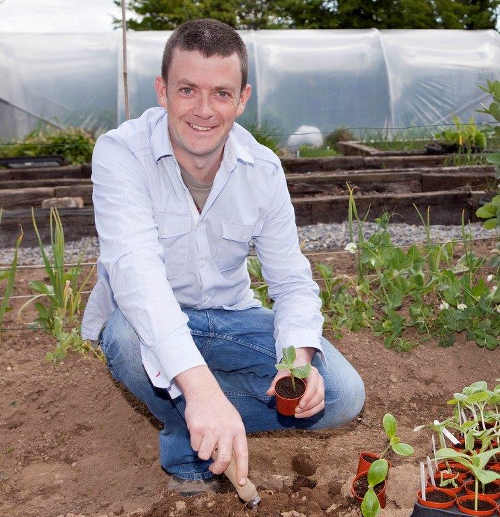

It’s a nice surprise to discover that what you have considered a real nuisance in the veg patch, could in fact turn out to be a blessing. I’ve been plagued with chickweed for well over a year now in the small polytunnel. God knows how it got in there, but clearly I unwittingly let some of it go to flower, and the result has been a persistent, interminable weed problem.
It’s a formidable foe with each flower being self-fertile and each seed pod producing up to 2,500 seeds. Once it starts to grow, it is rampant and has an extensive root system that makes it hard to knock back. Annoyingly, it seems to thrive and particularly enjoy growing right beside other seedlings making it even harder still to get at.
I covered the soil in the tunnel down with black polythene for 5 months this winter in the hopes of getting rid of it once for all, but it’s back with a vengeance again in the last few weeks. I recently read that its seeds can lie dormant in soil for 4 years. Persistent hoeing is the only way I can seem to stay on top of it, and that’s all I seem to be doing – staying on top of it, rather than getting rid of it.
Thankfully there are upsides to chickweed. Firstly it is a sign of fertile soil, so I suppose you can console yourself with that fact as you weed it. Secondly, not only is it edible, it’s considered to be (to use that awful phrase) a nutritional powerhouse.
This is good news indeed since I regularly find it in the salad bowl in among the oriental greens, among whom it grows happily in the tunnel. The leaves have a mild flavour and can be used by adding them raw to salads and sandwiches.
They can be tossed into soups and stews as well. Check out the soup recipe below which uses fresh chickweed soup to bring colour and flavour to a standard veg soup. Though I am always somewhat skeptical about so called superfood health claims, it can apparently be used to reduce inflammation and relieve gastrointestinal problems (yes, but in what quantities?). Still, the fact that its edible gives some meaning to my persistent battle against it.
You can recognize chickweed by its oval leaves, starry white flowers and if you pull the stem apart you find a second elasticated stem inside – our kids love that.
 The Basics – Getting Ready for Carrots
The Basics – Getting Ready for Carrots
Carrots are fussy and they need a deep, fertile soil to do well. Think about the length of a decent carrot and ask yourself the question - are these seeds going to be able to push down in to my soil and turn in to a nice, long carrot? If it’s heavy and stony, they probably won’t. So ideally, the soil should be in decent nick up to a spades depth. That means they are one of the only parts of the garden where I do a good bit of work on the soil prior to sowing.
I turn the soil in the carrot bed over with a fork about 3-4 weeks before sowing – so around now is good for me, since I will usually sow my main crop carrots at the end of May. Though this might seem late for a main crop carrot sowing, I find germination far more reliable (and carrot root fly far less a problem) if I wait until then. Also, since I am primarily interested in having carrots as a late autumn / early winter crop to be eaten straight from the soil, I really don’t want them ready too early.
Using the fork I break up any big clumps of soil, and then I leave it settle for a few weeks. Then about a week before sowing, I will get in there and get the bed ready for those tiny carrot seeds. A key mistake that people make when sowing carrots is that they don’t have a fine seed bed, and the carrot seeds end up being too deep or too shallow to germinate. Raking over and back does an amazing job of breaking up the larger clods of soil, and getting a really fine tilth. I also add a general purpose organic fertilizer (a handful of seaweed dust per square yard would do the trick).
Recipe of the Week – Chickweed Soup
Have your revenge on chickweed by making a tasty, nutritious soup. This recipe is from Ciaran Burke’s Blooms n’ Food blog. www.bloomsandfood.com. Serves 4.
Ingredients:
• 1 medium onion
• 2 small potatoes
• 1 Litre of chicken or vegetable stock
• 2 good handfuls of chickweed, pulled from the garden, only use fresh green growth which has not flowered
• Water
• A good knob of butter and some olive oil
• Salt and Black pepper
Directions:
Peel and finely dice the onion. Peel and finely dice the potatoes. Remove any big stalks from the chickweed and wash well. I find if you fill a sink with clean cold water and dump the chickweed in, any soil or dirt will settle to the bottom of the sink. You can then scoop the leaves from the water, leaving the dirt behind.
Melt the butter in some olive oil in a large saucepan. Saute the onion until soft and golden but do not let it burn. Add the diced potatoes and stir in the oil for a couple of minutes. Now add a little water, enough to cover the potatoes and simmer until the potatoes are soft. Then add the chicken stock and cook until it is boiling.
Throw in the chickweed leaves and simmer for about ten minutes. Season with salt and pepper. Remove pan from the heat and use a hand blender to blend the soup.
GROW HQ
Visit the home of the GIY movement, GROW HQ in Waterford for a range of classes and courses on growing and cooking food. Our plot-to-plate café and bistro, just 110 paces from the veg patch, won the Farm to Plate award at the Food & Wine Awards and Local Food Hero at the Irish Restaurant Awards. Open 7 days from 9am to 5pm and serving evening meals from Thursday to Saturday. www.growhq.org.
Become a VIPea
By joining GIY you help us to continue the work of supporting people just like you to grow food at home, at school, in the workplace and in the community – this year we will support over 500,000 people and 9,000 community food growing groups and projects. It costs just €35 to join GIY for a year, and to say thanks we will send you a seasonal copy of our supporter’s magazine GROW and some GIY seeds for you to sow each quarter. It will also entitle you to a 10% discount at GROW HQ and our online shop. Join today at www.GIY.ie.
About GIY

GIY is a not-for-profit organisation that aims to create a healthier, more sustainable world where people grow their own food. We inspire and support people to grow food more successfully by bringing them together to share advice, tips and ideas. There are approximately 65,000 people involved in the GIY movement in Ireland, which is proudly supported by Woodies DIY.
For more information check out www.giyireland.com
Michael Kelly is a freelance journalist, author and founder of GIY Ireland.
© GIY Ireland 2018 – all rights reserved.
Grow It Yourself - June
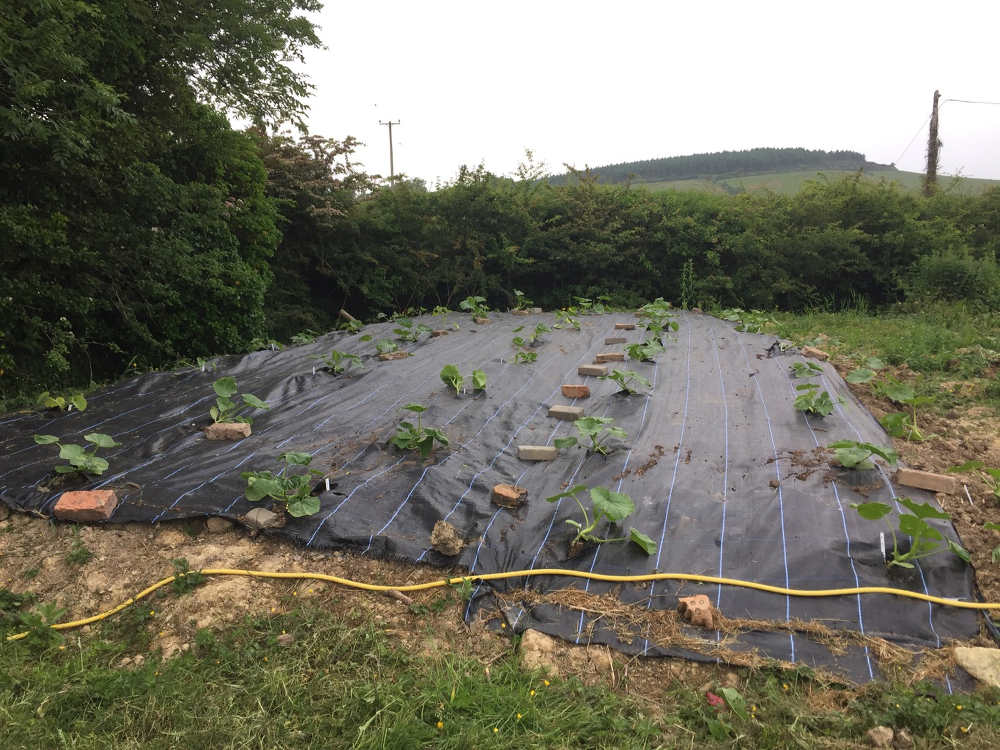

Like most GIYers I did a little rain dance with the arrival of rain after nearly a month of drought conditions. What a fickle bunch we are! Not so long back we were cursing how wet the soil was after nearly 8 months of incessant winter.
Then we seemed to skip spring altogether and bounce straight in to a fantastic summer. Don’t get me wrong, I’d much prefer a little heatwave to our more standard climate, but the daily watering outside was somewhat of a chore.
I suppose that beautiful warm sunshine by day followed by a decent shower of rain at night would be the ideal weather pattern for this time of the year. That’s not much to ask is it?
Things are progressing well in the veg patch. I’ve sowed my main crop carrots – it might seem a little late, but by waiting until now you get quick germination (within a few days, as opposed to 2-3 weeks it can take when you sow them back in April or May).
Unusually, parsnip germination was really poor this year. I used new seed as I always do (with parsnip seeds being notoriously perishable) so I think it was the dry weather that perhaps dried the seed out. I am going to try re-sowing even though it’s probably too late, but at least I might have some smaller roots to eat in the winter.
In the potting shed I am still nursing along the important winter/spring brassicas – purple sprouting broccoli and Brussels sprouts. These have been planted in to larger pots now to get them really big and hardy before exposing them to the various pests that love to munch them – pigeons, slugs, caterpillars and so on. I also planted out all my peppers (mix of bell and chilli) in the smaller tunnel this week.
We managed to plant out about 70 of the pumpkin/squash plants I sowed in the area beside the big tunnel in the field beside our house. I had about 30 plants left over which I’ve given in to be sold in GROW HQ. The rain arrived in the nick of time to save me having to water the plants that I planted out. There shouldn’t be much to do with them now, unless dry conditions return.
Tomatoes are progressing well in the tunnel, with side shooting the main job at this stage. It’s amazing how quickly the side-shoots grow. Our neighbour Bridget who helps us out in return for some fresh veg comes once a week earlier in the week to do it, and then I do it again at the weekend. It’s a small price to pay for having really productive plants.
We’re only a few days away from the first courgettes from the two plants I put in the big tunnel. The outside-sown ones are a couple of weeks away still. We’ve been harvesting broad beans for weeks now from outside, and beetroot and calabrese (broccoli) from the small tunnel.
We’ve also an abundance of leaves (lettuce, oriental greens, kale, spinach and chard) and our first strawberries. New potatoes are not quite ready yet, but I will probably try the first harvest in a week or so.
As we move in to summer, it’s important to keep sowing to make sure you extend your harvesting year. A lot of GIYers believe it's too late to sow seeds for this year. In fact there are still loads of vegetables that you can sow from seed including: beans (French and Runner), kale, pea, spinach, spinach beet, summer broccoli, carrot, swede, leek, lettuce, Brussels sprouts, beetroot, chicory, endive, turnip, kohlrabi, fennel.
You may also be able to get your hands on the following as seedlings or small plants in your local garden centre (or indeed the GIY shop): leeks, Brussels Sprouts, cabbage, autumn cauliflower, calabrese, sprouting broccoli, celery, celeriac, cucumbers, pumpkin, marrows, runner beans, aubergine.
The Basics – Growing Good Aubergines
I sometimes think that aubergines are easy to grow, but hard to grow well if you know what I mean. I find the plants easy to raise, but it’s a harder job to get good fruit. At this stage you should have plants ready for planting out (or you could buy them in a garden centre). You can either plant them out in a greenhouse or polytunnel (spacing is 40cm for standard varieties) or grow them in a 20cm pot in good potting compost.
Aubergines like some humidity so you can place some buckets of water between plants so there is some evaporation happening near them. Removing the growing point of the main stem when the plant is about 25cm high will help to encourage the plant to produce fruit on the side shoots. Once you have about 5 good fruits per plant developing, remove excess side shoots and new flowers. Water well and feed every two weeks with a liquid feed (tomato feed or comfrey tea).
Recipe of the Week – Broad Bean and Mint Bruschetta
The mint and broad beans combine really well to give a lovely, fresh summer recipe with a slightly decadent feel.
· 250g cooked broad beans
· Handful grated parmesan plus a few shavings, to finish
· A couple of slugs extra-virgin olive oil
· A small bunch of mint, leaves only, chopped
· 1 garlic clove, halved
· 1 French stick or small ciabatta, cut into 8 thin slices and toasted
Directions:
Put the cooked broad beans in a bowl and lightly crush. Season, then mix in the grated parmesan, mint and a slug of olive oil. Rub the slices of toasted bread with the garlic. Top with the broad bean mix, drizzle over a little more oil and finish with parmesan shavings.
GROW HQ
Visit the home of the GIY movement, GROW HQ in Waterford for a range of classes and courses on growing and cooking food. Our plot-to-plate café and bistro, just 110 paces from the veg patch, won the Farm to Plate award at the Food & Wine Awards and Local Food Hero at the Irish Restaurant Awards. Open 7 days from 9am to 5pm and serving evening meals from Thursday to Saturday. www.growhq.org.
Become a VIPea
By joining GIY you help us to continue the work of supporting people just like you to grow food at home, at school, in the workplace and in the community – this year we will support over 500,000 people and 9,000 community food growing groups and projects. It costs just €35 to join GIY for a year, and to say thanks we will send you a seasonal copy of our supporter’s magazine GROW and some GIY seeds for you to sow each quarter. It will also entitle you to a 10% discount at GROW HQ and our online shop. Join today at www.GIY.ie.
About GIY

GIY is a not-for-profit organisation that aims to create a healthier, more sustainable world where people grow their own food. We inspire and support people to grow food more successfully by bringing them together to share advice, tips and ideas. There are approximately 65,000 people involved in the GIY movement in Ireland, which is proudly supported by Woodies DIY.
For more information check out www.giyireland.com
Michael Kelly is a freelance journalist, author and founder of GIY Ireland.
© GIY Ireland 2018 – all rights reserved.
Grow it Yourself - August
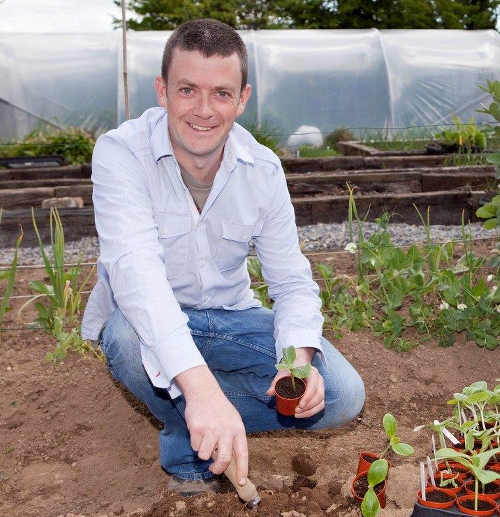
 One of the great lessons I’ve learned in my time as a GIYer is that the sowing season doesn’t stop at the end of Spring. In fact, if you want a consistent supply of vegetables over the winter, and particularly in the difficult “gap” months of March, April and May, then this is a crucially important time of the year to be sowing seeds.
One of the great lessons I’ve learned in my time as a GIYer is that the sowing season doesn’t stop at the end of Spring. In fact, if you want a consistent supply of vegetables over the winter, and particularly in the difficult “gap” months of March, April and May, then this is a crucially important time of the year to be sowing seeds.
The great market gardener Jim Cronin told me once that we should be almost as busy with sowing in August as we are in the spring. The greenhouse/polytunnel should be as resplendent with seed trays at this time of the year as it was back in March.
Rather than see this as a chore, I actually love this shift in emphasis so late in the season. The last two months have been all about harvesting and lately I’ve been getting this feeling that the GIY year was about to start it’s inexorable decline towards autumn and winter. But before we start feeling all autumnal, we have a reprieve and we’re back to the wonderful world of potting compost, seed trays, germination and the like. If, for whatever reason, you didn’t get a chance to sow much this year, than here’s your chance for redemption!
When it comes to August sowing, I am thinking about three main categories of vegetables:
1. Winter “salad” greens to supply us with green leaves right through the winter. In this category you can include winter lettuce, lambs lettuce, claytonia, rocket, mizuna, mibuna, French sorrel, chard, endive, parsley, coriander, mustard greens, pak choi and spinach.
2. Quick growing vegetables that will, if sown now, churn out a crop before winter like radish, turnips, baby carrots, baby beetroot and “quick-heading” calabrese. Try and source quick maturing or late season varieties of these.
3. Vegetables that you get in the ground now to provide a crop next spring like spring cabbage, kale and salad onions. Incidentally, also in this category, I will be sowing garlic and broad beans later in the winter. Though it’s too late now to sow purple sprouting broccoli and Brussels sprouts from seed, if you can source a couple of plants from your garden centre, you could chance planting two or three plants of each in your veggie patch.
The Basics – Harvesting Garlic
Knowing when to lift garlic can be a tricky proposition - harvest them too early and the bulbs will be too small, but harvest too late and the bulbs will begin to loose their quality. The old rule is to sow garlic before the shortest day of the year (Dec 21st) and harvest before the longest (June 21st). Some people also do a spring sowing which wont be ready until late July or August.
A good general rule of thumb is to do a test when a third of the leaves on each plant are gone brown. Carefully push back the soil around one plant and have a look at the bulb to check its size. If its too small, put the soil back around it. Lift all your garlic when a half to two-thirds of the leaves are gone brown. Lift carefully and dry on racks in sun (or indoors in wet weather) for two weeks. Hang in plaits.
 Recipe of the Week – Courgette Salad
Recipe of the Week – Courgette Salad
Every year I sow too many courgette plants – we have about 6 plants this year, and while we have a manageable amount of produce from them at the moment, we are only weeks away from being at full blown “glut” stage when we’ll be eating courgettes in pretty much everything – courgette bread anyone? For now we are enjoying small, crunchy pencil-length courgettes in this zingy salad.
Ingredients:
• 2 courgettes
• 3 tbsp olive oil
• 1 tbsp lemon or lime juice
• 1 tbsp honey
• 2 tsp poppy seeds
• 1 small garlic clove , crushed
Grate the courgettes and then toss them with the oil, lemon juice, honey, poppy seeds and the crushed garlic clove. Season to taste. Serve straight away (it gets watery if left hanging around) – makes a lovely accompaniment to barbecued meats.
About GIY
GIY is a not-for-profit organisation that aims to create a healthier, more sustainable world where people grow their own food. We inspire and support people to grow food more successfully by bringing them together to share advice, tips and ideas. There are approximately 65,000 people involved in the GIY movement in Ireland, which is proudly supported by Woodies DIY.
For more information check out www.giyireland.com
Michael Kelly is a freelance journalist, author and founder of GIY Ireland.
© GIY Ireland 2018 – all rights reserved.
Grow It Yourself - September
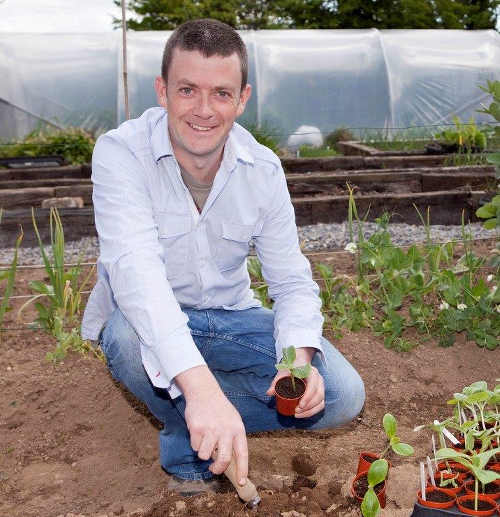
 There’s been a sudden drop in nighttime temperatures which it has to be said can’t be unexpected given the time of year. Still, with the kids back to school as well, it’s a fairly dramatic switch in season from summertime to autumnal.
There’s been a sudden drop in nighttime temperatures which it has to be said can’t be unexpected given the time of year. Still, with the kids back to school as well, it’s a fairly dramatic switch in season from summertime to autumnal.
After a summer of leaving the tunnels and potting shed open in balmy nighttimes, it’s back to a routine of closing them up at night to preserve as much of the daytime heat as possible. It is getting down below 7 degrees Celsius at night now, a temperature that could cause problems for tender salad leaves and tomatoes. Given that slugs have returned with a vengeance after the drought I’m also doing some nighttime slug hunting using the light on my phone to find them. They are particularly a problem in the smaller tunnel, where they are to be found after dark on the chilli plants, spinach (both on a new sowing of annual spinach and on the hardier perpetual spinach) and on salad seedlings. They can also be found occasionally in the potting shed, where they can reek havoc on a tray of emerging seedlings. Recently they munched through an entire, just-germinated tray of lettuce which was destined for the autumn tunnel.
There’s a definite sense of the growth disappearing gradually from the year. Though the winter greens that I sowed a few weeks back in the potting shed are growing, it’s a slower growth than earlier in the year. The trick I think is to ignore that sense of impending winter as much as possible and keep on sowing. This week I sowed some Florence fennel seeds in module trays for the tunnel, some white turnips direct in the ground outside and a green manure in the bed where I took my onions out of.
Thankfully there’s still a sense of abundance to counteract the gathering gloom, particularly in terms of courgettes, tomatoes and cucumbers which are still churning out their fruit at levels that are hard to cope with. I’ve a new outlet for some of this abundance now given that our chef in HQ will take whatever excess I have, and it’s far easier to pop a few courgettes and cucumbers in to the laptop bag to bring in to him rather than process them myself in the kitchen. I worry that this will mean I won’t have my own stash of chutneys, pickles and the like – but in the scheme of things that’s only a minor worry. We’re still busy processing tomatoes mind you which are far too precious to be handing over to anyone. A large bucket of tomatoes comes in to the kitchen every week and gets processed as per below, storing up their luscious sweetness for the long winter ahead.
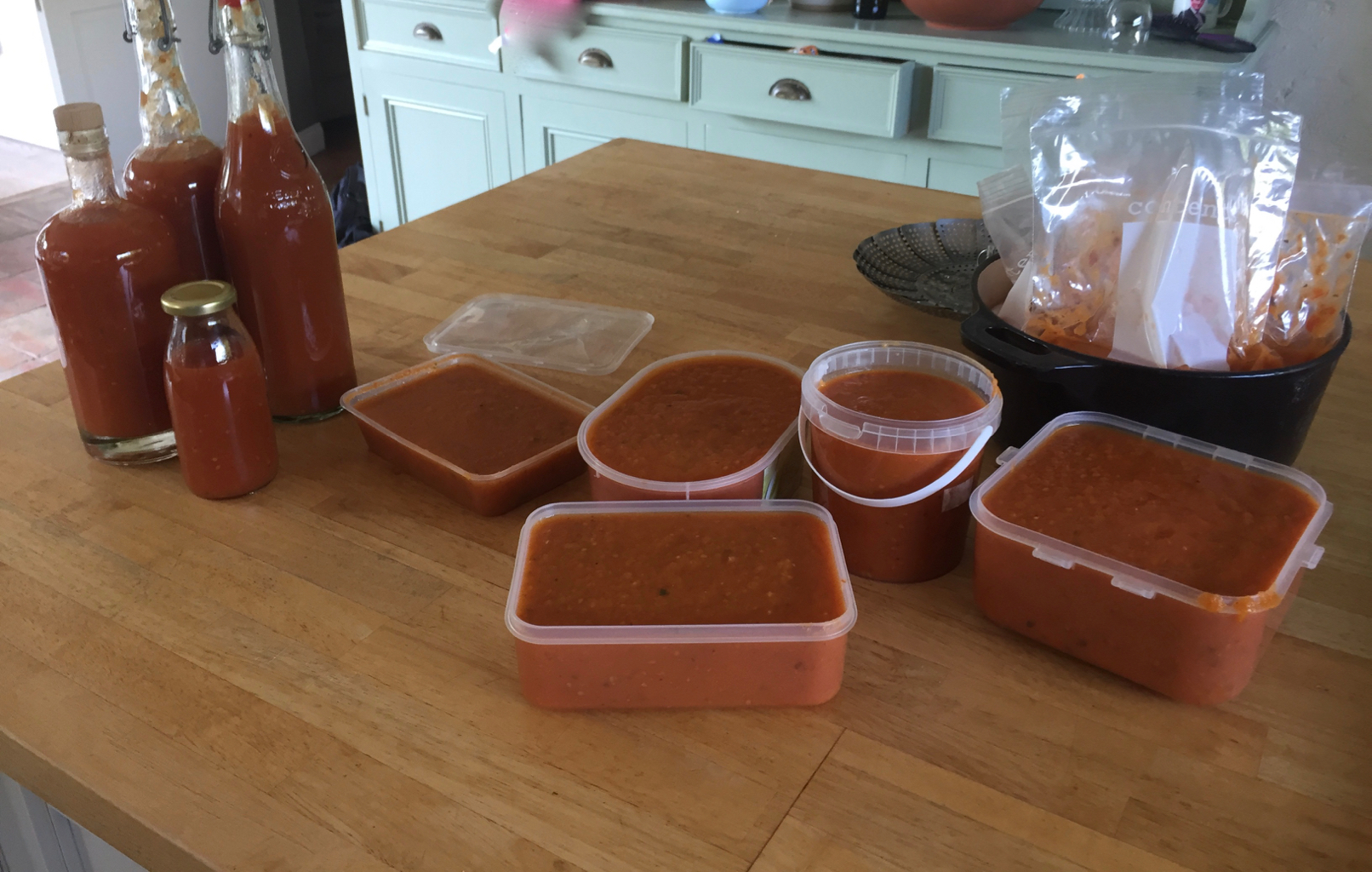 The Basics – Freezing Tomatoes
The Basics – Freezing Tomatoes
Of course tomatoes are amazing to eat fresh, but if you have any serious excess, turning them in to a sauce is a great way to freeze their goodness and flavour. There is a little prep work in the ‘recipe’ below, but nothing too onerous, and it’s a fantastically versatile and delicious sauce to have in the freezer. The basic idea is to bake the tomatoes for 45 minutes in a baking tray with a few other bits and pieces and then blitz them in to a sauce for freezing. We use this sauce as a base for pizzas, pastas, stews, casseroles and soups. It’s even flavourful enough to be used by itself as a soup.
Heat the oven to 180 degrees Celsius. Remove the stalks from the tomatoes. You can chop the bigger ones in halves or quarters, but smaller cherry tomatoes can be thrown in whole. Throw them in to a baking tray as you chop. Roughly chop a medium sized courgette and 2-3 peeled garlic cloves and add them to the tray too. Add a sprig of herbs – rosemary and thyme are ideal – and a splash of olive oil. Season really well with lots of sea salt and freshly ground pepper. Bake in the oven for 45 minutes. Use a hand blender to blitz it all down to a sauce consistency. To save time, I often blitz it right there in the baking tray but it can be a little messy so maybe better to transfer to a saucepan first. Leave to cool completely and then pour in to Tupperware containers or freezer bags to put in the freezer.
Recipe of the Week – Roast Peppers and Tomatoes with Butterbean Mash
A herby, garlicky, warming veggie treat from Nigel Slater. It’s a sinch to put together and celebrates three of the great seasonal veg of the moment – peppers, tomatoes and aubergines.
Ingredients
• 400g small peppers
• 250g cherry tomatoes
• 400g aubergine
• 6 garlic cloves
• 3 large sprigs rosemary
• 5 tbps olive oil
• 2 x 400g cans butterbeans
Directions:
Set the oven at 200C/gas mark 6. Place the peppers, cherry tomatoes and aubergines in a roasting tin. Tuck in the 6 fat garlic cloves, still in their skins, and the rosemary among the vegetables, then spoon over the olive oil. Let the vegetables roast in the preheated oven for about 30 minutes, until they are approaching softness, then push them to one side of the tin and tip the butter beans into the tin. Stir the beans to coat them in oil and roasting juices, then return to the oven and cook for a further 20 minutes until all is soft and golden.
Remove the garlic from the roasting tin and squeeze each clove from its skin into the bowl of a food processor. Tip in the warm beans and process to a thick, fluffy purée. Check the seasoning then pile the purée on to a serving plate and place the vegetables on top. Spoon over any juices.
About GIY
GIY is a not-for-profit organisation that aims to create a healthier, more sustainable world where people grow their own food. We inspire and support people to grow food more successfully by bringing them together to share advice, tips and ideas. There are approximately 65,000 people involved in the GIY movement in Ireland, which is proudly supported by Woodies DIY.
For more information check out www.giyireland.com
Michael Kelly is a freelance journalist, author and founder of GIY Ireland.
© GIY Ireland 2018 – all rights reserved.
Grow it Yourself - October
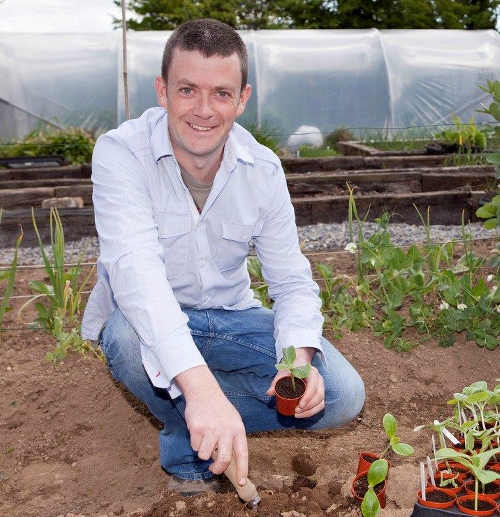
 Soil. Well, it’s just dirt really, isn’t it? It’s something to be cleaned off our boots and scrubbed off our hands, right? When I started growing my own food, I didn’t have any respect for the soil that the veg was growing in. My focus was on the seed, the plants, the vegetables. The soil was actually a source of annoyance to me - it had to be dug, raked, hoed, rotovated, coaxed and cajoled.
Soil. Well, it’s just dirt really, isn’t it? It’s something to be cleaned off our boots and scrubbed off our hands, right? When I started growing my own food, I didn’t have any respect for the soil that the veg was growing in. My focus was on the seed, the plants, the vegetables. The soil was actually a source of annoyance to me - it had to be dug, raked, hoed, rotovated, coaxed and cajoled.
If we brought in a big digger and scraped the thin little layer (about 6 to 8 inches) of rich topsoil off the surface of our planet, all life as we know it would cease to exist. Plant matter would not grow, and without plant matter there would be no animals (including humans). Given its importance to our survival, it’s strange that we treat it with such contempt. Centuries of commercial agriculture has assumed that we can continue to rob the soil of it’s nutrients by growing intensively from it and that all we need to do is replace the three core nutrients of nitrogen, phosphorus and potassium (the key ingredients of commercial NPK fertilizer).
 In fact, what soil needs to support life is far more complex than that. Composts and manures (which are the organic alternative to chemical fertilizers) also return dozens of trace minerals and other nutrients to the soil – the vegetables that grow in this soil have more nutrients in them as a result and healthier veg leads to healthier people. Then, having served their purpose in the kitchen, the vegetable trimmings and waste are returned to the compost, releasing the nutrients that are left back to the compost heap and then eventually back to the soil. Even a cursory understanding of this never-ending cycle of growth-maturity-decay leads you to one conclusion: growing your own food is actually all about the soil.
In fact, what soil needs to support life is far more complex than that. Composts and manures (which are the organic alternative to chemical fertilizers) also return dozens of trace minerals and other nutrients to the soil – the vegetables that grow in this soil have more nutrients in them as a result and healthier veg leads to healthier people. Then, having served their purpose in the kitchen, the vegetable trimmings and waste are returned to the compost, releasing the nutrients that are left back to the compost heap and then eventually back to the soil. Even a cursory understanding of this never-ending cycle of growth-maturity-decay leads you to one conclusion: growing your own food is actually all about the soil.
From that perspective, my most significant achievement as a GIYer has been to learn how to make proper compost. Each winter I put wheelbarrow loads of the crumbly stuff on my vegetable beds. And each year my soil starts to look less like a potter’s clay, and becomes a little darker, a little more crumbly and a lot more lovable. In a nutshell - I’ve stopped treating my soil like dirt…
The Basics – Pick Blackberries
As autumn progresses and we move in to October, we’re coming to the end of what has been a tremendous blackberry season. Sometimes you’ve got to be impressed with Mother Nature’s infinite wisdom. As we approach winter and the first snivels and colds, what does she do? She piles hedgerows all around us full with more free vitamin C then you could shake a stick at. Blackberries have been consumed by humans for up to 2,500 years, contain polyphenol antioxidants, and are abundant in vitamin C.
It’s pretty ridiculous that we spend good money on fruit/berries and vitamin C tablets while millions of Blackberries rot in ditches all over Ireland. If you spend the time to pick them you can then freeze them and enjoy for months to come. Blackberries are supremely useful – they can go in to jams, smoothies, tarts, wine, tea, ink and dyes. So get picking.
Recipe of the Week – Blackberry and Apple Crumble
Eldest Boy at home here has become somewhat of a whiz at making Blackberry and Apple crumble and he’s at the age now where he can pretty much manage the process from end to end – including picking the blackberries. Happy days.. It’s the ultimate autumn comfort food.
Ingredients:
• 900g apples – peeled, cored and cut in to chunks
• 350g blackberries
• 160g demerara sugar
• Juice of 2 lemons
• 225g plain flour
• 175g butter
• 125g muesli or a mixture of porridge oats, seeds and chopped nuts
Directions:
Preheat the oven to 200C. Pour the lemon juice over the apples - this will add flavour and stops the apples from going brown. Layer the apples, blackberries, and sugar in a lasagne dish. Place the flour in a large bowl and then rub in the butter until it resembles breadcrumbs. Add the muesli and another 50g sugar and mix through. Sprinkle the crumble topping over the fruit. Bake for 45 minutes. Cool for a few minutes and then serve with custard or cream.
About GIY
GIY is a not-for-profit organisation that aims to create a healthier, more sustainable world where people grow their own food. We inspire and support people to grow food more successfully by bringing them together to share advice, tips and ideas. There are approximately 65,000 people involved in the GIY movement in Ireland, which is proudly supported by Woodies DIY.
For more information check out www.giyireland.com
Michael Kelly is a freelance journalist, author and founder of GIY Ireland.
© GIY Ireland 2018 – all rights reserved.
Grow it Yourself - November

 I went on a sobering visit to a couple of our biggest field veg growers this week: Paul Brophy in Kildare who is the largest grower of broccoli in the state and the Weldon Brothers (Martin and Enda) in Swords who supply the majority of the Brussels Sprouts crop. Their operations are truly massive and impressive, and like most of the veg growers they have had to specialise and go large in order to compete. In the 15 years between 1999 and 2015 there was a huge drop in the number of field veg growers in Ireland, from 377 down to 165. Anecdotally the actual number remaining is likely to be less than this 3 years later, but there’s no data on that yet. Either way, that’s a pretty tiny number of growers who are responsible for our entire veg output. Interestingly, the output levels in edible horticulture haven’t dropped in that same time period, so in other words the remaining growers have ramped up their production big time.
I went on a sobering visit to a couple of our biggest field veg growers this week: Paul Brophy in Kildare who is the largest grower of broccoli in the state and the Weldon Brothers (Martin and Enda) in Swords who supply the majority of the Brussels Sprouts crop. Their operations are truly massive and impressive, and like most of the veg growers they have had to specialise and go large in order to compete. In the 15 years between 1999 and 2015 there was a huge drop in the number of field veg growers in Ireland, from 377 down to 165. Anecdotally the actual number remaining is likely to be less than this 3 years later, but there’s no data on that yet. Either way, that’s a pretty tiny number of growers who are responsible for our entire veg output. Interestingly, the output levels in edible horticulture haven’t dropped in that same time period, so in other words the remaining growers have ramped up their production big time.

The extreme weather alone doesn’t explain why so many growers are leaving the market. That alas, is largely down to the fact that there is so little margin left in selling the veg. Competition from cheaper imports plays a part, as does below-cost selling and discounting in supermarkets. In latter years, we’ve all seen the aggressive pre-Christmas price promotions on fresh-from-the-field veg like sprouts and carrots for sale for as low as 5 cent a kilo. It’s typically the supermarket that takes the hit on this (though some have been known to lean on growers to share the burden), using it as a loss leader to draw you in, and of course Consumer groups will say it’s great for the consumer to have access to cheap, healthy food. But these are short term benefits. In the long term, these promotions set ever lower benchmarks for the value of veg, which will drive more growers from the industry. Ultimately we will be left with less choice as consumers and more and more imported veg. That’s bad for jobs here at home, and reduces our access to healthy, seasonal, fresh food and the kind of taste that can only come from just-picked veg.
Most importantly, the Brophys, Weldons and the like are producing food that is everything food should be – incredibly good for us, nutritious, seasonal, fresh, local and creating jobs. We should be paying a fair price for that instead of discounting it. As always we have power as consumers. When buying your veg, always seek out Irish vegetables and try to avoid the price promotions remembering that there is always a cost to cheap food down the line.
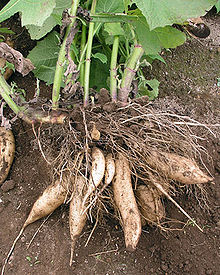 The Basics – Growing Yacon
The Basics – Growing Yacon
Similar to Jeruslaem artichokes and potatoes, yacon is a plant of South American origin and, with sweetly-flavoured tubers and small sunflower-like flowers, it is grown from tubers from last year’s crop. Yacon grows two types of tubers - the knobbly ‘stem’ tubers that grow just under the surface around the stalk of the plant and look a lot like Jerusalem artichokes, and the larger, smooth edible tubers that grow outside of these. The former are the ones used for propagating the following year’s crop, while the latter are for eating. In the late autumn (after frost), dig the whole plant carefully - the yield should be 5-10 large tubers per plant. Snap these off. They will store in a frost free shed in a box of sand and will sweeten further over time. Cut the stem of the plant back to about 10cm and store this ‘crown’ with the knobbly root tubers attached for next year’s crop, also storing in sand.
Separate the knobbly tubers in spring, making sure you have a growth point on each. Plant each one in to a large pot with good quality potting compost. Place the pot on a heated bench or sunny place in doors. Plant out in the ground in May, being careful of the weather - a good guide would be to only plant them out when you happy to plant out your tomatoes. Space 1 metre apart. Water regularly. The plants can be slow to get going but in the summer will get to a height of 2m. As it’s a hungry plant, it’s a good idea to ensure the soil is good and fertile with plenty of added compost or farmyard manure.
Recipe of the Week – Yacon and Blue Cheese Salad
It's not easy to improve upon the famously fabulous combination of walnuts and blue cheese but the addition of yacon, with its succulent sweet crunch, really lightens and freshens this deliciously different lunch. This recipe from Mark Diacono’s A Taste of the Unexpected (Quadrille, £20) serves 4 as a starter.
Ingredients
• Small handful of shelled walnuts or pecans
• Juice of 1 lemon
• 1 medium-large yacon
• Handful of salad leaves
• 180g blue cheese, such as Dorset blue vinney, roquefort or gorgonzola
For the dressing:
• 1 tbsp apple balsamic vinegar
• Pinch of flaky sea salt
• 3 tbsp extra-virgin olive oil
Directions
Preheat the oven to 180C/Gas 4. Spread the walnuts or pecans out onto a baking tray and toast in the oven for 8–10 minutes, shaking halfway through, until lightly coloured – keep an eye on them to ensure they don't burn. Fill a bowl with water and add the lemon juice. Peel the yacon, cut into slices and toss into the lemony water to prevent them from discolouring. In a small bowl, whisk together the vinegar with the salt before adding the olive oil a little at a time, whisking all the while until smooth. In a bowl, lightly dress the salad leaves in a little of the dressing and divide between 4 plates.
Arrange the sliced yacon on top, crumble over the blue cheese, then trickle over the rest of the dressing. Scatter the nuts over the top and serve immediately.
© GIY Ireland 2018 – all rights reserved.
Grow it Yourself
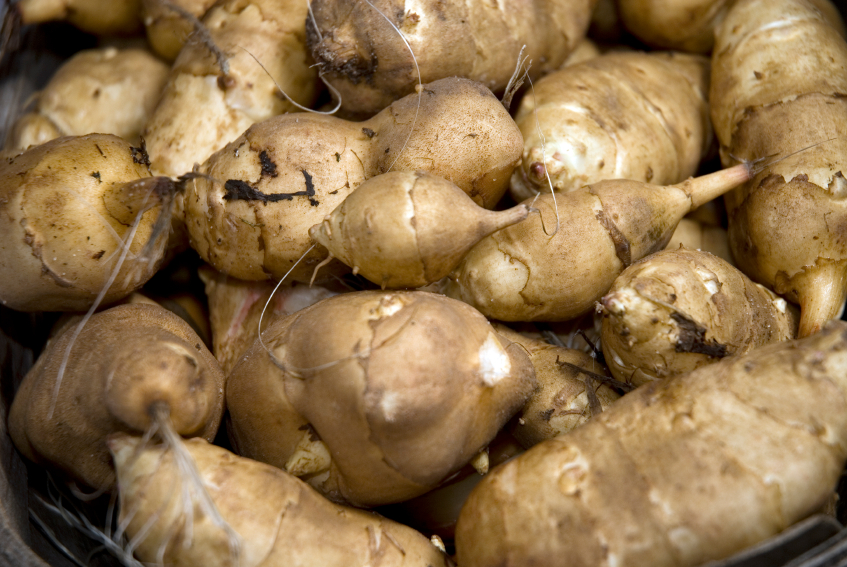
 We harvested our Jersusalem artichokes in GROW HQ in the last month and they’ve started to appear on the menu in the café. When I started growing first I was confused about the difference between Jerusalem and Globe artichokes and wondered if it was just different names for the same vegetable. They are in fact entirely different vegetables that bear little resemblance to each other. Jerusalem artichokes are actually part of the sunflower family, and when you grow them the family resemblance emerges. The plants grow to over 3m tall, producing yellow sunflower-like flowers and it’s actually the knobbly root or tuber of the plant that we harvest to eat. The tubers resemble root ginger, are brown in colour and about 7-10cm in length. The Globe artichoke is unrelated – it is a more ornamental affair, grown for the flowering globe that grows at the top of its stems (from which are gleaned the much-coveted artichoke heart).
We harvested our Jersusalem artichokes in GROW HQ in the last month and they’ve started to appear on the menu in the café. When I started growing first I was confused about the difference between Jerusalem and Globe artichokes and wondered if it was just different names for the same vegetable. They are in fact entirely different vegetables that bear little resemblance to each other. Jerusalem artichokes are actually part of the sunflower family, and when you grow them the family resemblance emerges. The plants grow to over 3m tall, producing yellow sunflower-like flowers and it’s actually the knobbly root or tuber of the plant that we harvest to eat. The tubers resemble root ginger, are brown in colour and about 7-10cm in length. The Globe artichoke is unrelated – it is a more ornamental affair, grown for the flowering globe that grows at the top of its stems (from which are gleaned the much-coveted artichoke heart).
Interestingly, the Jerusalem artichoke has no relationship whatsoever to Jerusalem. The name is thought to have come from Italian settlers in the US calling the plant girasole, the Italian word for sunflower. Over time, girasole morphed in to Jerusalem.
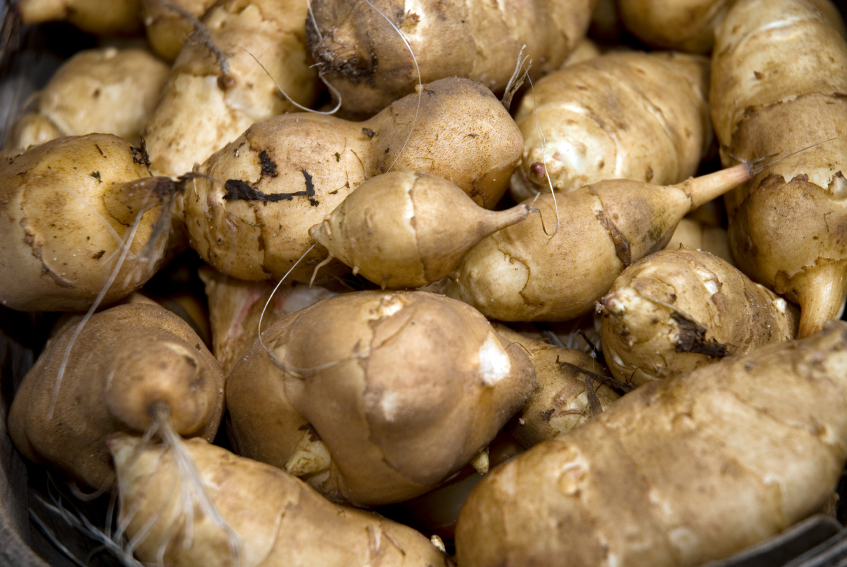 They were first cultivated in north America and brought to Europe in the 1600’s and though originally celebrated for their taste they suffered from being almost too prolific and were later to be relegated to peasant or animal food. Their reputation reached a nadir during the 1940s when they were particularly associated with the deprivations of the 2nd World War. But in more recent times their star is on the rise again, particularly as a winter soup ingredient. Some research suggest they can improve insulin sensitivity in diabetics. In the kitchen they can even be used raw, since they have a nuttier and sweeter flavour than potatoes. The knobbly tubers of the Jerusalem artichoke are not to everyone’s liking and they have an unfortunate association with flatulence (often nicknamed fartichokes, rather unimaginatively it has to be said). The body can’t digest the inulin that’s in artichokes in the digestive system but breaks them down using bacteria in the colon – hence the flatulence, and the reason why you often see recipes that ferment them first (see recipe below).
They were first cultivated in north America and brought to Europe in the 1600’s and though originally celebrated for their taste they suffered from being almost too prolific and were later to be relegated to peasant or animal food. Their reputation reached a nadir during the 1940s when they were particularly associated with the deprivations of the 2nd World War. But in more recent times their star is on the rise again, particularly as a winter soup ingredient. Some research suggest they can improve insulin sensitivity in diabetics. In the kitchen they can even be used raw, since they have a nuttier and sweeter flavour than potatoes. The knobbly tubers of the Jerusalem artichoke are not to everyone’s liking and they have an unfortunate association with flatulence (often nicknamed fartichokes, rather unimaginatively it has to be said). The body can’t digest the inulin that’s in artichokes in the digestive system but breaks them down using bacteria in the colon – hence the flatulence, and the reason why you often see recipes that ferment them first (see recipe below).
There is much to recommend them to the grower. They tend to persist for years after being sown, which would lead you to believe that to grow them you can simply leave some behind in the soil to grow on the next year. You could do this, but the quality of the tubers will decline over time. They do better if you harvest them all, and replant the next year in well fertilised soil. They suffer no diseases, and are exceptionally prolific (unlike their globe artichoke namesakes).
Famously, there are some harsh word on artichokes in a 1621 book called Gerard’s Herbal; “Which way soever they be dressed and eaten, they stir and cause a filthy loathsome stinking wind within the body, thereby causing the belly to be pained and tormented, and are a meat more fit for swine than men.” But don’t let that put you off trying this excellent and delicately flavoured vegetable - a bit of exaggeration always attracts the reader’s attention!
The Basics – Growing Jerusalem Artichokes
Sow them exactly as you would spuds – get yourself some artichoke tubers (they might be trickier to come across than spuds – ask a fellow GIYer if they can give you a few tubers), make a hole about 15cm deep and drop a tuber in to it every 30cm in a row. Then backfill with soil. You will only need about 5 plants. Don’t worry about including them in any rotation – they can be grown wherever you have the space, but since they grow exceptionally tall, chose your site carefully – they will cast a shadow on their neighbours in the veggie patch.
Earth up the plants several times in the season to provide some support to the plant as it grows and also to increase yield. When they are 30cm tall, earth up to 15cm. In the autumn when the leaves go yellow cut the stems right down to ground level and compost them.
You can start harvesting artichokes in October or November and they will stay in the ground quite happily right through the winter. You can remove them and store in a box of sand in a cold (but frost free), dark shed. They will last until April this way. Left in the ground they will eventually succumb to slugs and they will probably prevent you from preparing the bed for whatever will be grown there next year. Make sure to remove absolutely every last tuber from the soil – otherwise you will be plagued with them growing back next year.
Recipe of the Week – Mellow Jerusalem Artichoke Pickle
Fermenting artichokes will reduce their ..ahem… windiness. I can’t say I’ve ever done a detailed experiment on this, but did find this pickle absolutely delicious.
Ingredients:
• 1½ pounds Jerusalem artichokes, thoroughly scrubbed, and cut into ½-inch dice
• 1 teaspoon ground dried turmeric
• 8 cloves garlic, chopped
• 1 ½ tablespoons fresh ginger, minced
• 1 teaspoon cumin seeds
• 2 teaspoons salt
• 2 teaspoons sugar
• 1½ cups water
Directions:
Toss together the diced Jerusalem artichokes, the turmeric, the garlic, the ginger, and the cumin. Pack the mixture into a jar with a capacity of at least 6 cups. Dissolve the salt and sugar in the water. Pour the brine over the Jerusalem artichokes; it will not cover them at first. Add a brine bag (a gallon freezer-weight plastic bag containing 1 tablespoon salt dissolved in 3 cups water) or another suitable weight.
The next day the brine should cover the Jerusalem artichokes. If it doesn’t, add more brine mixed in the same proportions. Wait several days before tasting the pickle. I found it perfect after a week: The brine was sour, and the Jerusalem artichokes pleasantly, mildly spicy and still crunchy. When the pickle has fermented enough to suit your taste, store the jar in the refrigerator.
Michael Kelly is an author, broadcaster and founder of GIY.
© GIY Ireland 2018 – all rights reserved.
Grow it Yourself

 Most people sow their early potatoes outside in the vegetable patch in March, but if you have a polytunnel or greenhouse you can get started right now for a super early crop (May). Some years ago I went on a course with Jim Cronin over at his smallholding in Co Clare, and he outlined this method, which creates very deep beds and gives you an abundant crop.
Most people sow their early potatoes outside in the vegetable patch in March, but if you have a polytunnel or greenhouse you can get started right now for a super early crop (May). Some years ago I went on a course with Jim Cronin over at his smallholding in Co Clare, and he outlined this method, which creates very deep beds and gives you an abundant crop.
Cultivate the soil in the bed in the tunnel where you are going to sow spuds and make it loose. Take the soil from the bed (down to the subsoil) and put it out on to the path. Put your seed potatoes on to the subsoil at 10 inch spacing. On top of each potato put a little bit of soil. Put 15 inches of farmyard manure on top of the spuds. The little bit of soil stops the manure from burning the seed potatoes. The manure can be fresh or composted. Then put the soil from the path back on top of the manure. It is the depth of manure and soil on top of the seed that encourages a long stalk and therefore lots and lots of lovely spuds.
Put some fleece on top to protect from cold weather. Take fleece off when potato plants appear but put back on at nighttime where frost is a risk. Hoe occasionally to prevent weeds from taking hold, until the plants produce a canopy of leaves, which will prevent weeds. Do not water until some of the plants start to flower – probably April. There is enough moisture in the air in the tunnel in Feb and March and if you water too early you will get tall, leafy plants but few spuds. Start to look for spuds from early May. Cut stems down to 2 inches in July (if you still have any spuds left by then), which will allow you to leave them in the ground for longer.
The Basics – Jobs for the Month Ahead
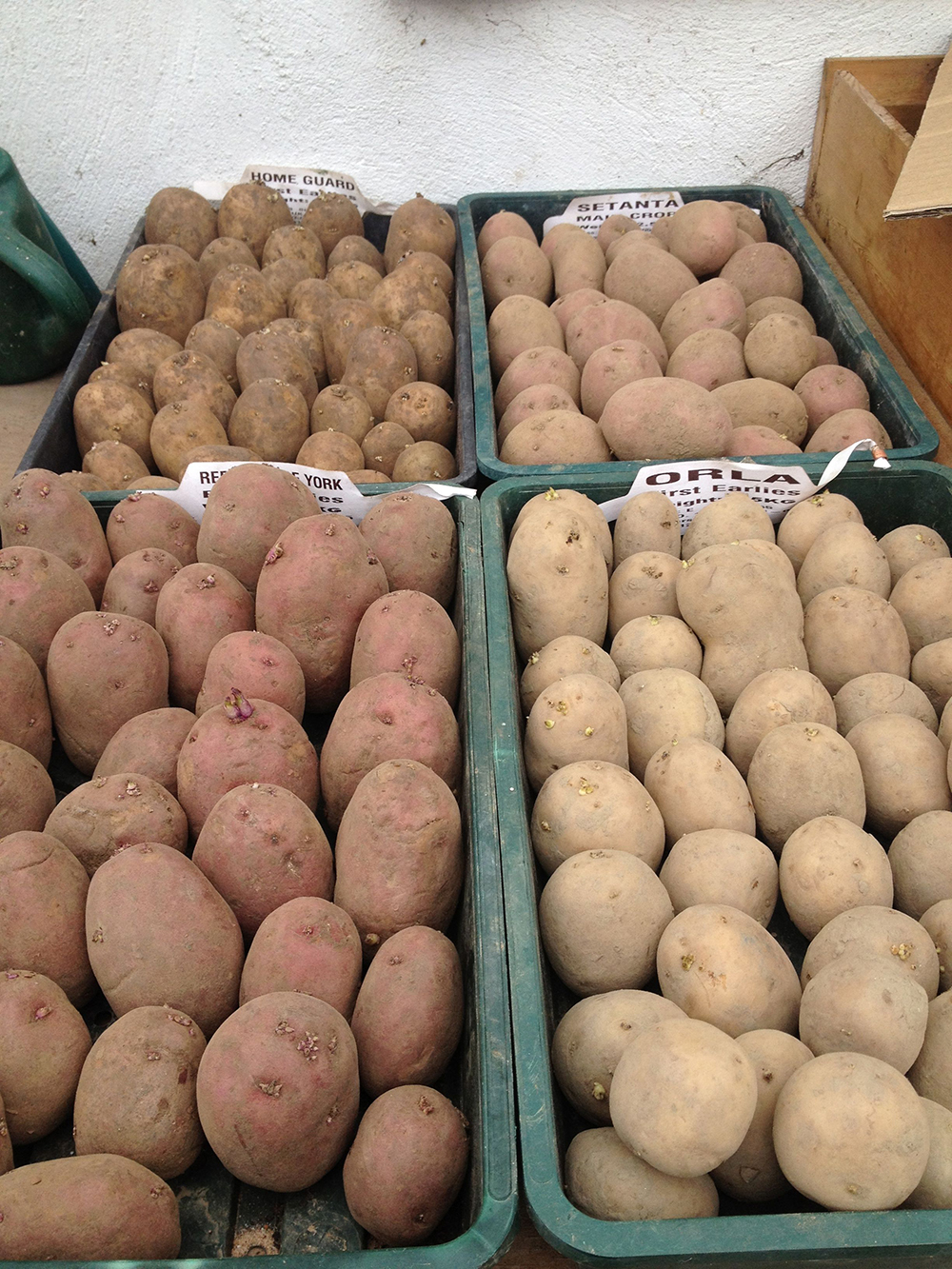 To Do
To Do
If you have not already done so order/buy your seeds, spuds and onion sets. “Chit” or sprout seed potatoes – put them in a container (e.g. used egg carton or empty seed tray) and leave them in a bright warm place. Check the pH of your soil – you can buy a soil pH testing kit in any garden centre. Lime your soil now if required (to reduce acidity in very acid soils), particularly important in your brassica bed.
Sow
Later this month we can, finally, sow some seeds. On a sunny windowsill indoors, in a heated greenhouse or on a heating mat: sow celery, globe artichokes, celeriac, leeks, onions, lettuce, tomatoes, peas, aubergines, peppers/chilli-peppers. For polytunnel or greenhouse: beetroot, carrots, leeks, lettuce, radish. Outside: Weather permitting you can try planting out broadbeans and early pea varieties.
Harvest
You could still be harvesting carrots, leeks, celeriac, Winter cabbage and cauliflowers, Brussels sprouts, spinach and kale.
Recipe of the Week – Mick’s Made-up Sausage and Beer Stew
Last night I was searching for ideas to make dinner and all I had in the fridge was a tray of sausages. Though I was tempted to go for a simple plate of sausage, eggs and chips, I had some veg in the basket from a harvest last weekend, and decided to concoct some class of a stew. It was surprisingly delicious, and warming on a cold January night. I would generally pair sausages with cider in a stew, but it being dry January all I had in the fridge was a bottle of non-alcoholic lager! Never mind, it seemed to work. Don’t worry too much about sticking to the veg ingredients – you could use celery instead of celeriac or swede instead of squash etc. Be adventurous.
Serves 4
Ingredients
• 6-8 good quality dinner sausages
• 2 onions, diced
• 1 leek, chopped finely
• 4 cloves garlic, peeled and diced
• Half a celeriac, peeled and diced
• 2 large carrots, diced
• ¼ of a squash or pumpkin, peeled and chopped in to large chunks
• Small bottle of beer
• Tin of tomatoes or 2 tbs tomato puree
• 500ml beef or chicken stock
• 1 tbs mustard (I used Dijon)
• 2 tbs chopped herbs (parlsey, rosemary and thyme)
• 1 bay leaf
Directions:
Heat a small amount of oil in a frying pan. Cut the sausages in to chunks and fry them for a minute or so on each side until browned. Remove from the pan and set aside on a plate. In the same frying pan, fry the onions, garlic, leeks, carrots and celeriac on a gentle heat for about 10 minutes (until soft). Transfer to a heavy saucepan or casserole.
Pour the bottle of beer in to the frying pan to deglaze the pan, scraping any nice brown bits off the pan with a wooden spatula. Bring to the boil and let it simmer for about 10 minutes to reduce down a little. Add it to your saucepan with the veg, and also add the stock, tomatoes, herbs and mustard. Bring to the boil and then add the squash or pumpkin.
Cook for 15 minutes with the lid on. Add the sausages back to the saucepan and cook for another 15 minutes. Taste and season with salt and pepper. Check the consistency - leave to simmer for another 10 minutes if it needs to be thickened or add a little boiling water if it’s too thick.
Serve with crusty bread or baked potatoes.
Michael Kelly is an author, broadcaster and founder of GIY.
© GIY Ireland 2019 – all rights reserved.
Grow it Yourself
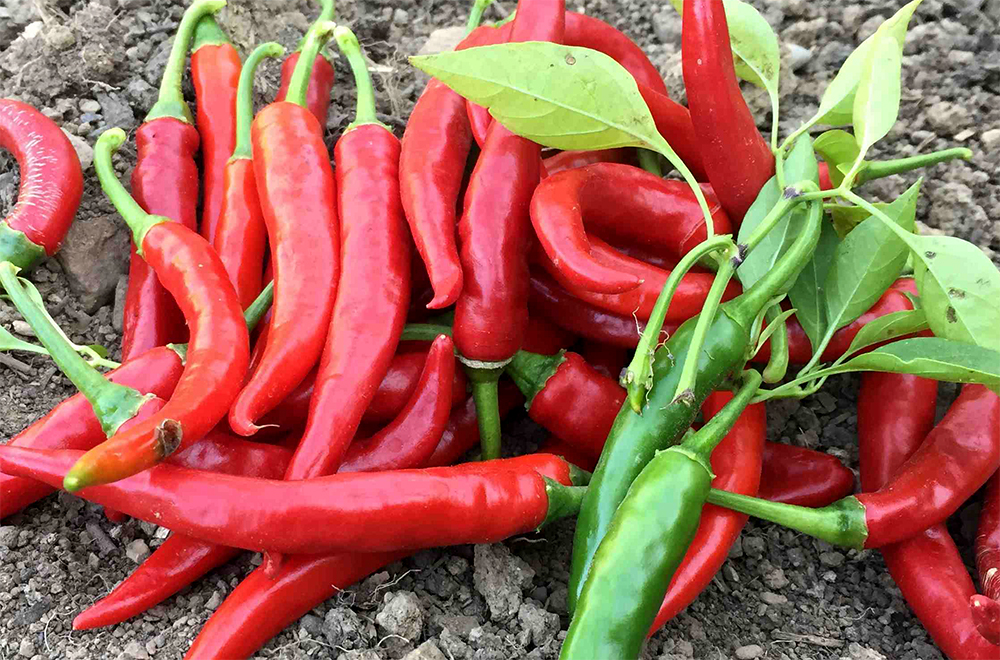
 “Grand bit of spring in the air” the lady said to me as we stood waiting for the pedestrian lights to go green. “It’s lovely” I said and smiled back at her. And it was lovely to be walking along the quays in brilliant sunshine carrying my jacket under my arm. The combination of brighter mornings, longer evenings and mild weather had put a spring in my step and I was feeling chipper. I suspect I’m not alone. But there was also an underlying sense of unease about it being 20 degrees on a sunny afternoon in Dublin, when it was technically still winter. Does it make me a climate change curmudgeon to worry about these things? Can’t I just appreciate those pictures of sun-bathers eating ice-cream in Stephen’s Green in February? Should I enjoy it when climate breakdown leads to unseasonably pleasant weather, or feel absolutely terrified instead?
“Grand bit of spring in the air” the lady said to me as we stood waiting for the pedestrian lights to go green. “It’s lovely” I said and smiled back at her. And it was lovely to be walking along the quays in brilliant sunshine carrying my jacket under my arm. The combination of brighter mornings, longer evenings and mild weather had put a spring in my step and I was feeling chipper. I suspect I’m not alone. But there was also an underlying sense of unease about it being 20 degrees on a sunny afternoon in Dublin, when it was technically still winter. Does it make me a climate change curmudgeon to worry about these things? Can’t I just appreciate those pictures of sun-bathers eating ice-cream in Stephen’s Green in February? Should I enjoy it when climate breakdown leads to unseasonably pleasant weather, or feel absolutely terrified instead?
Over the pond in Wales they had their hottest February day on record with a high of 20.6C – this is the first time ever that temperatures exceeded 20 degrees in a winter month in the UK. That is doubly odd when one considers that this time last year we were about to experience a once-in-100-year snow storm called the Beast from the East and we were shivering under Siberian air. Last year, Europe experienced its hottest summer on record and we had 6 weeks of drought conditions here in Ireland, while in October, Dublin airport recorded its coldest October night since records began. Topsy Turvy doesn’t begin to describe it. The new normal, it seems, is for our weather to be entirely abnormal.
Meanwhile we continue to whistle as we walk past the graveyard. On the RTE news there was a nice puff piece about people enjoying the summer-like temperatures on the prom in Galway (ice-cream and short sleeves in February, wow!), with a not a mention of climate change. Increasingly I think adults seem to be on the wrong side of history on this topic and teens and children are the ones talking sense. I walked past a group of teen climate change protestors in Cork City Hall – they looked angry (as teenagers do) and perhaps that’s the only appropriate response.
In the US, Senator Dianne Feinstein was captured on camera berating teen activists who had the temerity to suggest that she should support the Green New Deal which advocates de-carbonising the US economy within a decade (incidentally the UN Intergovernmental Panel on Climate Change says we have just 12 years left to turn this thing around). While we waste time thinking about frivolities like who wore what to the Oscars and who won €175m in the Euromillions, nature is screaming at us in every way it can that we need to fundamentally change the way we live. All aspects of our lives – food, transport, energy, waste - will have to change dramatically if we’re to avoid catastrophe.
So perhaps in considering how we should feel about the unseasonably warm weather, we should channel the uncompromising attitude of 16 year-old Greta Thunberg who lambasted the investors and bankers attending Davos: “I want you to feel the fear I feel every day,” she said, “Act as if your house is on fire. Because it is.”
GIY’s 10 Ways to Take Action on Climate Change
1. Buy a keep-cup and water bottle and bring them everywhere – never buy water or get tea/coffee in a takeaway cup again.
2. Start bringing bags with you to do your shopping and avoid buying food that’s packaged in plastic.
3. Reduce the amount of meat in your diet
4. Buy organic, seasonal and local food wherever possible
5. Plant trees.
6. Let your lawn grow to improve biodiversity and help pollinators like bees and insects.
7. Grow some of your own food.
8. Embrace frugality - reduce energy usage by unplugging devices in your home at night – broadband, TV, computers etc. Turn down the heating, buy energy saving lightbulbs.
9. Green your commute - walk or use public transport to get to work at least once a week even if it’s a pain. Give your car a day off at the weekend.
10. Hang the washing out on the line, instead of using the drier.
Things to Do This Week – Sow Bell and Chilli Peppers
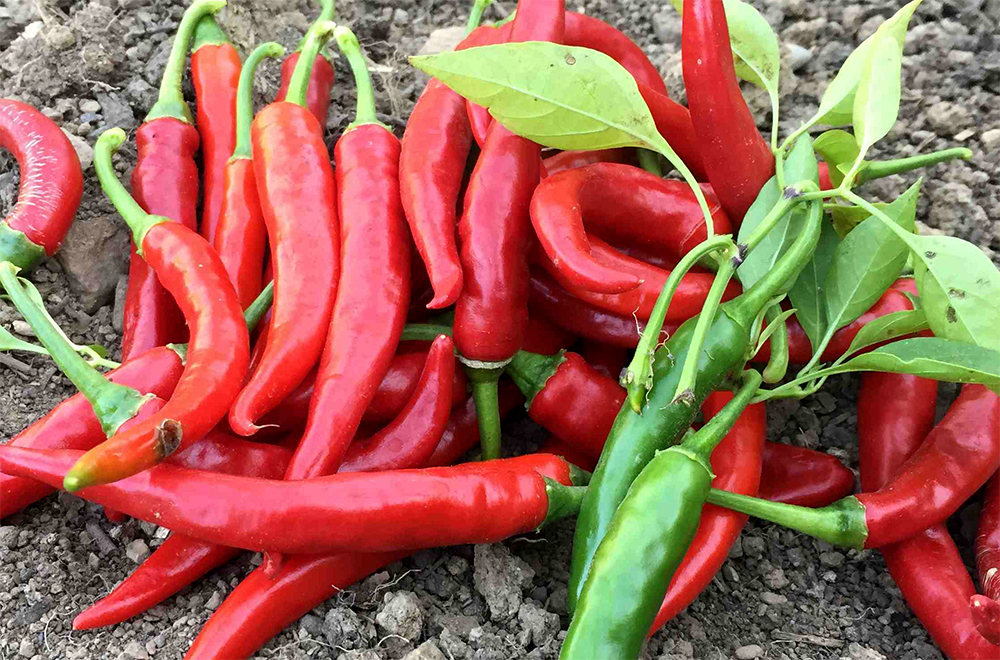
Peppers need a long growing season so the earlier you get started the better your chance of producing good, ripe fruit. Get the seeds sown this week on a heated propagator or inside in the house. You are looking for temperatures of 20 degrees Celsius plus. I sow 10 seeds in a 9cm pot of seed compost. They can take up to 2 weeks to germinate.
A few weeks after that, when the seedlings are large enough to handle, transfer each seedling in to its own 9cm pot (or module tray). In May or June, they will be planted out in the soil in the greenhouse or polytunnel or in to a bigger pot to grow on for the summer. All going well, we will be harvesting in October-ish.
For chilli-peppers I like the varieties Ring of Fire (hot hot hot), Hungarian Wax and Jalapeno.
Recipe of the week – Pasta with Winter Ratatouille
We’re on the hunt for recipes that use parsnips at the moment, having extracted a glut of them lately from the cold soil. This is a James Martin classic – easy and quick to cook. I used squash or pumpkin as a seasonal alternative to the sweet potato he had in the original recipe, which is almost always imported from the US.
Ingredients:
• 200g squash or pumpkin, peeled and cut in wedges
• 200g parsnips, peeled and cut in large pieces
• 200g carrots, washed and cut in large pieces
• 110g red onions, cut in quarters
• 3-4 cloves garlic
• 2 tbsp olive oil
• 75ml clear honey
• 2 sprigs rosemary, plus extra chopped to garnish
• salt and freshly ground black pepper
• 500g packet of pasta
• 800ml passata.
Directions
Preheat the oven to 200C. Place all the vegetables and the garlic on an oven tray and drizzle with the olive oil and honey. Add the sprigs of rosemary and season well. Cook for about 20 minutes until all the vegetables are tender and browned.
While the vegetables are in the oven, cook the pasta according to packet instructions. Remove vegetables from the oven, squeeze the cloves of roasted garlic over the vegetables and tip everything in a saucepan. Add the passata, bring to the boil and allow to simmer gently for a minute or two. Serve on top of the pasta and garnished with chopped rosemary.
Michael Kelly is an author, broadcaster and founder of GIY.
© GIY Ireland 2019 – all rights reserved.
Grow it Yourself
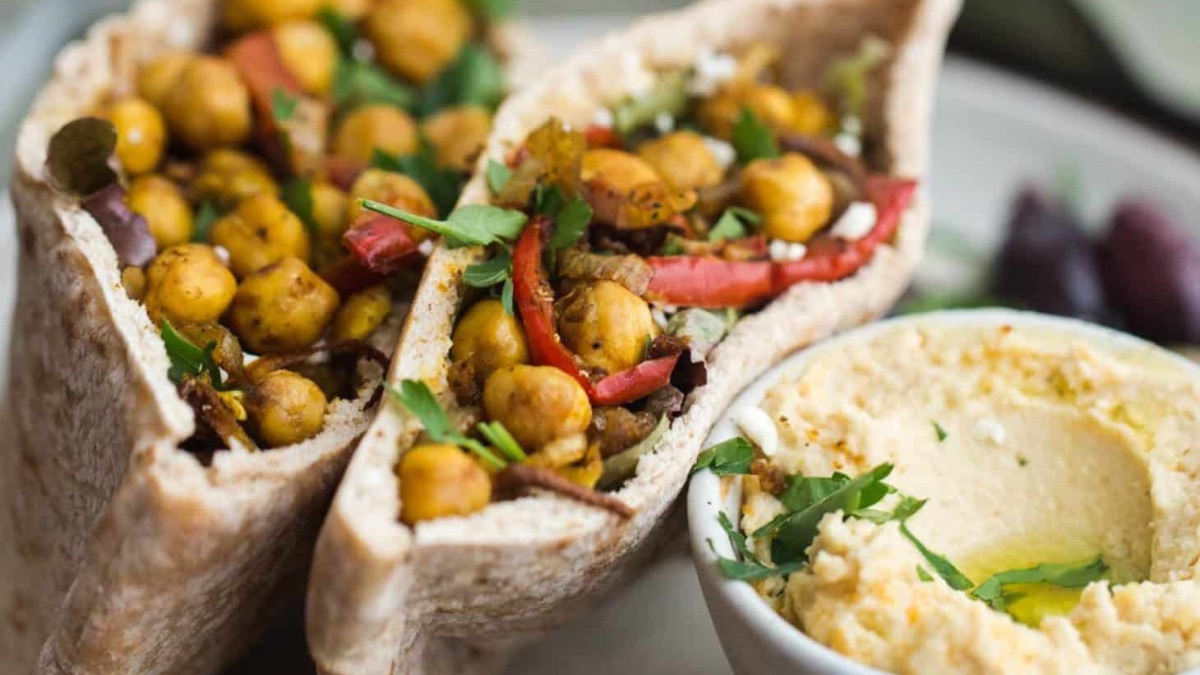
Tomato Mania
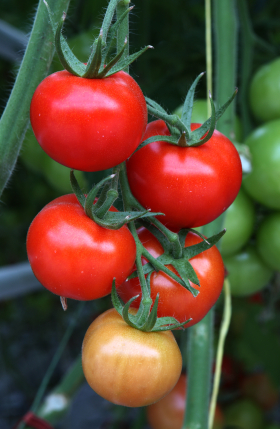 I delivered a course on growing tomatoes at GROW HQ recently, and though I was ostensibly ‘at work’, it didn’t really feel like work to be teaching about growing tomatoes (don’t tell anyone though). For me, growing tomatoes is a hobby that became an obsession and then spiralled out of control in to a mania. It started with a tomato plant in a pot maybe 15 years ago, then became 20 plants in a small polytunnel in the garden before finally morphing in to a full scale production in a large polytunnel in a field beside the house. In year one with the big polytunnel I grew 40 plants but this became 75 plants last year. And who knows, for this year, if I can squeeze in 100 plants, I probably will. “So you must be selling all those tomatoes then”, people say. “Nope,” I respond. “They’re just for ourselves”.
I delivered a course on growing tomatoes at GROW HQ recently, and though I was ostensibly ‘at work’, it didn’t really feel like work to be teaching about growing tomatoes (don’t tell anyone though). For me, growing tomatoes is a hobby that became an obsession and then spiralled out of control in to a mania. It started with a tomato plant in a pot maybe 15 years ago, then became 20 plants in a small polytunnel in the garden before finally morphing in to a full scale production in a large polytunnel in a field beside the house. In year one with the big polytunnel I grew 40 plants but this became 75 plants last year. And who knows, for this year, if I can squeeze in 100 plants, I probably will. “So you must be selling all those tomatoes then”, people say. “Nope,” I respond. “They’re just for ourselves”.
See the thing is, growing tomatoes is a double edged sword, because once you’ve tasted a proper homegrown tomato, eaten warm in the moment it’s picked, you really can’t go back to the bland shop-bought Dutch alternative. That means that we only eat tomatoes fresh between July and October (or November if we can encourage the ever-reliable Sungold to continue cropping) and then switch to frozen passata sauces to give us that tomatoey hit from November onwards. Then it becomes a simple maths exercise. The more tomatoes you grow, the longer you get to enjoy the passata in pizzas, pastas, stews, casseroles and soups. Let me say this: at the end of March we had about half a dozen bags of sauce left in the freezer. That looming shortage comes at a bad time - just as I’m planning how many plants I’m going to grow in the year ahead. And already I’m wondering can I make the passatas last in to April or May next year, if I grow more plants?
There are lots of veggies that are a cinch to grow. Tomatoes aren’t one of them. They have a very long growing season that stretches all the way from February or March right up to October/November. During that timeframe they are demanding. Sowing, transplanting, planting out, sideshooting, watering, feeding, harvesting. When you grow them at any sort of scale, that can mean a lot of hard work. But whether you grow one plant or 100, boy are they worth it. Bear in mind that from a single tiny seed sown on a cold February day, a healthy tomato plant can grow up to 8-10ft tall and produce over 300 delicious tomatoes in a season. And that’s the payback: each of those tomatoes will taste like nothing you’ve ever eaten before.
The Basics – Sowing Direct or Transplanting?
We are often asked whether it is better to sow direct into the soil or in pots and trays (for planting out later). It's always a tough question to answer because it depends on the vegetable and there are also other variables. Sowing direct is far less time consuming, but there are risks involved (tiny seedlings being eaten by slugs etc).
Root crops such as carrots and parsnips are better sown direct, because they don't transplant so well. Vegetables with large seeds such as peas and beans are generally sown direct - you can sow in pots earlier in the season if it's too cold to sow outside directly. Onions, garlic and potatoes are all best sown direct.
I think that most other vegetables are better sown in modular or cell trays. The seedlings can then be transplanted into the prepared bed or potted on into bigger pots. This has the added advantage that those well established small plants are more resistant to slug attacks.
You can buy different types of plastic or polystyrene trays or you can recycle yoghurt pots and cut milk cartoons for use as home-made seed trays.
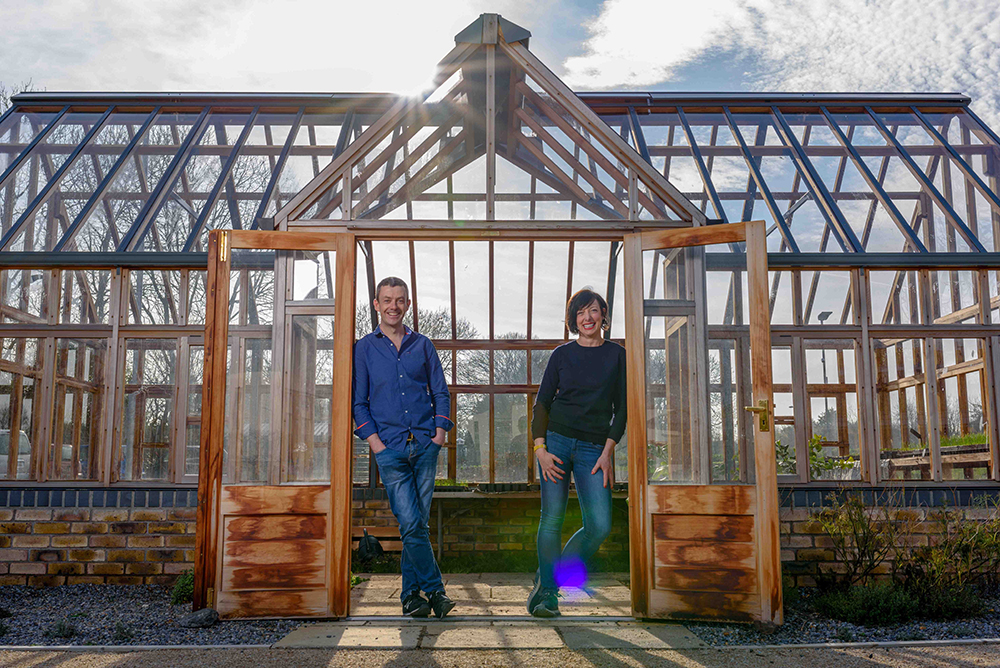
*** See Michael Kelly and GIY Head of Community Development, Karen O' Donohoe on GROW COOK EAT, Wednesday at 8.30pm on RTE1 - and join in the online conversation using #GROWCOOKEAT
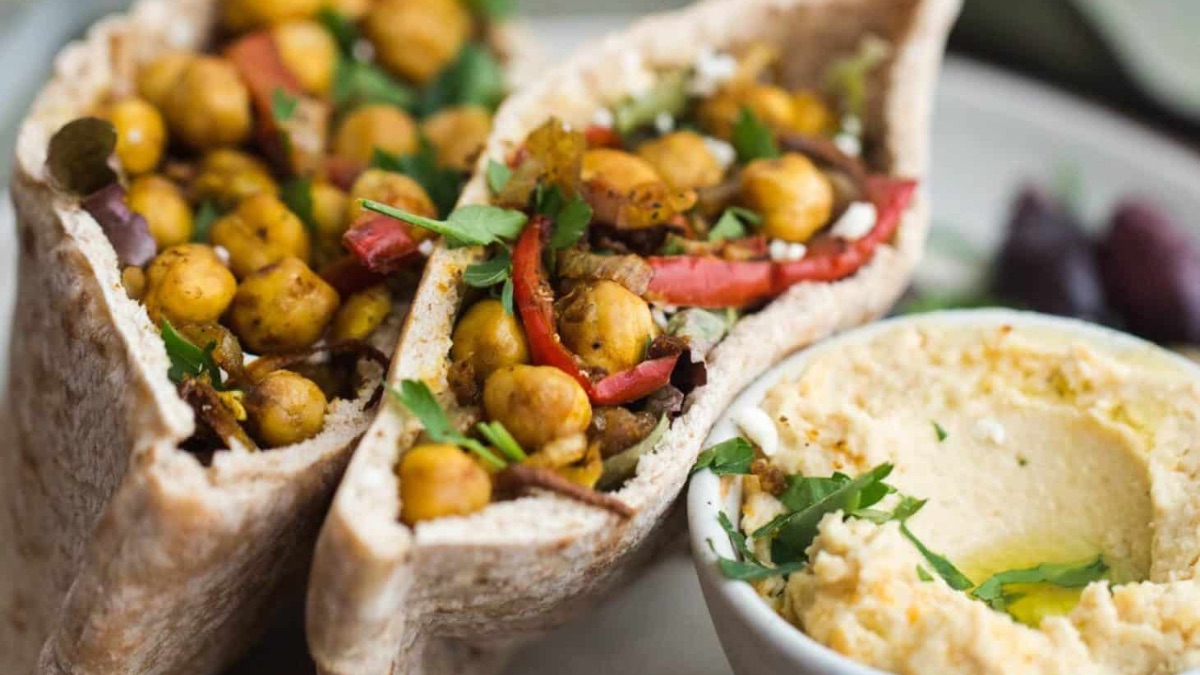 RECIPE: Spicy Carrot And Chickpea Pitta Pocket
RECIPE: Spicy Carrot And Chickpea Pitta Pocket
As the hungry gap really starts to kick in, and the range of veg available from the garden narrows, I’m on the hunt for recipes that use a single veg and some store cupboard ingredients to good effect. This is a great example from River Cottage Veg Every Day, using up some of our remaining carrots for a lovely light supper or lunch. I used a sourdough bread instead of the pitta bread, spreading a little yoghurt instead of butter and heaping the carrot mix on top. You can also add a little crushed cumin seed to the yoghurt for an added kick. Delicious.
Ingredients
50g butter
1 tablespoon rapeseed or olive oil
1 heaped teaspoon cumin seeds
4 large carrots (about 500g), peeled and cut into 2–3mm thick slices
1 large garlic clove, finely sliced
Finely grated zest of 1 orange, plus a good squeeze of juice
1 teaspoon hot smoked paprika
400g tin chickpeas, drained and rinsed
4 pitta breads or freshly cooked, soft flatbreads
4 heaped tablespoons plain (full-fat) yoghurt or soured cream
Sea salt and freshly ground black pepper
Directions
Heat the butter and oil in a frying pan over a medium heat. Add the cumin seeds and let them fry for a minute or two. Add the carrots and fry for about 8–10 minutes, stirring often, until tender and starting to brown, but still with some bite.
Add the garlic, orange zest, paprika and chickpeas and cook until the chickpeas are hot. Remove from the heat, season with salt and pepper and add a good squeeze of orange juice. Taste and add more salt, pepper and/or orange juice as needed.
Spoon some of the chickpea mixture into the pocket of a warmed pitta (or into the middle of each flatbread) and top with a spoonful of yoghurt or cream. Fold flatbreads, if using. Serve straight away.
Michael Kelly is an author, broadcaster and founder of GIY
© GIY Ireland 2019 – all rights reserved.
Grow It Yourself
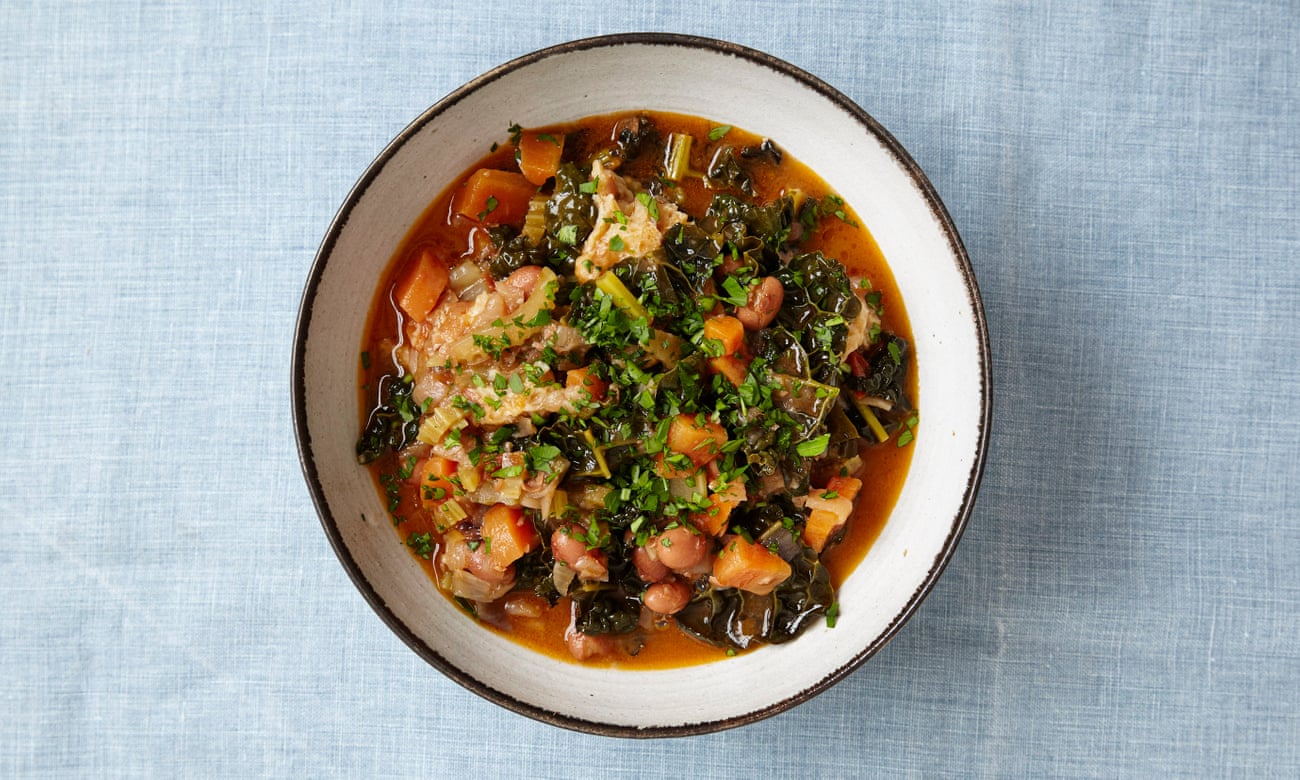
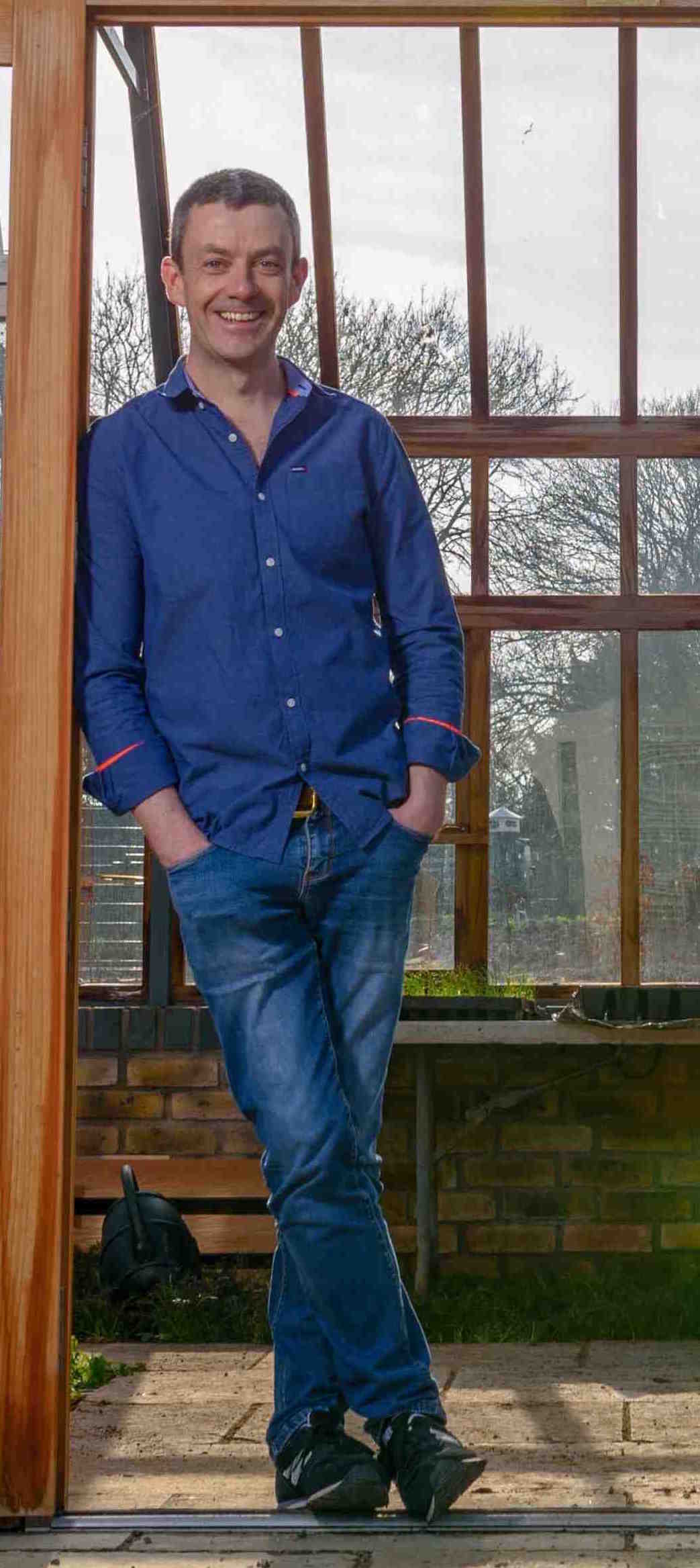 After a recent Fianna Fáil amendment to the Oireachtas report on Climate Action was accepted by both the Government and Opposition parties without a vote, Ireland became only the second country in the world to declare a climate and biodiversity emergency.
After a recent Fianna Fáil amendment to the Oireachtas report on Climate Action was accepted by both the Government and Opposition parties without a vote, Ireland became only the second country in the world to declare a climate and biodiversity emergency.
We all need to act now and put this fire out. We need to make a change with food, energy, transport & waste. You need to #BeTheChange #ClimateChange
Meanwhile, for gardeners everywhere - along with the weeding and transplanting - the seed sowing continues at pace. It’s this sort of activity that makes May so busy. I’ve recently been out in the potting shed most evenings after dinner, sowing seeds of one type or another. It’s a very pleasant hour of course, and no great chore. I love how it clears my head.
Last evening I was accompanied by Youngest Daughter which changes the dynamic from ‘head clearing’ somewhat, as she updates me on developments in school. Seed sowing is mindful enough of an activity, that I am receptive to her chatter. Childhood is fleeting, and there might come a time in her teenage years when she won’t talk to me much at all, so I’m reminded how precious these moments are. She chats, I listen, we sow seeds together.
I have her sowing a tray of climbing French beans, which will be planted out in the big tunnel in a few weeks time (they grow quickly). They could be sowed direct, but I like to give them a head start indoors to get ahead of the slugs. We fill a large module tray with compost and she puts one seed on the surface of each module, before pushing it down with her finger.
At the same time, I am ‘pricking out’ celery and celeriac seedlings from a tray. These were sown about a month ago, the tiny seed sprinkled on the surface of a tray of compost. The seedlings, just a few centimeters tall are now transplanted in to a module tray (one per module) in fresh compost. They will be kept inside for another month or so before planting out. It’s a delicate operation, holding the seedling by the leaf and carefully teasing it out of the compost with a plant label; making a little hole in compost in the module tray, popping the seedling in and firming it gently. I’m always aiming to plant out around 30-40 celeriac which are a brilliant crop to have over the winter months, since they can stay in the soil until you need them – we have just harvested the last celeriac from the soil (planted out last June).
With the celery and celeriac finished I move on to leeks. Again, I aim to grow a large volume of them, since they stand in the soil so well over the winter, and are so useful in the kitchen. I sow two tiny black seeds in each module, around 40 modules in all. Then I sow some basil – sprinkling the seeds on the compost in a small pot. In a few weeks time, I will transplant them from there in to the module trays to grow on, before planting out in the polytunnel. Finally I also sow a couple of trays of lettuce (variety Red Salad Bowl), sowing one little seed per module.
All the new trays and pots get a watering, and we try to find some space on the planting bench for them. We head back up to the house together to rejoin the world.
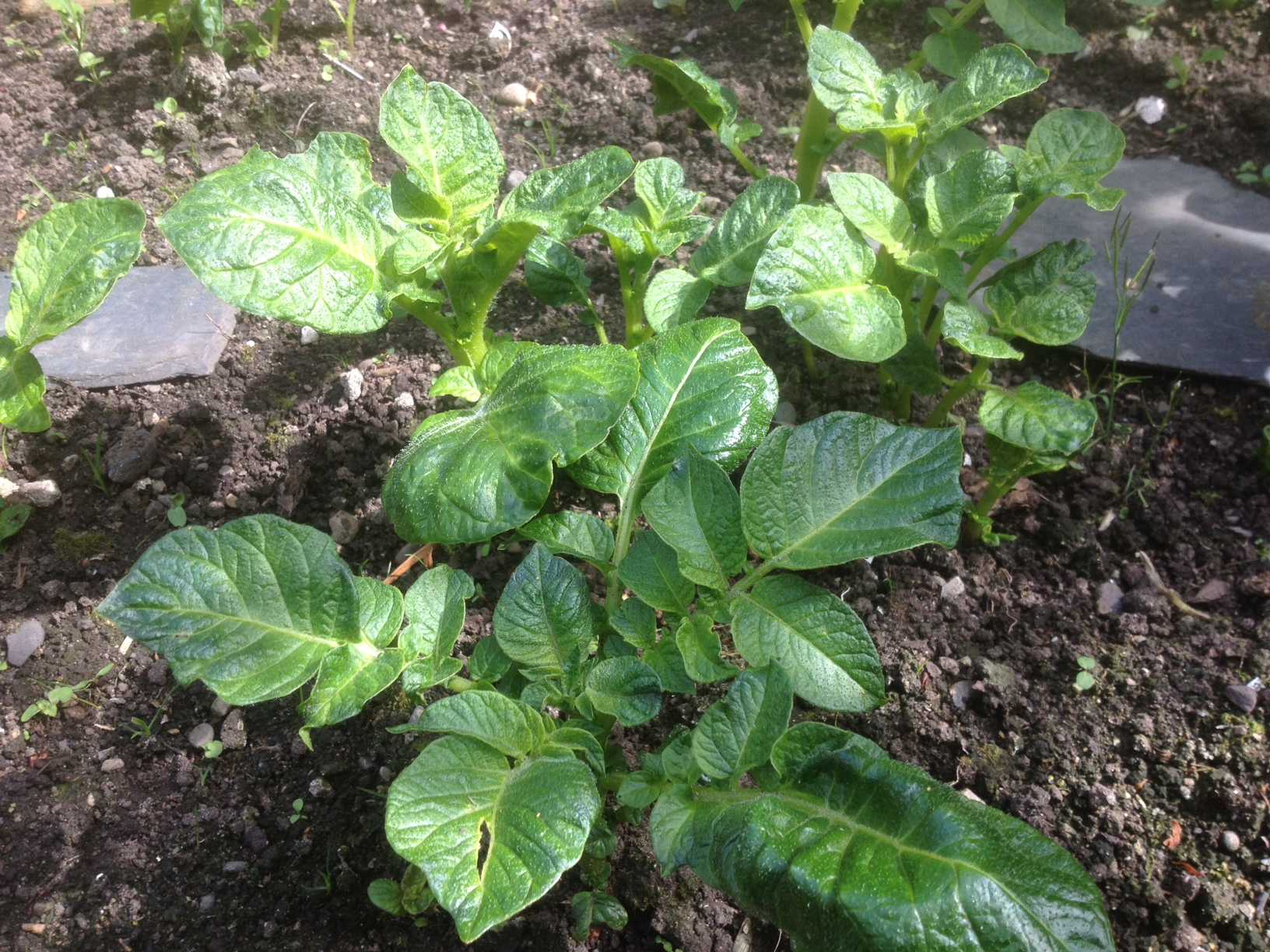
We had a few nights of frost recently, which is bad news for potato plants that have emerged from the soil. Potato plants are frost sensitive and the advice is to put a fleece cover over them to protect them, but of course I didn’t follow this advice – I think the words I used were “It won’t be that bad”. There’s definitely some frost damage now on the leaves of the early potatoes which were sown in mid-March.
I am grateful that I had already earthed them up twice, so it was just a tiny bit of foliage popping out of the soil that got a little damaged. The leaves go black from frost. A severe frost can cause the leaves to become blackened and then limp, with the whole plant falling over. In most cases the potato will send up new shoots to replace these, but the whole enterprise will be set back. A potato plant should recover quickly from a light frost however. Late frosts in May are not uncommon so keep an eye on the weather forecast, and have the garden fleece at the ready.
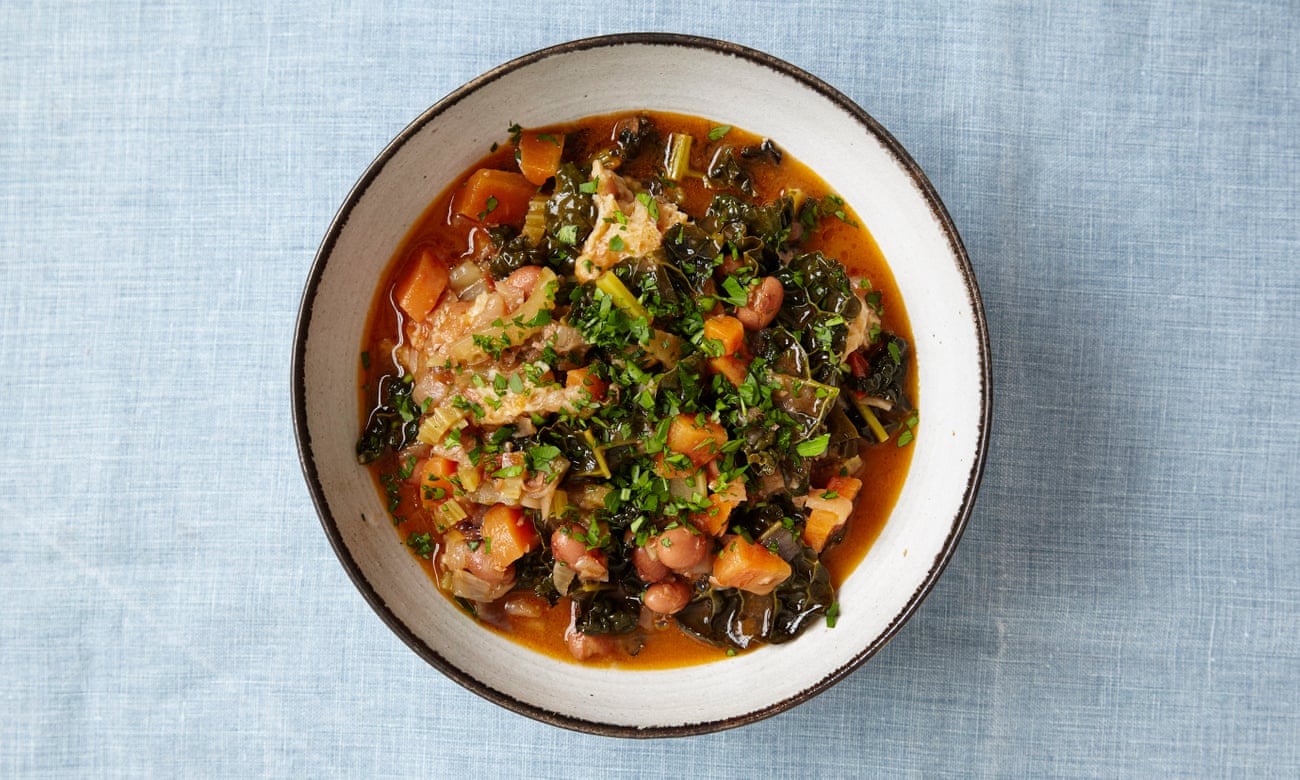 RECIPE: Borlotti Bean, Parsley And Bread Soup
RECIPE: Borlotti Bean, Parsley And Bread Soup
From The Kitchen Orchard by Natalia Conroy (Ebury), this one-pot veggie wonder is crammed with healthy vegetables, herbs and pulses- and it even uses up stale bread.
Ingredients:
• 6 tbsp olive oil
• 3 red onions, peeled and finely chopped
• 5 garlic cloves, peeled and finely chopped
• 3 carrots, roughly chopped
• 2 heads celery, outer branches removed, hearts roughly chopped
• 1 bunch parsley leaves, roughly chopped
• 5 tbsp tinned chopped tomatoes
• 1 bunch cavolo nero, chopped
• 500g cooked borlotti beans, cooking liquor reserved
• ¾ loaf stale white bread or ciabatta, crust removed, cut into 2.5cm thick wedges
• Plenty of good olive oil
• 600ml boiling water
• Salt and black pepper
Directions:
In a large heavy-based pot, fry the onions, garlic, carrots, celery and parsley uncovered in the olive oil for about one hour over a low heat.
When these are entirely soft, add the tomatoes and continue to cook for a further 15 minutes. Stir in the cavolo nero and set aside.
Pour half the beans with half their cooking liquid into a food processor. Pulse until smooth, then add to the vegetables. Strain the other half of the beans and add them to the soup. Lay the bread gently on top of the soup to form a sort of lid, then cover with plenty of olive oil. Pour the boiling water over the bread and leave the soup to cook very gently for 10 minutes, then leave to sit off the heat for a further 10 minutes. The bread should be completely soft.
Gently break up the bread lid and fold it into the rest of the soup. Season if need be, and serve with some more olive oil on top – the soup should be thick enough that you can stand up a spoon in it.
Michael Kelly is an author, broadcaster and founder of GIY
Grow It Yourself - June - Irish Veg Growing in Crisis

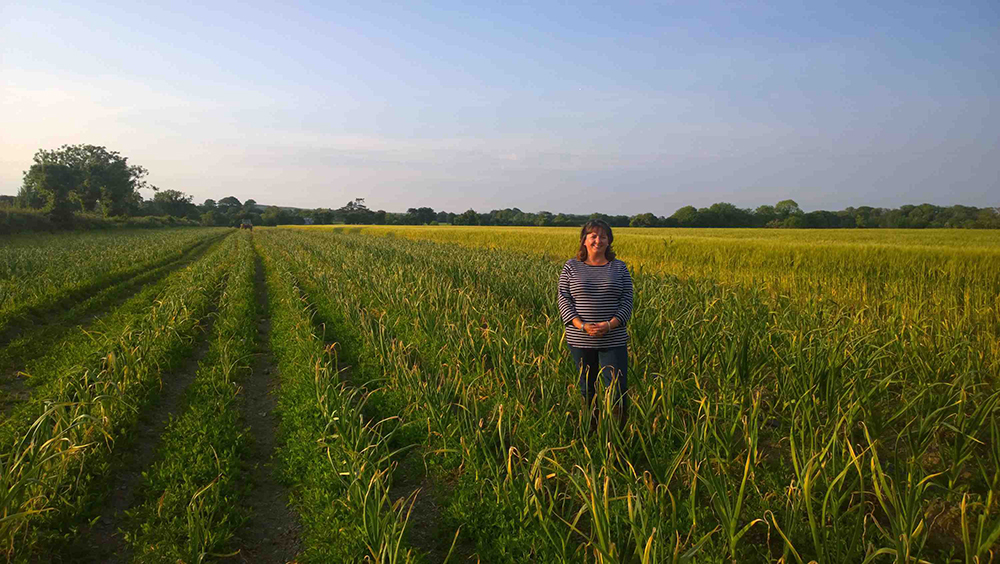
I’ve written here before about the lamentable state of affairs in the commercial veg growing world in Ireland. A perfect storm of competition from imports, aggressive price discounting on veg from retailers, and the low value placed on local veg has resulted in growers leaving the sector in their droves. The number of commercial veg growers has dropped 56% in 15 years, down to just 140 or so growers left in the country. In some cases there are vegetables (e.g. scallions) where we have just one commercial producer left, which says a lot about our food security as a nation.
The growers that are left have had to go big to compete. Most of them operate at extraordinary scale and tiny margins, which leaves them very vulnerable to external shocks. And the one thing we can be certain of with climate change, is that external shocks are becoming the norm. In the last year, they had to deal with 3 major weather events: the winds of Storm Ophelia, the snow of Storm Emma and the drought of last summer. While the general populace headed to the beach to enjoy the heat and drought conditions, many field veg growers had to invest in hugely expensive irrigation systems just to keep their crops alive.
These unforeseen costs (you don’t generally have to water outside in an Irish summer) are an existential threat for a low-margin business. Because of the power of the big supermarkets and the fact that veg growers don’t have a strong lobby voice the way beef or dairy farmers do, they have become price takers. They are literally given a price by supermarkets at which they have to produce their crop. Last summer, fearing more producers going out of business and more jobs lost (and veg growing is labour intensive), the growers had to go cap in hand to the supermarkets to plead for a temporary price increase. Bear that in mind the next time you see a picture of a smiling farmer in the middle of a field adorning the wall of your local supermarket multiple.
At Bord Bia’s Bloom this year, we hosted a discussion stage called Food Matters and several of our panels featured commercial veg growers. The discussions highlighted the challenges facing the industry, and yet…and yet. There are some reasons for optimism. Firstly, the arc of health and sustainability is bending slowly and inexorably towards more local, seasonal veg consumption. Report after report highlights the importance to our health and the health of the planet of eating more local, in-season vegetables and less meat.
Though the more established generation of growers fear for the future and wonder whether the next generation will want to take over the family business, they retain their passion for growing and have unrivalled growing expertise that risks being lost forever. As consumers we have to vote with our wallets, eating in season and buying Irish. Our broccoli crop from growers like Paul Brophy, for example, starts appearing on shelves about now and will be available (all going well with the weather) until November.
There are also newer entrants coming in to the market who are disrupting the system and doing things their own way. Look at the innovation from Drummond House growing garlic and asparagus in Co Louth. Look at Kenneth Keavy in Green Earth Organics who is growing 40 acres of organic veg in Corandulla, Co Galway (and employing over 20 people) selling direct to consumers in an at-scale box scheme. Look at Gavan Lynch of Hells Kitchen in Wicklow, who abandoned conventional mono-farming for a more varied life of organic dairying and growing 4 acres of hazelnuts. These are the stories that could inspire young growers in to the industry and if this is to be Irish horticulture’s moment in the sun, it’s that type of energy and innovation that’s needed.
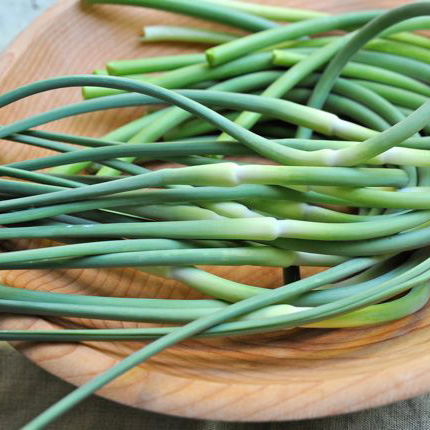 In Season – Garlic Scapes
In Season – Garlic Scapes
At this time of the year and just before they mature, hard-necked varieties of garlic (such as elephant) send out a long flower head or ‘scape’. Left to their own devices the flower head would produce its own tiny garlic bulbs known as ‘bulbils’. At this stage of their development, the scapes divert energy up the plant rather than down towards the bulb in the soil – which is what we need. For that reason it’s best to snip them off now.
Happily the scapes can be used in the kitchen and don’t need to be wasted. In fact they taste somewhat like asparagus and the aforementioned Drummond House sells the scapes as a pre-harvest delicacy. The recipe below is a pesto, but they can just as easily be used chopped up in to a veg stir-fry (blanched for a minute or two first) or used to make a slightly milder garlic bread.
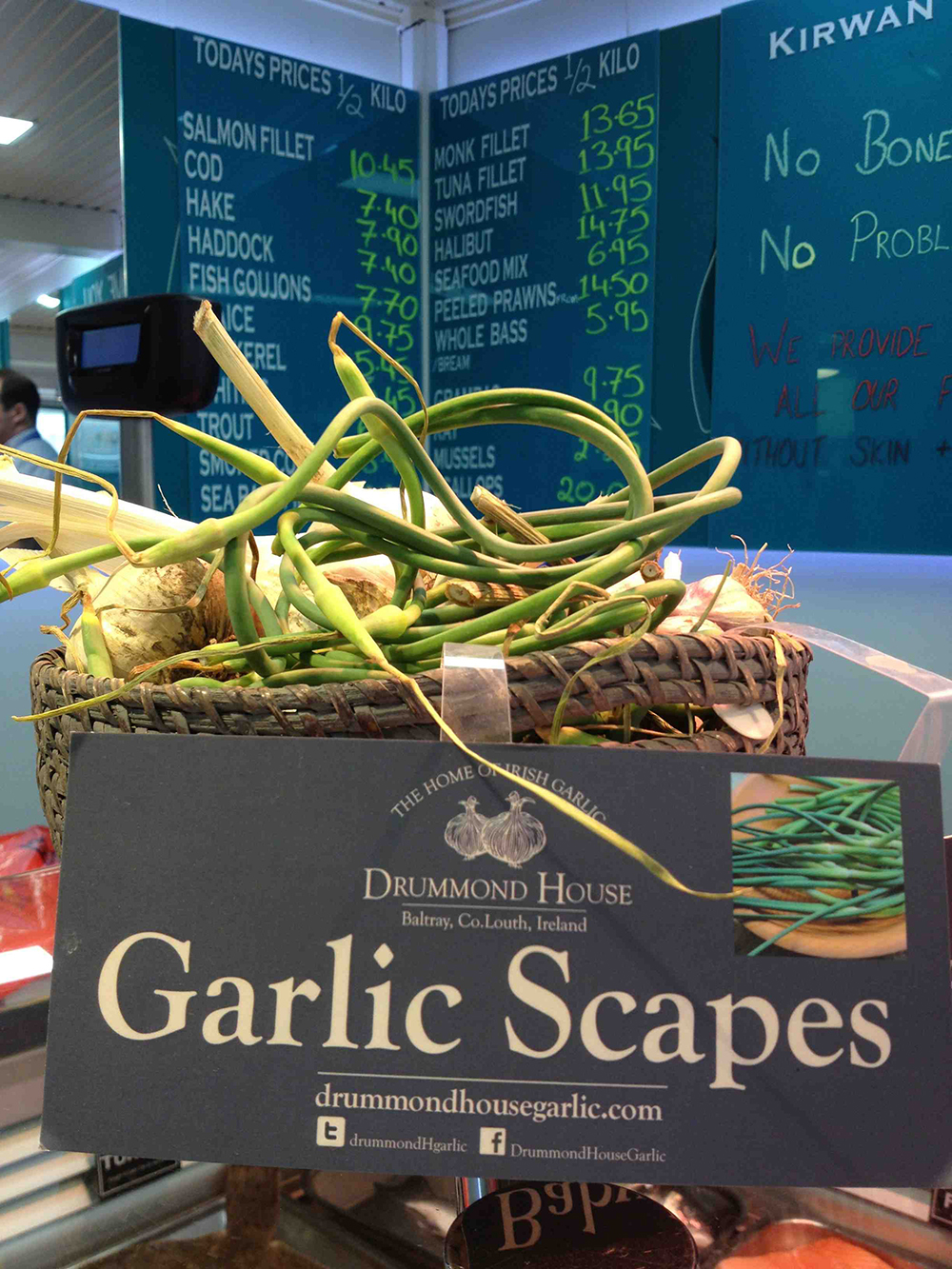 Recipe of the Month – Drummond House Garlic Scape Pesto
Recipe of the Month – Drummond House Garlic Scape Pesto
Visit www.drummondhouse.ie for more details.
Ingredients
• 1/4 cup pine nuts
• 3/4 cup coarsely chopped garlic scapes
• Juice and zest of 1/2 lemon
• 1/2 teaspoon salt
• A few generous grinds of black pepper
• 1/2 cup extra virgin olive oil
• 1/4 cup grated Parmigiano Reggiano cheese
Directions:
In a small, dry pan set over very low heat, lightly toast the pine nuts, stirring or tossing occasionally until just beginning to brown, about 2-3 minutes. Remove from the heat and let cool for a few minutes.
Combine the scapes, pine nuts, lemon juice and zest, salt, and pepper in the bowl of a food processor fitted with the blade attachment. Pulse about 20 times, until fairly well combined. Pour in the olive oil slowly through the feed tube while the motor is running. When the oil is incorporated, transfer the pesto to a bowl and stir in the grated cheese. If you plan to freeze the pesto, wait to add the cheese until after you've defrosted it.
Michael Kelly is an author, broadcaster and founder of GIY.
© GIY Ireland 2019 – all rights reserved.
Grow It Yourself - Know Your Onions
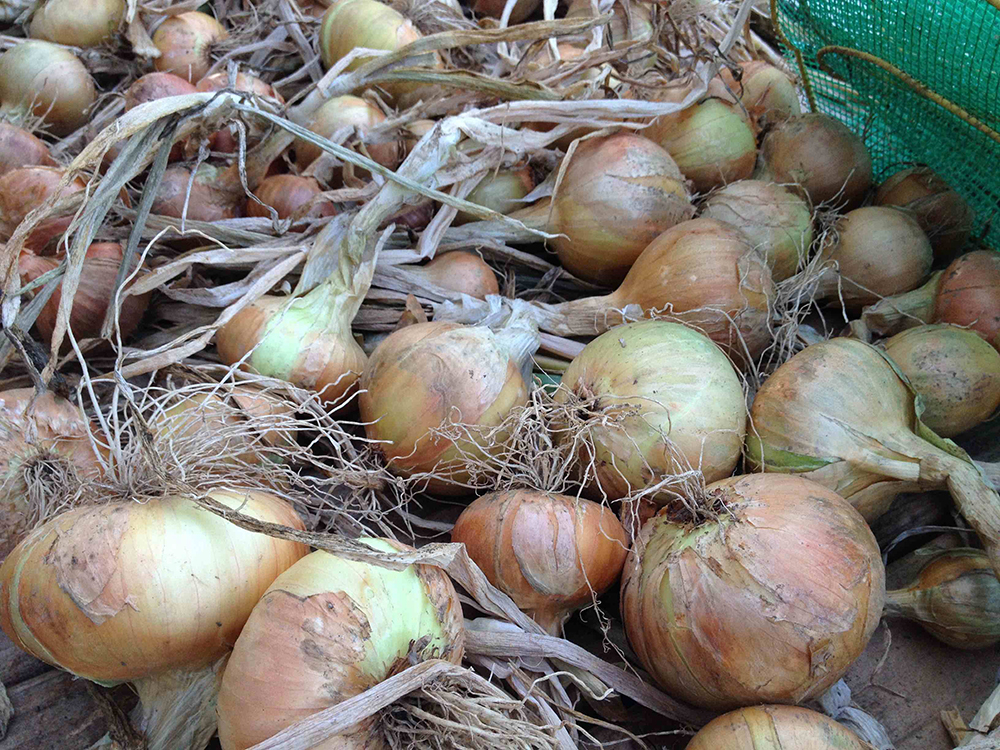
 We’ve been eating onions for the last month or so, even though they are not ready yet. The immature ‘green’ onions are a delight to eat and can be used anywhere there is a requirement for a scallion. At this stage though, the onions are moving in to a territory where they are almost ready to harvest.
We’ve been eating onions for the last month or so, even though they are not ready yet. The immature ‘green’ onions are a delight to eat and can be used anywhere there is a requirement for a scallion. At this stage though, the onions are moving in to a territory where they are almost ready to harvest.
Generally speaking onions are ready when the tops of the plants fall over. An old trick was to bend the stems yourself, but this is now frowned upon. Many GIYers then loosen the soil around the bulb with a fork to accelerate bulb ripening and allow them some more space to swell - a suggestion I once received was to turn the onion very gently and very slightly in the soil, which presumably achieves the same thing.
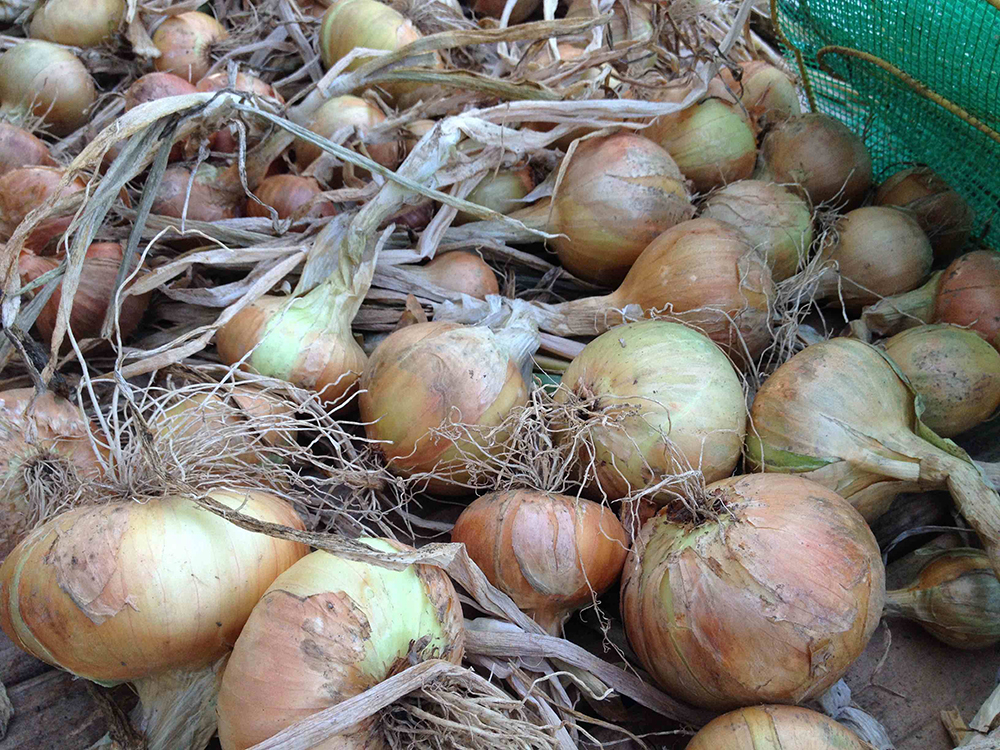 A week or so after the stems have bent over, the leaves will wither and yellow. Lift the onions and shake off the soil. If the weather is dry, place them on a wire rack outside to dry. If rain is forecast, keep them on a rack in the greenhouse or tunnel. Leave for 10 days to dry out or until the skin is paper thin. It is this drying process that gets the onions ready for storing.
A week or so after the stems have bent over, the leaves will wither and yellow. Lift the onions and shake off the soil. If the weather is dry, place them on a wire rack outside to dry. If rain is forecast, keep them on a rack in the greenhouse or tunnel. Leave for 10 days to dry out or until the skin is paper thin. It is this drying process that gets the onions ready for storing.
The presence of moisture in the onions is what causes them to rot in storage so make sure all the moisture is gone from them (particularly in the neck) before you store. Store in net bags or make a braid by twisting the onion tops around some wire or garden twine. Store somewhere cool and dry. Remove any shoots that form over the winter.
The Basics – Bolting
Bolting is a term which refers to vegetable crops that run to seed before their time. The plant is essentially rushing in to procreation mode - trying to spread its seed (by producing flower or seed heads) before it dies. It is a perfectly natural part of the plant's lifecycle, but unfortunately from a GIYers perspective it usually renders them inedible. It is often caused by a cold spell, changes in day length or other stress in the plant such as lack of water. Some plants such as lettuce, rocket and annual spinach are particularly susceptible.
Though bolting occurs as the plant reaches maturity it can be caused or initiated much earlier in the life-cycle. In annual crops it is usually caused by changes in day length but can be worsened by stressed conditions (lack of water, very dry soil etc). In biannual crops it is caused by unsettled weather conditions or a cold spell early in the propagation phase. Cold nights, followed by hot days will also cause it, as will late frosts.
The three main methods of controlling bolting are (1) soil conditions, (2) paying attention to sowing times, and (3) using bolt resistant varieties. I also find that succession sowings are the best way to beat bolting and provide a constant supply of produce.
Seasonal Tip – Make your Own Herbal Tea with Lemon Verbena
Lemon verbena has the most refreshing lemon aroma, much superior in my view to the more usual lemon balm. It makes a wonderful tea herb. All you need to do is to put a few leaves in a mug, pour boiling water over it and drink it a few minutes later.
In South America it is also used medicinally to treat fevers and headaches as well as for its relaxing properties. It is an excellent crop for your polytunnel, greenhouse or conservatory, but it will also do ok outside as long as it’s in a relatively dry, free draining soil, and somewhere sunny.
Recipe of the Month – Kohlrabi Carpaccio
I reckon I’ve come across the secret to cooking with kohlrabi – don’t cook it! Raw dishes make the most of its wonderful crunchiness and flavour. This healthy lunch or supper can be put together in minutes and serves four people.
Ingredients
• 1 medium (or 2 small) kohlrabi
• 4-6 anchovy fillets cut into thin strips
• 50g hard goat's cheese
• 1 tsp fresh thyme leaves
• Juice of 1 lemon
• 2 tbsp rapeseed oil
• Salt and freshly ground black pepper
Peel the kohlrabi, slice it into thin slivers with a vegetable peeler and divide these between four plates (or one larger platter). Scatter the strips of anchovy fillet on top of the kohlrabi, then shave the goat's cheese over, again using a vegetable peeler. Sprinkle on the thyme leaves, squeeze over a spritz of lemon juice and trickle on a little rapeseed oil. Season with salt and pepper to taste, and serve at once.
Michael Kelly is an author, broadcaster and founder of GIY.
Grow It Yourself - August
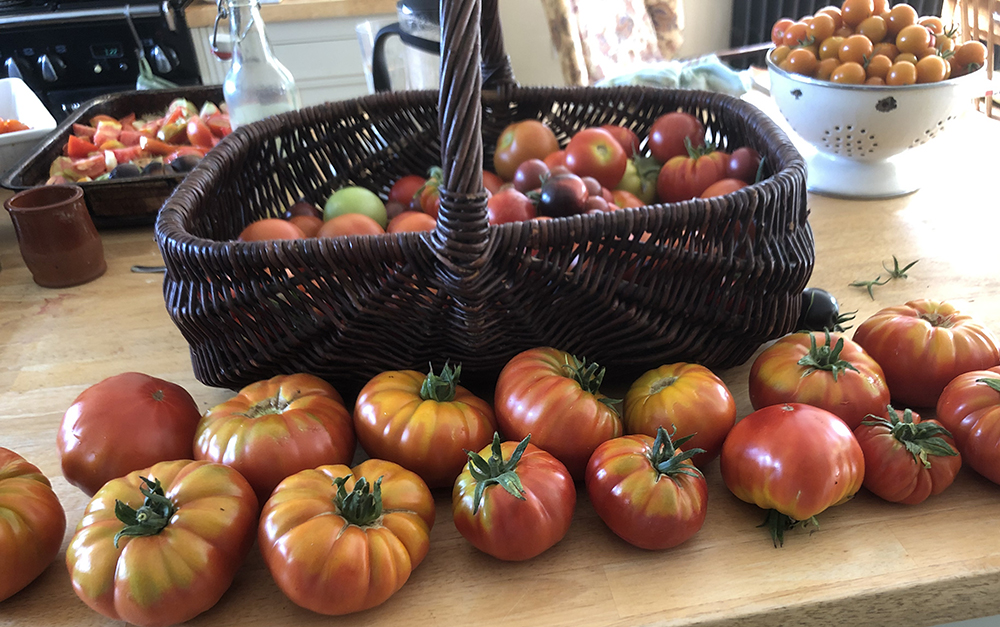
 The veg patch feels like a hard task master right about now, churning out seemingly never-ending gluts of produce. There’s a level on which I feel grateful for this abundance, particularly when it’s all laid out in big beautiful trays, buckets or bowls. But there’s another level in which I feel “ENOUGH ALREADY”, particularly when said trays, buckets or bowls of produce have been hanging around the kitchen for 3 days and I know I have to do something with them.
The veg patch feels like a hard task master right about now, churning out seemingly never-ending gluts of produce. There’s a level on which I feel grateful for this abundance, particularly when it’s all laid out in big beautiful trays, buckets or bowls. But there’s another level in which I feel “ENOUGH ALREADY”, particularly when said trays, buckets or bowls of produce have been hanging around the kitchen for 3 days and I know I have to do something with them.
Specifically, it’s the tomatoes, cucumbers, courgettes and French beans that are unwaveringly relentless at the moment and no amount of chutneying, spiralizing, saucing or freezing seems to get to the bottom of them. The porch (a cool place that’s ideal for storing veg) is full of produce at the moment and I know that after I finish writing this, I should really saucify another 6 or 7 baking trays of tomatoes for the freezer. And after that, I should really go out and harvest another massive batch of tomatoes that need picking too. By the way, if saucify is not a word, it totally should be.
There’s a simple way to reduce the incessant flow of vegetables, and that’s to sow less of them. But sowing less of things is not something that I would ever really consider. I know if I did that, I will just be annoyed with myself sometime after Christmas when I go hunting in the freezer for a lovely home-grown tomato sauce for a pizza and see that we’ve run out. But I reserve the right to whinge and moan a little at this time of the year.
Anyway, there are obvious upsides to all the work, albeit that the gratification is somewhat delayed. At last count, there are now 40 tubs of passata in the freezer which by my nerdish reckoning should take us well in to the late spring of next year (using one a week). Mrs Kelly just finished making a batch of cucumber pickle which is one of the handiest sandwich fillers known to man, and if there is a better accompaniment to a pair of good quality sausages and a decent Waterford blaa, I’ve yet to find it.
We’re spiralising the divil out of courgettes. Spiralising gets dismissed regularly as a rather laughable hipster fad, which is unfair, because actually it’s unbeatable as a way to use up serious quantities of courgettes (and there are always serious quantities of courgettes). Tonight’s dinner of ‘courgetti’ with (you’ve guessed it) tomato sauce, will see our family of four munch through 2 marrow-esque courgettes. We’re also freezing French beans like there’s a flood, war or some other class of pestilence coming down the tracks. 30-odd bags of them in the freezer will join many a quiche, stir-fry or Sunday roast during the Hungry Gap next year.
It’s worth considering amidst the belly-aching, that though the harvest currently seems endless, there will of course be an end at some point and we will rue that day when it comes.
The Basics – How to Save Tomato Seeds
If you had a variety of tomato that was a particular success this year, why not try saving the seeds from the tomatoes to grow next year’s plants? Save seed from open-pollinated varieties of tomatoes only, and not hybrids. When saving seed, think Darwin, theory of evolution and selective breeding - you want to replicate only the strongest of tomatoes. So only save seeds from the very biggest and best of your tomatoes. The tomatoes you select should be ripe but not overripe.
Cut the tomato in half and squeeze the contents (seeds, gel and juice - not flesh) in to a cup or container and label the cup with the variety of tom. Half fill the cup with water. After a few days a mould will form on the water which is a sign that the seed coating has dissolved. The mould will also kill off any seed-born diseases that may be in the seed. Pour off the water and any floating seeds (these are duds that wont germinate). The good seeds should be on the bottom of the cup. Rinse the seeds under a cold tap in a very fine mesh strainer (like a tea strainer). Put the seeds in a single layer on a paper plate (or an ordinary plate with some kitchen roll on it). You want them to dry quickly. Leave for a few days. Bag them up in a labeled envelope and store them somewhere cool (or refrigerate) until next spring.
Recipe of the Week – My Go-To Tom Sauce Recipe
 We’re in full-on tom glut territory at the moment, and so it’s time to pull out the old tomato sauce / passata recipe. We get tubs of this sauce in to the freezer from where they can be plucked in the dreary winter months to form the base for soups, stews and casseroles, pizzas and pastas. It’s designed to be quick and straight-forward and I don’t pay too close attention to how much of each ingredient goes in. Just bung them in to a baking tray, season and add some oil. Bake in the oven, then blitz, cool and freeze. Simple.
We’re in full-on tom glut territory at the moment, and so it’s time to pull out the old tomato sauce / passata recipe. We get tubs of this sauce in to the freezer from where they can be plucked in the dreary winter months to form the base for soups, stews and casseroles, pizzas and pastas. It’s designed to be quick and straight-forward and I don’t pay too close attention to how much of each ingredient goes in. Just bung them in to a baking tray, season and add some oil. Bake in the oven, then blitz, cool and freeze. Simple.
Ingredients:
Per baking tray:
• Tomatoes to fill the base of the tray, halved
• A small courgette, roughly chopped
• An onion, roughly chopped
• 3-4 cloves garlic, skin removed
• Some fresh herbs – sprig of rosemary, thyme, parsley etc
• Olive oil
• Seasoning
Directions:
Pre-heat the oven to 180 degrees Celsius. Half (or quarter them if very large) the tomatoes and put them in to an appropriate sized baking tray. Use several trays if you have a large quantity. You are aiming to fill the base of the tray but leave enough room to add the other veg. Roughly chop the courgette and onion and add to the tray. Roughly mash the garlic cloves and add them to the tray with the herbs. Season well and add a good lug of oil. Mix it all together with your hands to coat the veg in seasoning and oil. Put in the oven and bake for 45 minutes to an hour. Allow to cool completely. Blitz with a hand blender to a smooth, saucey consistency (or leave a little chunkier if you prefer). Bag up in to Tupperware tubs and put in the freezer.
Michael Kelly is an author, broadcaster and founder of GIY.
© GIY Ireland 2019 – all rights reserved.
Grow It Yourself - October
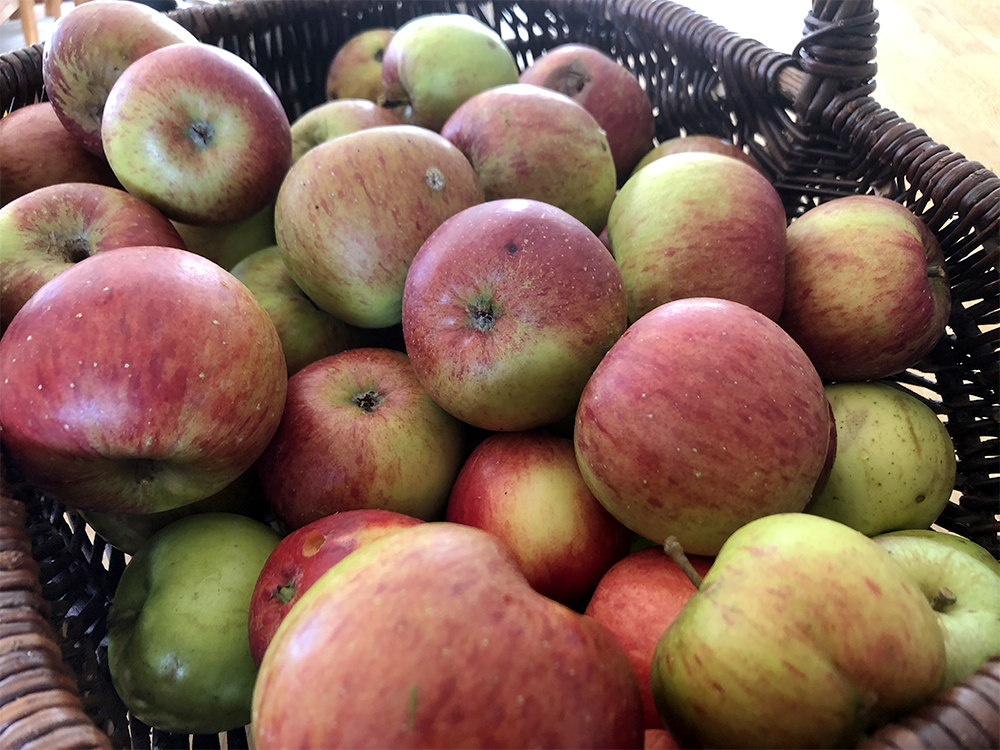
 The summer harvesting of salads and tomatoes might be easing off a little, but it’s replaced by an abundance of apples. The joy of having your own fruit trees is that September brings gluts of fruit but on the flip side the challenge of having your own fruit trees is that you have do something with those gluts…! This week I have been grappling with buckets and trugs-full of apples.
The summer harvesting of salads and tomatoes might be easing off a little, but it’s replaced by an abundance of apples. The joy of having your own fruit trees is that September brings gluts of fruit but on the flip side the challenge of having your own fruit trees is that you have do something with those gluts…! This week I have been grappling with buckets and trugs-full of apples.
We just have 4-5 apple trees in the front garden, but as they mature (they were planted maybe 5 years ago) the amount of fruit they produce is growing dramatically. We’ve been eating apples for a few weeks now – grabbing a handful as we head out the door in the morning – but it’s time to get serious about the harvest while it’s at its ripest. Birds and dogs are our most persistent apple pest at the moment. The former sit on the branches and peck at the fruit while the latter develop a serious seasonal interest, grabbing whole apples straight from the tree and munching them contentedly on the deck..
Getting serious about the harvest means getting up on a ladder (or putting a child on your shoulders..!) and taking all the apples from the tree. There’s a certain hunter-gatherer pleasure in stripping an entire tree of ripe apples rather than picking one or two here and there but then of course the challenge becomes what to do with them. How can we store hundreds of apples to make them last in to the winter? There are three ideas below that we use here at home.
If you don’t have your own apple trees (yet..) the same approach could be used with a bulk purchase of organic Irish apples. Considering that 90% of apples in Ireland are imported, it’s very much worthwhile seeking out a good local supplier and buying in bulk while in season. They need your support, and you get a delicious, seasonal, local product in return.
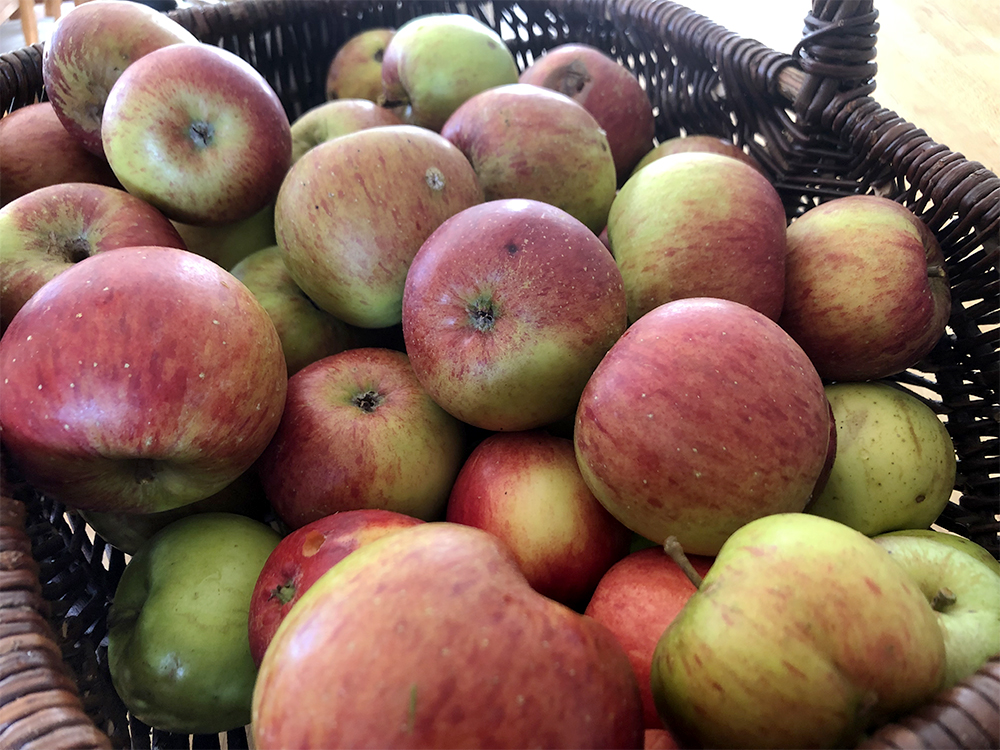 The Basics – Three Ideas for Storing Apples
The Basics – Three Ideas for Storing Apples
1. Store them – wrap each apple in a little newspaper and lay them carefully in a clean plastic bin with thick sheets of cardboard in between layers. Try to make sure the apples are not touching each other. Only store the perfect specimens – direct any fruit with bruising or other imperfections in to the kitchen. Put a tight fitting lid on the bin and store somewhere cool – a cool but frost free shed is ideal. Check the apples once a month or so and remove any that are starting to rot.
2. Dry them – a brilliant way to store apples is to slice them thinly (with a knife or mandolin) and dry them. Dip the slices in a bowl of water that has a tablespoon of lemon juice in it which will stop the slices from going brown. Dry them and lay the slices on to parchment paper on a wire rack, making sure they are not touching each other. Place either over a stove or in a low oven. I found it takes around 4-6 hours in an oven on the lowest setting (70 degrees C), turning them from time to time. Or if the stove is lighting, they should dry overnight.
3. Stew them – peel and core five apples and cut in to chunks and then stew them in a tablespoon of water in a saucepan with a lid for 3-4 minutes. At this time of the year you could add a handful of blackberries too, or you could sweeten a little to your taste with honey. Stewed apple with keep in the fridge for a week, or you can freeze it. We make enormous batches for the freezer and it’s a brilliant thing to have to brighten up your morning porridge over the winter.
Recipe of the Week – Apple Traybake
I like baking that has no faffing and this is a really simple tray bake that you can whip up in minutes.
Ingredients:
• 450g cooking apples
• Juice of ½ lemon
• 225g butter, softened
• 280g golden caster sugar
• 4 eggs
• 2 tsp vanilla extract
• 350g self-raising flour
• 2 tsp baking powder
• demerara sugar, to sprinkle
Directions:
Heat the oven to 180C. Butter and line a baking tin with parchment paper. Peel, core and thinly slice the apples with a knife or mandolin in to a bowl and then pour the lemon juice over them. Mix the sugar, butter, eggs, vanilla, flour and baking powder in another bowl.
Pour half the mixture into the tin. Arrange half the apples over the top of the mixture, then repeat the layers. Sprinkle over the demerara sugar.
Bake for 45-50 mins until golden and bouncy to the touch. Leave to cool for 10 mins, then turn out of tin and remove paper. Cut into bars or squares.
Michael Kelly is an author, broadcaster and founder of GIY.
© GIY Ireland 2019 – all rights reserved.
Grow It Yourself - November


I attended a sustainability conference this week for Climate Finance Week hosted by Sustainable Nation and AIB that brought former UK climate change advisor Sr David King to Dublin. The weather before and after the event was biblical which was appropriate given that what we heard inside Dublin Castle was utterly, utterly terrifying. We become somewhat numb to the endless bad news about climate change, but it could be about to get a whole lot worse as feedback loops create an acceleration of the worst affects. Melting water sitting in lakes on top of arctic ice are absorbing sun light, heating up further and causing more rapid melting. In Siberian Russia, methane gas that was locked in the permafrost for millennia is literally exploding out of the earth, blowing 60 meter craters in the ice. The arctic vortex which generally sits in the atmosphere above the arctic, keeping it toasty cold is ‘meandering’, causing unheard of minus 18 degree C temperatures in Texas.
The final speaker, Not Impossible Labs’ Mick Ebeling is a man that could inspire you to believe that there’s no problem that can’t be solved by human ingenuity and a commitment to change. I am naturally optimistic about the ability of citizens, chefs and companies to affect change, but it couldn’t stop my sense of foreboding that the next decade could be a horror show. The lack of tangible action in the face of the scientific consensus that this is our last chance, is made all the more frustrating by the fact that we know what to do to stop it but we simply lack the political will globally.
As if to reinforce that point, in the space of 24 hours Trump confirmed he was exiting the Paris Agreement and (not to be Out-Trumped) our own Taoiseach told the world that climate change may have some upsides and a ‘ledger’ of pros and cons to be considered. Ah…Leo.. improved winter temperatures in Ireland will not be of much benefit to us as a species if we no longer exist.
Of the many terrifying things Sr David had to say, the most terrifying of all was that the Chinese government (with their deep pockets) are hatching plans to buy up global supplies of rice to protect their citizens in the event of a total rice crop failure at home due to flooding. It’s a reminder in case it’s needed that if the proverbial hits the fan, it will be food that will be most important asset of all. In that context the continuing challenges faced by our own commercial growers and farmers and our lack of appreciation for the value of food is all the more alarming. Over 15 years ago we had over 400 veg growers in Ireland. That’s now down to under 150 and these growers and their generational knowledge continue to be lost in the face of aggressive supermarket discounting of veg, competition from imports and consumer apathy about the value of having an indigenous veg industry.
In the garden it’s been a frustratingly wet couple of weeks, and while I slosh around the veg patch in ever muckier wellies, I’m feeling worried for our commercial veg growing friends. Climate change makes their already enormously challenging commercial environment all the more precarious, and we have to face the reality that if things don’t change we won’t have Irish veg to buy. A third of the national potato crop is still in the ground where it must remain until things dry up a little. The national carrot and brussels sprout crops apparently are showing dangerous signs of climate stress. I think I know how they feel.
The Basics – Sow
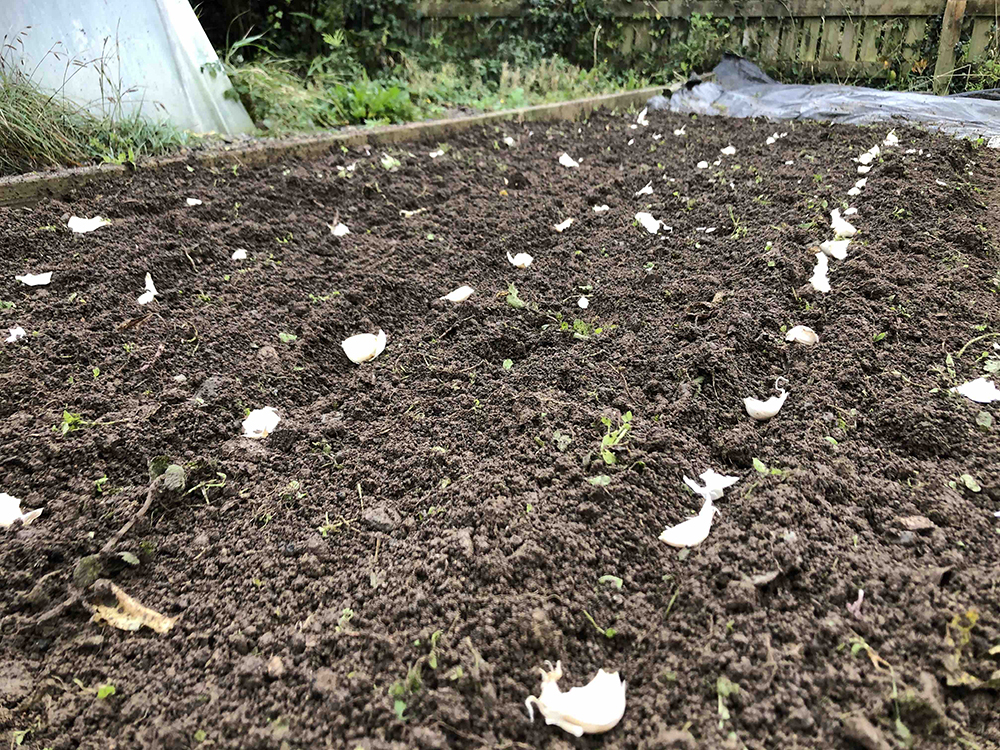 In the face of such alarming news, growing your own food as always offers solace and positivity and the chance to make a statement about how sustainable you want your food choices to be. Though you might not think it, there are still some things you can sow at this time of the year. This is the ideal time for sowing garlic but you can also sow over-wintering onions, peas and broad beans. Broad beans are best sown direct in the soil. Level out the soil with a rake and then using the end of the rake, mark out two shallow rows (45cm apart). Place the broad beans on the surface of the soil in the rows, 15cm apart. How many beans to sow, really depends on how much you like broad beans and how much space you have available – I find 15-20 plants or so is more than enough for a serious crop. Using your finger, push the beans 5cm down in to the soil and then rake the bed again to cover the holes.
In the face of such alarming news, growing your own food as always offers solace and positivity and the chance to make a statement about how sustainable you want your food choices to be. Though you might not think it, there are still some things you can sow at this time of the year. This is the ideal time for sowing garlic but you can also sow over-wintering onions, peas and broad beans. Broad beans are best sown direct in the soil. Level out the soil with a rake and then using the end of the rake, mark out two shallow rows (45cm apart). Place the broad beans on the surface of the soil in the rows, 15cm apart. How many beans to sow, really depends on how much you like broad beans and how much space you have available – I find 15-20 plants or so is more than enough for a serious crop. Using your finger, push the beans 5cm down in to the soil and then rake the bed again to cover the holes.
Recipe of the Week – Traditional Shepherd’s Pie
In the olden days, meat pies were done with left over stew and not with mince. The reheated stew was then topped with pastry or with mash potato (more traditional in Ireland). The diced lamb in GROW HQ’s Head Chef JB’s Traditional Shepherd’s Pie gives this a fantastic texture, and it’s full of in-season vegetables – garlic, carrots, parsnips and onions.
Ingredients
• 500g diced lamb
• 4 large tomatoes or 1 small tin of chopped tomatoes
• 2 garlic cloves
• 2 medium carrots
• 1 parsnip
• 1 large onion
• chopped rosemary leaves
• 200 ml good homemade chicken stock (made from the left-over bones of a roast chicken)
• pinch of salt
• 1 Tbsp cooking oil
• 700g nice buttery mash potato to cover the top
Directions
Fry off the diced lamb with a little cooking oil in a wide stock pot for 5 to 6 minutes until golden brown. Peel and slice the vegetables. Add the vegetables to the meat and fry off for 3 to 4 minutes.
Add the chopped garlic, rosemary and salt. Add the chopped tomatoes and the chicken stock and simmer on low heat for 2 to 3 hours until the meat start to become flaky. Pour the lamb stew into a pie dish, cover with mash potato and bake at 150 degrees celsius for 45 minutes.
Michael Kelly is an author, broadcaster and founder of GIY.
© GIY Ireland 2019 – all rights reserved.
Sustainable Christmas tips from the Green Guru Michael Kelly of GIY
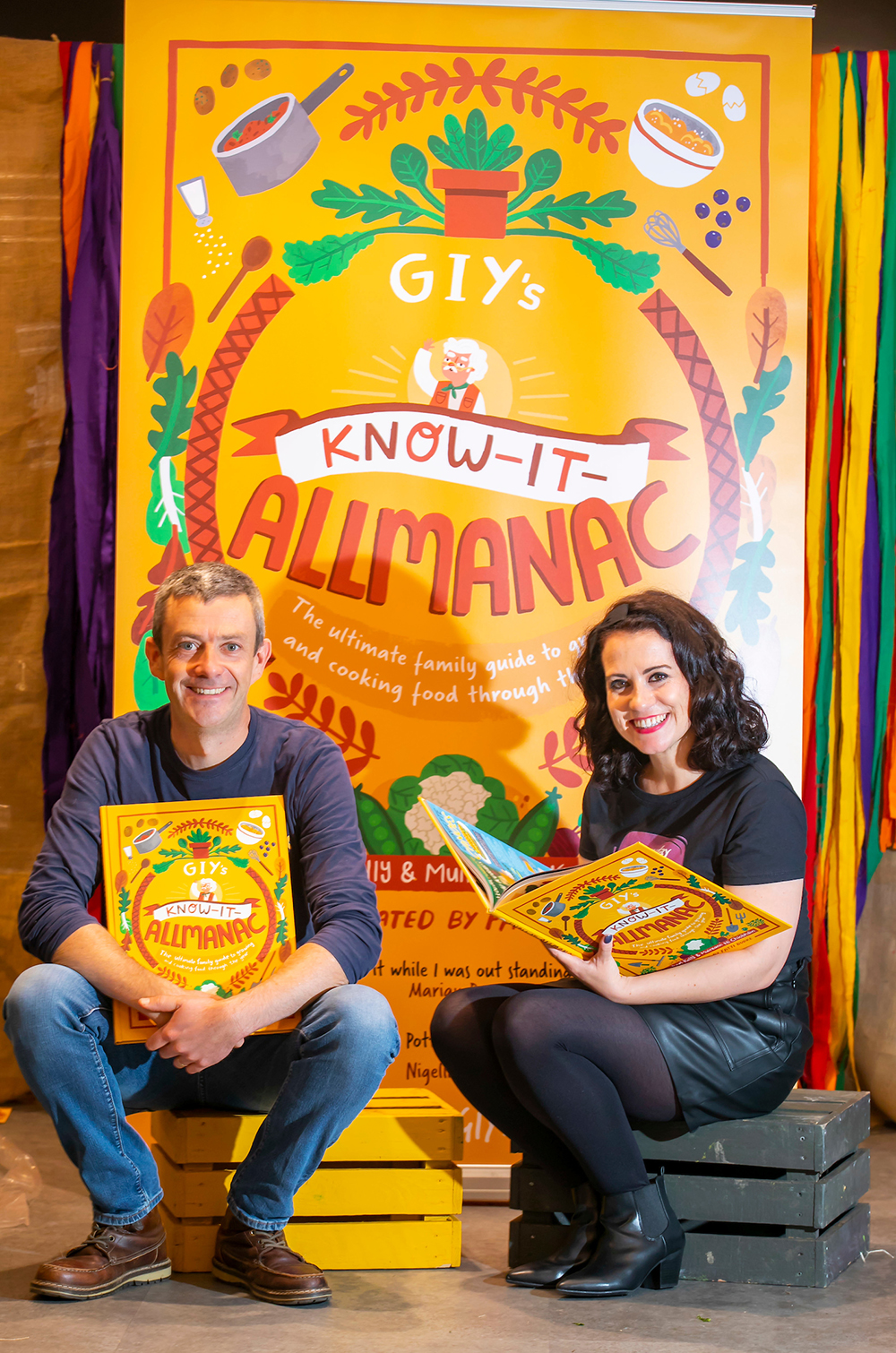
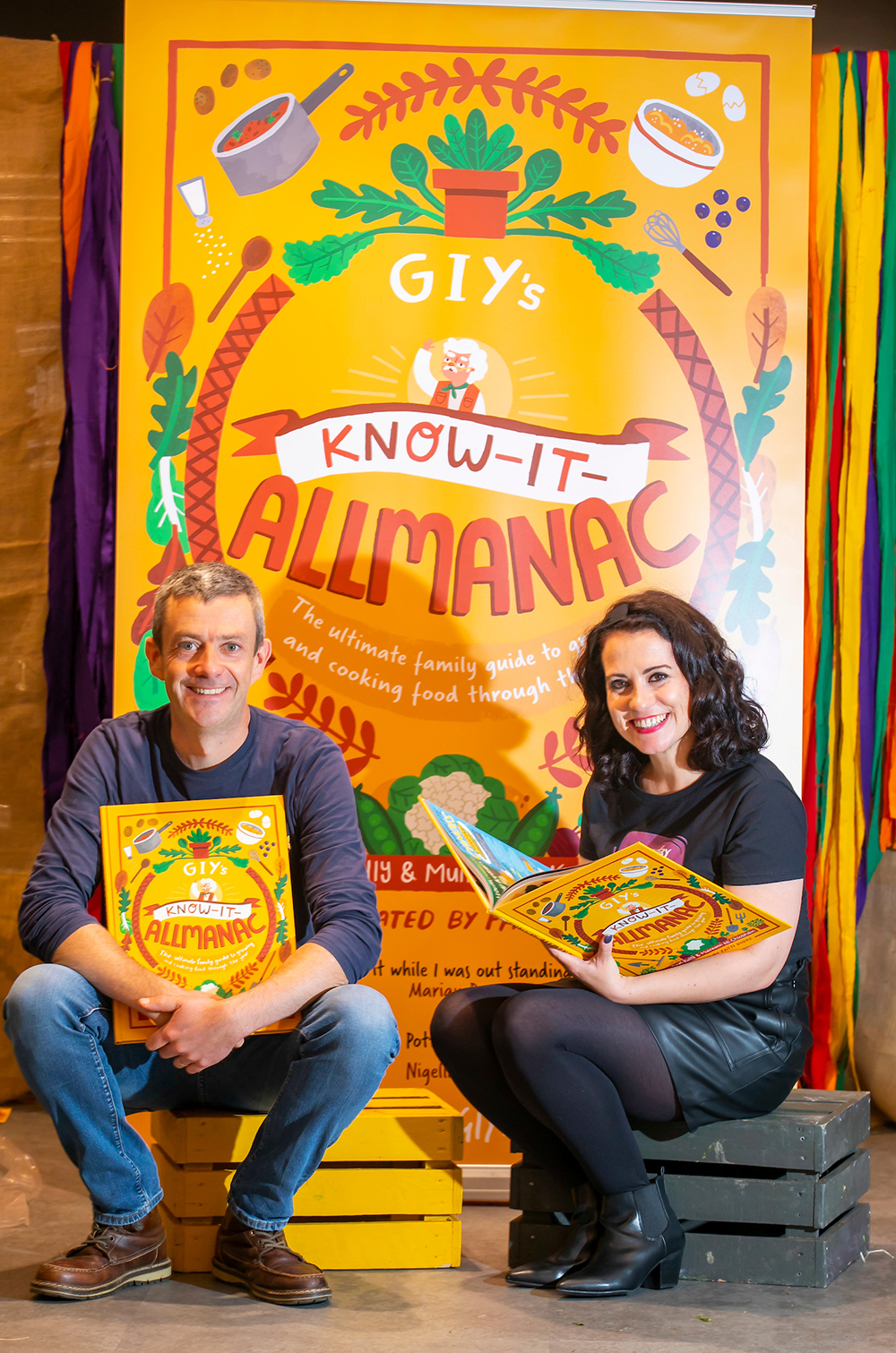
Michael has been sharing his passion for sustainable and seasonal living for over 10 years now and he shares some of the things he has learned in order to have a more eco-friendly festive season.
Top Tree Tips
Michael says, when it comes to the tree, choose a live one; live trees are a renewable resource and are replanted on tree farms contributing to our air quality and ecosystem. “You could also opt for a potted tree for indoors and then enjoy a ‘Nature Restoration’ activity with the family after Christmas as you plant it outside again or place it outside in a large pot and decorate it for the birds with seed balls, peanut butter and seed trays. It’s a fun activity for the kids and offers an important food source during the long cold winter days of winter for the birds. And finally, on the tree, of course, use LED lights on the Christmas tree and at home!
Dinner Time Wins
On to the dinner, the first tip is to buy less, every year Irish households dump tonnes of food waste, we never need as much as we think so don't fill that trolley.
A Turkey and ham dinner with all of the traditional trimmings can see 10’s of thousands of food miles racked up. We all need to make a more conscious effort of buying local and hyper-local, buy your food from a farmers' market or direct from producers themselves not only will it taste better but it is a more sustainable food shopping practice. And if you do have leftovers - a turkey carcass makes great stock for soups and you can compost the vegetable peel.
Go green with gifts
Homemade gifts are not only thoughtful but, for more unusual presents, homemade treats or sauces are a completely unique gift. In the GIY Know-It-Allmanac (see below) we have some delicious recipes for Rocket Pesto, homemade ketchup or Beetroot Chocolate Brownies all so simple that even kids can make them successfully. Ideally, reuse wrapping paper and if you do feel you have to buy some then avoid the shiny please and buy some brown paper which is fully recyclable.
Christmas is also a wonderful time to reconnect with nature. Consider starting a family tradition of a nature walk or plan a small patch of the garden for growing your family’s favourites during 2020. The GIY Know-it-Allmanac is a month-by-month guide to growing, cooking and eating food and it has all the tips and tricks that you could need. It focuses on seasonal foods and highlights each month’s significant dates, likely weather, along with ‘get crafty’ projects and garden to-do lists.
GIY’s Know-it-Allmanac is published by GIY. It is a 104-page hardback and is available from all good book shops and also online at www.giy.ie and is priced at €25.00
Grow It Yourself - September
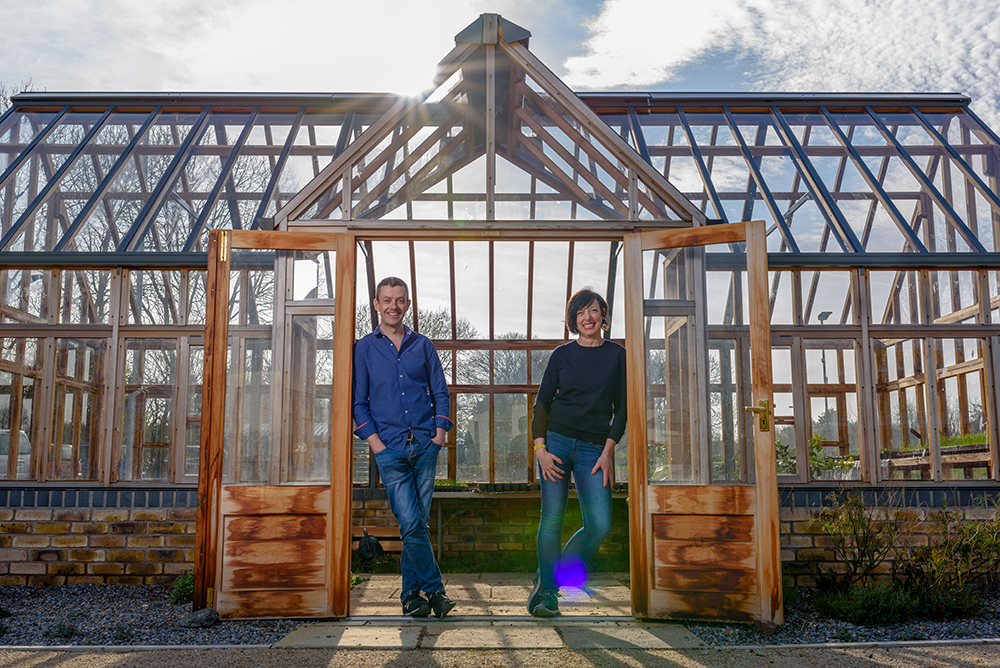
Tips For Reducing Food Waste
 The benefits of growing your own food are endless. Not only can it improve your health and save you money, but it is also a fantastic way to reduce your food waste. In Ireland, there are over one million tonnes of food waste disposed of every year and around 1/3 of this comes from households. Here are some of our top tips and you can also find more information at StopFoodWaste.ie
The benefits of growing your own food are endless. Not only can it improve your health and save you money, but it is also a fantastic way to reduce your food waste. In Ireland, there are over one million tonnes of food waste disposed of every year and around 1/3 of this comes from households. Here are some of our top tips and you can also find more information at StopFoodWaste.ie
Change Your Shopping Habits
To begin, you can start with your shopping habits – the next time that you go to the supermarket, be conscious, and look out for these few things:
1. Shop Smart: Make a list before you go shopping and stick to it, plan your meals and how much you will need and don’t stray from it. This is fundamental when trying to reduce food waste. Also, when you are actually in the store, pick up your fresh produce last.
2. Don’t forget to eat before you go: This one is easier said than done! But if you eat before you do your shopping you rare likely not to over-buy (something that we are all capable of!).
3. Try to buy loose fruit and veg: This is for obvious reasons – you only need to buy as much as you are going to use. You should find delicious local produce at your local food markets. You can find your nearest market with NeighbourFood.
Compost
By composting at home, you reduce the need to collect, process, treat, and/or dispose of biodegradable materials. This saves landfill space and the fuel needed to move things around.
Make Your Own Compost: Here’s how to make great compost for your veggie patch using two of the great waste creators in the home and garden - newspapers and grass cuttings. Build a heap (the ground surface area should be 1m by 1m) of alternating 30cm layers of crumpled newspaper and grass cuttings. Allow the heap to get quite tall - 4-6ft - and then leave it to rot down for a year.
Watch Mick and Karen give their top 4 composting tips from our TV Series GROW COOK EAT here.
Change Your Kitchen Habits
1. Preserve food: Produce doesn’t have to be tossed just because it’s reaching the end of its peak. Soft fruit can be used in smoothies; wilting vegetables can be used in soups, etc. And both wilting fruits and veggies can be turned into delicious, nutritious, juices, Chutneys & Jams. Fermented foods such as kimchi and sauerkraut are not only good for your gut but are also another great way prevent wasting food.
2. Practice first in first out “FIFO”: When unpacking groceries, move older products to the front of the fridge/freezer/pantry and put new products in the back. This way, you’re more likely to use up the older stuff before it expires.
3. Eat Leftovers: Pack them for work or school for a free packed lunch. If you don’t want to eat leftovers the day after they’re cooked, freeze and save them for later.
4. Grow your own food: Growing greens prevents food waste, saves money and is an excellent way to get a taste for GIY (Grow it Yourself). We recommend starting with lettuces and herbs – two of the most commonly wasted food that are also some of the easiest to grow! You can make growing greens even easier with our Grow Your Own Salads GROWBox which comes with everything you need to grow your own. Also everything that comes in the GROWBox is 100% compostable so you won't have to worry about any waste with this!
Get Creative In The Kitchen - Competition
The idea for this stems from our event 'The Wasted Supper Club'.
The aim of the Wasted Supper Club is to highlight the huge issue of food waste in our society and to educate each other on how we can use more of our food, root to stem as we like to say, by getting creative.
For this competition we want you, at home, to create a meal with a twist. An element of this dish MUST be created from something that you would normally deem as 'food waste' e.g. potato skins; fish bones; wind-fallen apples; lemon skin; cucumber water, celeriac skin; pumpkin flowers; pepper seeds; cauliflower leaves, etc. Get creative in the kitchen, there are so many possibilities!
You then take a picture of this meal and upload it to social media using the hashtag #HQRootToStem - you will then be in the draw to win a beautiful hamper of food waste supplies and a €100 voucher for GIY/ GROW HQ. The competition will end & the winner will be announced on Friday the 18th of September.
Meanwhile, we will post recipes ideas, food waste tips and we will be asking you your opinion on food waste. Get the whole family involved and be as creative as can be!
Best of luck - let the brainstorming begin!
Facebook
Twitter
Instagram
Weekly Challenge
Keep a diary
Keeping a diary can highlight where you are most wasteful and you can see ways in which you may be able to reduce waste in the future.
Make your own waste tracking diary and tag GIY on socials!
Join our GIYers Facebook Group
For more growing advice we have set up a GIYers Facebook group as a place where all our GIYers can come together to share their growing tips, tricks, and troubles.
What is the GIYers Facebook Group? We have set up a new Facebook group and are encouraging all you GIYers to ask any questions and kick off discussions you might have about growing.
This group will also feature;
* Exclusive GIY resources
* Q&As
In this group feel free to:
* Answer questions posted
* Share your own growing journey & progress
* Post any tips & tricks you've learned
* Ask your own questions if you're having trouble (it happens to the best of us).
GROWBox
Our GROWBoxes provide you with everything you need to get growing in your home as soon as it is delivered to your door.
GIFT VOUCHERS
Gift the gift of a GROW HQ experience - our gift card can be used in our award-winning cafe, for any of our courses, and our retail shop.
SEEDS
We use only trusted Irish suppliers and select varieties known for their reliability, yield and taste.
Follow GIY
Facebook | Twitter | Instagram | YouTube
Visit Our Websites: https://giy.ie/
Michael Kelly is a freelance journalist, author and founder of GIY.
© GIY Ireland 2020 – all rights reserved.
Grow It Yourself - October

Grow-It-Yourself guru Michael Kelly reminds us that, as well as doing the final harvesting and tidying up, we can start planting new crops this month. And it’s time to fall back in love again with old winter reliables such as chard and spinach. They will shortly become our very best friends.
 October is really the month for harvesting and gathering all that remains in your plot so it seems strange that you can sow or plant new crops. But there are a couple of vegetables that seem to prefer a cold start and usually perform much better if sown in October, so let’s take a look at what you can sow, along with other jobs we should be doing for this spooky season.
October is really the month for harvesting and gathering all that remains in your plot so it seems strange that you can sow or plant new crops. But there are a couple of vegetables that seem to prefer a cold start and usually perform much better if sown in October, so let’s take a look at what you can sow, along with other jobs we should be doing for this spooky season.
Pot up herbs so that they can be grown inside for use during winter. Continue to lift crops that have finished harvesting and clean up the beds. By now, green manures sown in late summer will be ready to be dug in to the soil. You can also sow over-wintering green manures now. Try and find a good source of farmyard manure if you don't have your own – cow, horse, pig, sheep and chicken manure are all great sources of nitrogen, phosphorus and potassium. If you are going to cover empty beds down with manure for the winter, the earlier you do it the better. October or early November is ideal.
To Do List
• Pull up crops which have finished harvesting and compost.
• Plant fruit trees and bushes.
• Tidy away canes and supports that you used for your peas, beans etc and you should be able to use them next year.( Leave them in the ground or throw them in a corner, and you probably won't.)
• If you have a pond, stretch a piece of netting over it to keep leaves out.
• Start collecting leaves for leaf mould.
• Start storing vegetables like carrots and beets – only store the perfect specimens. Try and process the rest.
• Check apples regularly to see if they are ripe – early ripening apples generally don't store that well.
• Cut autumn fruiting raspberry canes down to the ground.
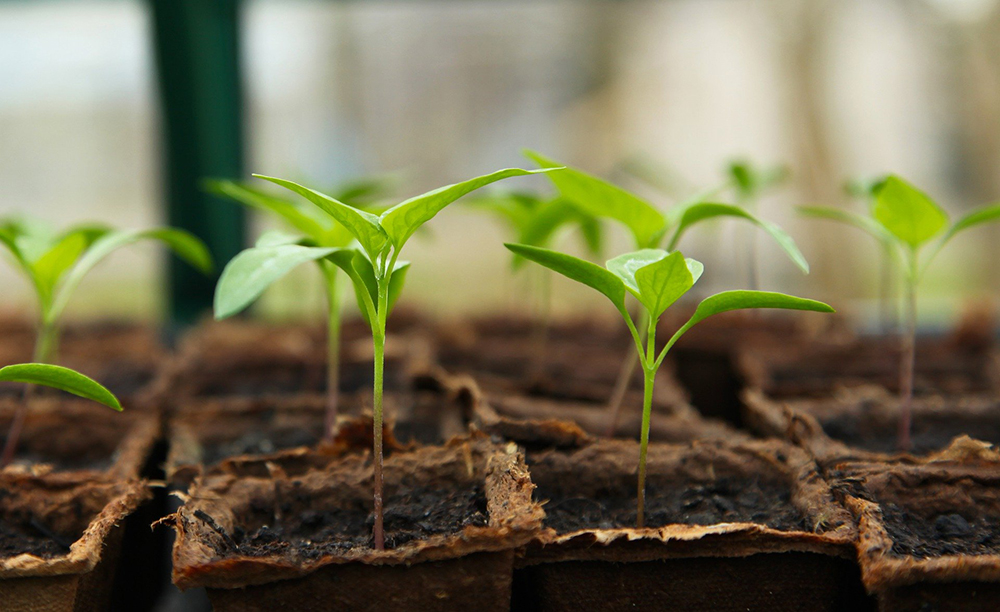 Sowing Seeds & Planting Out
Sowing Seeds & Planting Out
You can sow hardy varieties of peas and broad beans later this month for an early spring crop but only do so in well-drained soil. In the polytunnel get a crop of cauliflower and carrots going over the winter. Plant selected varieties of garlic and winter onion sets (visit GIY online shop for varieties). The former will benefit from a good frost so it's traditional to plant before Christmas.
Harvesting
Depending on the weather, the harvest may continue well into October – it's also a month when you are still harvesting many of the great autumn fruit and vegetables – pumpkins, squashes, courgette, apples, pears etc. It's the last hurrah however for peas, French and runner beans, tomatoes, cucumbers, aubergines, peppers and chilli-peppers. Continue to harvest wild mushrooms, elderberry, blackberries, apples, sloes, pears, peas, French and runner beans, tomatoes, cucumbers, aubergines, peppers, chilli-peppers, carrots, parsnips, swedes, celeriac, turnip, beetroot, potatoes, celery, marrows, pumpkins, squash, leeks, cabbage. Root crops like carrots, parsnips, swedes, celeriac, turnips and beetroots, as well as main crop potatoes should still be thriving. You can leave these in the ground for another while yet and use them as you need them, or lift and store if you prefer. Start to fall back in love again with old winter reliables such as chard and spinach. They will shortly become your very best friends.
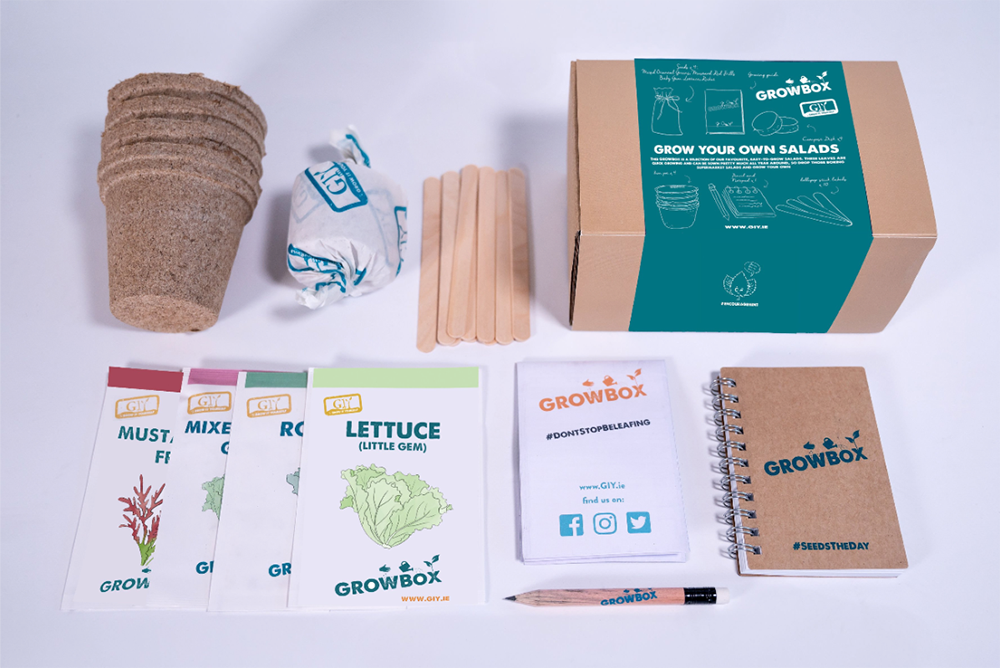 New GROWBox Alert - Grow Your Own Salads
New GROWBox Alert - Grow Your Own Salads
Salad leaves are one of the quickest and easiest crops to grow, ideal for sowing in pots & window-boxes. Harvesting the young leaves when you need them prevents plants from maturing and ensures several harvests of small, tender, mild-flavoured leaves over a long period of time.
Seeds
• Mixed Oriental Greens
• Mustard Red Frills
• Baby Gem Lettuce
• Wild Rocket
• Pencil and Notepad – always a good plan to jot down your sowing dates, progress and good intentions.
• Plant Labels – no, you won't remember what's in each pot! Always label them.
• 8cm pots x 4 – for sowing some of your seeds into.
• Compost discs x 4 – one for each pot (they bulk out when you add water).
Shop GROWBox
Prepare a Crop Rotation
Crop rotation is a fancy term for grouping similar vegetables together and moving them around each year to prevent a build-up of pests/disease and to maximise soil fertility. The groupings generally have the same or similar nutrient requirements and keeping them together means that you can more easily provide them with the best growing conditions – for example, the brassica family (cabbage, kale etc.) prefer a slightly alkaline soil and you can therefore put lime in the bed where they are to be planted to reduce acidity. You can divide your vegetable patch into areas and move the veg families around to different areas. Or, if you grow in raised beds you can allocate a raised bed (or several raised beds) to each family. Draw a plan of your beds and write down where you planted things so that you can refer to it the following year. No, you won't remember!
Join our GIYers Facebook Group
For more growing advice we have set up a GIYers Facebook group as a place where all our GIYers can come together to share their growing tips, tricks, and troubles.
In this group feel free to:
• Answer questions posted
• Share your own growing journey & progress
• Post any tips & tricks you've learned
• Ask your own questions if you're having trouble (it happens to the best of us).
This group will also feature:
• Exclusive GIY resources
• Q&As
• VOUCHERS
• Gift the gift of a GROW HQ experience - our gift card can be used in our award-winning cafe, for any of our courses, and our retail shop.
SEEDS
• We use only trusted Irish suppliers and select varieties known for their reliability, yield and taste.
Grow It Yourself - November
.jpg)
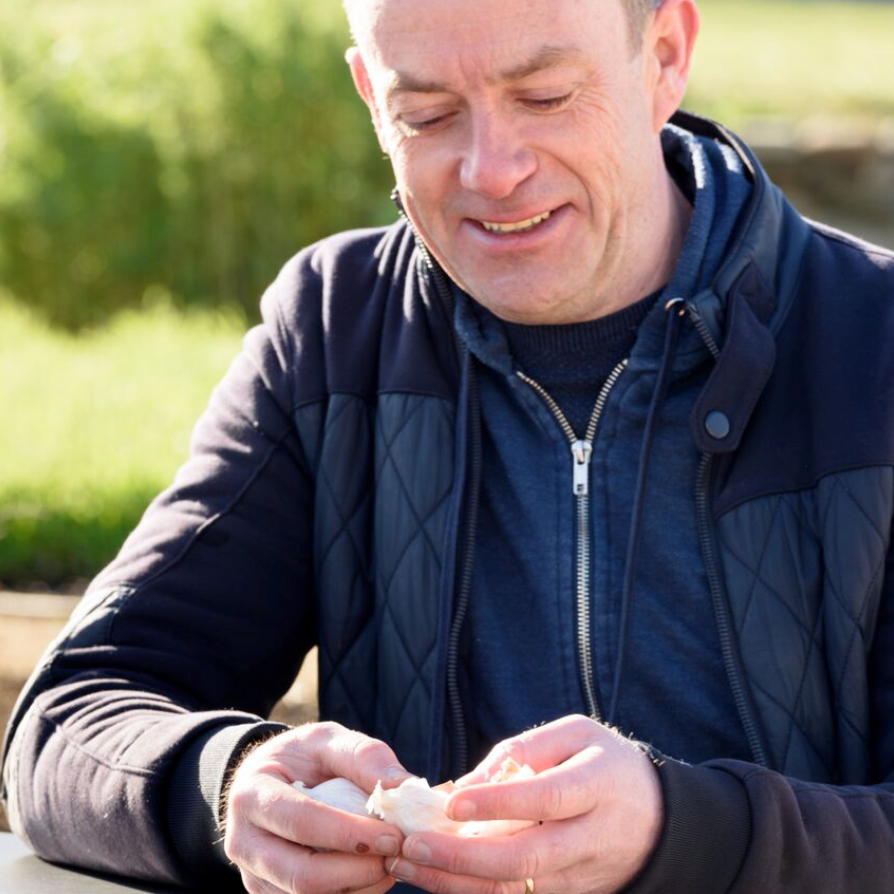 Garlic is where it all started for GIY, so of course, we grow loads of it at GROW HQ. Since most of the garlic available in supermarkets is from China (still, grrrr), it's a great one to grow yourself.
Garlic is where it all started for GIY, so of course, we grow loads of it at GROW HQ. Since most of the garlic available in supermarkets is from China (still, grrrr), it's a great one to grow yourself.
In case you don’t already know it, here’s the famous Garlic Story. A man walks into a supermarket...
Once upon a time there was a pale, chubby IT salesman called Michael, or Mick, but never Mike. One day Mick was food shopping for the family. Mick likes garlic, so Mick decided to buy some garlic. Good man Mick. But, wait a minute, what's this?! On a 90cent garlic bulb the sticker read "product of China". Now Mick has nothing against the Chinese per se. But China is a good 5,000 miles away from Ireland. And garlic is not exactly fussy. It's not like a panda, it doesn't need a specific temperature and nutrition and mood music and all that malarkey. So why the hell did someone decide to treat this garlic to the trip of a lifetime for 90cent a bulb?
That was the moment, the one on which Mick's entire life pivoted. Not content to remain a pale, chubby, foreign-garlic-buying IT salesman any longer he sallied forth from that mid-priced supermarket to grow his own damn garlic! And thus began the GIY story....
.jpg) GARLIC GROWING GUIDE
GARLIC GROWING GUIDE
Sowing
Most GIYers sow garlic in early winter (Oct-Dec, but before the shortest day of the year – Dec 21st) as the bulbs benefit from a cold snap. Some varieties however can be sown in spring but they won't grow as big. Pick a sunny site, with good fertile, free-draining soil. Apply an organic fertiliser before sowing. Divide the garlic bulb into cloves and plant each clove just below the surface, about 4-5 inches apart, in rows 12 inches apart. If soil is very wet, sow in module trays and transplant when sprouted.
Growing
As with onions, garlic hates weed competition so keep the bed weed-free. Hoe carefully around the bulbs once or twice over winter. Water occasionally in dry weather but don't over-water.
Harvesting
Harvest when at least half to two-thirds of leaves on each plant are yellowish-brown. Autumn sown garlic will be ready in early summer. Do not allow them to go too far as they lose flavour. Lift carefully using a trowel. Dry on racks in sun (or indoors in wet weather) for two weeks. Hang in plaits.
Where To Buy Garlic?
We recommend getting your garlic from garden centres or directly from producers as most garlic sold in supermarkets are grown in different countries and therefore usually need to grow in different climates to Ireland. If you do want to chance it and grow some supermarket garlic try growing them in containers!
.jpg) Watch GROW COOK EAT - GARLIC EPISODE
Watch GROW COOK EAT - GARLIC EPISODE
To find out more about growing this fantastic veg why not grow along with Mick and Karen? Garlic took the role of our superstar veg in series 1 of GROW COOK EAT. Series 1 & 2 are available to watch on our YouTube channel now.
Watch Now
GIFTS
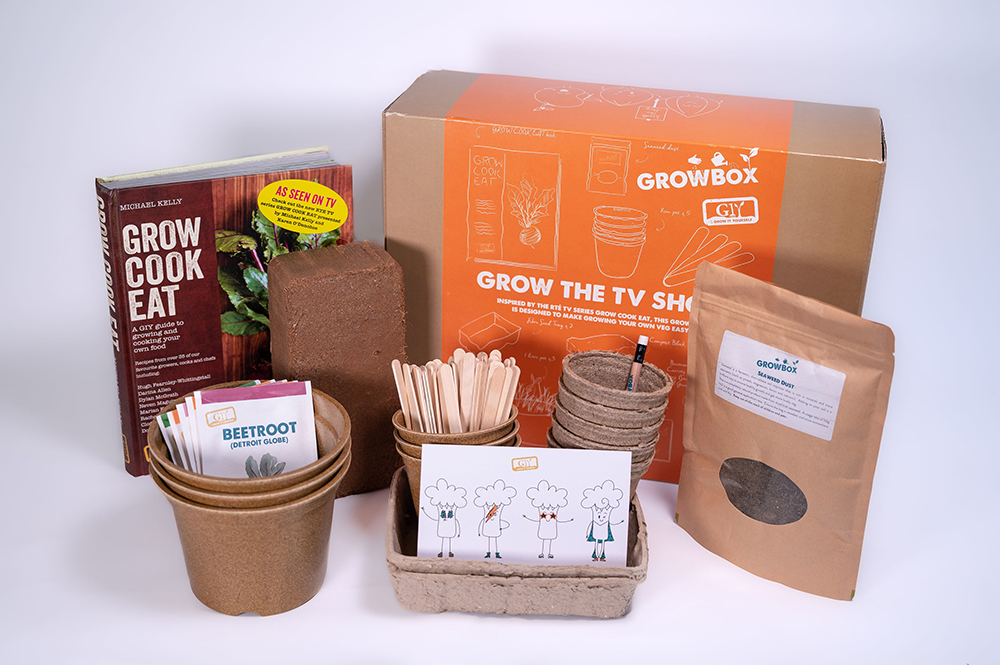 Give The Gift Of GROWBox
Give The Gift Of GROWBox
Our full range of GROWBoxes are back and make the perfect gift for someone you think needs to get growing. From bees to salads there is something for all kinds of growers. You can shop the full range on the GIY website.
Shop Now
Vouchers
Gift the gift of a GROW HQ experience - our gift card can be used in our award-winning cafe, for any of our courses, and our retail shop.
Seeds
We use only trusted Irish suppliers and select varieties known for their reliability, yield and taste.
GIY - What's in Store for February?
 .jpg)
.jpg) With what always feels like the longest month of the year finally coming to an end it's time to look forward to Spring and all that this amazing season has to offer. As we find ourselves, once again, staying indoors there is no better time to start some indoor sowing or get the garden prepared for the March growing season.
With what always feels like the longest month of the year finally coming to an end it's time to look forward to Spring and all that this amazing season has to offer. As we find ourselves, once again, staying indoors there is no better time to start some indoor sowing or get the garden prepared for the March growing season.
At GIY we want to help you stay active and stay positive during this time so here are some of the goings-on at GIY for the month of Feb - and you can sign up for our regular newsletters here.
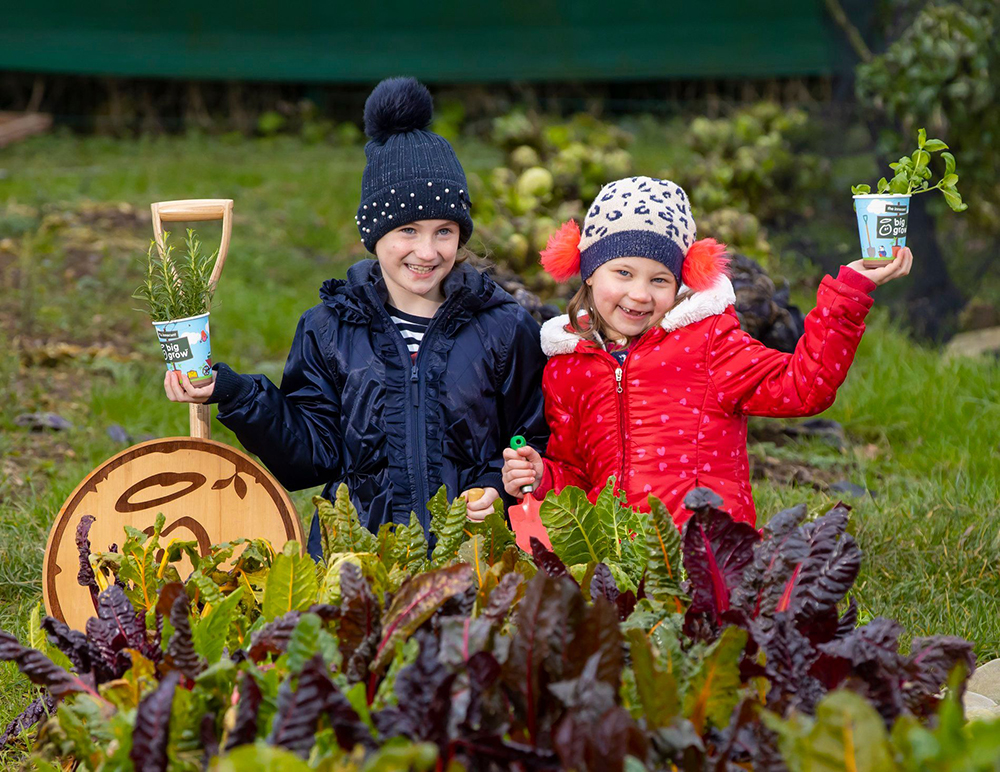
The #BigGrow launch is here and this year it's extra special - this year marks our 10 year anniversary working with the amazing Innocent Drinks Ireland & innocent to help kids in Ireland and the UK to start growing their own food.
Even though schools are closed, we are continuing to call on teachers to sign up for free food growing classroom kits to welcome pupils back when classrooms open again.
Today kicks off the tenth year of The Big Grow, an initiative that began to get kids growing their own veg at school, helping thousands of schools to get free growing resources.
Schools across Ireland are invited to apply for a food growing kit, which comes with five packs of different seeds and enough compost, growing cups, instructions, and fun lesson plans for the entire class.
Although schools are closed at the moment, the kits will be sent once everyone's back in class just in time to start the growing season. The growing cups are easy for kids to take home and do the activities in their kitchen too. Apply Now
Grow Cook Eat Series 3 Is Back
Starts Feb 15th at 8.30 on RTE
Great news for all our GROW COOK EAT fans, series 3 will repeat on RTE starting in February. Over 3 years we have now featured 21 veg (well 20 veg and 1 fruit) as well as dozens of fantastic growing stories from around the country. Join Mick & Karen as they get another 7 delicious veg from plot (or pot to plate)
Catch Up: If you can't wait until then for series 3 you can catch up on RTE player or on Amazon Prime
YouTube: Make sure to check out our YouTube channel to find all the #GrowCookEat growing guides, recipes, and tutorials in one place. Full episodes of series 1 & 2 are also available to watch.
Resources: Visit our Grow Cook Eat website to help get you GROWing and/or COOKing.
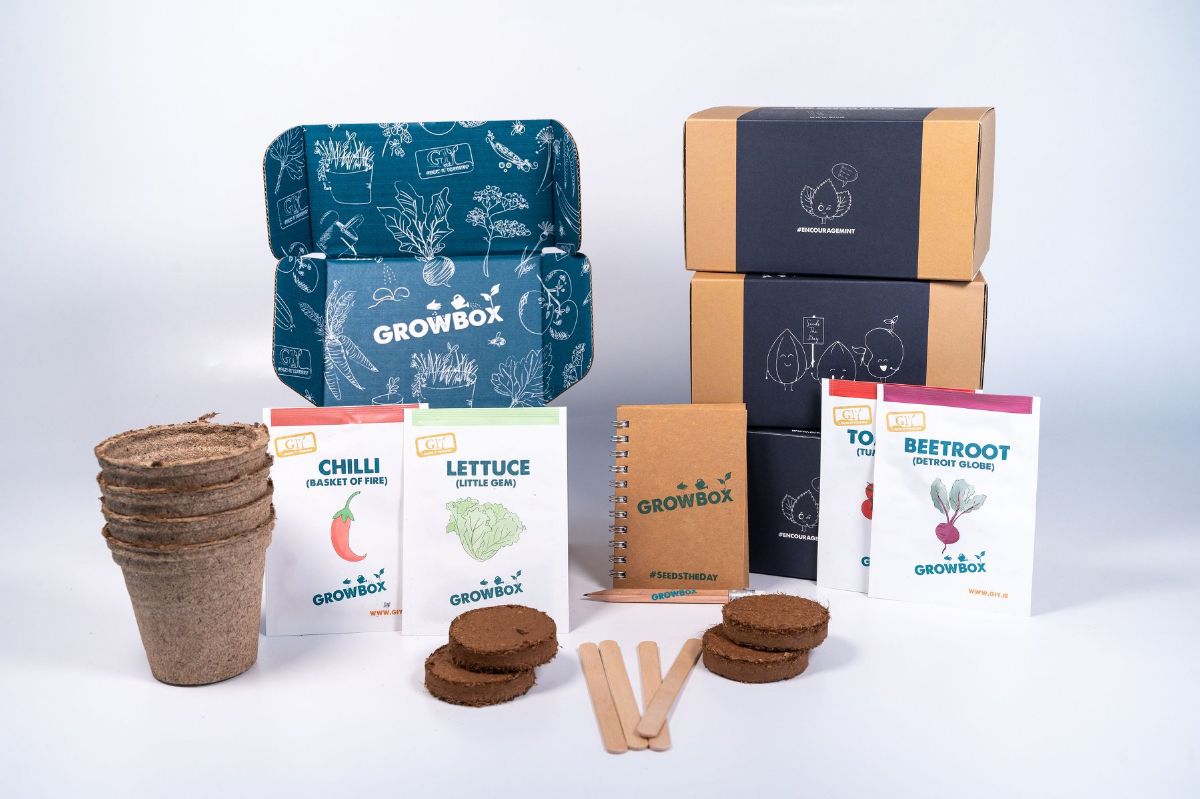 GROWBox Subscription
GROWBox Subscription
Early-Spring GROWBox Ships Next Week
Can't decide what veg you want to grow? Or maybe you've left it too late and can't get your hands on your favourite seed varieties. With GIY's GROWBox Subscription all the work is done for you so all you have to do is sow, grow and harvest!
The GROWBox Subscription is a seasonal subscription that comes with 4 GROWBoxes that will be delivered to your door just in time for each growing season. Get ready to have fresh, homegrown food all year round!
Our first GROWBox will be dispatched from next week so be sure to order now to get it in time.
Grow It Yourself - Hurrah for Spring!
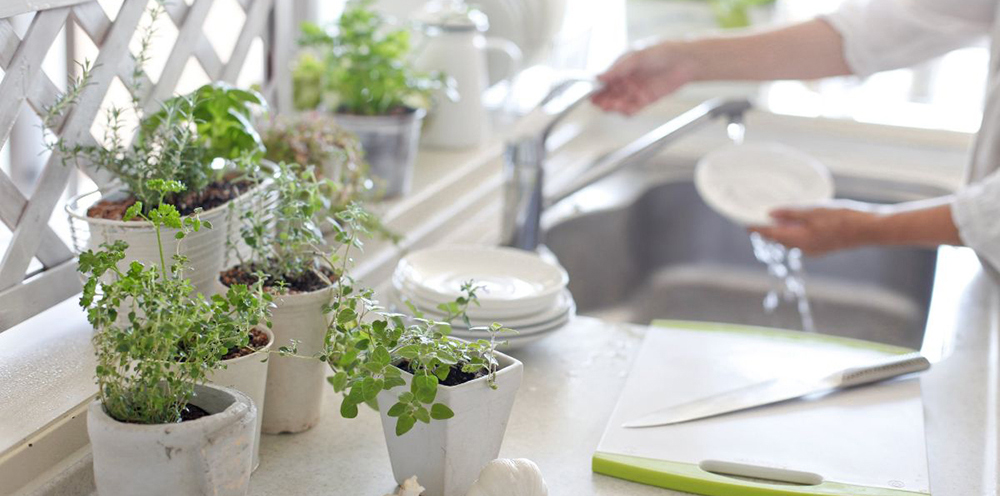
GIY founder Mick Kelly has plenty of advice for everyone who’s starting out to grow some food crops this year - and the great news is that you don’t even need a garden!
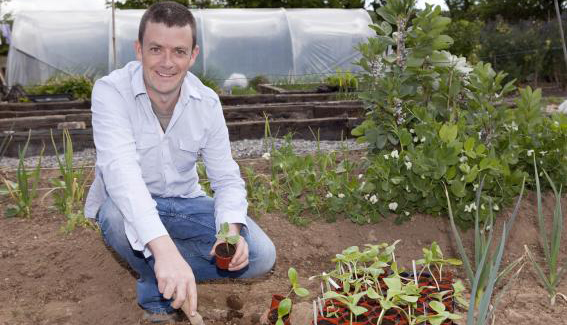
It’s March and spring is officially here (hurrah!), marking the beginning of the busiest three months in the gardener’s calendar.
Ground preparation, early sowing and planting, and keeping weeds and slugs at bay are the main jobs this month, ahead of the main planting time when the soil warms up - and you can follow the GIY To Do list for March here.
But - now that the pandemic has encouraged so many newbie growers to have a go - the really good news is that you don’t even need a garden! With a little bit of imagination, GIYers can grow lots of great vegetables on decks, patios, terraces, flat roofs, balconies, conservatories, or even on a kitchen shelf or windowsill.
Basics
• Most vegetables will grow well in containers and pots but they are demanding when grown this way – because the roots are restricted in terms of the nutrients and water they can access, they need plenty of water and may require additional feeding.
•On the other hand, the problems that many GIYers have with poor soil in their gardens, generally aren't an issue when you grow in containers, since you are using shop bought compost. There are also fewer problems with weeding and there is no digging required!
• Pretty much any container can be used to grow vegetables in, so let your imagination run riot! Pots, troughs, hanging baskets, window boxes, grow bags, wheelbarrows, old watering cans, tyres etc. The bigger the container the better – a minimum of 6 inches deep but 8 inches or more would be better, particularly for root vegetables like carrots. A very deep container of 12-15 inches would be ideal for deep-rooted plants like tomatoes.
• There must be some form of drainage holes in the base of the container. In a larger container put in a layer of 1cm of small stones to aid drainage.
• Garden soil is unsuitable for container growing. Use shop-bought compost (but not potting compost, which does not have enough nutrients in it) or make up a mixture of potting compost, top soil and well rotted garden compost or manure.
• Remember that you may need to water containers twice a day in very hot weather. A mulch of bark, straw or well rotted compost on the surface will help prevent evaporation.
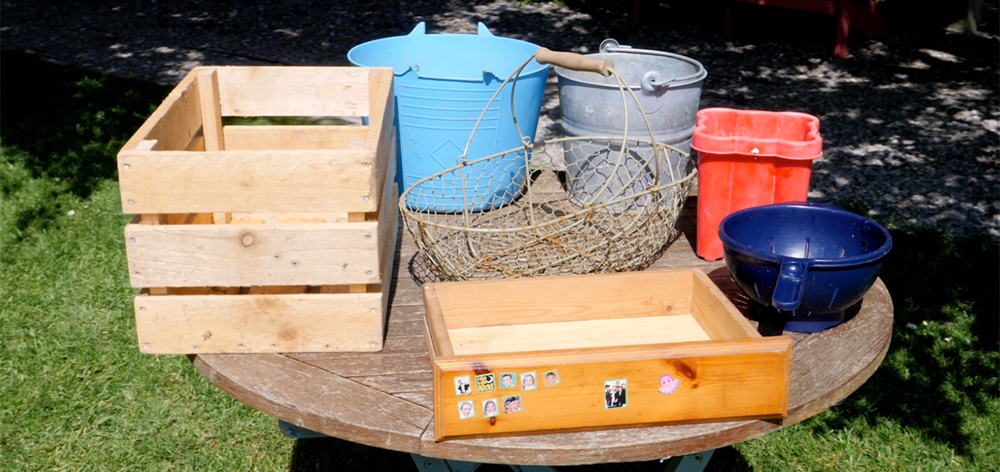
Container Friendly Veg: All of the following will grow very well in containers – baby carrots, short-rooted carrots, radishes, spring onions, cucumbers, swiss chard, courgettes, beetroot, chilies, aubergines, strawberries, and tomatoes.
Window Box Friendly Veg: Try growing lettuces, radishes, endives, rocket and oriental salads in window boxes – these are all relatively quick growing and undemanding vegetables. Allocate three or four window boxes to the project and sow little but often. Sow 10-15 seeds in the first box, then three weeks later sow another batch in the second box, and so on – this should guarantee a regular supply.
Salads & Greens: Cut-and-Come-Again varieties of salads are ideal for growing in small spaces – rather than waiting for a full head of lettuce to mature, with CCA varieties you can snip off leaves as needed and they grow back (up to three cuts from one sowing). Try out our Salad GROWBox & Herb GROWBox which are both window friendly.
Potatoes: Potatoes grow well in pots, bags or boxes - but the container needs to be deep. Try a very large pot or a metal bin.
Hanging Baskets: Hanging baskets are ideal for growing herbs, salad leaves, strawberries and tomatoes. Bush varieties of tomatoes are ideal for growing in containers but they are thirsty and hungry when grown this way and will need regular watering/feeding.
BUY seeds chosen by GIY, especially for their reliability, taste and suitability for growing in Ireland here
You can also try to grow MINIATURE VARIETIES of veg in containers that normally can't grow in small spaces such as leeks or turnips.
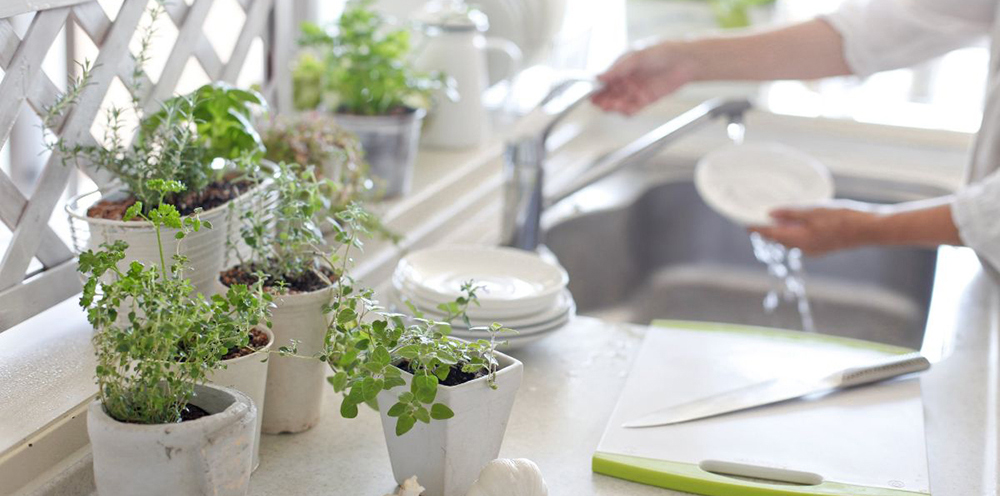
• A windowsill indoors is a great substitute for a greenhouse/polytunnel, and is an ideal location for raising seedlings. It also has the added benefit that you can't help but notice when your plants need attention!
• Try growing sprouting seeds such as mustard, chickpeas and fenugreek – they make an excellent addition to salads or a great, healthy snack for a train journey!
• Peppers (chilli and sweet) are compact little plants and like heat and light and so will do very well indoors.
• Dwarf varieties of vegetables are ideal for growing indoors or in any small space. For example grow dwarf French beans instead of regular French beans. Tiny Tim is a miniature variety of cherry tomato that will do well in a 6-inch pot. There are excellent dwarf varieties of peas, beans, aubergines and cabbages.
• Most herbs will do very well indoors in small containers and it's ideal to have them so close to the kitchen. Raise from seed and pot up, or buy small plants. Try parsley, thyme, mint, lemon balm, sage and basil.
TIPS FOR APARTMENT GROWING
• With a bit of ingenuity an apartment balcony can be turned in to your very own GIY HQ.
• The key to maximising growing space on a balcony is to go vertical! A four or five-shelf plastic "greenhouse" for example would be a great investment – each shelf will support five or six pots and it has a zippable plastic cover to keep your vegetables toasty warm on cold nights. Stash some gardening tools, compost etc on the ground beneath the shelves.
• Take a bit of time to work out which plants should go where based on which part of your balcony gets the most sunlight. Some plants need direct sunlight while others prefer partial shade, so check seed packets.
• Patio growers will also be able to use existing balcony features such as a railing to trail climbing plants up. You can also hang rectangular planters for rows of lettuce and other plants that have shallow root systems from the rails on your balcony.
• Bear in mind your veggies may be exposed to the elements if you are growing high up on a balcony, so use netting or bamboo screens to act as a windbreak. On the other hand, slugs are generally not a problem four floors up on a balcony!
Remember you can use nearly anything as a container so long as you have holes in the bottom for drainage. Here are some more container tips to get you inspired;
• Watch Mick teach you all about container growing in Episode 3 of How Food Grows.
• Watch Karen's container growing guide here.
Grow It Yourself - Grow it Forward
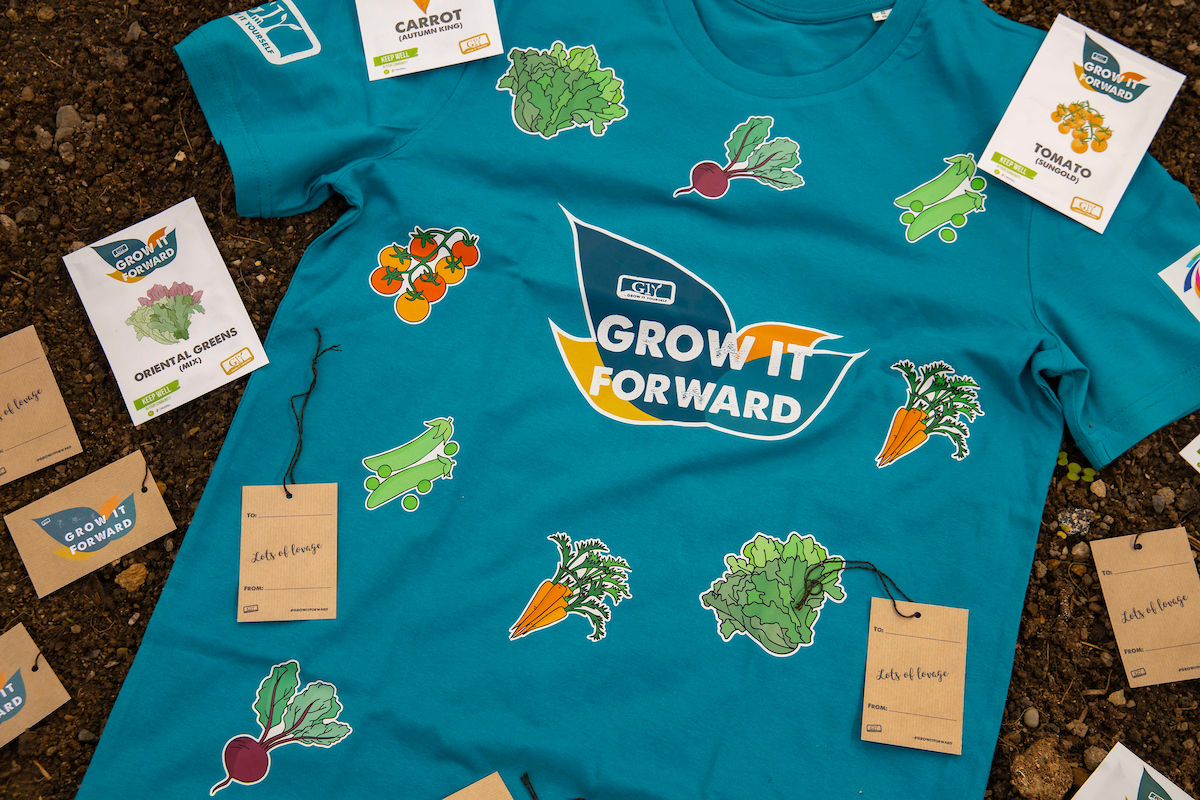
As GIY founder, Michael Kelly, said at the launch of their latest campaign Grow it Forward, “The pandemic has seen a record number of people turn to growing their own food and discovering the joy and pride that brings. The process of seeing a seed turn into a seedling and eventually food you can eat is full of magic and no shortage of optimism. And this new GIY campaign is all about sharing that feeling as far and wide as possible at a time when we need it most. That’s why we’re inviting people to get free seeds and do good deeds.”
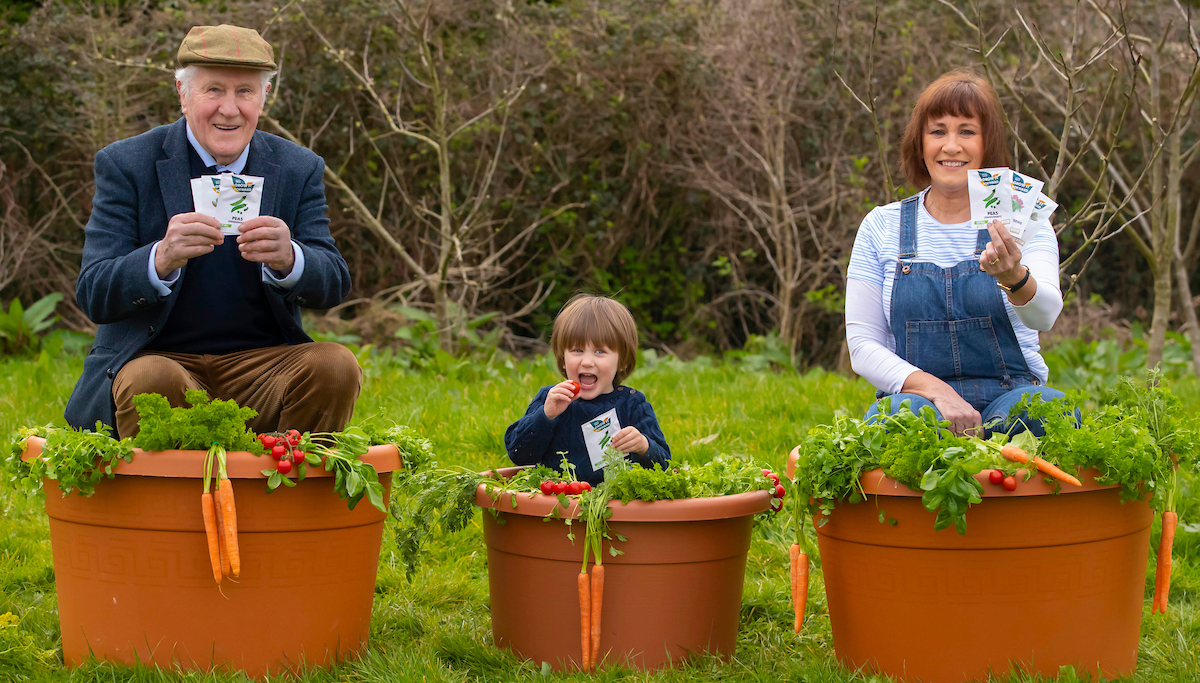
So, in partnership with Healthy Ireland and Libraries Ireland, GIY aims to help half a million people grow their own food with ‘Grow it Forward’. As part of the Government’s Keep Well programme, this campaign is designed to help the nation eat well by inspiring and supporting people to grow some of their own food at home while connecting with friends and family to join them.
A massive 50,000 free food growing kits will be given away through this initiative, with participants asked to use the kits to share the experience with ten people, enabling half a million people across Ireland to enjoy the wide range of benefits that come from growing food at home.
Each food growing pack includes seeds for beetroot, carrots, salad leaves, peas and tomatoes; a guide to help grow them and a postcard and gift tags to help share them. Those who sign up will also receive regular e-mails with growing support, video clips and ideas for how to ‘grow it forward’ by passing on seeds, seedlings or produce in accordance with social distancing guidelines.
Grow It Forward is a great initiative that will help to improve the health and general wellbeing of a huge number of participants and their families, friends and communities, not only through the activity of growing food itself, and the healthy meals produced, but also by helping to give back a sense of having some element of control over our lives at a time of great restriction. The gifting side of it is a lovely idea - and best of all, perhaps, it’s something that all ages can enjoy and it will introduce many more people to the satisfaction of gardening.
Apply for a Grow it Forward pack while supplies last at www.giy.ie/growitforward or contact your local library. #GrowItFoward #KeepWell
THINGS TO DO THIS MONTH
April is the month to catch up in the garden - and the key words are weeds and slugs. You need to stay on top of them both. Check your early spuds regularly and ‘earth-up’ as required. Water your tunnel/greenhouse – things can get pretty warm on a nice sunny April day and seedlings will dry out quickly.
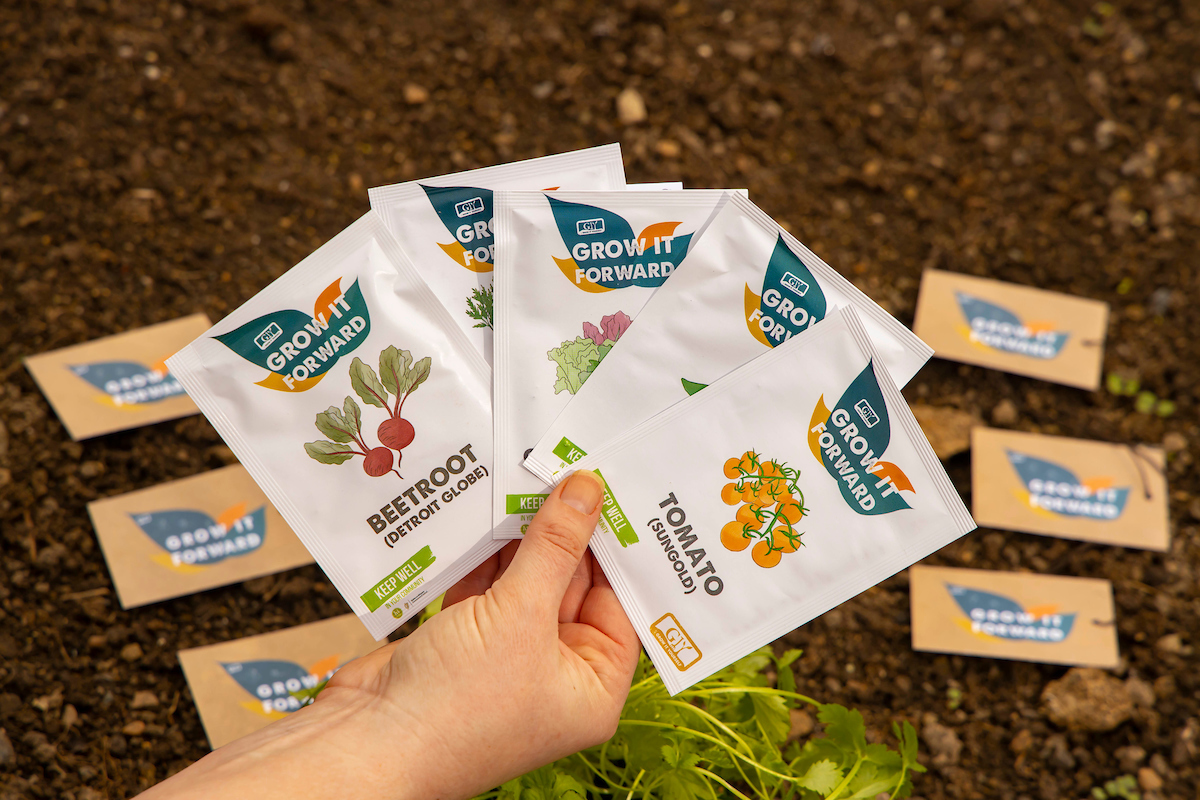
SOW (seeds in bold are included in Grow It Forward packs)
Indoors: lettuce, tomato, pepper, chilli-pepper, cucumber, celery, celeriac, basil, leeks, cabbage, cauliflower, Brussels sprouts, parsley, courgette, marrow, globe artichoke, beans, sweet corn and pumpkin.
Outdoors: broad bean, onion sets, pea, beetroot, cabbage, spinach, Brussels sprouts, parsnip, spring onion, leek, carrot, radish, broccoli, turnip. Plant out cabbage plants when they are 15/20 cm tall into well prepared soil that has been manured.
HARVEST
Stored fruit and vegetables are likely to be a distant memory at this stage and new crops are only starting to trickle in. But the middle of this month sees the arrival of the first asparagus and the first early spring cabbage. The other two star performers this month are purple sprouting broccoli and rhubarb.
TIP OF THE MONTH – Nettle Fertiliser
Pick huge bundles of tender young nettles - divert around 5oz to the kitchen for a delicious nettle soup and use the rest for an organic fertiliser. Nettles are extremely high in nitrogen so if you soak a large bucketful in water for a week, you produce a brilliant nitrogen-rich fertiliser which will be hugely beneficial for any plants which need leafy growth, for example lettuces, cabbage, kale etc - and it’s free. Put a kilo of nettles in a hessian bag and soak in 20 litres of water, then leave it to stew for a month or so. It gets pretty stinky so put a lid on top. Mix one part nettle liquid with ten parts water when applying to plants.
RECIPE OF THE MONTH – Salmon and Leek Filo Parcels
April is a classic hungry gap month and, for many GIYers, leeks may well be the only fresh vegetable in the soil at this time of the year. Here’s a fresh, healthy salmon and leek recipe.
Ingredients:
• 4 leeks, finely sliced
• 20g butter
• 6 sheets filo pastry
• 2 salmon fillets, skin removed
• 100g crème fraiche
Cook the leeks in a saucepan with a few tbsp of water and a knob of butter for 10 minutes, covered. Season well. Allow to cool.
Brush a sheet of the filo pastry with butter, then lay 2 more sheets on top, brushing butter between the layers. Place a salmon fillet on top.
Mix the crème fraiche with the leeks – put about half this mixture on top of the salmon. Fold the pastry up over the salmon to make it into a parcel.
Repeat this process for the second parcel. Brush them with a little melted butter.
Place on a baking sheet and cook for 20 minutes at 200C until nicely browned.
To accompany, some sprouting broccoli or mixed leaves from the veggie patch would be very nice
GIY - Autumn Jobs & Delicious Eats
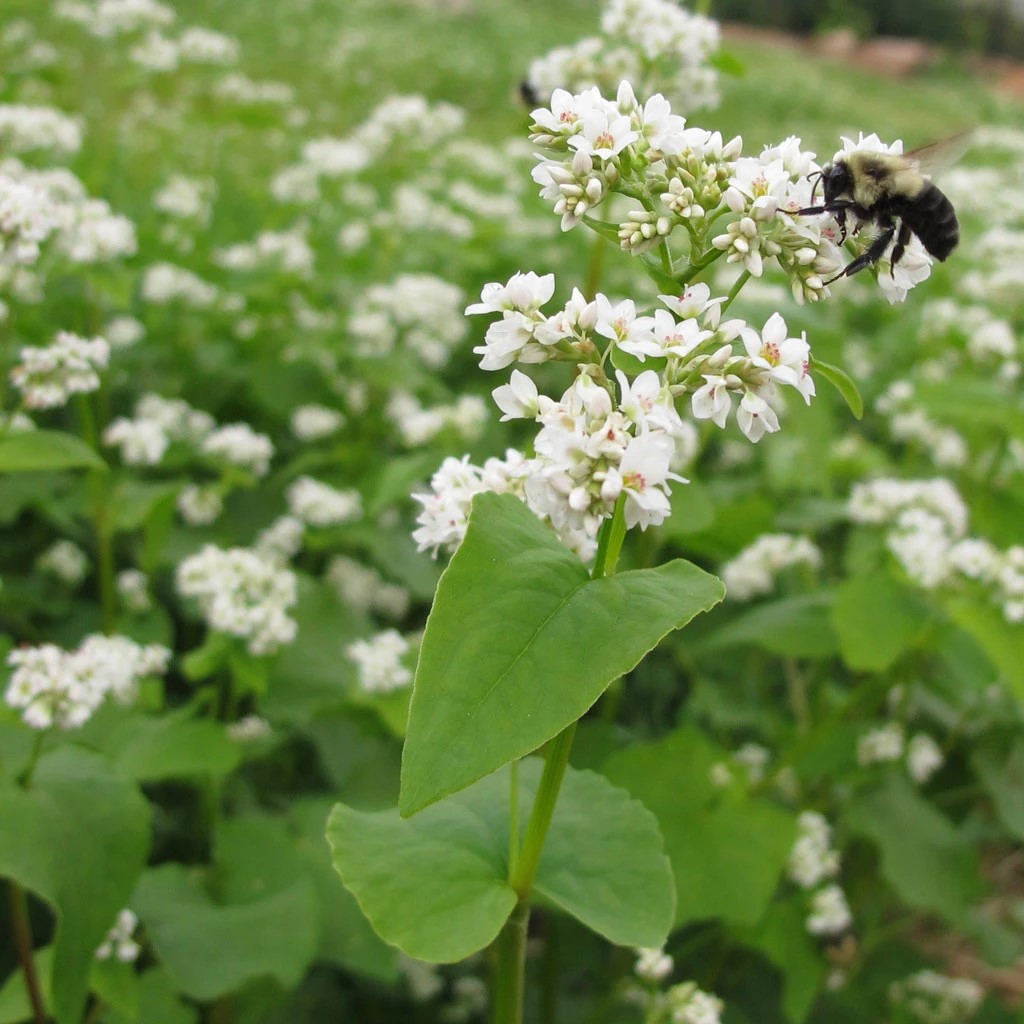
Spooky season is finally upon us and a new month means new veg to sow and plenty of veg to harvest.
October Jobs
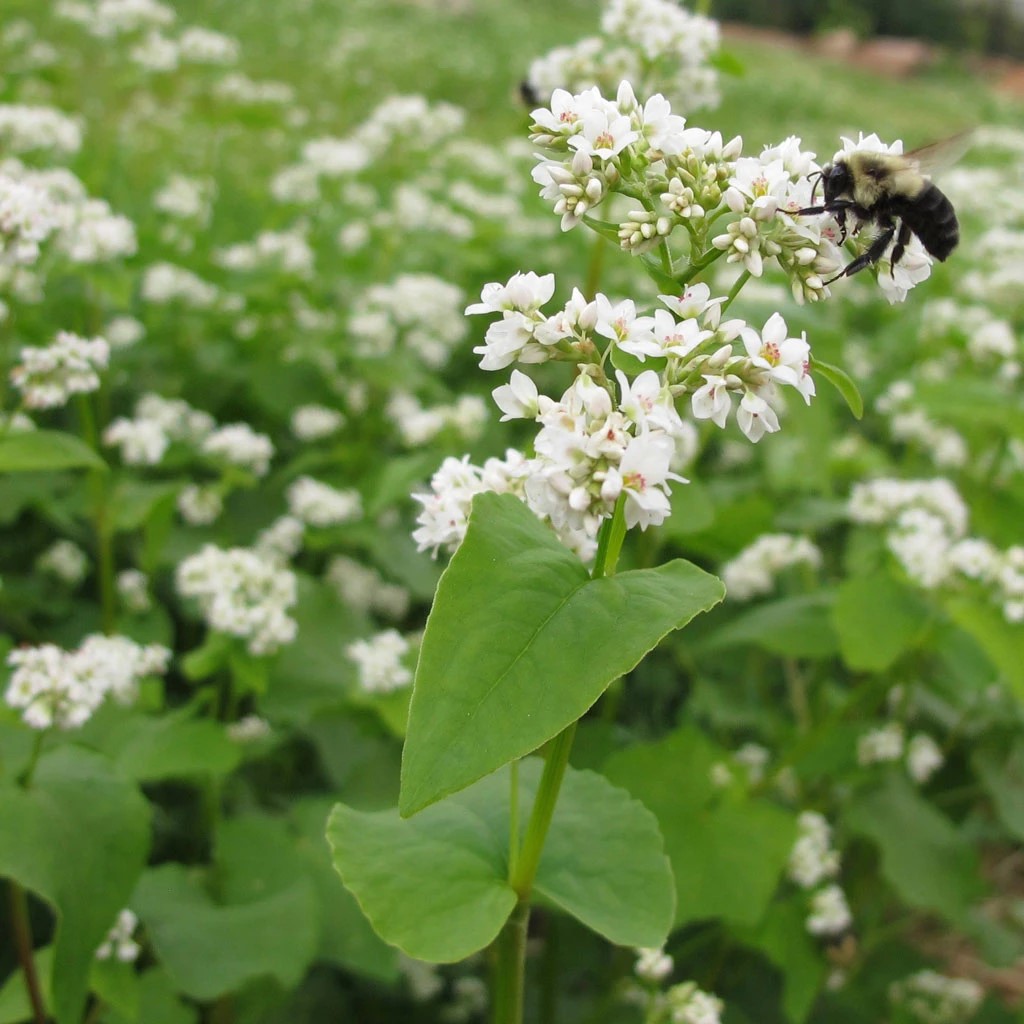 Pot up herbs so that they can be grown inside for use during winter. Continue to lift crops that have finished harvesting and clean up the beds. By now, green manures sown in late summer will be ready to be dug into the soil. You can also sow over-wintering green manures now.
Pot up herbs so that they can be grown inside for use during winter. Continue to lift crops that have finished harvesting and clean up the beds. By now, green manures sown in late summer will be ready to be dug into the soil. You can also sow over-wintering green manures now.
Try and find a good source of farmyard manure if you don't have your own – cow, horse, pig, sheep, and chicken manure are all great sources of nitrogen, phosphorus, and potassium. If you are going to cover empty beds down with manure for the winter, the earlier you do it the better. October or early November is ideal.
To Do List
• Pull up crops which have finished harvesting and compost them.
• Plant fruit trees and bushes.
• Tidy away canes and supports that you used for your peas, beans, etc and you should be able to use them next year. Leave them in the ground or throw them in a corner, and you probably won't.
• If you have a pond, stretch a piece of netting over it to keep leaves out.
• Start collecting leaves for leaf mould.
• Start storing vegetables like carrots and beets – only store the perfect specimens. Try to process the rest.
• Check apples regularly to see if they are ripe – early ripening apples generally don't store that well.
• Cut autumn fruiting raspberry canes down to the ground.
Sowing Seeds & Planting Out
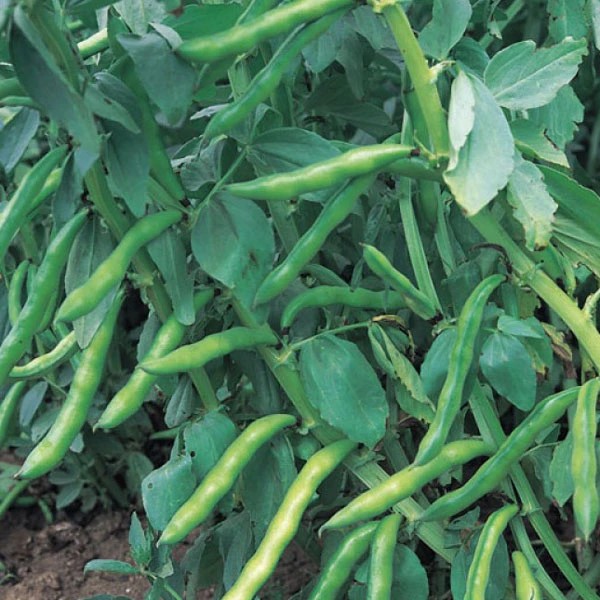 You can sow hardy varieties of peas and broad beans later this month for an early spring crop but only do so in well-drained soil. In the polytunnel get a crop of cauliflower and carrots going over the winter. Plant selected varieties of garlic and winter onion sets (visit GIY online shop for varieties) . The former will benefit from a good frost so it's traditional to plant before Christmas.
You can sow hardy varieties of peas and broad beans later this month for an early spring crop but only do so in well-drained soil. In the polytunnel get a crop of cauliflower and carrots going over the winter. Plant selected varieties of garlic and winter onion sets (visit GIY online shop for varieties) . The former will benefit from a good frost so it's traditional to plant before Christmas.
For loads more info visit https://giy.ie/
MORE-ISH AUTUMN RECIPES
.png) Parmesan Parsnips
Parmesan Parsnips
Parsnips are coming into their own again as the autumn advances and they will be at their best after frost, when low temperatures convert the starches in the roots to sugar and their deliciously sweet, nutty flavour develops.
1kg parsnips
3 tbsp wholemeal flour
1 tbsp ground black pepper
1 tbsp sea salt
1 generous handful of Parmesan cheese.
2 tbsp olive oil.
Preheat the oven to 200ºC/390ºF/Gas 6. Peel the parsnips and chop in half and then slice into four. You may need to slice the chunks in half again depending on what size you want them.
Place the parsnips in a pot and cover with cold water. Bring the pot to the boil and simmer for 4 minutes. Rinse with a little cold water and drain the chunks in a colander.
Combine the flour, pepper, and salt in a large bowl. Tumble the parsnips into the bowl and toss to coat. Place in a large roasting tray, sprinkle over the Parmesan cheese and drizzle with olive oil.
Roast in the oven for 25 minutes or until golden brown and crispy.
.png) Blackberry & Apple Crumble
Blackberry & Apple Crumble
It may be a little late in the season for blackberry-picking (traditionally ended on St Michaelmas Day, 29th September, when the devil is said to have spat on the bushes…) but but you may well have some in the freezer – and it’s bang on for windfalls, along with any berries or other fruit of choice.
Ingredients:
900g apples – peeled, cored and cut in to chunks
350g blackberries
160g demerara sugar
Juice of 2 lemons
225g plain flour
175g butter
125g muesli or a mixture of porridge oats, seeds and chopped nuts
Preheat the oven to 200C. Pour the lemon juice over the apples - this will add flavour and stops the apples from going brown. Layer the apples, blackberries, and sugar in a lasagne dish. Place the flour in a large bowl and then rub in the butter until it resembles breadcrumbs. Add the muesli and another 50g sugar and mix through. Sprinkle the crumble topping over the fruit. Bake for 45 minutes. Cool for a few minutes and then serve with custard or cream.
GIY - How to have a more Sustainable Christmas

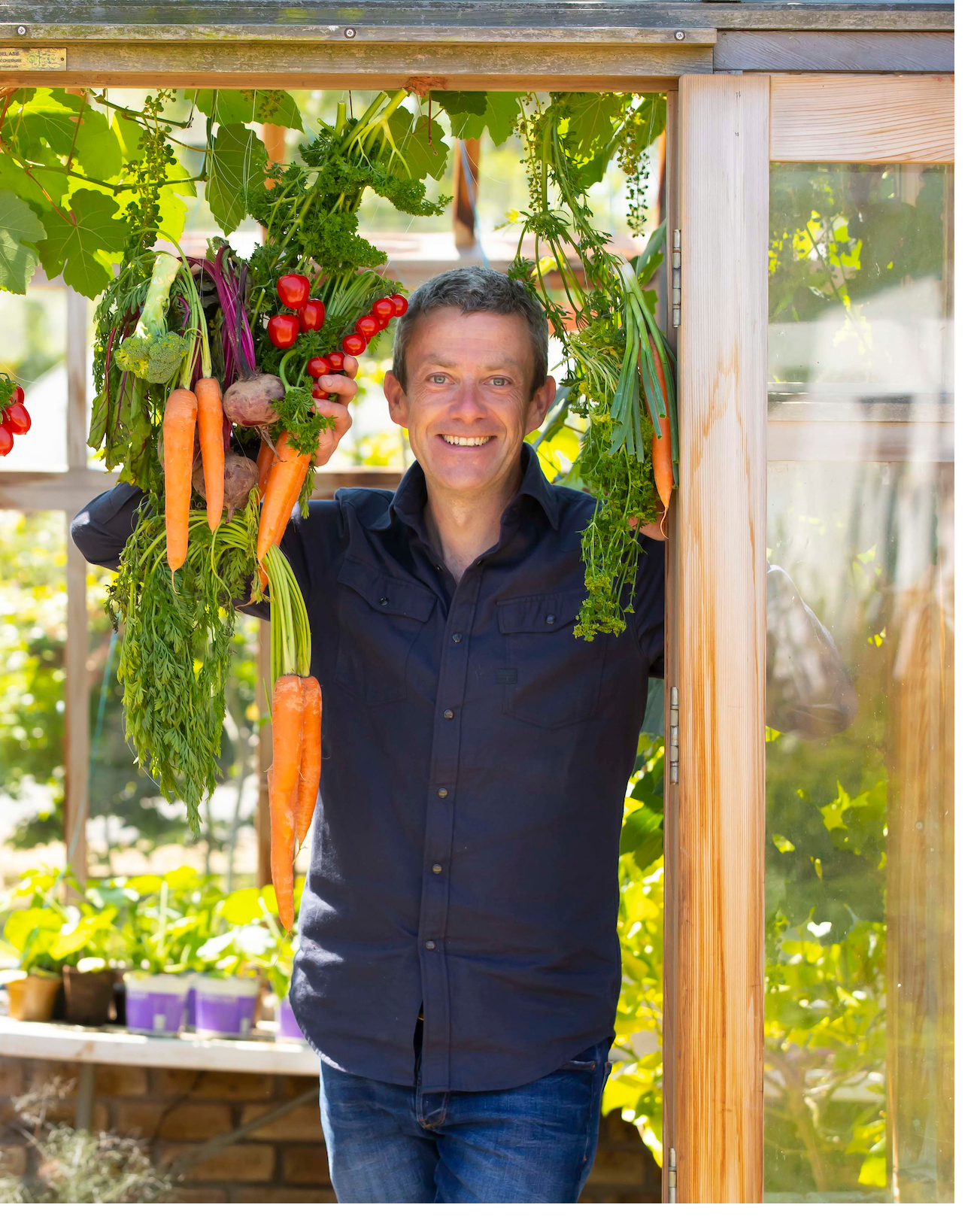 Founder of GIY Michael Kelly has some top tips for us all in order to enjoy a guilt-free and more ecological Christmas at home as well as tips to live more sustainably in 2022. Michael is sharing his own environmentally friendly Christmas tips that he has practised over the years; his passion for sustainable and seasonal living spans over 10 years now and he shares some of the things he has learned in order to have a more eco-friendly festive season.
Founder of GIY Michael Kelly has some top tips for us all in order to enjoy a guilt-free and more ecological Christmas at home as well as tips to live more sustainably in 2022. Michael is sharing his own environmentally friendly Christmas tips that he has practised over the years; his passion for sustainable and seasonal living spans over 10 years now and he shares some of the things he has learned in order to have a more eco-friendly festive season.
Top Tree Tips
Michael says, when it comes to the tree, choose a live one; live trees are a renewable resource and are replanted on tree farms contributing to our air quality and natural ecosystems. “You could also opt for a potted tree for indoors and then enjoy a ‘Nature Restoration’ activity with the family after Christmas as you plant it outside again or place it outside in a large pot and decorate it for the birds with seed balls, peanut butter and seed trays. It’s a fun activity for the kids and offers an important food source during the long cold winter days of winter for the birds. And finally, on the tree, for décor you could enjoy making some Dried Fruit Garlands and Trig tree stars and of course, use LED lights on the Christmas tree and at home.
Dinner Time Wins
On to the dinner, the first tip is to buy less. Every year Irish households dump tonnes of food waste - we never need as much as we think so don't fill that trolley.
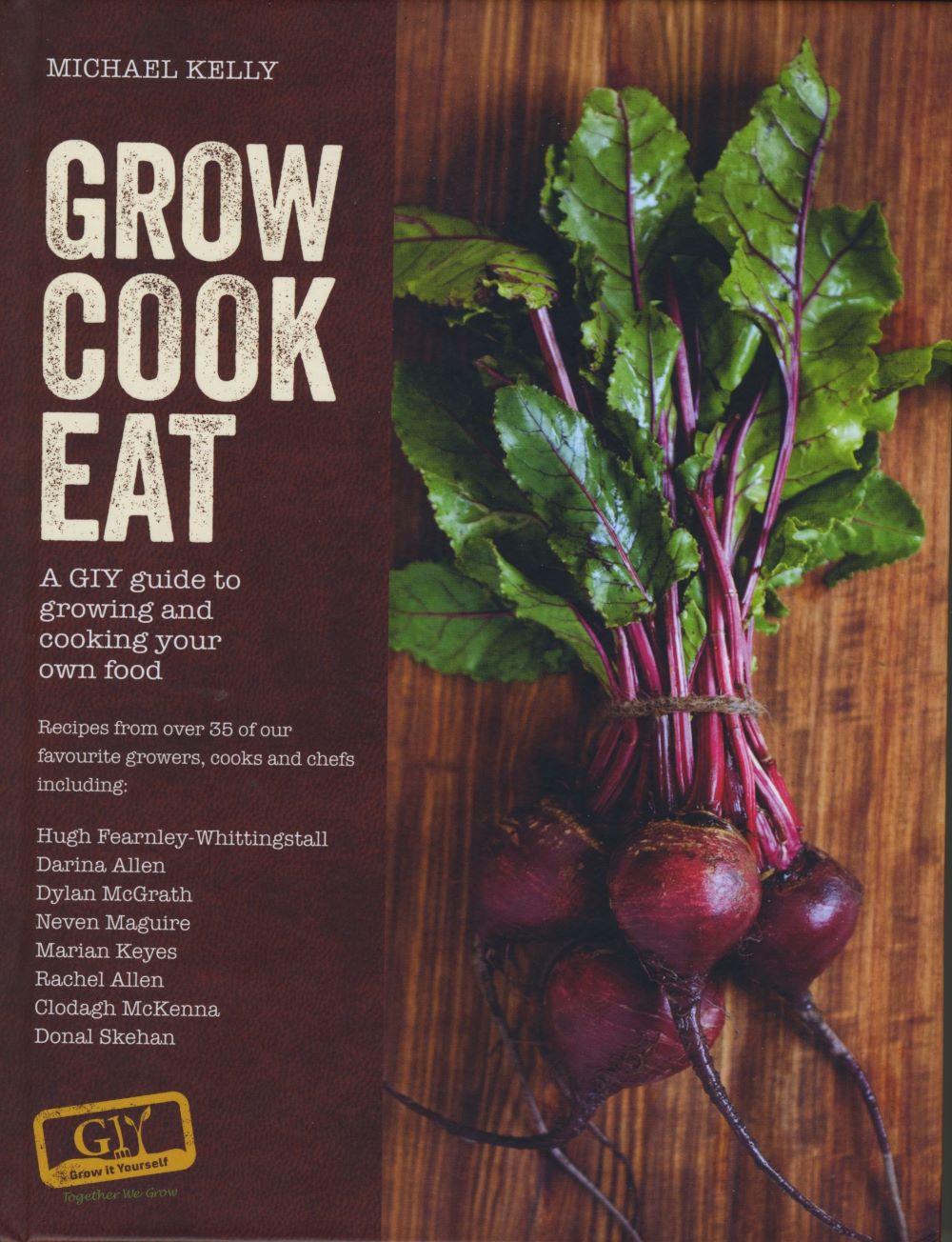 A turkey and ham dinner with all of the traditional trimmings can see tens of thousands of food miles racked up. We all need to make a more conscious effort of buying as local as possible. Buy your food from a farmers' market or direct from producers themselves. Not only will it taste better but it is a more sustainable food shopping practice. Most people buy a bird that is actually too big – so perhaps re-consider how much you actually need. And if you do have leftovers – get creative with the leftovers; a turkey carcass makes great stock for soups and you can compost the vegetable peel. If you’re stuck for a trecipe check out GIY’s Grow Cook Eat book, featuring seasonal recipes from over 35 of the biggest names in food, including Hugh Fearnley Whittingstall, Dylan McGrath, Donal Skehan, Darina Allen & more.
A turkey and ham dinner with all of the traditional trimmings can see tens of thousands of food miles racked up. We all need to make a more conscious effort of buying as local as possible. Buy your food from a farmers' market or direct from producers themselves. Not only will it taste better but it is a more sustainable food shopping practice. Most people buy a bird that is actually too big – so perhaps re-consider how much you actually need. And if you do have leftovers – get creative with the leftovers; a turkey carcass makes great stock for soups and you can compost the vegetable peel. If you’re stuck for a trecipe check out GIY’s Grow Cook Eat book, featuring seasonal recipes from over 35 of the biggest names in food, including Hugh Fearnley Whittingstall, Dylan McGrath, Donal Skehan, Darina Allen & more.
Or you could ditch with tradition and go veggie for dinner. It’s possible to enjoy the most delicious veggie Christmas dinner with nut loaves, veggie cottage pies and delicious in-season tasty veg. Local and seasonal vegetables mean fewer food miles and artificial ripening methods; potatoes, parsnips, carrots and sprouts are all grown in Ireland and available in December. Supermarkets will often use veg as loss leaders to get us in to the store at Christmas. This is bad news for our Irish veg growers as the price tends to be permanently lowered and we end up putting them out of business. Remember, there’s always a cost to cheap food so be prepared to pay a fair price for your turkey, ham and Christmas veg. If you’re adding gravy and purchasing an instant one be sure to choose a recyclable glass jar – basically when shopping try to avoid plastic packaging.
Another tip is to go organic, for both meat and vegetables – it’s a great way to ensure there are no chemicals being used in the production of the food and it’s kinder to the planet.
Start To Upcycle – with visitors calling it’s natural to fill your recycling bin more often at Christmas time, but this can be a good thing for food growers! You will likely find very useful veggie-growing aids in the shape of pots and other containers. Keep an eye out for yoghurt cartons and toilet roll inserts for sowing seeds in. Clear punnets and milk bottles can act as cloches in spring when seedlings are first put out into the soil.
Go green with gifts
 Homemade gifts are not only thoughtful but make for a more unusual and unique present. Homemade treats or sauces are completely unique. In the GIY Know-It-Allmanac, we have some delicious recipes for Rocket Pesto, homemade ketchup or Beetroot Chocolate Brownies all so simple that even kids can make them successfully. Ideally, reuse wrapping paper and if you do feel you have to buy some then avoid the shiny and buy some brown paper which is fully recyclable. GIY’s Know-it-Allmanac is published by GIY. It is a 104-page hardback and is available now from all good book shops and also online at www.giy.ie www.giy.ie and is priced at €25.00
Homemade gifts are not only thoughtful but make for a more unusual and unique present. Homemade treats or sauces are completely unique. In the GIY Know-It-Allmanac, we have some delicious recipes for Rocket Pesto, homemade ketchup or Beetroot Chocolate Brownies all so simple that even kids can make them successfully. Ideally, reuse wrapping paper and if you do feel you have to buy some then avoid the shiny and buy some brown paper which is fully recyclable. GIY’s Know-it-Allmanac is published by GIY. It is a 104-page hardback and is available now from all good book shops and also online at www.giy.ie www.giy.ie and is priced at €25.00
Christmas is also a wonderful time to reconnect with nature. Consider starting a family tradition of a nature walk or plan a small patch of the garden for growing your family’s favourites during 2022. The GIY Know-it-Allmanac is a month-by-month guide to growing, cooking and eating food and it has all the tips and tricks that you could need. It focuses on seasonal foods and highlights each month’s significant dates, likely weather, along with ‘get crafty’ projects and garden to-do lists.
New Year’s Resolutions for the planet
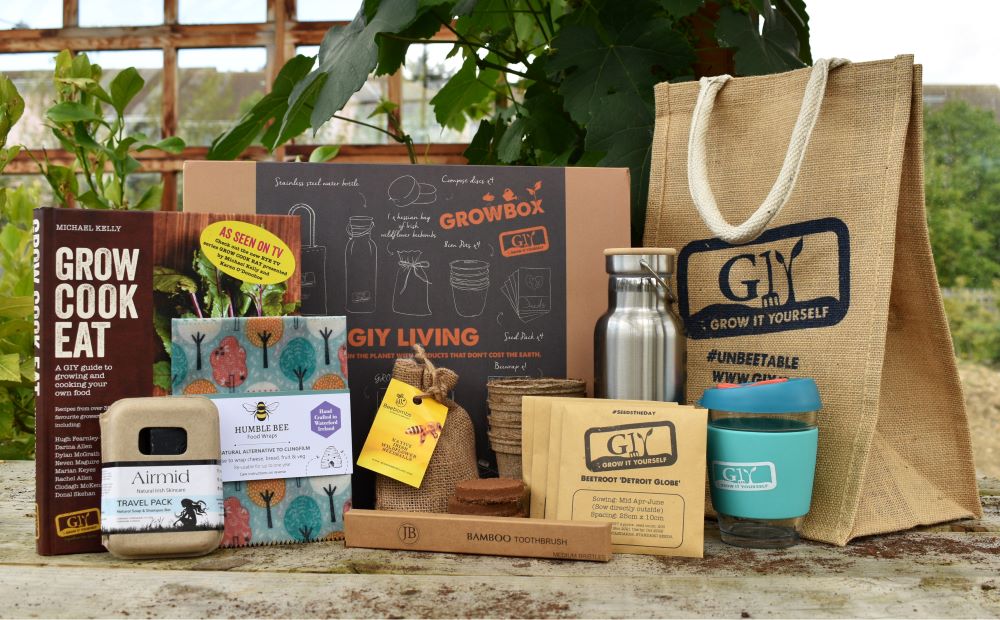 • Make The GIY Switch – all of the food choices we make has an impact on the environment, some more harmful than others. With food production responsible for almost one-third of global greenhouse gas emissions, a change in attitudes is radically needed if we are to avert climate change. So, what we eat matters and how it is grown and produced matters even more. People who grow their own food gain a deeper understanding of how the global food system works. This knowledge will not only help you to lead a healthier life but also a more sustainable one. The GIY Ultimate Starter GROWBox has everything you need to get going on your green journey. It is available from GIY.ie for €39.99 and if you need some handholding the Ultimate Starter course is available online for €30.00.
• Make The GIY Switch – all of the food choices we make has an impact on the environment, some more harmful than others. With food production responsible for almost one-third of global greenhouse gas emissions, a change in attitudes is radically needed if we are to avert climate change. So, what we eat matters and how it is grown and produced matters even more. People who grow their own food gain a deeper understanding of how the global food system works. This knowledge will not only help you to lead a healthier life but also a more sustainable one. The GIY Ultimate Starter GROWBox has everything you need to get going on your green journey. It is available from GIY.ie for €39.99 and if you need some handholding the Ultimate Starter course is available online for €30.00.
• Getting Started – after making the decision to start growing your own food you’ll probably have the urge to grow ALL of your food. But fight the temptation! Growing is a skill, and like any skill worth having it takes time. So, while you have downtime over Christmas, start off small and pick what you want to grow and where to grow it. Make sure to factor in how much space you have to work with. While growing can be done anywhere (on a windowsill/balcony/greenhouse/garden) not all plants require the same amount of space!
• Choose Organic Pesticides – Christmas brings a time of new beginnings, both in the garden and in life! Whether you grow your own food or not, avoiding artificial pesticides, fertilisers and herbicides go a long way to living a more sustainable lifestyle. Buying organic, in-season produce from local producers may raise your Christmas dinner bill slightly but the planet will thank you. For you GIYers, replace chemical pesticides with green manure and garden compost, or mulch poor soils with manure. Boost plant health with nutrient-rich tonics or liquid feeds such as comfrey tea, nettle tea or liquid seaweed!
• Foraging Seaweed – if you’re one of the brave who attempts a Christmas morning swim, grab some seaweed while you’re there as a Christmas pressie for your beds. Avoid pulling seaweed off rocks, collect it from the beach instead if it has washed up after a storm. Some say to rinse your seaweed before adding it to your soil, but we think the salt helps to keep slugs away from our precious crops!
For further green living and growing tips see www.giy.ie
GIY - Dig For Dinner
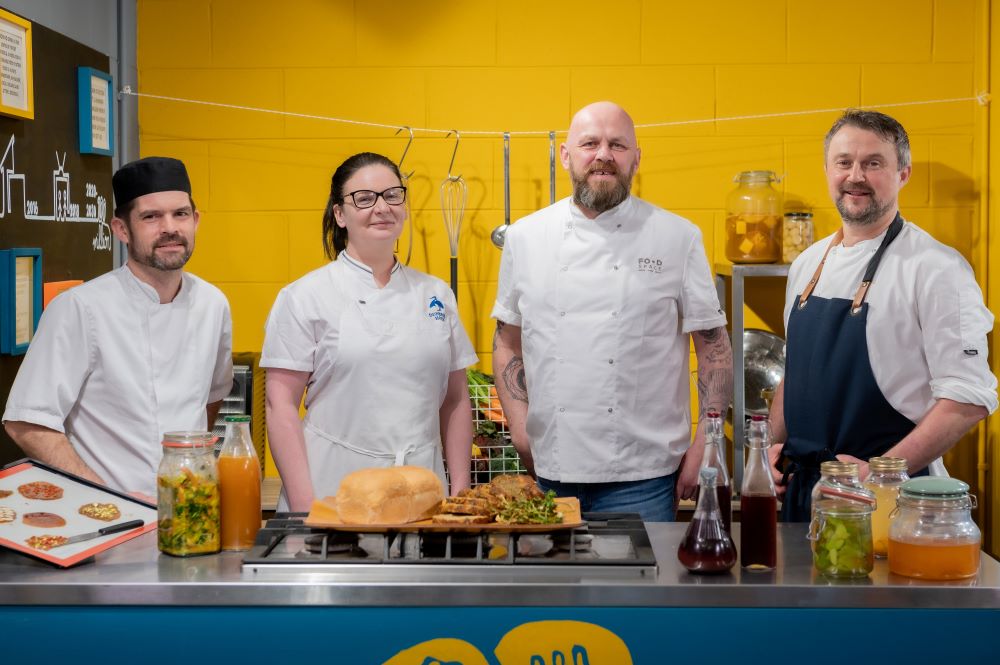
There may not be too many people around who remember the Dig For Victory campaign in WW2, but the importance of food security has taken on a new urgency recently - and GIY founder Mick Kelly and his team have plenty of ideas and advice to help keep us all well fed while also enjoying all the other benefits of gardening. This is an edited version of the March Growers Calendar and you can sign up for the monthly GIY Growers Calendars here...
March marks the official start to the growing season. Though the weather can still be problematic, spring is very much in the air and there's plenty of seed sowing to be done indoors, for later transplanting outside. Significantly, this month we really get stuck into outdoor sowings too, most notably of potatoes around St. Patrick's Day. Generally speaking, March is a great time to start giving your vegetable beds some attention - above all, make sure to enjoy being back out in the veg patch again after the long winter months. Just wait until the sun starts shining... If you're just starting out, there's still time to get a vegetable patch ready. A raised bed can be built in a few hours, and veg can be planted the next day - so don't delay!
.jpg) Grow Along With The GIY Experts
Grow Along With The GIY Experts
Anyone can access the GIY expertise on the website, or by signing up to their courses – this is the ideal time of year to begin the Ultimate Starter Course https://shop.giy.ie/products/ultimate-starter-course - or getting their How To books, including Mick‘s incredibly successful Grow Cook Eat and the GIY Know-It-Allmanac, which is perfect for kids.
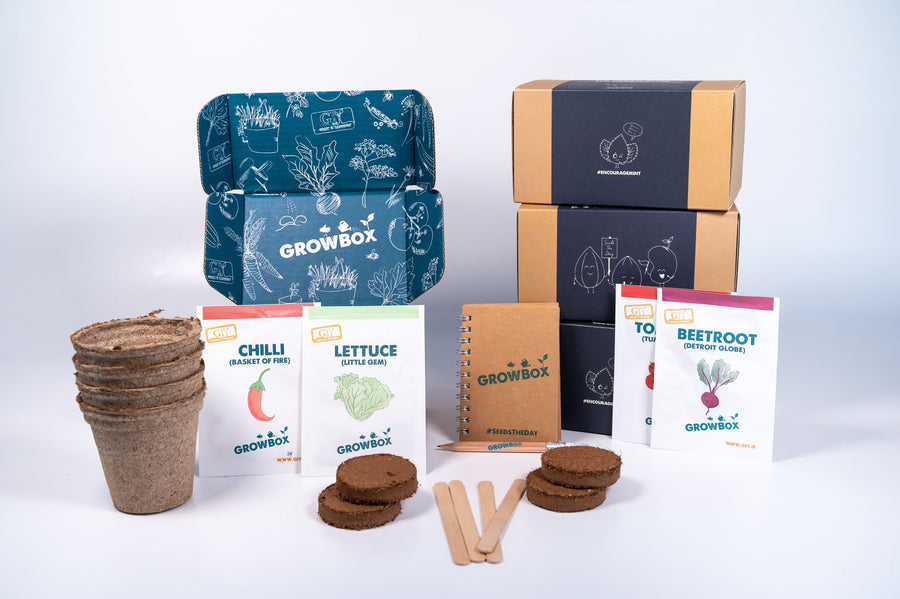 You don’t even need a garden to start growing your own - with a GIY GROWBox kit you can start growing anywhere. See the full range here. You can also get a great range of seeds and both Seeds and GROWboxes are available on Subscription.
You don’t even need a garden to start growing your own - with a GIY GROWBox kit you can start growing anywhere. See the full range here. You can also get a great range of seeds and both Seeds and GROWboxes are available on Subscription.
Harvesting – What's In Season?
March was once called The Hungry Gap because of the dearth of fresh vegetables. But this month the efficient GIYer is enjoying (from the ground and from storage) onions, leeks, parsnips, potatoes, some varieties of lettuce, mint, sprouting broccoli, kale, rhubarb, chard, the first of the spring cauliflowers and cabbage, and spinach (perpetual, spinach beet). Under cover in the polytunnel or greenhouse you could also be harvesting lettuce, rocket, cauliflower and carrots (ready now from late autumn planting).
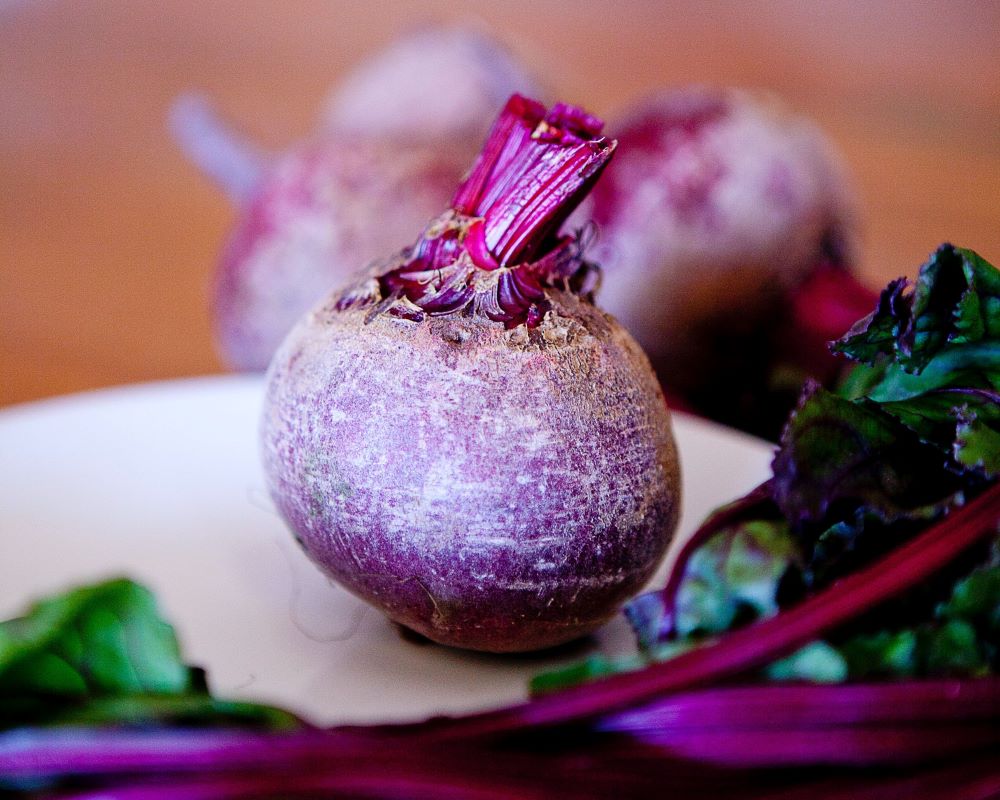 March Challenge - Sow Beetroot
March Challenge - Sow Beetroot
Beetroot is one of those vegetables with countless options - boil it, bake it, grate it into salads, make chutneys, wine and even cakes.
If you're one of the lucky GIYers with a polytunnel or greenhouse, you can get sowing straight away. If you're an outdoor grower, try and hold off until April to sow your seeds.
Top Tip: soak seeds in warm water for 20 mins before sowing to aid germination.
Beetroot likes a deep sandy soil. Apply organic fertiliser about a week before sowing if sowing directly into soil. If sowing in module trays first save this step for a week before transplanting. You can sow beetroot seeds direct in the soil, but if you're growing outside, we recommend sowing in a module tray first to transplant later.
Fill the tray or pot with compost and give it a little bang on the table to settle the compost and get rid of any air pockets. For baby beets you can sow in pots (one or two litre) and grow them on a sunny windowsill. Push each seed into the compost about 2cm deep the cover up with some compost and give it a watering.
Beetroot should start germinating in about a week or two, why not send a snap of your seedlings on social @GIYIreland
 Introducing ‘WASTED’
Introducing ‘WASTED’
GIY’s exciting new programme 'WASTED' is a national, peer-to-peer education programme for chefs and food service teams that focuses on reducing food waste in the hospitality industry. Supported by the Department of Environment, Climate Action and Communications (DECC) and Environmental Protection Agency (EPA) as part of the Circular Economy Innovation Grant Scheme, this new initiative aims to engage and educate over 150 chefs and food service team members to reduce food waste in the food service sector.
It's estimated that the Irish food service sector wastes over 200,000 tonnes of food worth €300 million per year – a significant cost that often goes unseen. The WASTED programme centres on prevention as the most successful solution to reducing food waste and aims to create a network of chefs and food waste teams that advocate the adoption of circular economy principals in commercial settings.
So what's involved?
• Registered chefs will have access to a free 8-lesson online course, and related digital resources, presented by some of Ireland's top professional chefs.
• An invite to join the free six-part webinar series featuring professional chefs and zero waste experts.
• The chance to host your own WASTED Supper Club.
• And last but not least, an opportunity to be part of a network of inspired, informed and proactive chefs and food service teams sharing zero food waste skills and knowledge and advocating the adoption of circular economy principals in commercial settings.
If you work in the food service industry and you're interested in learning about how to reduce, or even eliminate, food waste from your business then register to join the WASTED programme.
GIY - 'Get Ireland Growing Day� 2022
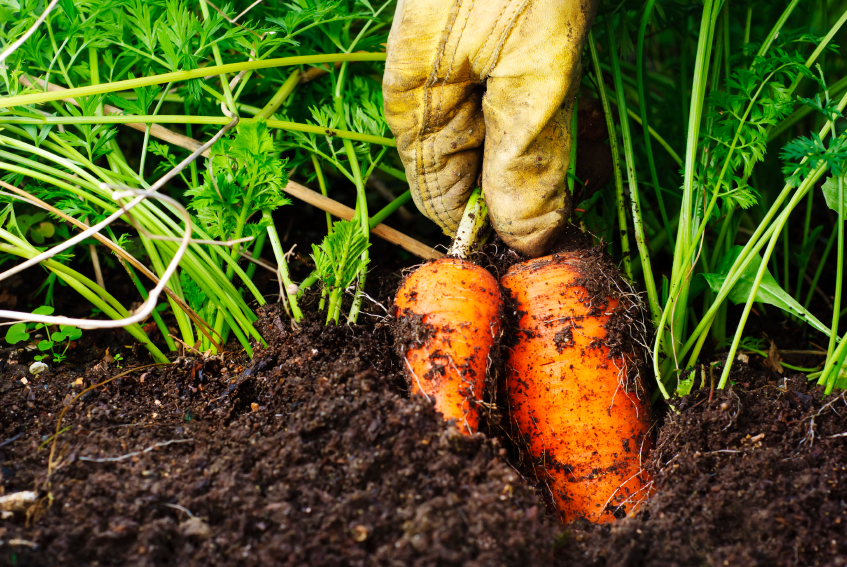
Join in 'Get Ireland Growing Day’ 2022 urges GIY Ireland founder, Mick Kelly - projects like seed exchanges, pollinator walks and foraging with friends all help to realise the power of communal vision and effort.
Grow It Yourself Ireland, partnered by Energia, are calling on communities across Ireland to take part in Energia Get Ireland Growing Day on Saturday, July 2nd 2022.
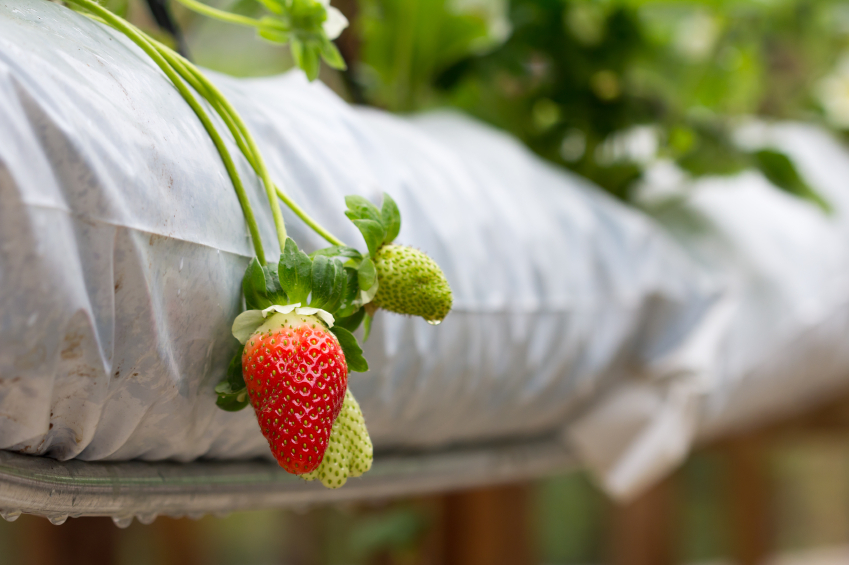 Get Ireland Growing Day is part of the Energia Get Ireland Growing initiative, in partnership with GIY. This year the initiative is aiming to sow the seed of
Get Ireland Growing Day is part of the Energia Get Ireland Growing initiative, in partnership with GIY. This year the initiative is aiming to sow the seed of
community food growing nationwide by encouraging and supporting individuals and groups to come together for community food growing projects of all shapes and sizes.
In April 2022 the Energia Get Ireland Growing initiative announced the giveaway across Ireland of 300 community growing starter kits worth €42,500. Using these kits, communities across Ireland are encouraged to come together to become more sustainable and connected through growing food together. For those that missed out on the kits, there are still great prizes to be won for any community group hosting a local gathering on Get Ireland Growing Day, with free resources available at getirelandgrowing.ie or by downloading the GIY app.
 Speaking of the day of celebration, founder of GIY Michael Kelly says: "Energia Get Ireland Growing Day is a day to celebrate the growing going on in your community. It's a day to gather and share the joy of growing and caring for your shared place and enjoy nature.
Speaking of the day of celebration, founder of GIY Michael Kelly says: "Energia Get Ireland Growing Day is a day to celebrate the growing going on in your community. It's a day to gather and share the joy of growing and caring for your shared place and enjoy nature.
We are encouraging seed exchanges, doing a pollinator walk, a forage with friends, getting together to tackle the 'big job' in the garden, sharing some of the food you have grown or simply a cup of tea to get to know your own food growing community better. It is a chance to get together and realise the power of communal vision and effort."
Lorna Danaher, sponsorship manager for Energia also said 'We're so excited to have our second Energia Get Ireland Growing day. The success of last year laid an amazing foundation for us to be able to further engage and build growing communities. We look forward to seeing groups come together and complete the Energia Get Ireland Growing challenges on the app'
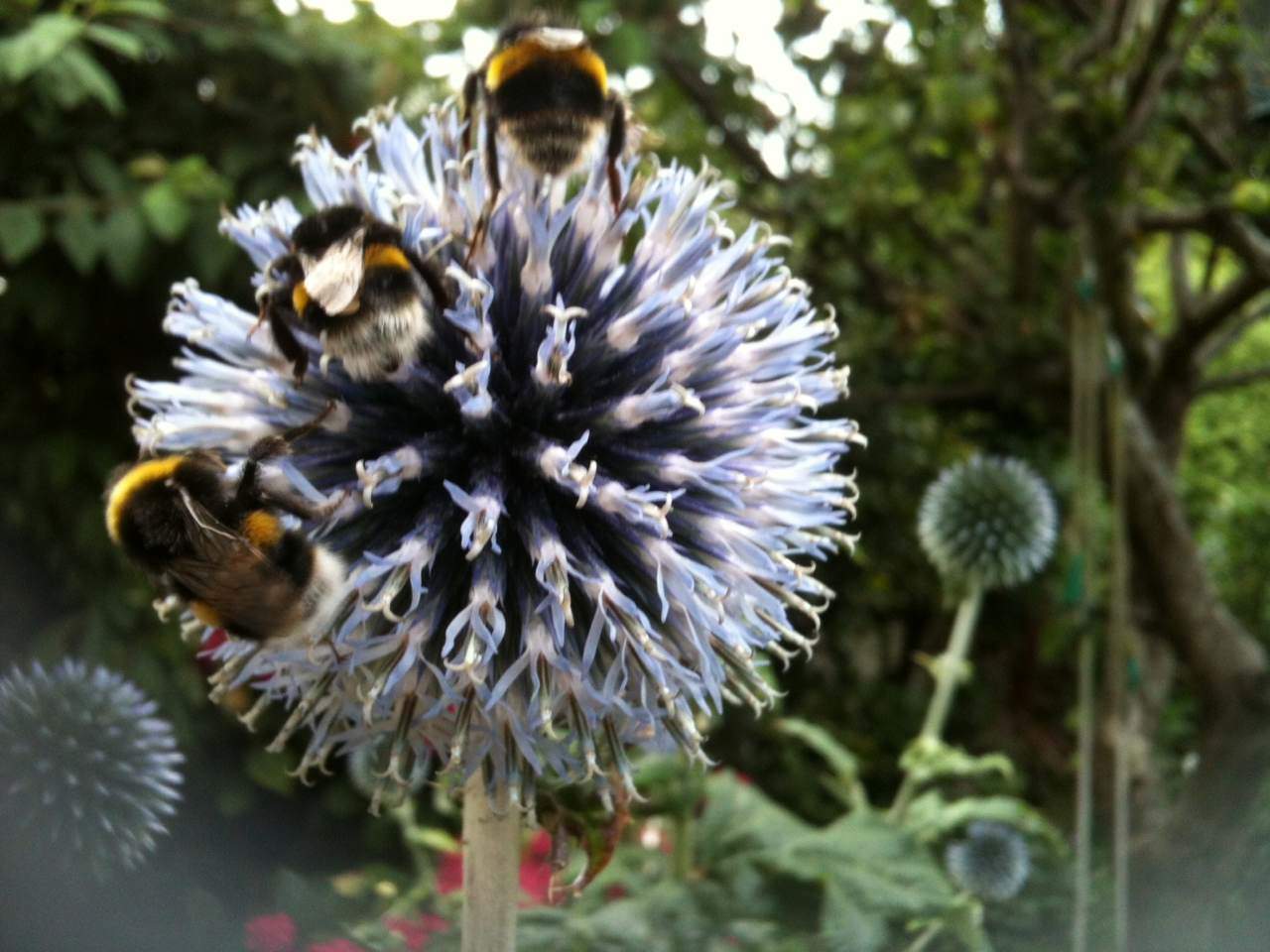 On Get Ireland Growing Day, it is also time for participants to submit their entries to be in with the chance of winning a range of prizes. To enter, participants are asked to post a picture of their community growing projects on any social media channel and tag @EnergiaGIG while also using the hashtag #GetIrelandGrowing.
On Get Ireland Growing Day, it is also time for participants to submit their entries to be in with the chance of winning a range of prizes. To enter, participants are asked to post a picture of their community growing projects on any social media channel and tag @EnergiaGIG while also using the hashtag #GetIrelandGrowing.
Members of the public also have the opportunity to nominate someone going above and beyond to support others to grow and be named their province's 'Get Ireland Growing Community Hero'. Previous winners have included those leading a community garden project, bringing food growing into schools or simply motivating their neighbours to give growing a go.
The 2022 prize categories and prizes include, a 'Community Hero' with one hero awarded per province and the winners awarded a GIY annual subscription. The 'Best Energia Get Ireland Growing Day' is an award for the most impressive gathering hosted on the day, with a prize of a GIY voucher worth €500. Finally, the 'Best Transformation' is up for grabs for a group that has transformed a space, with a €1000 cash prize. Get Ireland Growing Winners will be announced on Saturday, July 16th.
Energia Get Ireland Growing was first launched by Energia in partnership with GIY in 2016 to promote community food growing projects nationwide. For further details please see www.getirelandgrowing.ie
GIY - The Colder Months
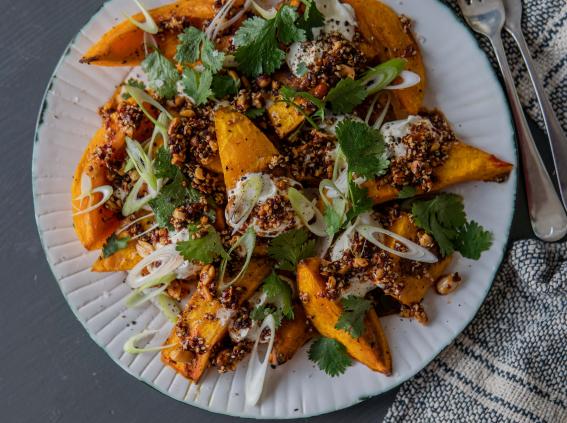
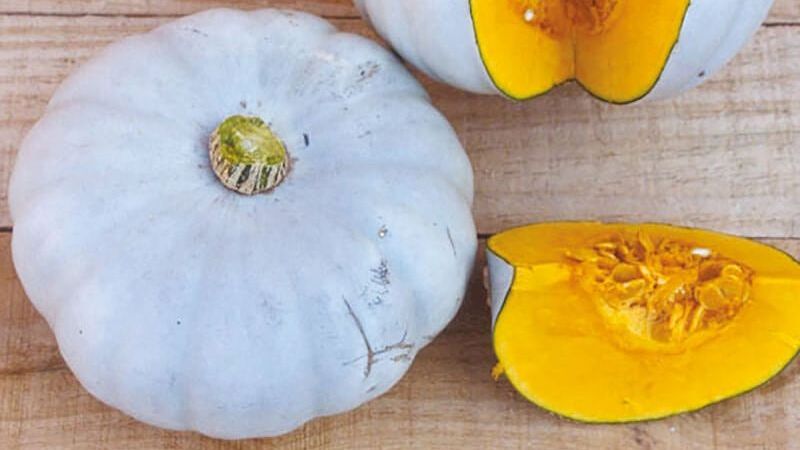 As always Mick Kelly and the gang at GIY www.Giy.ie have been busy hatching new plans and, as well as all the usual valuable advice to help us get the most from out veg patches, they have loads of news including...
As always Mick Kelly and the gang at GIY www.Giy.ie have been busy hatching new plans and, as well as all the usual valuable advice to help us get the most from out veg patches, they have loads of news including...
Very excitingly, in order to build on the success of GROW HQ and expand the food production and education, they are creating a GIY Farm that will, with GROW HQ, form a broader GIY education campus in the southeast. “GIY Farm will be a model of a sustainable food system and a mixture of food production, education, enterprise and tourism underpinned by a regenerative agriculture and organic approach. The approach will be to work with nature; creating a balanced and biodiverse system. The farm will be on 50 acres near GROW HQ and we aim to get it up and running early next year. To fund the initial capital and operational costs, we are issuing up to €400,000 in community bonds (loan notes) in €10,000 denominations with a 5 year investment and 5% per annum return.” If you or your company are interested in investing in this brilliant project please contact GIY directly for further information – and GIY also have some great ideas for “corporate gifts with purpose”; if that would be of interest to your company, email jane@giy.ie.
On a more accessible scale, Mick’s latest book The GIY Diaries out now and this month-by-month grower’s guide with recipes will be a pleasure for keen gardeners to get for themselves, or as a gift. Available online (rrp €26.99), it can be ordered from several major bookstores including Dubray Books and will be in local book shops too.
And, as always, GIY has some delicious seasonal recipes to make the most of the harvest – and this one is perfect for the colder months.
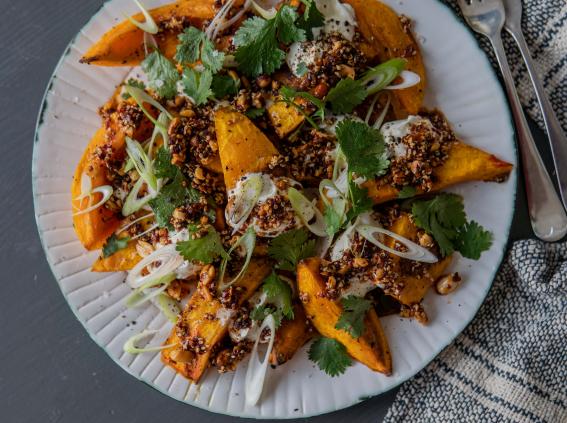 PUMPKIN WITH CREME FRAICHE, PEANUT RAYU, CORIANDER & SPRING ONION
PUMPKIN WITH CREME FRAICHE, PEANUT RAYU, CORIANDER & SPRING ONION
This recipe, from Katie Sanderson of White Mausau, is a firm favourite with GIYers. Peanut rayu is a sweet salty condiment inspired by the chilli sauces Katie grew up eating in Asia and it’s available nationwide in about 150 stores, and beyond (check website for more info).
Katie describes this as “a great big family salad perfect for sharing – you can cook the wedges ahead of time the morning of, or night before, a party. The peanut rayu is great used at the end as in this recipe, but can also be thrown on pumpkin or other vegetables before you roast, it all gets charred and it’s delicious. Try to find crème fraiche with a high fat content - the French ones are finger licking good!"
Ingredients
• Pumpkin cut into wedges skin on (easy to take off once on your plate)
• Olive oil
• Salt and pepper
• One jar of peanut rayu
• Creme fraiche (or coconut yoghurt for a vegan alternative)
• Spring onion chopped into thin discs
• Coriander, pickle
Step 1 - Cook
Preheat the oven to 190*C. Take the seeds out of the pumpkin and cut into wedges with the skin on. Place them in a bowl and season with salt pepper and oil.
Place in a hot oven making sure to not overcrowd the tray, give lots of space so it can roast properly. Cook for 35 min or until browned, maybe slightly blackened at the corners, and a knife goes through the flesh.
Let cool slightly.
Step 2 - Serve
Place on a big serving dish, rustic style. Add some dollops of crème fraiche add some spoonfuls of Peanut Rayu and then finish with some Maldon sea salt (or similar), cracked black pepper and some sprinkles of spring onion and pickled coriander.
GIY - A Future for Irish Vegetables?
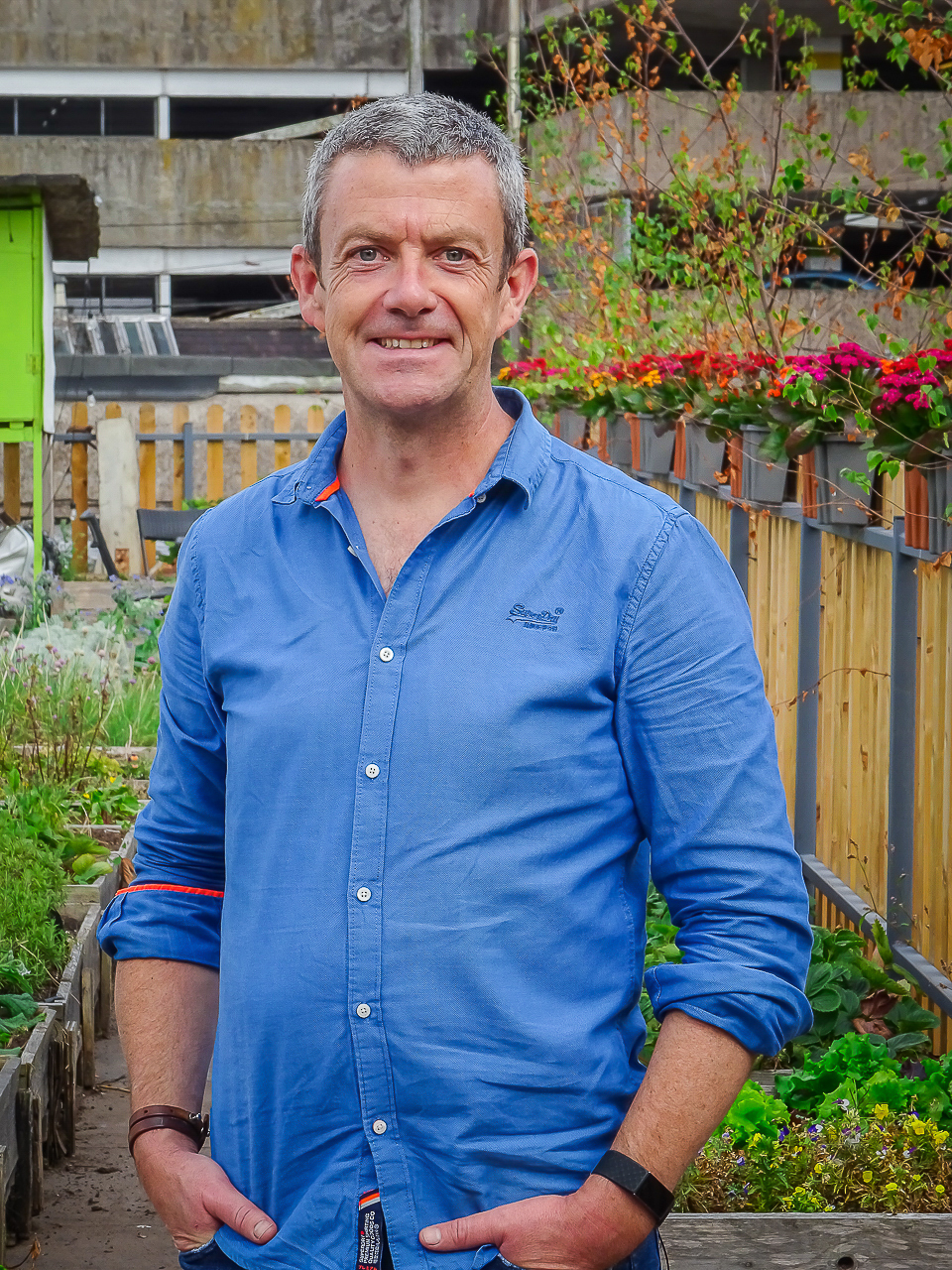
There’s a vegetable shortage crisis, yet Irish vegetable growers are going out of business – what’s going on?
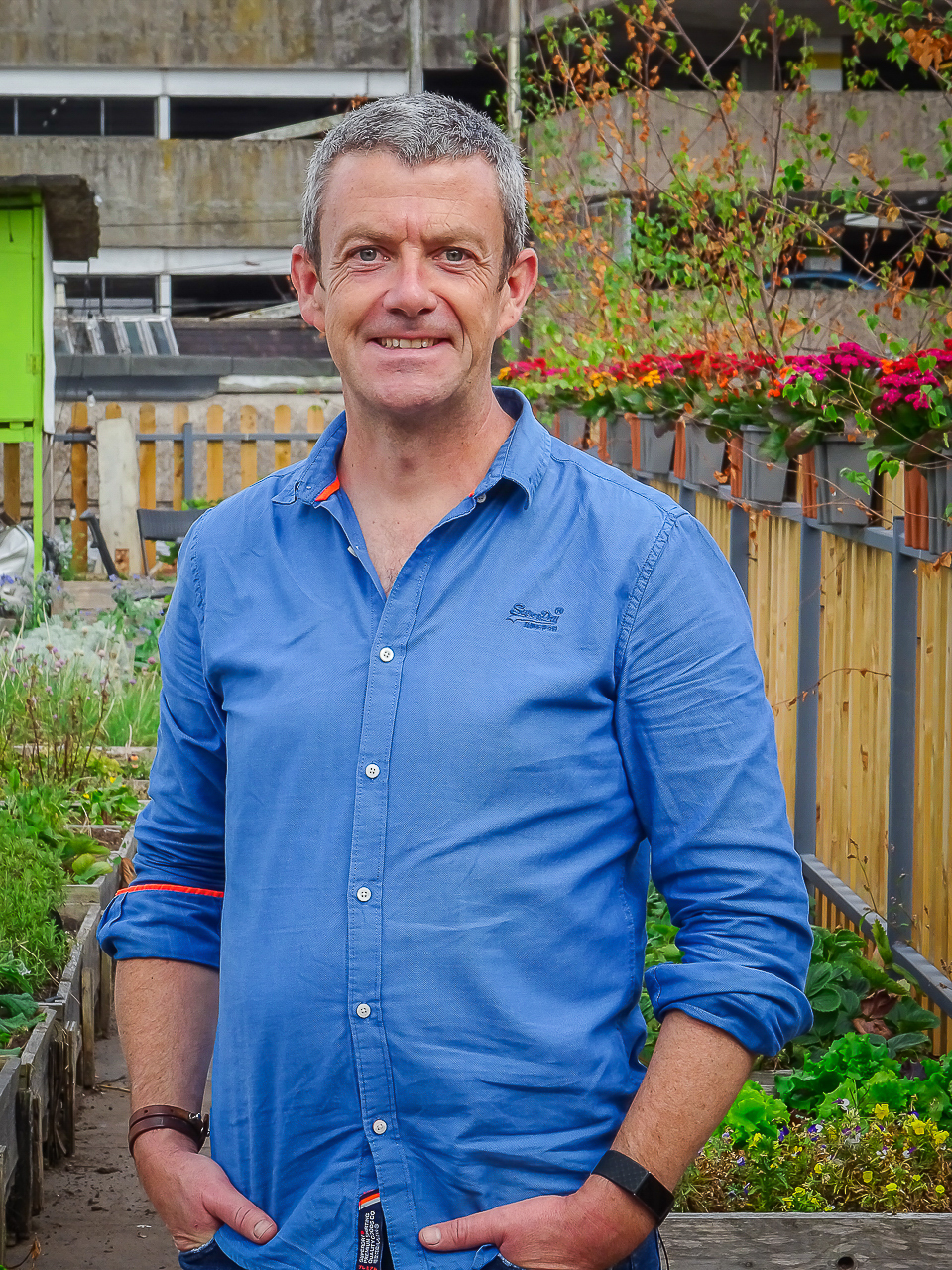 If you haven’t caught up with the excellent TV series Food Matters yet and want to get a handle on what’s going wrong with Irish food production – and what can be done about it - do make a point of watching.
If you haven’t caught up with the excellent TV series Food Matters yet and want to get a handle on what’s going wrong with Irish food production – and what can be done about it - do make a point of watching.
Airing on RTÉ One until May 3rd, the series uncovers how Ireland's food system is a major contributor to the climate change emergency.
Each week the founder of GIY (Grow-It-Yourself), Michael Kelly, meets producers from all across the country to investigate the sustainability of Ireland's food system. It’s not all doom and gloom but there are plenty of shocks. Since filming was completed, for example, one of the county's biggest vegetable growers has gone out of business. Cathal Lenehan, one of the country's main cabbage and Brussels sprout growers, left the industry after three generations due to rising costs.Yet there has never been a bigger shortage of vegetables and, as Michael Kelly says, "As a nation, we simply do not appreciate and support our own home-grown vegetable producers enough."
The Irish consumer obsession with the Mediterranean diet has seen mass attention placed on the lack of vegetables on the shelves due to climate change impacting the production of tomatoes and peppers in Europe – however, as Michael says, we have a huge variety of alternative Irish-grown vegetables that are in season and these go under-appreciated and, crucially, the growers are unsupported. Vegetables grown in Ireland that are in, or coming into, season include carrots, parsnips, young cabbage, cauliflower, spring onions, leeks, fennel, snap peas, asparagus, artichoke and fava beans – and these are the ones we should be focusing on now. “A huge and proven factor in health and well-being is eating seasonally and therefore it is these home-grown in-season vegetables that we should be seeking out." Michael says.
Throughout the series, Michael travels across Ireland to meet with farmers, food producers, food experts, climate experts, chefs, economists, ecologists and activists as he digs deep to uncover the complexity of the Irish food system, how it works, how it delivers and how it impacts the environment. An episode focused on 'Supporting Local' shows how consumers can be more supportive of producers and, importantly, why we need to be. Michael’s point is simple: "If we don't look after our food producers, we're never going to fix our broken food system. Farmers and small producers face increased pressures and this is not sustainable. Possible solutions include turning to a more local-based system: go direct to the producers, shop at shops that support local, shop fresh and shop seasonal."
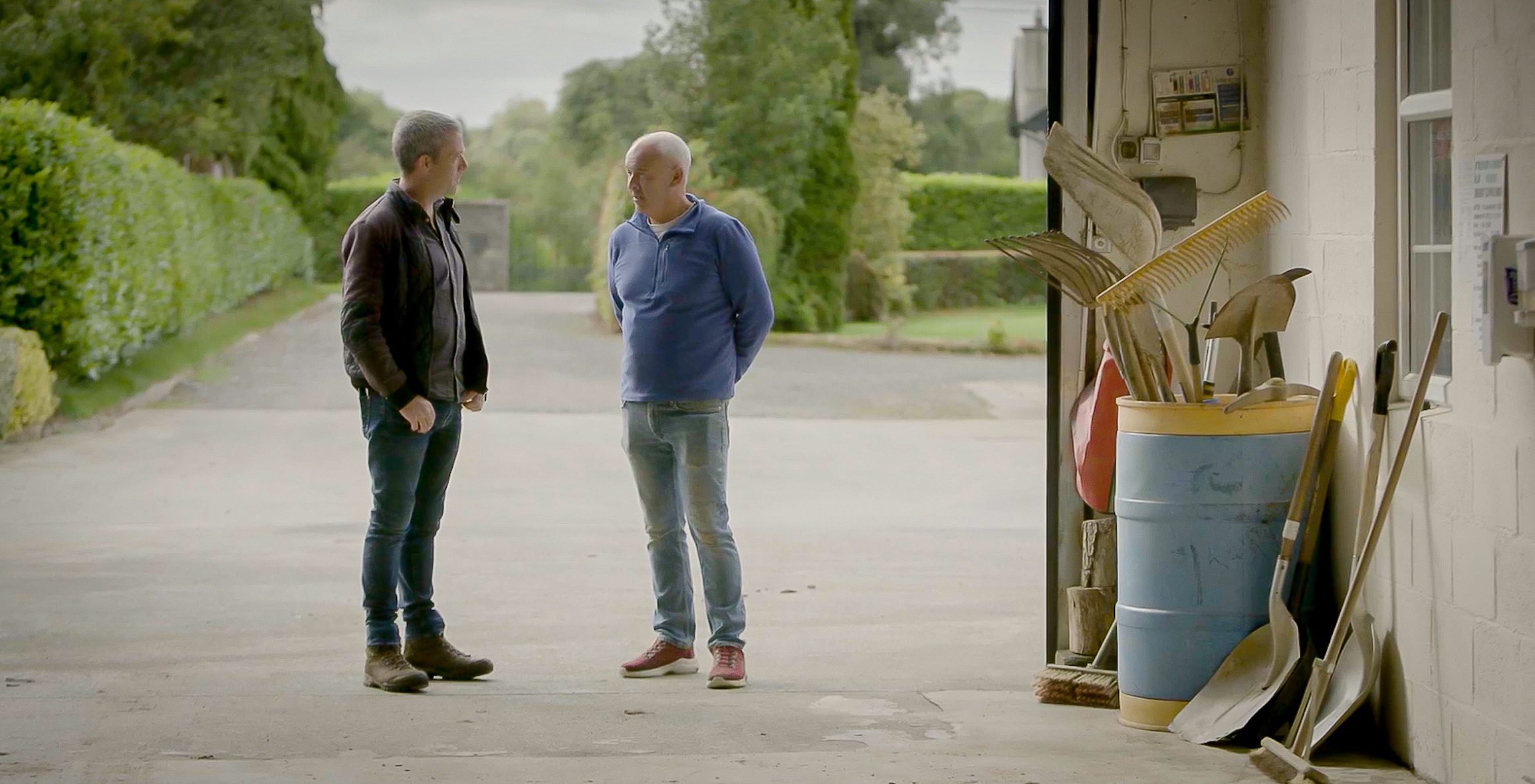
When Michael meets with grower Cathal Lenehan in Meath, he discovers how rising costs and anticipation of falling sales prices led to the closure of their third-generation business – and how it could have been prevented by a commitment to a small increase in supermarket prices. Mick also talks to former IFA chair of the horticulture sector, Paul Brophy, to see what we are doing to help farmers and producers during the current cost of living crisis, and travels to Kerry to discuss the situation with independent veg retailer Dan Horan.
On a brighter note, Mick discovers how one Wicklow company has managed to put sustainability at the core of their drinks business with the support of their local community, while in Tipperary the Cloughjordan Community Farm is also all about supporting each other. And, back at GROW HQ in Waterford, Mick takes part in a very special podcast with Jack from NeighbourFood, about how they are connecting small producers with a wider customer base and making it a win-win for small producers and their customers.
***The six-part documentary TV series 'Food Matters' series uncovers Ireland's food sustainability and how the food system is a major contributor to the climate change emergency. Produced by InProduction TV & Scéal Creative Ltd it is presented by GIY founder Mick Kelly, and supported by the EPA Stop Food Waste & ReThink Ireland. It airs on RTÉ One and RTÉ Player at 8 pm on Wednesdays until May 3rd.
*Episodes of the inaugural series of Food Matters to look out for or catch up with:
1. "LOVE SOIL"
2. "FOLLOW THE SEASONS"
3. "STOP FOOD POLLUTION"
4. "SUPPORT LOCAL"
5. "EAT MORE PLANTS"
6. "END FOOD WASTE"
www.giy.ie
#FoodMattersTV
For further details, to arrange a visit to GROW HQ, or to plan an interview with Mick Kelly please contact Ann Power, 086 3065588 Email: Ann@powerhousepr.ie
GIY - GROW At School FUND RAISING
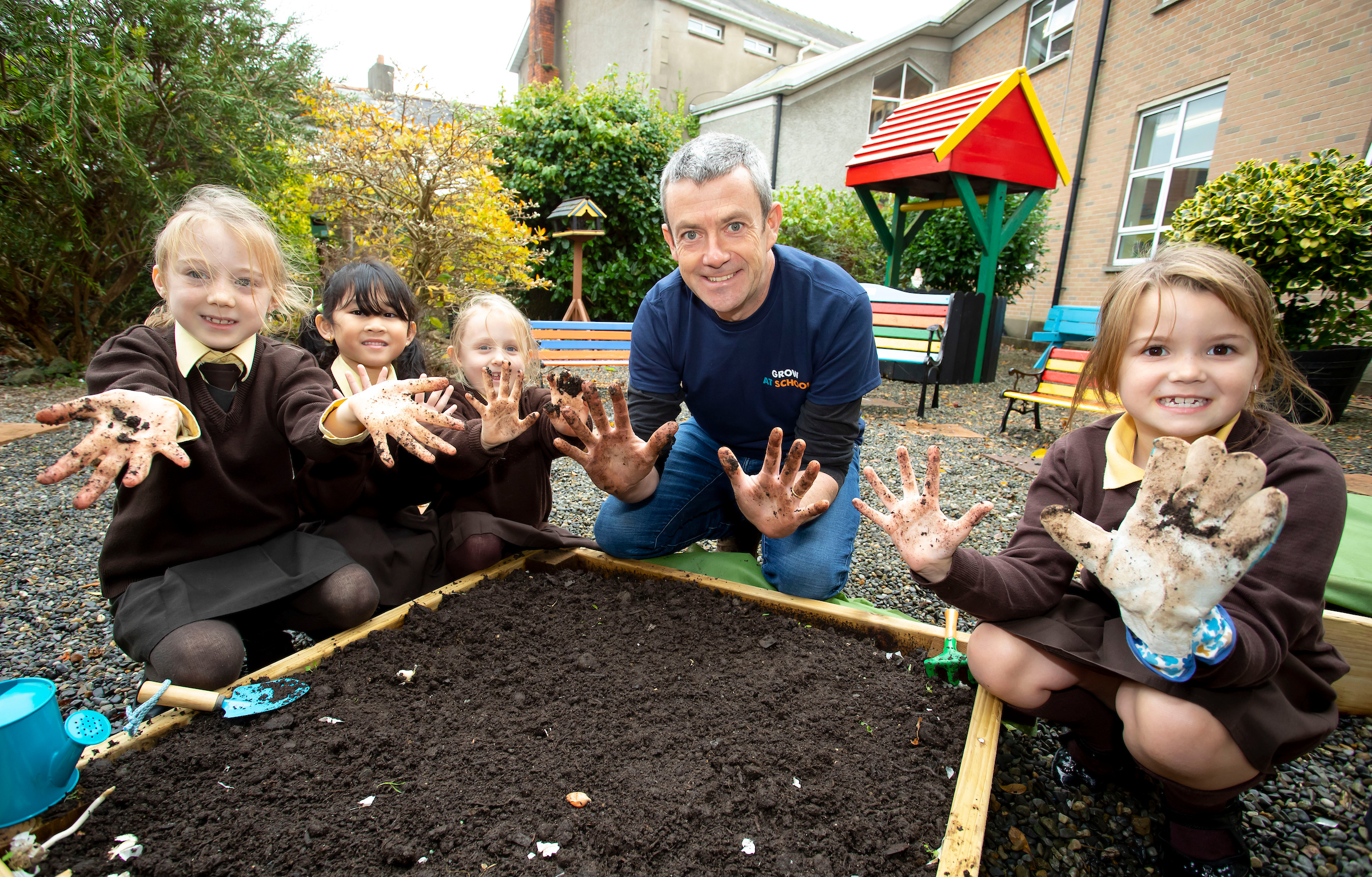
Grow It Yourself (GIY) calls on businesses and well-wishers to back an important €1 million initiative for children to GROW At School
The not-for-profit social enterprise Grow It Yourself (GIY) is aiming to raise €1 million in order to deliver the food education and mental health programme GROW At School in primary schools across the country for the academic year 2023/24.
'GROW At School' was first rolled out by GIY across 32 schools in Ireland as a 4-year pilot project, which was completed in June 2021. The programme was a huge success and the feedback from the schools and teachers who participated was captured in a research report, which was ALL overwhelmingly positive.
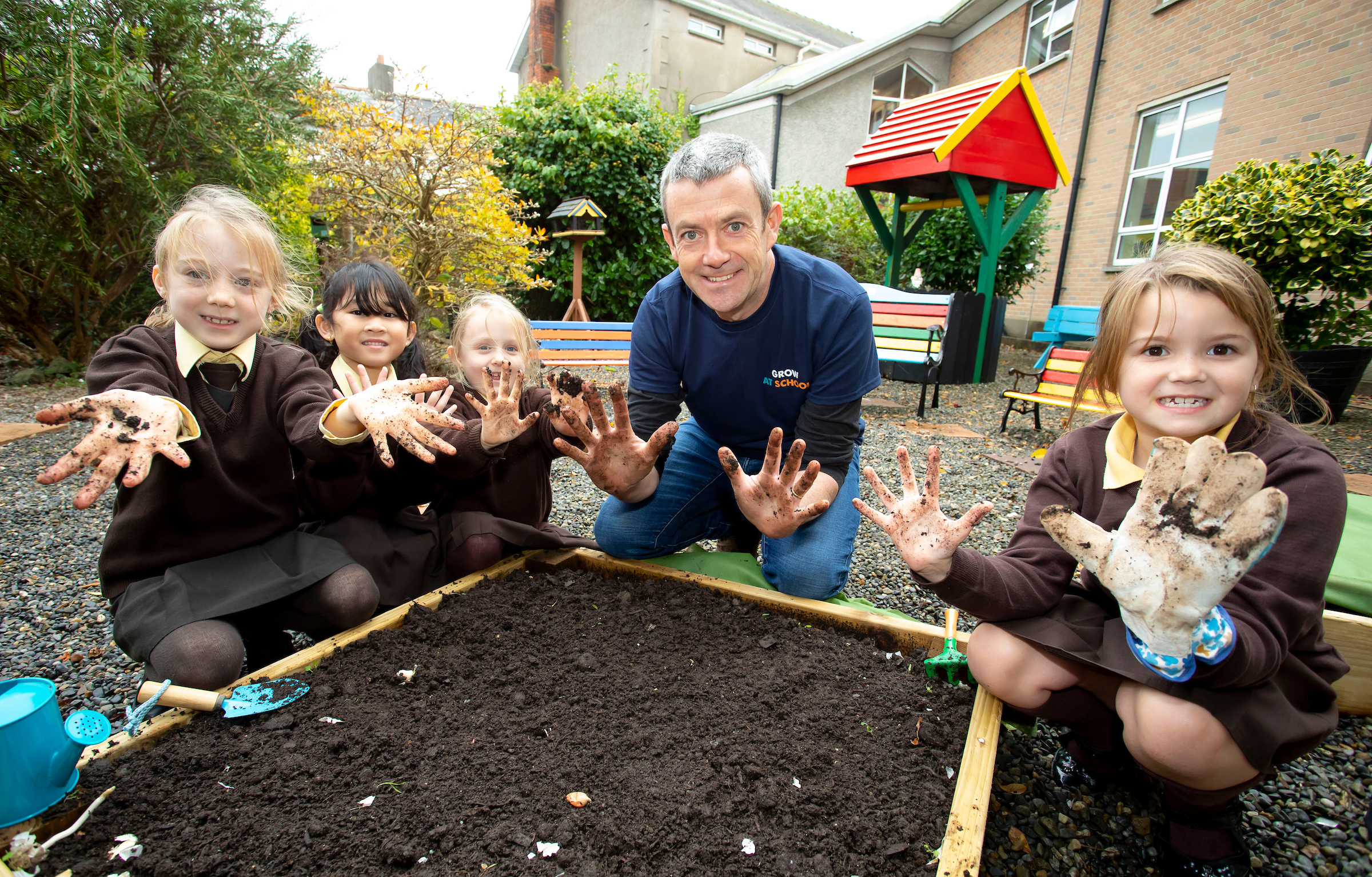
Submission to the Oireachtas Joint Committee on Education, Further and Higher Education, Research, Innovation and Science
In the summer of 2022, GIY made a submission to the Oireachtas Joint Committee on Education, Further and Higher Education, Research, Innovation and Science, proposing GROW at School be implemented and supported as a national food growing programme under the Programme for Government, and was invited to represent the GROW At School programme at a Committee session on Mental Health Supports in Schools and Tertiary Education. Michael Kelly made this presentation and submission last autumn.
Food growing is a great leveller for children
In delivering oral evidence to the committee, on 22 November 2022, Mr Michael Kelly, CEO, and founder of Grow It Yourself Ireland (GIY Ireland), noted that 'food growing is a great leveller for children of all abilities and ages. Sometimes the most marginalised children can participate and thrive in the school environment where they may not be thriving academically.'
Non-academic pursuits need equal status to academic subjects.
The Oireachtas Committee heard in oral evidence that the curriculum in schools is heavily focused on preparing for exams. Students do not have enough time to engage in other activities that could help maintain good mental health. The importance of Physical Education and other such as drama, art, creative writing or participation in workshops and courses such as those provided by Fighting Words, Lust for Life and GIY must be emphasised and given equal status to academic subjects. As such, time must be allocated within each student's timetable to enable them to participate fully in these activities.
Oireachtas Committee Recommendation: “The Primary and Post Primary Curriculum should be reviewed.”
In a subsequent Joint Committee on Education, Further and Higher Education, Research, Innovation and Science - Mental Health Supports in Schools and Tertiary Education report, which was published in January 2023, the Oireachtas committee have recommended "The Primary and Post Primary Curriculum should be reviewed to: Identify suitable Co-Curricular Programmes for inclusion such as those delivered by Grow it Yourself (GIY)."
Opportunities for businesses to support GROW At School Programme
As yet, the programme has not been funded by the government – however, GIY went on to raise almost over €300,000 so far this year through philanthropic support from individuals and foundations, and from corporate donors and individual philanthropic support and is currently delivering GROW At School to 134 primary schools across Ireland this year.
In September 2023 they aim to include an additional 500 schools in the Programme, with a further 1,000 schools in 2024 – aiming to grow towards embedding food growing over 50% of all Primary schools in Ireland in the future. For the 2023 initiative they need to raise €1 million and then €2 million for 2024. See here how you / your business can help.
Huge interest from schools
Speaking about the interest from schools for participation in the programme Nell Ward, Director of Development at GIY, says, "At present it's incredible that over 600 primary schools have registered their interest in joining the programme. This reflects the huge interest amongst teachers in actively participating in environmental action, and the impact of the programme even beyond food growing. GROW At School is at the nexus of climate action, mental health & education (food system). We have been working with schools since our foundation in 2008 and we have learned a lot about what works and what doesn't. This programme delivers on wellbeing, offering mental and physical health and wellbeing benefits. It also delivers on environmental goals – a healthy food system with sustainable food choices addressing biodiversity and zero waste in order to alleviate climate anxiety and it is educational offering students the opportunity to learn a practical life skill & understanding where food comes from.”
Teacher feedback
“We also have some incredible teacher feedback, about how the programme teaches children about their food and where it's come from will help them make better choices as they grow up - some children being "baffled" by the fact that Brussels sprouts grow on a stalk and that peas were growing in pods in front of them."
Positive impact on children
One teacher stated "It has had a huge impact on the children. A lot of them have transferred what they have learned and started their own patches at home." Children in the autism unit have probably got the most benefit out of it. It has been very therapeutic for them to go out and work the soil and see the plants growing.
Another says, "It made everyone very conscious of the amount of food that was wasted and the carbon footprint, compared with growing something in your own garden."
Pressure to fund schools for next academic year
The pressure is on to fund these schools for the academic year 2023/2024 (at no cost to the schools to participate). It costs €2,000 per school to provide the kit of four raised beds, soil to fill them, seeds and other materials, along with teacher training and ongoing support to help the gardens to flourish.
For further details email growatschool@giy.ie
GIY's 'Get Ireland Growing Day' - Doing our bit for the planet
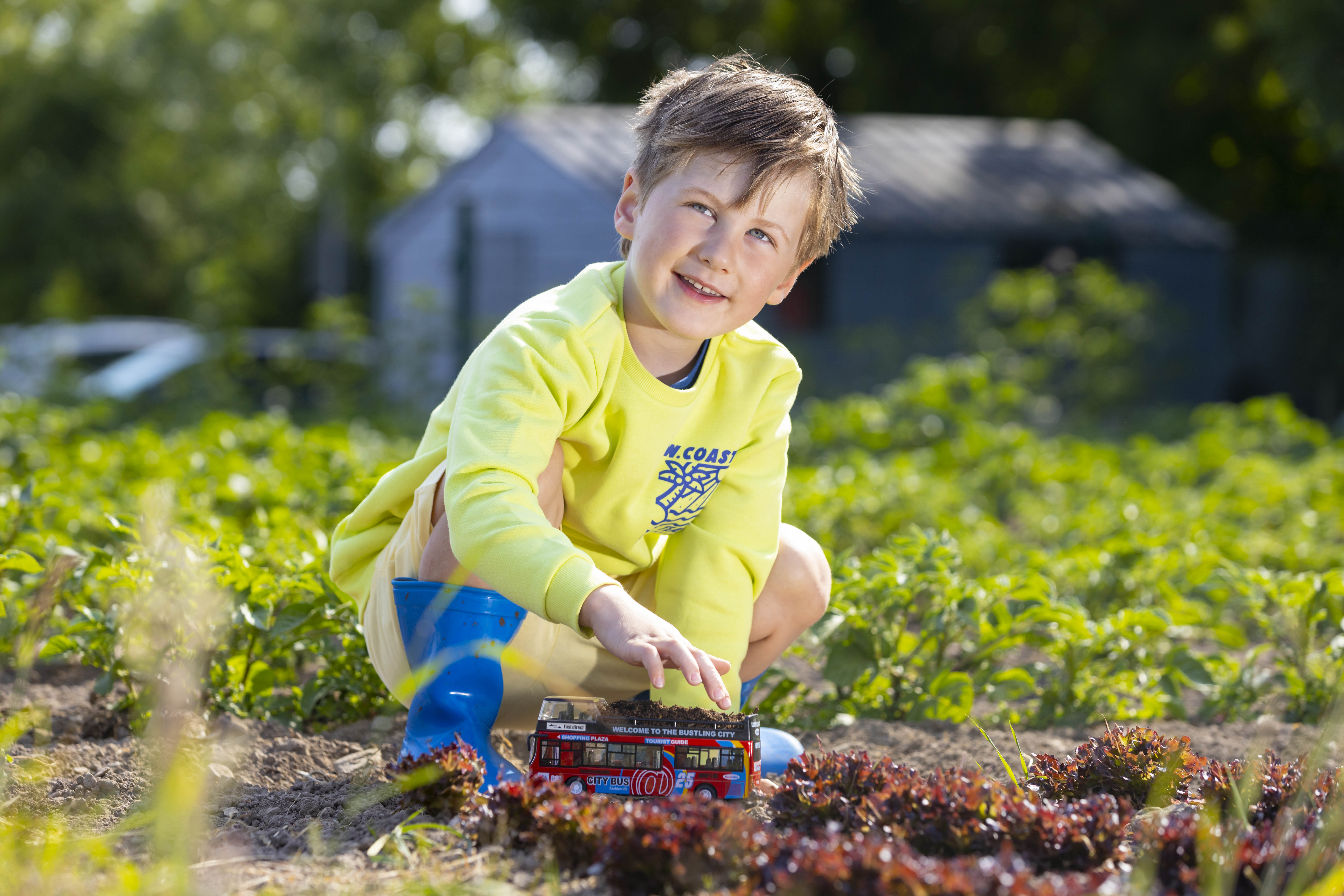
 Mick Kelly and the wise folk at GIY urged every household in Ireland to 'sow a seed and Get Ireland Growing’ this summer, with a special reminder issued to mark the longest day of the year.
Mick Kelly and the wise folk at GIY urged every household in Ireland to 'sow a seed and Get Ireland Growing’ this summer, with a special reminder issued to mark the longest day of the year.
Going since 2021, GIY’s Get Ireland Growing Day calls on everyone to carry out a positive food growing action and this year businesses across Ireland are backing 'Get Ireland Growing' Day, to help GIY spread the message and for their employees to get involved in sustainability activity.
GIY founder Michael Kelly commented, "In recent times we’ve seen a lot more people begin to grow food at home and we want to support and encourage more people to join the effort. We’re in the middle of both a climate and biodiversity crisis, and food growing is hugely powerful to connect us with these challenges in a really proactive way.
Seed sowing is not restricted to any particular time of year, of course, but Michael says, "With people across the country all joining us in 'sowing a seed' on June 21st and celebrating the importance of food growing in Ireland, Get Ireland Growing Day is designed to show that food growing is in our nature – both as a culture and through the planet's resources that make it possible and we can all create a more sustainable future in Ireland within our homes and our local communities."
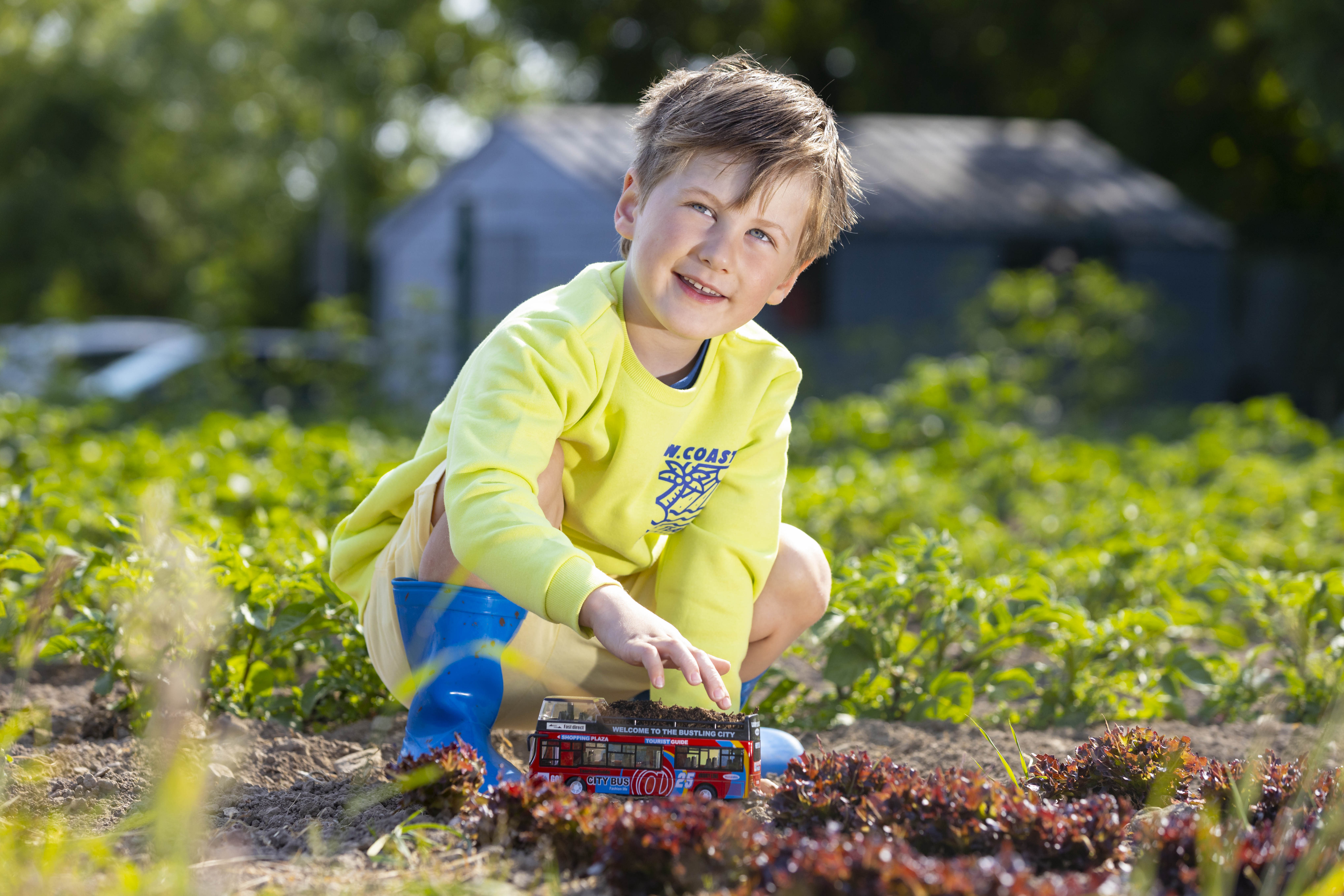
One of the Get Ireland Growing flagship partners is CIÉ Group, which includes the full fleet of CIÉ organisations employees across Irish Rail, Dublin Bus, Bus Éireann and the CIÉ Holding Company. CIÉ employees will be leading as Get Ireland Growing ambassadors. Caoimhe Donnelly, Chief Sustainability Officer for CIE:" The partnership spans multiple aspects of CIÉ's sustainability priorities, such as climate action, climate resilience, biodiversity, community engagement, and health & wellbeing – both for communities and CIE employees.
Through the simple but effective action of food growing in gardens, yards offices, windowsills and balconies in every village, town and city across Ireland, this reflects the power of employees as sustainability advocates, leading communities to take part in climate & biodiversity activity at a local level. The partnership will support and highlight a number of community and biodiversity initiatives across CIÉ such as community gardens, men's sheds, tidy towns, scouting Ireland, and local schools.
Regional Get Ireland Growing ambassadors are also coming on board in organisations across Cork, Meath, Limerick, Galway and Dublin with employees leading the initiative in their communities as they all plan their food growing projects and seed sowing from June 21st 2023.
This is yet another great initiative from GIY, showing us once again how we can all make a difference. For information on how you or your business can get involved in Get Ireland Growing Day see, www.getirelandgrowing.ie
GIY Market Garden at Curraghmore Estate
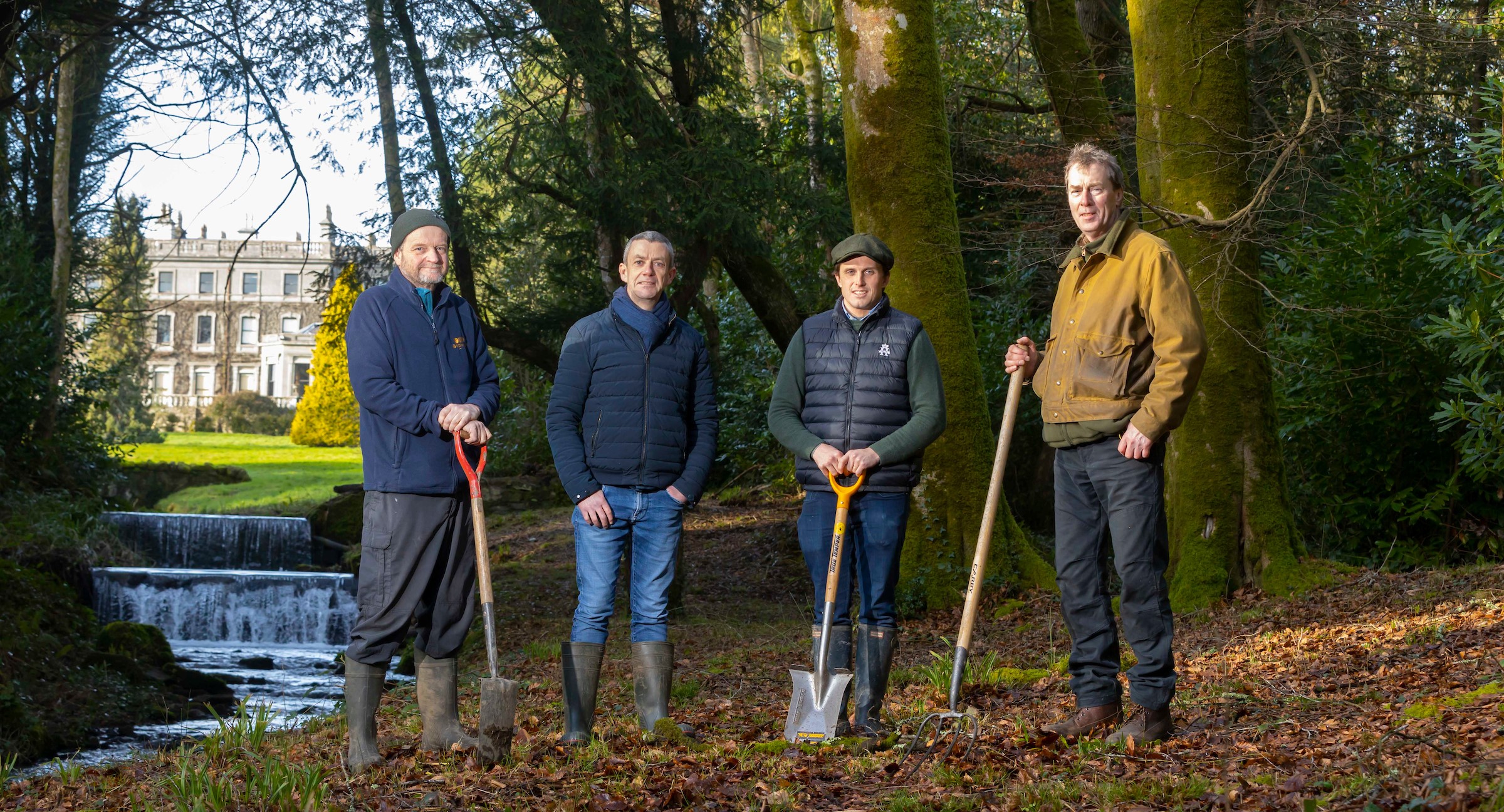
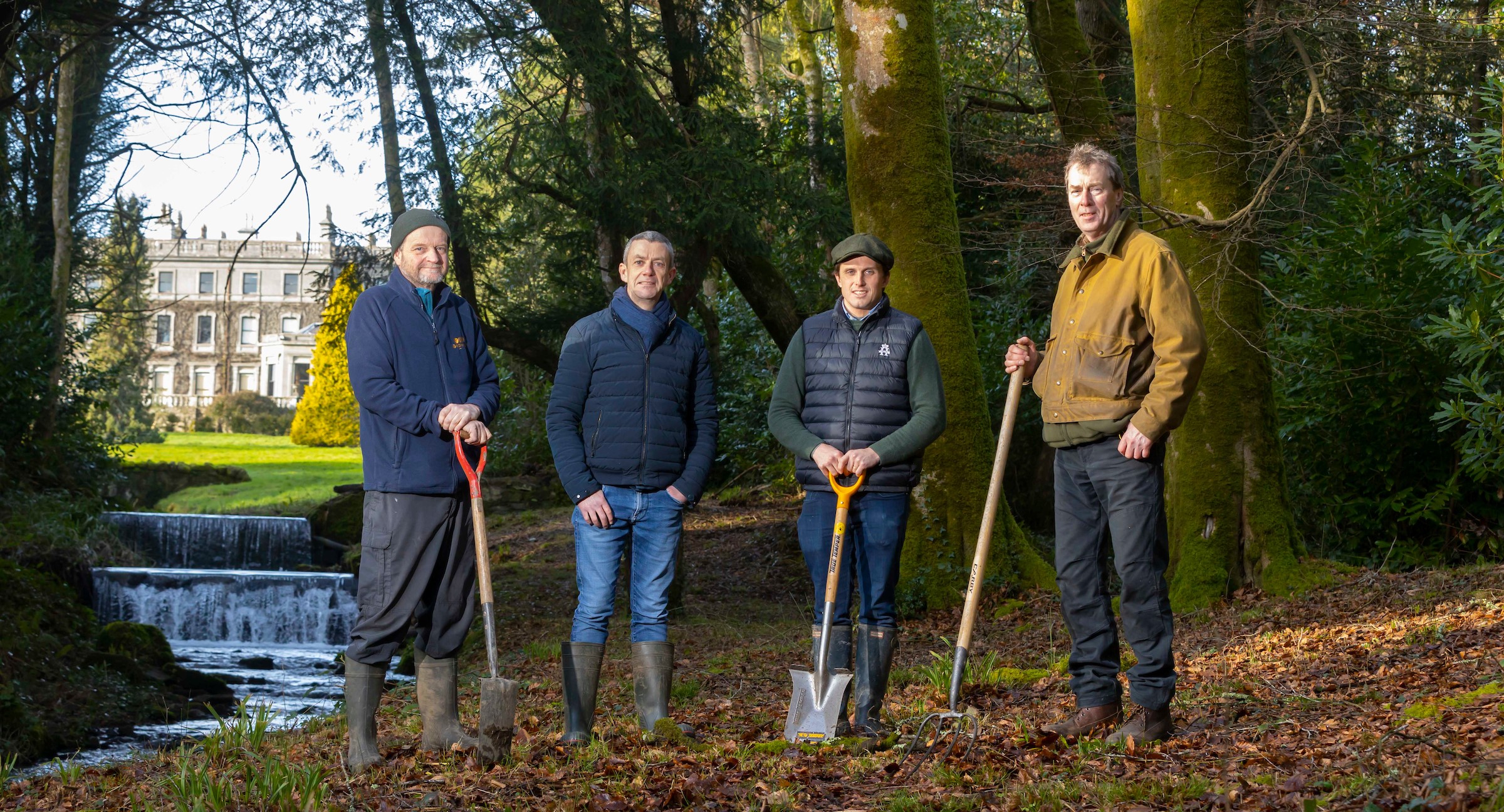
Seriously exciting news from the multi-award winning social enterprise GIY (Grow It Yourself) this month, on their expansion to develop a GIY Market Garden at Curraghmore Estate in Portlaw, Co. Waterford.
Having announced their ambition to find additional land to expand their food education and production activities in 2022, they’ve now signed a lease that enables them to create a mixed-use organic smallholding. Situated within Curraghmore Estate’s 19th-century 12-acre walled garden, which is one of the largest walled gardens anywhere in Ireland and the UK, it will be home to traditional breed poultry and pigs as well as field-scale vegetables and fruit following regenerative agriculture principles.
The partnership with the Curraghmore Estate is building on the success of GROW HQ in Waterford city to create a regenerative food education campus in Waterford that will be a model of a sustainable food system with a mixture of food production, education, enterprise and tourism. Announcing that they will be turning the sod on the new GIY Market Garden this spring, GIY founder Michael Kelly explained, “We will be using the new land for food production using farming and grazing practices that restore organic matter, soil and ecosystem health; for food education offering immersive education experiences through courses, visits and events for children and adults; for food tourism in working with the Curraghmore Estate to provide world-class regenerative food tourism experiences and for food enterprise by creating a community of GIY enterprises from an organic veg box scheme, to the supply of local restaurants with veg, eggs and meat and more. It's a very exciting next step for GIY and one that we believe will create an impact and benefit for people and the planet."
The next stage of the project will see preparation for spring 2024 planting across 7 acres, with the first food production and harvest underway through 2024. GIY would also like to see the walled garden restored ‘to some of its former glory’ - at one stage the walled garden would have employed 40 gardeners and supplied the estate and Portlaw itself with produce. It was pioneering and innovative for its time and was the first workplace of rewilding pioneer William Robinson, making the ultimate aim of restoring some of the garden buildings as education spaces especially appropriate.
People in Waterford and beyond will be able to sign up to receive a weekly box of organically grown produce from the GIY Walled Garden from July 2024. GIY has launched a registration process for people to find out more and sign up for the waiting list at https://giy.ie/
This project was approved by Government with support from the Dormant Accounts Fund.
- GIY is recognised as one of Ireland's leading and most innovative social enterprises and a thought leader in food, health and sustainability. The organisation has a track record of working collaboratively with partners across sectors – from foundations to corporate partners, to national bodies such as Healthy Ireland, Bord Bia and Failte Ireland, and even at a global level with the UN Sustainable Development Goals Advocacy Hub. GROW HQ, the home of GIY, is an award-winning food education centre, urban farm, shop and café based in Waterford City.
- Curraghmore Estate, near Portlaw in Co Waterford, is the ancestral home of the Marquis of Waterford and just a 25-minute drive from GROW HQ. With 800 years of history, it is the last of four castles built by the de la Poer family after their arrival in Ireland in 1167 and their descendants still live there today. It is also home to Curraghamore Whiskey and the All Together Now music festival. The gardens include a formal parterre, tiered lawns, a lake, an arboretum and kitchen gardens. The estate contains some of Ireland's most remarkable surviving trees - sweet chestnut and oaks, beech, Chinese Fir, Japanese Umbrella Pine, a Maritime Pine, Lebanese Cedar and the estate's and Ireland's tallest tree, an enormous Sitka Spruce. At 12 acres, the walled kitchen garden was known to be the largest walled garden in the UK and Ireland - at one stage it employed 40 gardeners. The farm at Curraghmore was considered Europe's first commercialised farm. Champion of the naturalistic style of gardening, William Robinson started his horticulture career at Curraghmore and later became a famous garden writer and author of The Wild Garden (1870).
*Pictured at Curraghmore Estate are Richard Mee Head Grower at GIY, Michael Kelly Founder of GIY, Richard The Earl of Tyrone Curraghmore Estate and Michael Murphy Head Gardener at Curraghmore Estate for the announcement of the GIY Market Garden at Curraghmore Estate [Photo: Patrick Browne].
Grow It Yourself
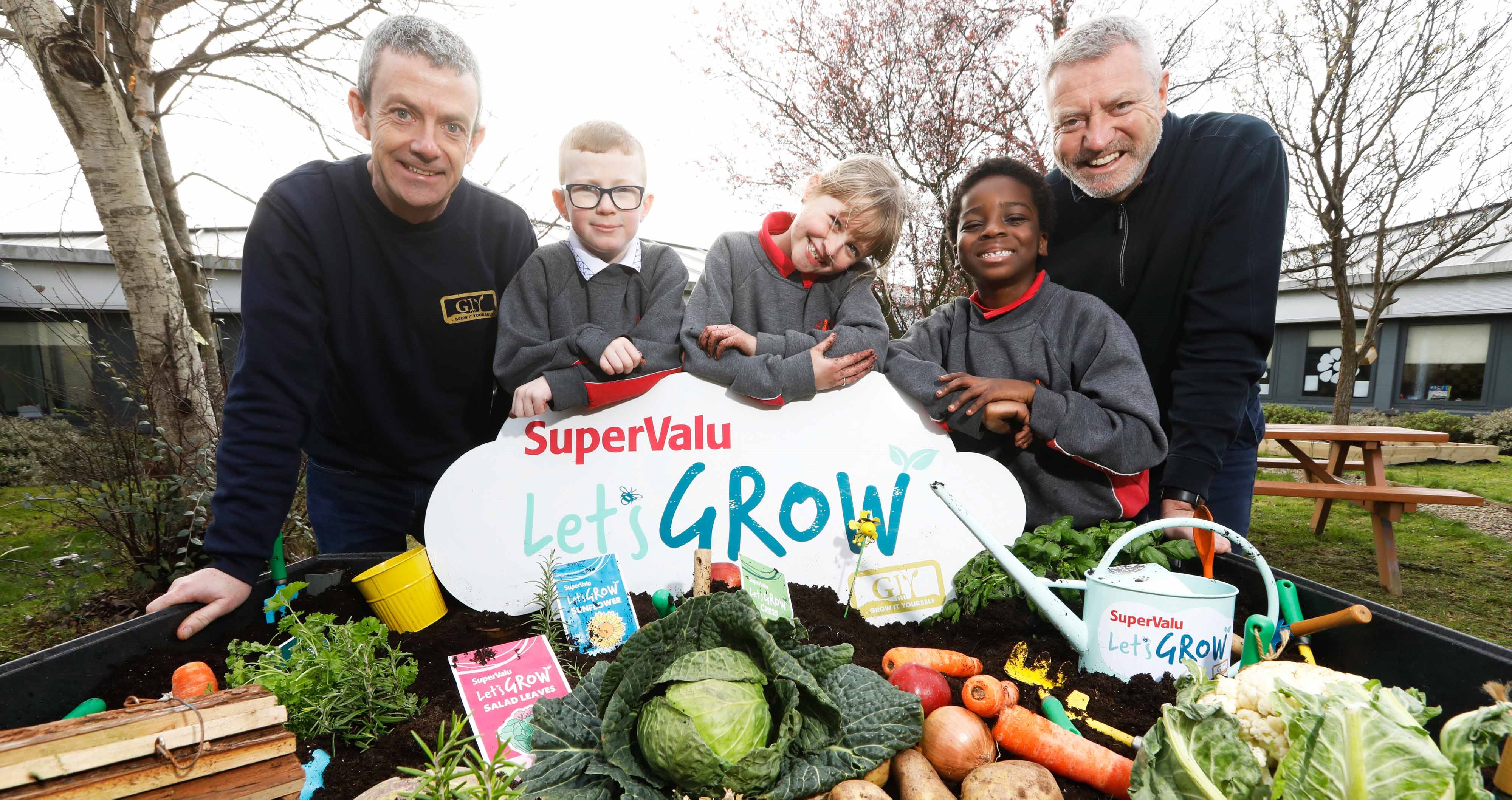
100,000 children are set to experience growing their own food this year, with GIY and SuperValu’s ‘Let’s GROW’ Initiative
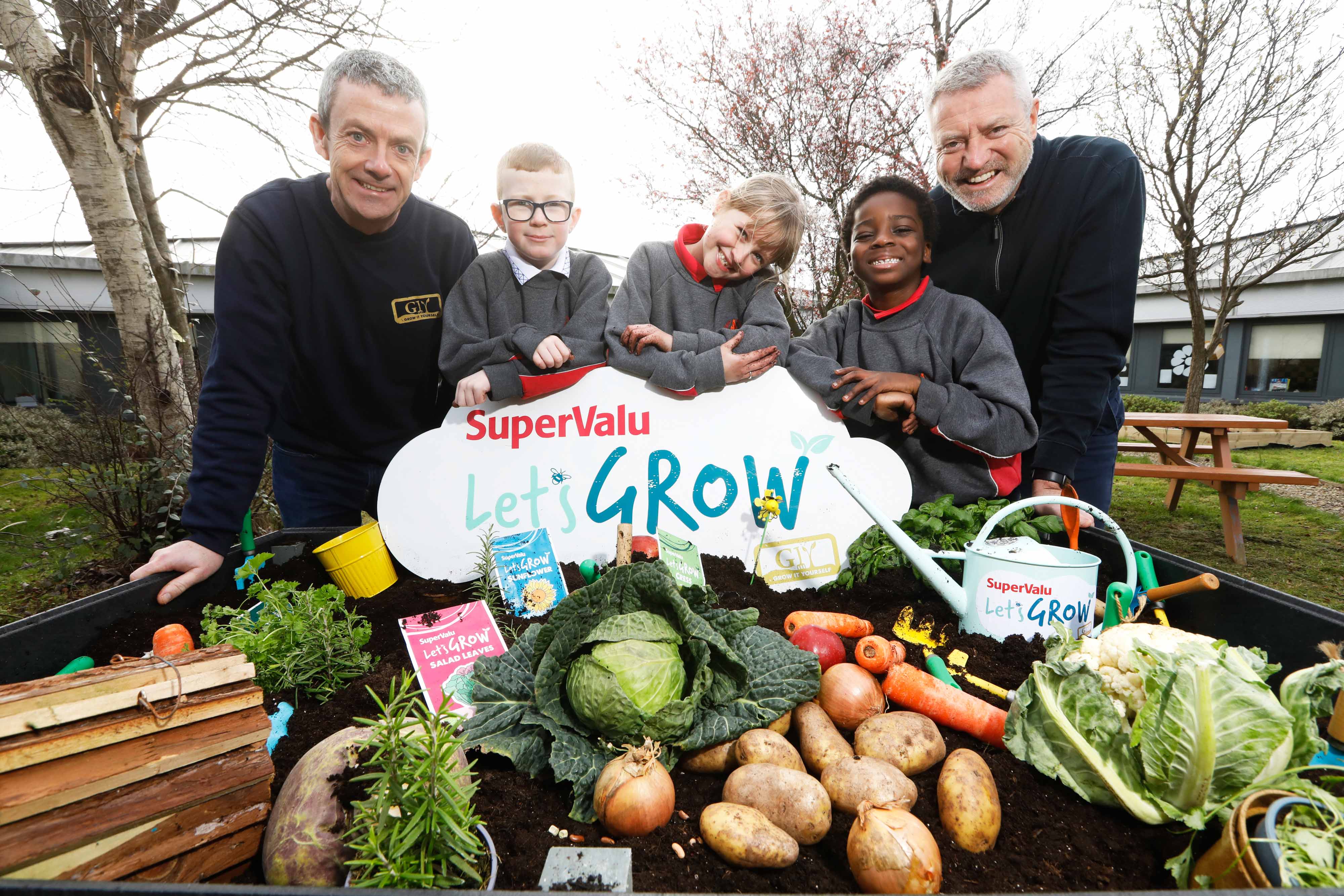 We all know the potential for change that lies with the next generation, so it’s great to hear that SuperValu and the not-for-profit social enterprise GIY (Grow It Yourself) have teamed up for the second year to bring the 'SuperValu Let's GROW' programme to another 50,000 primary school children throughout Ireland this spring.
We all know the potential for change that lies with the next generation, so it’s great to hear that SuperValu and the not-for-profit social enterprise GIY (Grow It Yourself) have teamed up for the second year to bring the 'SuperValu Let's GROW' programme to another 50,000 primary school children throughout Ireland this spring.
This means that 100,000 primary school children will have been educated in growing food through the 'SuperValu Let's GROW' initiative, having been supplied with the resources to grow their own fresh food for free at school. Research carried out by GIY shows that when children grow some of their own food they develop what we call "food empathy", a deeper connection with food, which is proven to lead to a healthier lifestyle.
The partnership aims to elevate the significance of homegrown food within classrooms and households across Ireland and schools can register for free food growing kits – which are available for as long as stocks last.
All of the participating schools nationwide will be in with a chance to win a school garden and the 2024 nationwide campaign was announced at Solas Chríost National School in Tallaght, Dublin, who were crowned the winners of the 2023 initiative, after they developed and adopted their own food growing grading system which assessed how the pupils made food growing even more interesting via creativity and imagination. The school was rewarded with a new school garden to the value of €1,000 from SuperValu which was installed by GIY.
Each participating school receives a 'SuperValu Let's GROW' classroom pack which includes everything needed for food growing and food literacy education. Designed by GIY, the 2024 packs include seeds such as cress, peas, salad leaves, beans and sunflowers, along with 32 compostable pots, 32 magic compost discs and an expert resource booklet with growing guides, lessons and activities, created by GIY to enhance the learning experience.
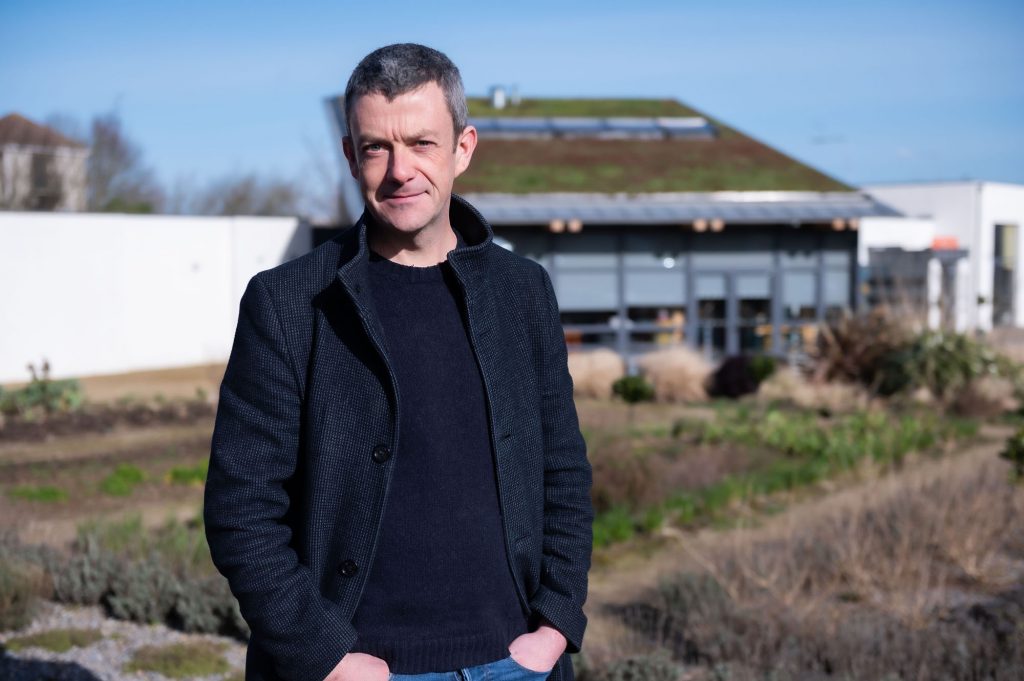 GIY Founder and CEO Michael Kelly says, "Food-empathetic children have better diets, eat more fruit and vegetables and have a better understanding of food and nutrition. At a time when Ireland still has among the highest rates of childhood obesity in the EU, establishing a deeper connection with food is more important than ever. In addition, children who have grown some of their own food are more likely to try new foods at home as a result. Not only is this important for the future health of our nation but it is also an opportunity to provide children with the life skills to grow their own food and obtain a natural appreciation for fresh, seasonal, healthy foods – and it's always a thrill to see the excitement of kids when the SuperValu Let's GROW kits arrive in their classroom!"
GIY Founder and CEO Michael Kelly says, "Food-empathetic children have better diets, eat more fruit and vegetables and have a better understanding of food and nutrition. At a time when Ireland still has among the highest rates of childhood obesity in the EU, establishing a deeper connection with food is more important than ever. In addition, children who have grown some of their own food are more likely to try new foods at home as a result. Not only is this important for the future health of our nation but it is also an opportunity to provide children with the life skills to grow their own food and obtain a natural appreciation for fresh, seasonal, healthy foods – and it's always a thrill to see the excitement of kids when the SuperValu Let's GROW kits arrive in their classroom!"
Building on the success of empowering children to grow their own food in schools, and in line with SuperValu's ‘Take Local Action, Make Global Impact' sustainability campaign, which aims to showcase the small actions everyone can take in their homes, stores and towns to make a collective global impact, SuperValu and GIY are also growing the initiative beyond the classroom, with GIY GROWBoxes now also available in selected SuperValu stores nationwide. The expansion of the 'Let's GROW' initiative ensures that the joy and learning experience of growing food can extend to every home, allowing families to deepen their connection with the food on their tables.
School teachers are invited to apply online for a free 'SuperValu Let's GROW' food growing pack at www.supervaluletsgrow.ie available while supplies last. Additionally, families looking to start their own growing journey can visit their local SuperValu store to pick up a GIY GROWBox.
 Top 5 Tips for Growing Food with Kids
Top 5 Tips for Growing Food with Kids
- Kids love sowing seeds (or indeed anything that involves getting their hands dirty). Bigger seeds like those from peas, beans, squashes, pumpkins and courgettes are easier for younger children to handle.
- Give kids some autonomy in the veg patch. Give them a dedicated raised bed or part of a bed for them to experiment with. Let them grow what they want to grow.
- Encourage them to grow fruit and vegetables that are fast growing so that they see a quick return. Radishes are a good example. Runner beans and sunflowers will get tall quickly. Get them to measure themselves against the plants each week.
- Encourage them to sample crops out in the veg patch. They will love grazing on sweet carrots, tomatoes, strawberries and peas, and it will help develop their palette.
- The top GIY activities for kids are sowing seeds, digging and watering. Basically, the messier the job, the more they will love it.
New LEAF programme for GIY and Libraries Ireland
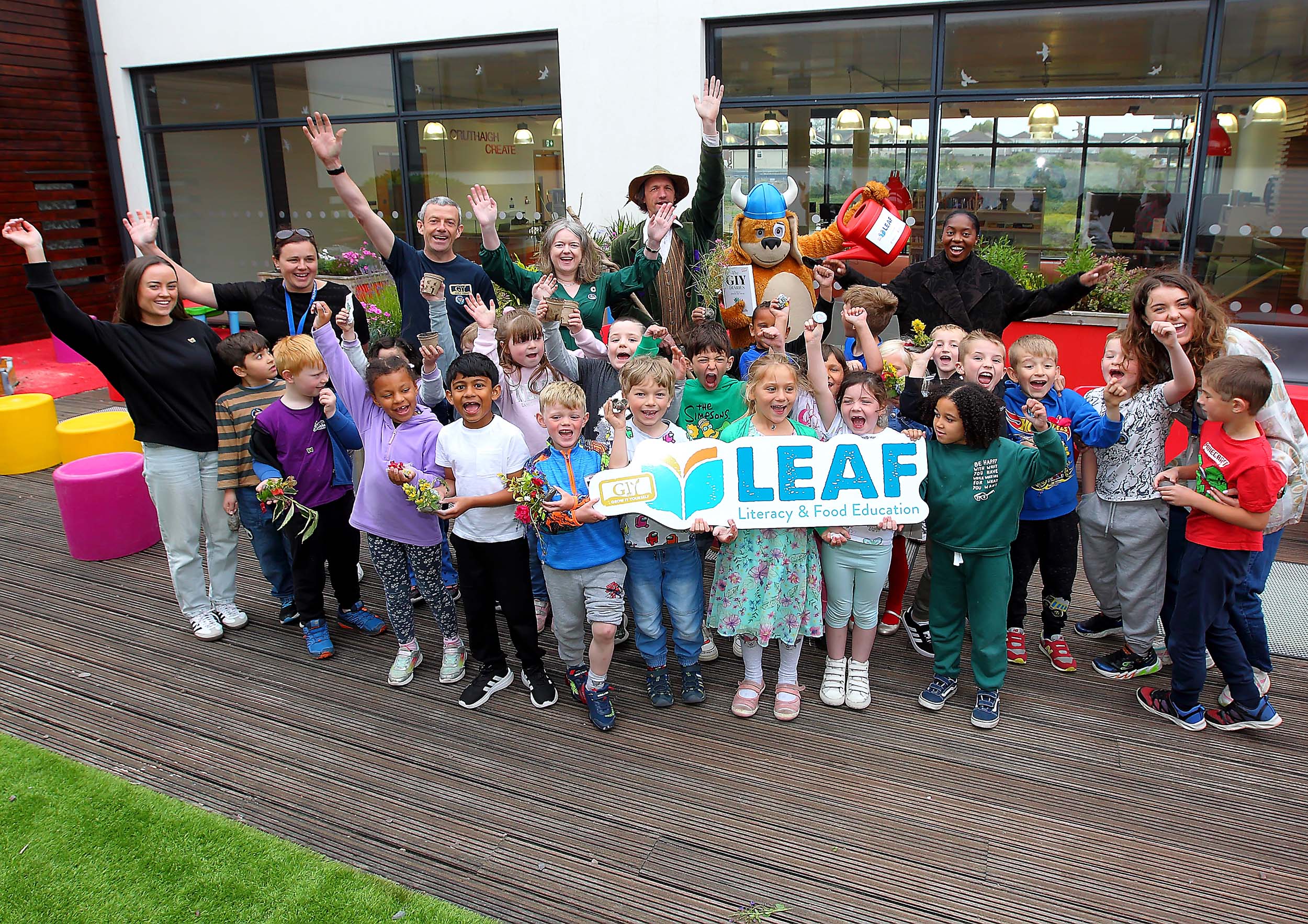

Yet another brilliant educational project from Michael Kelly's GIY (Grow It Yourself), who have teamed up with Libraries Ireland to create a new food education and literacy programme, LEAF, which aims to establish a food-growing community initiative in every, town, village, city and local authority area where there is a library.
LEAF focuses on empowering communities to grow their own food as a climate action while also fostering food empathy, and promoting sustainable living. Importantly, the LEAF programme is supported by the Government Climate Action Fund which encourages innovative projects to develop climate change solutions cost-effectively - and supports projects that would not happen without it.
Along with the provision of digital resources and 'how to' videos, both in libraries and online, there are free seed packs and information packs which recipients are asked to use in order to share the experience and enable a community of people - initially across Waterford - to enjoy the wide range of benefits that come from growing food.
Launching the LEAF Programme recently, GIY founder Michael Kelly said he was delighted to be partnering with Libraries Ireland through the Community Climate Action Programme. As GIY's primary goal is to get more and more people to grow some of their own food, any community effort in food growing is seen as a big win.
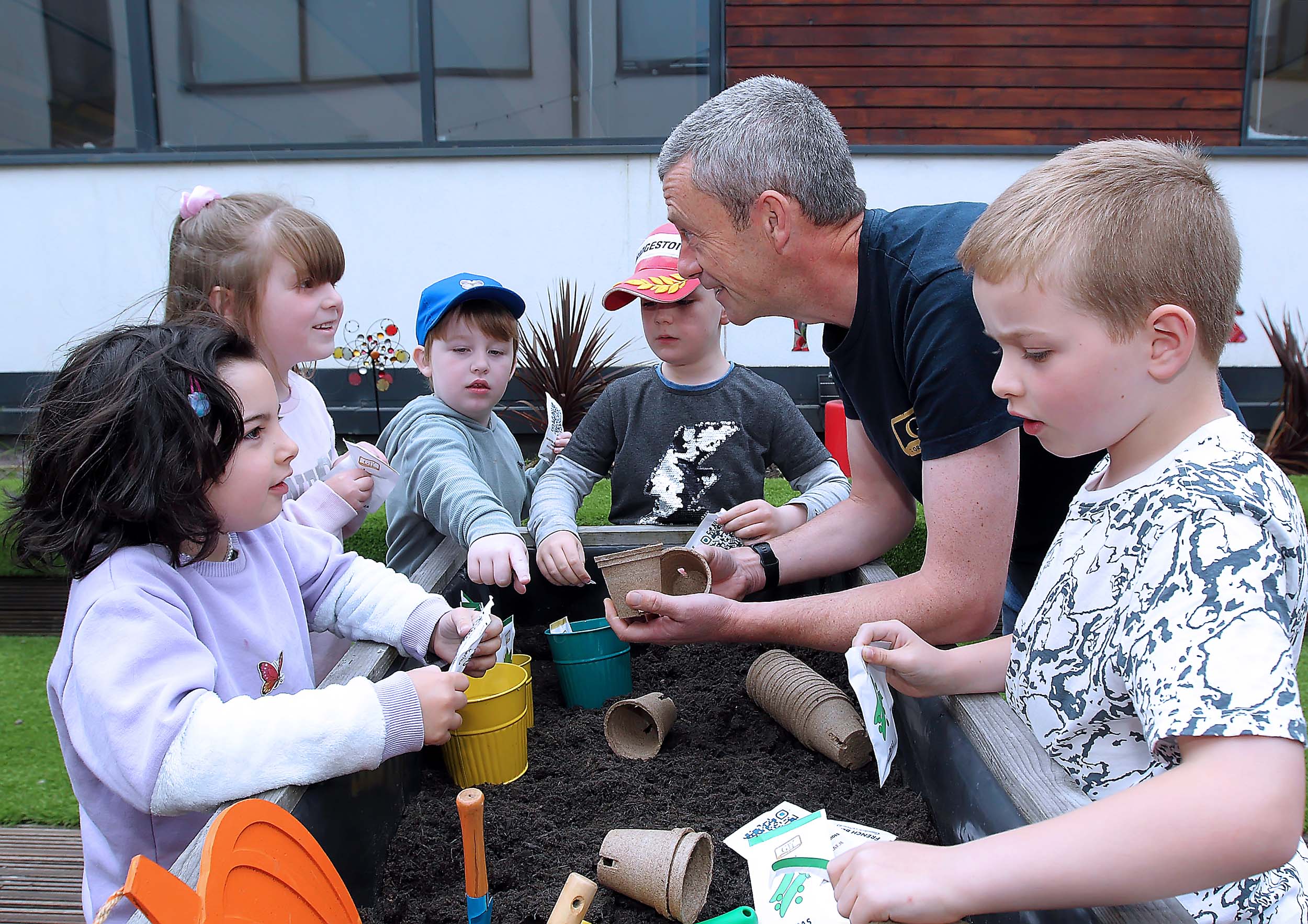
The hope is that this programme will reach people who have never tried to grow food before and who may want to build new connections through food growing in their community - and to entice those with knowledge and experience from working in their own gardens to share that valuable information and experience.
After kicking off in Waterford libraries, the LEAF programme will be piloted in 25 libraries across the Southeast region and members of the public who wish to get involved can register with their local participating library and pick up their LEAF pack.
Expressing her enthusiasm for the project, the Senior Executive Librarian of Waterford Library, Sinead O'Higgins, said they would also be hosting special events throughout the programme in tandem with the UN Sustainable Development Goal week, with key industry expert visits and talks plus 'Show & Grow' events for all of their community growing projects. "It will be a very engaging programme, offering a wonderful learning opportunity for everyone who takes part."
For further details, see.www.libraryleaf.ie
IMAGES:
Top - Michael Kelly, GIY, Susan Lee, Community Climate Action Officer, WCCC, Nell Ward, GIY, Zeinab Gohi, GIY, Mary Conway, Interim City & County Librarian and Head of Culture Waterford City and County Council, Dylan White, Age Friendly Waterford, Jennifer Lougran, Waterford Libraries, Sinead O'Higgins, Senior Executive Librarian, Waterford Libraries, Fiona Foskin, Waterford Libraries and Breda O'Shea, Librarian who were pictured at the launch of LEAF from GIY and Libraries Ireland at Carrickpherish Library on Friday 21st June 2024.
Centre - Seed sowing with the children of Educate Together at the launch of LEAF from GIY and Libraries Ireland at Carrickpherish Library.
Show me all Article


